THE CASH















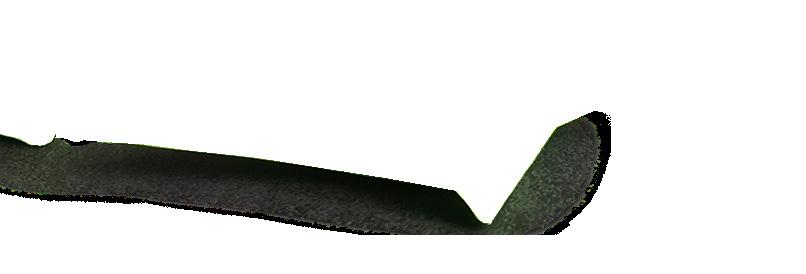
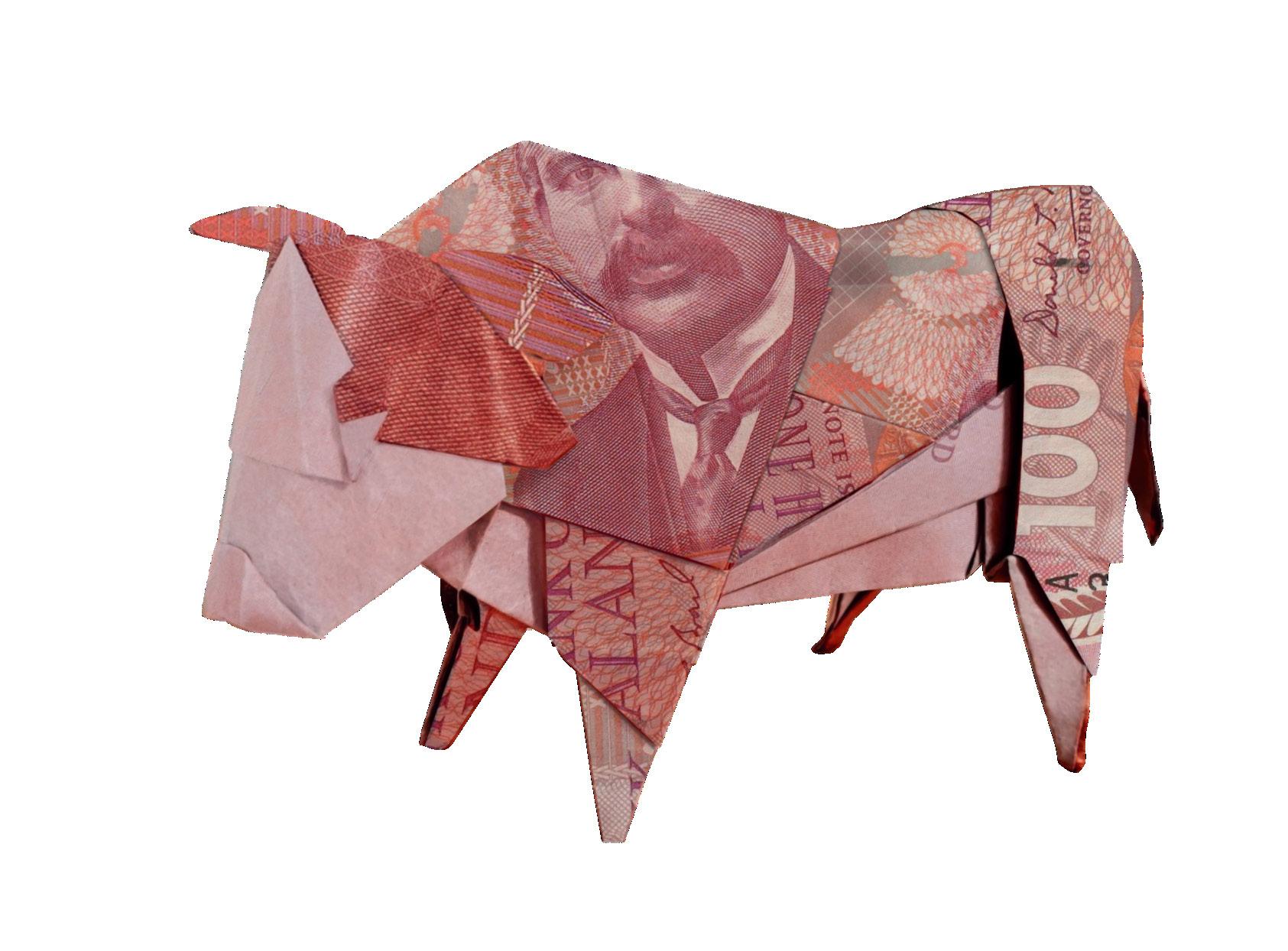




















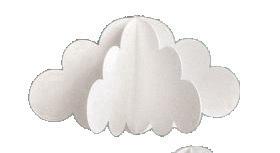

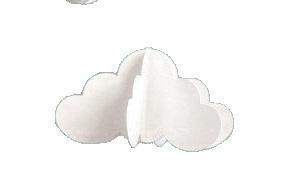












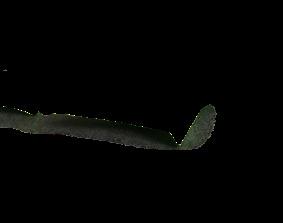


BY
MAGAZINE 20 23 $12.95 incl gst MAY 2023
COUNTRY-WIDE
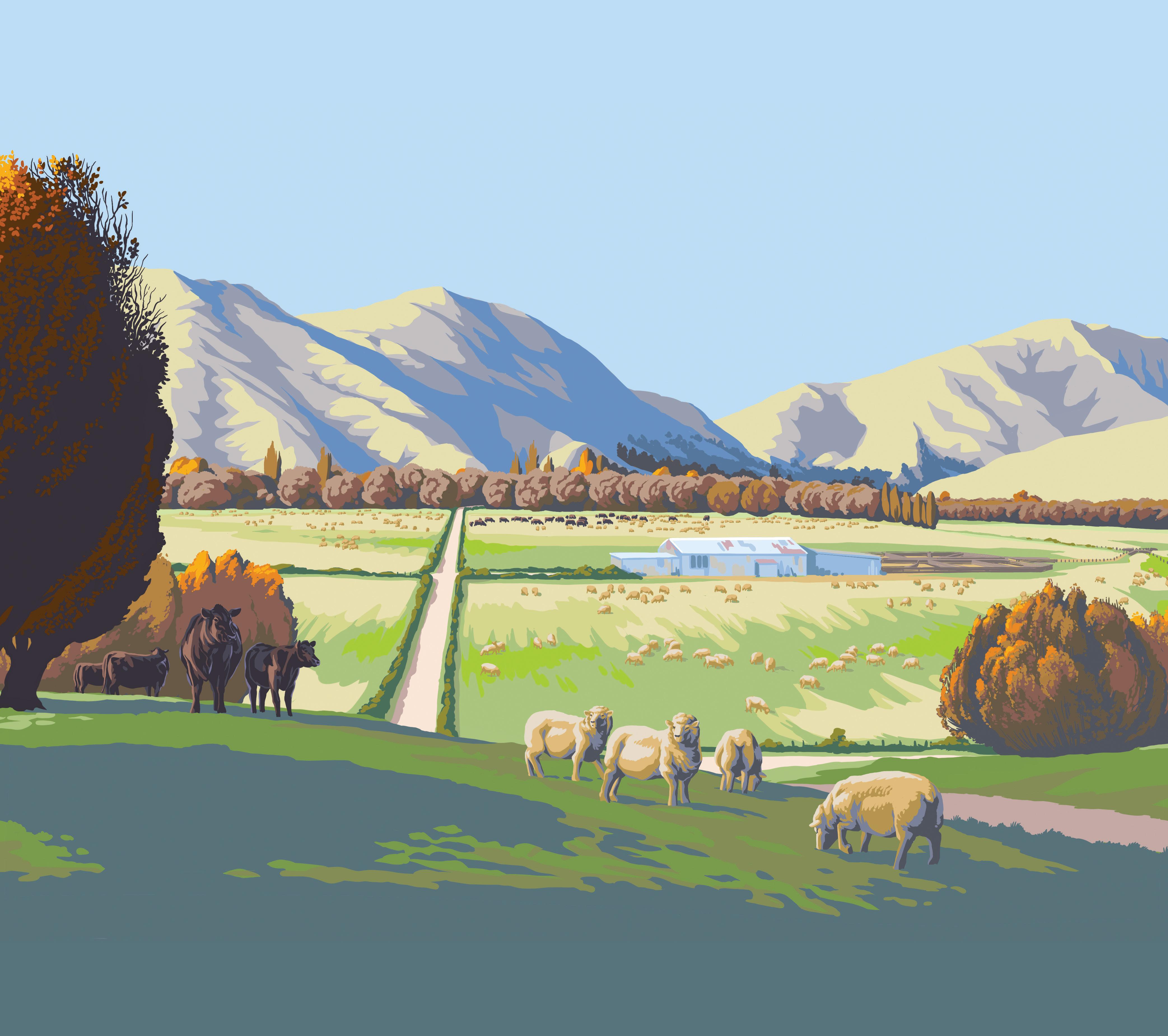
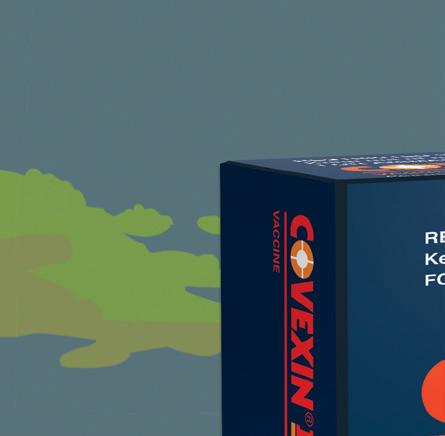

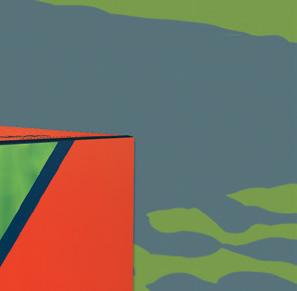










Unsurpassed 10-in-1 clostridial protection NOW AVAILABLE IN A LARGER 500ML PACK
Fast growing/high producing stock grazing new pastures, crops or supplementary feed are more vulnerable to clostridial disease and sudden death.1,2
That’s why we created Covexin®10. Made here in New Zealand specifically for our conditions, Covexin 10 offers the most comprehensive clostridial protection available on the market today. Talk to your vet about upgrading to Covexin 10 and get peace of mind that you are providing the best clostridial protection for your stock.

ASK FOR COVEXIN 10, THE PREMIUM 10-IN-1 PROTECTION

3 VAXIPACK® RECYCLING LEARN MORE AVAILABLE ONLY UNDER VETERINARY AUTHORISATION ACVM No: A9028. Schering-Plough Animal Health Ltd. Phone: 0800 800 543. www.msd-animal-health.co.nz NZ-BOV-221000001 © 2022 Merck & Co., Inc., Rahway, NJ, USA and its affiliates. All Rights Reserved. 1. Lebrun et al (2010) Cattle enterotoxaemia and Clostridium perfringens. Veterinary Record 167, 13-22. 2. Lewis (2011) Control of important clostridial diseases of sheep. Vet Clin Food Anim 27 (2011) 121–126.
SCAN QR CODE to read a farmer testimonial
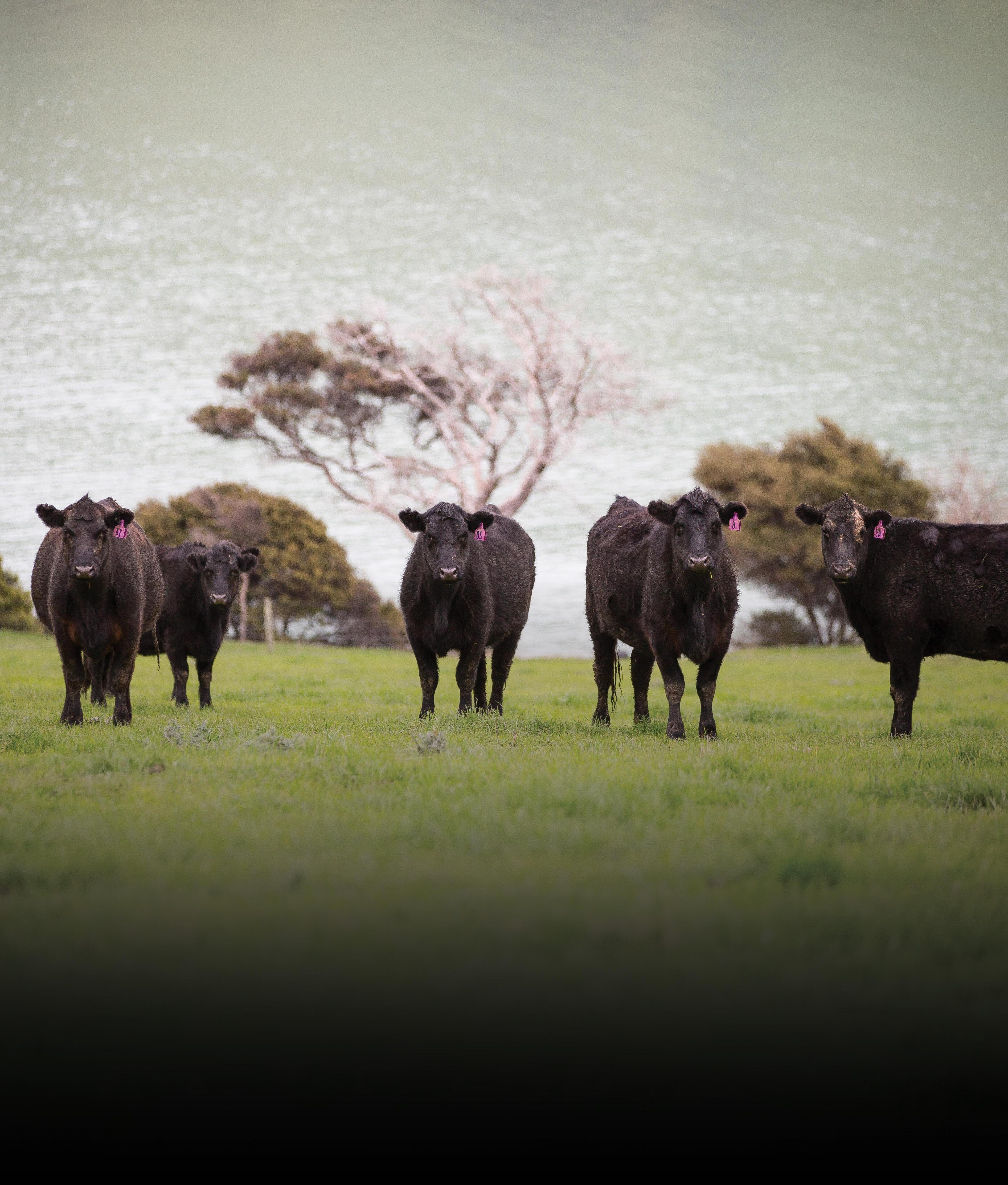
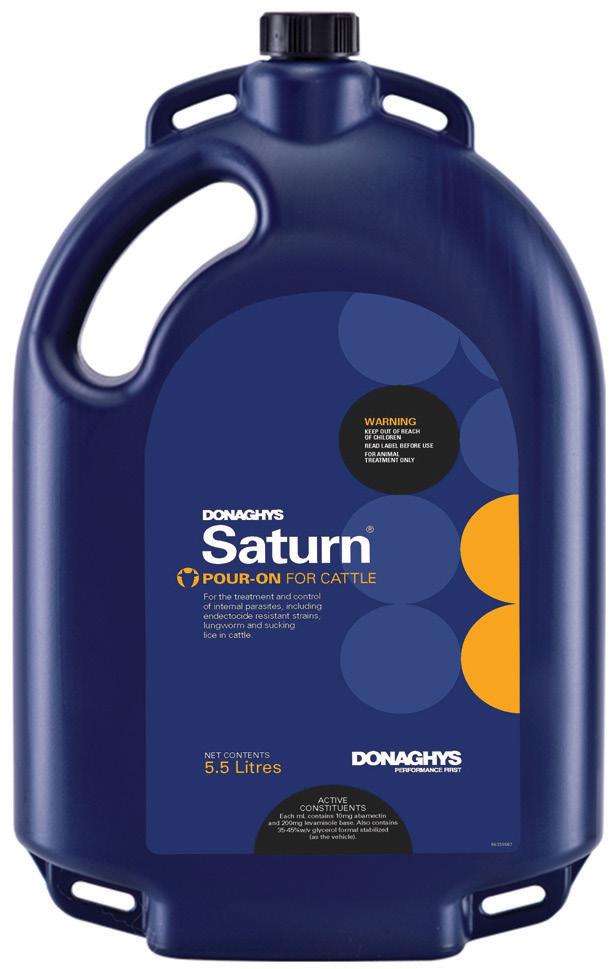

4 Country-Wide Beef | MAY 2023 FreePhone 0800 942 006 Contact your rural supplier or visit: www.donaghys.com Saturn iS a double active Pour on for cattle for the control of production limiting parasites including encysted Ostertagia and Ivermectin resistant Cooperia. It is ideal for use in cattle up to 15 months of age. venator HiMin iS a double active SHeeP and cattle oral and is effective against gastrointestinal roundworms and lungworms. It can be used in calves/ yearlings over 100kgs and lambs over 20kgs.
No room for complacency
GLOBAL AND INTERNAL EVENTS
may be hurting New Zealand agriculture, but the outlook for beef remains strong.
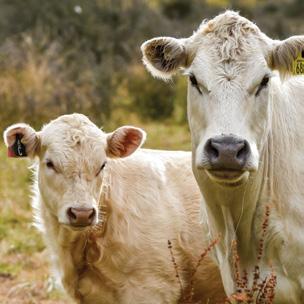
However, there is no room for complacency on either side of the farmgate. There are market opportunities to be grabbed and new and existing technologies to be used on farms.
In the United States, cattle numbers have fallen and this perhaps offers an opportunity for NZ to capitalise.
That depends on how well the meat industry and exporters seize the opportunities.
The best eating is in younger animals.
Young, grass-fed spring-born cattle should be our beef oysters but heavy, older animals are rewarded (see p87).
The US beef industry has been capitalising on dairy beef since the 1970s. Holstein programme calves are raised on a special ration then go into a feedlot.
Finished steers are sought after because they grade highly and their beef is of a high consistency. Why can’t we do more with dairy beef?
Meat companies have been innovative in China where there are many changes and increasing competition. The competition is coming not just from other countries; local production continues to improve. NZ beef is not regarded as a premium product in restaurants because it is not grain-fed and strongly branded.
Should Taste Pure Nature be more focused on the consumer rather than the retail market?
Other opportunities exist in the United Kingdom with the free trade agreement (FTA). The European Union FTA is under threat of an environmental barrier – deforestation rules. If a product breaches compliance there is a hefty fine which hopefully NZ will avoid.
Back in NZ, weaner market prices have remained strong. Post-Cyclone Gabrielle areas had some disruption, but overall the numbers came through. Blanket forestry is likely to have a big impact on future saleyard numbers.
Another threat is biosecurity and our Mycoplasma bovis series questions whether NZ is ready or not.
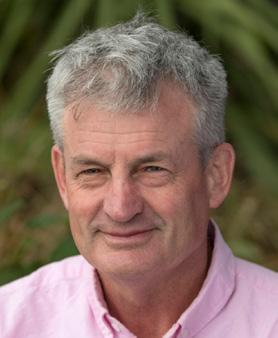
Good genomic predictions and the demand from the dairy industry has seen a rise in yearling sales. Good genetic opportunities exist for beef farmers too.
Country-Wide is moving to a twomonthly frequency to help control costs and improve the content with more in-depth articles. Existing and new subscribers can enter to win a cattle handler, see page 9.
NEXT ISSUE: June/July 2023

Cost-effectively turning hill country grass into saleable beef.
A Charolais Angus cross breed for the dairy industry.
Beware of unseen subclinical facial eczema in cattle.
How inflation is measured, its value and flaws.
Why the Albrecht system for fertiliser should be ditched.
Country-Wide Beef | MAY 2023 5
@CountryWideEd Got feedback? Contact the editor: terry.brosnahan@nzfarmlife.co.nz Ph: 03 471 5272 EDITOR'S NOTE
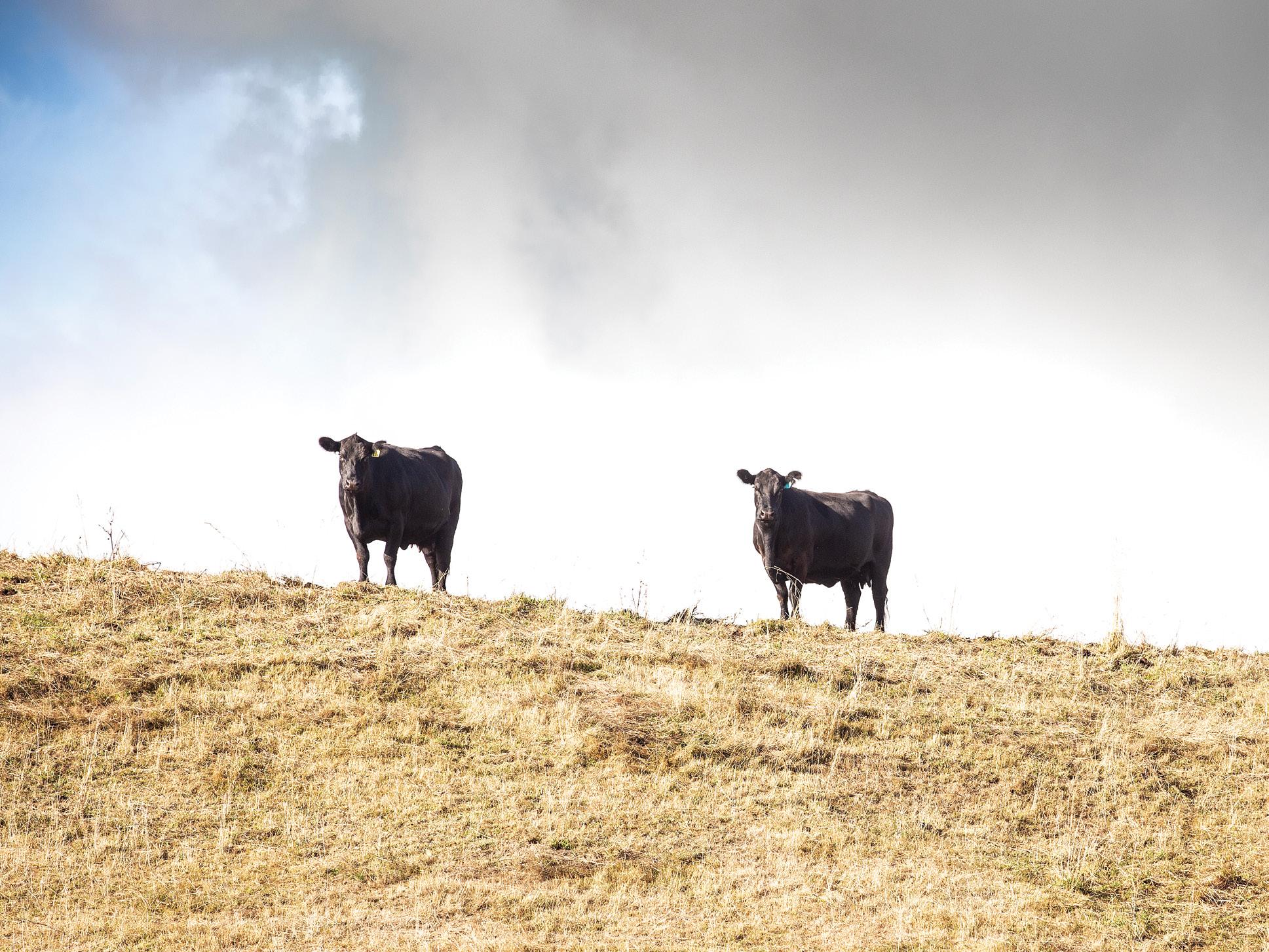
6 Country-Wide Beef | MAY 2023 CONTENTS MAY 2023 @COUNTRYWIDENZ 11 BOUNDARIES 12 HOME BLOCK MARKETS 14 America’s beef colossus 18 Challenges aplenty for exporters 22 EU: Troublesome barriers 24 Weaner calf prices strong 26 China’s market is changing BUSINESS/INDUSTRY 28 Weaners: It’s not just the sale price 33 Yearling bull sales 34 Right stock + feed = profit M BOVIS SERIES 36 Still waiting on MPI for answers ONFARM PROFILES 44 Manawatu: Making every minute count 54 Marlborough Sounds: Long lease builds top business 60 South Otago: Progress at Ben Annand 70 Gisborne: A Red Devon affair ANIMAL HEALTH
Making better use of data 80 Discussion groups best extension 82 Avoid breeding resistant worms 84 Dangerous eats in late pregnancy 87 The NZ beef oyster season 90 Difficult births, helpful solutions GENETICS 92 Selecting genes to reduce methane 96 Bid on genetics, not just looks 98 Proof that BCS lifts fertility 101 An eye for form and function
Future in youth
Wagyu worth the wait
Power of a database unleashed
Constantly tweaking the system RESEARCH
Best in beef research 2023 ENVIRONMENT
New regs for winter grazing
What’s the best fit for your farm?
CYCLONE
Cleaning up after Gabrielle
Opportunities from disaster
The power of nature
SOLUTIONS
FARMING IN FOCUS
IN YOUTH 106
testing has come a long way during the past decade, improving the accuracy of breeding values for yearlings.
78
SYSTEMS 106
118
122
130
136
140
144
POST
146
150
152
154
162
FUTURE
Genomic
44 MAKING EVERY MINUTE COUNT
Steve and Cheryl Hirschberg have three children, three farms and they still find time to participate in the Coast to Coast and Ironman competitions.
14 America’s beef colossus

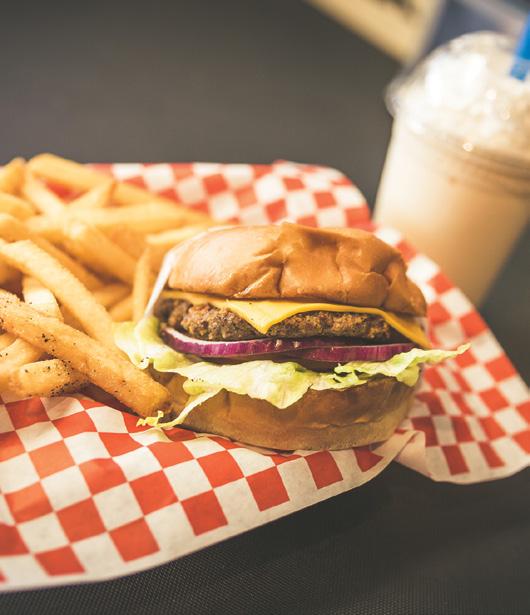
130 Constantly tweaking the system

By Country-Wide magazine
Published by NZ Farm Life Media PO Box 218, Feilding 4740 Toll free 0800 224 782 www.nzfarmlife.co.nz

Editor Terry Brosnahan 03 471 5272 | 027 249 0200 terry.brosnahan@nzfarmlife.co.nz
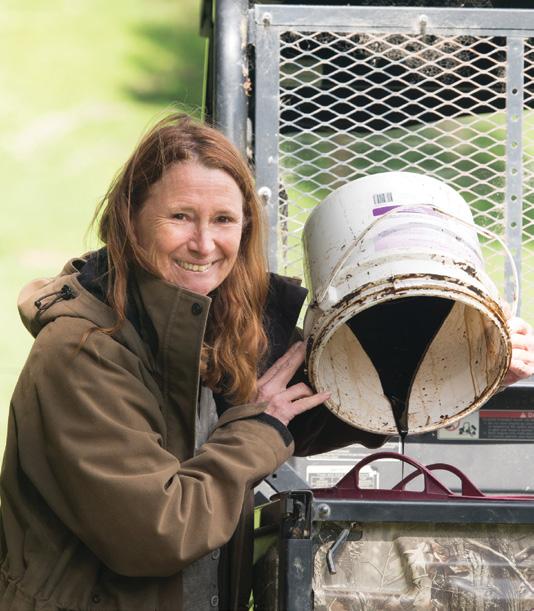
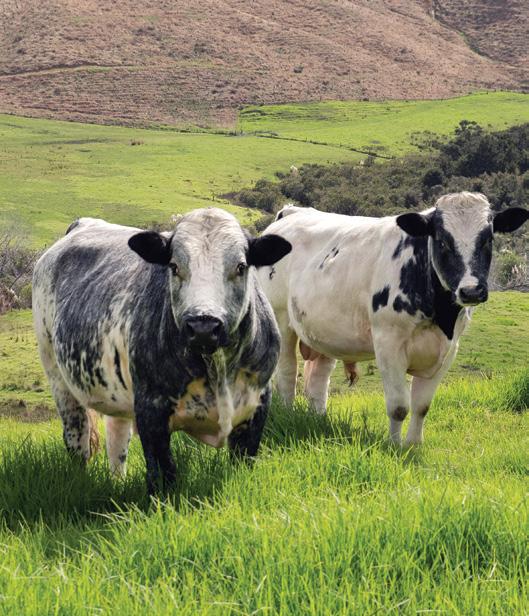
Publisher Tony Leggett 06 280 3162 | 0274 746 093 tony.leggett@nzfarmlife.co.nz

Sub editors Andy Maciver 06 280 3166 andy.maciver@nzfarmlife.co.nz


Alison Robertson
Designer Emily Rees 06 280 3167 emily.rees@nzfarmlife.co.nz
Production
Jo Hannam 06 280 3168
Writers
Anne Hardie 03 540 3635
Sandra Taylor 021 151 8685
James Hoban 027 251 1986
Jo Cuttance 03 976 5599
Joanna Grigg 027 275 4031
Glenys Christian 027 434 7803
Annabelle Latz 027 808 6469
Louise Savage 027 260 2750
Sarah Horrocks 027 555 7941
Partnership Managers
Janine Aish | Auckland, Waikato, BOP 027 890 0015 janine.aish@nzfarmlife.co.nz







Angus Kebbell | South Island, Lower North Island, Livestock 022 052 3268 angus.kebbell@nzfarmlife.co.nz

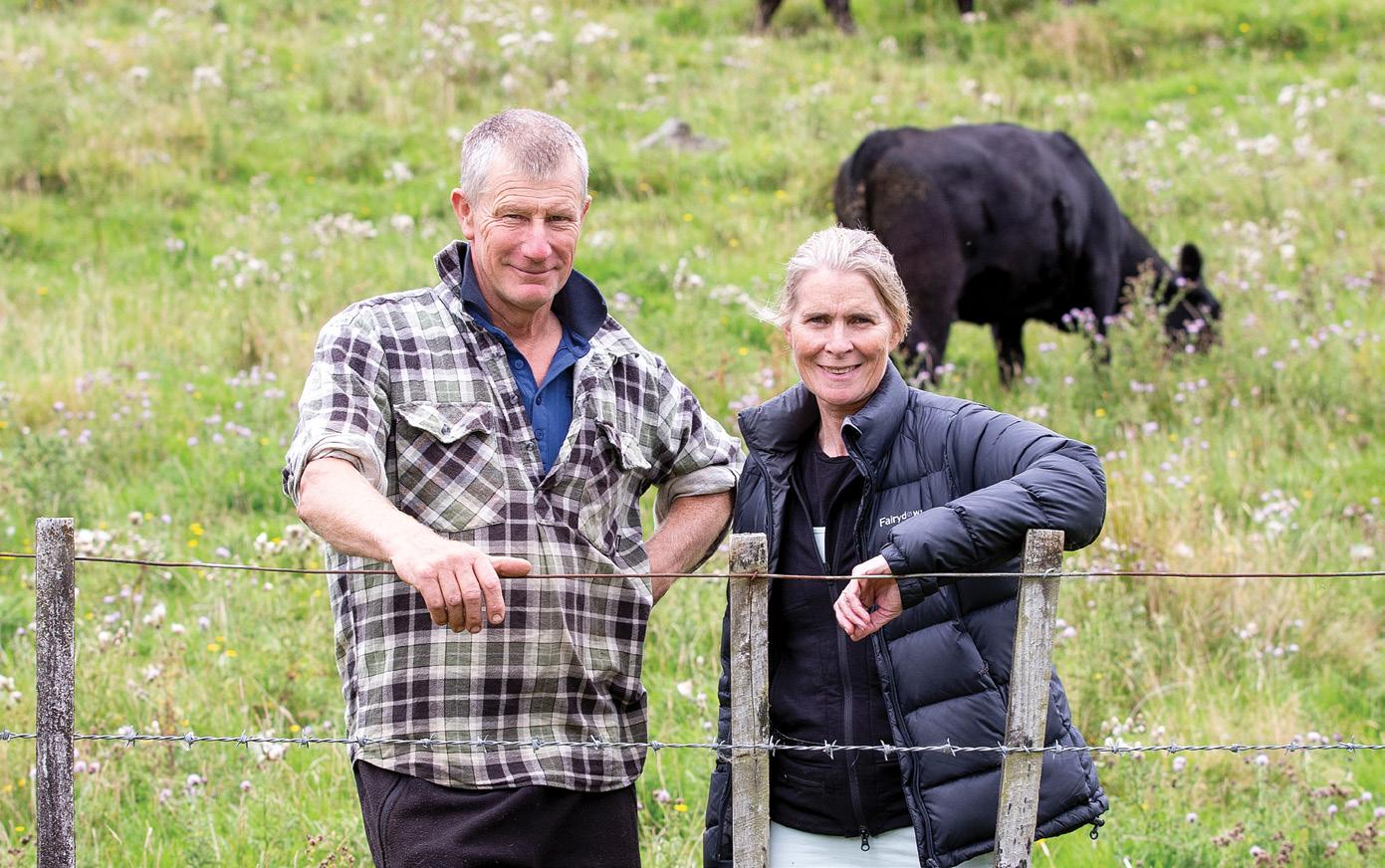
Tony Leggett | International 027 474 6093 tony.leggett@nzfarmlife.co.nz

Subscriptions


nzfarmlife.co.nz/shop 0800 224 782 subs@nzfarmlife.co.nz
Printed by Blue Star, Petone
ISSN 2423-0499 (Print)


ISSN 2423-0596 (Online)


Country-Wide Beef | MAY 2023 7
COVER DESIGN EMILY REES 70 A Red Devon affair 92 Selecting genes to reduce methane THE CASH
DEEPER. BETTER. INDISPENSABLE!
Join with the team at Country-Wide to take New Zealand’s premier farming magazine up a notch.
Just like you do in your own farming businesses, we need to adapt to maintain our premium position as your trusted provider of farming information to help you learn, grow and excel.
From next issue, we’re changing the frequency of Country-Wide to two-monthly and boosting the number of pages to about 120 per issue so we can deliver more of what you want in your favourite magazine.
You will continue to see the type of content Country-Wide is renowned for - on-farm excellence, cutting-edge research, coverage of new technologies and stories about the people who work on farms and agribusinesses around the country.
To complement this, we’re adding more indepth coverage of the key issues impacting farming families and businesses. We’ll also be looking at what’s happening further down the value chain so you can get a better feel for the future and how it impacts the farmgate price for your meat, wool and crops.
What will subscribers get?
Six issues of the Country-Wide each year, plus our regular special Beef and Sheep publications.
Regular content delivered through our email and social media channels, so you’re always up to date.
How do I subscribe?
It’s easy. Call our subscriptions freephone on 0800 224 782 and press option ‘1’ on your keypad.
Or visit our website at nzfarmlife.co.nz/shop and subscribe using your credit card, Farmlands or Ruralco cards are also accepted.
Or email subs@nzfarmlife.co.nz and one of our subscription team members will respond to help you through the subscription process.
8 Country-Wide Beef | MAY 2023
KEY FEATURES INCLUDE:
Full size concertina headbail with one side yokerubber lined, split gates operation side front hinged, full draft gate with draft handle, 19mm spring bolt latches, single side rear gate, floor fibre grate, Injecta gate, 75x75x3 SHS frame, sliding handle with bolt lock, drench pack hooks, top frame anti jump bar, scale lugs.

Visit technipharm.co.nz for more information

Country-Wide Beef | MAY 2023 9 BE
SUBSCRIBER AND
IN
DRAW
WIN If you are a subscriber before May 31, your name goes in the draw to WIN a brand new Technipharm Beefmaster Classic Cattle Handler valued at $12,500. Existing subscribers - enter using the QR code or visit www.nzfarmlife.co.nz/promotions/ 0800 224 782 subs@nzfarmlife.co.nz • www.nzfarmlife.co.nz Terms and conditions apply. Visit our website for details
A
YOU’RE
THE
TO
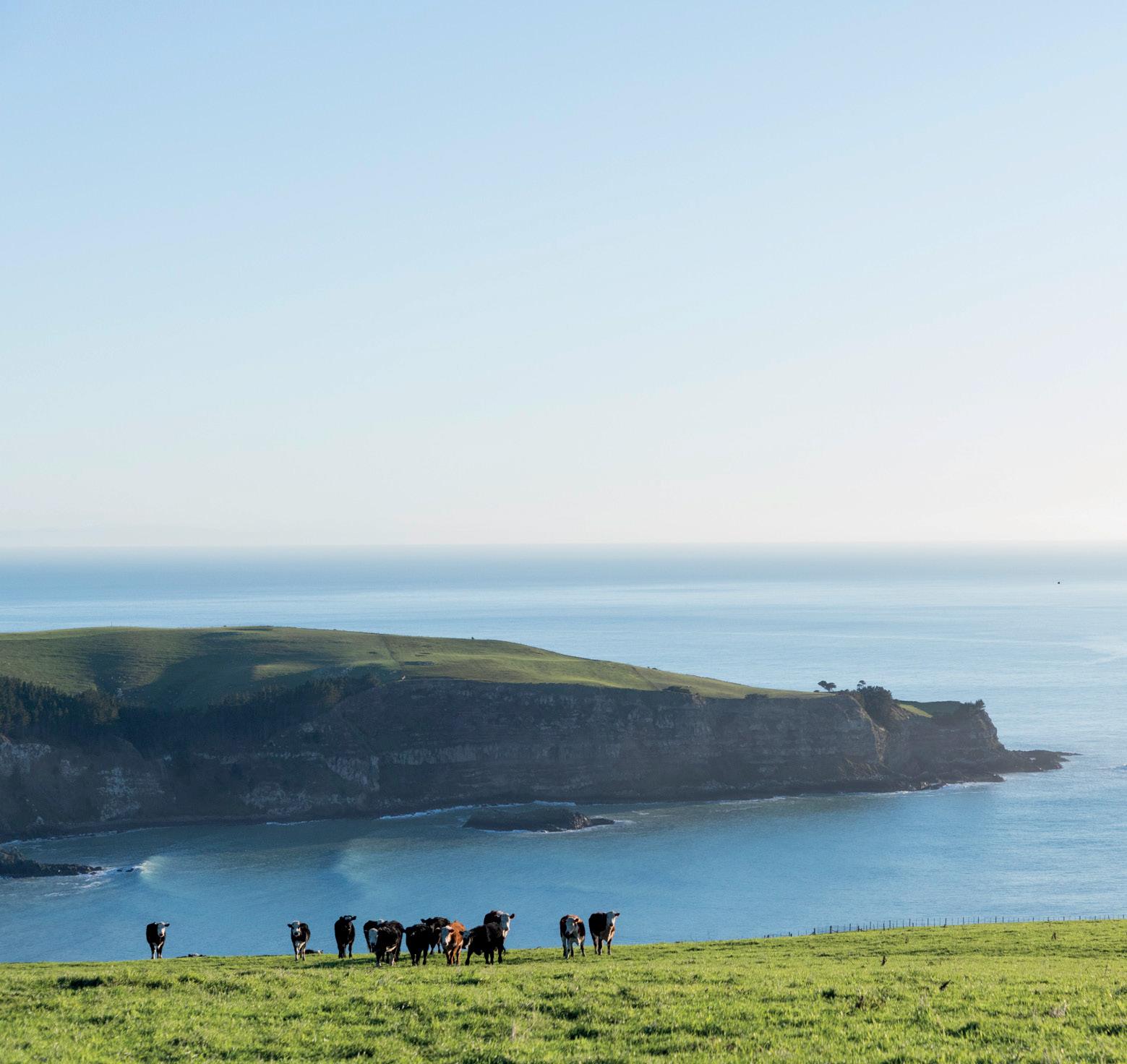
WATCH ME WALLABIES FEED MATE BALES4BLAIR
Slopedown sheep and beef farmer Amy Blaikie was the brainchild behind the Bales4Blair campaign, which involved farmers donating wool for the insulation and carpeting of the Southland Charity Hospital.
Through the initiative, farmers donated about 65,000kg of wool. With more wool donated than needed, the leftover wool was bought by Godfrey Hirst and proceeds donated to the hospital build.
Building the Southland Charity Hospital, due to open mid-2023, was the idea of Southland farmer the late Blair Vining who died of bowel cancer in 2019, aged 39.
Otago Regional Council ratepayers have paid $2.76 million and had more than 26,000 hours of work for a wallaby control programme that killed just 18 wallabies.

The Taxpayer’s Union says the Otago component of the national wallaby eradication programme administered by Biosecurity New Zealand cost an average of $153,422.72 a wallaby “destroyed” (terminology used by officials).
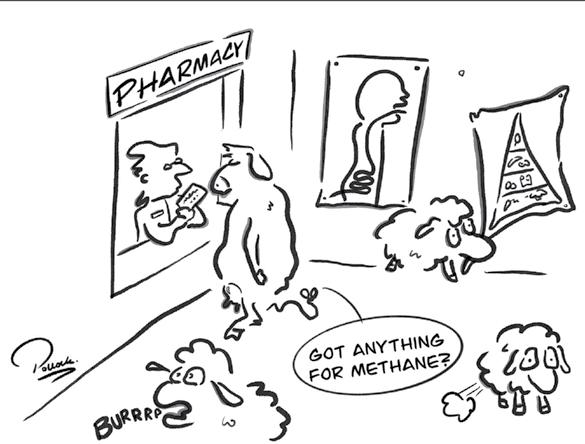
It averaged 1459 hours of human labour a kill with $341,894 spent on aerial shooting, $34,089 on ground
shooting, $71,028 on ground toxin and a staggering $2.3 million on surveillance.
By comparison, in Canterbury the cost for each wallaby destroyed was $763.57 and just under five hours of human labour.
The Union says it would have been cheaper to charter a private jet for each of these wallabies to send them back to Australia.
It had warned the $1.2 billion Jobs for Nature fund would be another slush fund with unmonitored, highcost, low-value spending.
Amy had met wool scouring industry people when she delivered a petition to Parliament in 2020 asking it to support wool.
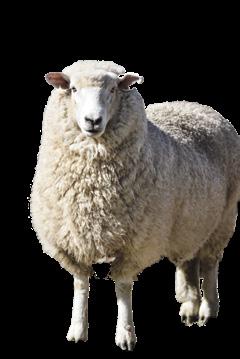
+ Read more p60
Easy money?
The Government has paid out $63m of taxpayers money through the Public Interest Journalism Fund Payments. See where the payments went.
nzonair.govt.nz/funding/journalismfunding/#funding-decisions
TWO-TOOTH WINNERS
Tapanui farmer Todd Perkins has won the 2023 Country-Wide West Otago Two-tooth competition. He scored 91 points out of 100.
Todd and his wife Amanda farm 3100 Romney-Coopworth cross ewes, 900 replacements and 120 breeding cows on 770ha.
Todd says the secret is good genetics with the ewes scanning about 179%.
The Perkins won $500 which they are donating to the Otago Rural Support Trust’ cyclone relief fund.
+ Read more on the Perkins in the June/July issue
Country-Wide Beef | MAY 2023 11 BOUNDARIES
Paul

loves his new dozer, but he’s struggling to grasp the concept of teamwork.
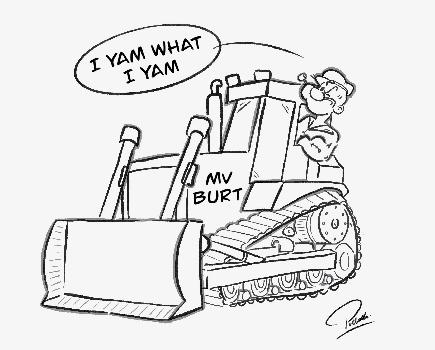
IT WAS THE MIDDLE OF THE night and I could only describe my condition as odd. The mother of all hangovers had descended upon me without invitation. I had been asleep but woke up saturated in a shearer’s sweat, not sure if my head was still attached. My joints simultaneously screamed for replacement and my stomach was messaging its plumbing north and south. Before the body acted on these signals I thought I’d better make a move. My blood pressure was dropping (so Dr. Google told me later) but I got most of the way to a place where the mess would be easier to clean up when I went down like a butchered bullock.

They say even non-believers turn to God at the end. I was aware of a heavenly glow (the bathroom light to a healthy man) and then I had a vision. An angel with an affro
appeared. As I came to, I realised it was just Louise standing over me. Despite, at the end of the financial year briefly wishing Louise was an accountant, I was never more pleased with my choice of a nurse and a very good one at that.
That episode was a while ago and I’m back to doing what I enjoy each day. For me that still includes a lot of farming but balanced by trying to minimise the mundane. That’s where Louise comes in. I keep reminding her that we are a team and she keeps saying there is no ‘I’ in team. Apparently I am not a good team player. Years of working on my own have blunted my communication skills and I’m told instructions are issued more like working dog commands than appeals for help. I always praise Louises’ own occupational abilities. She has patched me up with skill and compassion on a number of occasions but when I add that I know more about farming (intimating that she should listen) I get the “you know where you can shove that” look.
Despite me not being “right” as much as I would like, together, we still get things done and I hope this will be the pattern as we see out our productive years. Part of the process is learning that
there is a lot of give and take in a team. Last year, I succumbed to another illness but the only attribute Louise displayed was tolerance. I suffered a bad case of ‘Iron Disease’. (I didn’t want to reach my death bed wishing I had upgraded my bulldozer.) I made a purchase with all the thrill of being in love for the first time (better make that second time in the interests of domestic stability). The machine is, fittingly, a golden colour. Things have to be in balance for harmony in the team, but in this case it will take years to square the ledger. My feeble arguments describing the Komatsu as a working asset and a wise investment fall on deaf ears. The joy of operating the dozer is tempered by the dread of a major breakdown forcing me to take out a personal loan and learning to sleep by myself. It’s hard to portray to a non-believer the sheer exhilaration of shaping the earth with a bulldozer or digger. Peeling soil off a steep hillside and creating a road where there was none before has a status (to addicts) above mere work, although you never admit that at home.
“Peeling soil off a steep hillside and creating a road where there was none before has a status (to addicts) above mere work, although you never admit that at home.”
However, it’s just as well machinery operation has these highs as it helps you forget the down side. Like getting stuck, disturbing wasp nests and the rare occasions that result in a change of underwear. Not to mention the potentially eye-watering repair bills especially with older gear. Despite the dramas, life is too short for lingering regrets and I’m much happier than if I had bought a boat.
12 Country-Wide Beef | MAY 2023 HOME BLOCK
Burt
Bulldozer better than a boat
Matata
A little help at harvest
addiction to Wordle we ought to be worried about. The vaping 19-year-olds fuelling their day drinking V are small fry, it’s the dementia-dodgers that are the ones to watch. Busy tallying their micronutrients, counting their steps and keeping a close eye on the NZX app, I’m convinced they’re the ones the Productivity Commission ought to be rounding up.
IT HAS BEEN SELLING season in the Rakaia Gorge. Lambs and calves are loaded daily, off to Canterbury Plains’ irrigated greener pastures for final finishing. It’s a time of pleasure and pride –seeing animals sent off in the best condition the season allows while reaping the financial reward.
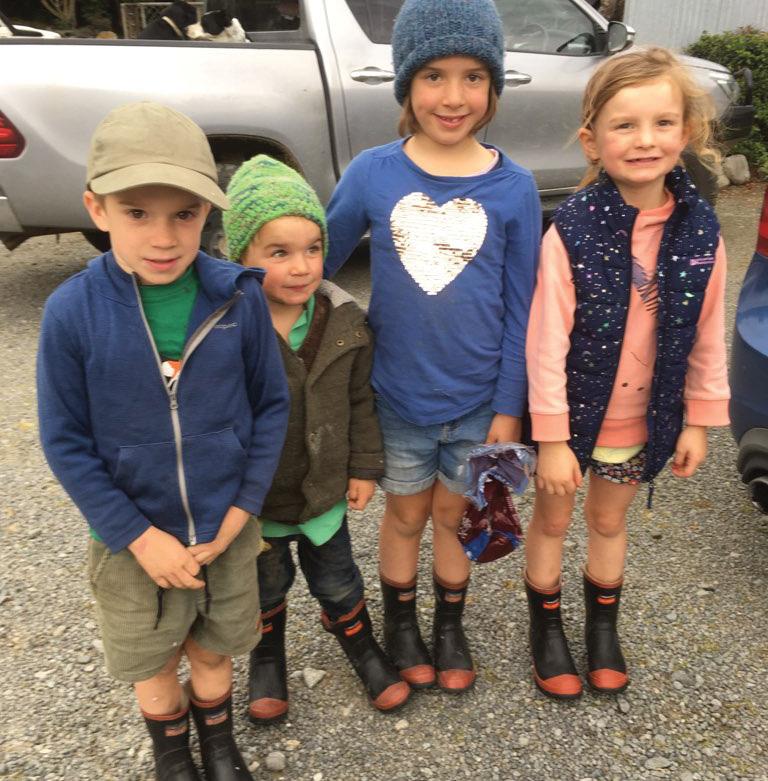
As is typical of harvest time, hard work precedes the outcome. As we all know, mustering, drafting, weighing, crutching, feeding and trucking takes considerable time, effort and resources. We’re no strangers to the time and effort, but resources have become something of a challenge. Just where have all the people gone?
There’s many a stock agent, truck driver and shearer working long hours to get through the workload. Many blame Covid, some the tech industry, others immigration policy. But me? I put the blame squarely at superannuitants. By crikey it’s hard to find a Gold Carder with a decent work ethic these days. They’ve really taken the ol’ flexible hours and ‘work’ from home bizzo by the horns haven’t they?
Forget the problems with youth of today constantly checking their Insta feed, it’s the oldies’ prolonged
Here at Middle Rock, my superannuitant parents appear to be ethically opting for a similarly low-emission workload. The Boss has gone from a 70-hour week to working every second week. For 73 years the foreign concept of work-life-balance has been kept at bay, with the construct of flexible hours a mere metaphor for working dawn ’til dusk daily. And now, timing it perfectly for every other Insta-updating TikToking V-slugging option to have vanished, he’s discovered the merits of semiretirement.
The Chief Inspector isn’t much better – she feigns reluctance for yet another ‘mini-break’, suggests a ‘staycation’ purely as it’s a newly acquired term, only to be last seen merrily e-bike riding off into the sunset with her knight in goldcarded armour.


Desperate times have called for desperate measures: the selling season must proceed and, with it coinciding with school holidays, I’ve called in the Blowfly gang.
The Blowflies, otherwise known as our own and other small children, are renowned for their incompatibility with sheep, consistently appearing from nowhere to be in the wrong place at the wrong time, with endlessly irritating noise in tow. But brandishing neither smartphone nor gold card, not even an IRD number in fact, they’re rapidly becoming the go-to workforce of choice.
Zero-hours contracts are a cinch with none yet able to read the
time. Nonetheless, all seem to have an innate grasp of workers’ rights. After a tough round of negotiations, remuneration now comes in the form of Nutella sandwiches though their performance seems to have a correlation to being paid nuts.
Other KPIs show additional cause for concern. Workplace bullying appears to be on the rise, with various shearers harshly rebranded as ‘Singly Pingly Man’, ‘Mr Undies’ and ‘Stinky’. Graffiti has also been an ongoing issue, with several truckies commenting they’d never seen so many unicorns drawn on ASD forms. As a side note, this does raise the issue of just how many unicorns are indeed drawn on the average ASD form, but I diverge.
Having solved my resourcing issue, I’m sincerely hoping this month’s Budget stalls the education overhaul and announces policies to give poor ol’ wayward youth a break. Let’s leave them to live their ‘best life’ and instead redirect truancy officers in pursuit of the nation’s grey nomads. What’s the bet they’re all loitering round the back of the EV charging stations swapping Code Cracker clues.
Country-Wide Beef | MAY 2023 13
Charlotte Rietveld has lost control of the olds and has had to recruit the young ones in the stock yards.
“Forget the problems with youth of today constantly checking their Insta feed, it’s the oldies’ prolonged addiction to Wordle we ought to be worried about.”
Rakaia Gorge
The Red Band Blowfly gang: Ralph 5, Ed 3, and Lucy Rietveld 7, with Harriet Richards 5.
Editor and publisher of Cattle Buyers
Weekly Steve Kay examines the state of the United States beef market.

COLOSSUS America's beef
Igrew up on a mixed livestock farm on Banks Peninsula. My family raised dairy and beef cattle, sheep and hogs on acreage that went from sea level to 2000 feet. I thus developed a great love of animals, including dogs and horses, from a very young age. My Dad was especially proud of the beef cattle he raised. He used top-quality Hereford bulls to mate with purebred Friesen heifers from the dairy herd. The result was a handsome mix of colours, from Hereford to black/white face to pure black.
My abiding memory of Dad was when he haggled with Barry, the cattle buyer from Christchurch, when it came time to sell cattle. Dad would ask a certain price and Barry would reply: “Mr. Kay, I can’t give you that much because of the darned American market.” Little did I know that years later I would start a newsletter called Cattle Buyers Weekly (CBW) and write every week about the United States (US) market.
I have written CBW for the past 35 years and have been privileged to watch a colossal industry transform itself from producing beef that was often inconsistent in
quality to producing the highest quality beef in the world. The industry’s productivity advances have also been enormous. The US in 1975 had 132 million cattle and calves and produced 24 billion pounds (10.9b kg) of beef. The industry in 2022 had 92 million cattle and produced a record 28.3b pounds (12.86b kg) of beef.
The industry is so enormous and diversified geographically that it has overcome every challenge it has faced in the last 50 years. These challenges have included: severe to extreme drought every 10 years or so; federal government interference in the beef market in the 1970s; the discovery of the E.coli O157-H7 pathogen in ground beef in 1993; the US’s first case of BSE in 2003, which shut all export markets for some time; and the Covid-19 pandemic.
The US meat and poultry industry faced unprecedented challenges due to the pandemic. These included labour shortages and supply chain and transportation disruptions that sharply reduced production at times. This led many in the beef industry and politicians to claim the industry needed more
Country-Wide Beef | MAY 2023
Cattle and calves on feed for the slaughter market for all feedlots on January 1 this year totalled 14.157 million head.
beef processing capacity. This was despite the fact it has ample capacity (135,00 head a day, by my calculation). The US processed 33.68 million cattle and calves in 2022.
Numbers dropping
Beef processing firms made record large profits because the reduced supply of beef could not keep up with strong demand at home and abroad. But such results are unlikely to be repeated in the foreseeable future. To the contrary, beef processing margins in 2023 and 2024 will be extremely small and might be negative at times.
This is because the supply of grain-fed cattle will decline sharply in 2023 and 2024. This year’s January 1 US cattle herd total was down 2.8 million head or 3.0% from January 1 last year to 89.27
million head. This was the lowest cattle inventory since 2015.
Drought caused the US cattle herd to shrink in each of the last four years. Last year’s big decline was also due to high input costs at ranch level. These factors forced producers to liquidate some of their beef cows. The first quarter of this year saw timely rains in many regions, so herd liquidation might end this year. However, any meaningful herd rebuilding might not begin until late next year or early 2025. When it does, fewer heifers will enter feedlots, further tightening cattle supplies for cattle feeders and grain-fed beef processors.
The January 1 inventory report saw beef cows total 28.918 million head, down 3.6% or 1.063 million head from a year ago. Beef replacement heifers at
5.164 million head were down 5.8% from a year ago. The US Department of Agriculture (USDA) estimated the 2022 calf crop to total 34.465 million head, down 2.0% from the previous year's calf crop. Every number points to a smaller herd and better margins for ranchers with beef cow herds (who are called cow-calf operators).
On the feedlot
The American beef colossus is also seen at the feedlot level. Cattle and calves on feed for the slaughter market for all feedlots on January 1 this year totalled 14.157 million head. These cattle were in 26,093 feedlots, of which 24,000 were fewer than 1000 head in terms of capacity. Total one-time feeding capacity was 17.1 million head.
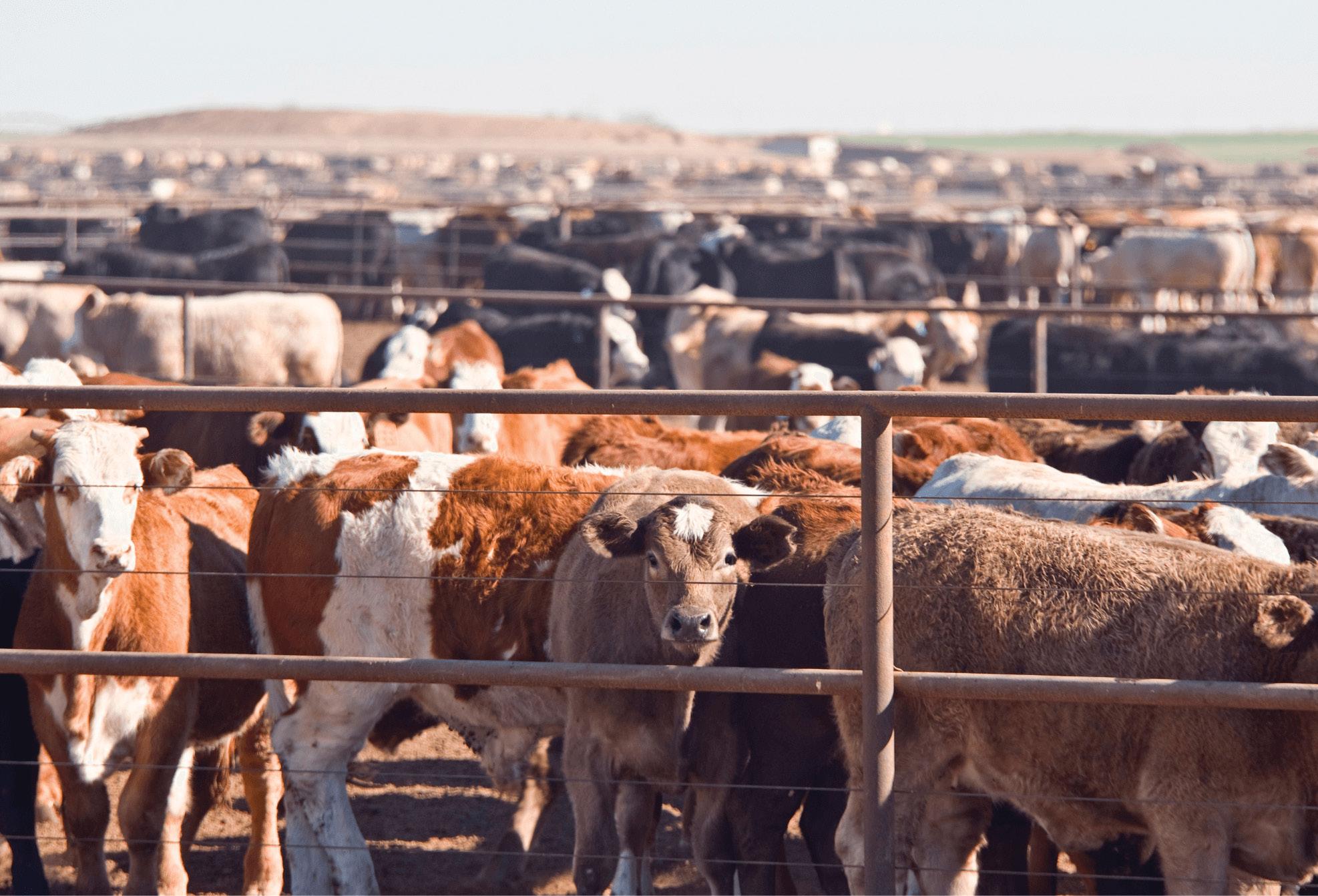
It is also important to note the vital contribution that dairy animals make to the US beef supply. On January 1 this year the US had 9.4 million dairy cows and another 4.3 million milk cow replacement heifers. The culled dairy herd produces beef in two ways: middle meat cuts and lean manufacturing beef. The latter is blended with fatty trimmings from grain-fed cattle to produce numerous ground beef products.
The second source of beef is through the raising of calf-fed Holsteins. Programmes developed in the 1970s are the same today. A calf raiser takes a day-old steer and raises it on a special ration until it is 350-400 pounds (159-182kg) and is then put in a feedlot on a regular ration. Once finished, these animals grade a very high percentage of USDA Prime and Choice. Their beef is also sought after for being of very high consistency. I have long-wondered why the New Zealand industry has not developed a similar programme to get more value out of its bobby calves.
US annual meat and poultry
Country-Wide Beef | MAY 2023 15
MARKETS UNITED STATES
“I have long-wondered why the New Zealand industry has not developed a similar programme to get more value out of its bobby calves.”
Fast growing/high producing stock grazing new pastures, crops or supplementary feed are more vulnerable to clostridial disease and sudden death.1,2

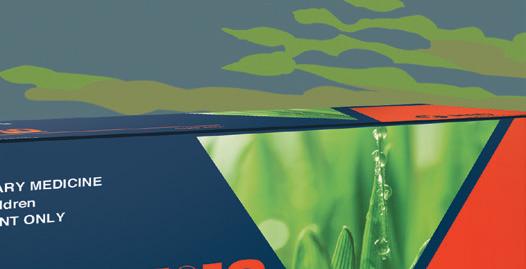
That’s why we created Covexin®10. Made here in New Zealand specifically for our conditions, Covexin 10 offers the most comprehensive clostridial protection available on the market today. Talk to your vet about upgrading to Covexin 10 and get peace of mind that you are providing the best clostridial protection for your stock.

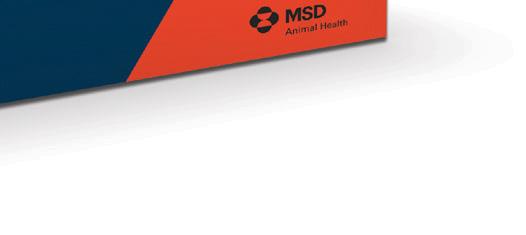
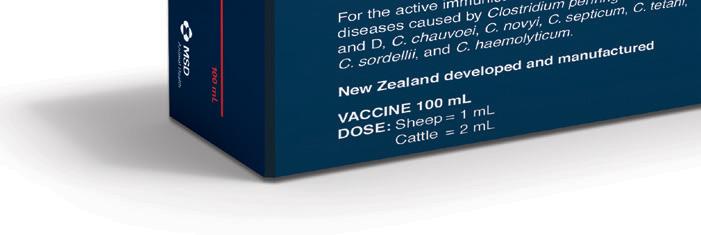
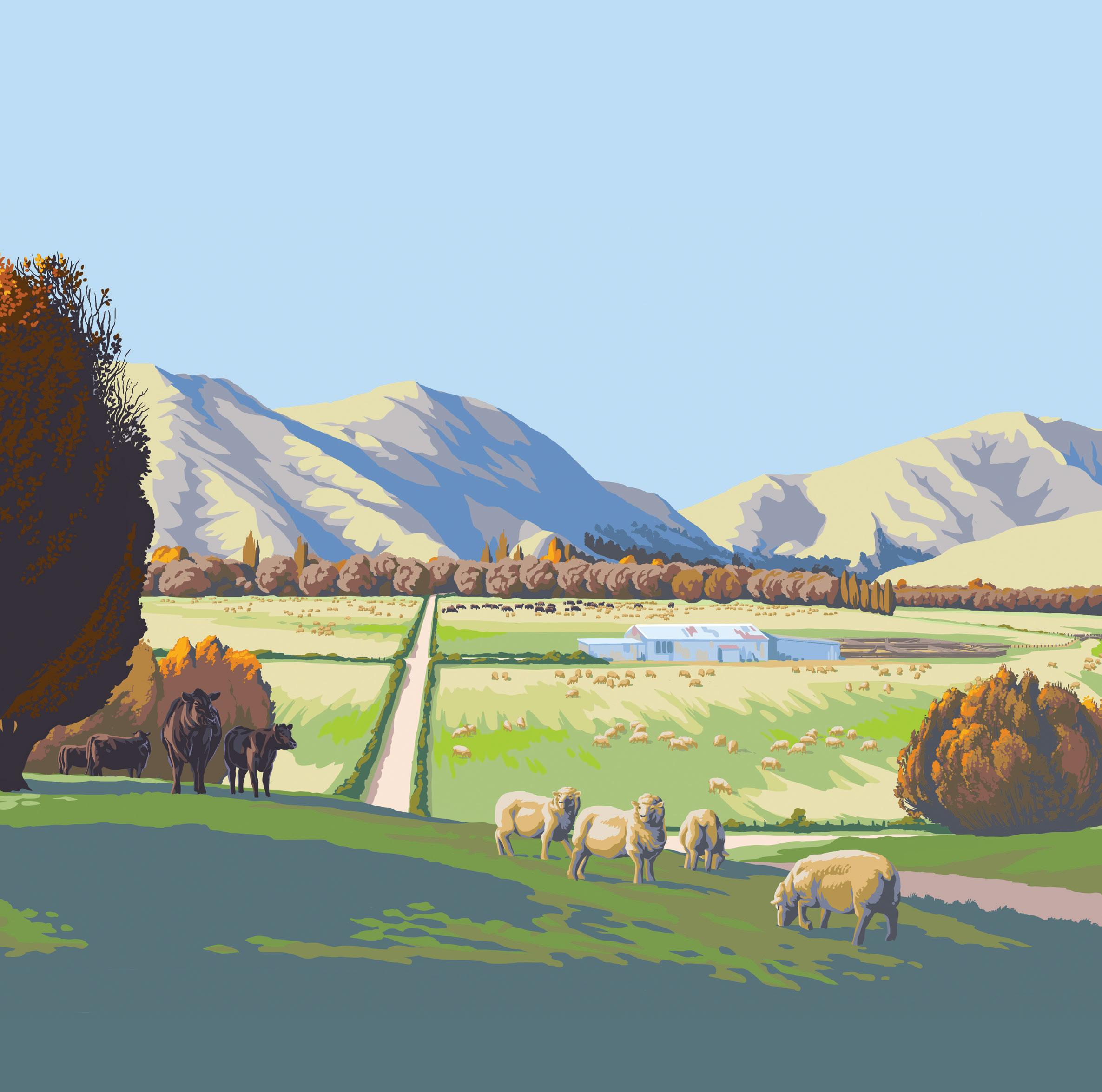
ASK FOR COVEXIN 10, THE PREMIUM 10-IN-1 PROTECTION



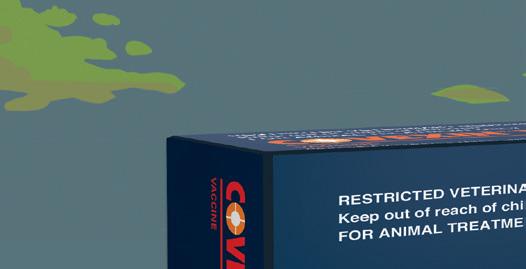
NOW AVAILABLE IN A LARGER 500ML PACK VAXIPACK® RECYCLING LEARN MORE Unsurpassed 10-in-1 clostridial protection AVAILABLE ONLY UNDER VETERINARY AUTHORISATION ACVM No: A9028. Schering-Plough Animal Health Ltd. Phone: 0800 800 543. www.msd-animal-health.co.nz NZ-BOV-221000001 © 2022 Merck & Co., Inc., Rahway, NJ, USA and its affiliates. All Rights Reserved. 1. Lebrun et al (2010) Cattle enterotoxaemia and Clostridium perfringens. Veterinary Record 167, 13-22. 2. Lewis (2011) Control of important clostridial diseases of sheep. Vet Clin Food Anim 27 (2011) 121–126.
SCAN QR CODE to read a farmer testimonial
production is further evidence of the industry’s size. Total red meat and poultry production this year will decline for the first time in a decade to just over 107 billion pounds (48.5b kg), USDA says. Pork production will increase 2% and broiler meat 1%, but beef production will decline 5.7% due to the sharp decline in cattle numbers. USDA forecasts 2023 beef production will total 26.665 billion (12.1b kg) against the record 28.290 billion lb (12.8b kg) in 2022.
All wealth to the beef industry comes from consumers, so it is notable that beef demand at retail and food service remains robust despite an increase in food inflation over the past year. Beef has an advantage over pork and chicken at retail as average prices are trending below year-ago levels, while pork and chicken prices are trending above. Beef prices are at their most competitive in relation to the competing meats since 2017.
US consumer demand for beef, pork and chicken was strong before the onset of Covid-19 in early 2002 and became even stronger as Americans stayed at home and cooked a lot more. Beef was the biggest winner of all the meats, as consumers sought a “meat treat” in exchange for not being able to eat out for many months.
Beef retail prices eventually reached record high levels in October 2021. USDA’s All Fresh beef price averaged US$7.55/pound (NZ$5.48/kg) and its Choice price averaged US$7.90/lb ($NZ5.73/kg).
They began to decline after that and in February this year averaged US$7.23 and US$7.59/ pound (NZ$5.25/kg and $5.51/ kg), respectively. These were down
The beef industry is so enormous and diversified geographically that it has overcome every challenge it has faced in the past 50 years.
slightly from a year ago. Prices will increase this year but will not reach the record levels of October 2021. Consumers are unlikely to be fazed by higher prices, as they already faced them in 2021.
Demand for the good stuff
Of special interest is that retail demand for high quality beef remains strong. The two largest sellers of USDA Prime beef, Costco and Walmart, both report that sales are robust. This is reflected in the price spread between the Prime and Choice beef wholesale cutouts reported by USDA each week. For the week ended September 23 last year, the spread was an all-time record of US$91.46 a cwt (50kg) or NZ$1.83/kg. The spread recently has been US$38 to US$40 a cwt (NZ$ 0.76 to $0.80/kg).
Beef exports were one of the top stories in the US beef industry last year. They topped US$1 billion (NZ$1.6b) in value most months and totalled a record 1.47 million metric tonnes (mt), up 2% from the previous high in 2021. Export
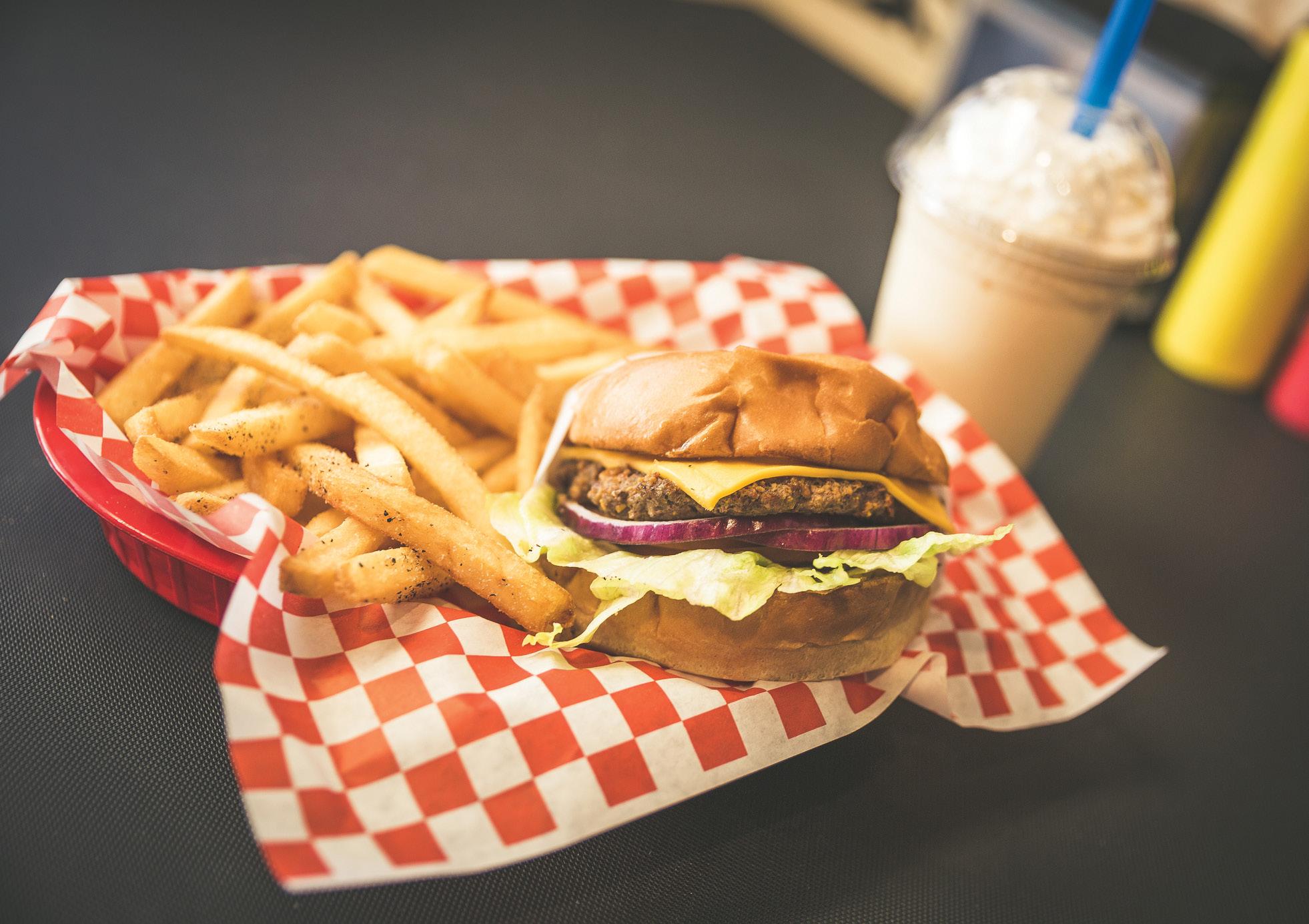
value climbed to a record US$11.68 billion ($NZ18.6b), up 10% from 2021.
However, exports slowed as the year ended and fell sharply in January versus a year ago. January volume fell 15% year over year to 100,942mt, which was valued at US$702 million or NZ$1.12b (down 32%). Beef inventories swelled in some key markets near the end of last year, contributing to a challenging environment for US exports, says the US Meat Export Federation.
USDA forecasts US beef exports will be down 12.6% in 2023 versus 2022, although many question this decline as total US beef production will be down only 5.7%. The big question is whether this will force buyers of US beef to accept higher prices than they did in 2022 because no other countries will be able to make up the shortfall in US grain-fed beef supplies. US beef imports will increase by 1% this year, says USDA, and I will be watching closely to see if more NZ beef arrives here.
Country-Wide Beef | MAY 2023 17
Challenges aplenty for exporters
Export markets are improving for New Zealand beef, but consumer behaviour in China has not returned to pre-pandemic levels, there’s continual competition from other countries, and people’s tastes are changing. By Glenys
Christian
.
Shipping and labour disruptions caused by Covid are still affecting all markets.
Meat Industry Association chief executive Sirma Karapeeva says New Zealand’s exports to China grew by 4% in 2022 to 219,000 tonnes and their value lifted 34% to $2.1 billion.
“But the recovery is remaining somewhat underwhelming. The Chinese consumer is remaining cautious and their revenge spending, which was predicted, isn’t really happening as they’re concerned about their jobs and income.”
There are predictions of 4.4% growth in the overall meat market for the coming year, as well as a growing shift from pork to beef and other meats. The Chinese government has been pushing consumers away from pork as a reaction to the African swine fever outbreak, meaning there’s less on the market – a “really positive” sign for NZ beef. And with another more recent outbreak, this could well lead to beef exports growing later in the year.
After a challenging last quarter for New Zealand beef exports in 2022 and a slow first quarter this year, Alliance’s category director for beef Darren Drury says the situation is looking a lot steadier than it has been in recent times.
“And we need that. It won’t be all plain sailing.”
Prices peaked in June and July last year but then tapered off by 20–30% by September, due to the Chinese government’s continued strict Covid
control measures, which restricted economic activity as its citizens weren’t able to leave their homes.
“Given the scale of uncertainty associated with the situation, many partners began to slow their demand commitments as they sought to work out the future market needs,” Drury says.
China picks up
The end of January saw the most normal Chinese New Year holiday period for some years with people travelling to their families as well as eating out.
“That gave the economy a bit of a boost.”
By early February, prices had recovered by about 10% and have been steady since then.
“But the market feels flat,” he says.
“There’s no real dynamism. Consumers are becoming more discerning. They’re epidemic-weary and a new normal is for them to take a conservative approach. We’ve got to be very focused on the right cuts at the right value so a full range of markets is necessary.”
Silver Fern Farms (SFF) sales general manager Peter Robinson says China is slowly seeing a return towards more normal activities around dining, such as the restaurant trade.
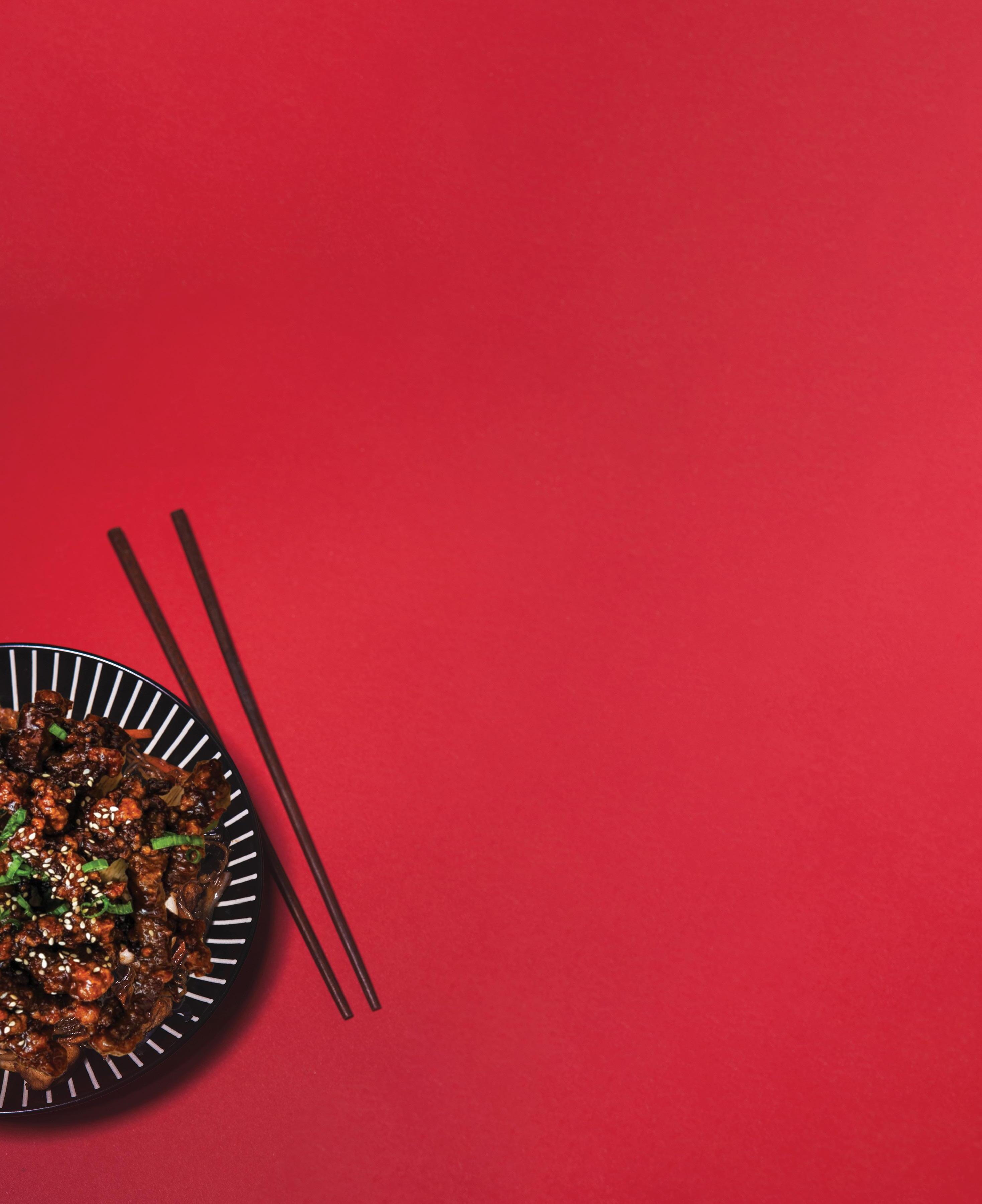
“But there are still elements of conservatism.”
SFF had been part of the Taste Pure Nature programmes in China in the past year, along with its own-branded promotional campaigns, and the approach will continue this year.
Close competition
ANZ agriculture economist Susan Kilsby says with Australia well through its herd rebuilding phase, there could be greater competition in the Chinese market.
Brazil’s beef trade was halted due to an incidence of BSE, but access was regained in early April this year, along with four new plants being certified to supply the market, the first since 2019.
Rabobank’s Beef Quarterly says Brazil
18 Country-Wide Beef | MAY 2023
EXPORTS
achieved record export volumes and returns in 2022, thanks to growing Chinese demand. It’s forecasting total beef production to be steady in the first quarter of the year with a 5% lift in Australian production. And with an expected 2% increase in Brazilian production, that almost offsets declines in beef in the US, Europe and NZ.
Karapeeva says Brazilian exports to China sold at a lower price point but are expected to grow. However, NZ is sending higher quality and differentiated product as it is grass-fed rather than grain finished.
“And NZ is trying to make more of a bigger deal of our lighter environmental footprint.”
Other Asian markets of Korea, Japan, Taiwan, Thailand and the Philippines are important for diversification. Robinson
says Japan is valuable as a chilled market, servicing the retail and food service sectors, particularly with cuts, such as tenderloins, striploins and cube roll. Japan, Korea and Taiwan offered viable alternatives when the US and China powerhouses came under pressure with their own lockdowns.
“They remain important from a competitive market angle, but they also have the potential to be a bigger part of our differentiated beef programmes, such
as Reserve, Angus and Net Carbon Zero,” Robinson says.
After the US set records in both volume and value for beef exports last year, there’s now a contraction in production with beef cow numbers the lowest since 1962 and feedlot numbers down.
Karapeeva says while NZ’s leaner grass-fed beef complemented domestic production, there had been a slight decrease in imports in 2022. But a 1.5–2% increase is now forecast, as domestic herd rebuilding drove stronger demand.
Drury says Alliance has seen clear data for the past six to eight weeks that US domestic slaughter is tightening as farmers are growing what they can and holding off sending their cattle for slaughter. There had been a small appreciation in grinding beef prices, which were high early last year, fell in the middle and didn’t recover until late 2022.
“Now there’s a slow and steady increase with high US$2 a pound for lean meat being paid.”
There’s still good demand for grassfed beef with consumers ready to pay a premium for this attribute, as well as antibiotic-free status and growth hormones not being used in NZ beef’s production.
Grass-fed getting a push
Robinson says stronger demand for NZ beef is expected over the next six months as large domestic inventories dwindle,which should mean good price growth. Grass-fed beef is creating a following, but consumers are wanting to go further in their buying decisions as they consider ‘better for me’, ‘better for the planet’ options. SFF believes this has created an opportunity for Nature Positive beef options, starting with products like Carbon Net Zero Beef, but these are likely to develop even further in the future.
With B+LNZ, the Taste Pure Nature campaign has billboards on the US West Coast espousing the benefits of NZ’s grass-fed beef, and telling consumers where to buy it locally.
Karapeva says the European Union (EU) free trade agreement (FTA) is delivering a smaller amount of access
Country-Wide Beef | MAY 2023 19
Oct Dec Feb Apr Jun Aug NZ average beef price into China (excl. veal, NZ$/kg) 11 10 9 8 7 6
Grass-fed beef is creating a following, but consumers are wanting to go further in their buying decisions as they consider ‘better for me’, ‘better for the planet’ options.
5-year average 2021-22 2022-23 NZ beef exports (Jan - Mar, thous. tonnes) 60 50 40 30 20 10 0 5-year average Last year This year
Source: AgriHQ
China/
Japan Sth Korea Taiwan US
Source: BLNZ
HK
Other Canada
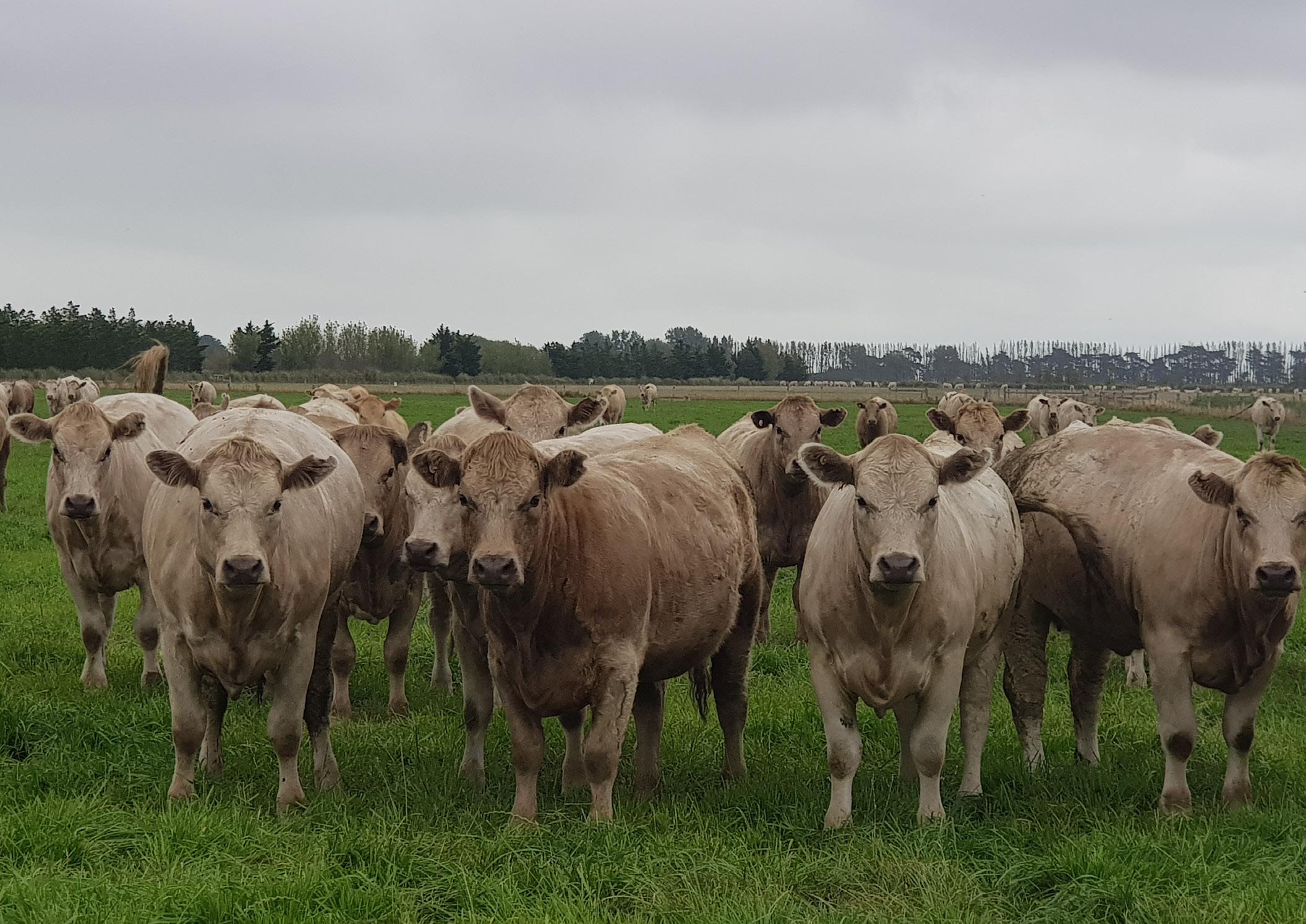
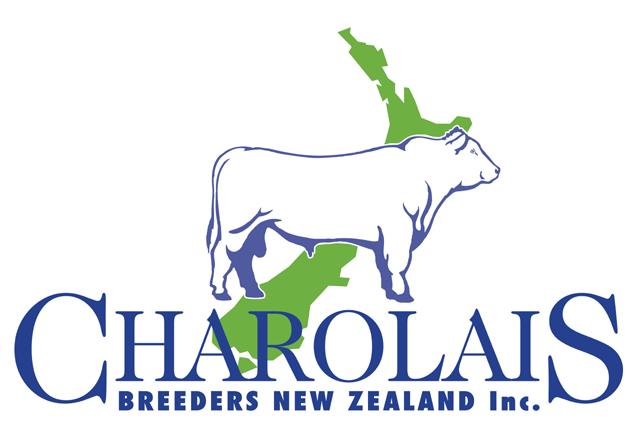
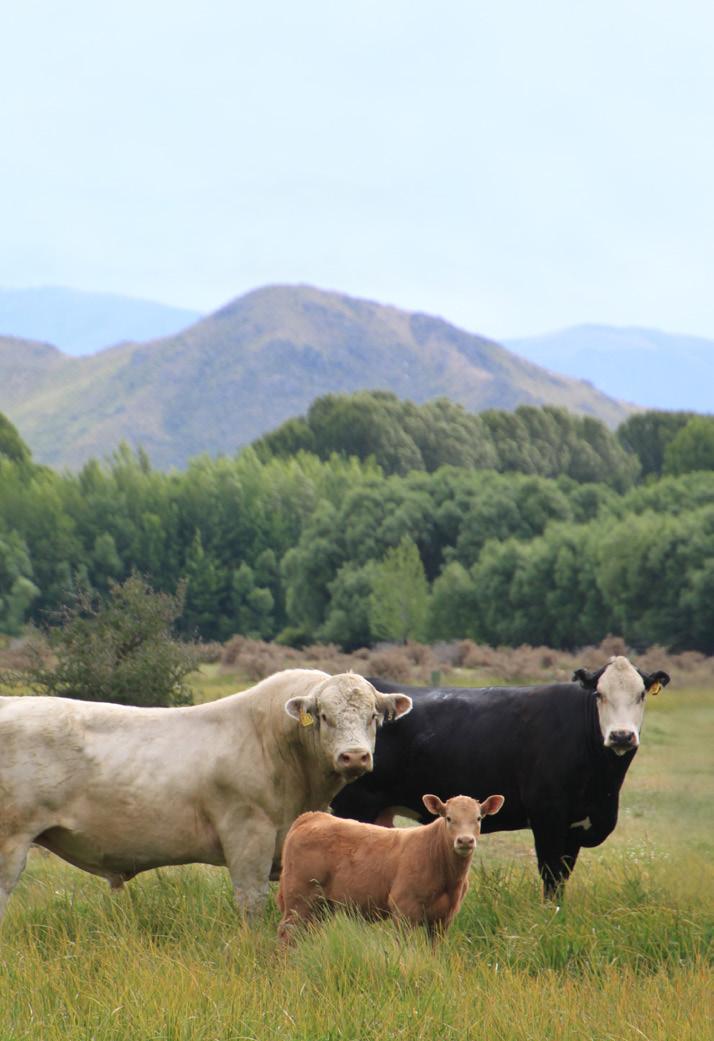
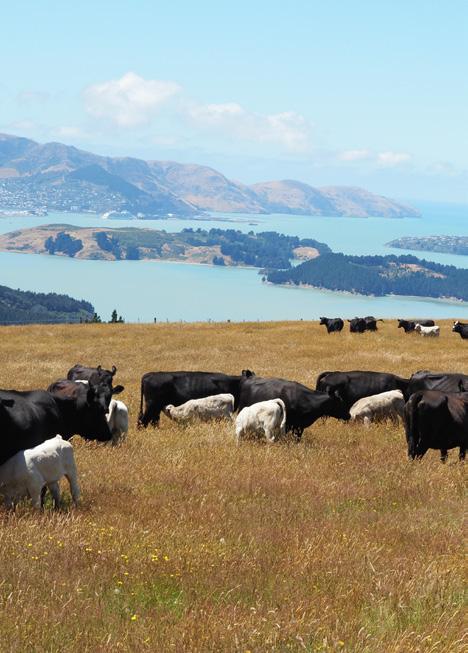

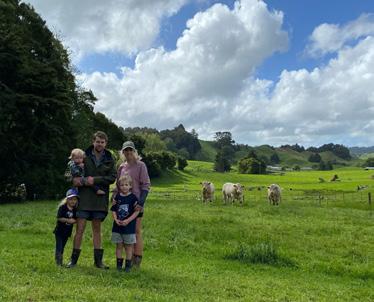
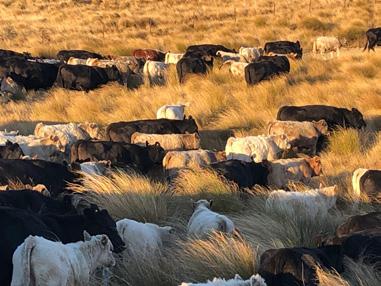
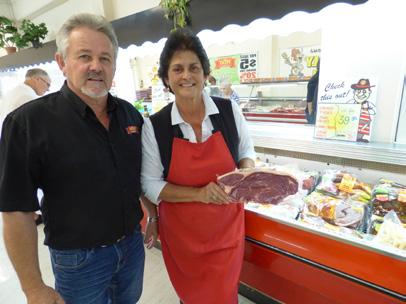
www.charolais.net.nz FB & INSTAGRAM@charolaisbreedersnz
CHAROLAIS PREMIUM -IMPROVED PERFORMANCE -BIGGER WEIGHTS
FINISHING
DRESSING PERCENT -MORE PROFIT ZEALAND 2023 CHAROLAIS MAGAZINE2023 EDITION THE OFFICIAL PUBLICATION OF CHAROLAIS BREEDERS NEW ZEALAND CHAROLAIS BREEDERS NEW ZEALAND 2023 Hard Work Pays Off STORY AND PHOTOS BY EMMA OWEN Tom and Stella have worked extremely hard to get themselves into land ownership the Banks Peninsula. Both have come from an urban background but are really passionate about the farming industry and what they do. Bank Peninsula will always be home for Tom Magill. Growing up in Lyttleton, Tom had an urban based childhood, but got taste of farm life when his father took him to friend’s farm at Purau to go shooting and help with general farm tasks such as tailing. It was pretty clear to Tom from an early age that agriculture was his future. When he left school, Tom got the opportunity to work week about, alternating between two properties in close proximity to each other, on the Banks Peninsula. With no real prior experience, this gave Tom the chance to learn from two top operators, developing his practical skills and set him in good stead for bright future in the industry. When Tom was 19 he took on his first lease, 35ha property where he ran 200 ewes. He moved into more causal based work after this, mainly shearing and mustering. He slowly started leasing more parcels of land here and there and the farming business grew from this. Today, 19 years later the farming business consists of six properties, totalling 1650ha and 11,000 stock units. This is a mix of lease blocks in combination with purchased land, where Tom farms sheep and cattle to breed and finish. Tom’s wife Stella, originally from Berlin in Germany travelled to New Zealand in 2009. She was enticed over when Kiwi school exchange student stayed with her family and sold New Zealand to her as a holiday destination. Stella did short stint in Nelson before taking three-month position as a WWOOFer in Charteris Bay. Not long into the stay she met Tom and never left the district. Charolais an Integral Part of Farming Operation. property- Oapui in the Taranaki. The extra performance and the premium they get for their calves has proven that Charolais are the right choice for them. Charolais a Real Money Maker for Sweetacres Lumsden couple Willie and Phillipa Menlove keep things simple with first of their cattle finished at 16 months. PHOTOS BY WILLIE MENLOVE Charolais Play Part in Paddock to Plate Career At 64 there is little sign Kevin Muncaster likely to be slowing down any time soon. The Whakatane owner of the Meat Company has spent his life in the red meat sector and can honestly claim “paddock to plate” experience over his working career within it. That paddock to plate experience what led him to become fan of Charolais beef and its ability to fulfil customer’s needs, meeting price, taste, and texture. popular Whakatane butchery. NEW CHAROLAIS 2023 MAGAZINE OUT NOW!! Email us at nzcharolaismagazine@gmail.com to get on our database and get your issue.
THE
-QUICKER
-BETTER
than expected. While beef production and consumption is declining, the market consumed 6.6 million tonnes each year.
“It’s still a big market and there will be opportunities.”

In 2022, NZ exports to the EU earned an average of $22/kg, more than double the average value in all other export markets.
“Even if the volumes are not great, the value holds up, it’s still lucrative.”
UK FTA implications
The United Kingdom (UK) FTA put NZ on a good path and is well placed to take up opportunities. However, a 1.5–2% drop in consumption of all meats is predicted for the coming year as household spending declines.
Drury says Alliance’s beef market presence is extending to the UK because of the strength of partnerships in that market and market familiarity with grassfed beef. There are opportunities to grow its Handpicked Beef, which has been showing strong double digit year-on-year growth.
Robinson says initial discussions with various sectors in the UK suggest there would be good opportunities for manufacturing meat for the ready-meal sector as well as packaged cuts for the retail shelf. Options are also likely to be available for specialty programmes, leaning towards a Nature Positive offering for high-end food service.
Karapeeva says the labour situation at meat plants is still “a mixed bag”.
“Some companies have secured the necessary migrant workers to operate at the optimum level, but some are still struggling,” she says.
In some cases there’s frustration that the processing time for visas isn’t consistent.
“Some are processed smoothly but some are waiting for months on end.”
With the flooding earlier in the year, some farmers are taking a calculated risk and holding on to stock, meaning there could be a surge in processing demand in the next few weeks.
Robinson says SFF’s labour situation is improving but there are still some constraints. The company has had some success with overseas workers – 250 arriving since September 1 and another 240 expected in the next few months.
Kilsby says there’s likely to be an autumn bottleneck as stock from Cyclone Gabrielle-affected East Coast properties is finally sent off farm for processing. Some stock have been moved to grazing in other areas and there’s plenty of grass around. “But growth will slow down and there are fewer supplements around because it was too
wet to make hay.”
With shipping, Karapeeva says feedback from companies is that there’s now a steady flow of product. “It’s on the mend. The crunch has eased but we’re not out of the woods yet.”
Repositioning of empty containers is still an issue. Typically a 20ft container is best for chilled product but there’s a general trend to move to 40ft containers to free up space and make shipping more efficient. But this could mean more complications for NZ exporters.
Drury says there’s now a steady flow of product into markets after a challenging period.
“Problems with the repositioning of empty containers will take a while to resolve.”
Robinson says SFF has seen some improvement in shipping services this year.
“But we still need to see a return to a full global schedule, vessels completing rotations as planned and improved equipment availability.”
Occasionally there’s a shortage of 20ft containers, which will only worsen as they aren’t replaced, but the move to 40ft containers had been well signalled by shipping lines.
Country-Wide Beef | MAY 2023 21
5-year average 2021-22 2022-23 25 20 15 10 5 0 Oct Dec Feb Apr Jun Aug
NZ beef exports to China/HK (thous. tonnes)
Source: BLNZ
Other Asian markets of Korea, Japan, Taiwan, Thailand and the Philippines are important for diversification.
Troublesome barriers
Beef exporters look likely to be slapped with new barriers to trade with the European Union once its deforestation supply chain regulations are adopted next year. By Nigel
Stirling
Sellers of a range of commodities will have to prove to bureaucrats in Brussels that their products have not contributed to deforestation around the world.
According to the European Commision “companies will be required to collect precise geographical information on the farmland where the commodities they source have been grown to so that these commodities can be checked for compliance”.
Failure to do this risks a fine of up to 5% of the non-complying entity's European Union (EU) turnover.
Meat exporters in New Zealand breathed a sigh of relief in December when sheep meat was excluded from the new regime after initial demands from the European Parliament for its inclusion.
However, beef remains one of a handful of products the EU believes are the main drivers of global deforestation and are subject to the new rules.
The products include palm oil, soy, cocoa, timber, rubber and cattle as well as other products made from those raw commodities
such as chocolate and furniture.
Had sheep meat stayed, Beef + Lamb NZ estimates the cost to NZ exporters could have run into the tens of millions of dollars.
B+LNZ’s senior manager for international trade Frances Duignan said the cost will be less for beef but the new rules will add a new layer of compliance for exporters at a time when many will be looking to capitalise on expanded beef quota created by the EU-NZ Free Trade Agreement (FTA).
“The thinking by the European Commission would be similar to an export certificate, which the exporter would provide outlining specific information as to whether the product contributed to deforestation or not, and then that would get checked at the border with all the other documentation.”
It was particularly frustrating for the meat industry in NZ that the real targets were South American and South-East Asian countries where massive deforestation was still an ongoing problem, Duigan said.
“In the conversations we have had with the EU they have said we know who we want to target,
“We are hopeful we can reach a deal… but there is nothing certain when it comes to sustainability and the EU.”
but they hadn’t thought of the collateral damage that’ll be felt by all the other countries that do not have the same issue.”
It might be that the most NZ could hope for was to receive a lower risk classification from the EU.
“There is a question mark around the other categories [of country] about what information they need.
“If you are lower risk, do you have to provide [authentication] at an exporter level, or could it be provided at a country level?
“There was a conversation about whether you check 10% of all shipments of beef coming from NZ, say, instead of 90% coming from Brazil.
“Those are still live

22 Country-Wide Beef | MAY 2023
EUROPE
conversations we need to have bilaterally with the European Commission,” Duigan said.

As with all new EU trade rules there is the lingering suspicion they are motivated more by a cynical desire to protect their domestic producers from imported competition rather than any higher principles.
Some countries have already questioned the legality of the rules at committees of the World Trade Organisation (WTO), although none had initiated a formal dispute.
Duignan said on the legality matter with the WTO, it was difficult to know which side the NZ Government would come down on.
She said NZ was fortunate that
it still had the ear of the European Commission as officials from both sides put the finishing touches on the FTA.
And the environmental record of NZ farming was still fresh in the mind of officials in Brussels.
“They understand our sustainability credentials in a way that they do not understand other countries’.
“We are hopeful we can reach a deal…but there is nothing certain when it comes to sustainability and the EU.”
Phil Houlding, director of international policy at the Ministry for Primary Industries, confirmed talks were ongoing.
“We are continuing to engage constructively with the European authorities to ensure they
understand NZ’s beef production, our approach to sustainable forest management, and the ways in which NZ is improving land management practices.
“We expect NZ will be designated a low-risk country under the new law, which will reduce the due diligence requirements for businesses that trade within the EU.”
Exporters deemed by the EU to be large will have 18 months to comply once the new rules are adopted. Smaller companies will have 24 months.
Country-Wide Beef | MAY 2023 23
“There was a conversation about whether you check 10% of all shipments of beef coming from NZ, say, instead of 90% coming from Brazil.”
Nigel Stirling is a farmer and agribusiness and trade journalist from South Otago.
Weaner calf market prices strong
When it comes to cattle markets, there’s rarely a more important spell for store trading than during the autumn beef weaner calf sales. With both buyers and sellers only active over a few weeks, it can make for major swings year-toyear, especially as holding calves through to spring isn’t a viable back-up option, unless there’s extra grass covers grown before winter or supplementary feed on hand.
The year leading to this autumn had been the definition of up-anddown. Through 2017, and 2018 to a lesser extent, the market for beef weaner calves was astounding compared to the sort of money paid anytime beforehand.
Strong schedules and no shortage of feed meant buyers had plenty of cash as they walked into sales. At the other end of the spectrum was 2020, when lockdowns and North Island drought not only scared off buyers
but reduced calf weights, sending prices tumbling.
Luckily for beef breeders, returns this year fell into the top-end of what’s been paid the last few years. A welcome relief considering the rising costs to simply operate, not to mention the extra cash flow needed to speed up the repair work post-Cyclone Gabrielle.
A few of the later sales are yet to roll around, but the market mainly found its level early and hasn’t deviated too far from those initial markers. Over a sample of seven key saleyards in each island, the average price for all weaner steers has been $991 or $4.14/kg liveweight in the North Island and $888 or $3.89/kg LW in the South Island. For heifers, the averages to date have been $797 or $3.65/ kg LW in the North Island and $698 or $3.27/kg LW in the South Island.
In both instances, these are the second-highest prices ever paid in the North Island, only beaten by
2017, while for the South Island they’re the third highest, where both 2017 and 2018 were stronger.
As a general rule, and as usual, buyers have been more active where feed’s been more abundant. That’s been especially noticeable this season as high trucking costs have pushed buyers to purchase from vendors closer to home. This largely explains why the North Island has led the charge with pricing. The South Island market has been variable, typically stronger through Marlborough and Canterbury which entered into autumn in a solid position, whereas Otago and Southland have usually been softer owing to the dry summer in large parts of these regions.
This isn’t too dissimilar to a year ago. The key differences are the Southland dry dragged deeper into autumn last year, while northern Waikato had its own brief drought in late autumn too. Schedules were similar in the North Island and stronger in the South Island back then. Cash flow has been another factor behind the stronger weaner calf market compared to last year. R2 cattle entered in autumn at or near record high prices, causing some would-be buyers to turn their attention to the younger cattle classes with lower per-head prices.
One point of interest going into the weaner selling season was how Gisborne and northern Hawke’s Bay would handle the series of issues that cropped up due to the damage from Cyclone Gabrielle. While this did lead to a few changes – weaners set to sell through Wairoa were relocated to
24 Country-Wide Beef | MAY 2023 WEANER SALES
Despite rising costs and the effects of Cyclone Gabrielle, weaner calf sales have experienced a boom market, AgriHQ senior analyst Reece Brick reports.
Reece Brick is a senior analyst
AgriHQ. Average saleyard beef weaner calf prices ($/hd) Heifers Steers 1000 800 600 400 2011 2013 2015 2017 2019 2021 2023 Source: AgriHQ
for
Matawhero, Stortford Lodge held an extra sale to accommodate cattle that weren’t able to be accessed at the start of March. The market at both locations has performed about as well as other yards with sales, though it’s been reported that other centres on the East Coast such as Dannevirke and Masterton likely sold at higher pricing, but without weight data to be certain.
Sales avoid post Gabrielle damage
BY GLENYS CHRISTIAN
Some weaners are coming to sales more than 50 days late due to problems with farm access, says Dean Freeman from Redshaw Livestock in Hawke’s Bay.
The first sales of the season in March and April at Stortford Lodge in Hastings were reduced from the usual two days to one because of the lower numbers yarded.
“The rest will come into our weekly sales, some well into May,” Freeman says. “Or we might do paddock sales.”
Stock from the Wairoa area that would usually come south had gone to the Matawhero sales out
of Gisborne because of the main road south being impassable.
But the weaner season had been strong. “That largely comes down to grass,” he says.
NZ Farmers’ livestock agent in the Waikato Gareth Price says given a wet summer, which was good for grass growing, weaners came forward at a lot heavier weights to the Frankton weaner fair.
“They were met with a lot better buying power as people thought there was going to be a drought,” he says.
Although numbers had dropped slightly over the last five years, about 200 weaner steers were sold, along with 300–350 weaner heifers and a similar number of weaner bulls, which were traditionally straight Hereford.
Steers, bulls and heifers were all about 30kg liveweight heavier than usual, which was reflected in prices paid. Straight Angus steers fetched up to $1/kg more and for other classes vendors were 70 cents to $1/kg better off. Yarding numbers were slightly lower.
While the central Waikato wasn’t too badly affected by Cyclone Gabrielle, the north Coromandel Colville weaner sale was cancelled and stock that
would have been sold there sent to other saleyards. The offering at the Kauroa weaner fair near Raglan had dropped as farmers’ breeding policies changed, so stock that would have been sold there went “over the hill” to Frankton.
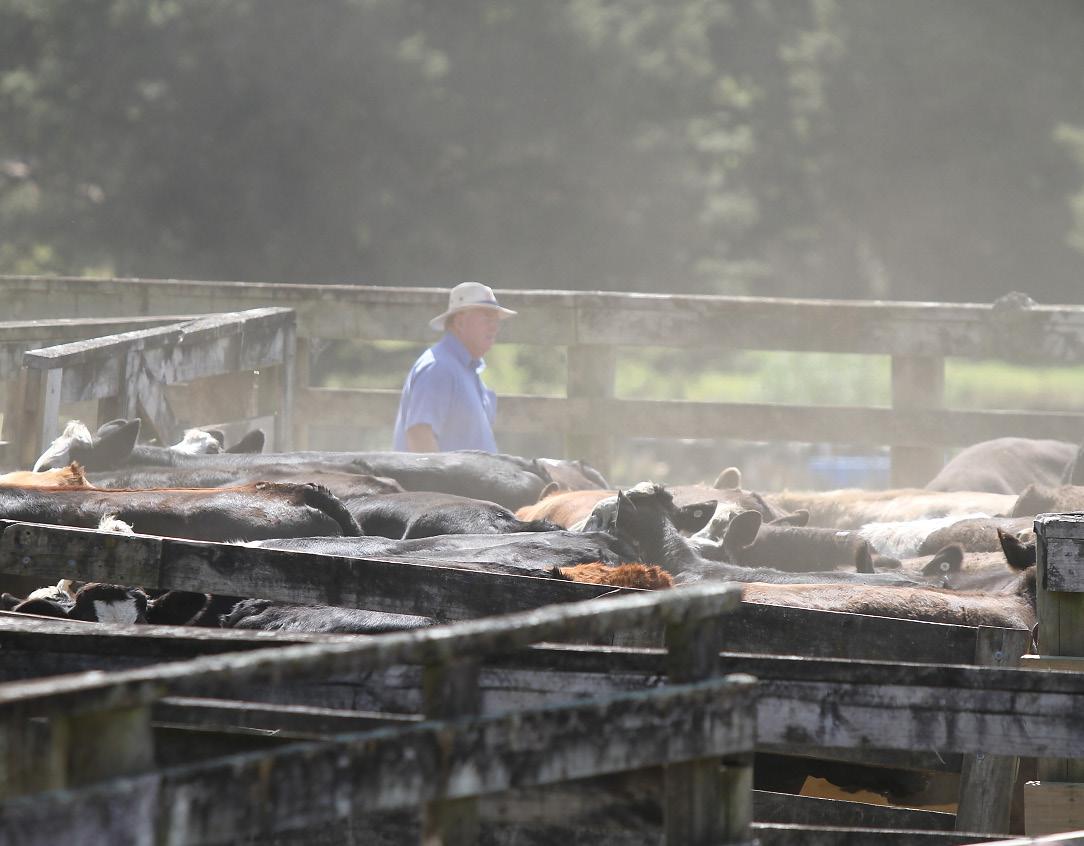
Numbers of breeding cows were down due to changes in farmers’ stock policies and some farms had recently been sold to go into forestry for carbon credits.
Carrfields agent in Northland Reuben Wright says there was a very good run at both the Peria sale where 2500 head were sold and Broadwood where 1500 went under the hammer.
The sales weren’t affected by any cyclone damage.
NZ Farmers’ northern and central South Island agent Regan Laughton says sales had been “very upbeat”.
Stock came to the Temuka weaner sale far heavier than usual with 300kg calves reaching $3.80–$4/kg, “and a handful went for more”.
Lighter steers went for an average of $4–$4.20/kg.
Source: AgriHQ
The number of sales had been condensed over recent years to make attendance more attractive to buyers, so stock numbers on offer were similar to previous sales. But there would be an effect of recent sales of farms to be planted in trees for carbon credits.
Country-Wide Beef | MAY 2023 25
weaner steer price
South Island North Island 80% 70% 60% 50% 2011 2013 2015 2017 2019 2021 2023
Beef
as percent of schedule
Above: A saleyard stockman directs cattle at a weaner fair.
China’s beef market is changing
NZ beef has stiff competition in China and Hunter McGregor reports from Shanghai that longtime overseas producers are now competing with internal growers.
According to Beef + Lamb
New Zealand, last year the top three NZ beef export markets were Japan ($349m), USA ($1.3b) and China ($2.1b). The Chinese beef market is significant to NZ, but what do you know or understand about this market?
The Chinese beef market is massive and continually growing. But like most things in China, it is very complex. I do not understand all of what goes on with beef here, but selling NZ venison within China's high-end food service channels for the past seven years gives me a special market perspective.
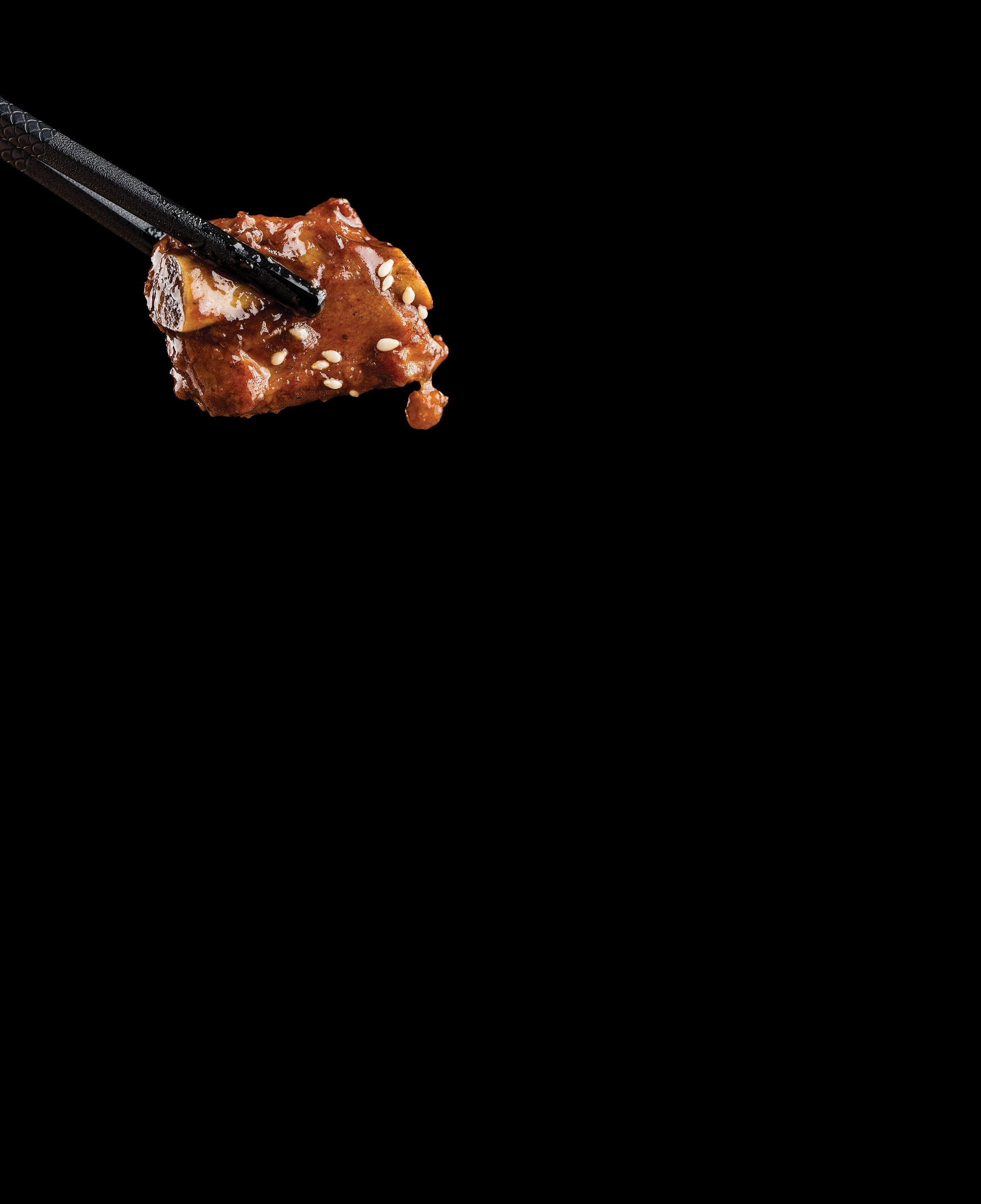
Is NZ beef seen as a "premium product" in China? This is the million (actually billion) dollar question. It is tough to find evidence by looking at the market and consumer preferences that NZ beef is seen as a premium product. More likely, NZ beef sits in the middle of the road. It's not cheap compared to some South American products, but nor is it expensive compared to the top-end brands from Australia or USA. You can see this in supermarkets, restaurants and on wholesale price lists. This position might change in future if there is a big enough market segment to move to grass-fed beef. You often hear that there’s a
long-term Chinese consumer trend to eat more beef, and this is true. This is positive for the entire beef industry worldwide. According to a recently released McKinsey report, there were nine million tonnes of beef consumed in China in 2021, ranking it third behind poultry (25 million tonnes) and pork (67 million tonnes). Furthermore, the report predicts the growth rate of beef (to 2026) to be about 2% a year. So there is plenty of upside within this large and complex market.
There are plenty of high-profile Australian beef brands that dominate the premium end of the market, and since 2017 US beef has been allowed back into the market where it competes in the top end with the Aussie brands. There are many reasons why this is the case, but consistency is important. Consistent product quality is of utmost importance to the end user, and a constant supply or availability is also essential. Inconsistent supply (of all products) is a significant challenge for many food service operations in China.
You often hear about the longterm focus or planning happening in China by Chinese companies. This is a great myth as most Chinese companies only focus on today and don't worry about tomorrow. Though the Chinese government and some companies plan longer term, most do not. NZ beef is not immune from these challenges. Unfortunately,
26 Country-Wide Beef | MAY 2023
CHINA
I have heard of many issues in the past about supplying NZ beef to NZ chefs (who want to use it) in China. Hopefully, this has improved.
It is clear what Chinese consumers of the premium beef market are after:
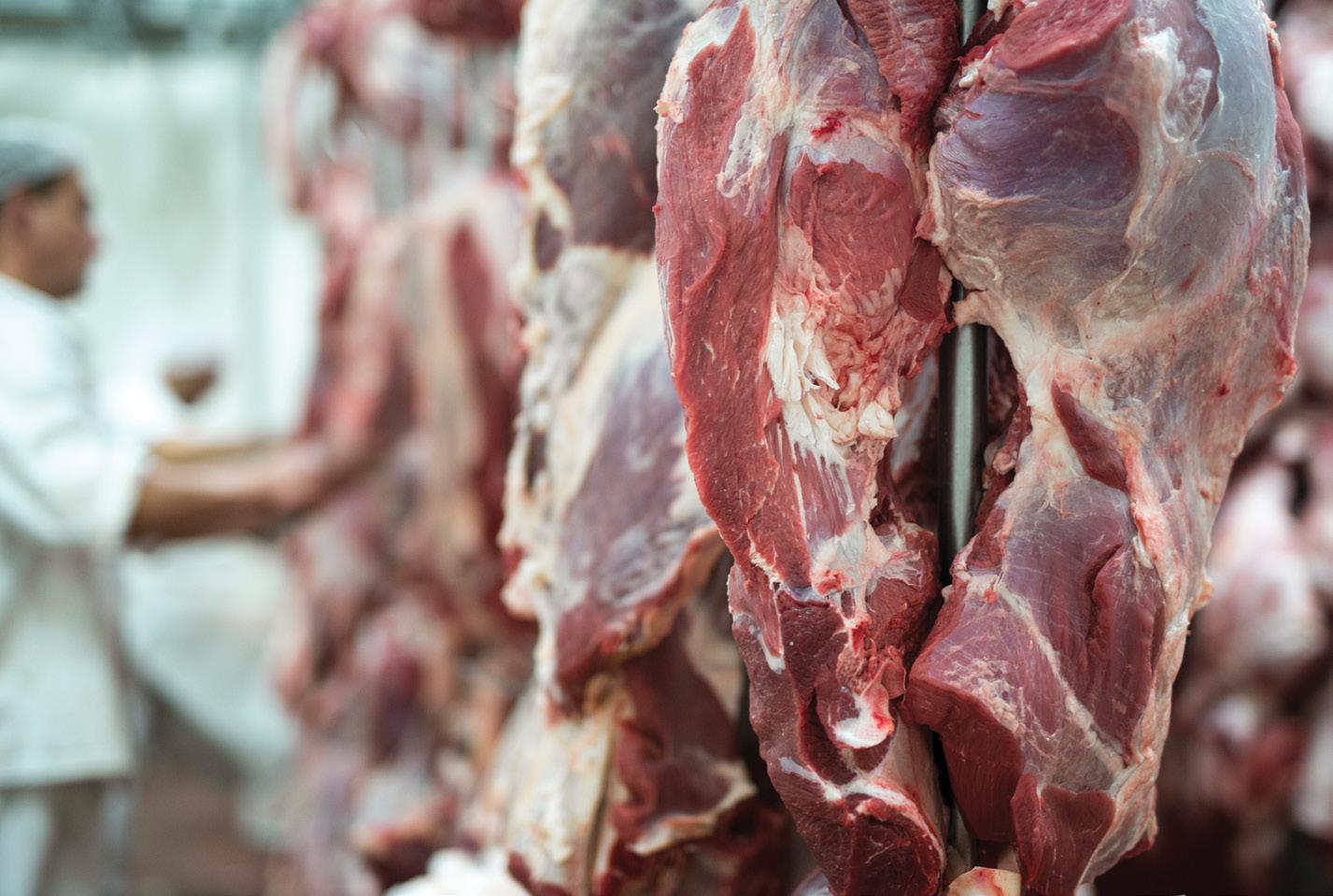
• Brand – There are some influential and well-known brands.
• Breed – Wagyu leads the market, but Angus has its place. The exception to the rule with bread is USDA prime beef. This grading system is well known in China and actually means something to many consumers.
• Grain-fed beef – just about always clearly sold as a premium over grass-fed.
• Country of origin is important, but it has become less so in recent years.
NZ beef falls short on just about all of these at the top-end space, especially within restaurants. Finding any NZ beef in many of the top steak houses and/or high-end around China is very difficult. I know many people who have opened restaurants in China and NZ beef (and unfortunately, NZ venison) never seems to be at the top of their list of must-have items. This is a major challenge, as promoting yourself as a premium product at a retail level is difficult if your products do not sit within any of the top restaurants. Retail and restaurants are linked, as many of these restaurants' clientele are also looking to cook quality meat at home. Connecting allows many brands to build and maintain credibility in that premium space. The Australian brands do this very well. Unfortunately, Taste Pure Nature marketing only focuses
on retail, which is a long-term strategic mistake.
As a side note, NZ lamb (and some venison) sits on menus within many of the top-end restaurants all over China and it’s fantastic to see.
Dry ageing of beef has only expanded from a couple of years ago, found in a few places in major cities such as Shanghai, Shenzhen and Beijing. Many restaurants now have their own dry-ageing facilities and run their own programmes. I have yet to see or hear of NZ grass-fed beef dry aged in a restaurant (hopefully, it is happening somewhere in China), but it is often grain-fed beef from the US or Australia. Some grain-fed South American brands/products are doing very well in many restaurants and are also sold as dry-aged finished product.
Another long-term trend across everything in China is consumers moving to locally produced brands or items. I think this started with electronic items and has now spread to food and drink brands. The Chinese government has been working hard to increase local standards and reputations, and consumers are responding positively to this. In the past, imported food items were always considered superior and premium to locally produced products. This has now changed, and you now see more and more Chinese products on the menus of the top restaurants. Locally produced beef is slightly behind their lamb, seafood and poultry items at the moment, but it is improving.
As the Chinese beef market and consumer demand continue to change, there is a lot of potential and upside for NZ beef. It is going to be challenging because there is a lot of competition, but it has been good to see some of the moves by NZ beef companies here lately. Long may it last.
Country-Wide Beef | MAY 2023 27
“It is tough to find evidence by looking at the market and consumer preferences that NZ beef is seen as a premium product.”
Finding any NZ beef in many of the top steak houses and/ or high-end restaurants around China is very difficult.
It is not just the sale price

Kerry Dwyer reviews cattle trading margins year upon year, and says profitable beef production is based on getting the optimum growth rate relative to your cost structure.
Ayear ago I wrote an article on cattle trading margins, when beef prices were sitting at an all-time high in New Zealand. I didn’t make any predictions for the year ahead, rather, I looked at some of the gross profits made in the previous year. And now, as a comparison, it is worthwhile looking at what might have been achieved in the past 12 months when beef prices have eased somewhat.
The trading systems I used were fairly simple, based on several different buying options available at the Temuka auction in April and selling within 12 months. The Temuka sale is indicative of the South Island market and may be different from some North Island options.
Beef weaner steers
As a simple trade, let’s look at buying a pen of Angus-Hereford steer calves at one of the Temuka calf sales, say on April 4, 2022, and selling them a year later on March 23. They are average calves, weighing 233kg liveweight (LW) and cost $827/head in 2022 compared to $720/head a year earlier in 2021.
If these were grown at a high growth rate of 1.13kg LW gain/ day they would weigh 630kg on March 23, 2023. At that weight they are classed as finished, so could be sold either at the Temuka prime sale or direct to a processor. Because there is often a slight difference between these markets due to factors such as availability
of processing space, I have compared the two options.
Note that the prices used are gross with no costs taken off, because they will vary with your own individual circumstances. Also, I have used a generic average available processor price without any premiums that might be available on specific contracts.
As a comparison, if you fed the steers less quantity or quality feed they will have grown at a lesser rate. Say we use 0.75kg LW gain/ day for the year you had them, then instead of hitting a slaughter weight, they get to 500kg LW, which is more likely, meaning a store sale for them. While they could still be sold for processing, their yield will be less than at a heavier weight and they might
just slip down a price tier at a lighter weight. So we say they have been sold back at the Temuka sale as stores.
Table 1 shows the comparative results for the various options for both a trade over the 2022/23 year and the 2021/22 year.
The purchase price for the steer calves was $3.09/kg LW in 2021, rising to $3.55/kg in 2022. That reflected the good margins that had been made with the earlier trade, which buyers passed back to breeders at the calf sales. And having the optimistic gene, the buyers hoped the good times would continue.
The sale price from processors sat at $5.80/kg carcaseweight (CW) in March 2022, reducing to $5.40/kg in March 2023. Given
28 Country-Wide Beef | MAY 2023
BUSINESS TRADING MARGINS
the doom and gloom prevalent in the world, that drop of about 7% is mild compared to the $1.50/kg CW fall in lamb schedules in the same timeframe. At close to a 20% fall, it has ripped the profitability out of many sheep farming businesses.
Putting the higher price and the lower sale price together has obviously reduced the margin for profit – by $88/head if selling at the saleyards and $246/head if selling direct to processors. At more than $1000/head margin for a 12-month trade, that remains at the higher end of historically
achievable levels.
Note the larger difference between saleyard and processor price in 2022 for the heavy steers compared with 2023. Slaughter space was tighter a year ago than now, which gave a discount to saleyard price.
The margin per kg DM has reduced proportionately between 2022 and 2023.
The other option was to grow the steers at a slower rate and sell them store at the Temuka saleyards at the same end of March timeframe. For a third less growth rate, the potential profitability reduces accordingly.
The moral of the story is that when margins get tighter, the most efficient producers can still make headway.
Beef weaner heifers
Instead of buying the AngusHereford steer calves, we might have purchased their sisters at a lighter liveweight of 210kg at a lower price. We were looking at $2.40/kg in April 2021 compared to $2.90/kg in April 2022.
The heifers will not grow quite as fast as steers, so I have picked a higher growth rate of 1.05kg/ day and a slower rate of 0.7kg/ day for comparisons. The higher growth rate heifers could be sold prime at 580kg LW at either the saleyards or direct to slaughter, with the slower growing animals getting to 457kg, to be sold store at saleyards.
Table 2 shows the possible margins for these heifers. Note the margin a head is not dissimilar to the steers over the same time
Country-Wide Beef | MAY 2023 29
Year ending Type Buy price/head Sale price/head Margin/head c/kg DM 2023 Beef steer calves –higher growth rate $827 $1851 = saleyards $1876 = slaughter $1024 $1049 19c 20c 2022 Beef steer calves –higher growth rate $720 $1832 = saleyards $2015 = slaughter $1112 $1295 22c 26c 2023 Beef steer calves –slower growth rate $827 $1443 = saleyards $616 14c 2022 Beef steer calves –slower growth rate $720 $1443 = saleyards $723 17c
Table 1 Trading beef steers, margin possibilities, cattle trading for years ending March 2023 and March 2022
Year ending Type Buy price/head Sale price/head Margin/head c/kg DM 2023 Beef heifer calves –high growth rate $609 $1683 = saleyards $1724 = slaughter $1074 $1115 22c 23c 2022 Beef heifer calves –higher growth rate $504 $1538 = saleyards $1832 = slaughter $1034 $1348 23c 30c 2023 Beef heifer calves –slower growth rate $609 $1234 = saleyards $625 15c 2022 Beef heifer calves –slower growth rate $504 $1119 = saleyards $615 16c
Table 2 Trading beef heifers, margin possibilities, cattle trading for years ending March 2023 and March 2022
“...when margins get tighter, the most efficient producers can still make headway.”
WE ROLLED UP OUR SLEEVES AND PICKED UP THIS AWARD

We’ve been named as Canstar Bank of the Year for Agribusiness 2022 for providing an outstanding combination of products and excellent service to our agribusiness customers. Looks like hard work does pay off. If you’re in the agri sector, come to the bank that’ll do the tough mahi with you.

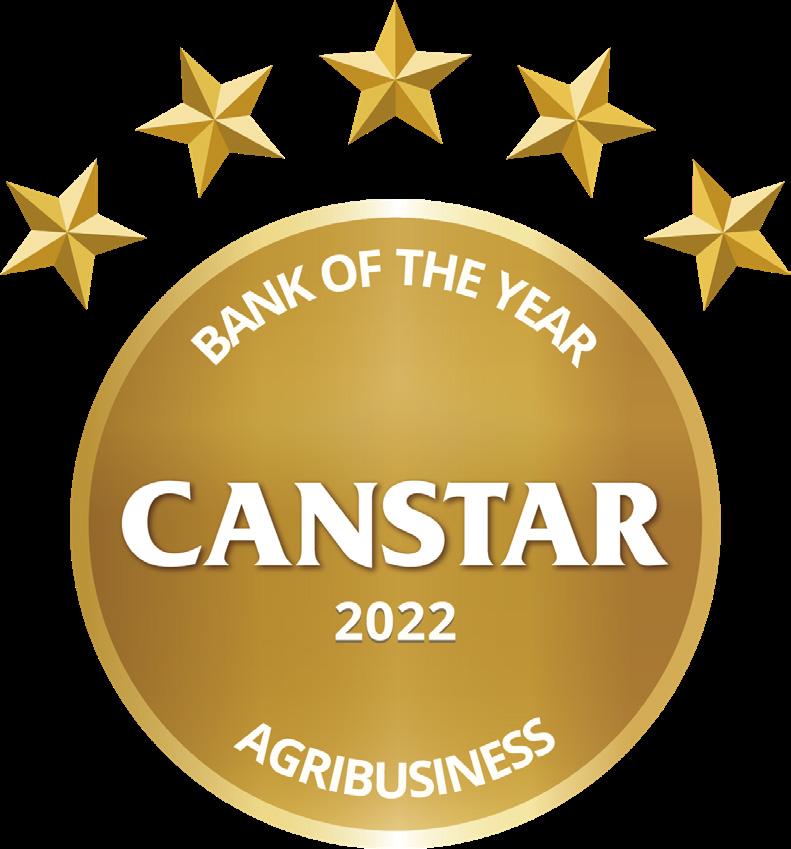

Year ending Type Buy price/head Sale price/head Margin/head c/kg DM 2023 Friesian bull calves –high growth rate $644 $1729 = saleyards $1815 = slaughter $1085 $1171 20c 22c 2022 Friesian bull calves –higher growth rate $506 $1729 = saleyards $1936 = slaughter $1223 $1430 25c 29c 2023 Friesian bull calves –slower growth rate $644 $1286 = saleyards $1298 = slaughter $642 $654 14c 15c 2022 Friesian bull calves –slower growth rate $506 $1236 = saleyards $1385 = slaughter $730 $741 18c 18c
Table 3 Trading Friesian bulls, margin possibilities, cattle trading for years ending March 2023 and March 2022
2023 Dairy heifers –winter trade $800 $1920 = saleyards $1920 = slaughter $1120 $1120 30c 30c 2022 Dairy heifers –winter trade $648 $1780 = saleyards $1780 = slaughter $1152 $1152 33c 33c anz.co.nz/rural
Table 4 Trading two-year-old Friesian heifers, margin possibilities, cattle trading for years ending March 2023 and March 2022
frames. And the margin per kg DM is similar or possibly higher than that of the steers. Again, the higher buying prices and lower selling prices for the 2022/23 trade have impacted the margins.
Friesian bull calves
The next option looked at last year was buying Friesian bull calves at Temuka saleyards for a comparable time trade. I used the figures of buying a 230kg bull calf, growing at either 1.13kg/day or 0.75kg/day. The resulting sale weights would be either 629kg LW or 495kg.
The slower growth rate bulls could be sold back to the saleyards or to processors, but as with the steers, there is risk of the lighter animals slipping below a price tier at processors.
The figures for the Friesian bulls are not dissimilar to the beef steers and heifers. A good growth rate will have resulted in more than $1000/head margin and more than 20c/kg DM achieved. A slower growth rate drops that by about a third. The margins dropped in the 2022/23 trade compared to the previous year.
R2yo dairy heifers
The other trade I compared was buying rising two-year-old Friesian heifers in April. They had been scanned empty from dairy herds and had the frame to be grown into prime beef for slaughter late October. This is a shorter trade than the previous three options. We could look at R2yo beef steers or heifers of a similar age, but I have used the dairy heifers because they are generally considered the least desirable beef option and are frowned upon by many.
Assuming these were reasonably well-bred Friesians, they could have been wintered then sold seven months later at the end of October having grown at 0.9kg/ day to achieve 600kg LW. The selling options are to sell back
in saleyards as prime or direct to processors.
Table 4 shows the results possible for the dairy heifer trade. Selling prime in October 2022 had a sale price of $6.40/kg CW, rising from $6.00/kg in October 2021. That gave a similar margin to both years due to the purchase price rising in April 2022. The margin
The buying price is just one part of profitable beef trading.
Summary
Cattle purchase prices were generally higher in 2022 than 2021 and we saw a fall-off in processor pricing in late 2022, which has impacted per head margins.
per head that could be achieved in seven months was similar to that over the 12-month trade for younger animals, giving a higher return per kg DM input. It is a different trade and brings some implications for wintering heavier cattle and not using all the spring pasture growth. The store cattle buyers generally show a preference for short-term trades, which is reflected in their purchase price levels.
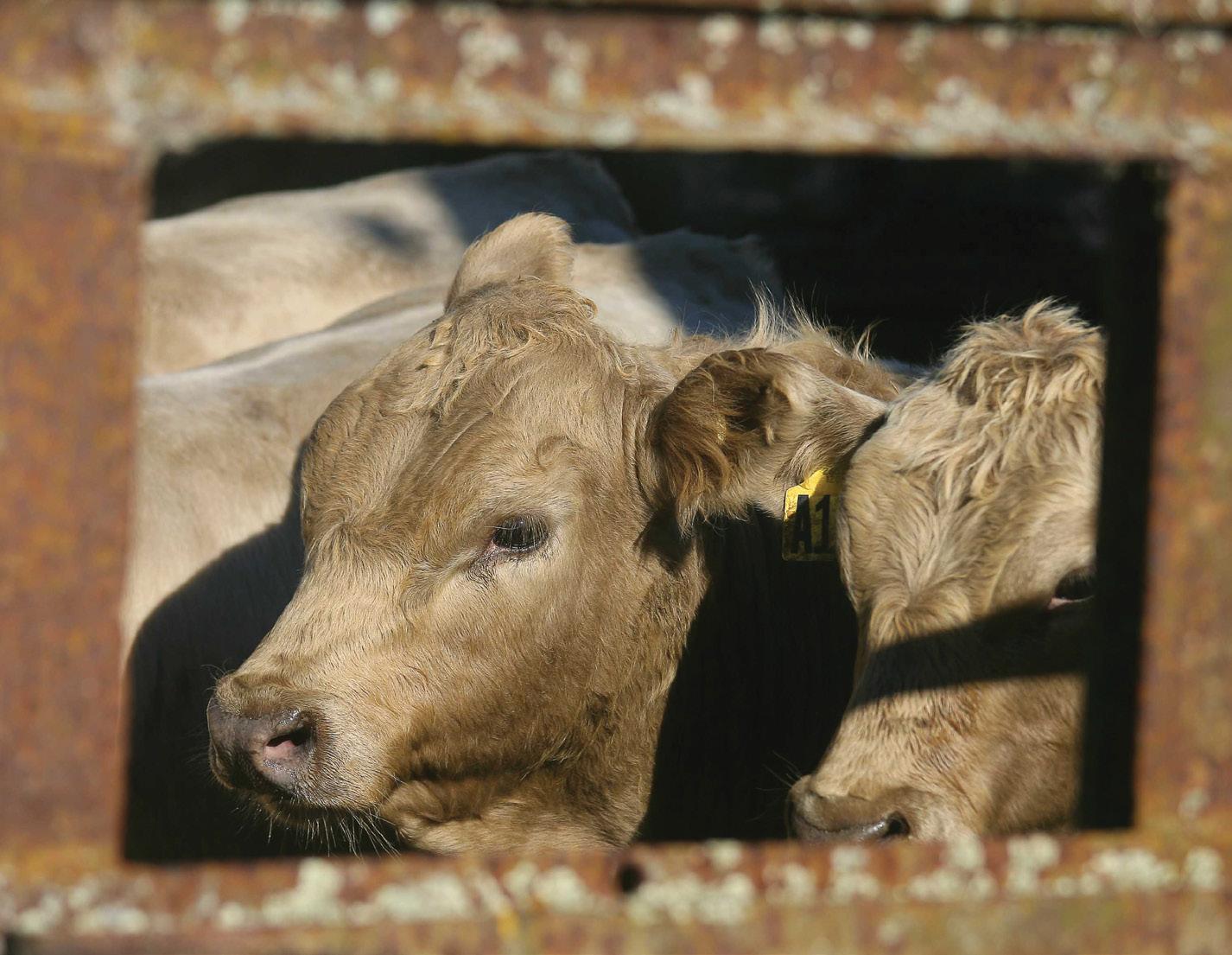
Note that the margins shown are gross, being sale price less purchase price. Net profit depends on your own individual costs of transport, selling and feeding. Feeding costs can vary considerably depending on how you winter your animals. For example, all-grass wintering may be costed at close to $100/head while feeding a brassica/balage mix might be more than $300/ head.
While prices vary between and within years, profitable beef production is based on getting the optimum growth rate relative to your cost structure. Purchase price is one part of profitable beef trading, as is sale price and growth rates achieved.

Country-Wide Beef | MAY 2023 31
“Net profit depends on your own individual costs...”
HARNESS THE POWER OF HYBRID VIGOUR
- 12% increase in profitability with hybrid vigour
- Quicker finish and increased carcass weight
- Eliminate “tubby pure bred heifers” and animals that go prime too small
- Cross bred animals have greater marbling scores and better access to premiums
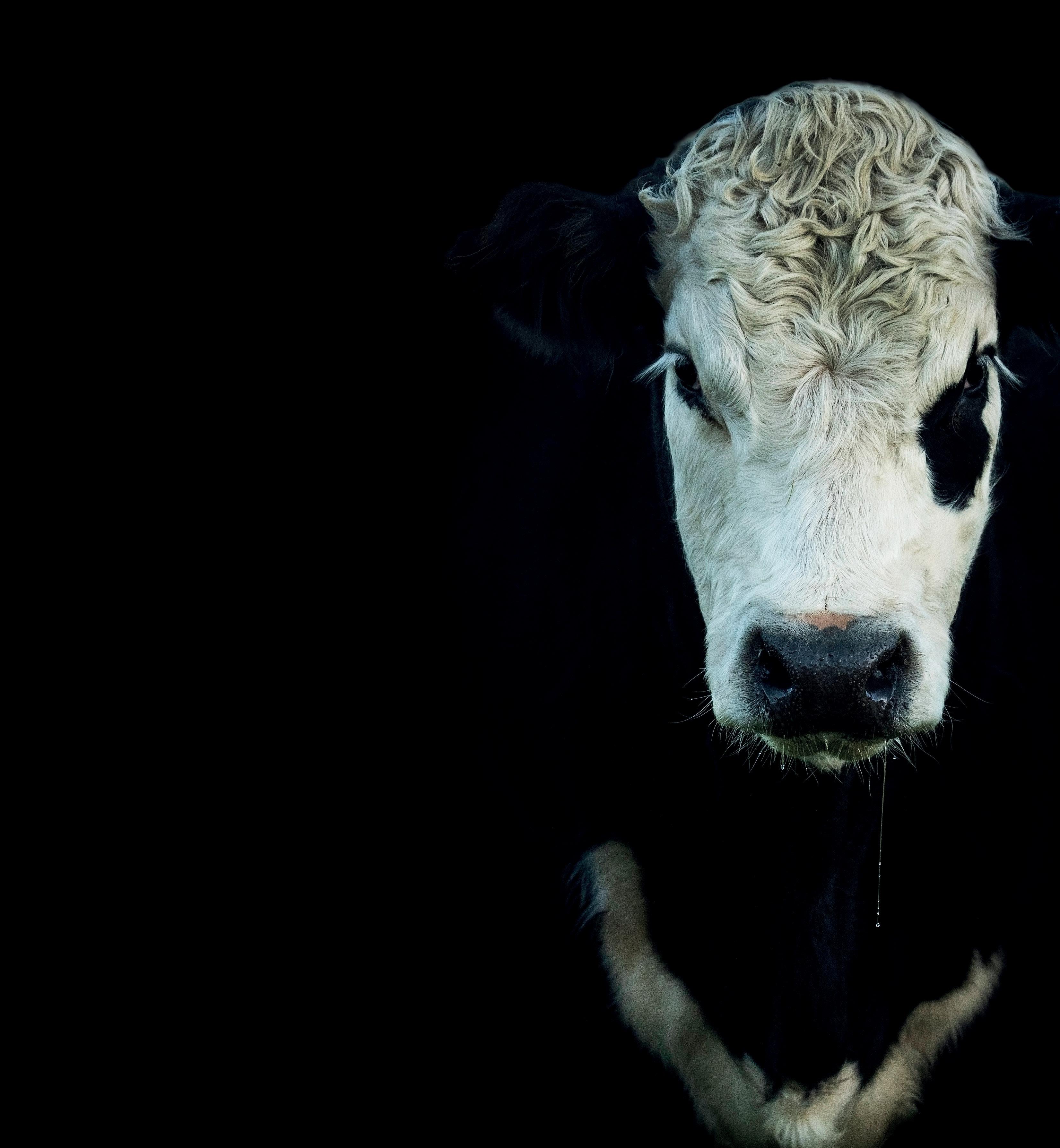
- Increased fertility, production and longevity from hybrid vigour
- Hybrid vigour is the true answer to feed efficiency and sustainability
To find your local registered Hereford bull sale view the calendar at www.herefords.co.nz
To purchase a registered Hereford Bull, talk to your stock agent or visit www.herefords.co.nz
32 Country-Wide Beef | MAY 2023
Opportunities for the young ones
BY: TONY LEGGETT
Opportunity and technology are driving more beef studs to offer yearling bulls each spring.
The volume of yearling sales has been trending up for the past few years, primarily to meet rising demand from dairy farmers looking for low-birthweight bulls for mating heifers.
But with increasing use of sexed semen in dairy herds to produce sufficient heifer replacements, there’s greater scope for more use of beef bulls across the remaining herd to produce beef-cross progeny which can be finished for export as high quality beef.
A new supplier rule introduced by the country’s largest milk processor-exporter is also expected to have an impact. Fonterra told its milk suppliers earlier this year to ensure all their calves have a ‘useful life’ and has banned onfarm euthanasia from June 1 this year, except for animal welfare reasons.
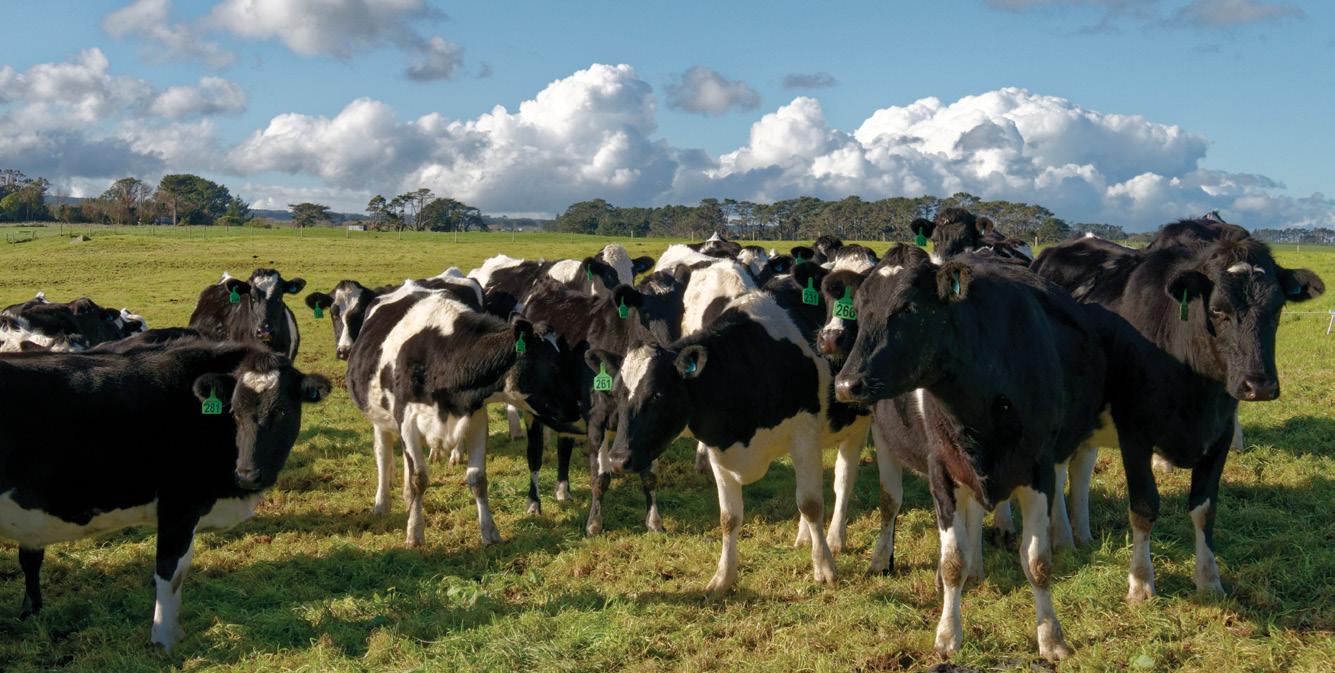
This is expected to influence bull choice away from traditional options such as Jerseys to beef breeds, so the dairy industry will become a larger source of dairy beef calves for rearing and finishing.
The technology supporting greater
numbers of yearling bulls being offered for sale is genomics.
Zoetis Genetics beef specialist Amy Hoogenboom says genomics provides a good prediction of a bull’s likely future performance, even at yearling age.
Genomics is a numbers game and is only available for Angus and Hereford breeds, recorded with Breedplan, or for cattle recorded through the Leachman $ Profit multi-breed analysis which is used by a small number of NZ studs.
Genomic analysis helps shift a bull’s EBVs closer to its true breeding value before the bull has any progeny on the ground. When combined with all the other information available (pedigree, raw measurements recorded), genomically enhanced EBVs provide potential buyers with the best estimate of the bull’s genetic value as a sire.
“There is really only one measurement that breeders are unable to record for by yearling sale time each year which is 600 day weight, so this means there is minimal change between a bull’s EBVs, and accuracy between yearling and twoyear-old age.”
Hoogenboom says yearling sales are becoming more popular with beef
farmers because they are usually a source of cheaper genetics than two-year bull sales.
“Farmers are no worse off buying at yearling sales, provided the stud selling the bulls is recording all the traits accurately and doing the measurements when they should,” she says.
Northland Angus breeder Chris Biddles says the Fonterra move to ban on-farm euthanasia is likely to draw more beef studs into running yearling bull sales in the future.
He was one of the first to run a yearling bull sale, specialising in offering genetics for calving ease and heifer mating. He sells around 100 under the hammer in early September each year and says 40% of his clients are dairy farmers who buy 60% of the bulls offered.
The Absolom family in Hawke’s Bay will hold its 31st yearling bull sale this spring and has been embracing the use of genomics in its bull breeding strategy to deliver about 750 yearling bulls to the beef and dairy sectors.
Co-owner Daniel Absolom says genomics has created the biggest shift in performance recording since EBVs were introduced in the 1980s. EBVs enhanced by genomics has almost doubled the accuracy of the data previously available.
“In the past five years, genomic testing has become a massive part of what we do at Rissington. When coupled with Vytelle Feed Efficiency testing that we do here, genomics is certainly a game changer for us,” he says.
Rissington is in its third year of selling homozygous polled yearling sires to the dairy sector and this year expects to sell 500, already double the number sold to commercial beef farmers which took more than 50 years to build.
Rissington sources bulls for its dairy farmer customers from its beef bull clients who use the Zoetis Inherit Select DNA test to ensure they retain only the most profitable females. Another genomic tool, HD50K for $Profit, is then run on their bull calves to select the best for the dairy industry using a trademarked $Dairy Index developed with AbacusBio.
Country-Wide Beef | MAY 2023 33
YEARLING BULL SALES
There is greater scope for more use of beef bulls across dairy herds.
Right stock + feed = profit
Gore-based farm consultant Graham Butcher has spent more than a decade looking at c/kg DM across sheep, herd, calf finishing, bull and dairy policies and finds bull beef tops the list.
One would think that the decision from Fonterra to not allow on-farm slaughter of bobby calves from June this year would ripple through the dairy sector and create some difficulty and also some opportunities for calf rearers. Apparently not. After a discussion with a noted Southland dairy consultant, there is not much on-farm slaughter anyway, so it’s business pretty much as normal except perhaps for Jersey breeds. Dairy farmers will get about $30/calf at the works, give or take $5 for weight. They need to be at least four days old, which is about $20 worth of milk and farmer time of course. So, a healthy four-day-old calf at $80/hd seems reasonable.
From a beef perspective there appeared to be a glimmer of an opportunity to get some lower-cost calves for rearing and take advantage of a large resource that’s always been there.
So what is the bull beef opportunity?
The best place to start is to take a look at profitability (gross margins) of the enterprise in terms of profit against feed consumed – or cents profit/kg DM consumed. This gives the relativity of different
enterprises and, providing you take all matters into account, it gives a global view of possible directions to take. What we can’t do with this approach is allow for the different resources each farm has and how different stock policies combine to improve pasture utilisation and quality.
Right now, the current relativity stakes are as follows:
It’s not surprising to see calving at R3 has lower profit, but some farms need to do this. It raises the question of what could be done to rear heifers capable of taking the bull earlier, even if you need to run first calvers separately after their first weaning.
Some more beef options:
No surprises here: autumn heifers (hfrs) and steers are about the same, which shows sensible purchasing by farmers. And, as with all finishing enterprises, the higher the performance (growth rate) the higher the profitability.
And now, the bull beef options:
34 Country-Wide Beef | MAY 2023
c/kg DM Breeding cows, selling weaners, calve as R2 10.3 Breeding cows, selling weaners, calve as R3 7.3 Breeding cows, finish calves, calve as R2 10.8
Autumn bought steer calves 11.6 Autumn bought heifer calves 11.4 Higher performance steer calves 12.0
Bull beef (100kg calves bought) 16.9 Bull beef (100kg calves reared) 17.8 Bull beef (100kg calves reared)
performance 21.1
high
So, there we have the relativity among a number of cattle options. All based on average production except for the higher performance autumn steers and reared bull options.
Bulls are significantly better at converting grass to profit, but it’s got to be high quality grass. Here’s a very important factor: both bulls and autumn purchase of calves need high quality. Breeding herds consume about 20% lower metabolisable energy (ME) pasture. If we make an adjustment for this, the breeding herd competes well with steer and heifer calf finishing. It comes down to the nature of your farm. Don’t underestimate the value of breeding cows, selling calves.
Here's another important question. How do the figures above compare to sheep and dairy support? Consider
(autumn purchase) follow a very similar trend but are below bulls, also sometimes below sheep policies and sometimes not. Dairy support is good and less variable than bulls or beef calves. Sheep are outperformed by dairy support and bulls. Herd policies appear low, but remember that 20% lower ME issue. Taking this into account they are more competitive. If we did the analysis on an ME consumed rather than a DM consumed basis, differences would narrow.
The current relativity stakes are all very well, but farming is a long-term business and we can’t change stock policy on a one-off look. We need to consider policies for a much longer term.
Graph 1 shows a global look at long-term relativity. Breeding ewe enterprises are grouped together as are the herd selling calves and the bull options.
All these comparisons are based on current values and costs.
I’ve been looking at annual c/kg DM issues since 2011. So I took a look at long-term trends by grouping sheep, herd, calf finishing, bull and dairy policies and looking at them over the last 10 years at yearly intervals (Graph 1). This will probably give a statistician bad dreams, but it demonstrates some points.
Bull beef tops the list, consistently good. Beef calves
Remember, these figures are based on gross margins, which is the gross income less direct expenses and interest on stock capital. We don’t include costs that don’t change, i.e. accounting, repairs, etc. Nor do we consider drawings, tax, other interest or capital expenses. It shows the ability of an enterprise to convert grass to profit which is available for all those other things.
What I take from this is that in the long term bull beef and dairy support are better at converting grass to profit. Herd policies really fit in where lower quality pasture is an issue. More so than is indicated in Graph 1.
Autumn steer calves are quite volatile, sometimes good, sometimes not.
The skill of the farm manager is to take the attributes of different stock policies and match them to what resources your farm has to offer. Not everyone can do bulls, or even wants bulls, and not everyone can do dairy support. Not everyone has the ability to finish their own bred calves. But everyone can strive to get the very best out of whatever mix of policies are finally chosen.
The name of the game is, firstly, to utilise as much of the grass you grow as you can by selecting the appropriate class of stock. Secondly, put the grass you do grow into a class of stock that will convert it into the most profit. Don’t change policies unless there are sound and well thought out reasons based on the long term. As always, look for cost effective opportunities to grow better quality grass that will allow a step up in performance. You will be considered a successful manager if you achieve this.
Sounds simple doesn’t it?
Country-Wide Beef | MAY 2023 35 BULL BEEF
these figures: c/kg DM Breeding ewe, 135%, no hogget mating 11.8 Breeding ewe, 140%, 50% from hoggets 13.2 Breeding ewe, 155%, 85% from hoggets 14.4 Dairy heifer grazing, $8.50 to May then $12.50 17.7
25.0 20.0 15.0 10.0 5.0 0.0 2013 2014 2015 2016 2017 2018 2019 2020 2021 2022 2023 Sheep Beef herds Beef herds + 20% Dairy support (hfrs) Bulls Beef calves
Graph 1: Comparative long-term trends (c/kgDM)
"Look for cost effective opportunities to grow better quality grass that will allow a step up in performance."
Still waiting on MPI for answers
A recap of the ongoing Mycoplasma bovis investigation series that started in Country-Wide December 2022. By Nicola Dennis.
It’s time to recap what we have already learned during the ongoing M bovis series. That should give the Ministry for Primary Industries (MPI) a chance to work out if they know the ages and carcase weights of the infected cattle they have slaughtered. You would think that would be an easy task for the number one proponents of the national animal tracing system, NAIT. There are birth dates and slaughter dates in NAIT, right? That should give an estimate of age. Kill sheets have carcaseweights for each NAIT number, right? Bing, bang, bong, Bob’s your uncle, there’s the data I asked for back in February. Thank you kindly. But, no. My official information act (OIA) request was refused on the basis that the “information requested does not exist or, despite reasonable efforts to locate it, cannot be found”. Hot damn! Did MPI just admit to not keeping cattle records? I asked MPI to confirm their statement while visions of journalism trophies danced in my head. On closer inspection, what MPI said was not what they meant. They reopened the request, waited a month, and then extended the 20-working-day deadline. Any month now, we should know what, if anything, MPI knows about the 183,000 cattle it has paid for.
SOME INFORMATION GLEANED THUS FAR
So far we have covered the hiccups taking place between MPI and NZ cattle vets, we’ve perused some damning findings from social scientists, we’ve talked to the meat processors and we’ve ploughed through the 19 publicly available reports on MPI’s M bovis website. Let’s pull out some key lessons from the experience so far.
36 Country-Wide Beef | MAY 2023
•
SERIES
M Bovis
ERADICATION PROGRAMMES ARE ALWAYS MESSY…

There is no nice way to destroy someone’s herd. The experience is universally distressing. One thing the social scientist pointed out, which I think passes many townies by, is the paradox of culling. Farmers cull animals all of the time; it’s just part of the job. But routine culling is done at a strategic time of the year and it is done for the greater good of the farm and bank account. This is an entirely different proposition to slaughtering an entire herd of cattle because they might be sick. Even the meat processors, who purposely place themselves at the cut and thrust of the meat supply chain, expressed dismay at being asked to cull “healthy looking” dairy cows and undersized stock. It violates the natural order of things: it is perceived as wasteful and in many cases the timing of slaughter was in
direct contravention of a farmer’s ethics (culling heavily pregnant cows or leaving cattle in muddy conditions).
Those who had been involved in disease outbreaks overseas, said that a certain amount of confusion and chaos is baked into the system. Especially at the start when information is slow and things are being propped up by the best guesses from the experts. It is a real challenge to maintain that expertise and trusted relationships during peacetime so that you have the right people to turn to when the excrement hits the fan.
…BUT THE MIDDLE YEARS OF M BOVIS WERE GROSS
From what I can gather, the M bovis programme actually started off strong. Experts were plucked from all over to provide rapid guidance on containment, testing and communication. And now, after many years, the programme
seems to be operating well. But that is glossing over the gross middle years where it alienated almost everyone in the industry. The bit where MPI was supposed to run its own programme but was ill-equipped to do so. MPI clung to the “one size fits all” National Control Centre model which is best suited for short-term national crises (i.e. flood) and not a decade-long industry programme. That meant that all decision making was funnelled up to Wellington which had no idea what was going on in the regions.
MPI hadn’t had a chief veterinary officer for decades so there was no one whose job it was to liaise with industry veterinarians. This led to an embarrassing faux pas where MPI commissioned the development of a test that was ultimately rejected by the NZ Veterinary Association. Things soured between AsureQuality and MPI (both government bodies) when costs exceeded expectations. Some tireless epidemiologist at the Wallaceville laboratory was manually producing reports on the number of farms sitting in queues at different stages of the M bovis response. When the epidemiologists in Wallaceville were no longer part of the programme, the reporting stopped. Without a piece of paper to say so, those managing the programme were incapable of hearing their staff screaming in agony as they disappeared under a gigantic backlog in cases. Meanwhile, affected farmers were faced with irrational orders around stock movements, culling and farm cleaning. Basically, if it was good management practice and the calendar read 2018 or 2019, then MPI was probably not doing it. Let’s take a closer look at how they came to overwhelm themselves.
OVER COMMITTING YOURSELF IN SLOW MOTION
Many farmers believe that the government at the time (or more, the ministers from the Green Party and their #TooManyCows supporters) wanted to reduce the number of cattle anyway and M bovis was a convenient excuse. The official documents tell a different story. M bovis is the kind of disease that
Country-Wide Beef | MAY 2023 37
TH IN K OF IT AS A STROKE OF G E N I US
It doesn’t take long to work out that buying Simmental means you are buying smart. With Simmental consistently dominating the top yearling, 18-month weights, EMA and carcase weights over the last seven years of Beef+Lamb Progeny test results, it’s in your best interest to buy Simmental - they don't do badly in weaning weights either.
Learn more at simmental .co. nz
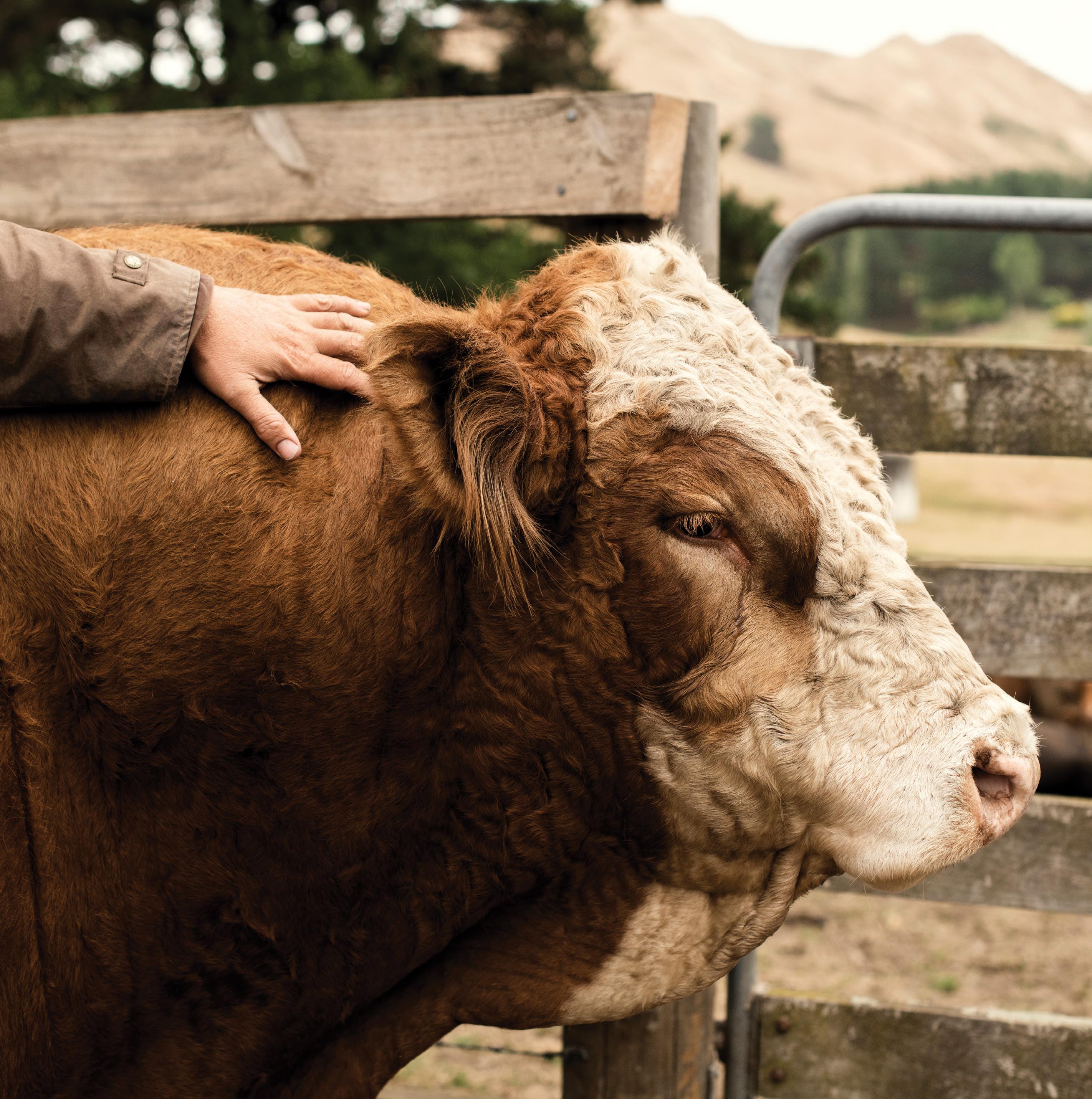
38 Country-Wide Beef | MAY 2023
AGRARIAN
the government could have left alone. It isn’t a threat to human health or overseas trade and it is largely asymptomatic in a well-managed herd. And going through the timeline of the M bovis eradication decision, it is clear that MPI was hedging their bets for a while.
The disease was first discovered on the Van Leeuwen Dairy Group farms in July 2017. It took 87 days for MPI and the outgoing government to announce that it would be culling those properties. It wasn’t until March 2018, that any further cullings of affected farms were announced. And it wasn’t until May 2018, some 315 days after the first diagnosis, that the Government committed to eradicating M bovis. By this time, 4/10 independent experts on the technical advisory group (TAG) team believed that eradication was no longer rational.
Rational or not, it was happening and the eradication programme quickly
grew to more than 400 staff. Many of whom were entirely unschooled in the ways of agriculture. There was no central database or information sharing between various arms of the programme, rather people were cobbling their own data together from spreadsheets.
By Christmas it was clear to everyone on the ground that there was an issue with workload. But the central office seemed none the wiser. In fact they allowed employment contracts to lapse and bunked off for a three-week holiday break. By January TAG was highlighting issues with staff fatigue. By April, DairyNZ was aware of discrepancies between reports from field staff and the people managing the eradication response and demanded an explanation from MPI. The Government then took a
look around and was surprised to find it had a 666 farm backlog in testing and tracing. Three days later this was revised to 1100 farms. When the science advisor was asked to review the issue, it was revised again to 1400 farms. By ANZAC weekend, enough was enough, and the programme was restructured and MPI slowly worked its way out of the mess it created.
M BOVIS NOT THE FIRST RODEO
Biosecurity responses seem to have two distinct stages. Stage 1: full steam ahead; these are unprecedented times and other people’s concerns are only for “precedented” times. And Stage 2: the apologies and promises that they will definitely do better next time. Basically

the same playbook as an abusive drunk. The M bovis eradication programme was staying true to the genre, much to the annoyance of experts who had been involved in overseas outbreaks. There was no need to continue to repeat the mistakes of the past. There are literally textbooks on the topic. The social scientists that I spoke to for part 2 of the series plan on combining their NZ M bovis research into another textbook to add to the pile.
Plus MPI, or its predecessors, have their own history to ponder. The most amusing of which is the West Coast heiferlumps problem. Also known as the time the then Department of Agriculture spent 55 years gaslighting West Coast farmers about a test that wasn’t working. I really can’t spare the space to do the heiferlumps story justice, you will have to dig up January’s issue to see it in its full glory. The highlights are as follows: There were an unreasonable number of West Coast heifers (read 70%) that tested “positive” for bovine tuberculosis (TB), but when they were slaughtered they were actually healthy. That was agitating West Coast farmers to no end. You
Country-Wide Beef | MAY 2023 39
By this time, 4/10 independent experts on the technical advisory group (TAG) team believed that eradication was no longer rational.
Four-year-old Herd Sire: Woodleigh Elegance
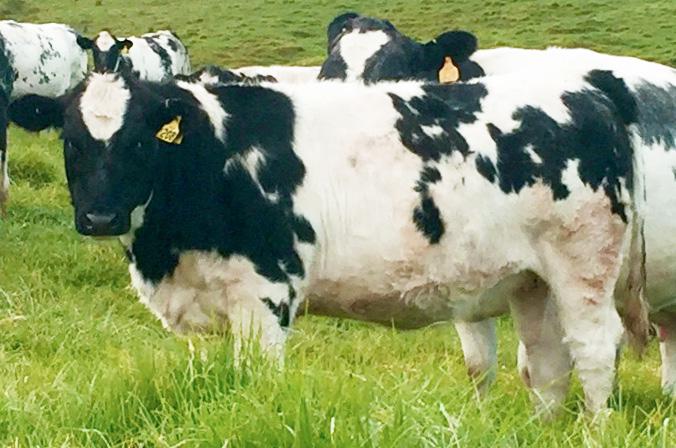
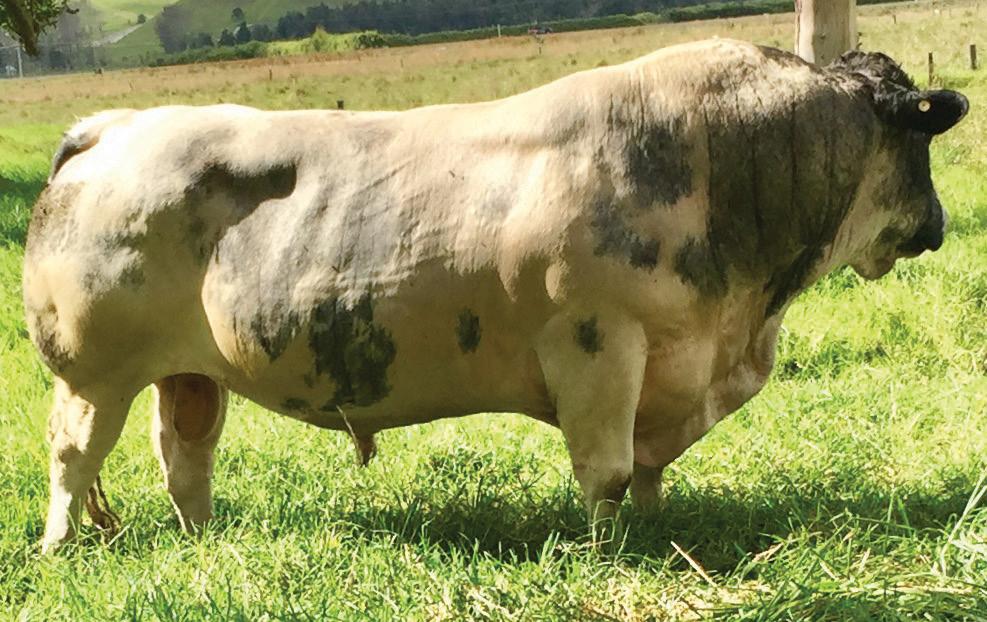
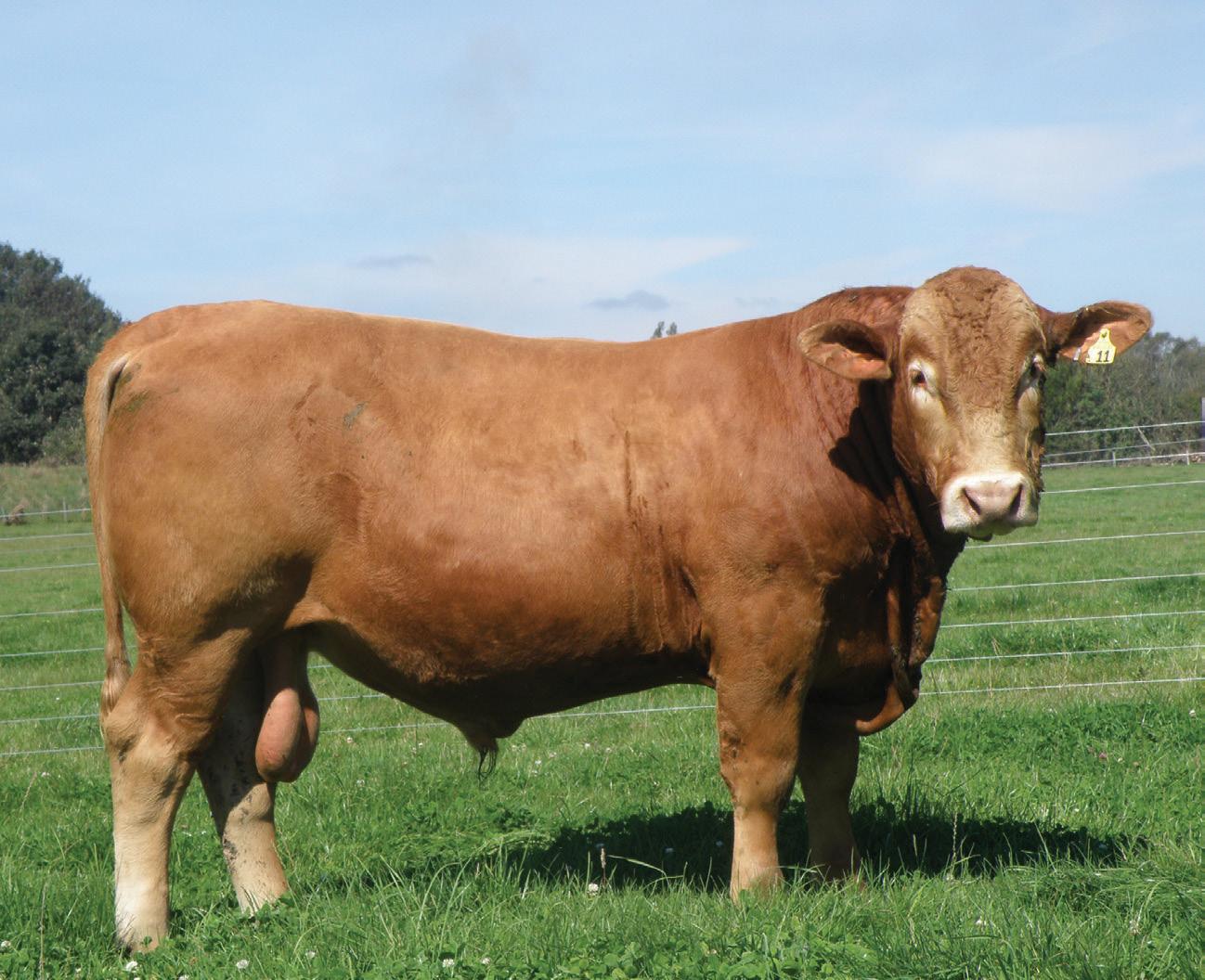
Woodleigh bull 23months old - 445kg carcass
Average NZ bull over 2yrs old - 300kg carcass
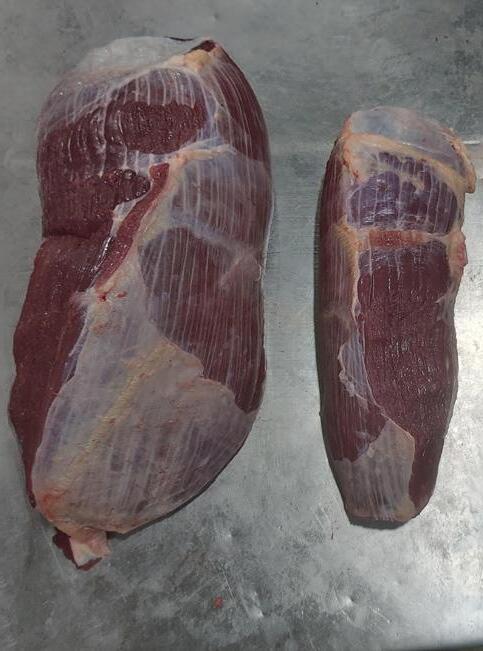
30 YEARS INTENSIVE SELECTION FOR EARLY GROWTH PRODUCES THESE RESULTS
Paddock sales rising 2-year-old bulls until 30 June
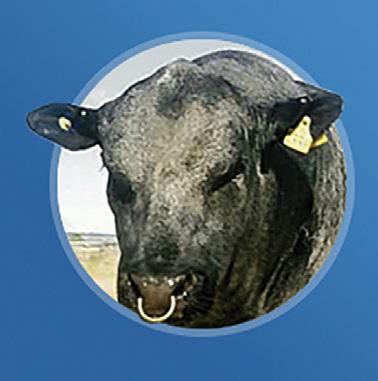
Catalogue available at www.belgianblues.co.nz

Lockwood Smith 022 458 0515 or lock@xtra.co.nz
On Farm Sale
Monday, 22nd May 2023 - 1.30pm
KAIMOA
Mark, Anthony and Di Eagle ‘Chessfield’
1775 Mangaone Valley Road
Eketahuna
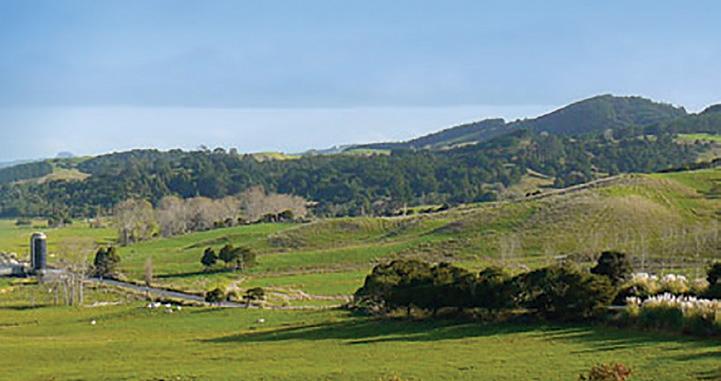
p: 06 376 8256
m: 027 434 7152
e: eagleeketahuna@xtra.co.nz
1775 MANGAONE VALLEY ROAD, EKETAHUNA
Kaimoa South Devons have pleasure in putting forward 22 Bulls in 2023
We are committed to producing meaty bulls with good frame, constitution and temperament. With clients’ needs in mind we have sourced new genetics from overseas to maintain the highest qualities in our bulls.
40 Country-Wide Beef | MAY 2023
Woodleigh Karena 17th with her 8-month Heifer Calf
wouldn’t like it either. The Department ran scientific trials that did everything but specifically test if West Coast heifers were being falsely accused of TB. The Department decided they didn’t have a problem; it was the farmers who had a problem, they were simply uneducated and troublesome. They also suspended a prominent veterinarian who spoke up on the issue, and continued to slaughter even more healthy heifers. And then, in the 1970s they chilled out and hired some people with epidemiological training who confirmed that, yes, there was an issue with testing in the West Coast. By 1977, they had adopted the recommendations presented to them 14 years previously by all the poor souls they had kicked to the curb. Sorry guys, we will do better next time.
WHAT DID THIS COST?
Ok so what’s done is done, but I think it is still fair to ask some questions. A great one to start with is “how much did this all cost?”

When the eradication programme was announced, it was declared that doing nothing about M bovis would cost the industry $1.3m in lost production, but for the cost of $886 million (paid in part by farmer levies) the disease could be eradicated. And that was the last anybody heard about the economics of the programme. I see many TAG reports asking to see the numbers, and I hope those requests were eventually fulfilled behind closed doors. But nothing has been publicly released. It is also difficult to judge how much money has been spent on the programme. The intention was to spend $886m over 10 years. I can see that there were grumbles about budget blowouts. Every now and then a vague “we have spent this much so far” number comes out, but there are inconsistencies. For example, it was reported that the programme had cost $635.9m in July 2021 and then it was a lower number ($588m) the following year in June 2022. And, I have yet to see any real breakdown in costs. I can see that $238m has been paid in compensation so far, but how much was spent cleaning farm equipment?
Programme administration? Meat processor top-ups? And writing all these reports?
HOW DID IT GET INTO NZ?
We are still none the wiser about how M bovis made its way into the country. Many people erroneously believe that Alfons Zeestraten’s company Southern Centre Dairies has been prosecuted for importing M bovis. But MPI has yet to prove that this farm is patient zero for the outbreak. In fact, reviews of imported cattle that have perished from pneumonia suggest that M bovis was making undetected breaches through our border as early as 2004, but these historic cases have no plausible link to the current outbreak. If these cattle deaths had been thoroughly investigated at the time, it may have prompted some vigilance at the border. It would have also been helpful if imported semen was limited to bulls that were guaranteed M bovis free, rather than relying on voluntary testing.
As it stands, we don’t know if the disease got in because someone broke the rules or because the rules were not good enough to keep the disease out.
HOW IS M BOVIS SPREADING BETWEEN FARMS?
If we asked this question early last year, then it would have been a slam dunk. M bovis spreads through close cattleto-cattle contact or from feeding calves infected milk, duh. But recent events have blurred the picture somewhat. Firstly, there is a new strain of M bovis. And there are a cluster of farms in Canterbury that have picked up the disease without bringing in any infected stock or milk. It seems that the disease has managed to jump a few kilometres from the affected Five Star Beef feedlot (possibly via seagulls or flies) and then spread across boundaries through brief contact between cattle from neighbouring farms.
Country-Wide Beef | MAY 2023 41
...I
but how much was spent cleaning farm equipment? Programme administration? Meat processor top-ups? And writing all these reports?
Nicola Dennis is a scientist, data wrangler and writer.
can see that $238m has been paid in compensation so far,
How can you reduce your reliance on imported feed?
MAYBE THE ANSWER IS SIMPLY TO GROW A BIT
With the air of uncertainty around imported feeds in both the short and long term, now is a good time to explore alternatives. And you don’t have to look far. Planting an extra paddock in maize at home, or ordering more maize silage in, may be all that’s needed. Maize silage is the ideal supplement to pasture. The cows love the stuff, it helps you maintain high production and milk quality when your feed levels dip (and will keep for years if they don’t). To find out about adding more maize to your farm system, contact your local Pioneer representative, call 0800 PIONEER or visit pioneer.co.nz/maize-silage
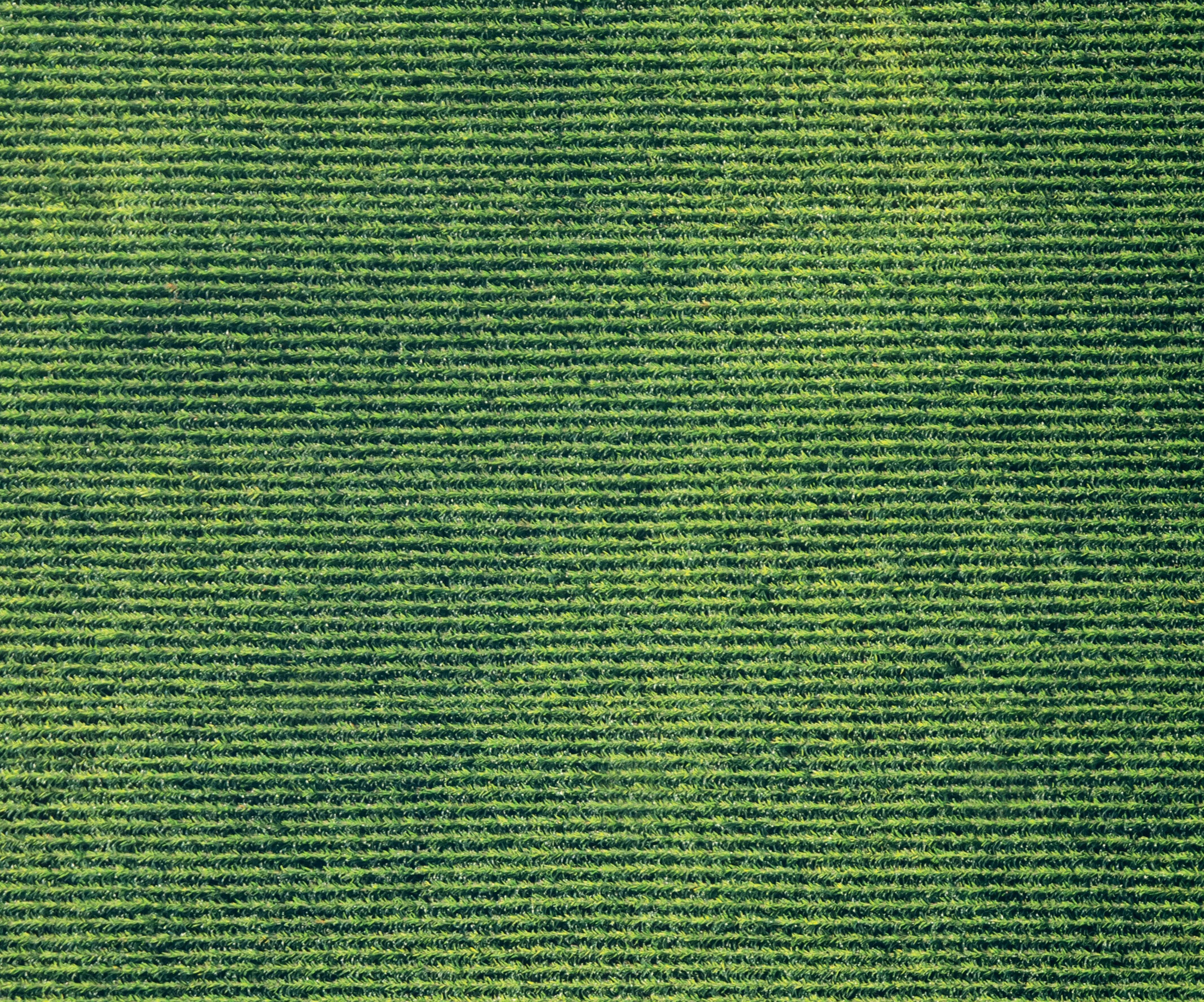
Putting on the beef A
SIMMENTAL HEIFER GAINED
massive media attention nearly 50 years ago when it was guided into the lift at a Christchurch hotel and transported to the top floor to be sold at a gala auction event.
The publicity stunt worked and the heifer was reputedly sold for $47,500 to an Australian buyer, keen to get a head start on building a purebred herd using embryo transfer.
They were heady days in the early 1970s when Simmental cattle first arrived in New Zealand in a wave of ‘exotic’ breed imports including Charolais and Limousin.

middle of Wellington Harbour. Further small consignments were imported from Europe and the United Kingdom in the following years. Not surprisingly, there was enormous demand for any purebred Simmental or Simmental-cross cattle in those early days, and prices around $50,000 were not uncommon.
Just over 50 years later, the Simmental breed is the third-ranked breed for registered stud females in the country. Simmentals have secured their place among beef bull buyers and the breed is now experiencing growing demand from dairy farmers looking for low birthweight
EXTRA.
The original consignment of 20 purebred Simmental females from Germany was arranged by the Ministry of Agriculture & Fisheries and the fledgling NZ Simmental Association. These animals were offered to buyers through a ballot system. The lucky cattlemen made their selections while the cattle were completing their quarantine at Somes Island, in the
beef bulls for their herds.
Breed society president Tracey Neal says the opportunity for cross breeding with the large British breed cow base in NZ was the major attraction farmers had for Simmentals in the early 70s.
“Heterosis was in play and it was a free lunch for many breeders who used Simmental bulls over their British breed cows. The progeny were exceptional and
Simmental-sired weaners are often still among the top-priced pens of calves sold at weaner fairs right across the country,” she says.
Neal says the terminal sire bull market remains the primary outlet for Simmental bull breeders, but many are now targeting the dairy bull market and Simmentals are prominent in the rankings within Beef + Lamb NZ’s dairy bull progeny test.
It hasn’t all been plain-sailing for the breed in NZ. It took 15 years and heavy culling to overcome the stigma of Simmentals being renowned as a stroppy breed.
“As a breed society, we were the first to introduce an estimated breeding value (EBV) for docility and to measure docility in our heifers at both weaner and rising two-year-old stage, so we could cull poorly ranked cattle from our herds,” she says.
Today, the Simmental NZ breed society has 45 stud members across the country.
A recent herd tour of Northland snapped a two year gap in activities because of the travel restrictions imposed by Covid-19, also putting a hold on plans for a big celebration of the breed’s 50 years in NZ.
At an individual stud level, two Hawke’s Bay studs have reached the milestone of 50 years of breeding Simmental cattle.
The late John Absolom was a successful buyer from that first consignment of cattle. He preferred to build his Rissington stud through grading up using imported semen rather than paying excessive prices for the few purebred cattle available at the time.
Another Hawke’s Bay cattleman, Tony Thompson, marks 50 years of breeding Simmentals this year at his Glen Anthony stud near Waipukurau.
43
INDUSTRY
+ Glen Anthony 50th year plans, see page 154.
MAKING EVERY

MINUTE COUNT
Sheep and beef farmers Steve and Cheryl Hirschberg have three children, three farms and they still find time to participate in the Coast to Coast and Ironman competitions. Story and photos by Sarah Horrocks.
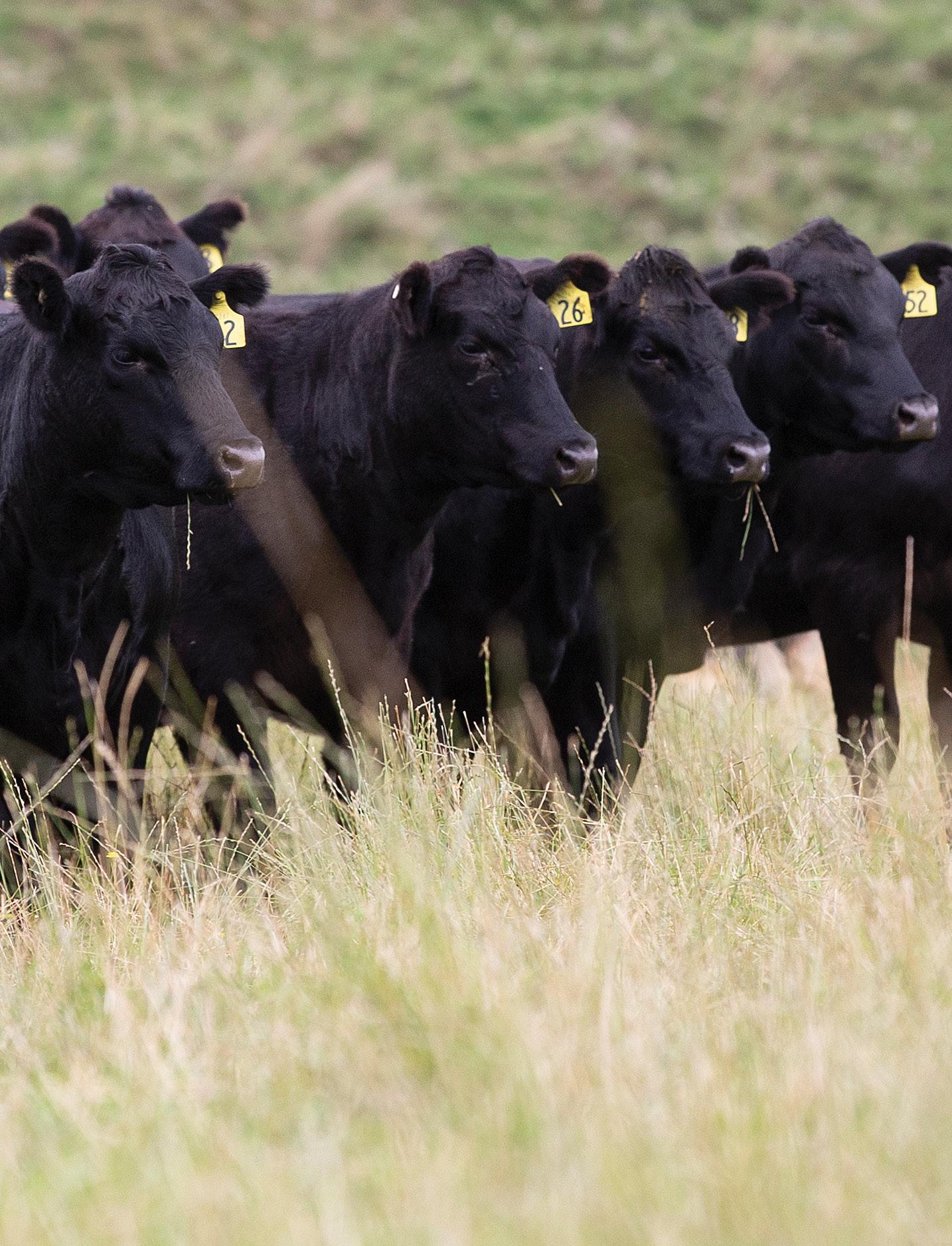
inning Steve Hirschberg down for a yarn is no easy feat. Even once inside his house, he insists on standing in the kitchen while chatting, as he makes lunch during this brief break in his day. His phone rings constantly as he organises stock trucks, fertiliser spreaders, and shepherds, but eventually enough information on his farming operation is extracted.
Steve and wife Cheryl run 800ha (effective) just east of Apiti in Manawatu. The original home block was his grandfather’s – bought in 1927. In 1996 Steve left his role as rural manager for the National Bank to move back to the home farm with Cheryl, and over the years they’ve sold and bought various different farm blocks nearby. The system is a mix of family trust and partnership – comprising three relatively equal-sized blocks that range from 400m up to 600m above sea level.
“Countless people have helped us to get where we are today,” Steve says.
Over the years Steve and Cheryl have been through some tough times with farming.

Steve says especially through 2008, 09, 10 and 11 with droughts and low stock prices.
Cheryl originally trained as a medical sonographer and it was her innovation to diversify into the sheep scanning business that got them through, enabling them to keep building on their landholding dreams.
“For 23 years Cheryl was beaten up in the winters but she got us through those tough years.
Cheryl was scanning up to 120,000 ewes a season, until one evening four years ago she came home from a long day in the yards and decided enough was enough. Her attention to detail (through her medical training) made her one of the best scanners in the country, but it was time to hand her clients over to industry colleagues and take a break.
Steve and Cheryl’s most recent land, bought in June 2021, was what they refer to as “Kate’s block”, after stock manager Kate White who lives in the house there. The block is 325ha and boasts 80ha
46 Country-Wide Beef | MAY 2023
of flats, bringing the total flat land count to 200ha across the three blocks.
The overall farm is classed by Beef + Lamb NZ in their economic services farm survey as Class 4, medium hill country and Steve agrees that this is an accurate representation.
The extra flats made the new block appealing for finishing country.
Steve oversees the entire operation, with Kate at his side managing the stock on a day-to-day basis.
“I’d be completely lost without Kate!”
The farm runs 30% cattle and 70% sheep, with the straight Angus herd used solely to clean up pastures for the sheep.
The cattle have to pay their way but they need them for the sheep programme.
Cattle are a valuable tool
There are 150 mixed age Angus cows, as well as 40 R2 heifers and 80 yearling heifers. All the maternal cows and replacement heifers are kept on the home block, the first and second calving heifers are kept on the higher terrace block and the B cow mob are
Opposite page: Steve and wife Cheryl out with a mob of two-year-old heifers, on their farm just east of Apiti in the Manawatu. The original home block was Steve's grandfather’s – bought after he came home from Gallipoli.
Left: All yearling heifers are mated to low birthweight Angus bulls which Steve says is essential to his farming system.
farmed on the new block – Kate’s block.
All the yearling heifers are mated to low birthweight Angus bulls, which Steve says is essential to his farming system.
“Breeding cows are unprofitable enough as it is without not getting a calf out of them.”
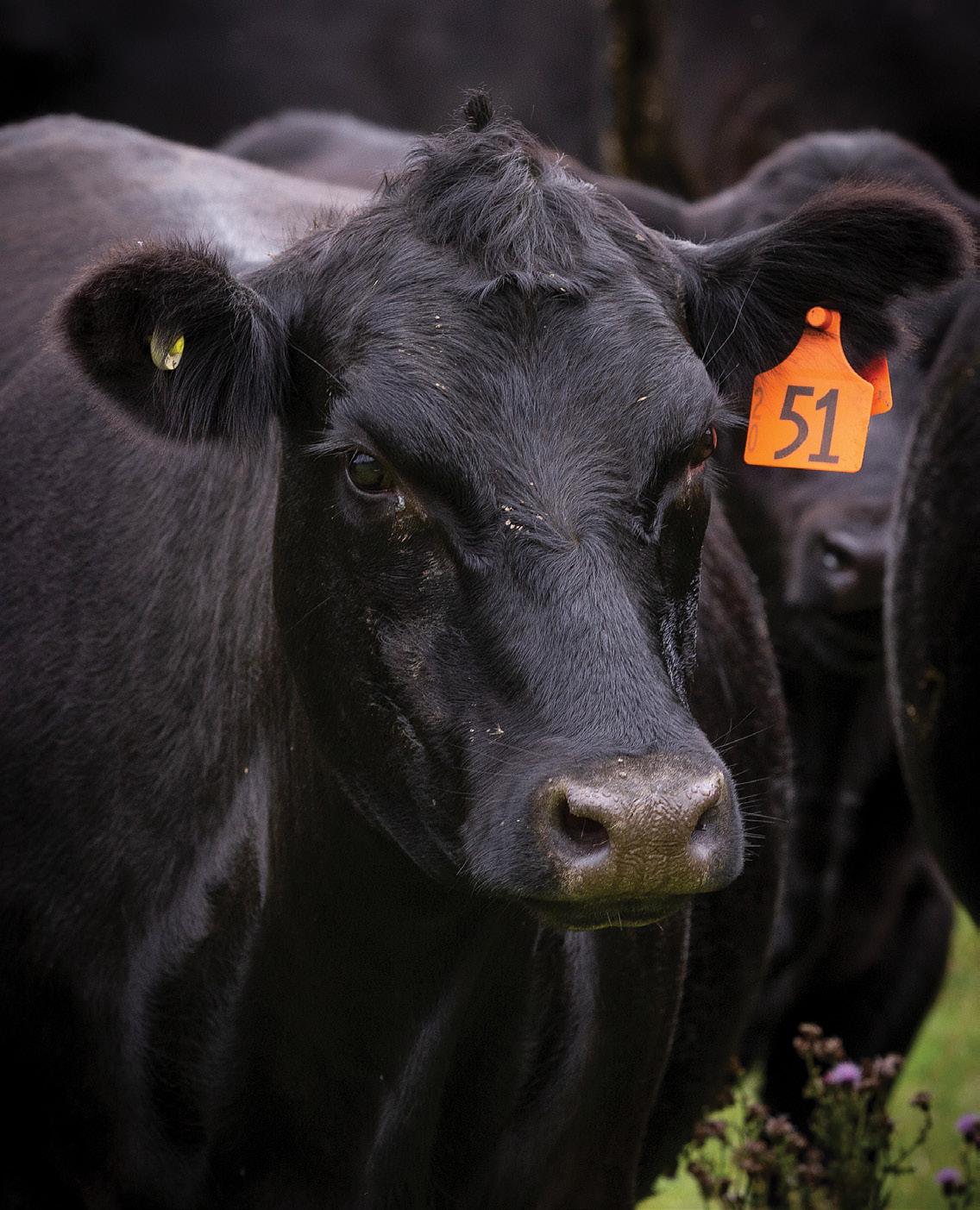
Steve once read that if you don’t mate them until they’re a three-year-old they deposit too much fat around their mammary glands and it affects their future milking performance. Whether this is true or not is almost beside the point for Steve as there’s another benefit – calving yearling heifers gives him a gauge on temperament earlier, so females can be culled before being carried through to three years old.
“If I’ve got a wild cattle beast, I’ve only got myself to blame.”
The Angus bulls have been sourced from Ngaputahi, Stokman and Komako Angus in recent years, after having problems with structural breakdowns in the past. Since shifting breeders they’ve not had any issues.
Steve has developed a great relationship with Forbes and Angus Cameron at Ngaputahi, where he also buys his Romney rams, and enjoys the interest they take in ensuring everything is going smoothly with the bulls throughout the year.
Usually he’s looking for the best two-year-old bulls he can afford – moderate mature cow weight EBVs with above average 600 day weight figures and good ease of calving. He will try to buy the curve benders to suit the heifers and get that good growth.
Steve says because they’re killing rising two-yearolds, the 600 day weight is important. He doesn’t buy specifically for intramuscular fat, but knows it’s on the Ngaputahi and Stokman radars, so is going to get it anyway.
“Our profitability comes down to every cow having a live calf.”
The bulls are put out on December 10, with 45 heifer replacements part of the 250 females that go to the bull in total. Everything is scanned in April and anything that’s dry is culled. The remaining
Country-Wide Beef | MAY 2023 47
ONFARM
LIVESTOCK
ORARI GORGE HEREFORDS
NEW SALE TIME 1.00pm
59th ANNUAL BULL SALE WEDNESDAY JUNE 7th 2023 at 1.00PM

ORARI GORGE STATION, GERALDINE
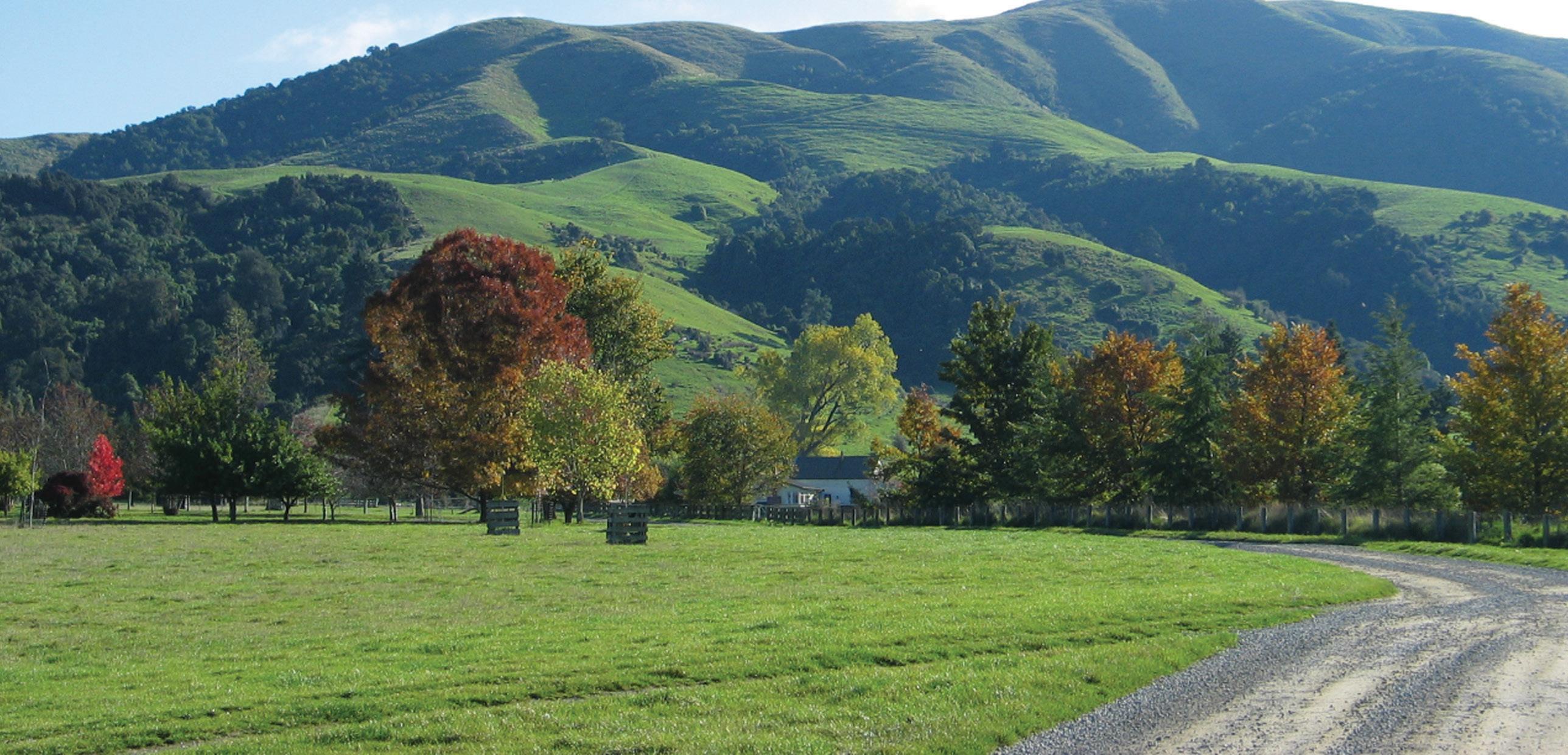
The main objectives of the herd have always been to focus on breeding functional, structurally-sound cattle with good conformation to meet today’s market. Running more than 100 bulls in one management mob with regular weighing, muscle scanning, body condition scoring and DNA testing our WHOLE herd ensures highly accurate data. We have nearly 700 fully recorded cows wintered on steep, high tussock country over 3000ft from weaning to calving. Snow is a frequent problem, challenging the Hereford longevity, constitution and soundness. As early adopters of BREEDPLAN EBV analysis, we have over 30 years of records to show strong genetic progress to benefit all our clients from lowland to high country.
SOME OF THE BEST MARBLING IN THE COUNTRY • BALANCED TRAITS = MAXIMUM PROFITABILITY
ALL SALE BULLS ARE BREEDPLAN RECODED • INDEPENDENTLY STRUCTURALLY ASSESSED • CARCASS SCANNED
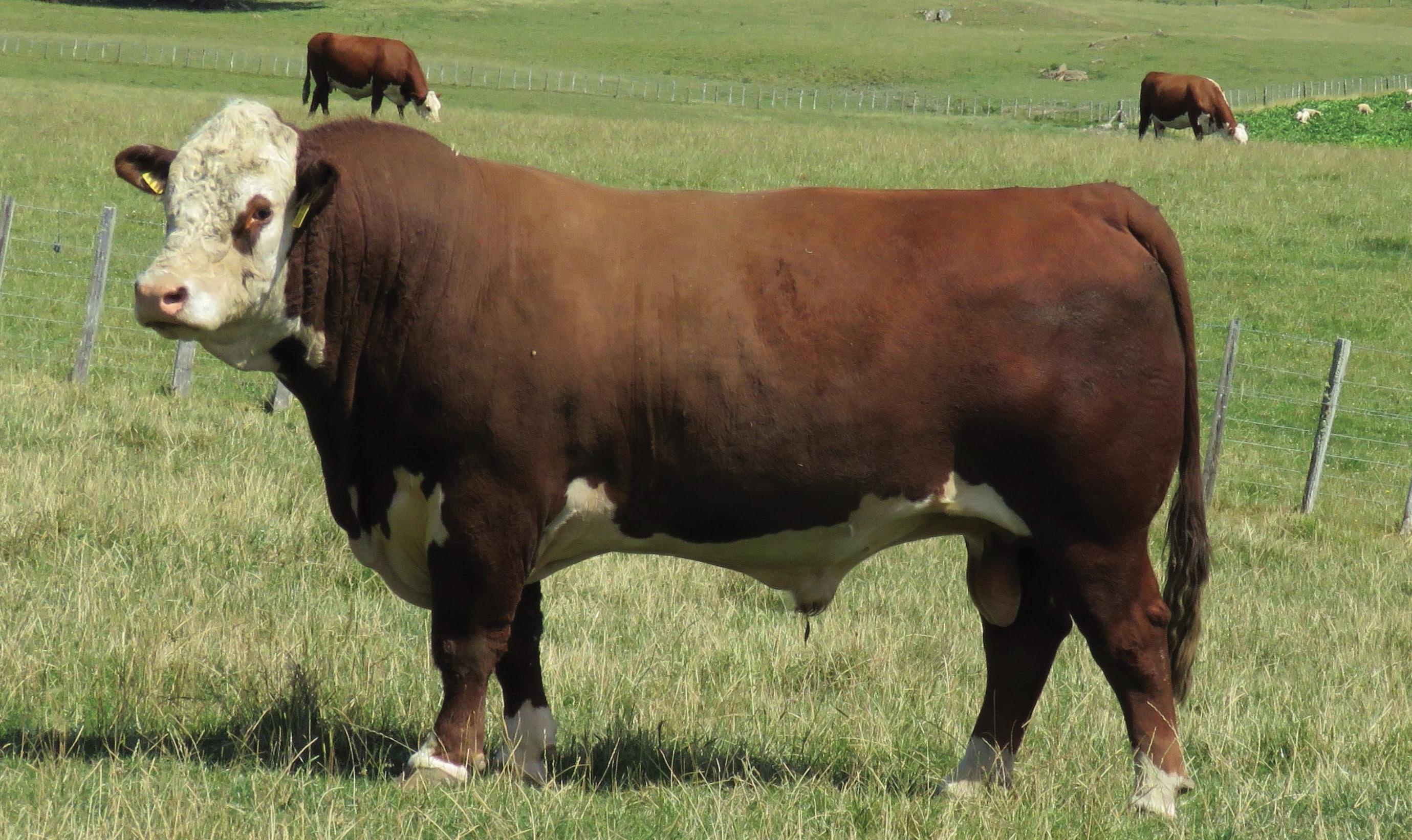

SEMEN TESTED • DNA TESTED FOR GENOMICS, SIRE + DAM VERIFICATION AND CLEAR OF ALL GENETIC CONDITIONS
BVD TESTED AND VACCINATED • TB STATUS C10
48 Country-Wide Beef | MAY 2023 POLL HEREFORDS Est. 1962 Alistair & Eileen 06 372 7861 Email: studstock@tetaumata.co.nz 150 Te Kopi Road, Gladstone, Wairarapa www.tetaumata.co.nz BEEF INDUSTRY DRIVEN PERFORMANCE FOR 60 YEARS Alistair & Eileen 027 4550 099 Email: mcwilliam@tetaumata.co.nz 150 Te Kopi Road, Gladstone, Wairarapa www.tetaumata.co.nz TE TAUMATA 44TH ANNUAL POLL HEREFORD BULL SALE MAY 31ST 2023 at 1.00pm Te Taumata Genetics For electronic sale and catalogue and pictures www.tetaumata.co.nz Te Taumata Justice 18119 D BVD VACCINATED • TB C10 • CARCASE SCANNE • FREE DELIVERY Robert and Alex Peacock • Tel 03 692 2893 • Email
Graham and Rosa Peacock • Tel 03 692 2853 • Email rosa@orarigorge.co.nz WWW.ORARIGORGE.CO.NZ
Formerly known as Nithdale Herefords Established 1947 SALE BULLS INCLUDE SONS OF ORARI GORGE TATHAM 190033 ORARI GORGE TARZAN 190091 ORARI GORGE QUOIT 160105 ORARI GORGE TOLKIEN 190083 LIMEHILLS SENSATION 170271 MATATOKI ROMEO 1803
robert@orarigorge.co.nz
ORARI GORGE STATION TRIPP SETTLEMENT ROAD, GERALDINE, SOUTH CANTERBURY 7991, NEW ZEALAND
KEY POINTS
800ha (effective) in Apiti,
50-odd heifers not put to the bull are finished and killed at 18 months of age.
As previously mentioned, the cows are a working tool to clear up the pastures, so Steve only carries as many cows as he needs to achieve this goal. For him, lambs are more profitable than beef progeny.
The bull calves are steered and killed over summer at 26–28 months old, to an average carcase weight (CW) of 330kg.
Steve doesn’t like the feed it takes to get steers through the second winter but has to if he wants 330kg CW.
All steers and the surplus heifers go into the ANZCO natural beef programme, who keep their premiums confidential. The criteria to enter the programme is that stock must be antibiotic free, grass fed and the farm must be quality assured. There’s no marbling criteria.
Steve was disappointed that ANZCO couldn’t take his post-Christmas cattle, and these had to be offloaded elsewhere at short notice.
“It’s bloody hard to farm like that.”
This lack of reliability in the beef processing system has meant he’s now considering leaving some of the bull calves entire and killing them at 18
months of age as bull beef instead.
In total there are 120 heifers and steers killed annually and all the supply contracts are left in the hands of Steve’s stock agent.
While very little technology is used within the cattle system, Steve has considered AI to reduce the bull buying costs, which is about $6000/bull. However, after doing the research, he realised the need for bulls wouldn’t decrease much, due to the demand on them during the second cycle with fixed time AI.
“AI conception would have to be up about 80% or more to reduce my follow-up bull needs.”
As well as the cow herd, Steve also runs a dairy bull programme. He buys 70 weaner calves a year from the Feilding sale yards, but once Kate’s block has been through more re-grassing, he will look to run up to 200 Friesian bulls.

They’re on a straight grass programme and they’re killed at 18 months of age. In fact there are no crops for any of the cattle at all.
“I hate mud.”
The mention of mud stops Steve talking as he reflects on the damage and hardships of those farming on the East Coast after Cyclone Gabrielle.
Country-Wide Beef | MAY 2023 49
Cows are a working tool to clear up the pastures, so Steve and Cheryl only carry as many cows as they need to achieve this goal well.
Manawatu.
270 Angus females and 75 Friesian bulls.
5335 Romney females and 7000 lambs. Finishing 4400 of 7000 lambs born. Processing through Ovation and ANZCO. Two full-time staff.
i
Gross farm income (GFI) $1747/ha.
Expenses are 46% of GFI. $5.52/su on animal health.
$152 average for lambs in 2020/21. $300,000 fertiliser budget. $60/ha for regrassing & cropping. 6.1% rate of return on total farm capital.
Lamb for dinner
There are 4200 mixed-age Romney ewes and 1135 ewe hoggets on the farm and Steve’s thought process is all about live lambs on the ground and finishing as many as possible himself.
“The lambs are our main source of income.”
Only 1800 of the ewes go to maternal Ngaputahi Romney rams, with all the two-tooths getting a Poll Dorset and 1400 B mob ewes getting a Landcorp Texel or Focus Prime ram.
“With my sheep genetics I always try to buy the best I can,” Steve says.
The weather at lambing time can be a mixed bag of freezing cold easterlies and snow showers so there’s no early lambs, even though the climate at Kate’s block is a couple of weeks ahead of the top block.
“Early lambing is too much pressure, so we focus on live lambs on the ground.”
Lambing dates reflect the change in climate over the three blocks, with rams going out on April 3 on Kate’s block, then a week later on the home block and April 17 for the high block. There is a two-week gap in the growth curve.
The scanning results are the proof in the genetic pudding for the sheep programme, with 209% in the mixed-age ewes and 195% in the two-tooths. The hoggets are mated also, and while they only
docked 90%, they’re still carried through if they don’t have a lamb.
High-octane feed is grown for the lambs. In 2022/23 that was 26ha of chicory and 12ha of rape/plantain mix. Steve finished 4400 lambs of the 7000 born last year, with another 1100 kept as replacements. The remaining 1500 were sold as store stock through Ovation, with Steve avoiding sale yards whenever possible.
“It’s all direct to farm.”
Not everything can be finished and Steve says the male Romney lambs are the hardest to get away. These are sold store at 34kg liveweight from January to March. They want to have their ewes in acceptable condition going into the autumn.
In early March 2023, Steve only had 1600 lambs left on the farm and although the yielding was back on grass-finished lamb this season, Steve is pleased with how his lambs have performed.
“The lambs on chicory are smokin’.”
The lambs killed pre-Christmas off mum are 18.5kg CW and then after weaning on Christmas eve, the next 2000 lambs go out in January at 19.5kg CW.
“Christmas and New Year couldn’t come at a worse time for our farming system.”
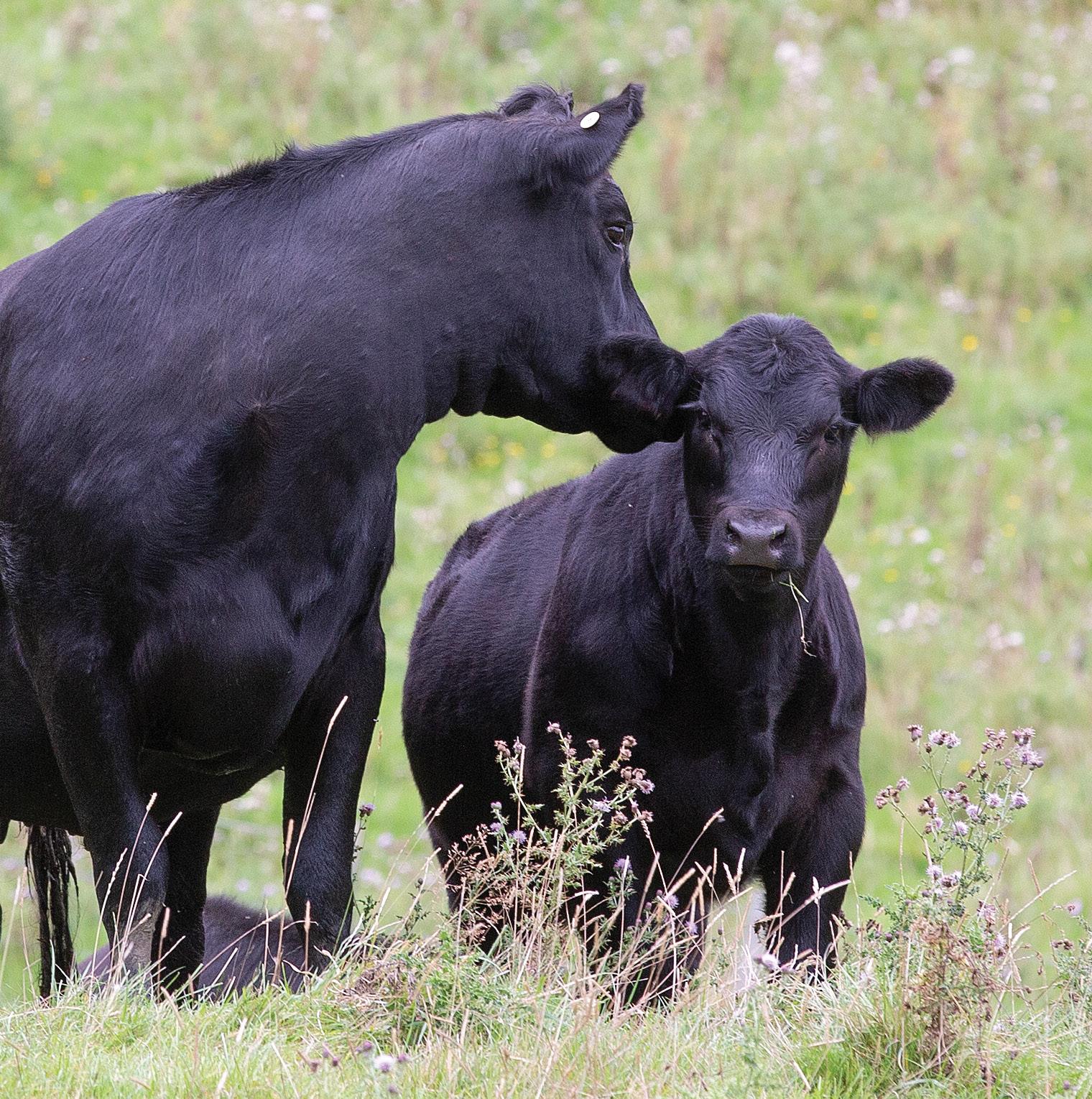
The top block isn’t weaned until January but that doesn’t stop Steve getting every lamb on the farm away by June.
The total lamb production per hectare over the 2020/21 season was 142kg, well above the Beef + Lamb NZ survey’s class average of 99kg/ha. In the 2021/22 season Steve averaged $152 for every lamb on the place, although this will be back $30 this season.
Woeful wool
Shearing is a cost that Steve and Cheryl would rather not think about, with it costing them far more than it reaps every year.
“We’re paying $5.50 a sheep, which is right up there.”
The wool is almost worthless, as every strong wool farmer is well aware, but Steve is determined that he will continue his six-month shearing policy. It’s all about lamb survival for him.
Steve quotes considerable research that’s been done to suggest that there’s up to half a kilo advantage in lamb birthweight from winter shearing your ewes. The shearing needs to be done
50 Country-Wide Beef | MAY 2023
Steve’s profitability comes down to every cow having a live calf.
i
FINANCIAL
during the window of 70–85 days gestation. And that extra half kilo is all about lamb survival.
“Massey have proven the metabolic changes affecting the placenta, which pumps more into the lamb.”
Steve and Cheryl have been using the same shearing contractor for 20 years but their two sons, Bryce and Darren, are capable shearers so they chip in and help where they can.
Steve and Bryce shore all the rams this year, although Steve reckons Bryce well and truly stitched him up.
“He had a nice pen of Romneys and my pen had all the Poll Dorsets.”
Their daughter Sara also has an interest in farming, living near Dannevirke with her husband and three children.
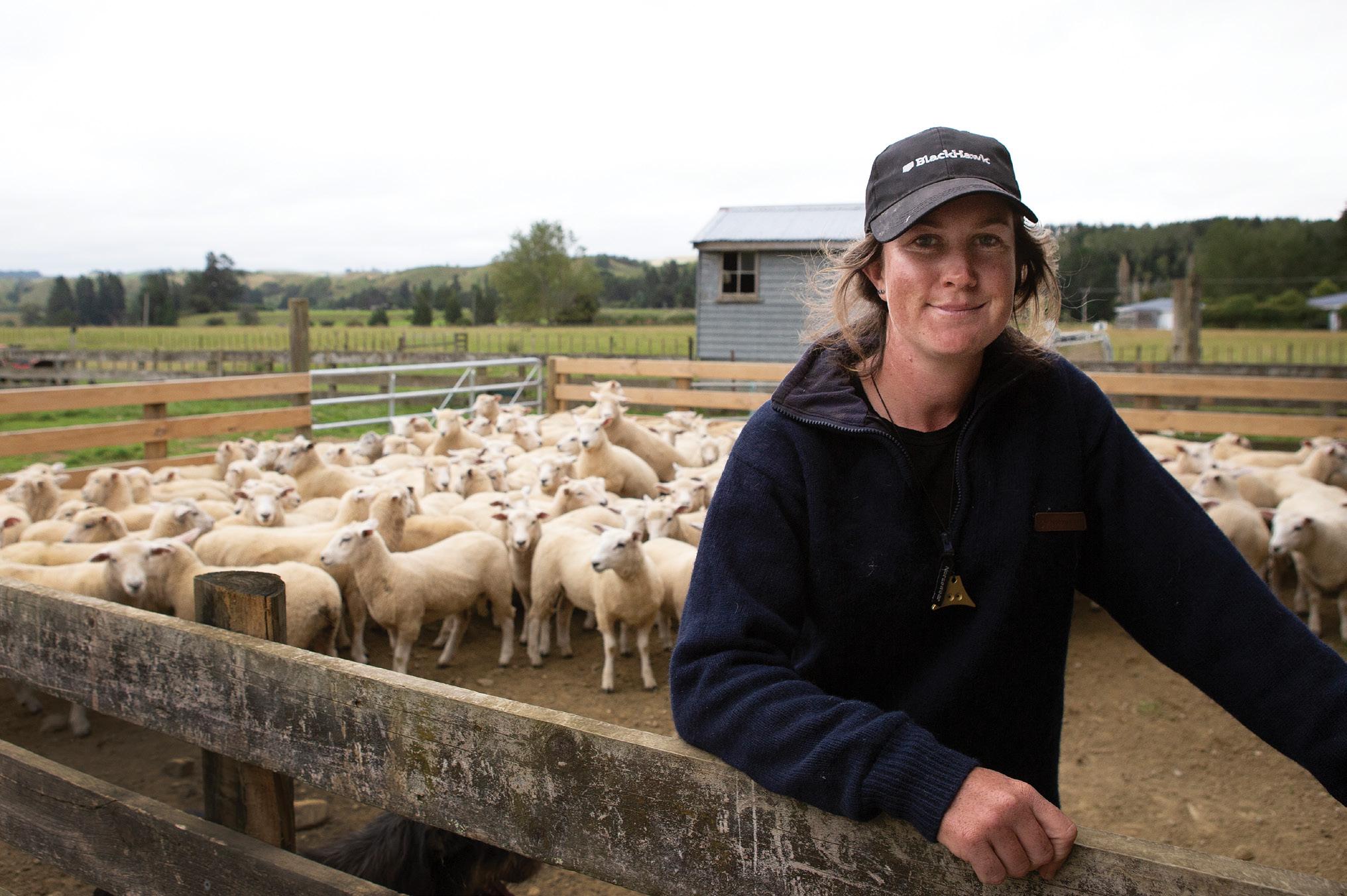
Animal health
As analysed by Beef + Lamb NZ, the animal health costs sit at $5.52/su. The cattle get oral drenching, once as a weaner and then again six weeks later. Then again in the spring, and the following spring as well, if they’ve gone through a second winter. No cows are drenched after two years old unless Steve
sees a light three-year-old after weaning. A pour-on is used for lice and as well as BVD jabs in all the females (two for the heifers), copper bullets are given to the weaners and also the cows before they’re set-stocked with the ewes in midAugust.
“The bullet means that I don’t have to give them a jab pre-mating.”
The lambs are drenched two weeks before weaning and then again in mid-January before shearing. Some went six weeks without a drench this season.
Steve does faecal egg counts regularly to try to reduce the amount of drenching being done. The maternal ewes aren’t drenched at all, but the B ewe mob gets capsuled to slow the worm burden in the pasture contamination on Kate’s block.
He says it was all sheep prior to them taking it on, so it has high contamination.
Growing grass
Steve likes to ensure that the basics are done right in his farming system, and that includes fertiliser.
“I haven’t missed a year of putting 20 units of P on the hills in 27 years.”
Country-Wide Beef | MAY 2023 51
Stock manager Kate White at the yards with a mob of lambs.
“Early lambing is too much pressure, so we focus on live lambs on the ground.”
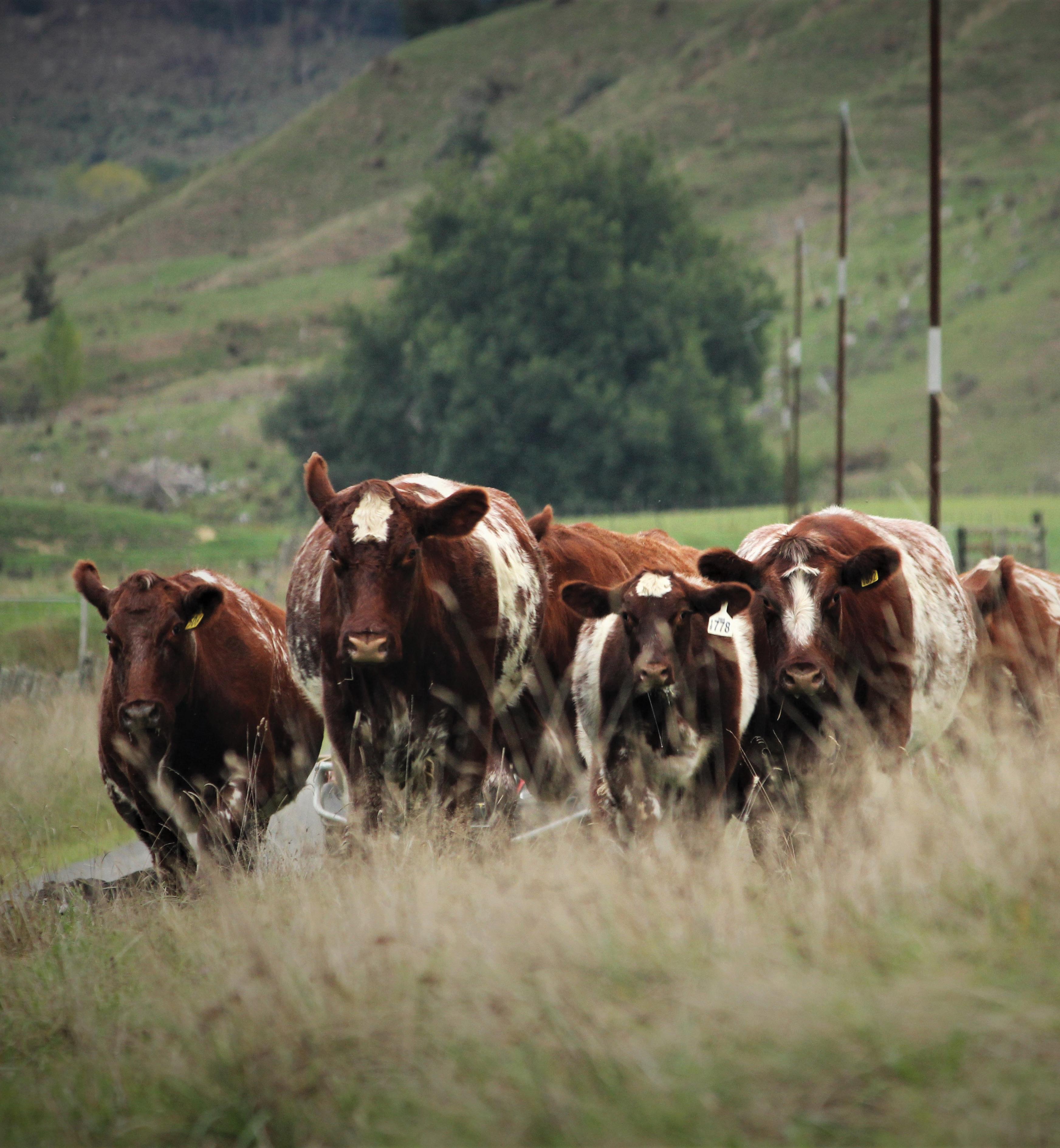

52 Keep an eye on our facebook and website for updates www.shorthorn.co.nz Check them out Lochburn Taupiri IC Heifer Sale 12th June, 1pm 027 290 9040 - Barbara Stoneford Matamata Private Sale 027 253 3769 - Bobby Colvend Ongarue Sale 30th May, 3.30pm 07 894 6030 - Alan Mangaotuku Stratford Private Sales 06 765 7269 - Jack Westwood Tuatapere Private Sales 03 226 6713 - Anita Mount Ronga Rai Valley Private Sales 03 571 6108 - Charlie Rough Ridge Ranfurly Sale 19th May, 11am 03 444 9277 - Malcolm Raupuha Mahoenui Bull Sale 30th May, 1.30pm 07 877 8977 - Russell Glenrossie Whangarei Heads Sale 30th June, 1pm 09 434 0987 - David 09 434 0718 -Will Hiwiroa Waipukurau Private Sales 027 428 8821 - Nick 06 858 5369 - Jim Hinewaka Sale 7th June, 3.00pm 027 496 1462 - Mitch Browns Ohinewai Bidr Sale 26th June, 7pm 027 449 4175 - Hamish Glendhu Heriot Sale 23rd May, 11am Bidr Sale & On farm 027 497 8104 - Fraser Bullock Creek Waitara Private Sales 06 754 6699 - Roger Using a Shorthorn bull in your programcross-breeding will increase bottom line up to 20% Carriganes Cattle Dunsandel Private Sales 022 470 2447 - Sarah Glenbrook Station Omarama Private Sales 021 285 9303 - Simon Mill Valley Whangamomona Private Sales 06 762 3520 - Aaron Roscliff Te Awamutu Private Sales 027 211 1112 - Ross Glenfern Tokanui Private Sales 03 246 8498 - Allan Turiwhate Kumara Bidr Sale 25th May, 7pm 027 379 8167 - Chris Carnegie Waiuku Private Sales 021 031 3091 - Bruce Renowned for great marbling producing high quality meat Looking for a Beef Shorthorn? Morton Katikati Sale 18th May, 1pm 021 520 244 - Craig Maerewhenua Omarama Private Sales 021 140 7518 - Norm Glenview Rotorua Private Sales 021 460 957 - Diane
Soil testing is undertaken biannually, with Olsen P levels of 13–14 on the hills and an acidity that sits at about pH5.8.
He says the fertiliser bill last year was $240,000 and they’ve budgeted $300,000 for 2023.
The normal policy includes putting PhaSedN or sulphate of ammonia in the spring. In the autumn it’s DAP and elemental sulphur, so it doesn’t get washed away in the winter. The hill country gets 20 units of P, 30 units of S, and then N twice a year, and the flats get 30 units of P but don’t have a huge requirement for S because it’s all ash flats.
In the 2020/21 year Steve spent $2.37/ha on fertiliser, well above the class average of $1.37/ha. This is partly due to so much of it having to be flown on by plane.
“I only get the truck over about 200ha.”
Lime is also put on, with the home and top blocks getting one tonne/ha and Kate’s block getting two tonne/ha.
“We’re slowly working our way around the new farm.”
Cropping and re-grassing costs are high – $60/ ha for the 2020/21 season, but this was due to a lot of re-grassing and direct drilling that was done on Kate’s block when they first took over. This was a necessary spend to get the grass and crops growing for the lamb finishing programme.
The total meat yield of the farming system is 235.5kg/ha over sheep and cattle, a figure that Steve and Cheryl should be pretty pleased with. But it’s the gross farm income that hits the mark – $1747/ ha or $188/su, and with total expenditure at only 46% of the gross farm income.
“It’s the rate of return that I’m more interested in,” Steve said.
That rate of return on the total farm capital is 6.1%, taken from the Beef + Lamb NZ economic service’s farm survey of 2020/21.

The future
When Steve and Cheryl were asked about the future of the farming operation, he was quick to answer.
“Retirement.”
He says he’s got three kids and three farms so there’s space for everyone in the years ahead. But for now he and Cheryl are focused on ensuring they make time for themselves and keep the place ticking over.
Off-farm interests are a big part of life for the pair, who regularly participate in adventure racing. They race in the Coast to Coast together as a team, as well as Ironman events and other gruelling tasks that
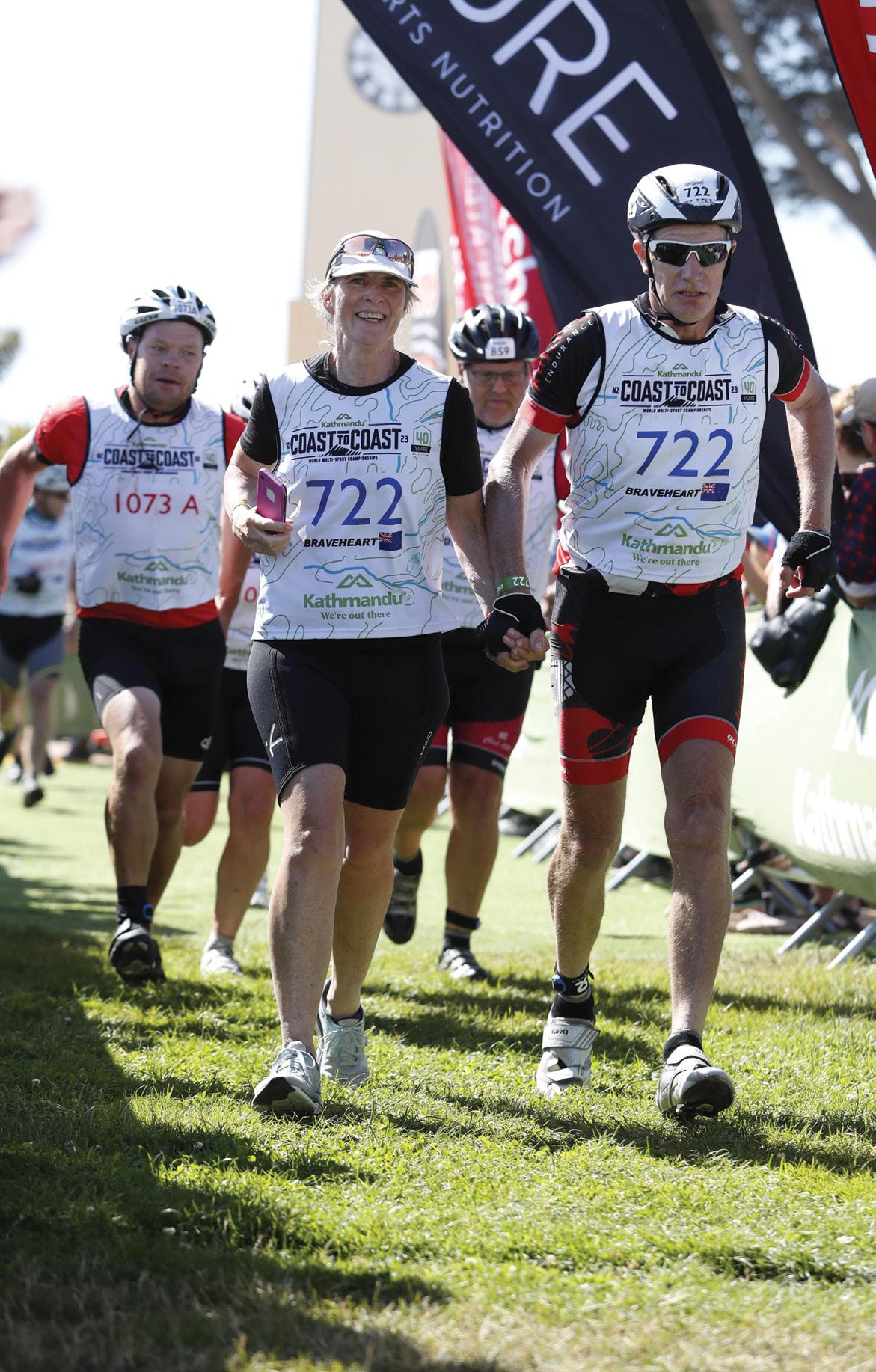
aren’t for the faint hearted.
“Sunday is our training day which means we get a day off the farm.”

Cheryl also works at the Broadway Radiology in Palmerston North as a sonographer two days a week. The commute is 50 minutes each way, made even longer thanks to the flooding during Cyclone Gabrielle taking out a bridge on the usual route.
Volunteer firefighting in Apiti is also on the agenda and thankfully their pagers didn’t go off during the visit.
“That’s our community service.”
The fact Steve and Cheryl are willing to volunteer time they don’t have is testament to the kind of people they are. Steve operates at a hundred miles an hour but he’s getting the results on the farm to prove that all the hard work is paying off. He probably runs in his sleep.
Country-Wide Beef | MAY 2023 53
Steve and Cheryl crossing the finish line as a team in the 2023 Coast to Coast.
LONG LEASE BUILDS TOP BUSINESS
Josh Jamieson and his family have made a comfortable living from the bounty of the Marlborough Sounds. But it’s taken a fair amount of hard work and entrepreneurship.
By Joanna Grigg.
Josh Jamieson’s father Talbot was a pioneer mussel farmer, setting up mussel lines in Pelorus Sound in the 1970s. This brought the family into the drowned valleys of the ‘top of the south’, and it was here that Josh first learned to drive a boat and muster the steep hills around the beaches.
Josh left school at 15 with a plan to work on farms and build his knowledge. Luckily his first employer was the late Tim Shand, a farmer in Port Ligar. Josh describes him as a great teacher and respected friend who taught him to enjoy farming.
By age 20, Josh had the confidence to take on his first lease block – one of the Harvey family’s blocks in Clova Bay. He bought 700 ewes and 40 cattle and ran the block alongside his new job as a casual shepherd at nearby Manaroa.
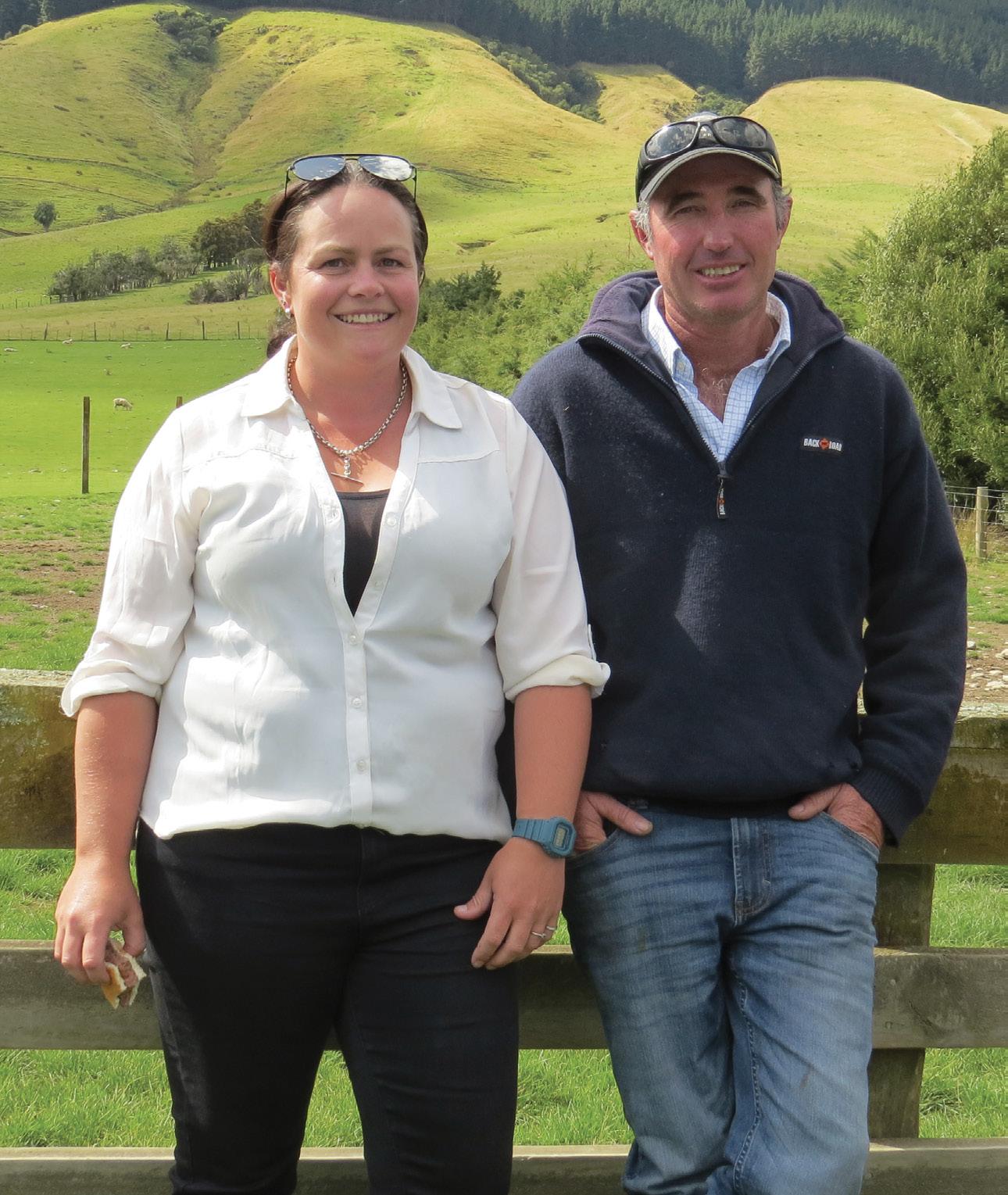
By the time Josh was 28 (2003), he was offered the job to manage Manaroa. This Clova Bay farm had a great mix of flats and hill, a good jetty and, most importantly, supportive owners. The 400 effective hectare (ha) area in Pelorus Sound, at the end of the Kenepuru access road, is owned by Prue Jackson (nee Rodgers). The Rodgers family also owns a farm, Ellerton, in Kekerengu (north of Kaikoura).
Two years later, in 2005, a lease offer was put on the table. Josh said it was a generous offer that started low to help him get going.
“It was a really good deal at the start, then has increased over time.”
Eighteen years later, the farm is in good heart, with regular weed control and fertiliser programmes and an enthusiastic lessee.
Out of earnings, Josh started subdividing paddocks and regrassing the flatter blocks. He has used some joint venture earnings and off-farm
54 Country-Wide Beef | MAY 2023
ONFARM
investments for further leverage and now owns a couple of blocks as well.
“The trick is to stay keen and focus on what you are good at and find someone to back you.”
Climate advantage
Josh and his partner Kate Hutterd have recently added another lease block, in nearby Waitaria Bay. This 50ha block has meant all steer calves can be finished prime by 18 to 20 months. The climate is so benign that in the first year of finishing the steers grew more than one kilogram every day, even all through winter.
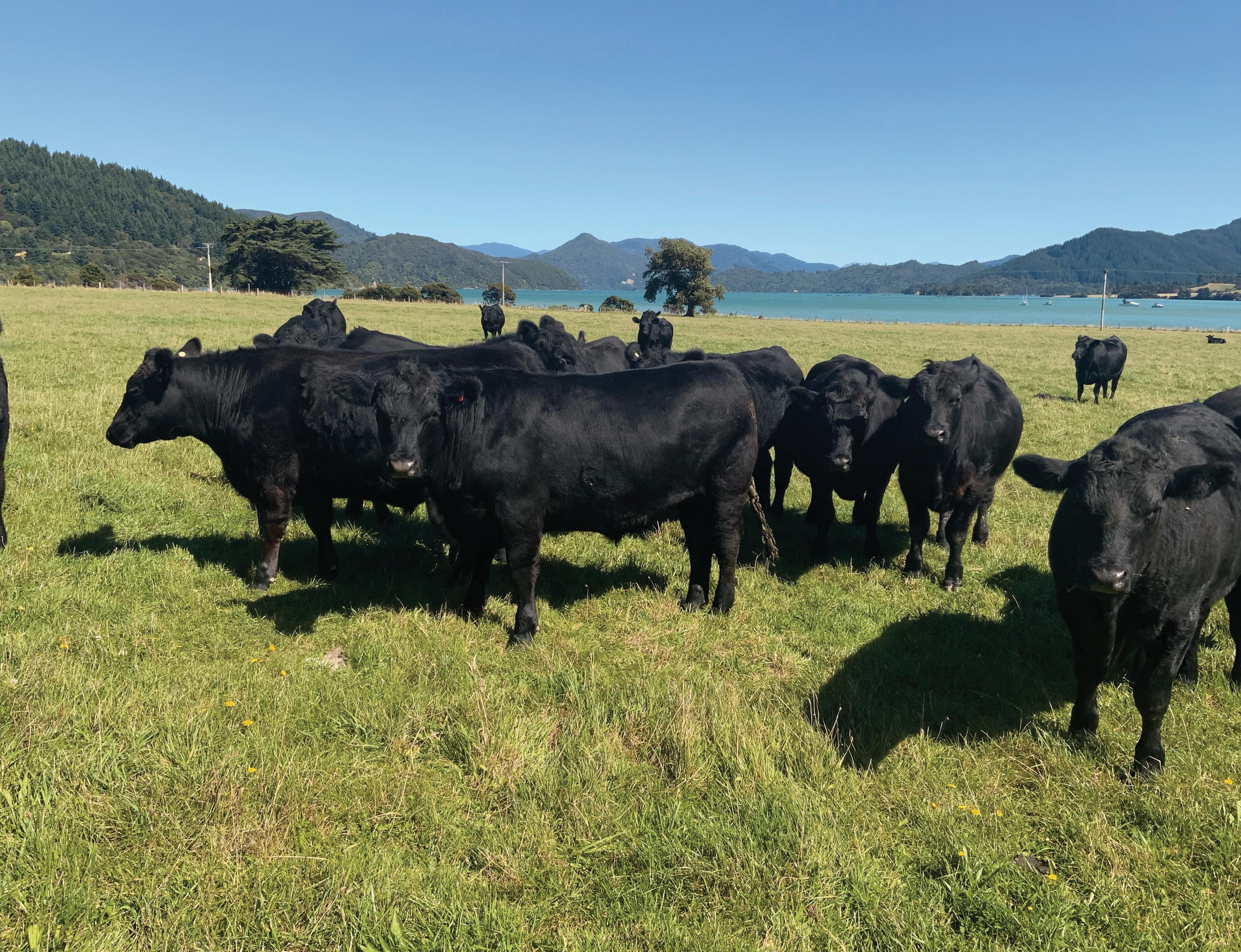
Josh says the winter was two frosts and a couple of foggy days.
“The stock agent asked us, ‘how do you do that?’ but it’s just that we don’t have that 50-day cold winter.”
Summer was a stunner with 2000mm of timely rain. Growth was fantastic, as
long as parasites were limited.
All up, 4350 stock units of sheep, cattle and deer (for velvet) are run at an impressive stocking rate of 9.7/ha. As Kate and Josh are the only labour, the stags are limited to 120 (300 stock units). They are the best returning stock class, cutting 8-9kg of velvet and making $247/stock unit (su).
“But we can’t be in the deer shed all day, every day, in spring,” Josh said.
Josh said to be wary of expensive lease costs.
“Often people ask way too much for land – driven up by dairy farm competition typically.”
The couple has a young daughter Willow who attends Waitaria School.
Greg Sheppard, Sheppard Agriculture, ran a comparison of Manaroa revenue estimates for the 2023/24 season (including cattle finishing) against the Beef + Lamb NZ Class 6 equivalent.
KEY POINTS
Leasing, joint ventures and buying small blocks.
450 hectares effective (100ha easy contour).
9.7 stock units/ ha.
380 deer, 2365 sheep and 1600 cattle su. Averaged $1700/ steer last season.
1200-2000mm rainfall.
145% lambing and 90% calving (cows mated/ calves weaned).
Country-Wide Beef | MAY 2023 55
i
Left: Josh Jamieson and Kate Hutterd at Manaroa.
Above: These 18-month steers are waiting to be loaded on a truck and barged out to Havelock.
Speaking at the Marlborough Beef + Lamb NZ Farming for Profit field day recently, he said the production and profitability was good. The farm’s operating surplus was expected to be well above the equivalent economic service farm in 2022/23 ($726 vs $349/ ha). Cattle are estimated to be earning an impressive $158/su next season – $20 ahead of the comparable Class 6 farm.
Costs are kept low (wages of labour is excluded). Shearing costs are half that of Class 6 farm average. Josh said this was because he used a freelance shearer and did all the penning up, pressing and providing food.
They also don’t shear lambs until late January, so most are sold before shearing.
Feed costs are also a fraction of the average.
Neighbour Mike Gerard, Hopai farm, told the field day his neighbour Josh was known as being “tinny” with his luck.
“The sun always shines at Manaroa when the shearers turn up.”
A fair bit of clever planning, hard work and good luck is a winning combination.
Finishing at 18-20 months
Josh has built his 110 herd of cows from 40 Angus heifers.
He won’t deviate from Angus.
“They handle what we give them and fatten much faster than the dairy cross cattle we tried.”
He rates them ahead of sheep and next season he expects his cattle to make more income per stock unit than sheep.
“Cattle are way easier to run and more economical.”
Bulls are chosen using EBVs with a preference for positive fat, low mature body weight and calving ease. The main stud bulls used have been from Mt Linton (Josh knew the manager there) and also Meadowslea, Fairlie.
“My theory is that a bull that is born into a 150-day winter will have progeny that love being here in the Marlborough Sounds.”
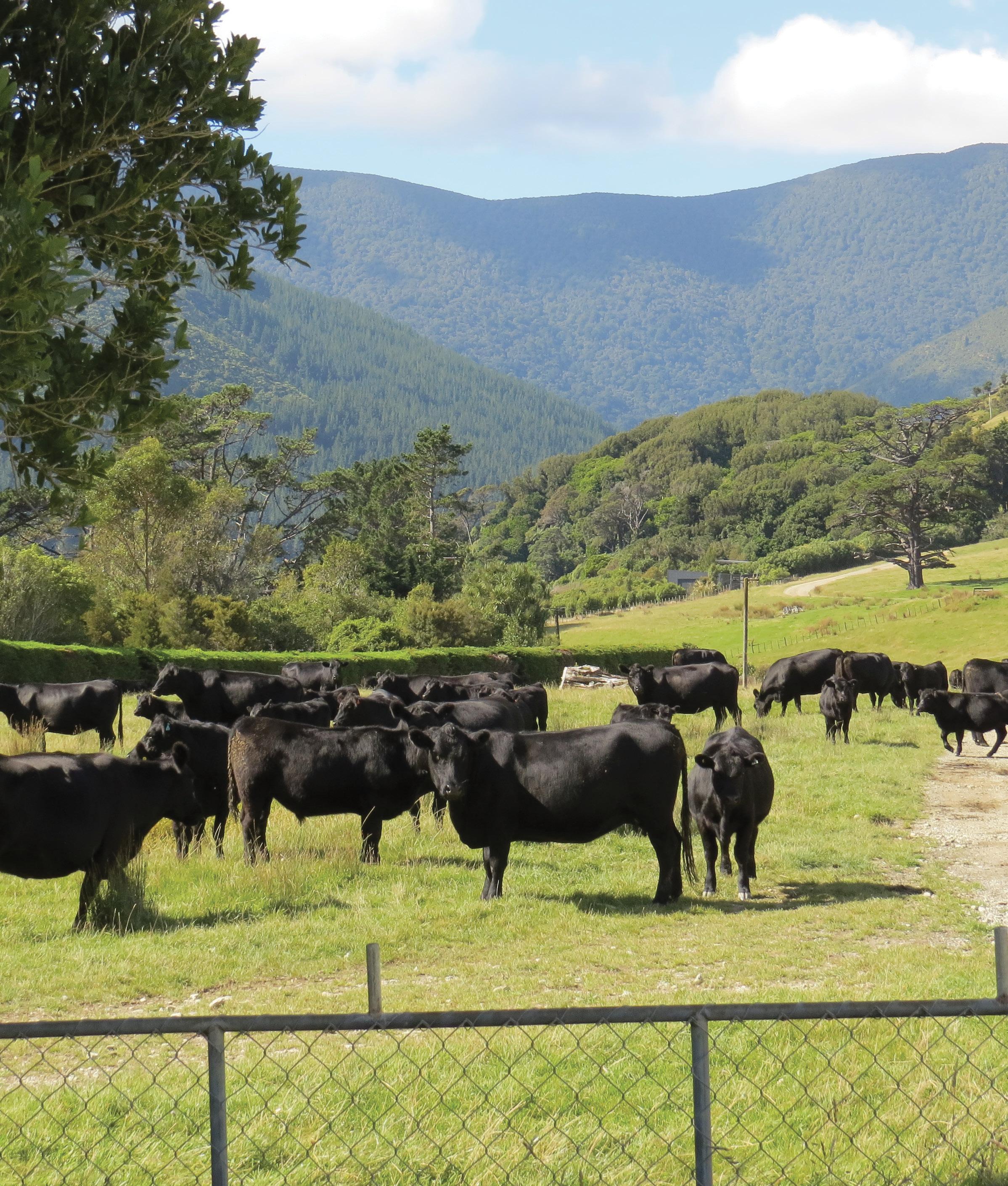
Rising One year heifers have not been mated in the past, although this year, 10
were put to the bull and all are in calf.
“I’ve never had to pull a calf from a cow.”
They are after a moderate cow size. Cows calve starting mid-September and are weaned early March. Calves are kept yarded for two days alongside their mothers, then the cows are walked away.
Josh and Kate run 1600 stock units of cattle all up and this includes the 120 young cattle on the 50ha lease block, an hour’s droving away at Waitaria Bay. Josh’s dad, Talbot, lives on site and is happy to shift the cattle every day.
The fast rotation has allowed all yearling steers and cull heifers to be
grown on to 300kg carcaseweight (CW) by 18 to 20 months. The first go prime by March. Feed costs are low as they only get one medium square balage a day (made on farm) and pastures are permanent, not cropping.
In July 2021 a storm did major damage to the main truck and trailer access road (Kenepuru Road). This meant all stock had to be transported to Havelock by barge from near Waitaria Bay – a four-hour trip. In August 2022, the weather struck again and the road was even more damaged, making it only suitable for utes with a trailer. Access is restricted to residents and plans for full repair – if at all – are still to be decided.
56 Country-Wide Beef | MAY 2023
"They handle what we give them and fatten much faster than the dairy cross cattle we tried."
Calves on the day before weaning, at Manaroa, Marlborough Sounds.
Manaroa (2023/24 estimate vs B+LNZ class 6 estimate 2022/23). Source: Sheppard Agriculture. Note: Class 6 = Northern South Island breeding and finishing. Estimates only.
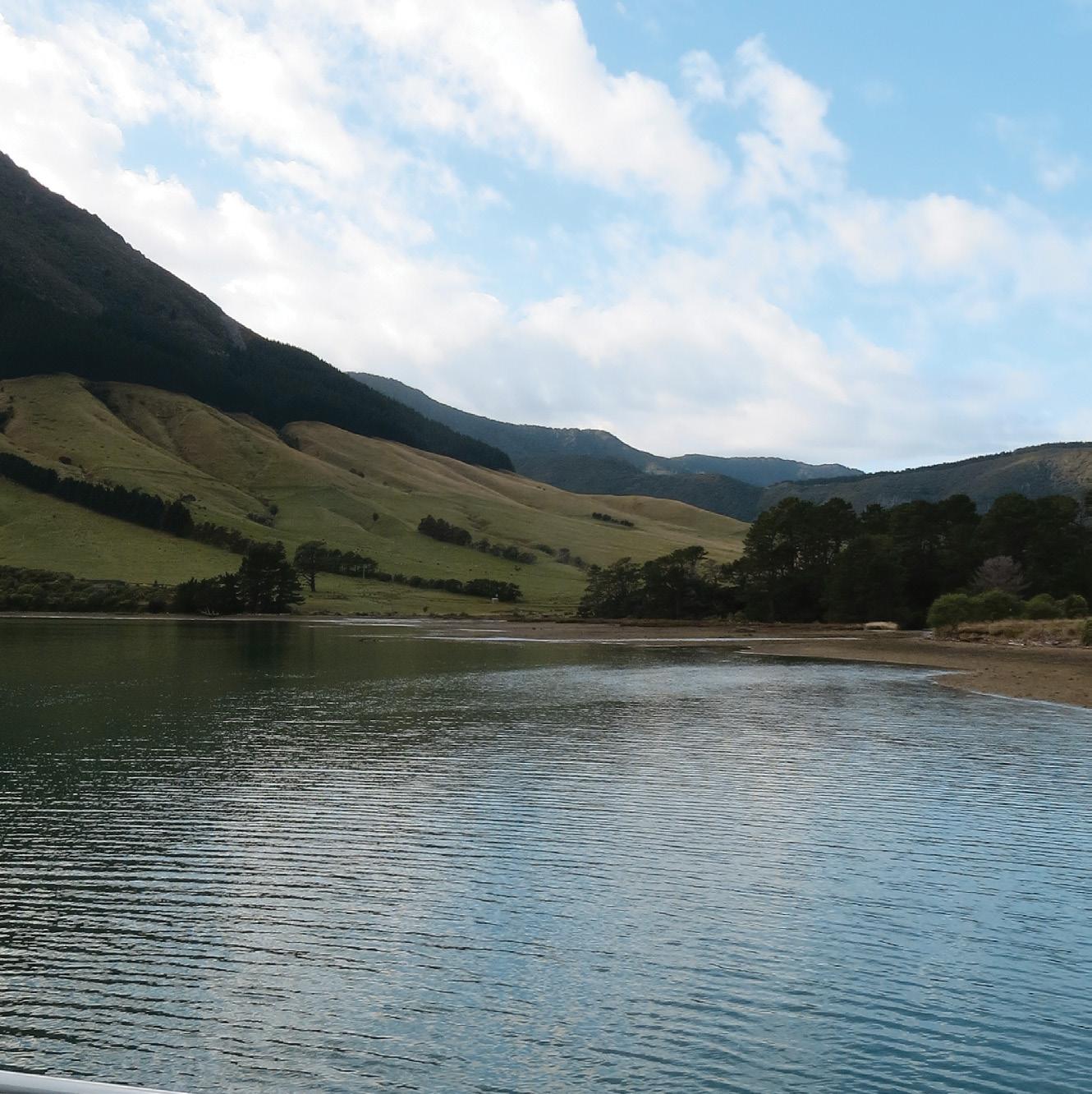
Meat company helps with access
The barge costs about $540/hour and the truck and trailer cost is on top of that. It can cost up to $4000 for a trip in and out. Meat company Alliance has come to the party, helping out with barge transport costs in return for local farmers committing to send prime stock to Alliance. About 30,000 local stock units go to Alliance.
Josh said almost all local farmers supplied Alliance now and it made sense to support them as they can take stock when they needed to offload.
They value the relationship and have sold to Alliance for the past 10 years.
Having financial support to get prime stock out is another incentive for Josh and Kate to move to selling prime stock. They averaged $1700/steer last season. The cattle meet the Angus Premium requirements, Josh said, which gives them another 30c/kg CW.
“It’s another $90 for a steer, which helps.”
Josh would like to try to get their cattle into the Handpicked Alliance programme but this requires a stock agent to visit
Country-Wide Beef | MAY 2023 57
Manaroa 2023/24 estimate B+LNZ Class 6 $ 2022/23 forecast Difference $ Sheep income $/ha $738 $804 B+LNZ $66 Cattle income $/ha $564 $378 Manaroa $187 Deer income $/ha $211 $20 Manaroa $191 Sheep/su $140 $168 B+LNZ $28 Cattle/su $158 $138 Manaroa $20 Deer/su $247 $98 Manaroa $149 Overall GFI/ha $159 $148 $11 Farm working expenses/su $75 su $117 -$41 Stock purchases (50 steers) $88/ha Farm operating surplus/ha before leases $726 $349 Manaroa $377/ha more
Table 1 Impressive cattle figures.
Manaroa runs sheep, cattle and velveting stags.
Red, White & Roans of our world
BULLS, SEMEN, GENETICS
MAHIA, HAWKES BAY
www.upthevalley.co.nz
ray@upthevalley.co.nz
On-Farm Bull Sale


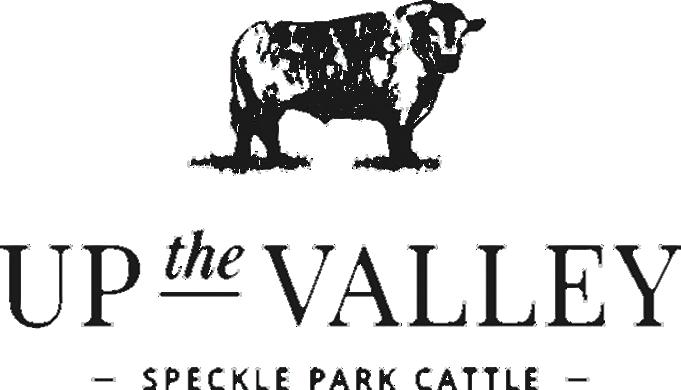
30th May 2023, 1:30 pm
Contact: Russell Proffit email: rnmwproffit@xtra.co.nz
Enquiries and inspection always welcome
2033 State Highway 3, RD Mahoenui, 3978 phone: 07 877 8977 or 027 355 2927

www.raupuhastud.co.nz Raupuha Stud
GIVE YOUR CALVES GIVE YOUR CALVES THE BEST HEAD START THE BEST HEAD START
A proudly 100% New Zealand owned and operated family business based in Oamaru, North Otago, Milligans
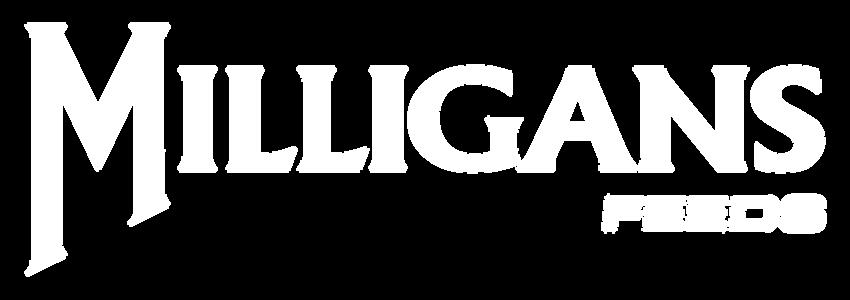
Feeds is one of New Zealand's leading suppliers of animal nutrition products
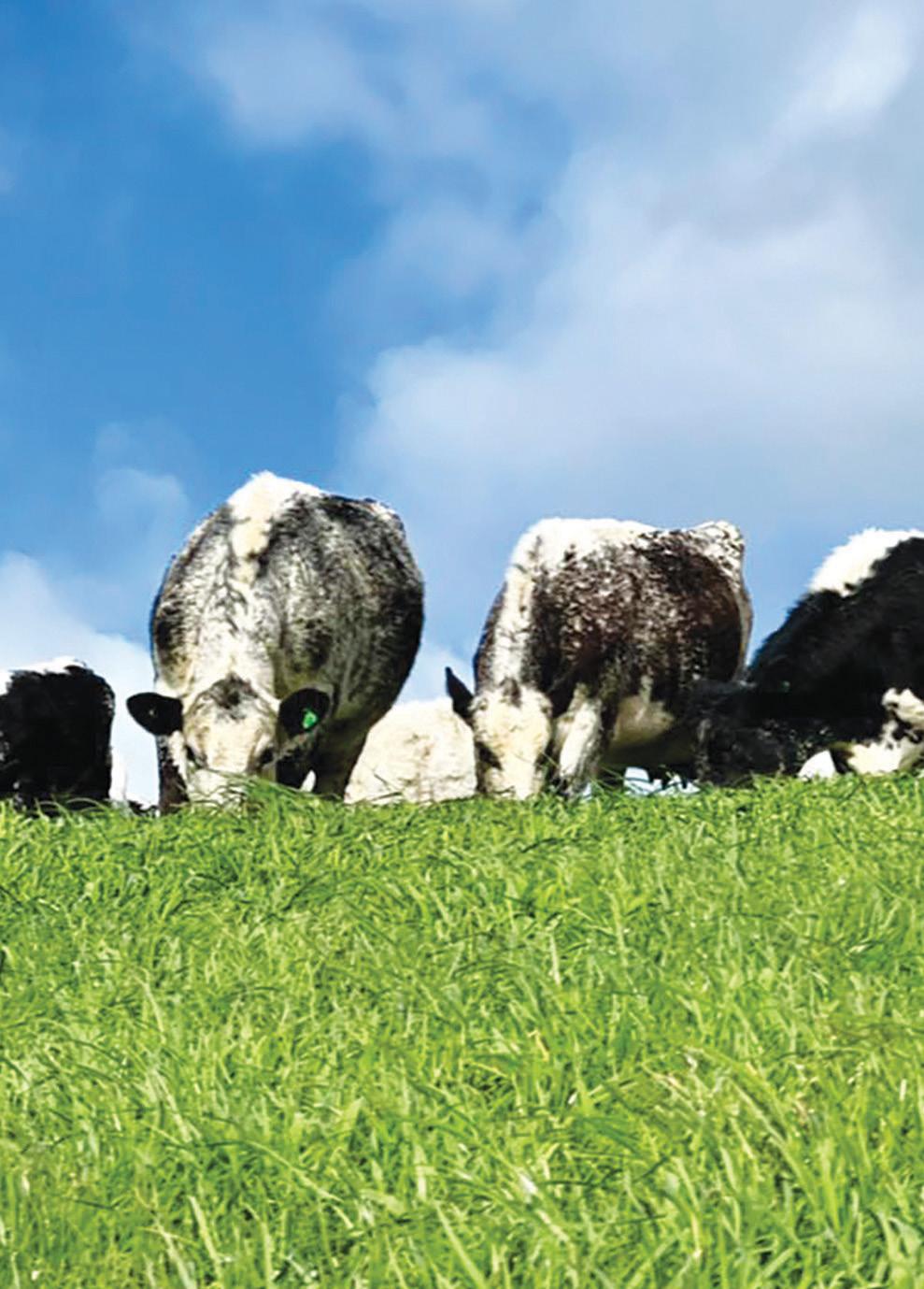
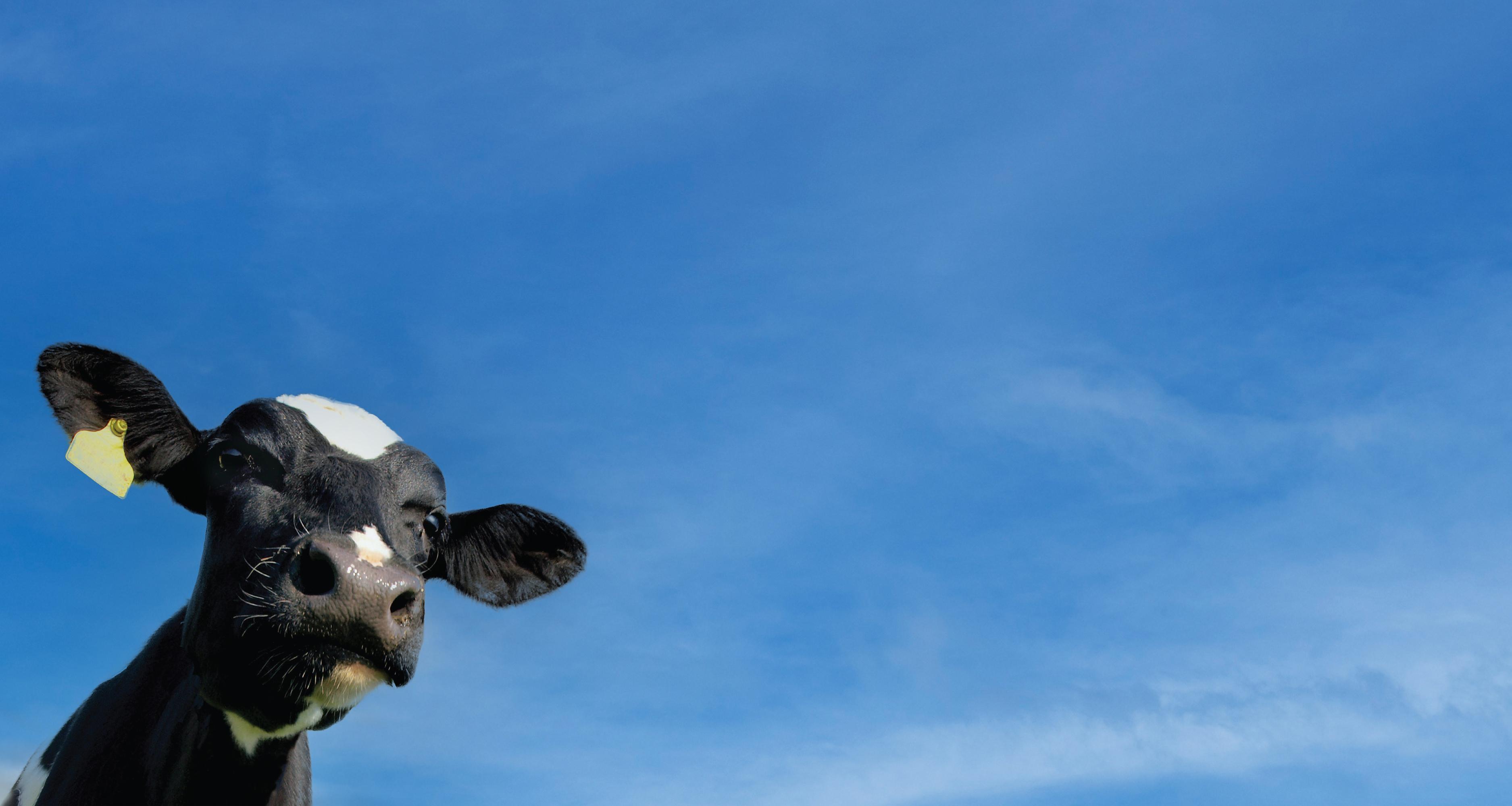
Having over 30 years' experience in producing high quality, top performing milk replacers, Milligans Feeds has been the choice for generations
Check out our website for more information on the range and where to buy
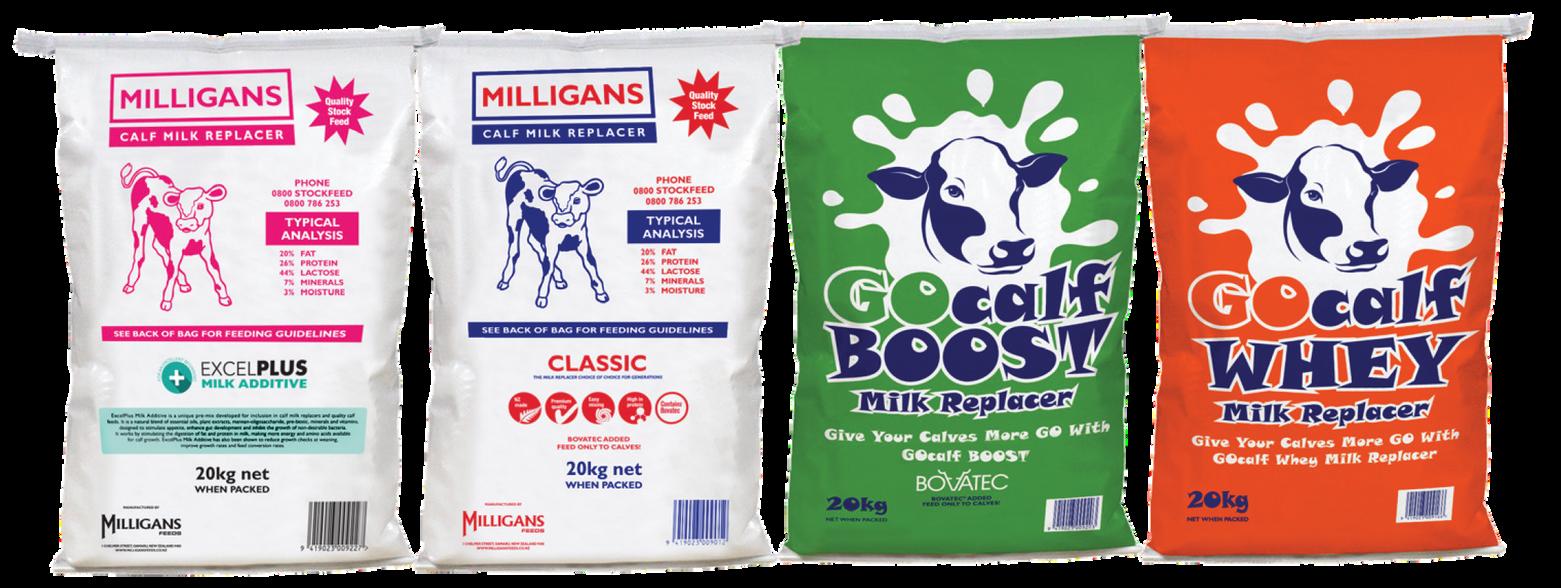
58 Country-Wide Beef | MAY 2023 0800 786 253 0800 786 253 || ffeedsales@milligans.co.nz eedsales@milligans co nz || www.milligansfeeds.co.nz www milligansfeeds co nz
PLEASE NOTE CHANGE OF TIME
and select animals. The requirement to get a barge load and tie it in with killing on a certain day each week, plus agent travel costs, creates issues with this, Josh said.
“Our stock sometimes have to be held in Canterbury and then go to Pukeuri.”
Lambs are now also sold prime, with the first weaned cut killing at 18kg carcaseweight at 10 weeks.
Speaking at the B+LNZ field day, general manager livestock at Alliance Murray Behrent said it was critical to have good transport systems to ensure top animal welfare.
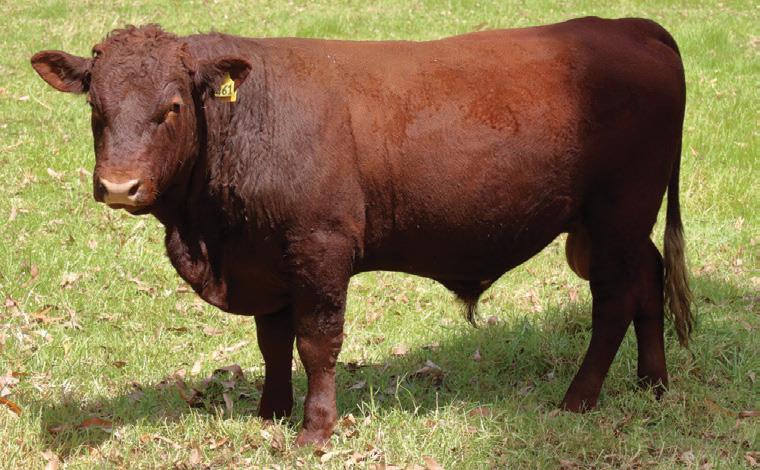
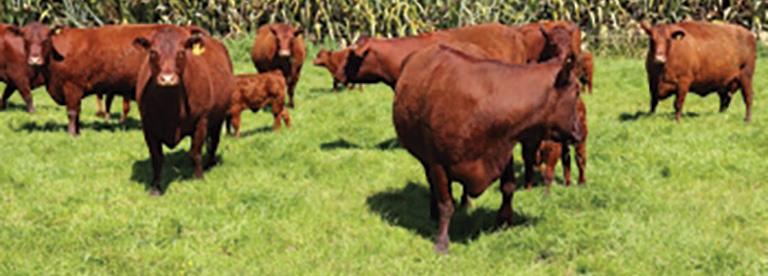

“The co-operative is happy to wear the cost of the barge at the moment to make it worthwhile for both farmers and the company.”

An analysis of stock movements shows most stock goes out of the Sounds December to April.
The extra transport cost for stock
means the Jamiesons have moved away from bringing in store lambs to finish. Extra returns are being sought by lambing hoggets this year. They have an impressive survival rate with Josh saying lambing percentage (ewes mated to lambs weaned) is sitting at 145% from a scanning of 165%. Rams are Piquet Hill and Wairere Romneys, selected for facial eczema tolerance.
Soil fertility has lifted from a pH of 5.2 to 5.8 and Olsen P of 10-15 to 20-30. Fertiliser costs are about $200/ha – with transport costs pushing it high. Josh admits he likes lime, but speaking at the field day, Ravensdown’s Dr Ants Roberts led a discussion on getting the best return on a limited fertiliser budget.
He said it was more important to put P and S on than lime short term.
But Josh said they would be lost without initial lime applications.
“We wouldn’t be fattening stock.”
Country-Wide Beef | MAY 2023 59 Sound well fleshed sires, Excellent temperament 200 Fully Breedplan recorded cows • 20 Bulls Catalogued PETER & CAROLINE FOSS 495 Potaka Road, RD 1, Aria, King Country PH/FAX (07) 877 7881 EMAIL pcfossy@xtra.co.nz 29TH ANNUAL SALE THURSDAY 8TH JUNE, 1PM TE KUITI SALE YARDS BULL OPEN DAY DATE TO BE ADVISED ALL ENQUIRIES WELCOME Stud Est. 1980 KAIPAPA RED DEVONS (POLLED) CURRENTLY AVAILABLE 18 MONTH OLD BULLS AND HEIFERS INSPECTIONS WELCOME PH 09 420 2063 MOB 027 593 6222 EMAIL alanandjoy.harg@xtra.co.nz No. 29 Evans Rd, RD1, Helensville, 0874
Alan & Joy Hargreaves
This attractive stream planting is around the old Manaroa homestead. The farm has been in the Masefield/ Rodgers family for six generations.
Progress at Ben Annand
A couple strive to maintain healthy and profitable stock, increase production, diversify where they can, and battle unwelcome pigs and deer.
By Jo Cuttance
.
AT A GLANCE: Freehold 1468ha; 970ha effective, 38ha exotic forestry, 460ha native forest/bush | Kaiwera clay loam | Average rainfall: 2501650mm per year | Daytime temperature: summer 16-23 deg C, winter 8-12 deg C | Annual sunshine hours: 1600hrs
Hereford cattle provide an essential role in managing pasture quality for South Otago sheep and beef farmers Amy and Victor Blaikie.
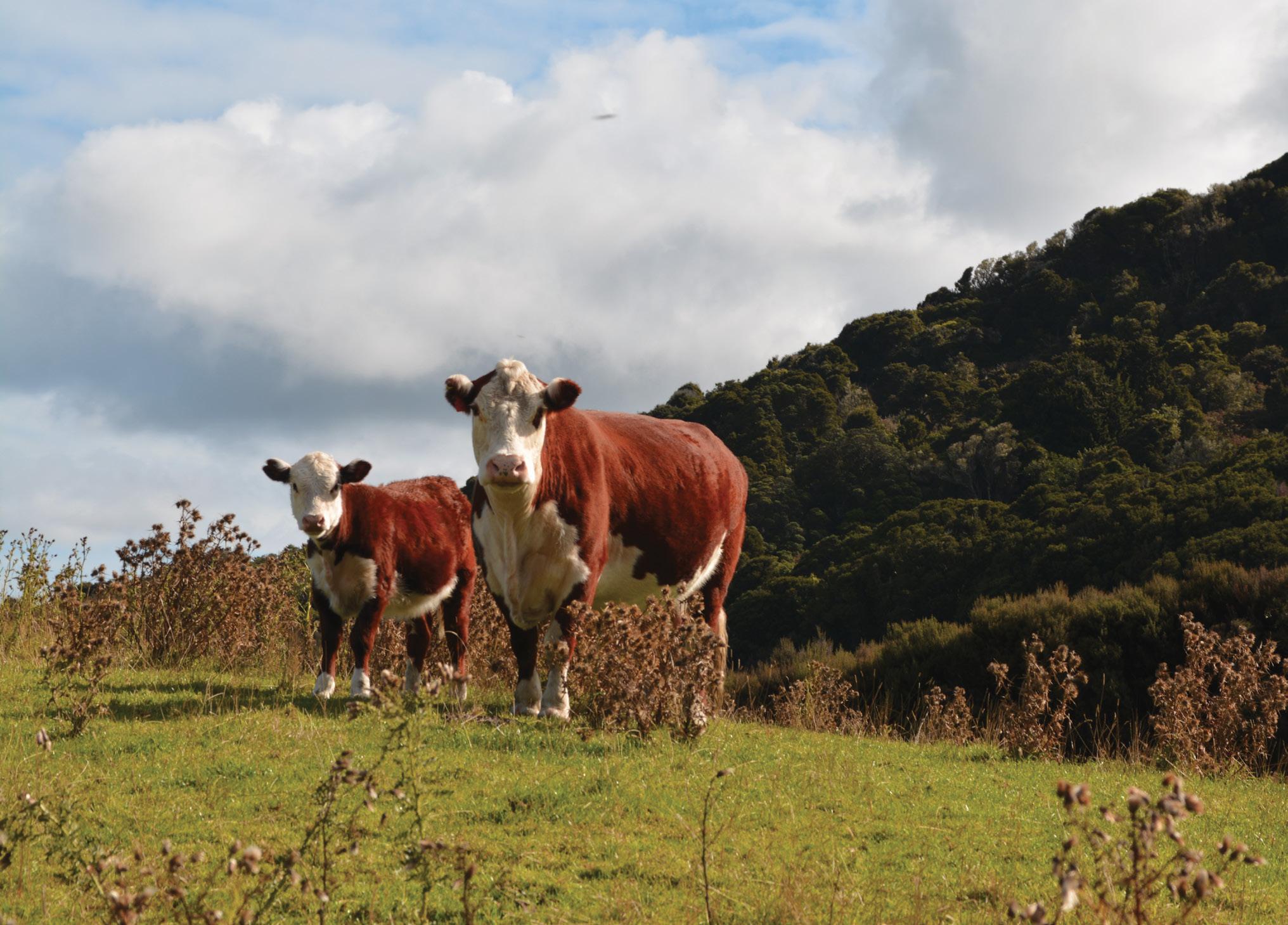
The Blaikie’s farm Ben Annand, located 38km east of Wyndham and 26km southwest of Clinton. The farm is characterised by rolling to steep hill country with sharp gullies and natural waterways.
Victor’s father, the late Keith Blaikie, chose Herefords when setting up the farm in 1960 because they were a hardy, easy-doing breed. Nowadays, the Blaikies have 190 mixed age cows that are serviced in December by bulls sourced from Te Anau stud – Monymusk Polled Herefords – with calving from late September to late November.
Victor picks his own bulls and looks for a sound, solid looking, free moving animal. He has seven bulls and replaces one each year to keep new genetics
60 Country-Wide Beef | MAY 2023
ONFARM i
rolling through. He also uses an Angus bull from Hall Genetics’ Lillliesleaf Stud for the 40 first calvers.
Amy said the predominantly Hereford herd is wintered and they calve on the higher tussock country. Ben Annand is 1468ha and ranges from 160m to 540m above sea level, has at least one snowfall a year and frequent frosts during winter. Calves are sold in April at weaning to make the best of higher prices, though there is flexibility to retain and fatten until 18 months to kill. At least 40 replacement R2 Heifers are kept annually, and these calve to a low birth rate bull. These heifers are wintered on a tussock block. Victor said the cattle have a job to tidy up rough feed and clean up paddocks after the sheep.
“The cattle are less labour intensive than other stock breeds,” Amy said.
The mixed enterprise of beef and sheep enables easy manipulation of labour
time, as cattle work can be staggered around the sheep operations. Perendales were chosen because they suited the country and management style of the farm. Victor said they are free moving and can look after themselves for food and at lambing.
Victor and Amy have brought their own style of farming to Ben Annand. Victor said they chop and change, if someone has a better idea, they will try it. They have changed shearing dates from January to mid-June and now seem to have fewer issues. The Blaikies would
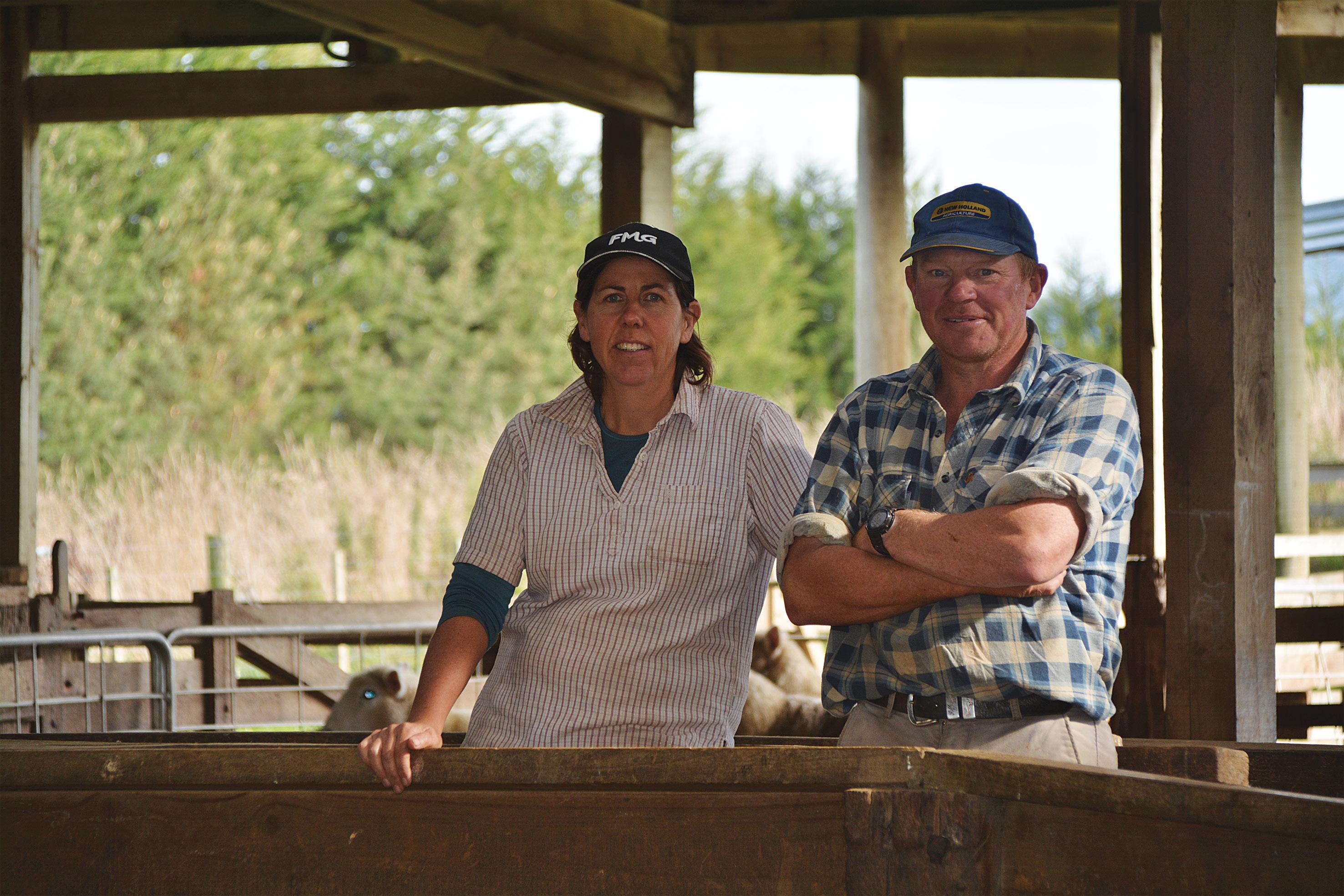
Country-Wide Beef | MAY 2023 61
2018 2019 2020 2021 2022 Operating expenses/eff ha $397.50 $414.70 $531.09 $519.60 $657.63 GFR/eff ha $867.92 $845.88 $727.71 $841.77 $964.85 OE ratio 45.78% 49.03% 72.98% 61.73% 68.2% EBITRm/eff ha $470.42 $266.96 $87.69 $229.51 $224.95 Net profit/total ha $173.15 $132.47 $58.13 $78.38 $76.56 Net profit/su $35.15 $26.75 $11.58 $14.70 $14.62
Economics
Opposite page: Mixed aged cow and calf, the calves will be sold at weaning.
Above: Amy and Victor Blaikie take a break in the sheep yards.
prefer to shear twice a year but that isn’t viable. The couple are staunch believers in wool as a product and say in time it will make a comeback. Victor said there was no point in designing new things – if it was used for socks, jerseys, carpets and insulation there would not be enough wool. Amy recalled when wool was so valuable they would be on high alert in case their wool was stolen. The 2022 wool clip produced a loss of $6207.
Dags are used as a weed suppressant in Amy’s berry orchard. Having an orchard was a deal breaker for Amy agreeing to move to the farm from East Otago where she and her father ran a successful horticultural business. Amy sells raspberries from the orchard and uses raspberry leaves in the skincare range she and her sister-in-law Frances Blaikie created.
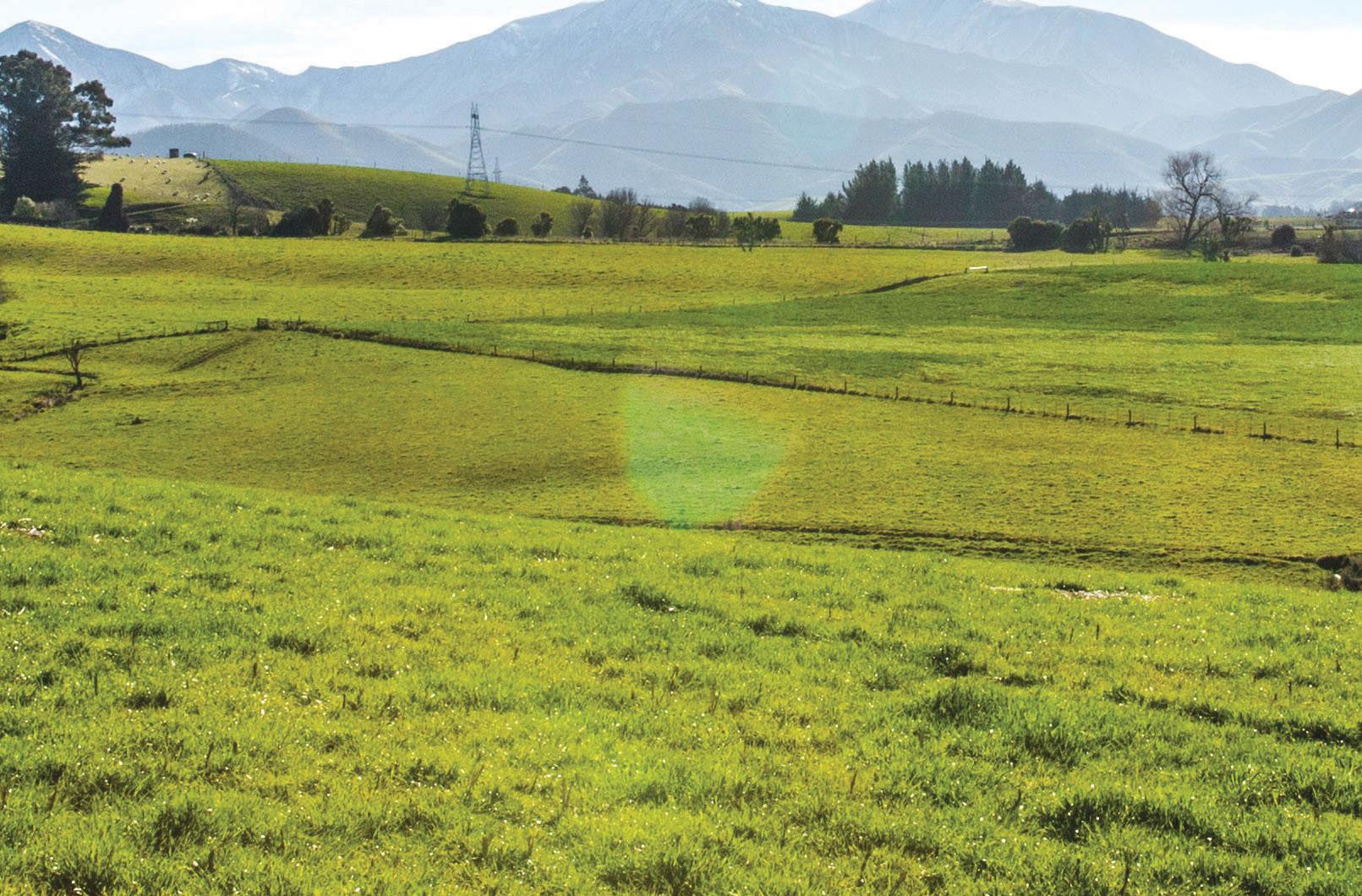
For the past three years they have sourced rams from Montana and Gowan
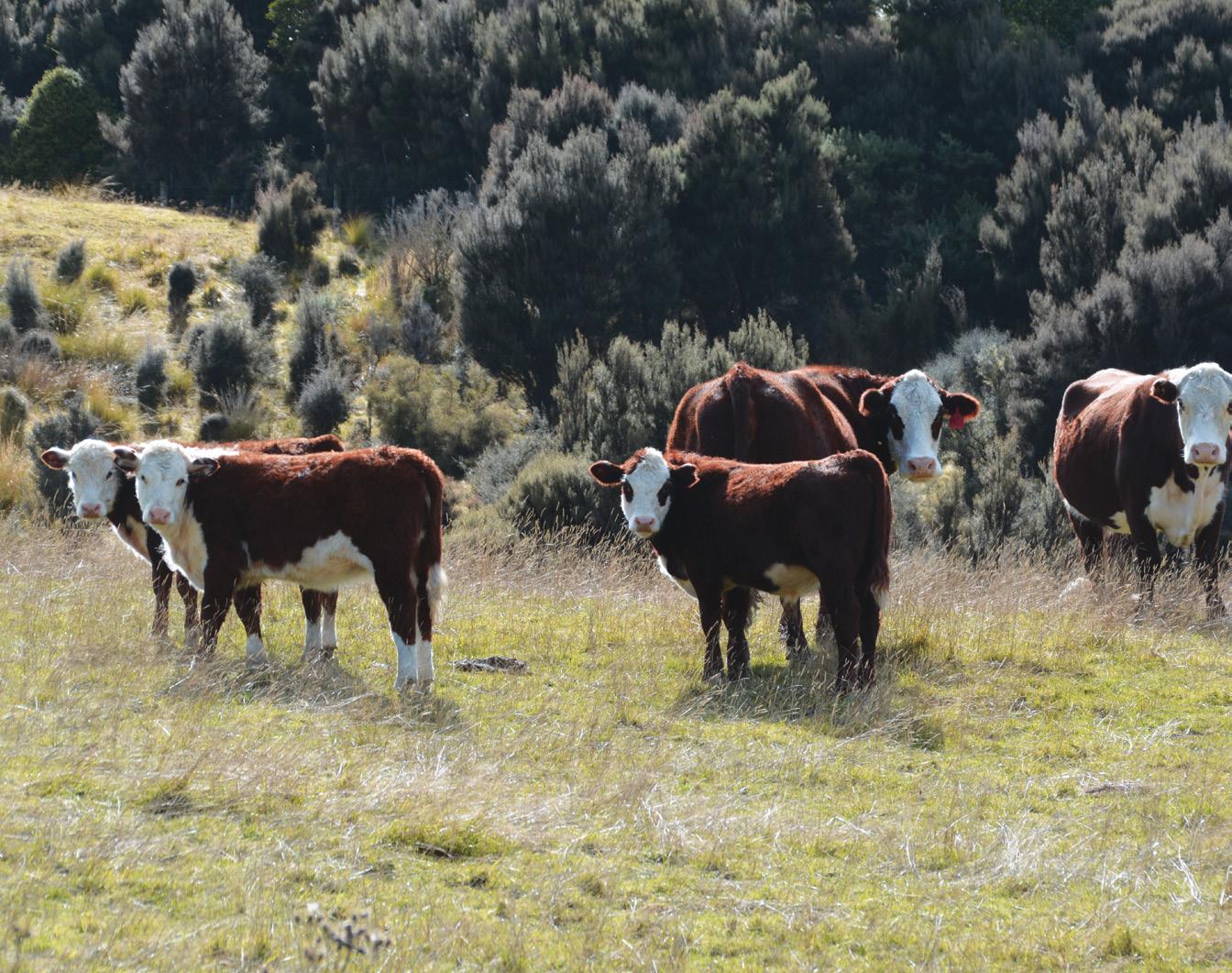
more reach and more market influence.

We provide more practical advice and more technical expertise. And, with the country’s largest network and most popular sales events, we bring together more buyers and more sellers, delivering more value for all.
If you’re looking for a planned approach to success, give us a call today.
we can help.
network, our
of Genetics
have more contacts,
CALLUM STEWART National Genetics Manager 027 280 2688 CALLUM MCDONALD Genetics Representative 027 433 6443 CAM HEGGIE Genetics Representative 027 501 8182 EMMA POLLITT Genetics Representative 027 597 5821 JOHN MCKONE SI Head Auctioneer 027 229 9375 SIMON EDDINGTON Genetics Representative 027 590 8612 SIMON SMITH Genetics Representative 027 444 0733 TOM SUTTOR Genetics Representative 027 446 9967
BREEDING BETTER BUSINESS As part of New Zealand’s largest Livestock
team
Specialists
BULL INSURANCE? Yes,
See your local iCiB BrokerWeb rep at the sale. Or contact your PGG Wrightson Livestock rep. Bull cover available at the fall of the hammer, and billed direct to your PGG Wrightson Livestock account.
pggwrightson/livestock fb.com/pgwlivestock instagram.com/pgwlivestock
Braes Perendale studs as they tried different genetics to lift the lambing percentage and wool. Ewes that Victor did not like the look of at crutching were mated with a Suffolk ram from Mitchell Farming.
Lambing starts on September 20 and Victor said the percentages had fluctuated over recent seasons from about 125% down to 114%. This season was hovering at 112-114%. Seasonal variability affects the killable weights that lambs and calves can be grown out to. Feed availability, market price and weather conditions dictate what percentage of lambs go prime with AFFCO versus stores, and whether calves are sold or grown to 18 months old.
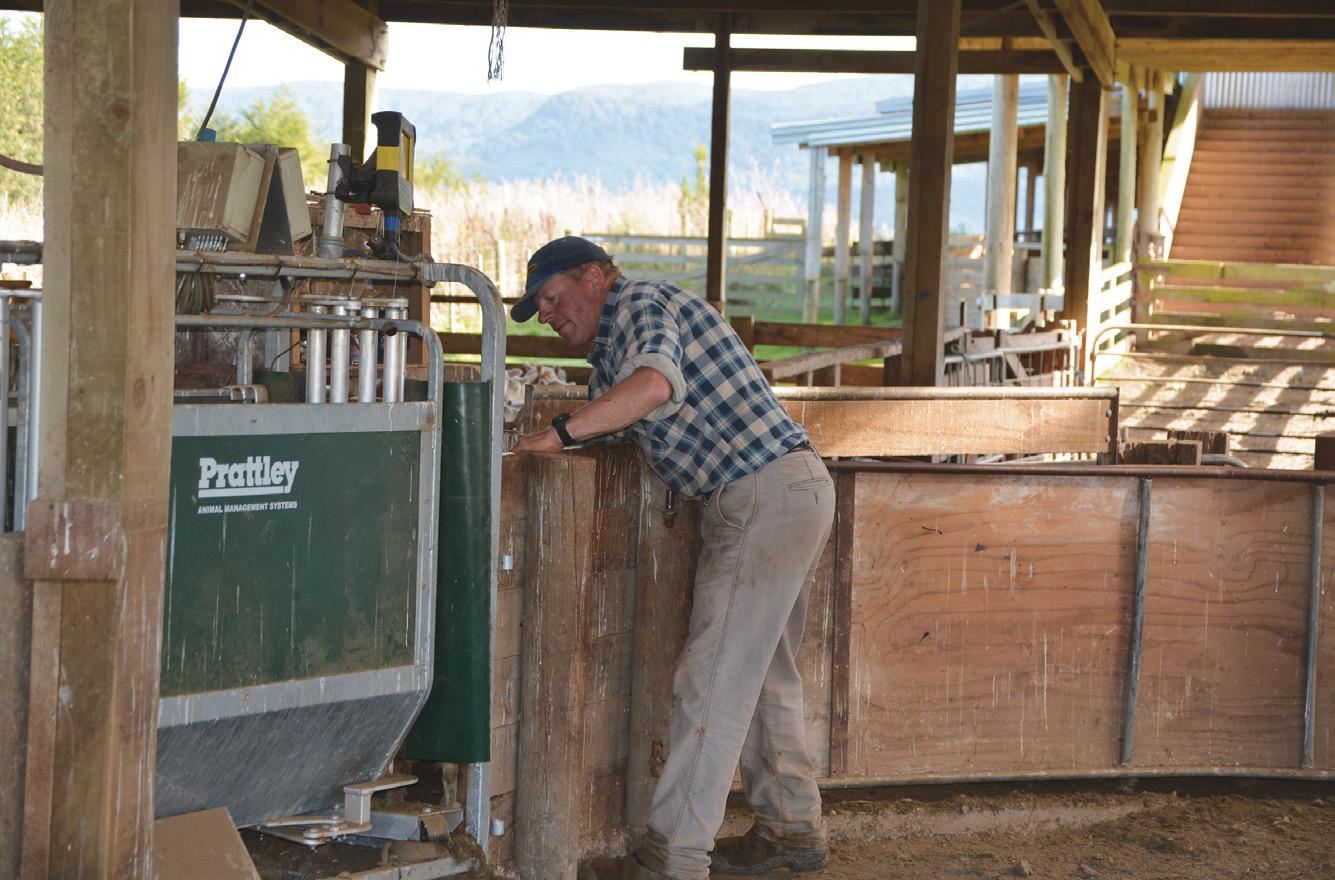
Victor said when down to the last 300 or 400 lambs, it depended on grass growth and weather. “If the store market is there, we will take advantage of it.”
Wild pigs have influenced lambing percentages. Two or three years ago a pig killed 120 lambs. During lambing Victor spends three nights a week out with the thermal scope looking for pigs amongst the ewes and lambs. “That wears a bit thin after a couple of weeks,” he said.
The thermal scope paid for itself in the first fortnight. When their accountant questioned whether it was tax deductible, Amy showed him photos of two pigs and explained the paddocks where those pigs had been shot: the lambing percentage went up by 12%.
Rooting by pigs has dictated which paddocks are chosen for winter feed.
Victor said it was tough trying to level paddocks after pigs had destroyed them. “They [pigs] don’t leave it very level and it’s very uncomfortable sitting in the seat.”
The Blaikies crop about 50ha a year. The first year was a mix of swedes and rape, followed by kale and into grass in the third year. Single-bearing ewes and
Stock Total su 7688, su/effective ha
Sheep Cattle
4861 Mixed aged ewes
1200 Hoggets
51 Rams
Sheep su 5888
calves went onto the swedes and rape, supplemented with balage, and 1200 hoggets which are not lambed are on kale.
Improvements to infrastructure
The Blaikies have noticed the weather getting drier. The average annual rainfall at Ben Annand used to be 1500ml but in the last few years has dropped to 1100ml. Last year, to eliminate dependence on natural water supply, the Blaikies put in a reticulated stock water scheme. It cost just over $150,000 and included the installation of 40km of pipe, 74 concrete troughs and three header tanks linked to springs to gravity feed three water systems.
Other improvements to infrastructure
192 Mixed aged cows
43 Rising 2yr olds
83 Rising 1yr olds
7 Bulls
Beef su 1780
included covering part of the back sheep yards, which Victor said made it much pleasanter to work out there. Now, when it's hot, there are no shadows over the race and the sheep will run. “It’s marvellous,” he said.
The Blaikies have added a new worker’s cottage to the farm to replace the original cottage, and four years ago they built a new four-stand woolshed costing about $300,000.
“At this stage there’s not much return on it [the woolshed], but it’s a nice hut for people to stay in,” Amy quipped.
Victor said the old woolshed was untreated rimu and the borer had eaten it.
“Every time you wanted to shear you had to rebuild something – it was becoming a health and safety issue.”
Country-Wide Beef | MAY 2023 63
“During lambing Victor spends three nights a week out with the thermal scope looking for pigs amongst the ewes and lambs.”
7.9
Victor weighing and drafting cull prime lambs at the beginning of April.
Buy your Murray Grey cattle from one of our registered breeders

GLEN KOWHAI
D & J Niccolls, Warkworth • 021 120 3970
WILLOW GULLY
AJ & DL Powell, Auckland • 09 411 8380
RUAPEKAPEKA
AD & BI Priest, Hikurangi • 09 433 4703
AONGATETE
C & R Lee, Katikati 021 919 093
TAUREKA
T & R Trenbeth, Tauranga 027 451 5594
MARU
L & K Ramsey, Pukeatua • 07 872 4891
PREMIER
D & C Hayward, Cambridge • 07 823 5608
OAKVIEW
Allan Hayward, Cambridge • 07 827 1847
ONAMALUTUS
P Stachurski & S White, Inglewood • 027 441 1622
MANGAOTEA On Farm Sale 14th Sept RR & Z Blackwell, Inglewood • 022 050 7119
KAIHINAU M Malmo, Shannon • 06 362 7361
SIMANDA
S & A Tripe, Blenheim 03 573 7493
SOUTHBANK
G & I Leov, Blenheim 03 572 2760
HALDON DOWNS
L, G & M Anderson, Kaikoura 03 319 5467
CAVAN
GG & SK Rountree, Oxford 03 312 4047
SUMMERSDALE
B & J Dickson, Gore 03 207 2434
SILVER FERN
On Farm Sale 16th Oct
CJ McIntosh, Otautau • 03 225 5884
KINGFISHER
D & A Fowell, Manaia 027 484 8438
DENALI
H & M Fletcher, Culverden • 021 313 941
OPOURI
T Payton, Rai Valley 03 571 6391
SEA SPRING
A Morgan, Hawarden 03 424 4948
CHEQUERS
J Burke, Whakatane 07 322 2680
FLAX RIVER
Z Brake, Whakatane 07 308 4999
MARIRE
M Gray, Tokoroa 027 814 2617
ASPALL
B & C Foy, Tokoroa 07 886 0388
KAITOA
P & E White, Whanganui 022 570 4536
BROX
J Badger, Palmerston North 06 356 7932
CUMBERLAND PARK
G Preston, Foxton 06 362 7959
BLACK CREEK
A & A Hutching, Eketahuna 06 375 8841
ARAWA
M J Kilsby & DJ Kilsby-Halliday, Levin • 06 368 8415 / 06 368 8182
YORKVALE
TW & SW Clarke, Levin 06 368 6132
MURRAY DOWNS
MELBURY B & J Hallenstein, Ashburton 027 683 8111
TAMARIND SAWYER
R & L McLennan, Port Chalmers 03 472 8291
TORRISDALE
On Farm Sale 11th Oct BS MacDonald, Winton • 03 236 2736
S Rodie, Amberley 03 314 8196
SHERWOOD
RW Driver, Kaiapoi • 03 327 7899
WAIMAK G Climo, Kaiapoi • 03 327 6445
STONYBROOK
C Brooks, Christchurch 027 768 9889
75 South Street, Feilding 4702 • P: 06 323 4484 E: murraygreys@pbbnz.com • www.murraygreys.co.nz Like us on Facebook: NZ Murray Grey Breeders
Wild deer are winning
Victor shot about 60 pigs and 95 deer last year. He said there’s no way to eradicate the deer. “They’ve beaten me.”
Deer hunters were on farm most weeks, either crossing through to hunt on DoC land that borders the farm or hunting on the farm. Victor said they don’t seem to be making any headway on numbers. “It’s been going on for years, but I feel it’s getting worse.” The farm has 8km of bush boundary and the deer come out most nights.
Victor said if the venison price went back up that would help, but it has been made so hard to sell them that even the helicopters don’t come now.
“In the past I used to shoot for money – now there is no money for venison recovery.”
The Catlins Coastal Rainforest Park borders the southern side of Ben Annand and during the roar hunters on the DoC ballot block stay in a haybarn, nicknamed The Campsite. Victor said the hunters love the haybarn and bring their families out. If the weather turns bad they have somewhere dry to stay.
The Tahakopa River starts in the hill blocks, as does a small stream that feeds into the Mokoreta River. The 17.8ha Upper Tahakopa Swamps are regionally significant wetlands protected from
Ben Annand’s beginning
Keith Blaikie moved to the Slopedown district in 1950 and worked for the late Eric Ayson. After 10 years of service, Eric gave Keith a preferential lease for the “front” 180.9ha of bare tussock country. Wyndham Station relinquished a 1287.2ha block that adjoined the front block, making a farm area of 1468ha – Ben Annand.
In 1960 there was one fence. Farm work was done on horseback and Victor said his dad worked tirelessly breaking in “virgin” tussock country
stock. The wetlands and rivers have an abundance of aquatic life including eels, trout, koura, and the rare gollum galaxias.
Carbon credits and succession
Victor is clearing 68ha of gorse and plans to plant 30ha of it in pines this year. Pines were the best option to beat the gorse, he said. Gorse got out of control in the 1980s when interest rates went to 26%. He said it’s unproductive land but there was money to be made from carbon credits. “It’s better to look at a pine tree than a gorse bush.”
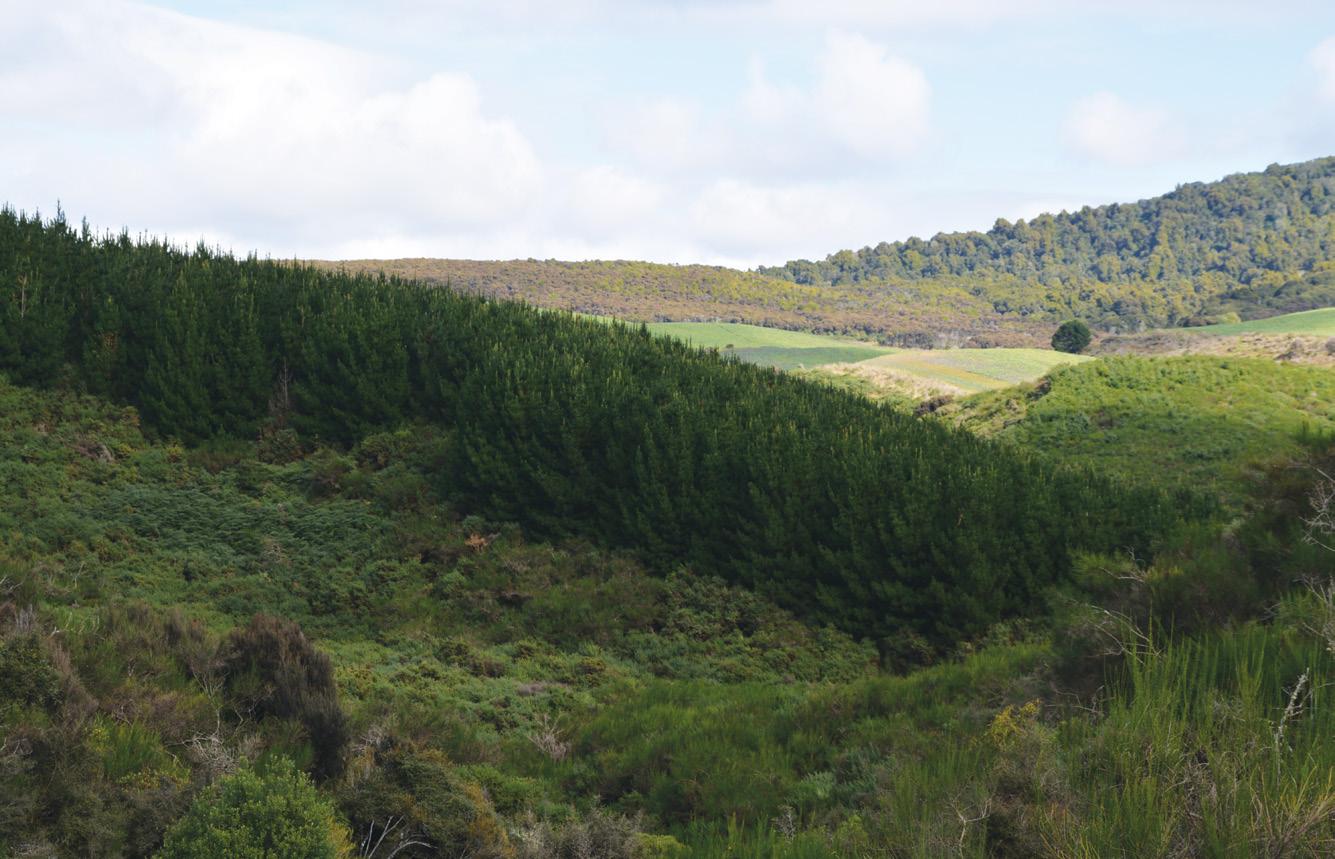
Gorse control is a large part of the yearly budget and is done by helicopter and by hand gun. The plan was to keep planting pines anywhere that gorse was growing, though Amy had areas where she wanted to plant natives. They have planted some natives but find they are slow growing and hampered by deer eating them or cattle getting in and pulling them out. It was great when you did see them growing, Amy said.
Victor and his brother-in-law cleared a 10ha block and planted Douglas firs. Victor said it looked good from the ground. Then when they flew over in a
and building a house. He also built the worker’s cottage, shearers’ quarters, implement shed, woolshed, covered yards, haybarns, fertiliser sheds, farm lanes, and fenced the farm into smaller paddocks. Ben Annand was freehold by 1998 with Keith and his wife Alma in partnership.
In 1993 Victor returned home to help on the farm after stints driving tractors, dozers, and possum hunting in NZ and overseas. Three years later he joined the family partnership
and took over management. The partnership was reconfigured after Keith died in 2003 – to Victor and his mother in partnership for stock and machinery, and a trust owning the land. The 1468ha has been divided into 49 paddocks with four hill blocks and two forestry blocks. Paddocks are planted with a mix of red and white clover, cocksfoot and ryegrasses. The hill blocks have native tussock and cocksfoot over sown with clovers.
Country-Wide Beef | MAY 2023 65
Victor Blaikie admits it is a shame to plant pines but pines are the only financially feasible option.
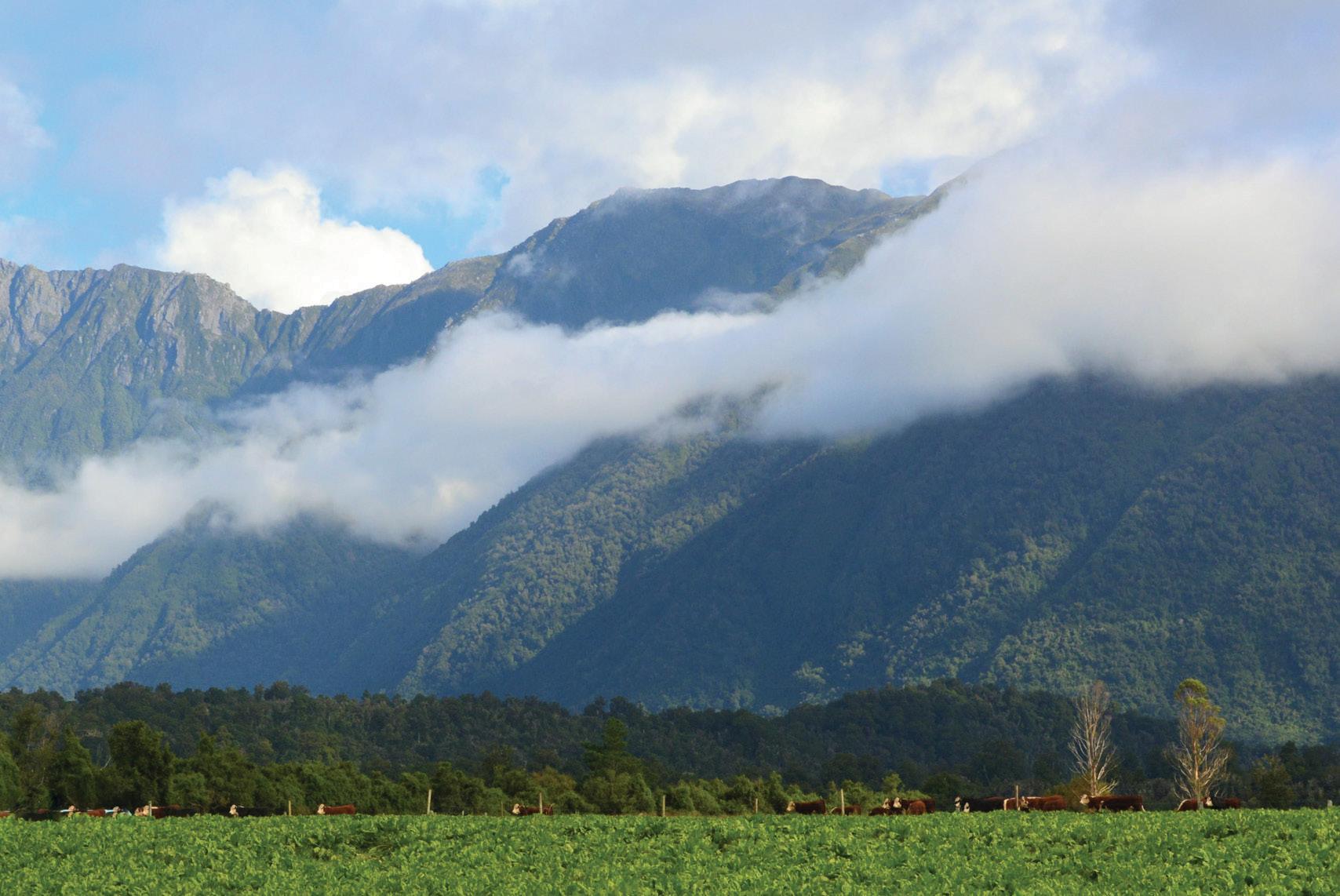
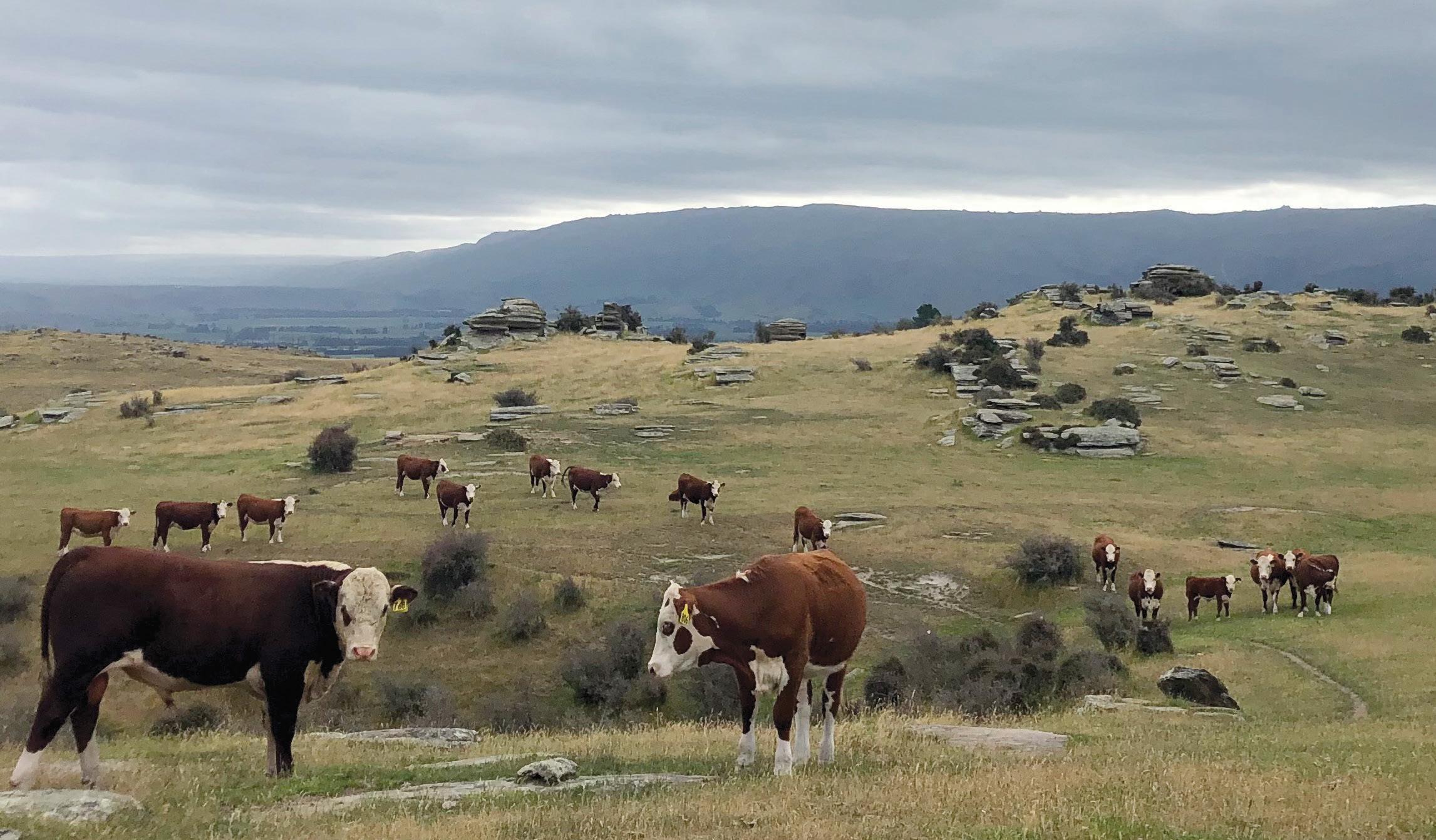
66 Country-Wide Beef | MAY 2023 FLAGSTAFF POLLED & HORNED HEREFORDS BANNOCKBURN ANGUS GLACIER HORNED HEREFORDS BULL SALE SATURDAY 27th MAY 2023 Condons Rd, Mahitahi, South Westland Thomas Condon FLAGSTAFF HEREFORDS Mahitahi Phone (03) 7510864 David & Robert Scott BANNOCKBURN ANGUS Karangarua Phone David (03) 7510898 Robert (03) 7510797 Wayne & Maggie Williams GLACIER HORNED HEREFORDS Fox Glacier Phone (03) 7510826 www.flagstaffherefords.co.nz BULLS TO BE SOLD IN A HELMSMAN AUCTION IN CONJUNCTION WITH NETHERTOWN ANGUS FRIDAY 26TH MAY 2023 FOR ENQUIRIES OR INSPECTIONS CONTACT: FOULDEN HILL HEREFORDS + BLUESTONE SANTA GERTRUDIS 706 Moonlight Road, RD. 3, Middlemarch 9598 Will Gibson - 027 436 0237 • E: will.fhgenetics@gmail.com Anton & Liz Gibson - 03 464 3603 • E: a.egibson@ruralinzone.net Foulden Hill Genetics Also home to BLUESTONE SANTA GERTRUDIS FOULDEN HILL HORIZON 210768 FEBRUARY 2023 HEREFORD BREEPLAN EBV DIR DTRS GL BW 200 400 600 BULL +7.8 +5.5 -4.2 +3.1 +40 +66 +87 B Avg +2.8 +2.3 -0.8 +3.9 +34 +56 +79 EBV MWT MILK SS DTC CWT EMA RIB BULL +60 +24 +4.0 -7.1 +66 +7.2 +2.9 B Avg +66 +17 +2.2 -3.1 +53 +4.0 +0.8 EBV RUMP RBY IMF INDEX ($) HP BH DB BULL +4.9 +0.1 +2.2 +$184 +$233 +$142 B Avg +1.0 +0.8 +0.6 +$117 +$126 +$109 PICTURED BELOW: FOULDEN HILL HORIZON 210768 SIRE: DAYS HORIZON M028 (IMP AUS) DAM: FOULDEN HILL ALMOND 190555 DOB: 23/09/2021
helicopter they counted 16 deer standing in the block and they’d decimated the area.
“That was depressing but we’ll just clear it again and try again,” he said.
Pines would create shelter and help diversify income. Amy said succession was in the back of their minds. Their children, Josh, 11 and Caitlyn, 7, have said the farm is not to be sold as they want to farm it. Saving money and putting in a few tree blocks would help with that, Amy said. Both children enjoy working with the stock and going hunting. Caitlyn had the newest addition to the farm – a pony named Mr Woody. The highlight of Josh’s year is approaching, when the family’s 1946 V8 truck gets its warrant of fitness and he can be there overseeing the mechanic’s inspection.
Amy loves being at Ben Annand but said there are pressures – the paperwork had taken some of the enjoyment out with so many regulations, but she accepted it as inevitable.
Morven Road Skin Care
Amy and her sister-in-law Frances Blaikie are staunch supporters of wool. Two years ago they were searching for an idea that would showcase wool and after considerable thought settled on producing a skin-care range that had the hero ingredients of lanolin and hemp seed oil. Frances grew up on Ben Annand, had a career in science and after many years in Europe, she returned to New Zealand and was keen to use her expertise.
The skin-care range is made on farm and is marketed as Morven Road Skin Care, a nod to where Ben Annand is located. Lanolin, which is secreted by sheep to condition wool and skin and cannot be artificially copied, is sourced from the farm. The hemp seed oil is sourced from South Island growers and is infused with raspberry leaves from Ben Annand’s berry orchard and horopito leaves from surrounding native bush.
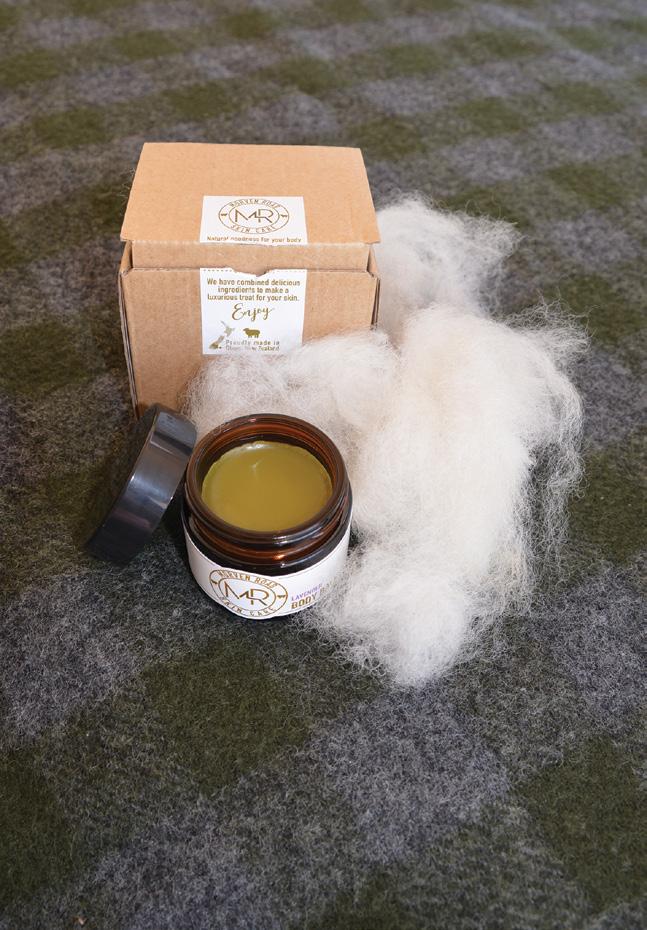
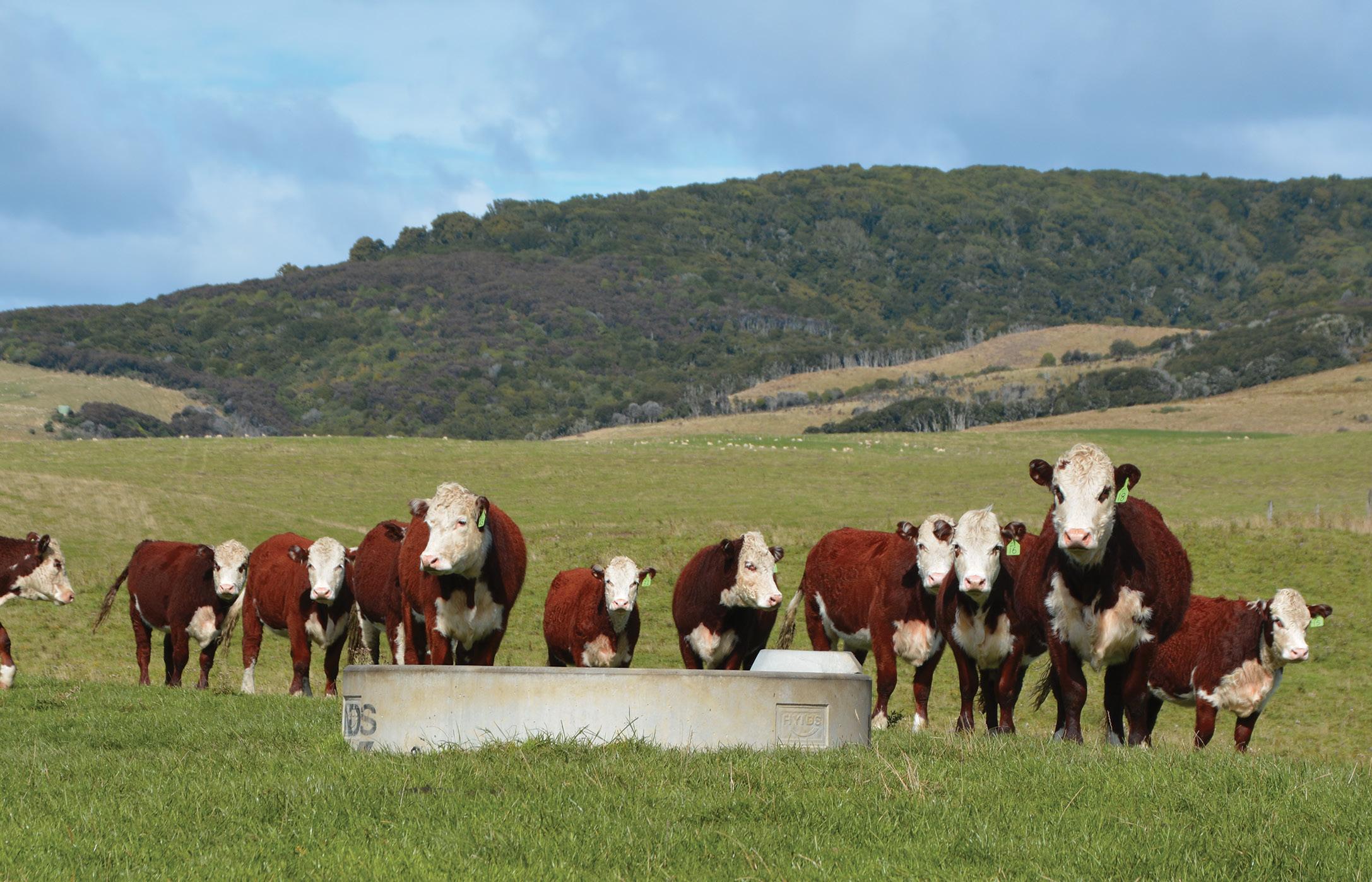
Country-Wide Beef | MAY 2023 67
R2 heifers – The Blaikie’s have invested over $150,000 in a water scheme at Ben Annand.
The Blaikies’ Morven Road Skin Care.


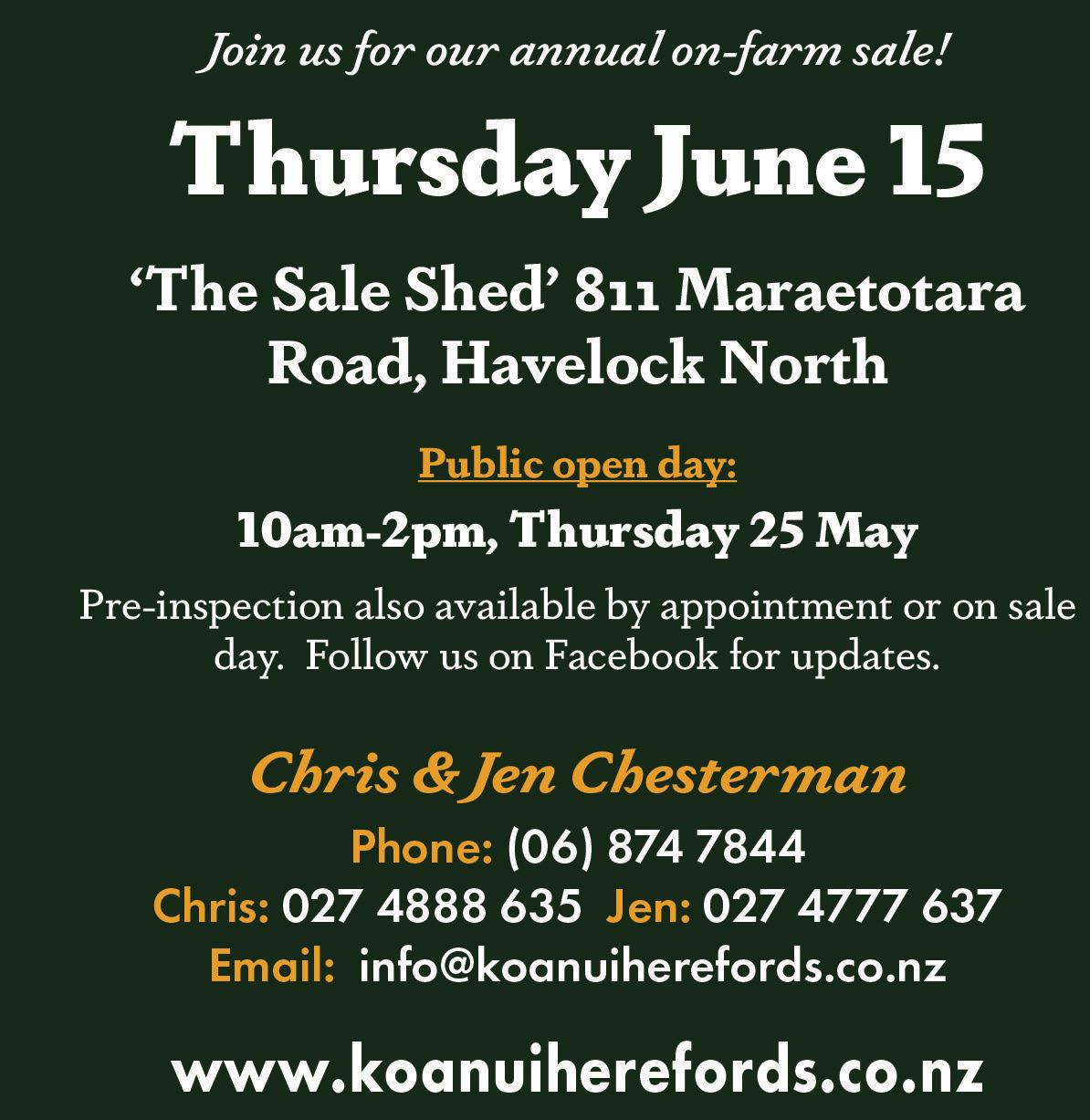
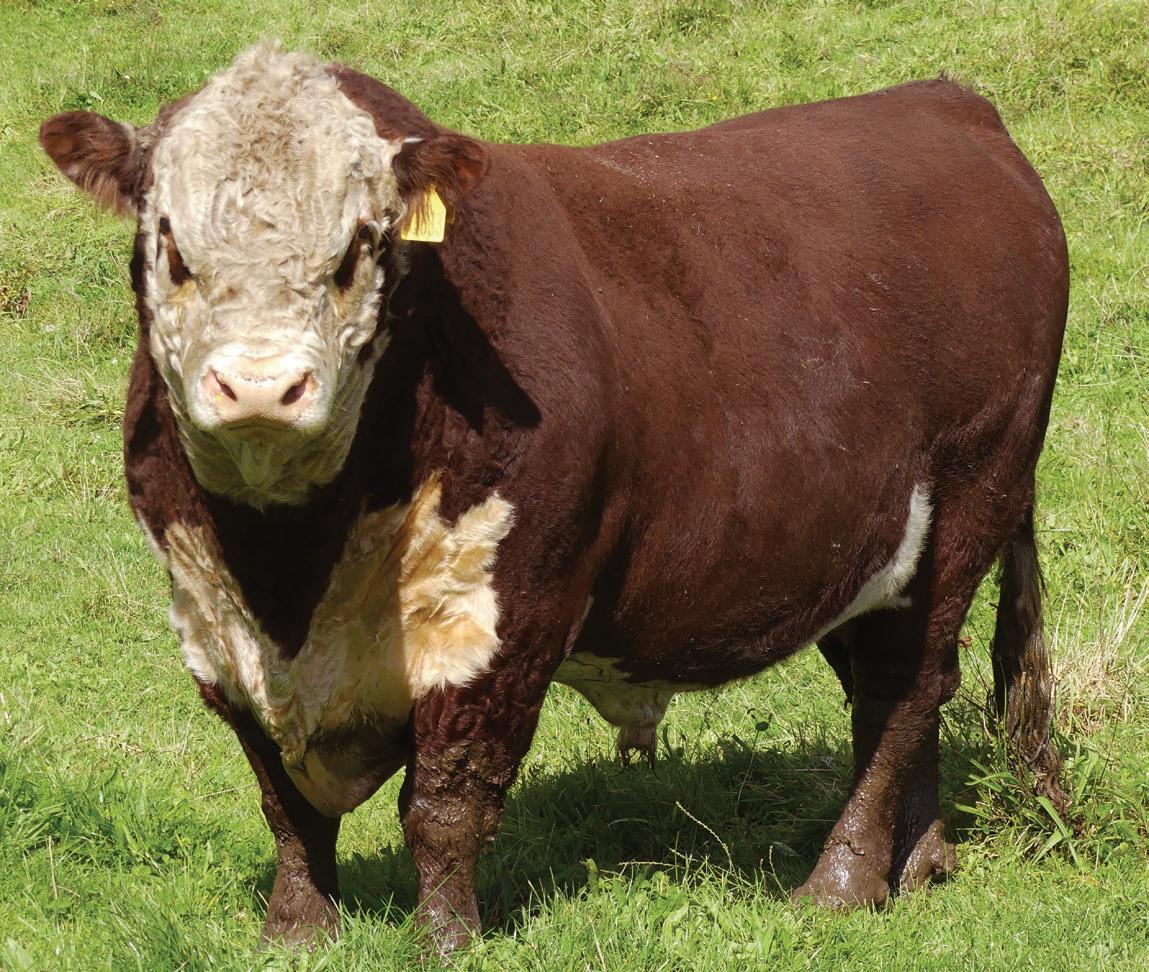
K E E P T H E F I R E B U R N I N G S A L E D A Y : J U N E 1 6 T H ~ 3 P M T U T I R A B U L L S + B E E R S : 2 5 T H M A Y ~ 2 P M Building on 50 years! Est. 1972
CELEBRATING 116
LOOKING FOR MORE LIVE CALVES ON THE GROUND,
LIMEHILLS STARDOM 190158
600-day growth top 1% • HP index top 1%
MAHUTA POLLED HEREFORDS free moving, attractive, high performance data & indexes

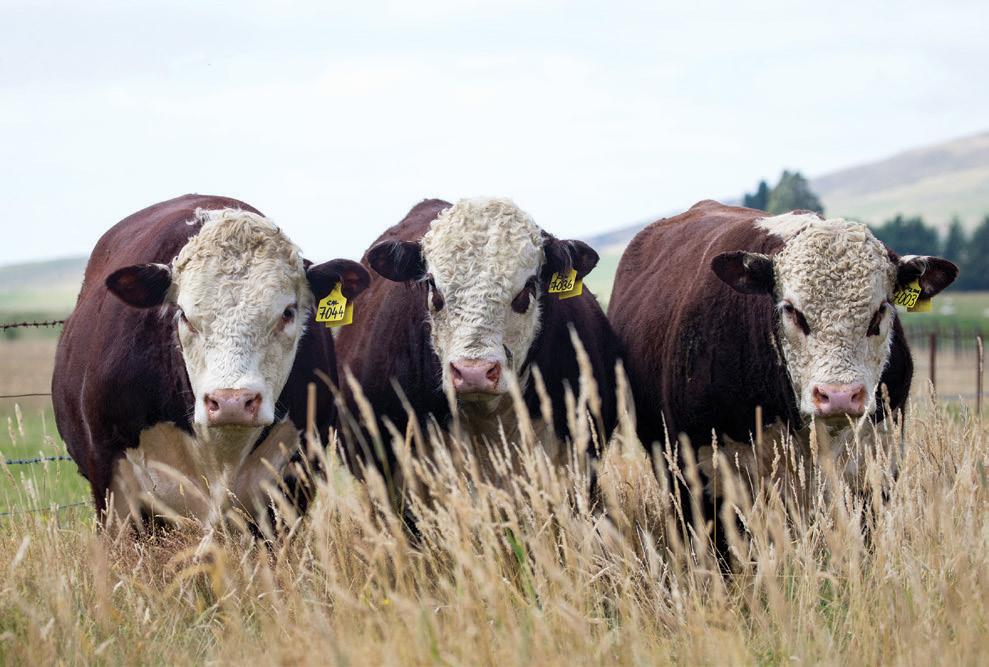



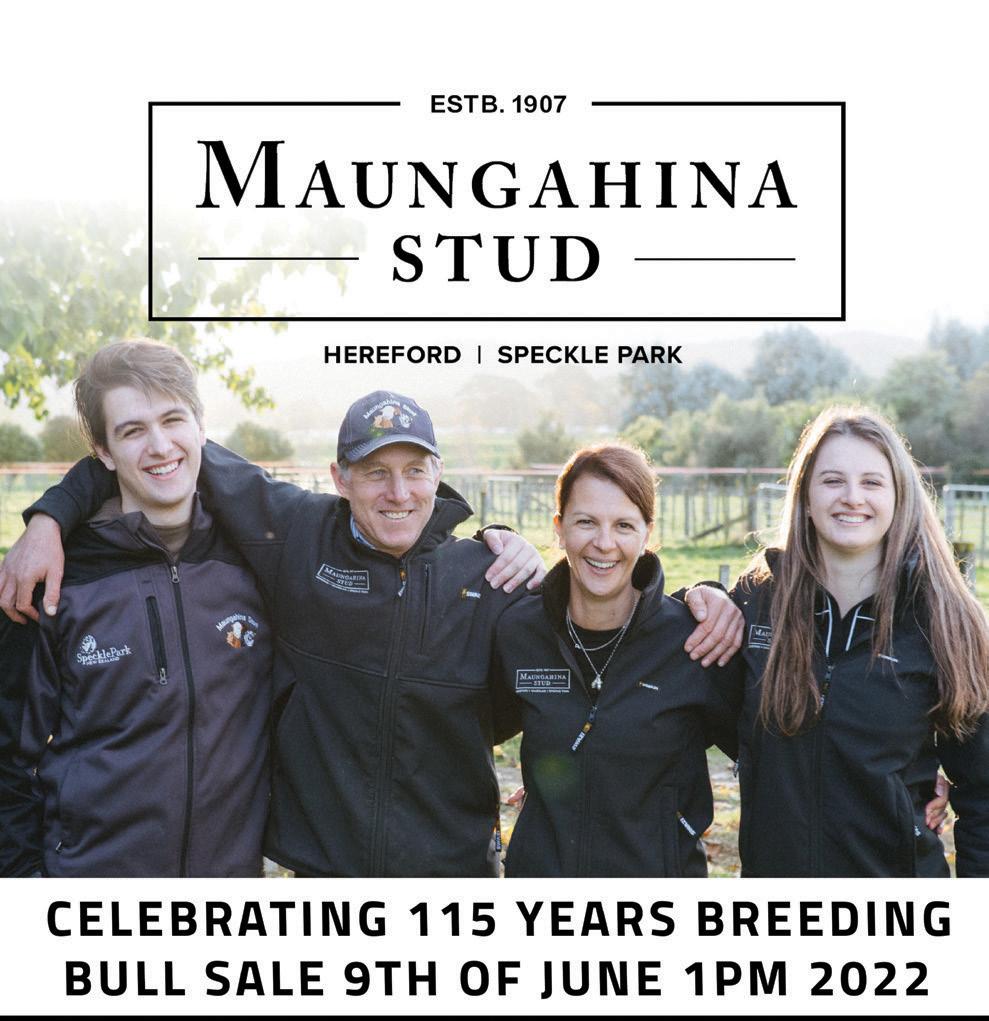
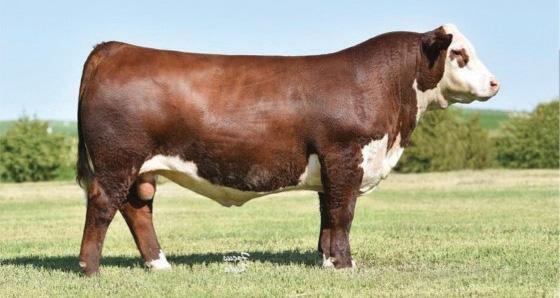
Annual Yearling Bull Sale
Friday 15 th September 2023
ENQUIRIES TO JOHN ALLEN
M: 027 440 7504
E: jvmeallen@xtra.co.nz
W: mahutastud.co.nz
335 Maurice Road, Glen Murray RD 5, Tuakau 2695
Bruce and Chrissina Donald 1877 Weber Road, Dannevirke 06 374 2939
• Bulls Lepto and BVD vaccinated
• Our focus on breeding seedstock with great fats, fertility, feed converters, faultless structure and are free and friendly movers
• The real article is at Ngakouka Herefords

• The best cross over all breeds of cow
NJW
Bull sale onfarm 10am, June 1st 2023
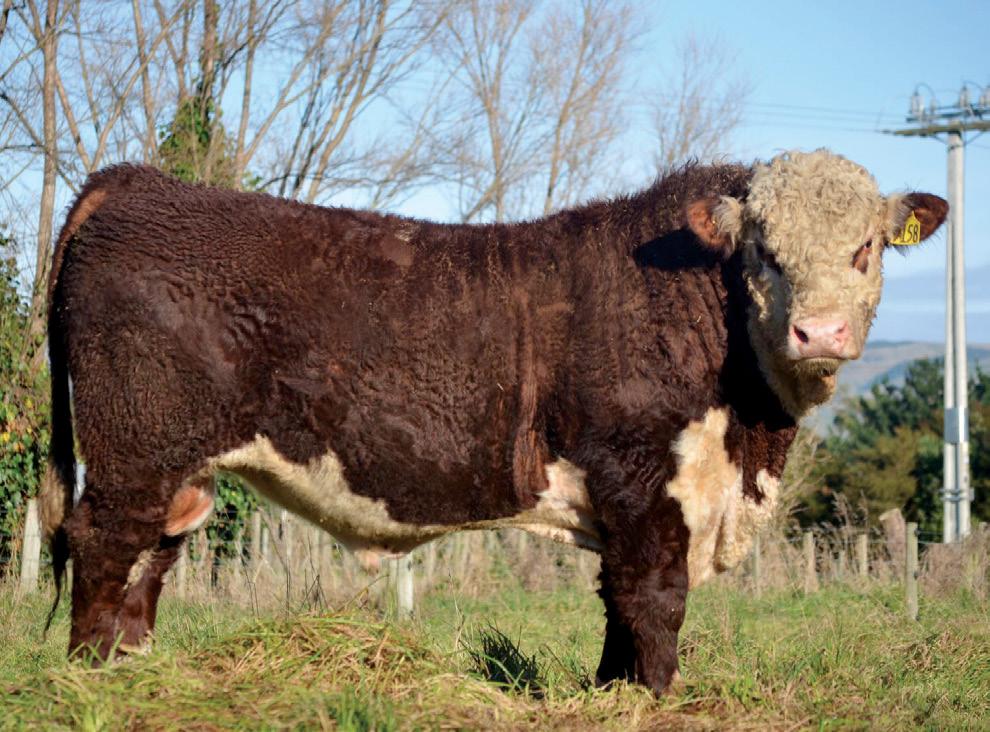
Country-Wide Beef | MAY 2023 69
Endure
most influential sire
recent
is the
of
times, sons for sale this season
Focused on Performance
YEARS BREEDING BULL SALE 8TH OF JUNE 1PM 2023 35 POLLED HEREFORDS BULLS 15 SPECKLE PARK BULLS 15 ELITE SPECKLE PARK FEMALES
54 th ANNUAL BULL SALE
NICK
Phone:
518
Email:
2.30pm THURSDAY 1ST JUNE 2023 60 RISING 2 YEAR BULLS
& PENNY FRANCE
027 567 8019
Upper Downs Road, RD 8, Ashburton 7778
nickandpennyfrance@gmail.com
NOTE: NEW WEEK FOR SALE 2023
THINK
FOR HEIFER MATING
 One of Lee Askew's pedigree Red Devon calves.
One of Lee Askew's pedigree Red Devon calves.
A Red Devon affair
Former police detective Lee Askew now runs a successful breeding and finishing farm in Gisborne’s Waimata Valley, and it all started with a sentimental attachment to Red Devon cows. Words and photos by Louise Savage.
she took a job as milk-records supervisor for the UK Milk Marketing Board, managing a team of 25 contractors quality testing milk on up to 200 farms. This experience gained her a more specialised role as a mastitis consultant for dairy cows with the company Genus.
In the UK, farmers are paid for the quality of their milk, incorporating fat and protein percentages as well as somatic cell counts. These cell counts are a significant factor in the UK because cows tend to be housed in winter, farmed more intensively and the climate tends to be wetter. As Lee got more and more farms on the right track with procedures to improve milk quality she found she’d done herself out of a job. In a complete turnaround she joined the police.
Lee met her late husband Brian Askew in the Devon and Cornwall constabulary.
“Brian was so kind to me during training and always looked out for me.”
When the NZ Police were seeking recruits from the UK, Brian and Lee, then a detective, came to NZ.
FARM FACTS
Location: Mander Road, Waimata Valley, Gisborne.
Type of business: Valueadded: pedigree Red Devon beef, farmed “from pedigree to plate”.
Area of farm: 66ha, 55ha effective.
Paddocks: 24, ranging from 0.5 to 10ha.
Contour: Medium to steep hills with 4.5ha flats.
Stock: 70 cattle, including 18 breeding cows.
Climate: Mild Gisborne winters, can be summerdry, 1500mm average annual rainfall.
As they say, you can take the lady out of Devon, but you can’t take Devon out of Gisborne farmer Lee Askew.
On a picturesque farm in the hill country of Waimata Valley, Lee’s business is to breed, finish and present high quality, free-range, low-stress beef. She sells both chilled and cooked to consumers via the Gisborne Farmers’ Market and at other events at which Lee caters.
Hertfordshire born, Lee began life as a city girl, but family holidays in Devon saw her fall in love with the southern English county. She gravitated there to go to college to study agriculture and she stayed.
In 1990, following a year of dairy farming experience in New Zealand, Lee returned to the United Kingdom and completed a diploma in farm management. Because she loved cows,
The Askews bought 5ha of land in Gisborne and Lee bought two in-calf Red Devon cows “for sentimental reasons” and that was the beginning of an enduring love for the breed. Red Devons are excellent foragers and are considered a gourmet beef breed, with tender meat, good marbling, and white fat, coupled with a calm temperament.
The little herd was slowly increased in size, initially using bulls borrowed from friends Gayle and John Couch before Lee invested in her own bull.
The realisation that her hobby could be a “real business” came to Lee after attending a meeting of the NZ Red Devon Cattle Breeders’ Association that incorporated a visit to Fiona and Julian Downs’ farm. The Downs processed their cattle through to the final product, which they sold at the Wellington Farmers’ Market.
“That was my lightbulb moment,” Lee says.
“I could see in an instant that was
Country-Wide Beef | MAY 2023 71
ONFARM
what I wanted to do, and Brian was right behind me.”
The Shemshi Red Devon brand was born.
Naturally a bigger block of land was needed, and in 2014 the Askews bought the initially weedy, scrubby and steep block up Mander Road and Lee threw her heart and soul into developing her farm, building up her herd from the first 11 cows and selling the meat at the Gisborne Farmers’ Market, both as “the very popular Delicious Steak Mince Burger” and chilled cuts.
Lee and Brian lived in a caravan for 18 months awaiting construction of their house. During that time they received
the devastating news that Brian had dementia. They carried on as long as possible, Lee keeping a constant eye on Brian, but eventually he needed to go into care.
About the same time, support came via a chance meeting with Sandra Mathews, who along with friend Marie Burke had set up Farming Women Tairawhiti (FWT). Lee undertook a course through FWT called Understand your Farming Business which led to her completing a diploma in agribusiness management. The support and friendships fostered through the group of like-minded women became invaluable during the tough years
of Brian’s illness and developing the fledgling business.
Killed and chilled
By far the biggest and ongoing business challenge has been getting stock to an abattoir and then the chilled transport to get the product back home.
Ever mindful of the welfare of her stock, low-stress handling and quality of the meat being paramount, Lee bought a trailer that enabled her to take her cattle, two at a time, to be slaughtered.

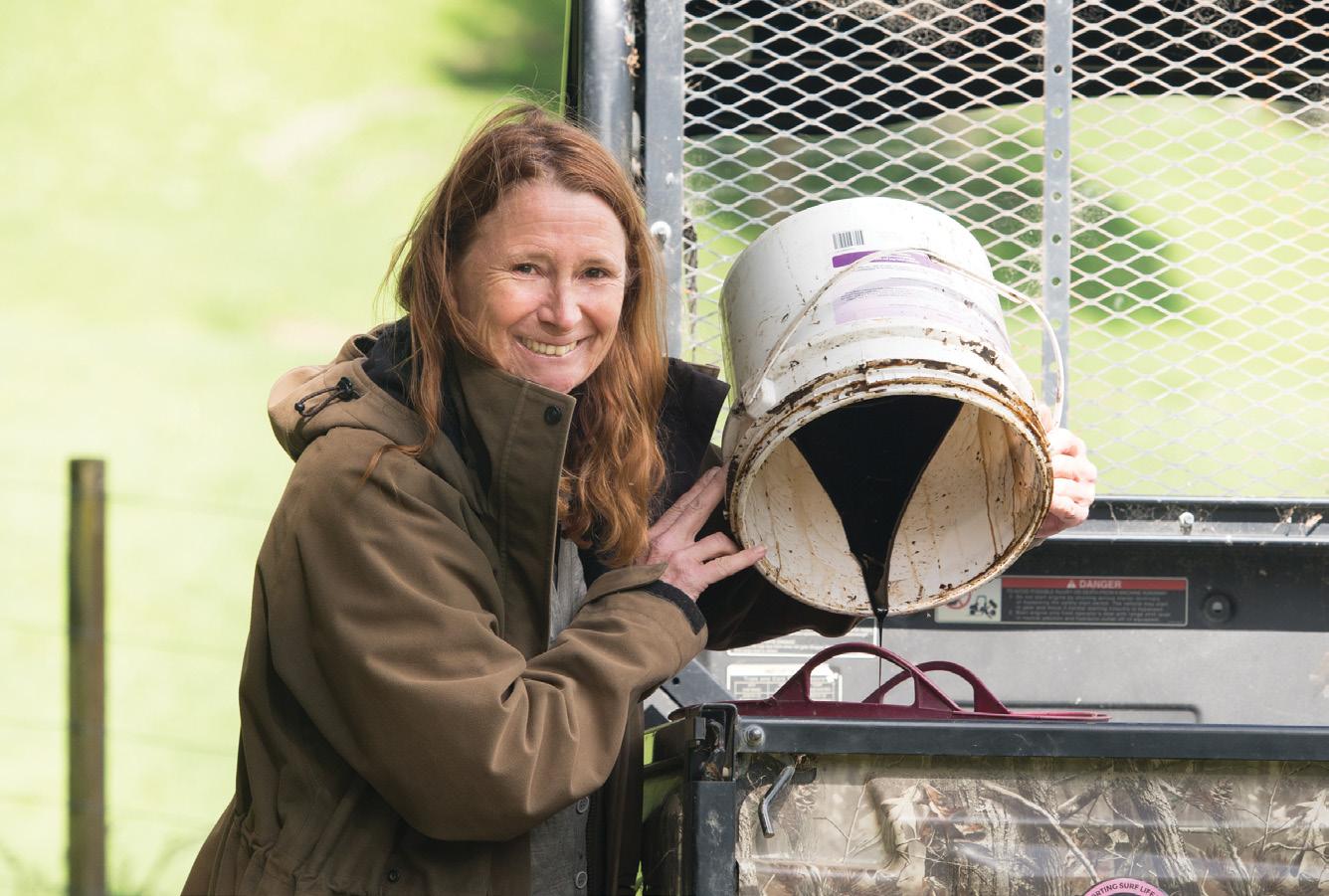
“We used to take them to Ruakura in Hamilton, then to Auckland Meat Processors. That was a total nightmare”.
Lee takes stock to Tom and Carrie Andrews’ Cambridge micro-abattoir Wholly Cow.
“Thank goodness for the Wholly Cow,” Lee says.
“Without the Andrews I wouldn’t be in business, and the way they do things, low-stress, perfectly aligns with how I want my animals handled.”
The Andrews farm and slaughter their own stock, which is then sold though their butcher shop.
They kill on a Tuesday, so Lee loads them and drives over on the Monday. They spend the night in yards, and each one is taken separately down a race to be killed, out of view of the other one.
“They don’t even know what’s happening.”
She says cull cows and any extras go to Silver Fern in Hastings, but “obviously not right now with no road”.
Lee says when animals are stressed
72 Country-Wide Beef | MAY 2023
due to handling and transport, the adrenaline released uses up glycogen and not enough lactic acid is produced in the muscle post-mortem. “The effect of this on the meat is to make it tougher, lower in flavour, high in pH and it doesn’t last chilled compared to low-stress meat.”
Her policy is to reduce stress in her animals at all times, and especially prior to slaughter, and to increase the glycogen levels in the muscle as a buffer
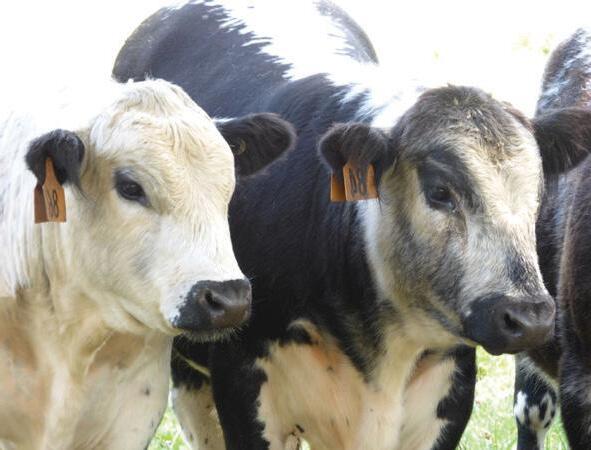
prior to transporting them. She does this by feeding them for two weeks, giving whole soaked oats mixed with molasses.
“The cattle become really familiar with me while I’m feeding them.”
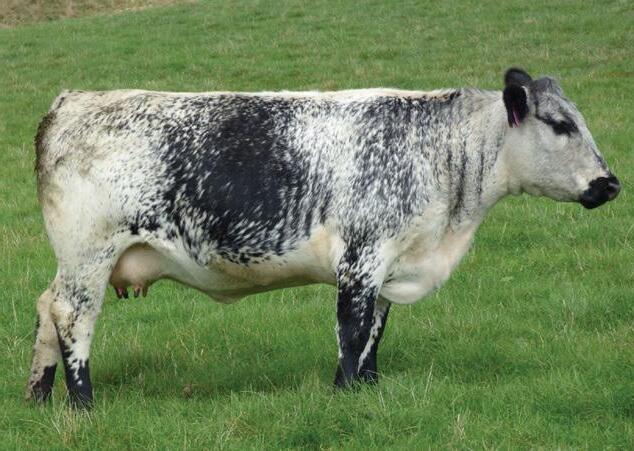
In the few days prior to transporting Lee will feed them on the trailer, training them to walk on voluntarily, so they’re comfortable with that, too. When the time comes to leave, they load themselves.
The trip to Wholly Cow is slow and careful, taking a bit under six hours.
Lee feels the ultimate from the animals’ point of view would be killing on farm using a mobile abattoir.
They tried it, but it was hard to handle the carcases afterwards, and actually, we can’t get anyone to come here any longer to slaughter on farm.”
Lee has considered having a mobile abattoir built to service her business
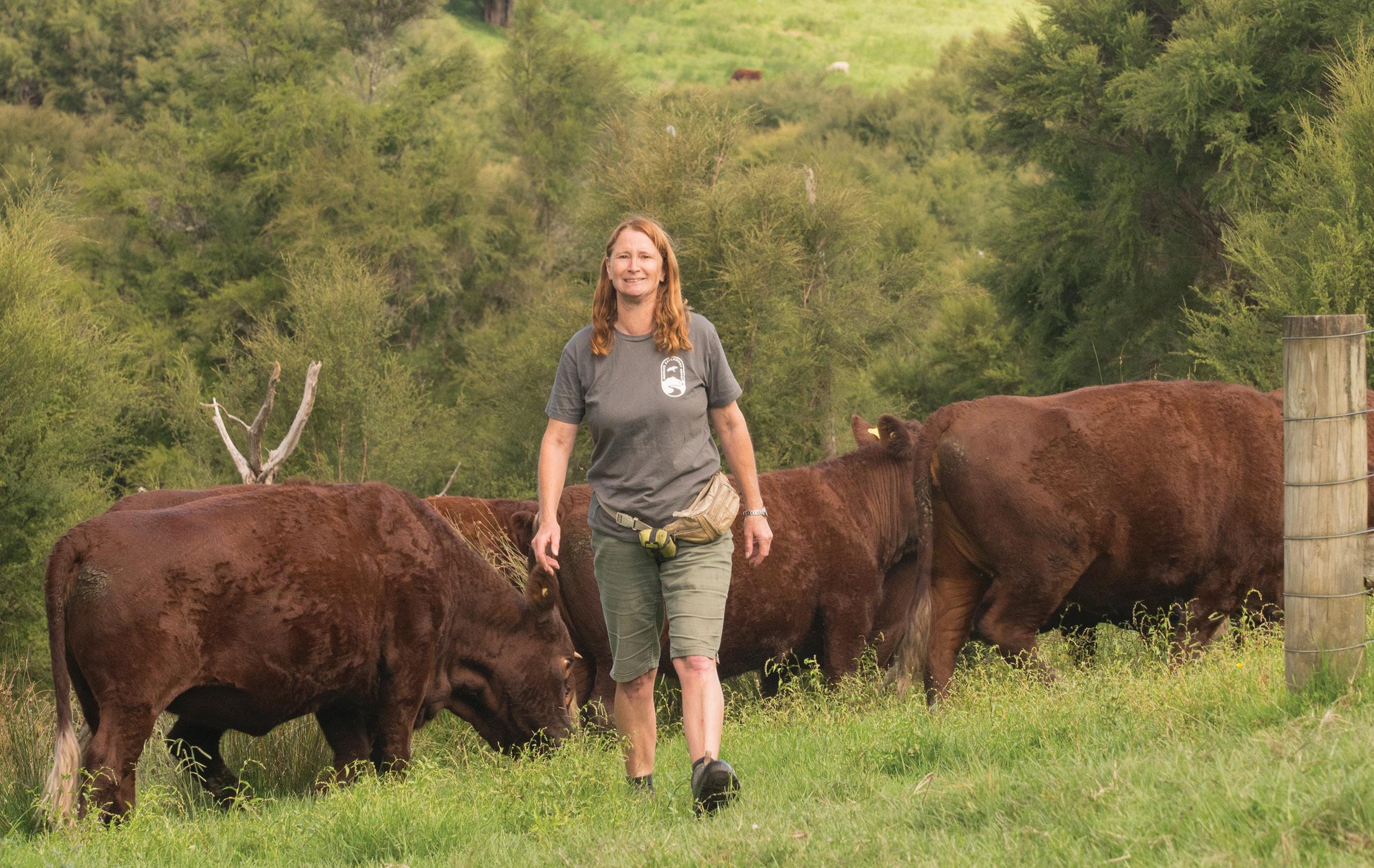
BLUE SKY SPECKLE PARK
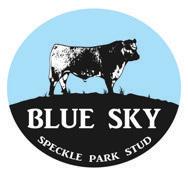
Country-Wide Beef | MAY 2023 73
Opposite page: Lee preparing a feed for the two cattle next to be transported to Cambridge for slaughter. This buffers them for pH against any stress while being transported. Above: Lee with her quiet herd of pedigree Red Devon cattle.
FOR SALE
EMA
• Frozen Semen from Blue Sky Hemi
Top 10% - Rib Top 15% - Rump Top 12% -
IMF
Top 20% - BW Top 12%
• Purebred Embryos
• Rising 2yo Purebred bulls
• Frozen Embryo’s from two top cows (one pictured)
Contact: Steph Niven, Upper Moutere Tasman blueskyspecklepark.nz | 021 259 1799
Yield, Super Feed Conversion, Great Adaptability
Exceptional
and hire out to others, but from an engineering point of view, considering the rough Gisborne roads, it would be a difficult engineering problem. “I think it would pretty quickly shake itself to bits,” she says.
“We really need a micro-abattoir here in Gisborne. It would serve not just me, but enable others to set up similar businesses, adding value. It would be wonderful if someone local could offer lamb at the Farmers’ Market. It would be useful for lifestyle block farmers too, and after the recent cyclones cutting us off, it would give businesses resilience to carry on.”
Developing the property
In the eight-and-a-half years Lee’s Shemshi herd and business have been on the Mander Road Block, she has done a huge amount of development. She bought a digger and cleared her own
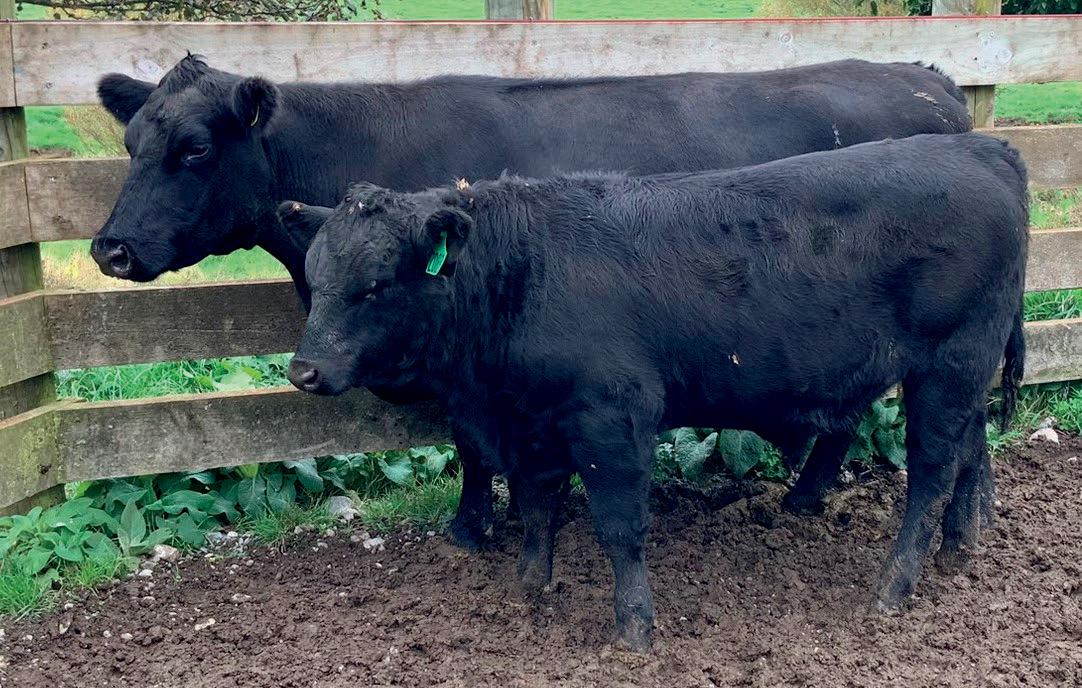
tracks, improved the fences, combatted the blackberry and reclaimed pasture.
“One square metre at a time”.
Initial soil tests showed slight acidity and low potassium. DAP was twice applied by plane, then last year superphosphate by helicopter. No nitrogen is added at all. Despite the very wet winter, temperatures have been mild and Lee says it’s been an amazing clover season.
Five years ago Lee left NZ Police and became a full-time farmer; the realisation of one dream even as Brian was so unwell, and sadly he passed away in 2020.
Stock
Stock numbers peaked on the property two years ago at 105 cattle, including 30 breeding cows. Covid made it even more difficult to get stock killed and prompted a rethink. Lee realised those numbers
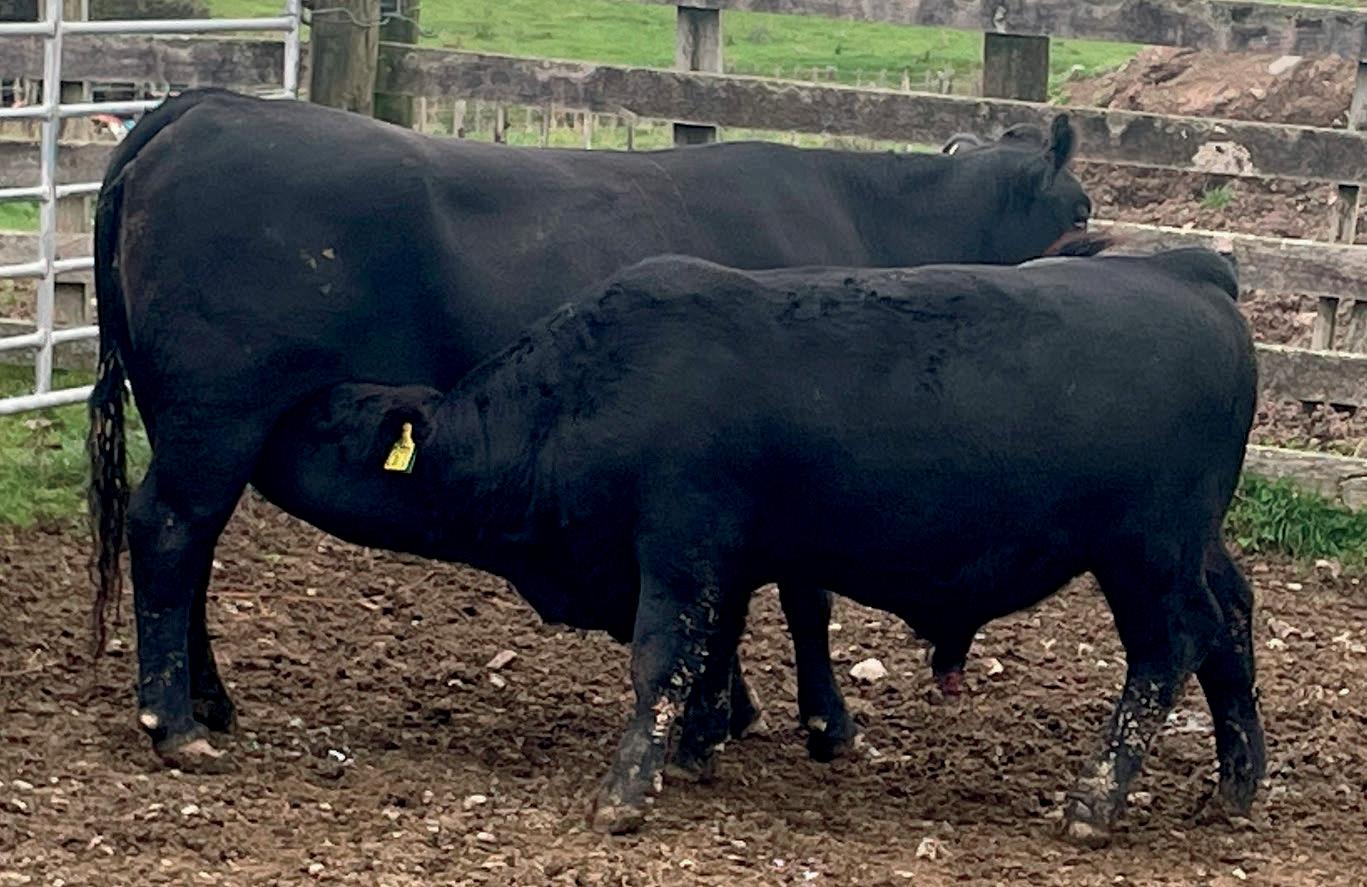
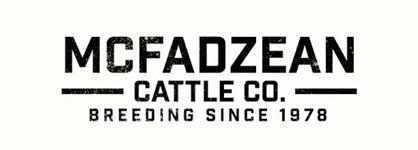
74 Country-Wide Beef | MAY 2023
M C F A D Z E A N C R U I Z Y C A L V E M C F A D Z E A N M E A T M A K E R McFadzean Cruizy Calve 2083 Birth Weight 32kg Weaning Weight 315kg Featuring the McFadzean Meat Maker, McFadzean Super Angus & McFadzean Cruizy Calve Superior weaning weight % Instant impact on calf size, growth & muscling Higher carcass yields High EMA scores Strong milking & maternal traits At least 7/8's Angus Moderate framed hill country cattle Excellent growth rates and superior muscling Positive fats & high IMF % Strong milking & maternal traits 100% Registered Angus Positive for calving ease Short gestation Positive fats & good growth Suited for heifer mating Thursday 14th September 2023 at 1pm 65 Top quality yearling bulls up for auction Open Day 30th August 2pm 216 Wiltons Road, Carterton www mcfadzeancattlecompany co nz Johnie McFadzean 0274295777 | Andrew Jennings PGG Wrightsons 0275946820 H I L L C O U N T R Y C A T T L E B R E D T O L I F T Y O U R C A T T L E P E R F O R M A N C E A N D Y O U R B O T T O M L I N E M C F A D Z E A N S U P E R A N G U S McFadzean Meat Maker 2413 Weaning Weight 446kg Weaning weight % 63%
"We really need a micro-abattoir here in Gisborne. It would serve not just me, but enable others to set up similar businesses, adding value."
were too many for the block to carry. Currently there are 70 cattle, including 18 breeding cows and Lee plans to reduce numbers a bit further to 15 breeding cows and 60 head in total.
All stock are weighed frequently, at every treatment and at least six-weekly using a Tru-Test weigh system. Lee is looking for liveweights of 500+kg LW for steers to be slaughtered and 460+kg LW for heifers.
Qualities Lee looks for in a bull are temperament, low birthweight combined with good growth EBVs and finishing weight.
These factors combine in Shemshi’s sole pedigree bull: Devland Kristoff.
“Kristoff went out with the girls on January 15 and came out on March 19. That’s nine weeks, or three cycles.”
Pregnancy testing is done at the beginning of May and calves are born from October 20 onwards, “To match our grass growth, and they have to arrive after the Poverty Bay A&P Show, which is a big catering event.”
Kristoff, due for replacement, has served the herd well, although Lee feels she has not capitalised on his genetics for good growth; the limiting factor being a lack of feed, and hence her decision to downsize the herd.
The lush situation belies this, with stock in great condition following the very wet and mild summer Gisborne experienced, culminating in two cyclones and several other severe weather events. Waimata Valley received twothirds of annual average rainfall by the third week of February.
The farm is not flood prone and fared well in the cyclones. Lee lost some fences, her main stream crossing and some tracks sustained damage, but thanks to space-planted poplars, scattered mature kanuka stands and the bush gullies, the farm got off fairly lightly.
A measure of success
Asked how she measures success, Lee instantly replies: “By the number of ciabatta buns we go through at the farmers’ market.”
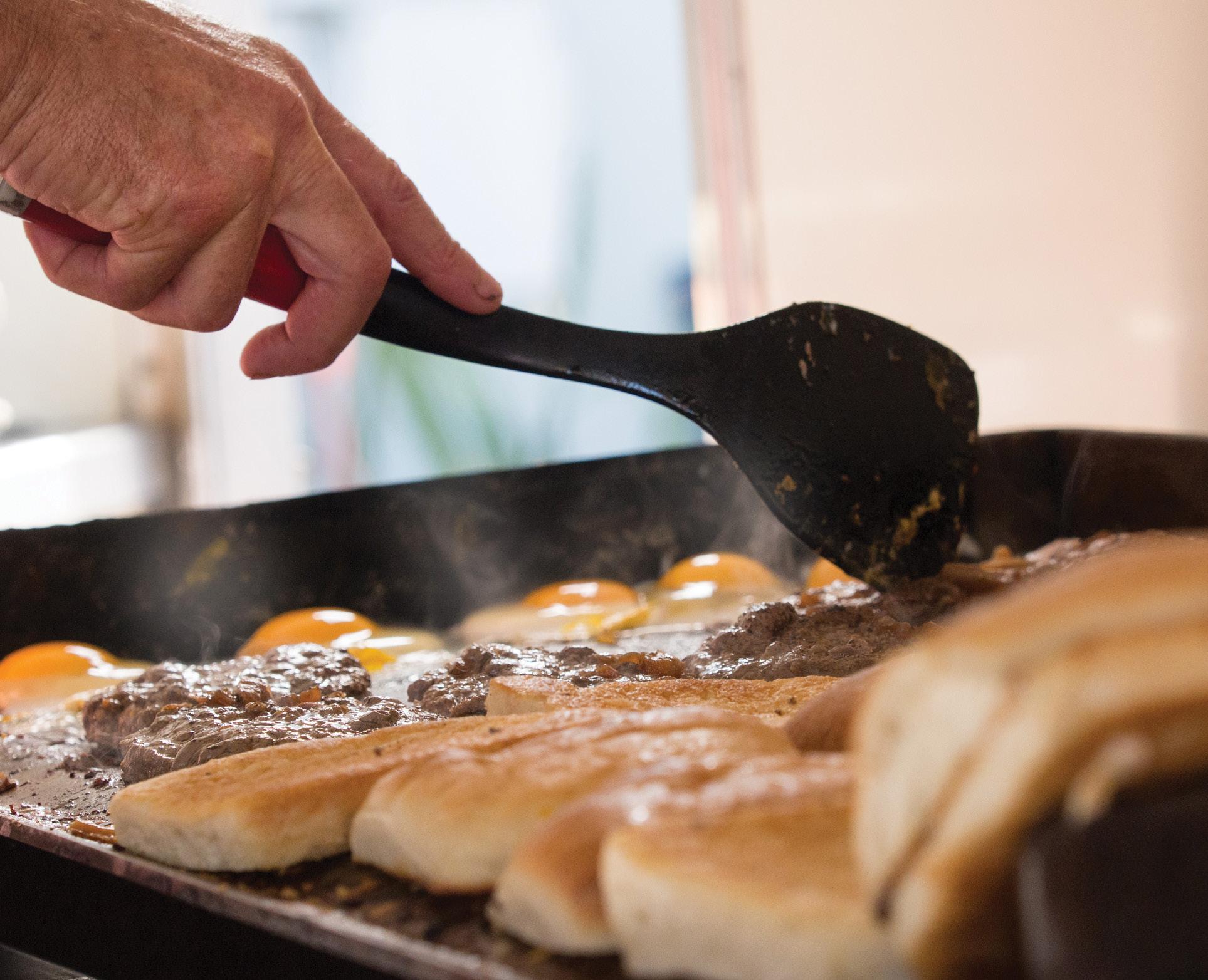
Despite Covid disruptions to the market and cancellation of so many
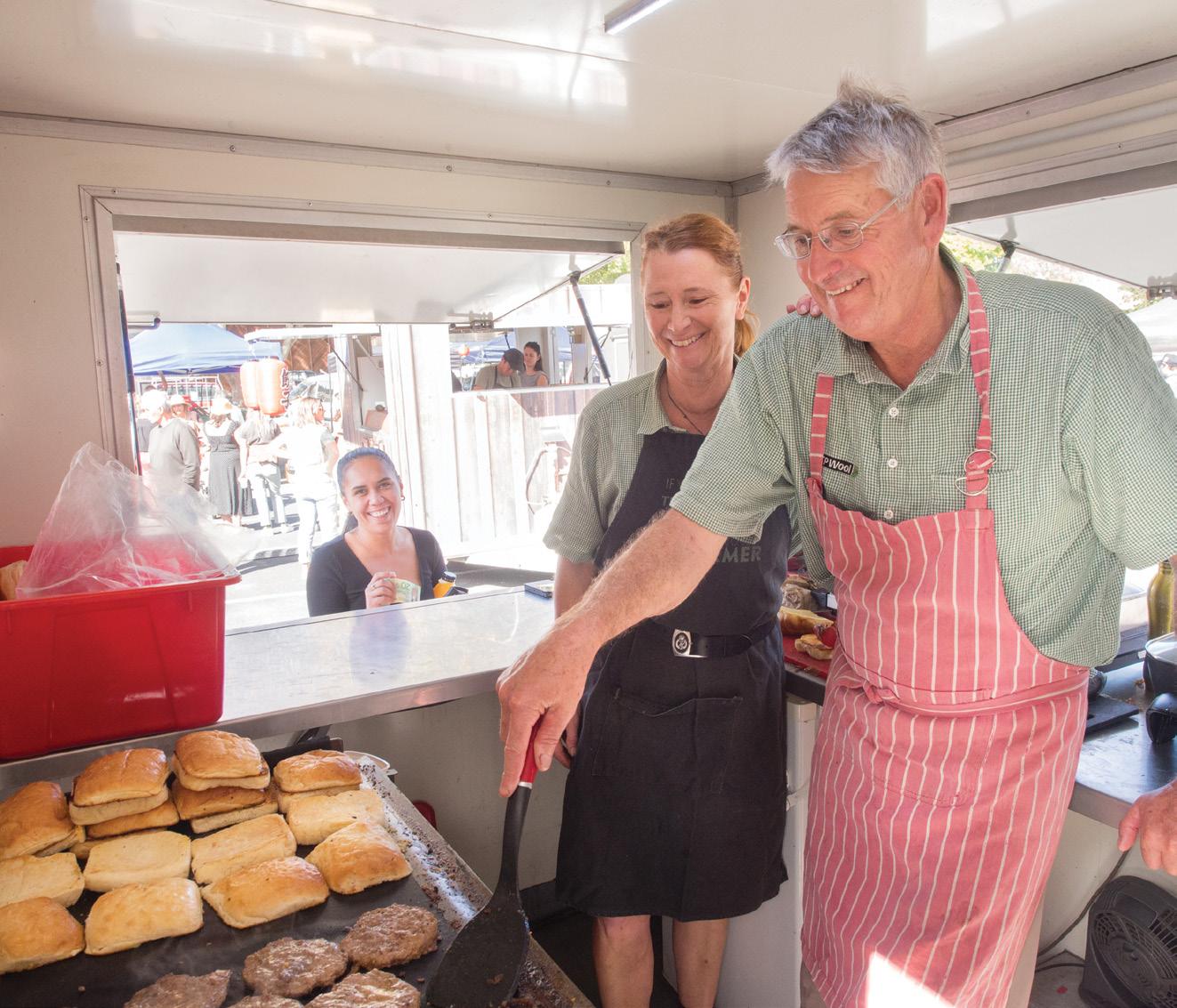
Country-Wide Beef | MAY 2023 75
Lee and partner Simon at the Gisborne Farmers’ Market, selling the finished product, cooked and chilled, from the Shemshi Beef food trailer.
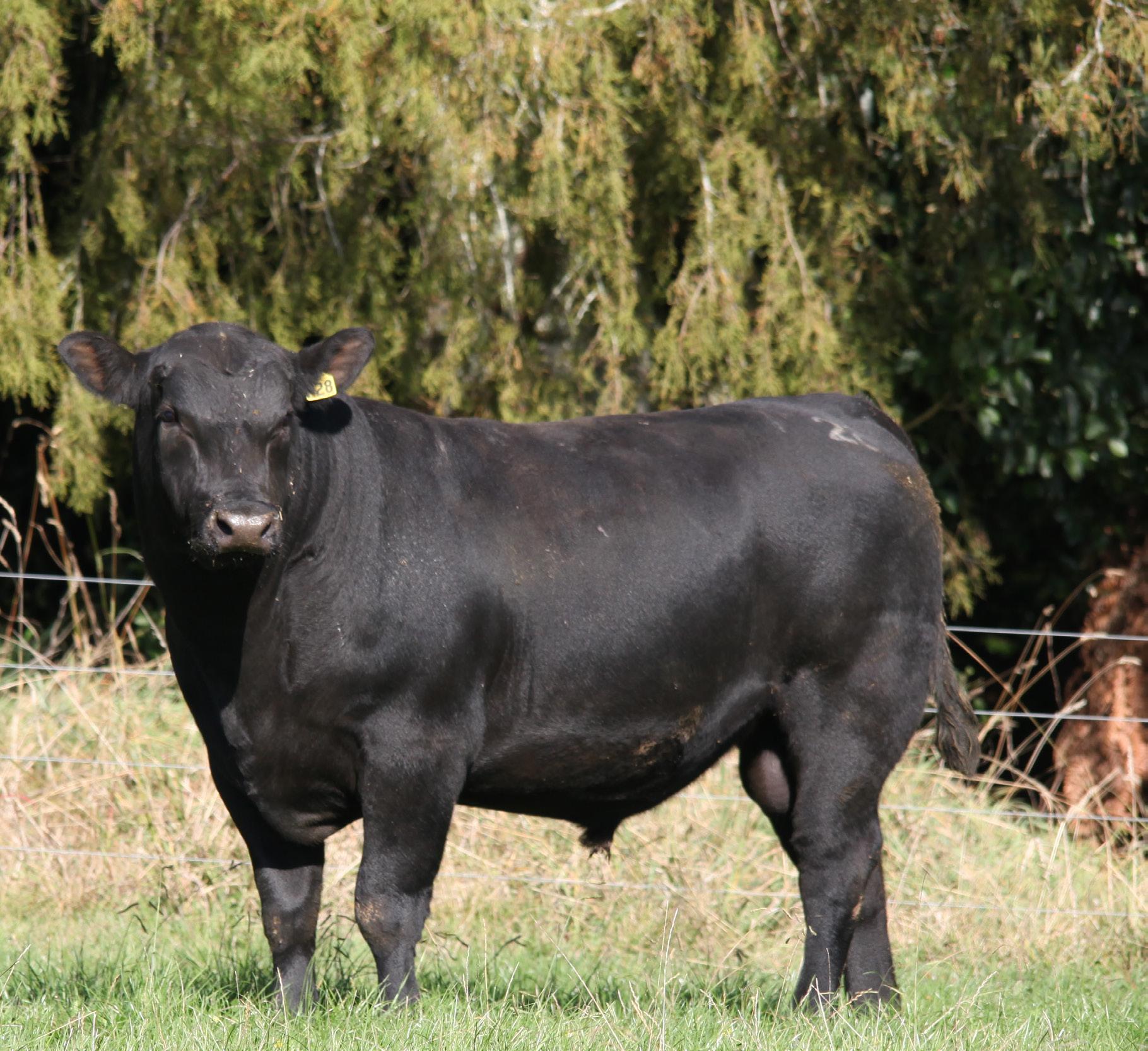

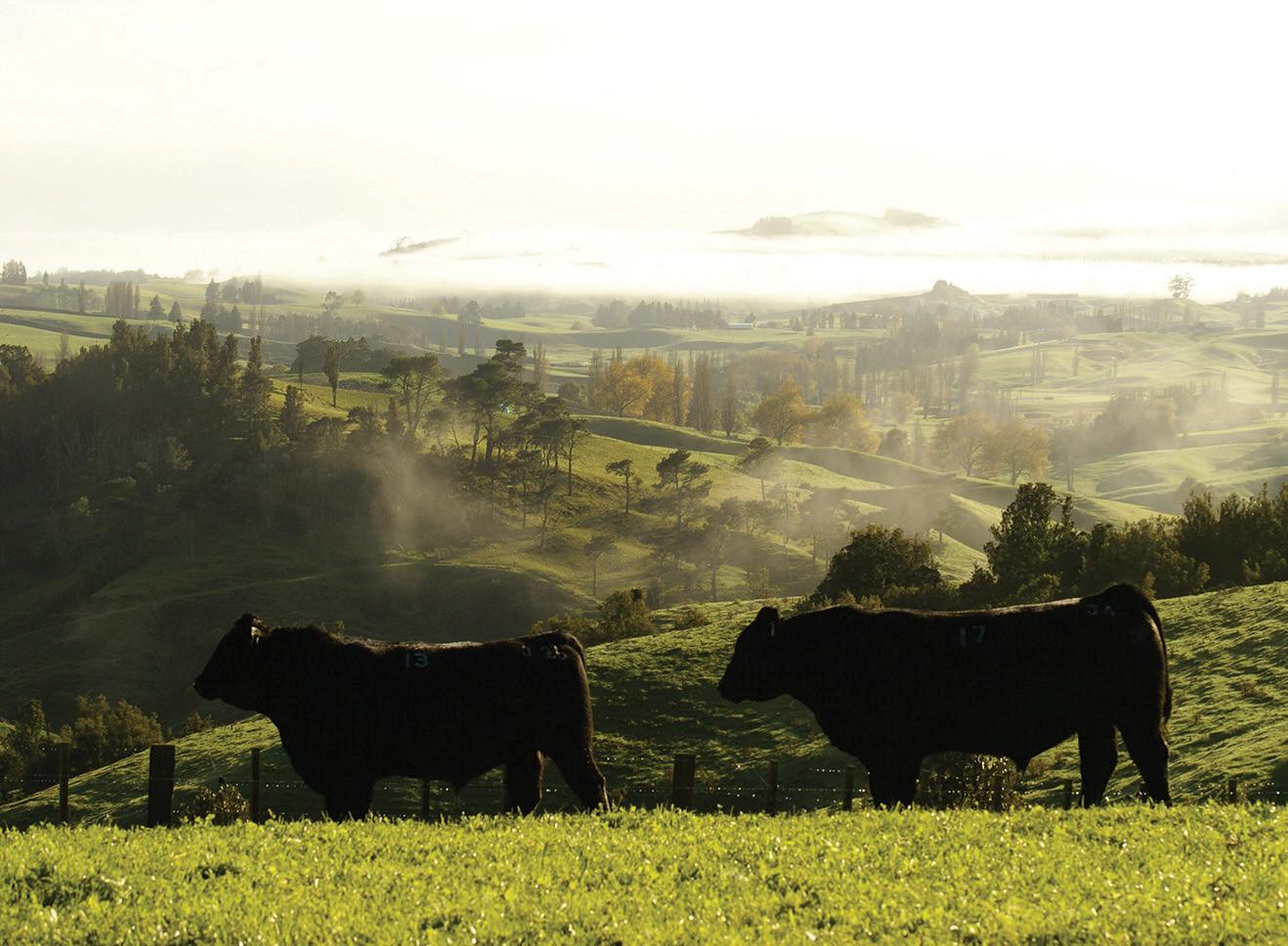
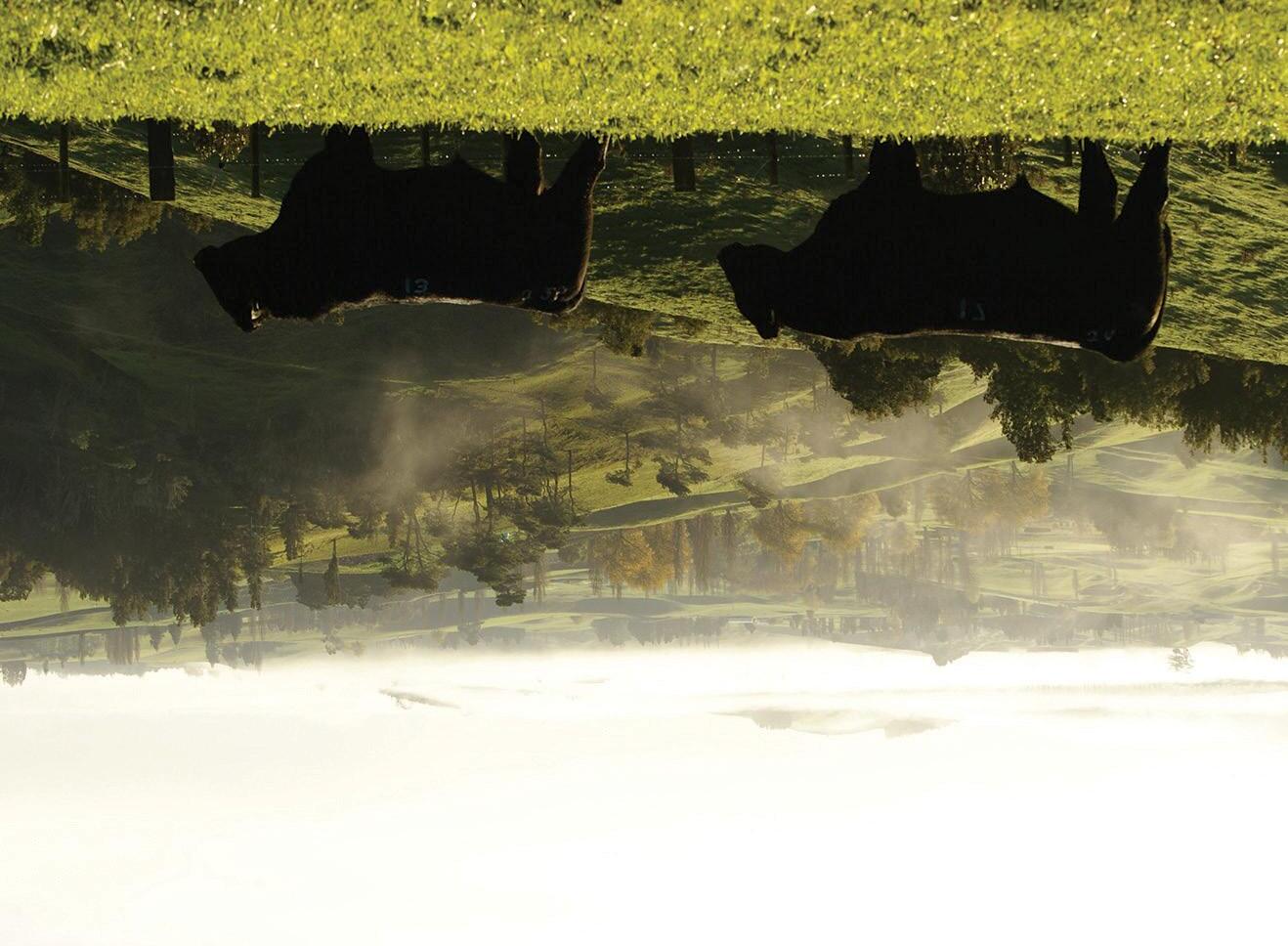
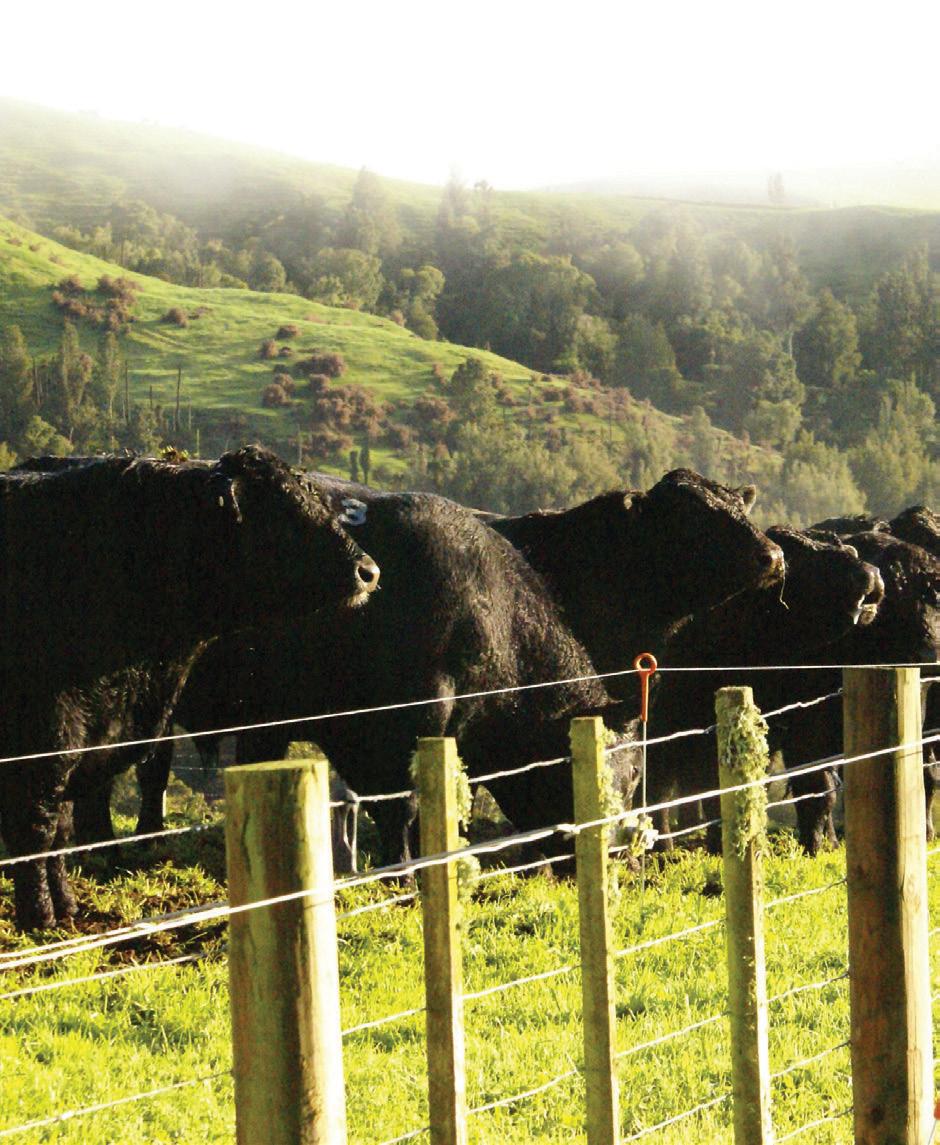
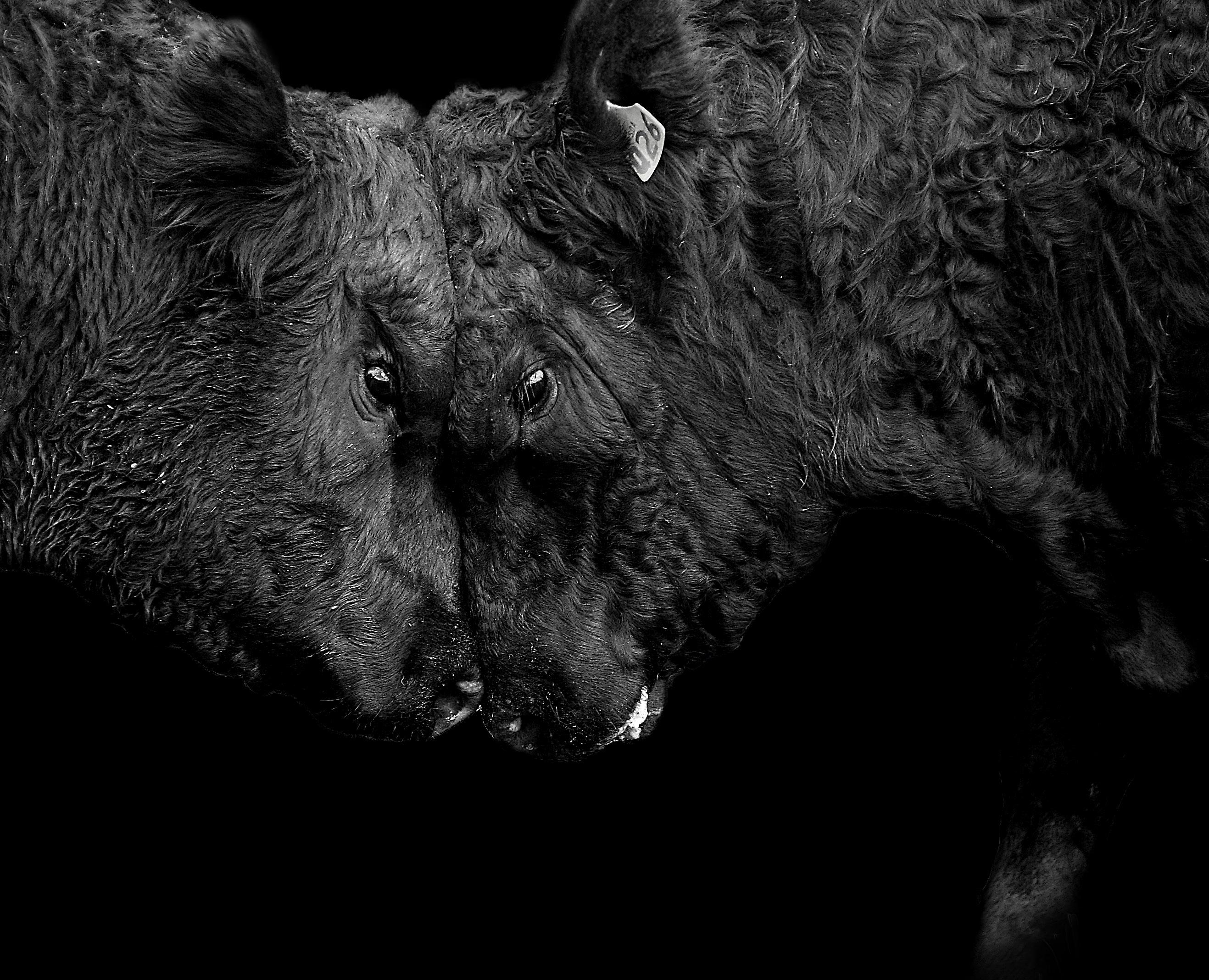
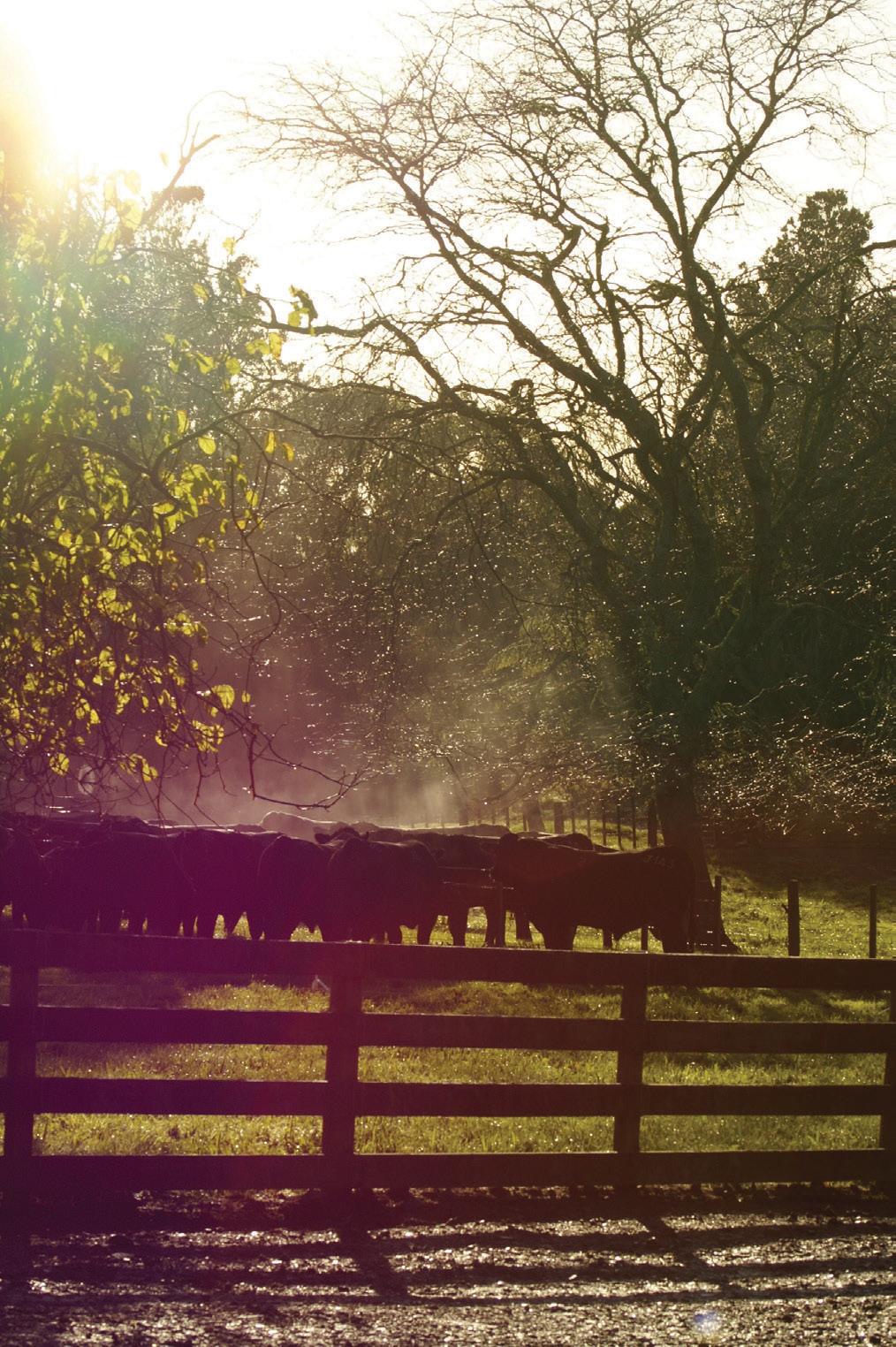
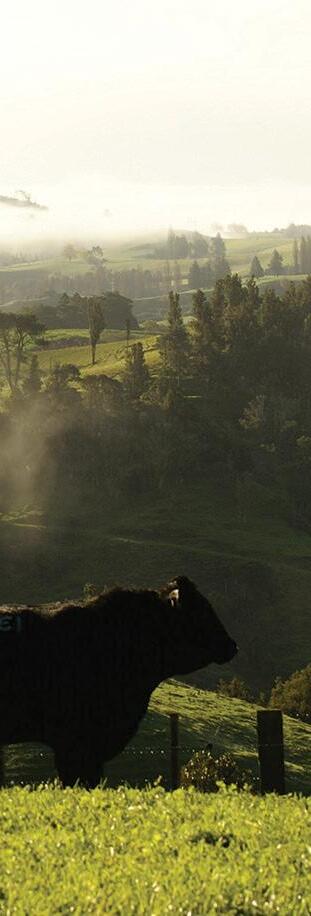
76 Country-Wide Beef | MAY 2023 There is more to bulls than meets the eye. Top EBVs, Top Indexes, Top Bulls. Wednesday 31st May 2023 – 1pm on farm Selling 85 top R2 Angus Bulls Tim & Kelly Brittain 524 Paewhenua Rd, RD2, Otorohanga, 3972, New Zealand ph: +64 7 8732816 | mob: +64 275 935387 | www.storthoaks.co.nz | tim@storthoaks.co.nz
events where Lee normally caters, the bun count has escalated from 50 or 60 pre-Covid to 150 at a regular Saturday market.
In addition, the chilled product – dryaged scotch fillet and sirloins – “fly out of the chiller”.
Two years ago, Lee met new partner Simon. He moved to Gisborne to be with Lee and now helps on the farm and is chief burger-flipper at the Saturday market.
He’s a fencer, cabinetmaker and furniture restorer by trade. “Simon can turn his hand to pretty much anything from fixing fences to tractors and spraying weeds, so he’s a great help,” Lee says.

The next chapter of Lee Askew’s life sees her in a good space, with the farm and stock looking wonderful, performing well, and the business going from strength to strength. The city girl has become a country girl through and through.
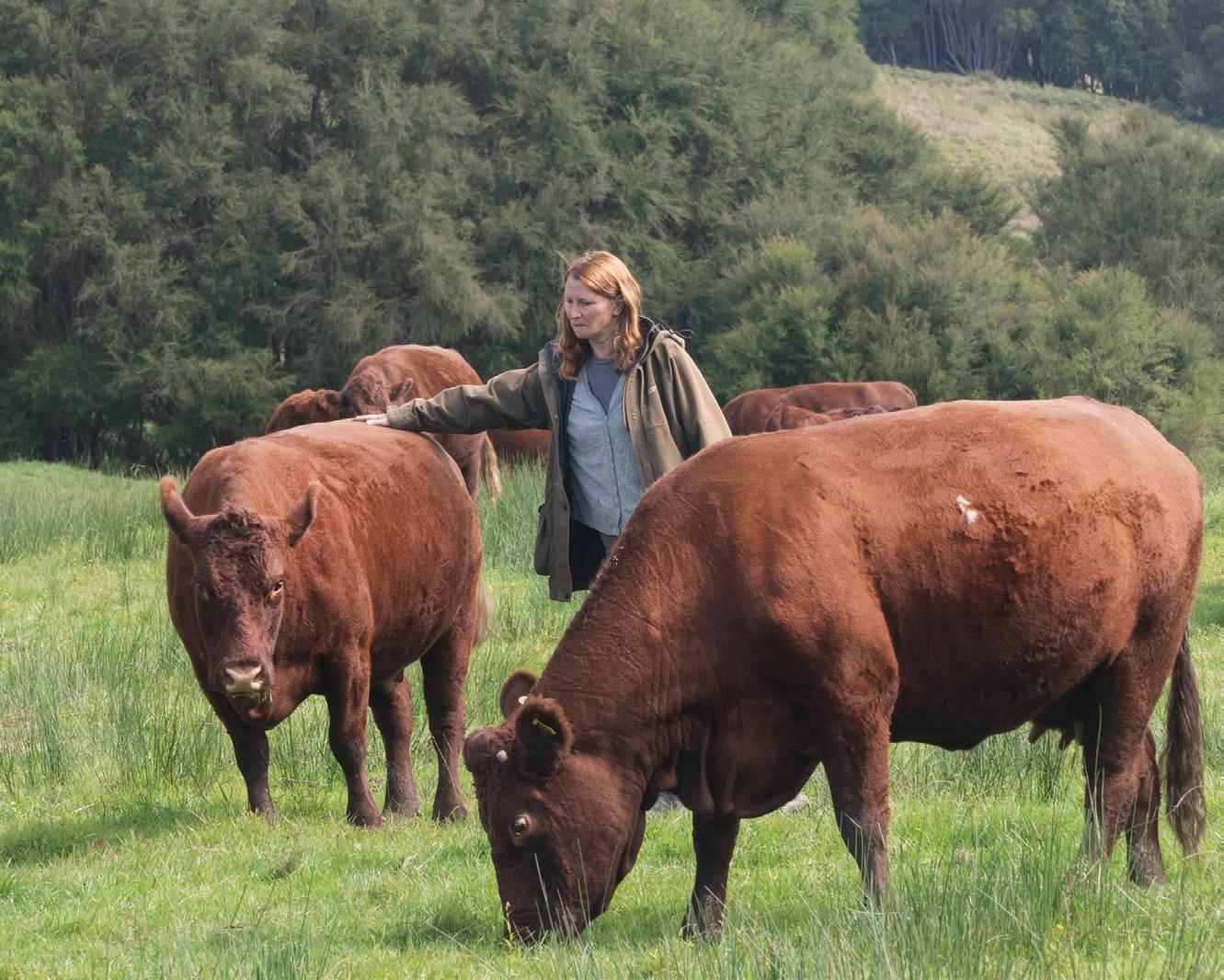
Country-Wide Beef | MAY 2023 77
ARE ON NOW FIELD DAY SPECIALS 6.99% FINANCE P.A+ UP TO $2,500 FREE ACCESSORIES^ 0800 440 290 | www.polarisnewzealand.com | /PolarisNZ | /polarisorv_nz *Offer ends 31/7/23 or while stocks last. Offer only available at participating Polaris Dealers. Not valid with any other offer. Excludes fleet clients. +Finance offer is only available on selected models. GST registered customers only. 24-month term contract. 20% Deposit required. Deposit may include Trade (Trade conditions apply). Fees and conditions apply (normal lending criteria applies) Finance is provided by Polaris Finance, a program operated by De Lage Landen Limited Company No 135515. DON’T MISS OUT, CONTACT YOUR LOCAL POLARIS DEALER TODAY!
Lee is aiming to kill two head every second month, 12 a year.
A 0 1 B Y T 2 E T A H F
K Q F E F W J T Q T O Z A
Q S L T O R B S E A S I
Data collection is getting easier and can have real value on farm, if you know how to use it. Andrew Cochrane writes.
A I G T 3 Q T 9 O P B Y 8
X N Z Q E 7 2 D F V I U
M P A C T E R S W D X 1 S
D G 1 X R L A V G A 3 N Y
78 Country-Wide Beef | MAY 2023
O
C
S
Y
Z E K Z H D X U I M N P
HE DATA PEOPLE COLLECT on farms always interests me. I have clients who have recorded 40 years of weather data in a notebook and can tell me exact details about the flood of 1984. Others, more tech savvy, have 15 years of Microsoft excel files detailing the production of every stock class and paddock on their property. Is this data useful? Maybe, maybe not. The value of data is only realised if it is utilised and acted upon – otherwise it is just a record that future generations will eventually find, smile at and dispose of.
At the opposite end of the scale, we have clients who collect minimal data, don’t pregnancy test, don’t weigh stock, don’t have the time, don’t have the means. Some of these farmers don’t fully appreciate the value this data could add to their operation.
Fortunately, as technology improves, data is getting easier, faster and cheaper to collect. The type of data we can collect is expanding too. Take pregnancy testing as an example. It wasn’t that long ago that this was done by the vet manually, shoulder deep in the cow and predominantly only providing a result of pregnancy or not. This was physically demanding work and relatively slow. Now this can be done reasonably comfortably at 150 an hour (with the right facilities) and data can include foetal ageing to five-day intervals and identification of twins.
This data can be used to identify cows requiring special treatment, or those conceived to a certain sire or AI. It can also allow the formation of wintering mobs based on calving date and aid in any investigation into fertility problems or bull failure. Many farmers (particularly studs) are also collecting data on frame size, structural assessment and temperament, which can all be done ‘cow side’ for little cost. This data can all be used to assist in the selection of replacements and/or the decision
around what to cull. Going further, DNA parentage and genome sequencing, along with measurements of muscle and fat, can also be collected and recorded, adding accuracy to breeding values for studs.
Notebook no more
The use of electronic tags has simplified data collection further and the days of pen and paper have given way to wands and computers. But whilst the younger generation has certainly adopted this quickly, there are still farmers who prefer the tangible comfort of handwritten notes. The fear of data being lost is the main reason for not having full trust in technology, because notebooks never got lost, right?
Whilst errors can happen and tags can be lost, EID and wand technology has generally been a great advancement in the collection and storage of data. It has definitely been an improvement on trying to read the tag of a cow that is intent on keeping her head buried under the cow in front of her – assuming you can reach her with the wand!
As previously mentioned, data is no more than a record unless it is acted
upon and utilised. Identifying secondcycle cows at pregnancy testing is simple data to collect, but the power in this information is then using it to draft those cows into a separate mob, keeping them on their winter ration for three weeks longer than the early cows. This helps to conserve feed for spring. It ensures feed saved for calving is reserved only for those that will soon need it. Equally, body condition score is valuable data to collect, but its true value is realised when it is used to prioritise feed to light cows. This can be done at weaning, set-stocking and at calf marking to ensure the best quality feed is going to those that need it most.
There is a large amount of data that can be collected and used on the farm to aid decision making, and this isn’t limited to stud farms. We have commercial beef clients who are recording cows that wean a below average calf – this can be based on weight alone, can include information on birth date (and therefore growth rate) or be linked back as a percentage of the cows liveweight. This data is then used to assist cull decisions. These cows go into a B mob initially and if they fail

Country-Wide Beef | MAY 2023 79
ANIMAL HEALTH
Discussion groups best extension
Drench resistance, farm survival, not heeding advice and discussion groups are all covered this month by Trevor Cook.

It has happened. Lambs are dying because there is no effective drench left to treat them. More lambs are dying because the only effective drench left is not available.
There are two issues here that should alarm sheep farmers. First, that drench resistance can get to the stage of no drench being effective enough. In a summer and autumn like this, which has been paradise for worms, any drench failure is badly exposed. Secondly, the supply of some of the combination drenches that we use is far from being secure. Product shortages have been common over the last year. As I have been saying time and time again, we must get away from managing parasites by just using a parasiticide. The parasites always win.
The place of genetics has always been crucial for production gains. New Zealand’s livestock industry has been a world leader in this and interest in New Zealand genetics from
overseas is rampant. That expertise and commitment must continue but in a different direction.

Getting more lambs, faster growing lambs or calves or meat that is marbled is still important, but stock that is cheaper to run, can cope with parasites or get less disease is becoming more and more important.
None of this is new and there are breeders who have this focus, but more and bigger gains need to be made.
The term ethical farming is bandied about, usually without there being much substance to it, but there is some sense in this term when we look at the challenges that are before us.
Market preferences, the cost of production, animal welfare sensitivities, failing medicines, a changing
climate and fewer and fewer sympathetic urban eyes make for a very different farming environment ahead. The spectacular shift of sheep farmers into shedding or hair sheep is partly in response to these needs.
None of this is comfort to the farmers whose farms have been decimated by storms. Their focus is now
on survival. Luckily good feed is saving an even bigger animal welfare disaster. I am amazed at and heartened by the amount of support that I come across from other farmers. It is interesting that despite some formal or organised support efforts attracting significant money, there is still a widespread desire to directly fund farmers
80 Country-Wide Beef | MAY 2023
ANIMAL
HEALTH
“It is farmers supporting farmers, as well as being powerful learning platforms."
to help their recovery. It is this expression of the farmers helping farmers concept or sentiment that has held farming together for years.
Being in the South Island quite a bit last month was an escape from the damage, although in Golden Bay there were roadworks to repair damage done by severe rain earlier in the summer.
Two farmer interactions made me question the effectiveness of extension. This was further brought home in a recent interview when I was asked what investment was needed in extension to farmers. For those two farming businesses some of my advice prompted comments they had heard before. This just confirmed
what I have often said, that I seldom tell any farmer something that they have not already heard.
So was my telling them again going to make any difference? I asked them why they had not implemented that information. For both, the replies were almost the same – the information was difficult to see in the context of their farms. In fact, the information was very relevant to both farms but had not been presented in a way that made it relevant. It put the pressure on me to make it relevant. It was easier for me because I was being paid to help make a difference in those farming businesses. So they were already in a more receptive mind set. What’s more, I can follow up.
Knowledge can never be the sole pathway to progress. Implementation and support are just as important. So my interview answer was for more support for groups. Discussion groups in their various forms are the best money spent on extension. Little coincidence that the Wairarapa is in my opinion the home of the highest concentration of very good farmers, but also the home of the greatest number of discussion groups, and the highest proportion of farmers belonging to such groups. It is farmers supporting farmers, as well as being powerful learning platforms.
to produce a decent calf a second time they are gone. With time, this results in a more efficient and productive herd, culling out the under performers with accurate data to support it.
The EBV suite
The obvious other suite of data to improve productivity and efficiency, one that most commercial beef farmers are already using, is the estimated breeding values (EBVs) of the bulls we use. This data has been shown time and again to improve the performance of a herd when used appropriately. Now, with genomic technology becoming more readily available, it is also possible to test your heifer replacements as another tool to improve the genetic merit of your herd. This genomic data can be used to aid selection of replacements, assist culling decisions and increase the production and efficiency of your herd.
Trevor Cook is a production animal consultant/ veterinarian in Feilding.
The breadth of data that can be collected can be overwhelming, but it doesn’t have to be. Start by focusing on what you can collect and influence easily on farm –weights of young stock, body condition score, etc. Consider what data you could use to aid decision making, whether it be wintering mobs, replacement selection or culling decisions. Farming smarter and making the most of the resources available to you may be easier than you think.

Country-Wide Beef | MAY 2023 81
Continues from p79
Avoid breeding resistant worms
For nearly 60 years, the availability of ‘effective’ anthelmintics has meant worm control in cattle finishing systems has required very little thought.
Managers of high-performance young cattle know that offering low worm challenge feed always results in better liveweight gains than simply controlling worms via regular drenching. But there are many R1 cattle out there that get through their first year doing suboptimal weight gains on highly contaminated pasture, with nothing but a monthly or six-weekly pour-on or injection between them and getting sick with worms.
In the 1960s and 70s, when only Benzimidazole (white) and Levamisole (clear) drenches were available, cases of the stomach worm, Ostertagia, were not always well-controlled by a single drench. Severe or ‘Type II’ cases of this worm required multiple doses of white drench administered over several days. Recovery was variable, with some animals taking many months to regain lost condition.
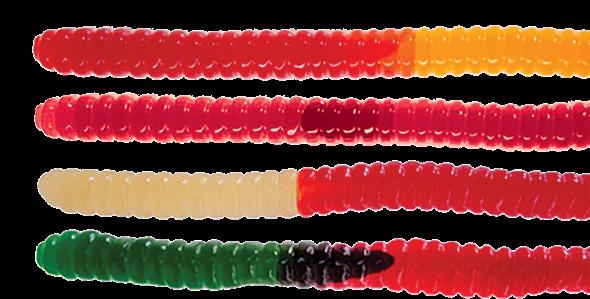
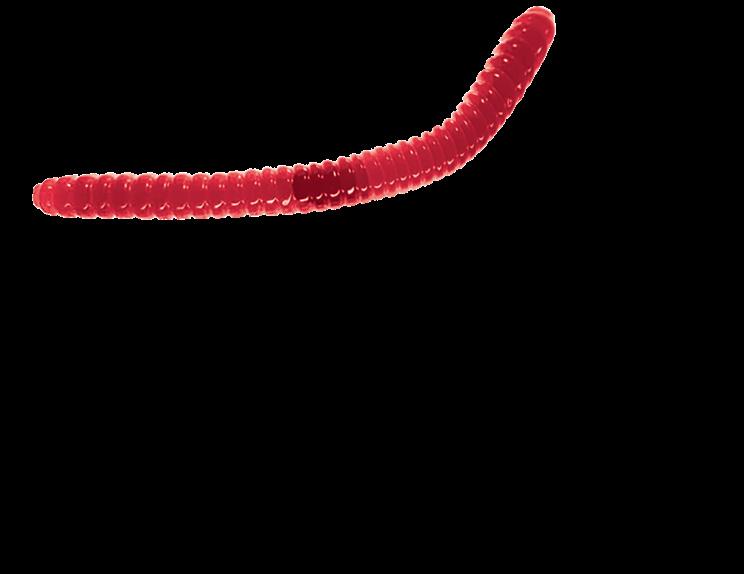
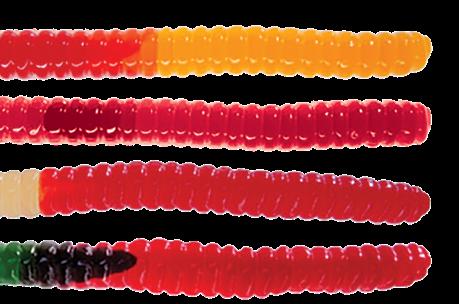


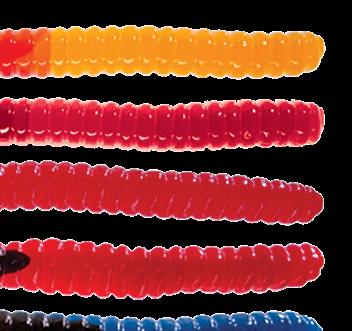
Enter the mectin drenches in the 1980s. Ivermectin was the original and it started a revolution of treating cattle with pour-on and injectable preparations. One dose was highly effective against these severe cases of Ostertagia, and this type of parasitic disease in cattle has all but faded from memory. Our addiction to pour-ons and injections remains to this
day, despite there being clear evidence from New Zealand trial work that oral preparations are more effective at killing resistant strains of Cooperia.
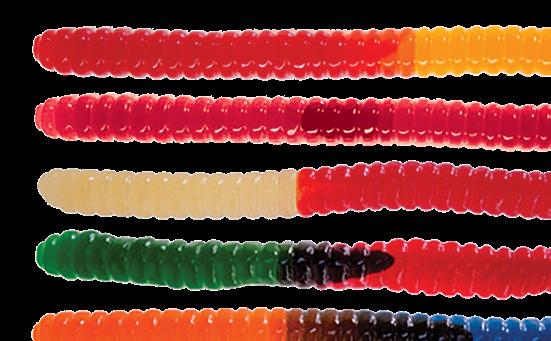
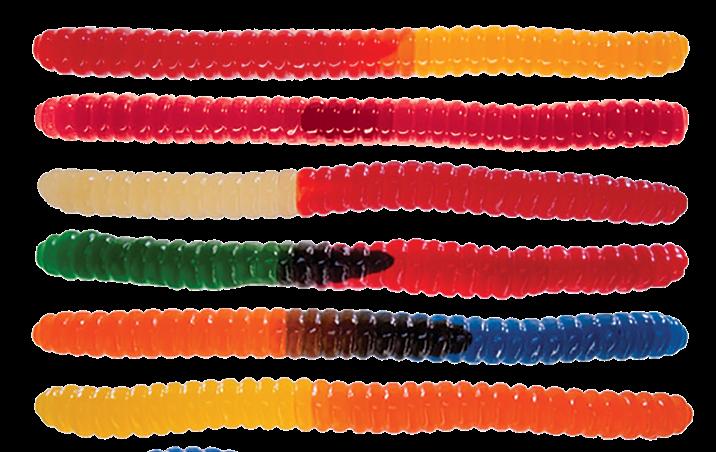
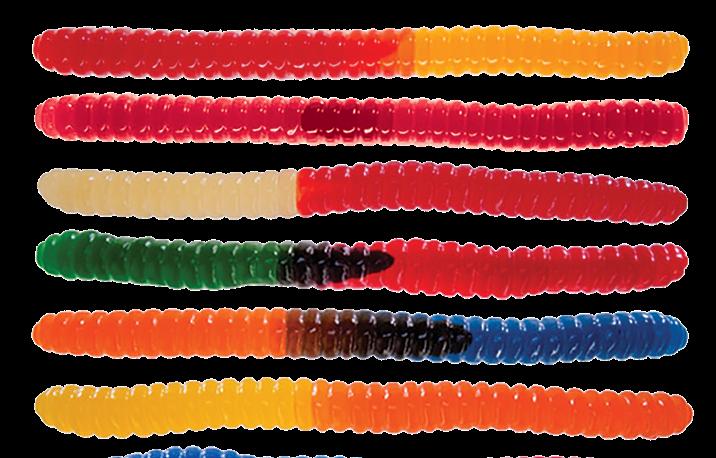



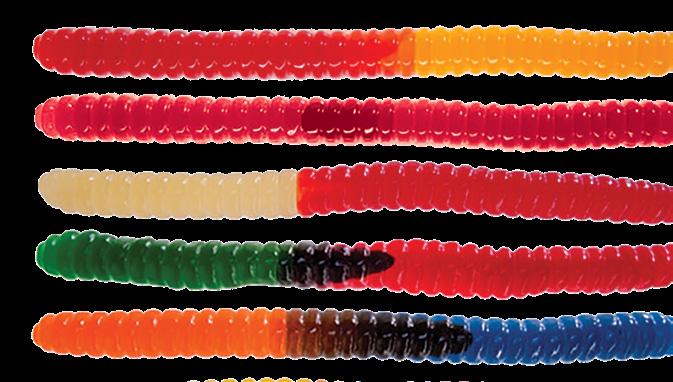
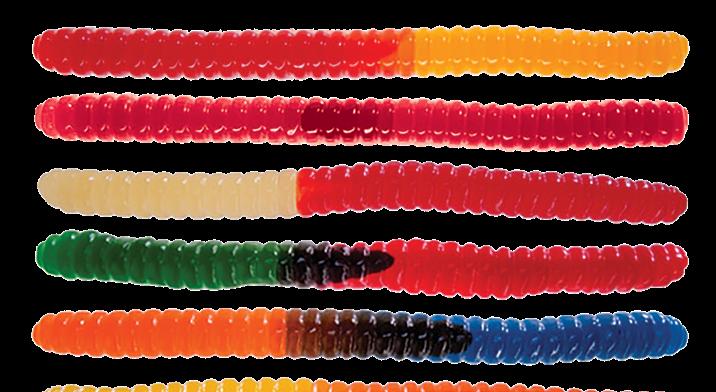
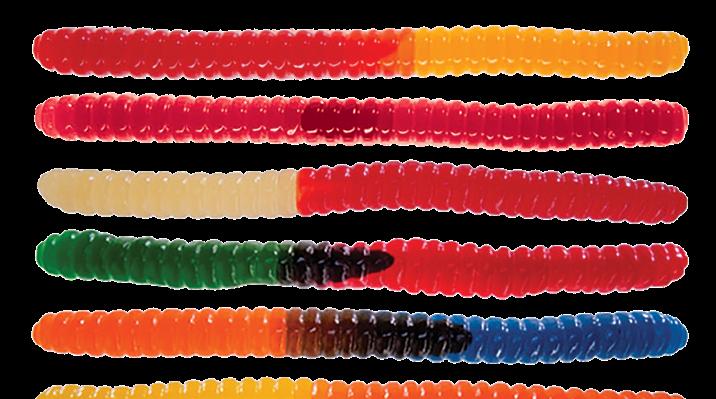


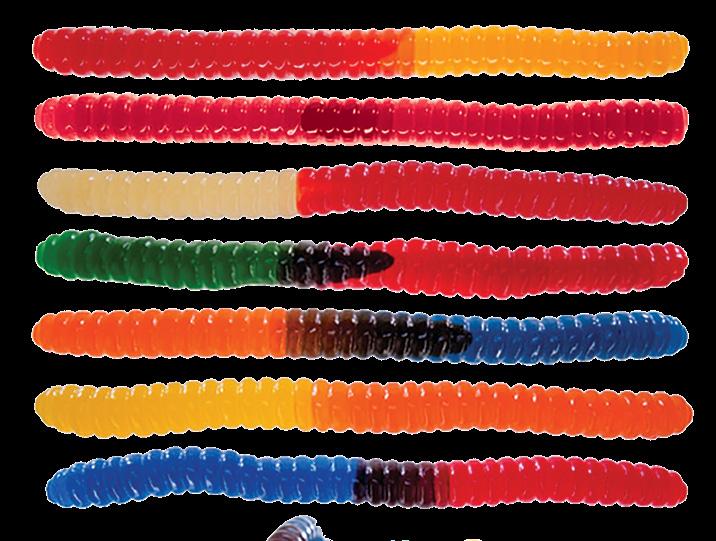


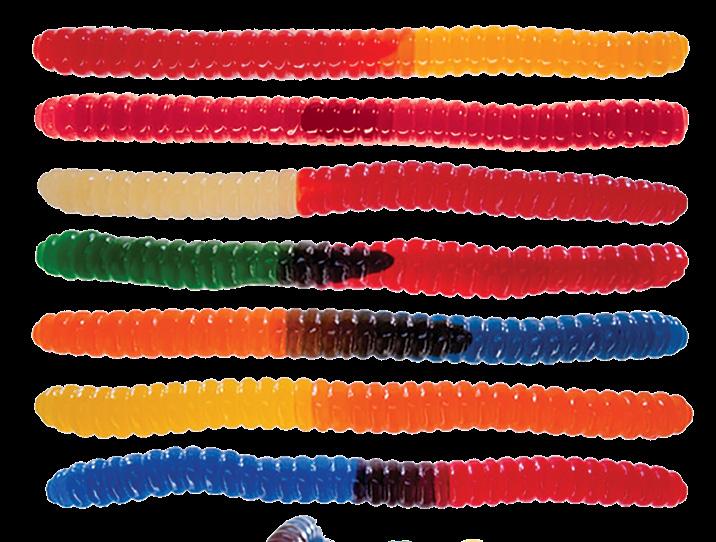
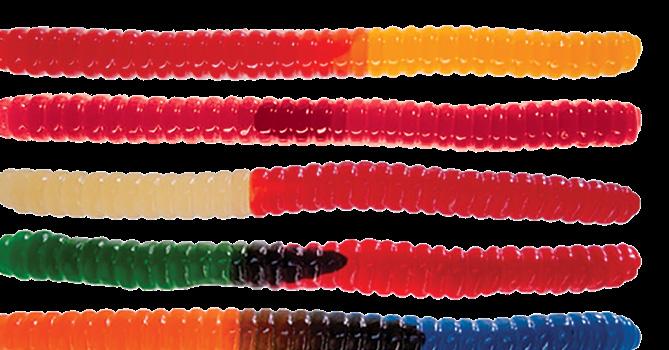
This intestinal worm caused hiccups in intensive young cattle systems in the late 1990s and early 2000s. A substantial build-up of Cooperia that had become resistant to the ‘mectins’ saw calves on some farms sick and dying with vast numbers of what was previously thought to be an inconsequential parasite. The national drench resistance survey published in 2006 confirmed that 92% of beef farms surveyed had Cooperia that were resistant to the mectin family of drenches. In that same work, 75% of farms had white drench resistant Cooperia.
Most farmers of young cattle know that they must use a drench containing Levamisole to adequately control their Cooperia.

But if most Cooperia are resistant to the other two families, what happens when and if Levamisole fails against this parasite?
We are starting to see examples of this now.
Frequently there are underlying stress factors on calf blocks where resistant parasites are causing disease -- overstocking, lack of adult/ alternative stock classes to ‘vacuum’ pastures and insufficient time on meal/ concentrate after weaning are common denominators.
ANIMAL HEALTH
Is it back to the future for intensive beef systems?
Ginny Dodunski looks at past worm treatments and what’s happening now when a product fails
However, worse than straight Levamisole resistance are the cases of triple drench resistance starting to pop up in calves. We now have recorded reports of both Cooperia and Ostertagia that can survive correctly applied doses of oral triple drench.
Mectin resistant Ostertagia were confirmed on NZ farms by AgResearch back in 2016, but human nature has dictated that little notice has been paid to this until we actually started to see sick animals.
The ‘combinations will be our salvation’ mentality has prevailed across the industry. Through the advertising of drench products to the unwillingness of those selling them to make themselves unpopular with customers. They don’t want to suggest there might be risks in a farm system where a lot of drench is required to keep calves healthy.
So is it going to be a case of ‘back to the future’ for parasite control in cattle as we start to see more cases of worms surviving drench treatments in intensively managed calves?
Many of us in the industry today are too young to remember the cases of Ostertagia of old, and those who remember calves sick with Cooperia in the days of single-active ‘mectin
injections and pour-ons may get to witness this again, but this time with more dangerous multi-drug-resistant strains.
What to do?
Buying calves: Carefully consider how you will quarantine artificially reared calves you’ve bought. A triple combination drench may no longer be a safe quarantine treatment. Ask the vendor or agent for evidence that a triple or other ‘standard’ combination is still achieving a high (near 100%) reduction in faecal egg count from treated calves. A quarantine drench may not be necessary in every case if the calves are healthy and show low faecal egg counts. Conversations matter!
If you are unable to get any history on the calves you are planning to buy then you will need to be more careful.
Zolvix Plus (monepantel plus abamectin) is registered for use in cattle, and an increasing number of farmers buying in young dairy beef animals are using this as their quarantine treatment. Seek advice from your animal health adviser before doing this – a complicating factor for calves under 120kg liveweight is that many products containing abamectin are not licensed
for use in these smaller animals. Products may be used off-label, but care must be taken to dose animals accurately to their liveweight. Overdosing with abamectin has been a common cause of calf deaths for many years.
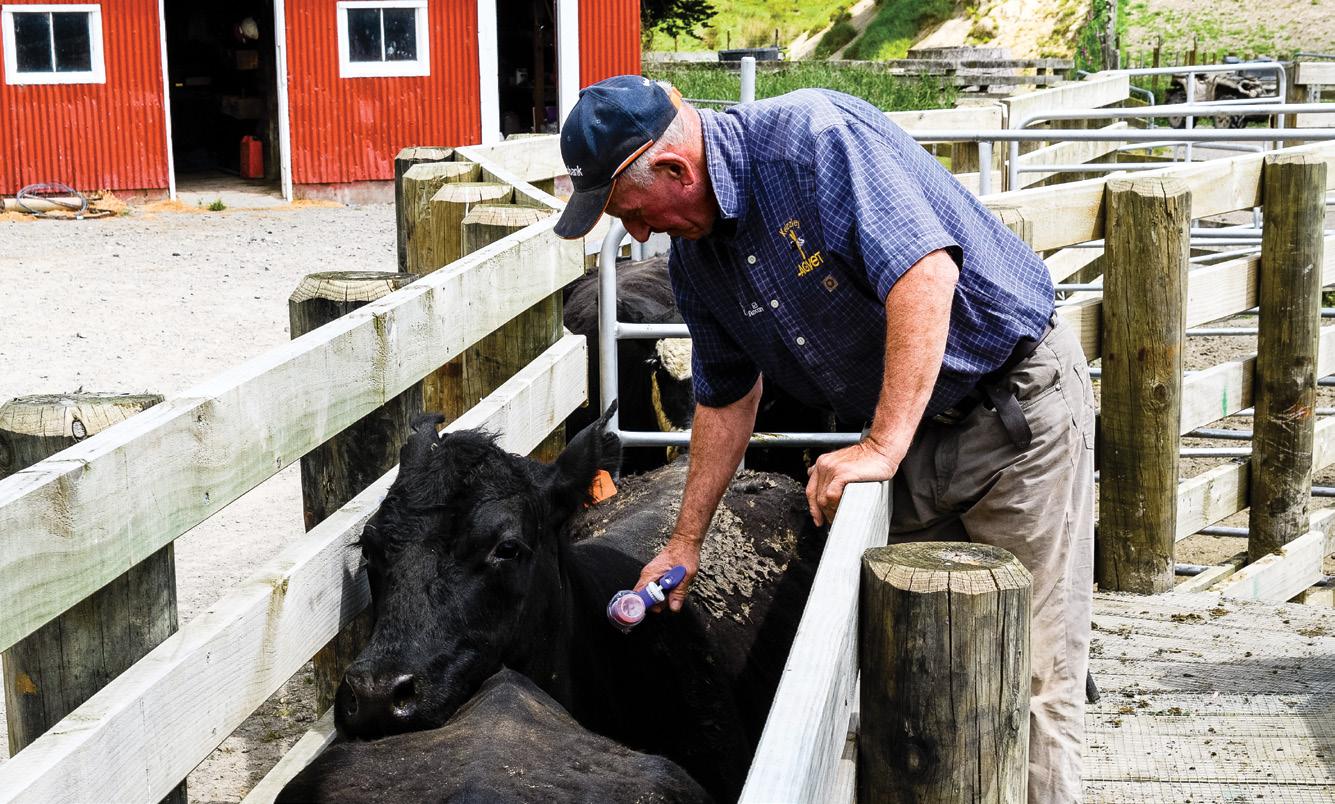
Treated calves also require a stand down period, with feed and water available, to allow the eggs from resistant worms to pass out on to a yard or other bare area where they can’t develop and infect other stock.
Buying traditional beef breed weaner calves is far less risky as there is typically minimal drench use in these systems.
At home: There are two important pieces of work to do for your own farm:
Assess your system – how risky is it both from a worm challenge perspective and the likelihood of breeding-up drench resistant worms? High numbers of R1 cattle on permanent pasture without other stock classes is typically a red flag. What’s ideal for a ‘worm-safe’ calf enterprise are systems that provide calves with highly nutritious and low worm challenge feed. Where strategic supplement use keeps them growing through dry or cold periods, other stock classes in the mix provide refugia (e.g. the next age class up) and vacuum cleaning (adult cattle and other species).
Assess the performance of your drenches. If you’re using a drench that is only 70-80% effective, you won’t necessarily have sick or poor-doing calves, but you will be forgoing growth performance and creating a build-up of resistant parasites on your pastures. These at some point will manifest as uncontrolled parasitism if the situation is left unchecked. A simple ‘drench check’: 10-15 fresh faecal samples collected 10-14 days after drenching young calves, and checked for the presence of worm eggs, is a great start. If you find you have worms surviving your double or triple combination drenches, now is the time to seek advice. Don’t wait for sick calves to spur you into action!
Ginny Dodunski
Country-Wide Beef | MAY 2023 83
is a veterinarian and Wormwise programme manager.
“If you find you have worms surviving your double or triple combination drenches, now is the time to seek advice.”
Dangerous eats in late pregnancy
Most farmers are aware of the risk of stock aborting from eating macrocarpa in late pregnancy. I often get asked at what stage pregnant cattle can be safely grazed on macrocarpa and what other trees have the same aborting risk.
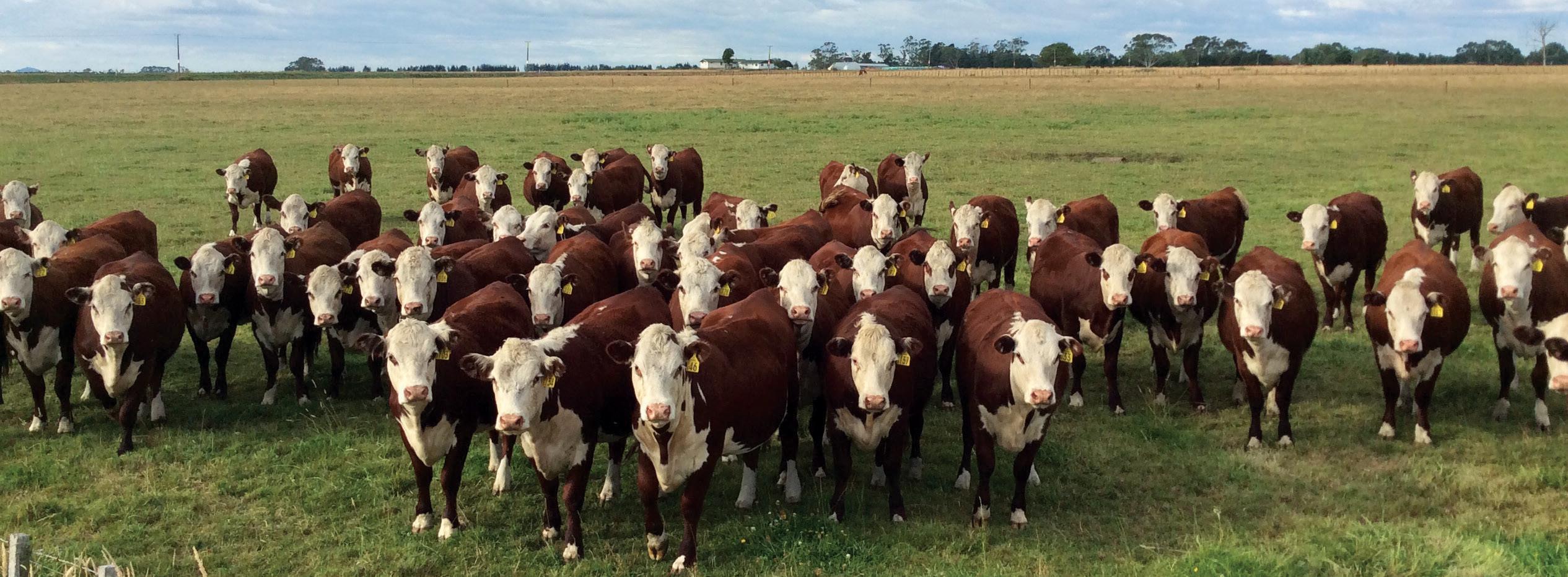
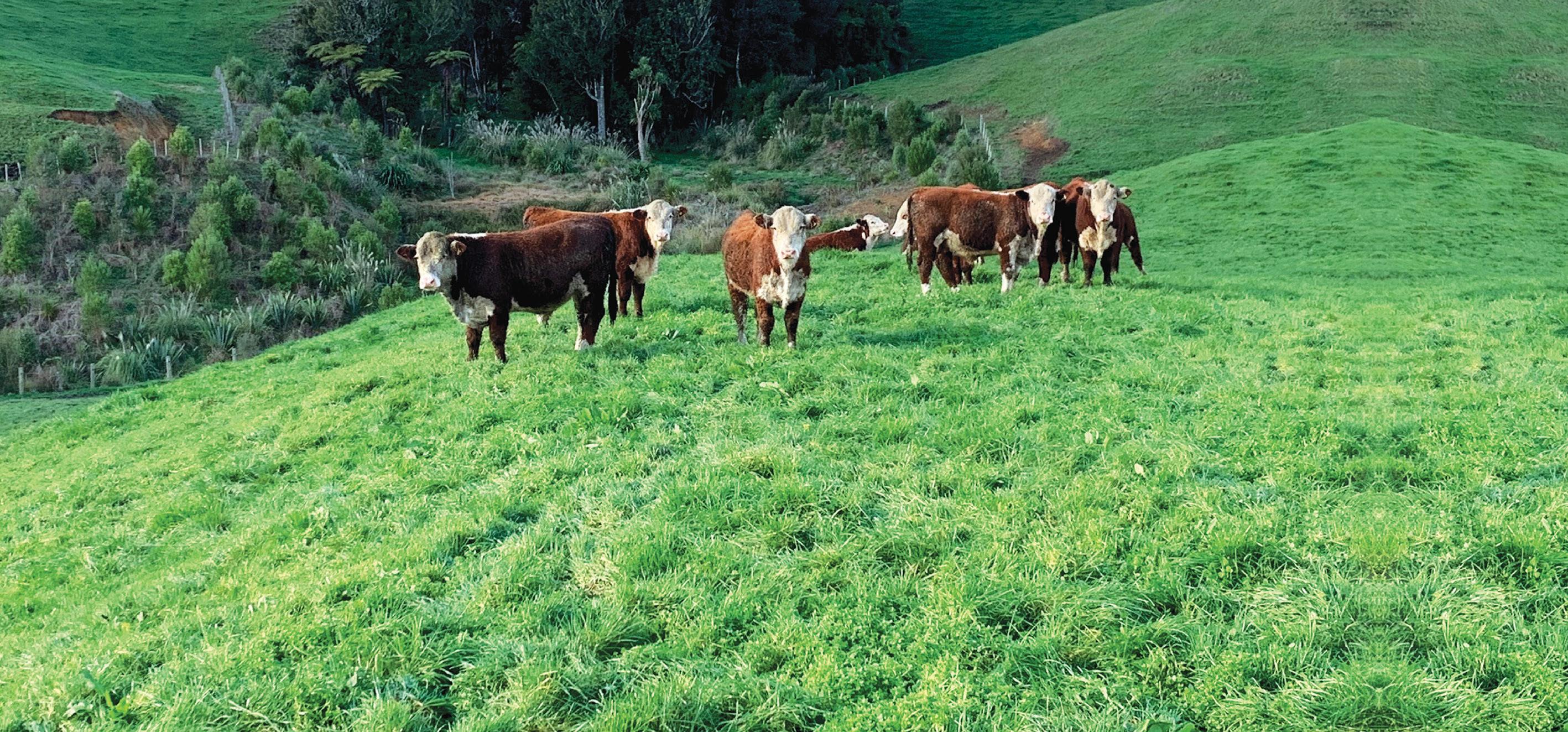
The toxin responsible for the abortions is called Isocupressic acid. Macrocarpa (Cupressus macrocarpa) and Leyland cypress (Cupressocyparis leylandii) are the most common tree species implicated, as their needles seem to contain the highest concentration of isocupressic acid. Other pine species do contain some of this toxin.
What about pine plantations? Some sources list radiata pine as a cause of abortion; others say that it has low levels of isocupressic acid so is relatively safe. How dangerous they are to graze will probably depend on how much the animal eats.

For all these trees – pine species,
macrocarpa and Leyland cypress – the needles, bark and branch tips all contain the toxin, and weathered or wilted bits are more toxic.
The toxin causes damage by reducing blood flow to the uterus. Abortions happen in late gestation because the foetus gets bigger and needs more blood flow. How late in pregnancy can you graze cattle near pines? Again, it depends on how much of the toxin they eat so best not to take any chances.
You might also have calves born weak and premature. Along with the abortion, cows have a period of looking depressed and having a decreased appetite.
Abortion can happen up to two weeks after cows have eaten the needles or bark. You often get retained membranes after a macrocarpa abortion and in my experience it’s the rule rather than the exception. Even though calves are small and premature you often have to assist with the calving. Because the damage
84 Country-Wide Beef | MAY 2023 ANIMAL HEALTH
As spring and calving approaches, vet Sara Sutherland says farmers need to be mindful of their animals’ diets.
• Bred for performance under commercial conditions • 450+ females in herd • • Easy calving • Impressive growth • Super conformation • • BREEDPLAN recorded and carcass scanned • BREEDING HEREFORDS FOR OVER 50 YEARS! ENQUIRIES WELCOME • DAVID & SUE HENDERSON • David’s Mobile: 021 166 1389 DANIEL HENDERSON • Daniel’s Mobile: 027 753 6669 429 Rukuhia Road, RD2, Ohaupo • Email: craigmore.hereford@gmail.com • www.craigmoreherefords.co.nz All bulls sold are genomics tested for sire verification and the polled gene ANNUAL YEARLING BULL SALE Monday 11th September 2023 BREEDING HEREFORDS FOR OVER 50 YEARS!
is on the uterus side, it can be hard to diagnose – there aren’t a lot of signs in the aborted foetus. If you see abortions though, it is always worth getting them investigated. That way you can rule out other common causes of abortion.
There is no treatment. In an outbreak you just have to wait it out.

It doesn't seem like sheep are affected in the same way.
If you are seeing abortions, talk to your vet – it's better to do some investigation and find out whether there is something you can do to avoid losses.
It was only early autumn when we had a couple of nights cold enough for a fire so it feels like winter isn't far away. I’m not a fan of winter – the only good thing about it is that it makes you appreciate spring! One of the best things about spring is calving. No thrill quite matches pulling out a live calf. As vets we don’t get many live calves though – usually if it’s easy the farmer will have already got it out. So I humbly offer my words of advice for farmers at calving season.
Don't wait too long. You're never wrong to gently put on a long glove and put a hand up and check. If things aren't going well they will be easier to fix now than tomorrow morning.
A uterine prolapse a vet gets to within a couple of hours will always go back in;
one that you don’t get to until the next day is rarely a success.
Remember the motto of the Australian Cattle Veterinarians group: always use more lube (and I assume they are talking about calving cows!).

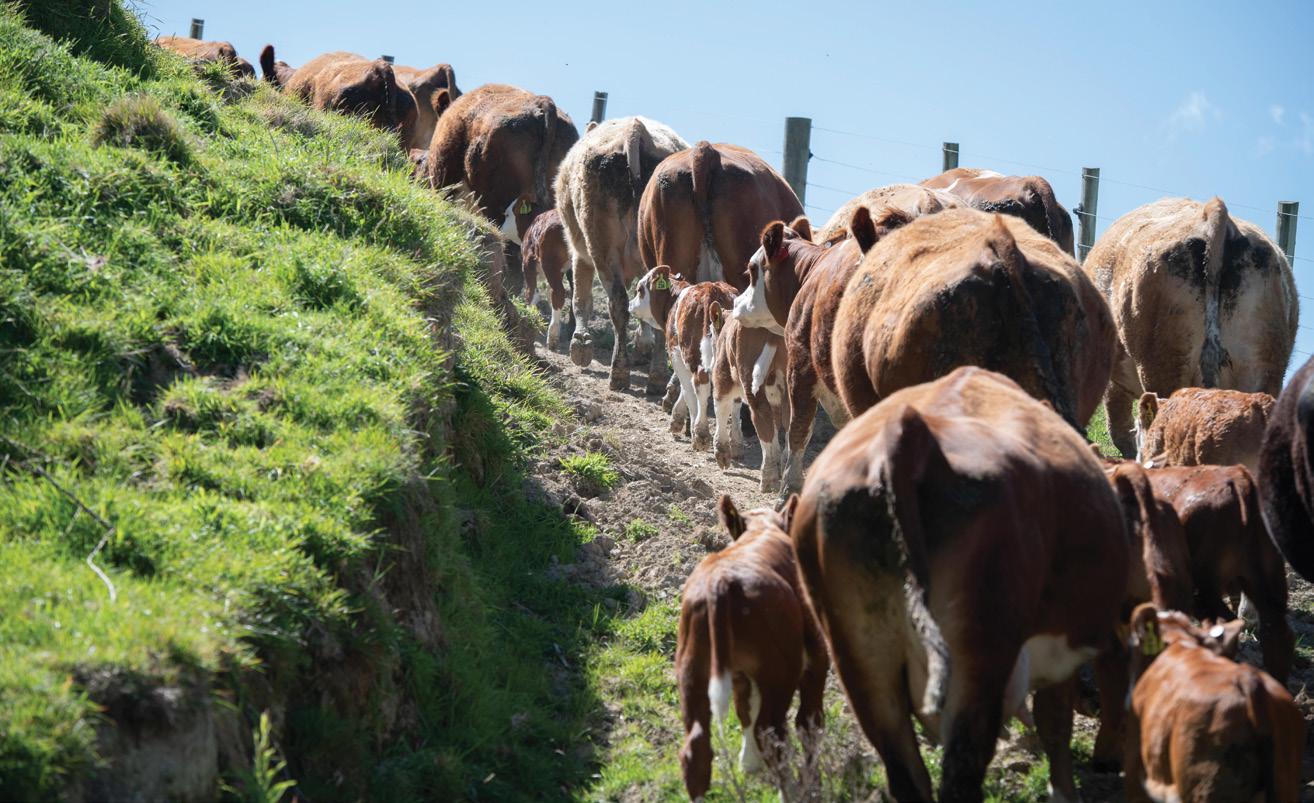
If you're trying something for 20 minutes and it's not working, try something else.
Don't underestimate how fast an angry cow can run (or, don't overestimate how fast you can run away!)
If pulling hard doesn't work, pulling harder probably won't either. It's now illegal to use a tractor to pull a calf out –a practice best left in the dark ages.
For those that need a bit of antibiotic – a cow with a dead calf or a difficult
calving for example – penicillin dose rates and withholding periods have recently changed. Talk to your vet to make sure you're using the latest label. Since having a baby of my own I have a lot more sympathy for cows. Without getting anthropomorphic, I am less likely to mock them for complaining loudly and vocally. Also, I appreciate the relief of an epidural after hours of unproductive straining. Don't be embarrassed to call the vet out to help. It's not a sign of weakness and doesn't mean you failed. We have drugs.
Sara Sutherland is a vet with Vet Services Wairarapa.

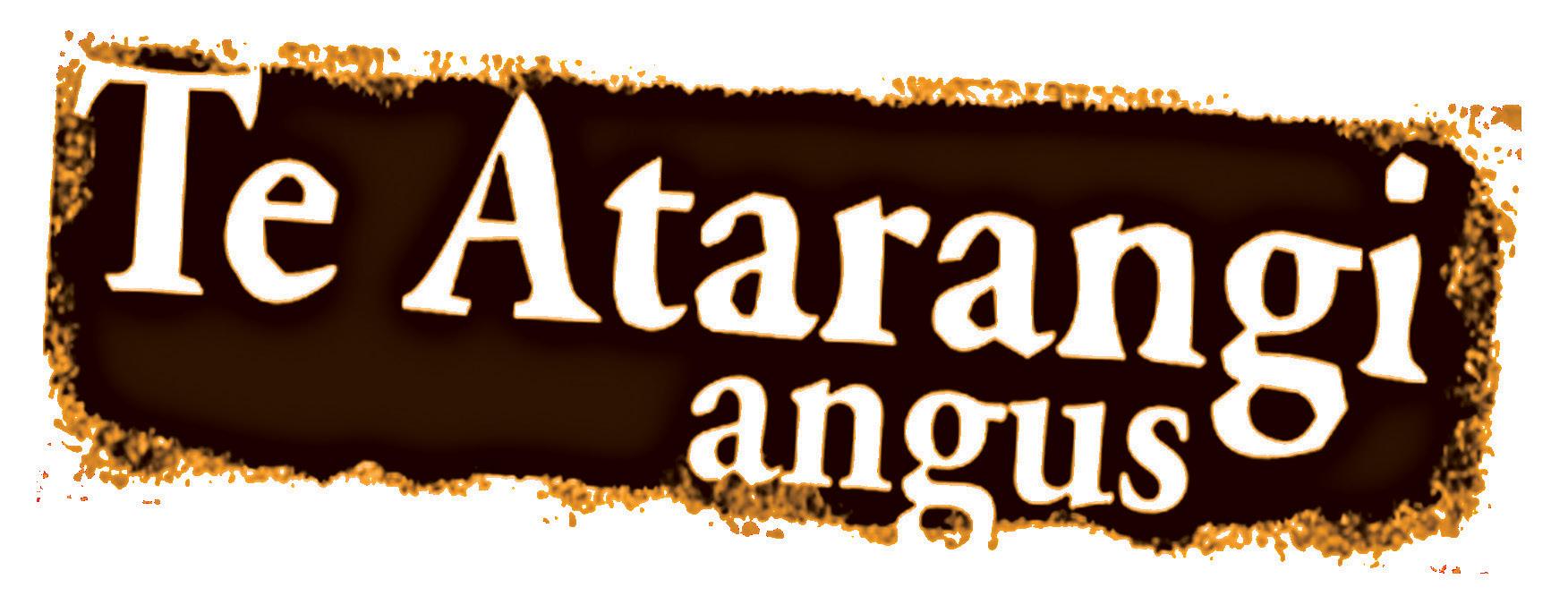
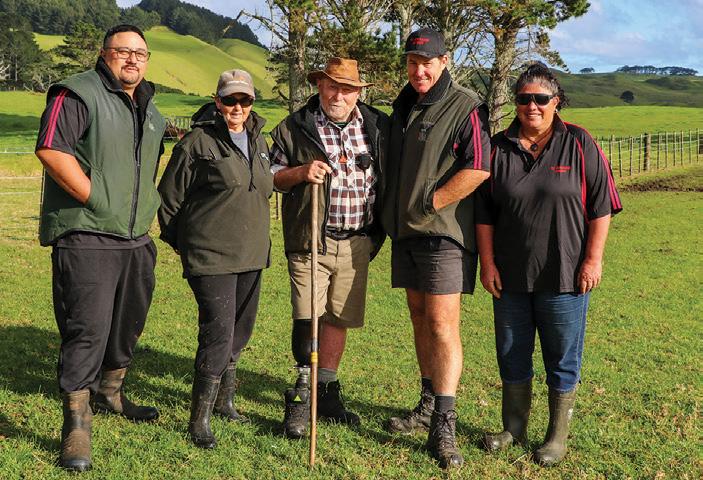
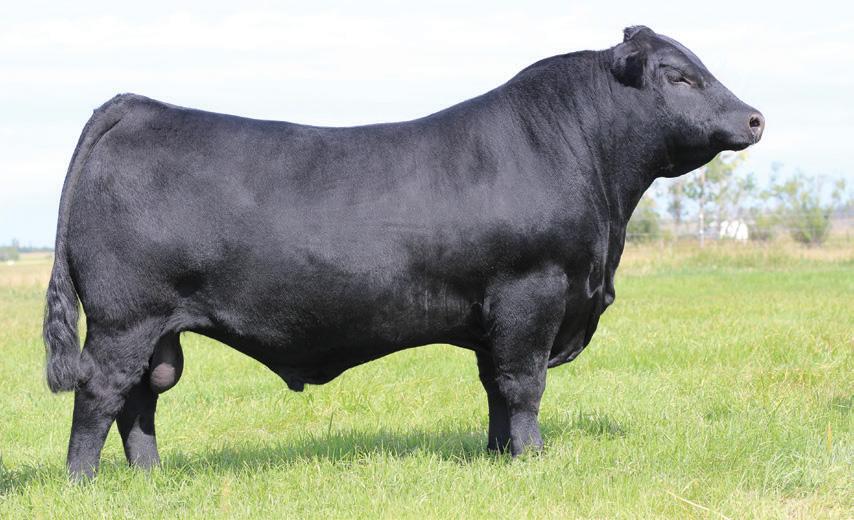

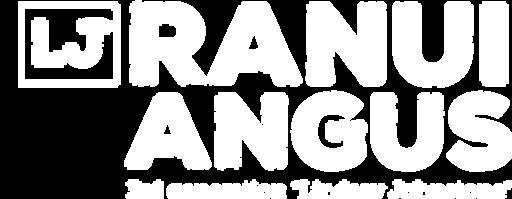
86 Country-Wide Beef | MAY 2023 Specialising in ease of calving and heifer mating All our best bulls offered at our annual yearling sale AngusGS 72K SNP tested Our complete program (all 300 cows) is focused on ease of calving and heifer mating FERTILITY Only 43 days mating - cows Only 28 days mating - heifers 120 Yearling Angus bulls at our Annual On Farm Sale and Hybrid bidr Auction 5th Sept 2023, 12.30pm Chris & Karren Biddles, RD1, Te Kopuru, Northland P: 09 439 1589 m: 021 795 929 e: chris@teatarangi.co.nz w: teatarangi.co.nz THE TE ATARANGI ADVANTAGE Specialising in Ease of Calving and Heifer mating ATAHUA HAMILTON FARMS ALCATRAZ 60F 2yr Bull Sale Monday 12th June, 2023 11am To view bulls prior to sale please email or phone to secure a date and time that best suits you! ALAN AND MICHELE DALZIELL 283 McBeth Road, RD7, Feilding 4777 Ph: 06 328 9784 Mb: 027 629 8954 Email: atahua.angus@farmside.co.nz VISITORS AND ENQUIRIES WELCOME OUR CATALOGUE WILL BE AVAILABLE AS AN EBOOK 2023 Sale Bulls by: GAR Ashland Hamilton Farms Alcatraz 60F EXAR Stockfund 9097B GAR Hometown Atahua 1 - 20 sold to McFadzean Cattle Company & Te Whanga, 2022 www.ranuiangus.co.nz 16 MAY Open Day 8 JUNE 28 SEPT 2 Year Bull SaleYearling Bull & Heifer Sale SAVE THE DATES!
The NZ beef oyster season
BY BOB THOMPSON

Our beef grading and payment systems and associated marketing need positive change sooner rather than later to make way for new ways to better reward farmers for quality beef. There’s not much a farmer can do to fend off rising costs but those entrusted with marketing their beef at least have the opportunity to increase rewards for those farmers who want to step-up and produce beef that’s better than average.
Thankfully in NZ we can reference a rich bank of research history, albeit mostly generated more than 30 years ago. The evidence from our beef research is clear-cut in that young, well-grown pasture-fed beef is best by far. It’s tender, lean and packed full of Omega 3 and Omega 6 in near-perfect balance – it’s naturally good for you.
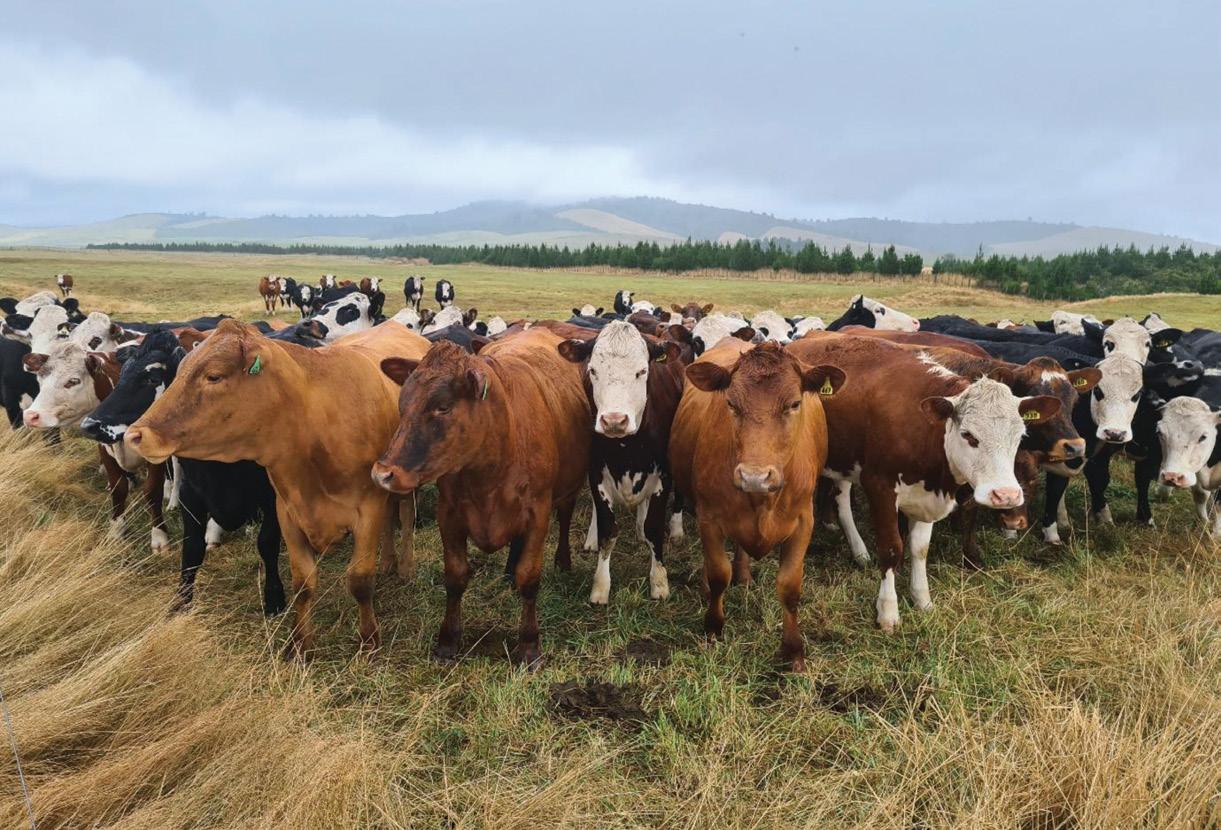
But young, naturally raised spring-born animals from a one-winter all-pasture system are not heavy enough to reach carcaseweights (CW) with price premiums and therefore are not a profitable option. On the contrary, the best money is with a two-winter finishing policy where cattle are marketed in the 270–330kg CW range. This is despite the fact that the most tender beef comes packed into a 160–220kg CW from a one-winter system with a fashionably smaller cut size.
Just like Bluff oysters, this beef is ready in season.
Interestingly the NZ Bluff oyster season extends from March until August because that’s when they’re ready to be harvested. A NZ beef oyster season would perfectly match the Bluff oyster season by completing the year with supply from September to February – this is when these young bovines are at their best, as
they are harvested from our shapely spring and early summer pasture bump.
Unfortunately, our NZ meat processors don’t believe that these smaller beef carcases have a future. They say the market doesn’t want them and people like us don’t understand how meat processing works. They say that with small carcases a meat processor cannot get enough beef into boxes in a day, and this negatively impacts plant efficiency. And yet our meat processors can process venison at 80kg CW and lambs at 20kg CW and make money. Sure, venison and lamb are bought and retailed for a bit more than beef and both have a higher percentage of higher paying cuts, but arguably there is the same potential for our ‘beef oysters’.
Despite lighter weight cattle from onewinter systems not being wanted by our beef processors, the facts are that a one-winter animal occupies half the land area compared to its older brothers and sisters on a two-winter finishing regime. The one-winter cattle are also smaller and therefore kinder on our soils, are more feed conversion efficient and produce much less methane over their lifetime.
Certainly, the payment and grading system heavily penalises cattle at lighter weights and instead continues to incrementally reward cattle as they get older and bigger despite the fact their beef eating quality declines. That’s what you get when most of our beef is bought and sold through a price averaging system with the associated lowest common denominator outcomes.
The messages sent to our farmers through our beef grading and payment systems are broken and have been for a very long time. Yes, there are some beef quality reward programmes offered by some of our meat companies, but the premiums are low relative to the average strike rates.
Firstly, the average strike rates tell us that less than half of our beef is good enough to be paid a premium. Secondly, it tells us that our meat companies do not have the ability to pass on a satisfactory market reward, even when the beef is high quality. Thirdly, when we learn that these quality reward programmes are often over subscribed, it tells us that farmers are responsive and able to supply cattle for even a small reward. The fact that a meat company can be over subscribed also tells us that they have limited markets for quality beef, or that they don’t know how or where to market this superior product.
Country-Wide Beef | MAY 2023 87 OPINION
Bob Thompson is a beef and sheep specialist with AgFirst Waikato.
BULL SALE 32 Bulls
THURSDAY JUNE 1ST 2023 AT 4.30PM
ANGUS
1908

Alan & Catherine Donaldson p: (07) 896 6714 e: agcsdonaldson@gmail.com www.pukenuiangus.co.nz
FIND US ON FACEBOOK
3179 COAST ROAD, AKITIO, DANNEVIRKE
Hugh Ramsden 06 374 3552 • 027 228 3940
Rodney Eastwood 06 374 3582 • 027 376 2726 www. moanaroaangus .co.nz
MODERATE FRAMED, EASY FLESHING CATTLE, RENOWNED FOR FERTILITY, TEMPERAMENT, CONSTITUTION AND LASTING ABILITY.
Honest, functional and efficient cattle with performance bred for New Zealand Hill country.

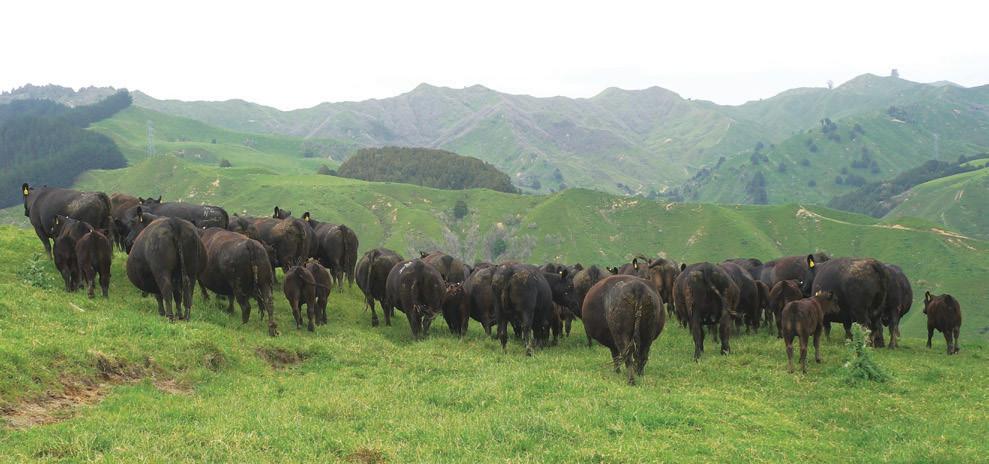
www.anguswaigroup.co.nz
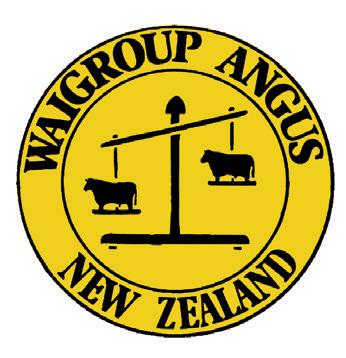
Pinebank Sales by Private Treaty: June and October
Glanworth On-Farm Auctions: 2-year Bulls June 29th at 2:30pm | Yearling Bulls October 5th at 12 noon
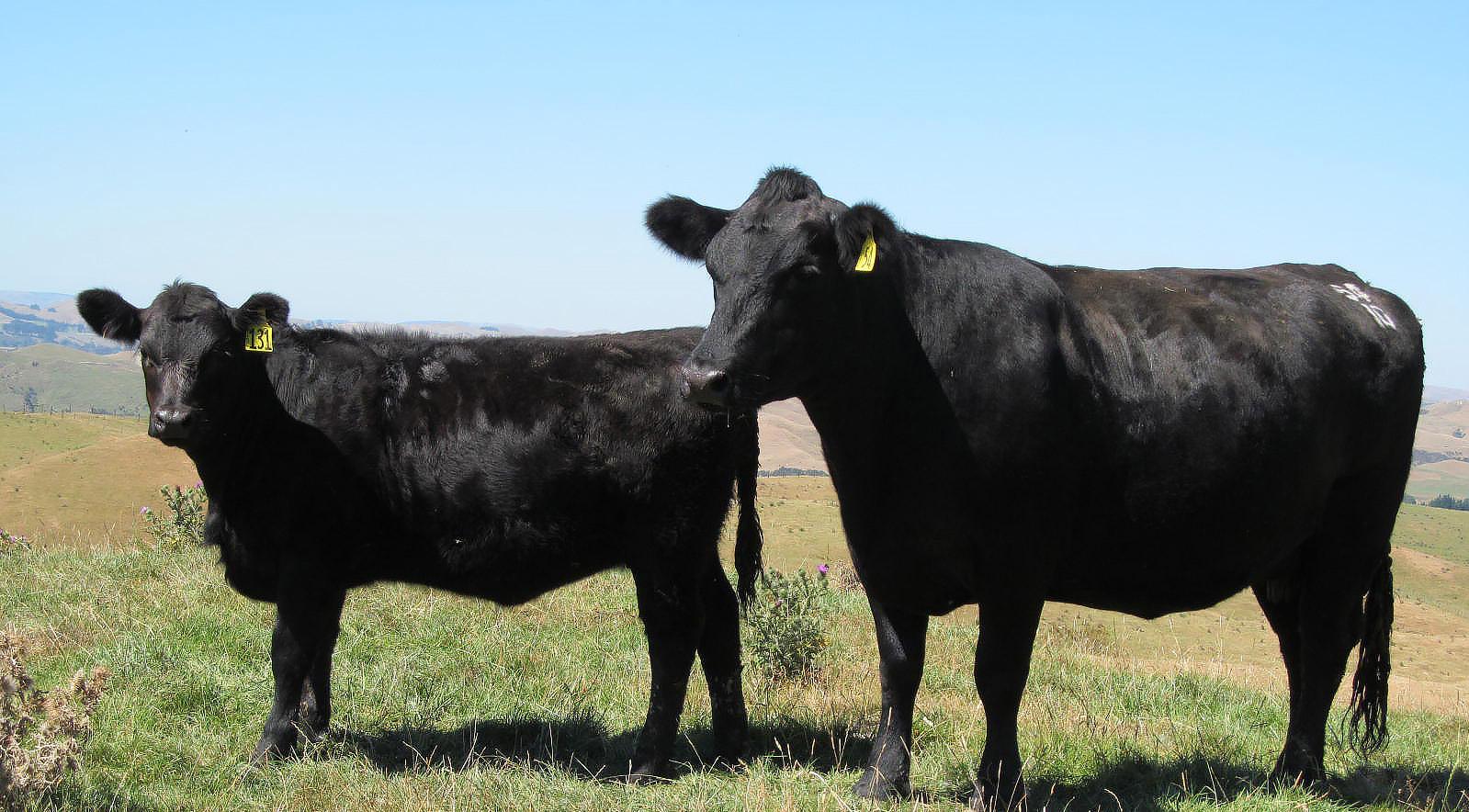
VISITORS & ENQUIRIES WELCOME
PINEBANK Established 1919 — Willie Falloon PH: (06) 372 7041 E: falloon@xtra.co.nz
GLANWORTH Established 1952 — Shaun Fouhy PH: (06) 376 8869 E: glanworthfarm@gmail.com
88 Country-Wide Beef | MAY 2023
ANGUS
BULL SALE VENUE: 303 River Road, SH 43, Taumarunui MOANAROA
115 YEARS of ANGUS BREEDING • 1908 - 2023
Our cowherd is stacked with dams sired by bulls that lead the Angus breed for fertility, performance and longevity. We balance phenotype, EBV’s and carcass traits without losing the strength of the Angus cow. Don’t overlook what really matters, and the reason the Angus cow excels above all other breeds.
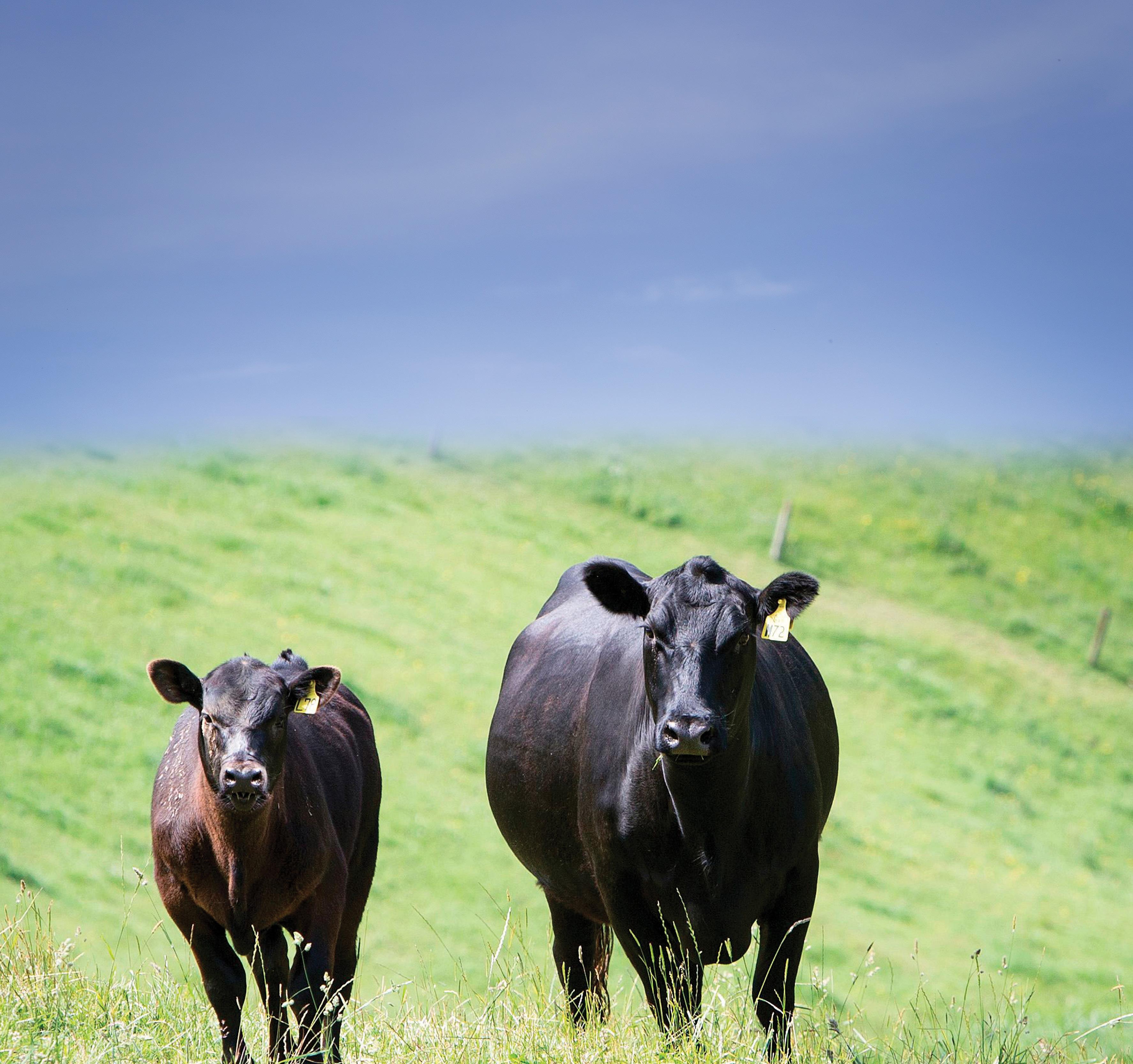
Stokman Angus - Breeding cattle that are profitable in every segment of the industry -from conception to carcass.
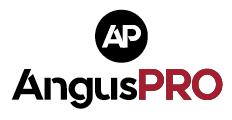

Country-Wide Beef | MAY 2023 89 2023 Bull Sales R2 and Autumn Born Angus bulls sell private treaty June 2023 - contact us for details Wed Sept 20th – 100 Top Yearling Bulls and 40 Heifers sell – 1 pm At the farm - 1708 Te Kopia Road, Waikite Valley, Rotorua Mark, Sherrie and Jake Stokman | RD1 Rotorua 3077 email: mtkiwi@farmside.co.nz Mark: 027 640 4028 Jake: 027 787 4008 Stokman Angus
HD50K tested l Fertility
semen
C arcass Scanned
Parent
REALLY MATTERS…The Angus Cow!
All sale bullsl
and
tested l
l
verified DON’T OVERLOOK WHAT
Check us out on Stokmanangus.com or facebook: Stokman Angus Farm We are breed leaders in CalvingEase,GestationLength, combinedwithgrowth and carcass. -Stokman Solution S329, whose semen rights sold in 2022 to Mandayen Angus, Australia for $55,000 in 2022. Contact us for details. TACE CED GEST Birth Wt 200 Wt 400 Wt 600 Wt Mat Cow DTC ScrotalCarcassEMAIMF EBV +11.7-11.3 +0.5 +56+106+130 +73 -6.6 +3.0 +78 +10.9 +3.2 !FLASH! Semen now available on NZ Yearling Record Setter, Stokman Solution S329
Difficult births, helpful solutions
Calving and dystocia go hand in hand. Vet Rachael Fouhy looks at the main causes of dystocia and has some tips and tricks to deal with it.
Dystocia or calving troubles is a common issue we all potentially face as farmers at calving time and as vets it contributes to a significant proportion of our workload in spring.
Dystocia can occur when there is foetal-maternal disproportion: for example, the calf is too big to fit through the cow/heifer’s pelvis. The most common causes of this are under-grown heifers and the wrong bull. If the wrong bull is chosen, then typically the shoulders and/or the pelvis are too big to fit through the cow’s pelvis and everything gets stuck.
The wrong bull refers to one that either has a high birthweight and has been used over heifers, or one that is the wrong shape for young animals, e.g. large thick shoulders.

Regarding birthweight, it is very important that the EBVs are used when assessing potential birthweight, not the numbers. The bull’s birthweight doesn’t always accurately reflect his genetic potential, e.g. if the bull was 32kg at birth that doesn’t guarantee that his calves will be 32kg, potentially he could leave 42kg calves. This is why EBVs need to be used.
It is also important to look at a
stud’s breeding policy. If they are not mating yearling heifers then it is probably not the place to buy bulls from for heifer mating. Hybrid vigour means oversized calves are more likely when you use a different breed than your maternal breed.
I often hear people make comments about feeding heifers and the impacts of this on the birthweight of the calf. As a general rule, the birthweight of
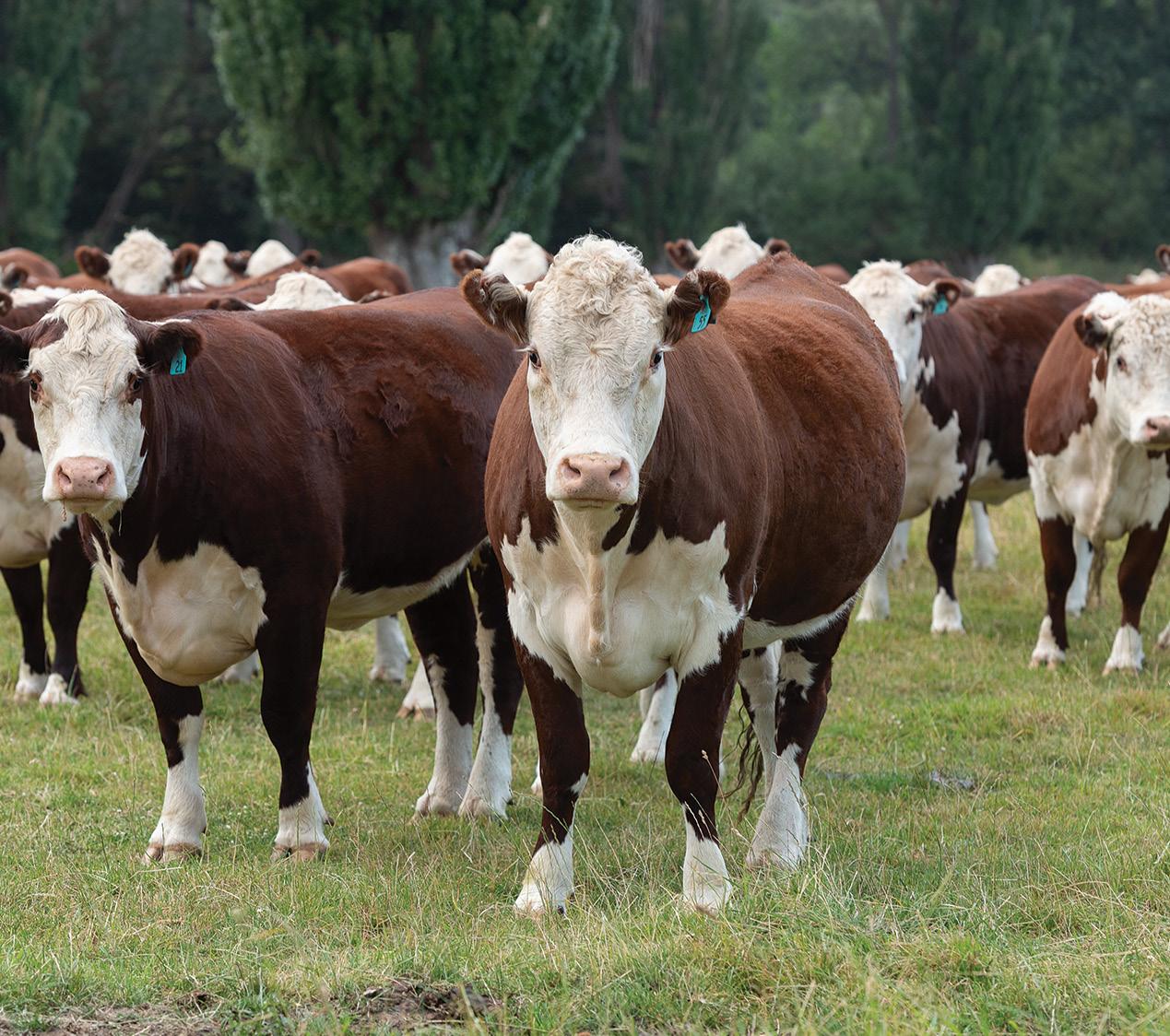
90 Country-Wide Beef | MAY 2023 GRANT & SUE CRAWSHAW - 027 686 7753KENHARDTANGUS@XTRA.CO.NZ C R I C K L E W O O D P A N D E M I C P 0 5 6 K E N H A R D T J A C K P O T 3 1 5 B L U E D U C K 1 8 2 4 U - 2 C O A L I T I O N 2 0 6 C K E N H A R D T P 1 0 5 7 M A N G A T A R A N 4 Wednesday 28th June 2023 10:30am, State Highway 2 Nuhaka A n n u a l o n - f a r m b u l l s a l e 2 0 2 3 S I R E S
ANIMAL
HEALTH
Above: R3 incalf Hereford heifers.
the calf is already genetically programmed and feeding will have very little impact on this, bar extreme underfeeding which will affect the heifer, or extreme over feeding that may result in increased fat in the pelvic canal. Please do not underfeed heifers in late pregnancy thinking this will help with calf birthweight. It will not, it will just result in low energy heifers who take longer to recover from calving.
as far into the uterus as possible. Does everything feel normal? Is everything in the correct place? Will it fit out? Is the cow/heifer dilated enough? Is there only one calf? Is it coming head first or tail first?
Calving troubles can happen when things are in the wrong place. This includes legs back, heads back, or some type of calf deformity. For some reason the cow might also have some issues. One issue might be not having a fully dilated cervix – normally you can’t feel the cervix. If you feel a band over the calf’s head or your arm needs to go through a hole/ tunnel to get to the calf, then she is not dilated enough or she has a twisted uterus. The best advice if you feel this type of unusual feeling is to wait an hour and reassess. If nothing has changed, call the vet.
Most importantly if you have spent 15 minutes trying and have made no progress you need a change of plan. Now is the best time to call the vet. If you try for an hour before you call for help, chances are you have made no more progress than you did in the first 15 minutes, and all you have achieved is a tired animal which will make it harder for the vet, and you are now grumpy and frustrated.
When should we choose to intervene?
If you see one leg and a head or a head only, it’s likely the animal will need some help asap. Alternatively, if the heifer has made no progress in an hour then it’s a good idea to check. As much as we all want to get the calf out as quickly as possible, it is really important that time is taken to make an assessment before pulling commences. Make sure you reach
Despite all our preparations, often nature can throw curve balls at us and we end up with a season where we have issues – it happens to us all. If you are having calving issues in your heifers, we do have the ability to use drugs to help with the earlier delivery of some calves in situations where a heifer’s welfare is being affected.
TIPS AND TRICKS FOR ASSESSING FOETAL SIZE
Both legs and the head need to fit into the pelvic canal
• This means both feet out and the nose almost at the vagina.
• If you can’t do this, the calf is too big.
You should be able to extend both legs fully
You need to be able to get both front legs straight: e.g first joint out of the vagina. If you can only get one at a time then the calf is probably too big.
Measure the feet diameter
Measure the size of one fetlock and then how many fetlock widths fit between the pin bones. If you can fit three, then you are good to go. If you can only fit two, then it could be very tight or not happening.
TIPS AND TRICKS FOR CALVING COWS AND HEIFERS
• Use lots of lube: this is cheap and makes life so much easier – your vet should happily sell this to you
• Attach ropes to both the head and the legs
• Ensure smooth and slow pulling – jerky stop/go pulling is one reason that farmers have more difficulty than vets in getting out bigger calves
• Once the shoulders are through, pull the calf in a downwards direction as the hips pass though
• If the calf is coming backwards the same applies, but make sure the tail is pulled down as if it curls up it can tear the cow.

Country-Wide Beef | MAY 2023 91
Rachael Fouhy is senior veterinarian and director at Tararua Vet Services, Pahiatua.
i
Hybrid vigour means oversized calves are more likely when you use a different breed than your maternal breed.
Selecting genes to reduce methane
Massey University’s Dorian Garrick says genetics could play a part in reducing methane emissions in livestock, but it’s a complex and pricey process.
As global concerns over climate change intensify, the need to address methane emissions from livestock, particularly cattle, has become a pressing issue. A promising avenue for mitigation lies in reducing emissions per unit product. By focusing on genetic improvements and refining management practices, livestock agriculture has the potential to be seen as a more environmentally sustainable sector.
But who should pay for the costs of developing and implementing systems to reduce methane emissions by selection? And what are the risks of selecting for reduced emissions? Selection sometimes has unintended consequences; do we know what
these might be? And what are the threats that arise from doing nothing?
Methane production in grazing ruminants is a natural process that occurs during digestion. Ruminants, such as cattle, sheep and goats, have a specialised stomach called the rumen, which is home to a diverse community of microorganisms that help break down fibrous plant material including that from ryegrass and white clover pasture that ruminants consume. During rumination the microorganisms produce methane as a byproduct of their metabolism. Some of the methane enters the bloodstream and is breathed out from the lungs, but most is expelled from the animal’s body through
belching, which is why ruminants are a significant source of methane emissions.
The amount of methane expelled can be measured. A GreenFeed machine is a commercially available device that is used to measure methane emissions from individual cattle. It works by using an infrared gas analyser to measure the concentration of methane in the breath and belches of the animal. The machine is essentially a feeding station that is equipped with a gas sampling system. When the animal approaches the feeding station to eat, if its electronic ID allows it access, it breathes into a specialised chamber that captures a sample of its breath and belches. The sample is then analysed by the gas analyser, which measures the concentration of methane and other gases, such as carbon dioxide and oxygen.
Ranking implications
The amount of methane expelled varies from animal to animal, even if they are the same sex, fed the same diet, and are of similar age. The extent of emission varies from family to family, indicating that methane emission represents a heritable trait. Some of that variation is explained by variation in intake, with animals that consume more feed naturally produce more emissions. It makes sense therefore that many trials to measure methane emissions
92 Country-Wide Beef | MAY 2023
GENETICS
also calculate feed intakes over the same period. Trials suggest about three-quarters of the genetic variation in methane emissions is still present after accounting for differences in intakes. So, it would be possible to select animals whose progeny would have lower methane emissions, or alternatively select animals whose offspring would have lower methane emissions for every


unit feed consumed. Research on methane emissions in cattle has been undertaken for some years in Scotland and Ireland, but until recently NZ work has focused on sheep.
Any trait that exhibits genetic variation can be subjected to selection to increase or to decrease the mean of that trait over successive generations. However, ranking animals to facilitate selection has implications on costs and income. First, there is the effort and cost of measuring the trait. Weight traits such as weaning and yearling weights are cheap to record if you have electronic scales. And every bull breeder should have electronic scales if they are serious about genetic improvement. In contrast, measuring methane emissions is
BETTER BEEF BREEDING LEARNING MODULE

NOW ONLINE
In a commercial beef herd, without cow recording, the bull contributes at least 80% of the herd’s genetic improvement. Based on the popular workshops, our Better Beef Breeding module will help you make the right decision to select bulls that meet your farm's needs. Remember, a good bull decision today will still be directly affecting your herd in 10 years’ time. So invest well.

Visit beeflambnz.com/knowledge-hub and search for “better beef breeding” to find the module.

an expensive activity. GreenFeed machines themselves represent a considerable investment and require associated facilities, feed and feeding systems and trained personnel to collect and record emissions. Second, there are opportunity costs. Increasing selection intensity on a trait such as methane emissions will reduce selection intensity on other important traits. Getting more advances in that one trait will come at the expense of advances in other important traits that affect beef production efficiency, such as growth, reproductive performance and product quality.
Dairy bull research
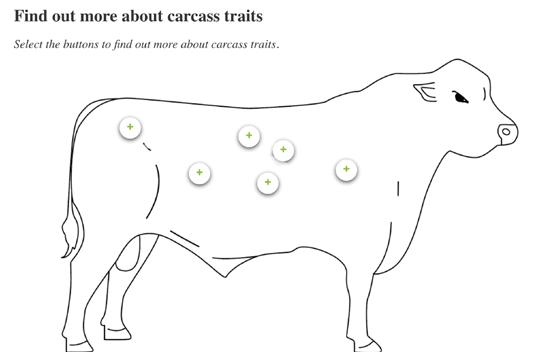
A joint initiative of LIC and CRV with funding from the NZ Agricultural Greenhouse
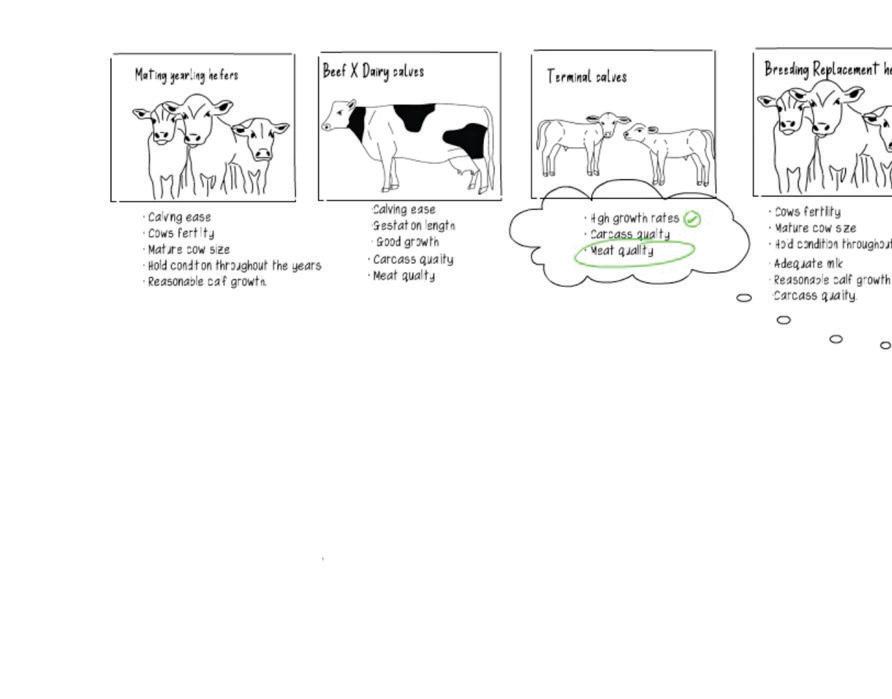
Country-Wide Beef | MAY 2023 93
"Getting more advances in that one trait will come at the expense of advances in other important traits that affect beef production efficiency."
Establish breeding objectives Understand traits Interpret catalogues
Gas Research Centre has now measured methane emissions in the last two intakes of young dairy bulls that LIC and CRV have selected for possible widespread use. This data includes measurements of more than 500 bulls that will sire most of the AI-bred dairy replacements in NZ over the next few years. One GreenFeed is in each pen which can house up to 12 bulls that are each allowed to access the machine up to six times a day. LIC reports that a typical bull visits about three times a day. Feed is dispensed keeping the animal in the feeding station for about five minutes each visit so that it has many opportunities to belch.

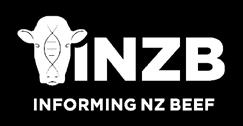

Dairy bull teams that have been predicted to have high or low emissions from these trials
were used as sires in 2022. The daughters of these bulls will be born in 2023 and have their first lactations in 2025. There are plans to measure the daughters for emissions to assess the practical application and ramification of using this technology to alter the direction of selection relative to the past few decades.
Now consider the context for sheep and beef cattle farmers. The bull battery required for 750,000 beef breeding cows at a 2% mating ratio would be 15,000 bulls. If bulls are used for an average of three years, then 5000 new bull replacements are required to be sourced from bull breeding herds each year. Just testing the sires of these bulls would represent a considerable phenotyping effort – much larger than the effort
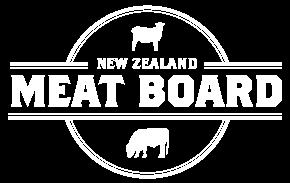

required for testing the dairy bulls. And then the number of offspring born to beef breeding cows is a small fraction of the number of dairy cattle offspring. This greatly reduces the value proposition for selecting to reduce methane emissions in beef cattle relative to dairy cattle.
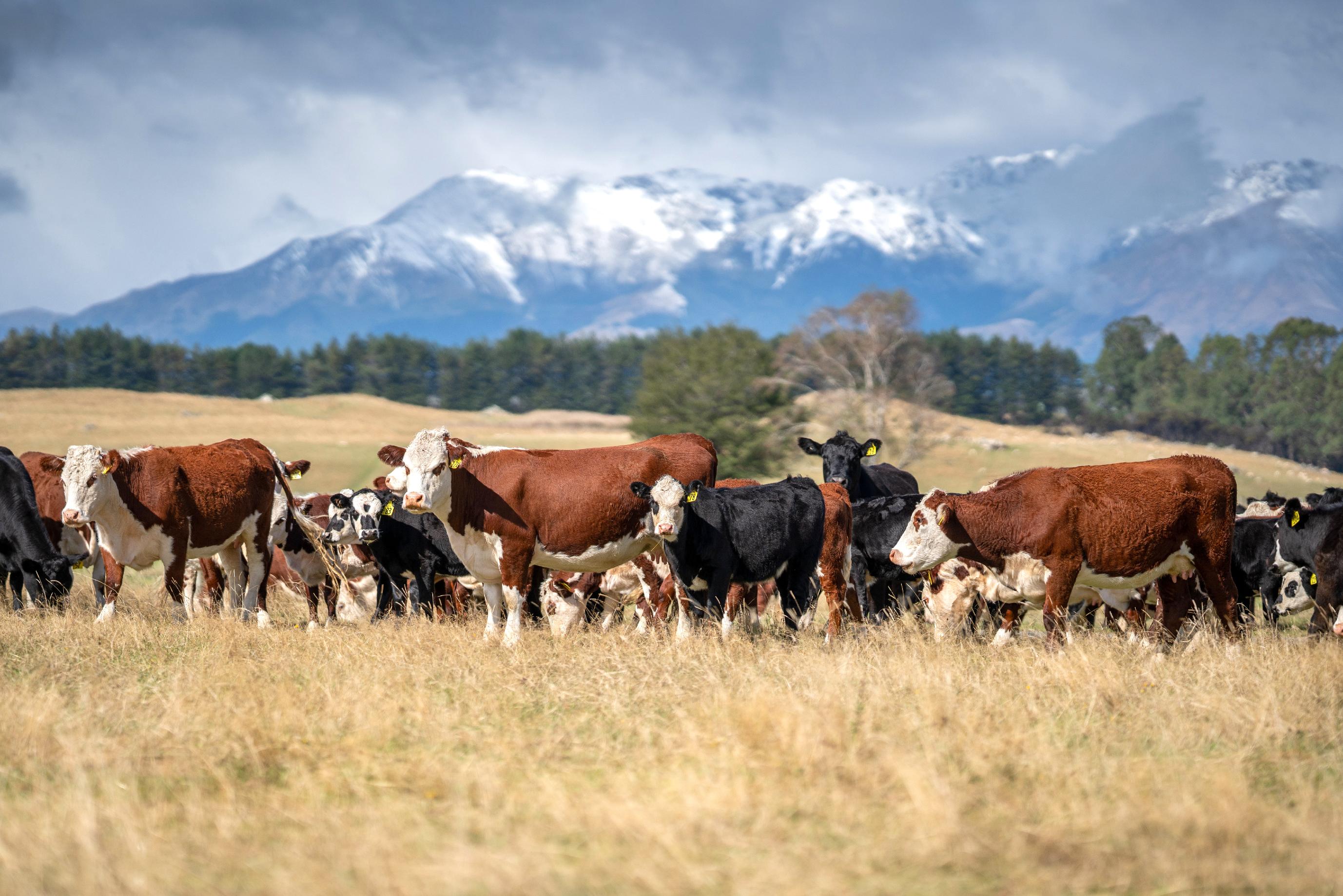
There is little point in measuring methane emissions only on the animals that will be used as parents. Genetic improvement can only occur when a pool of selection candidates is assessed, and when only a proportion of the best animals are then chosen to be used as parents. The smaller the proportion of tested animals that are selected, the greater the advance from selection. However, testing more candidates means the
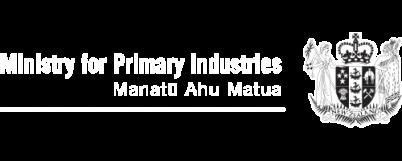
measurement costs also increase.
Bulls are more intensely selected than cows, since one bull can breed many cows. It therefore makes sense to measure bulls rather than cows. As any farmer will know, keeping post pubertal bulls together in pens can create some behavioural challenges. Measurements made earlier in life would be helpful, but weaning weight is an important trait to measure in beef cattle, and weaning takes place at six or seven months of age.
Genomic selection would also offer promise for selection to reduce methane emissions, but in my experience at least 10,000 cattle with phenotypic and genomic information that are related to the selection candidates would be required in order to provide any predictive ability in


indicated that a mechanism for reduced methane emissions might be faster passage of digesta through the rumen into the abomasum and small intestine, perhaps associated with reduced rumen capacity. Faster passage through the rumen can reduce the digestibility as less fermentation will have occurred, and a smaller rumen might limit the ability of cattle to consume large quantities of low digestibility pasture. Either of these mechanisms might reduce the efficiency of beef cattle production in NZ circumstances. Nevertheless, we are a small country that relies on exports, for example to China. Imagine a press release that stated:
“In a groundbreaking move aimed at curbing climate change,
China announced today that it will now exclusively accept beef imports from countries actively working to reduce methane emissions in their beef industry. This bold decision comes as the latest in a series of environmentally conscious policies implemented by the Chinese government, sending a clear message that the fight against global warming is a top priority. Experts predict that this new regulation will not only encourage worldwide innovation in sustainable livestock farming but also signal the urgency of addressing the environmental impact of meat consumption to governments and industries around the globe.”
While there are challenges and risks in addressing methane emissions, there will be market threats for those exporting nations
that do nothing and market opportunities for those that can demonstrate reduced emissions. There is clearly scope for selection to reduce methane emissions in beef breeding cows, but genetic improvement is a long-term activity, and this will require at least 5–10 years of animal evaluation and selection activities before any effects flow through to export products.
Leadership, vision, and an implementation strategy organised at a national level is required. This will be challenging given the structure of the beef industry, but could be done with more serious investment by government and industry players. The alternative may mean that we have to reduce methane emissions associated with our beef exports by running fewer beef breeding cows and increasing our dairy beef production.
95
“...genetic improvement is a long-term activity, and this will require at least 5–10 years of animal evaluation...”
Bid on genetics, not just looks
On those cold days in late autumn and early winter when beef farmers are out scouring the countryside for their next moneymaking sire, take some time to reflect on the massive amount of effort and technology that’s gone into generating the breeding values in all those shiny bull sale catalogues. It involves a lot of people, a lot of money, and a lot of very considered thought.
At the root of it all, in my view, is a breeding objective. A breeding objective is that marriage between knowing where you want to go and how to get there. If a breeding objective isn’t well defined, then it could be a bit shotgun-like and
we’d have bulls doing all sorts of things, genetically.
New Zealand is an unusual country in that it exports so much of its primary produce. So the breeding objective for beef needs to consider those who buy our beef internationally, as well as what Kiwis want on their plates, in their ovens or in their burgers.
Setting the breeding objective is quite a lengthy process and it involves many participants from throughout the supply chain. We design our breeding objectives economically, so we want to know the costs, prices, margins and profits that go with every movement or transaction. Farmers, processors,
exporters, rural professionals, scientists, economists, industry bodies, and buyers all contribute to painting this picture. Recently, breeding objectives have felt pressure to change, or maybe adapt is a better word. Climate change, environmental sustainability and to some extent, social licence are all knocking on the breeding objective door saying, “Hey, what about me?” Production and efficiency have tended to dominate breeding objective thinking, but other factors now need to also be considered.
Why? Because the world is changing and buyers of red meat in the sophisticated markets we target expect more than just production and efficiency. So, we think carefully about how to introduce new elements into our breeding objectives, which means we can offer our product at a premium, maximising the return to farmers for all the effort and cost that they incur when meeting consumers' values.
Looking for improvement
As the farming experts, you’ll be well aware that biology is hard to change. Reliably squeezing out an extra couple of centimetres of eye muscle area or an
96 Country-Wide Beef | MAY 2023
BREEDING Ph: 0272 224 421 (Clayton Peters) or 03 976 6509 or 0272 258 330 (Justin Wallis) www.petersgenetics.co.nz To be held at Beaumont. Inspections welcome from 9.30am BULLS 4 U Beaumont, RD1, Lawrence 9591 Otago PETERS ANGUS 11a.m. Tuesday, 30th May 2023 Affordabull - Dependabull - Profitabull 14th ANGUS BULL SALE 25 rising 2-year-old bulls
Breeding values may seem difficult to use, but they are easy compared to the work that goes into them. By Sharl Liebergreen.
extra millimetre of intramuscular fat from each crop of calves is not easy and it certainly takes time.
And what about the things we can’t easily measure, such as fewer methaneladen burps or less nitrogen-laced urine? I wish I had a magic wand, but the reality is that we are on a path of continual improvement.
Gathering performance data from breeders’ herds will remain absolutely essential. As the traits of interest become more novel and specific, we’ll need some breeders to record new things in new ways, probably at additional cost. Progressive attitudes from leaders within the beef industry are vital if we are to include new, important traits in our breeding objectives. Fortunately, behind the scenes, this is happening.
No threat
Genomics has been around for almost 15 years now and our red meat industry has adapted reasonably well to what was initially perceived as a threat. We’ll
need DNA from New Zealand herds included in analyses domestically and internationally to help us identify genotypes that “bend the curve” more quickly than before. Traits for reduced emissions and smaller environmental footprint will need all the help they can get.
Having defined our breeding objectives, collected a whole stack of performance records and some DNA, and then had a cup-o-tea and a lie down, next we need to implement all this in a form that makes it easy to match bulls with buyers. The long, considered gaze from the weathered eye of a crusty bull buyer will never be lost. Even in
peripheral vision, buyers need to like what they see every day in the front paddock.
Once 100 bulls have been scanned and narrowed down to 10, then the catalogue is sought from the back pocket. These catalogues actually contain a wealth of information and this can seem overwhelming, but it doesn’t need to be. Mark each breeding value, arrow up or down, if you like. (Do this in advance or you’ll miss out on the host’s BBQ.) Or look for the selection indexes that gather up a lot of what’s important and provide you with just one number to think about.
“Maternal”, “terminal”, “heifer”,
“dairy”, etc; the names of selection indexes are designed to help match what you see in the pen with your needs and your market. Selection indexes are a great way to narrow 10 down to 4. So, we are getting there!
The last bit is hard, or easy, depending on the result. The selection index number is an indication of the profit that an individual bull will contribute to your business. So, the larger the number the more profit in the bull. Therefore you might think that bulls with larger numbers always sell for higher prices. Well, that’s not always the case. Remember the proverb “beauty is in the eye of the beholder”? This is why you need to begin the auction with at least four bulls marked with a star in your catalogue, because others might agree with you. Happy bidding.
Country-Wide Beef | MAY 2023 97
“Reliably squeezing out an extra couple of centimetres of eye muscle area or an extra millimetre of intramuscular fat from each crop of calves is not easy and it certainly takes time."
Sharl Liebergreen is a consultant with AbacusBio.
Coverage from a recent genetics field day at Kepler Station, the South Island site of the Informing NZ Beef across-breed beef progeny test.
Proof that BCS lifts fertility
Results from a five-year beef progeny test show that body condition is a heritable trait and there is a strong correlation between cow body condition and reproductive performance.
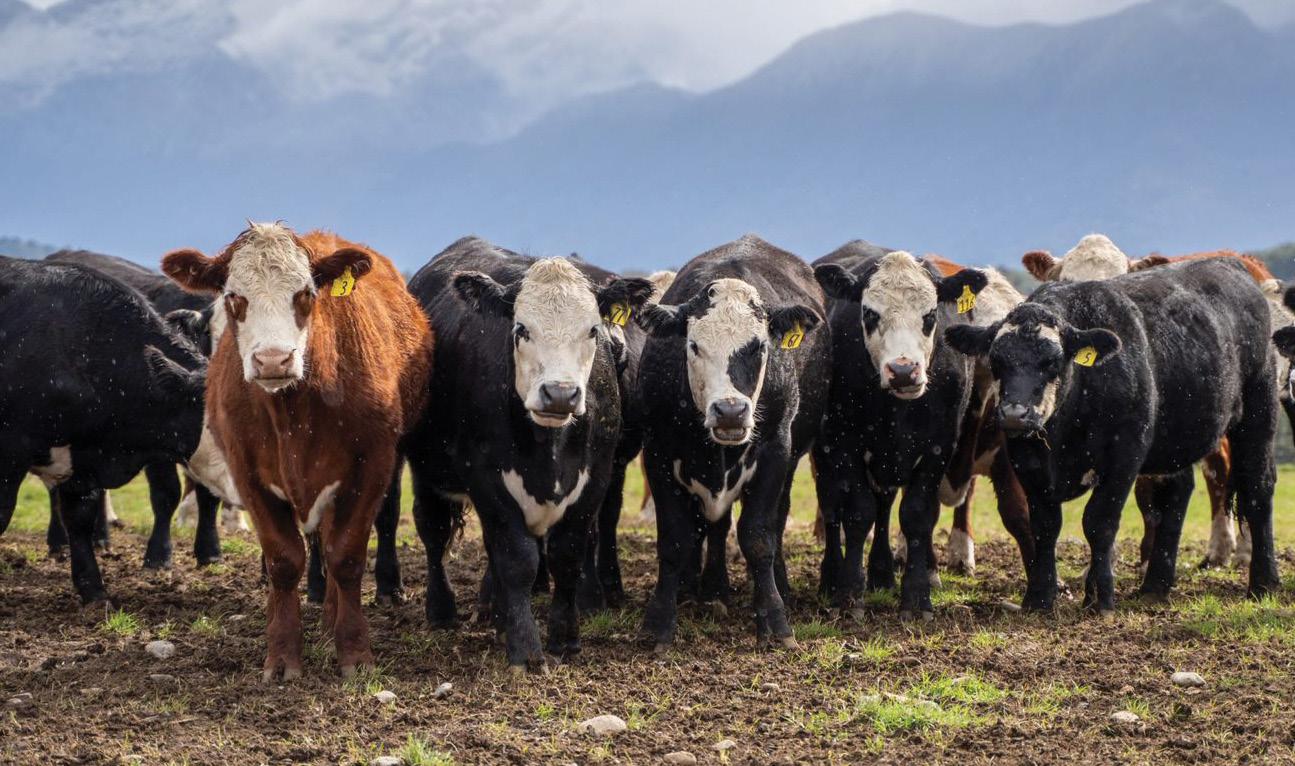
As part of her PhD, agricultural scientist Franzi Weik has been analysing the data set collected from the five largescale beef operations that participated in Beef + Lamb New Zealand’s beef progeny test between 2014 and 2019.
Speaking at the recent B+LNZ Genetics field day at Kepler Station (South Island site of the Informing NZ Beef acrossbreed beef progeny test), Weik says she looked at the phenotypical and genetics influences on body condition and the relationship between body condition score (BCS) and pregnancy.
The cows in the progeny test were weighed and body condition scored
three times a year – at mating, weaning and calving. They went through an artificial insemination programme followed by two cycles of natural mating.
Weik says to optimise conception, the breeding cow needs to be at a BCS of seven at mating. Beyond that there was no benefit in terms of conception rates, but there was a penalty in reproductive performance from having cows at a BCS below seven.
Identifying low condition cows and preferentially feeding them before calving so they can reach a BCS of seven would help improve reproductive performance at the next mating. This not only increases conception rates, conception happens earlier which helps tighten up the calving pattern.
“The most value will be obtained by
98 Country-Wide Beef | MAY 2023
Supplied by Beef + Lamb New Zealand.
Cattle in B+LNZ’s Progeny Test at Kepler Farm. The test is part of the Informing New Zealand Beef programme.
GENETICS
reducing the number of low conditioned cows in the herd,” Weik says.
As a rule of thumb, 27kg will shift the BCS by one unit in Angus and Hereford cows.
Weik says genetics are an additional tool that could be used to help the breeding cow herd maintain condition and get back in calf. BCS has a heritability of 27% so the right genetics could help lift the BCS of the entire herd by up to one BCS.
“There is potential to identify sires with high genetic merit for BCS, but at the moment we don’t have EBVs for BCS to include in our bull selection.”
As part of her research, Weik looked at the relationship between cow BCS and fat measurements. While EBVs for fat are valuable from a finishing point of view, they are a blunt instrument when it comes to helping lift BCS in breeding cows.
She says rib fat EBVs are an important tool for finishers to help them achieve industry targets of 3–10mm fat, but they are not good indicators of body energy reserves in cows.
Unfortunately, positive fat EBVs are the only tool farmers have in the toolbox, but they should be used
primarily to improve the performance of the finishing herd.
The progeny test highlighted the big fluctuations in weight many breeding cows experience over the course of a year.
Weik says there were big differences between farms and while this could be management and seasonally related, it showed how inter-related liveweight, BCS and reproductive performance are.
Progeny test in third year
This spring, the third crop of calves born into Beef + Lamb New Zealand’s Informing New Zealand Beef Progeny Test will hit the ground on Pamu’s Kepler Farm.
Anna Boyd, Beef + Lamb New Zealand genetic operations specialist - beef, says 405 Hereford and Angus cows were artificially inseminated (AI) at the Manapouri farm last December, using genetics from six Angus, six Hereford bulls and one internationally sourced Angus bull. The AI programme was followed up by farm-selected bulls.
Boyd says despite the dry spring, the cows were in very good condition going
into mating and this was reflected in the pregnancy test results in March. The re-bred 2020-born heifers went to the bull at a body condition score (BCS) of 7.6 and had a 69% success rate to AI. The 2019-born females went to the bull at an average BCS of 7.5 and had a 63% in-calf rate to AI.
Last spring, the first heifers sired by progeny test sires (born in 2021) went to the bull for a natural mating. Weighing an average 421kg going into mating, they had a pleasing 96% pregnancy rate.
This breeding information will be amongst the data gathered on the heifers’ fertility traits which will include days to conception. Using foetal ageing, this is calculated to within five days of conception.
Along with steers born the same year, the heifers were structurally assessed and had their eye muscle area, rib fat, rump fat and intramuscular fat ultrasound scanned and measured.
The 2021-born steers will all be processed at Silver Fern Farms’ Finegand plant by late June and carcase data, including Beef EQ data, will be collected and analysed.

Boyd says in April, the second cohort of progeny test calves born on Kepler were weaned and docility scored.
Taupo’s Lochinver Station came into the progeny test last year and had their first mating in January.
Boyd says 586 Angus cows went through an AI programme using the same Hereford and Angus genetics used at Kepler, with the addition of four Simmental bulls. Pregnancy testing showed a 58% success rate to AI.
The seven-year Informing New Zealand Beef (INZB) programme is a partnership between Beef + Lamb New Zealand, the Ministry for Primary Industries and the New Zealand Meat Board. It aims to boost the sector’s profits by $460m over the next 25 years.
Focused on increasing uptake of the use of high-quality genetics in the beef industry, the four main components of the programme are developing New Zealand-specific breeding indexes, building a genetic evaluation and data infrastructure, running progeny test herds, and developing new data sources.
Country-Wide Beef | MAY 2023 99
BULLS ARE A farm asset, an investment – so why would they be bought on a whim?
Beef + Lamb New Zealand has launched a new interactive onlinelearning tool to assist the decisionmaking process. Designed to help commercial farmers select the best genetics for their specific breeding objectives, the 40-minute module steps farmers through establishing clear breeding objectives for their business (including a downloadable breeding objective template) and provides an overview of breeding traits and their importance.
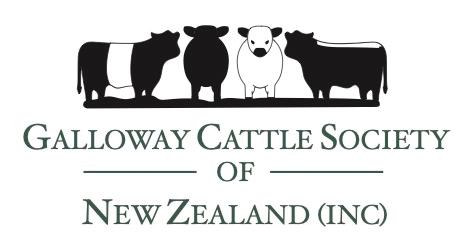
This information allows farmers to select the right breeder and right bull
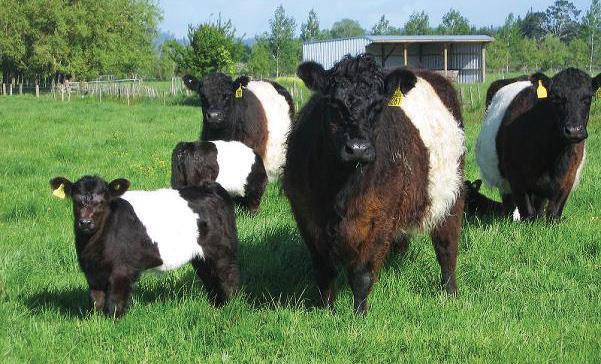

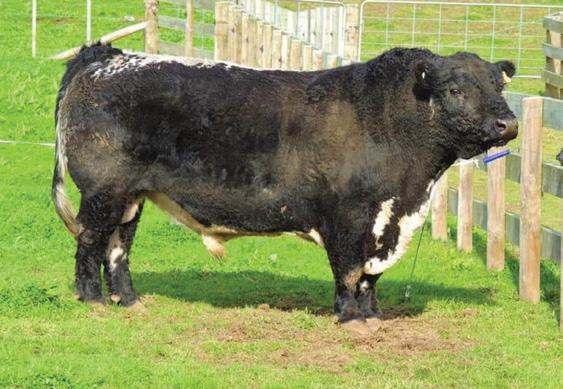
for their particular needs. It can also be completed in sections, allowing farmers to come and go as they wish.
The module includes farmer case-study videos, tips on contacting breeders and what questions to ask, as well as detailing how to interpret bull catalogues and the dangers of buying on impulse at bull sales.
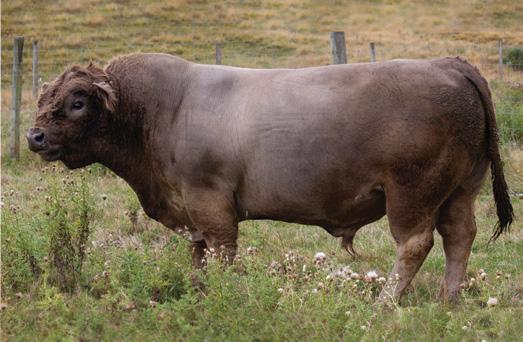

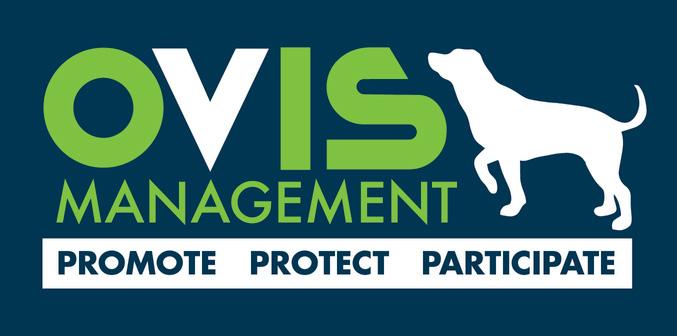
Viewers get the opportunity to have a go at selecting the right genetics for
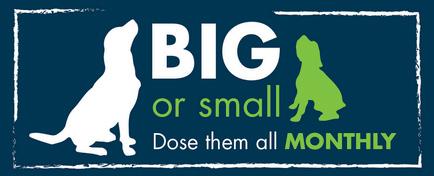
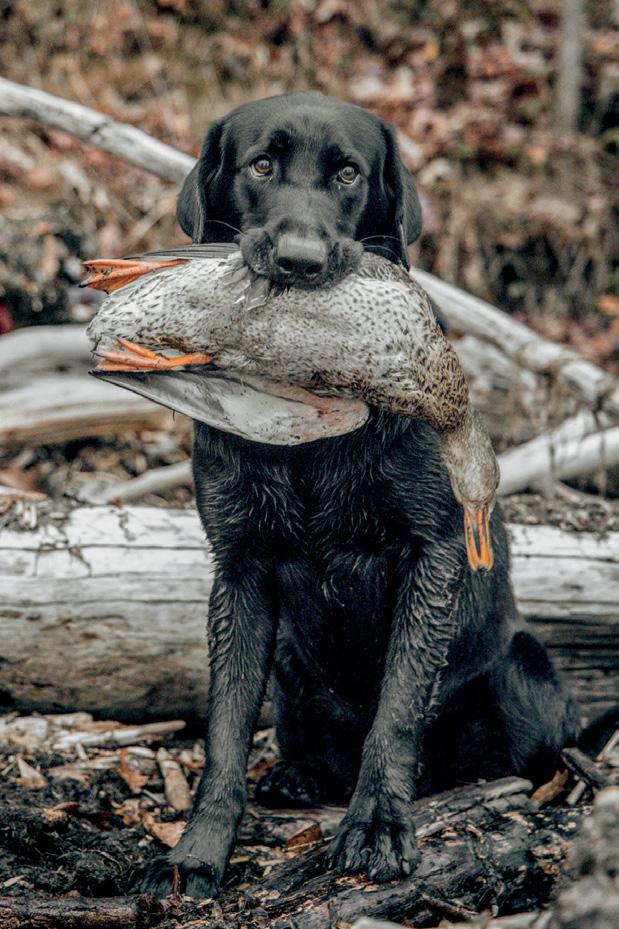
different farmer needs in an interactive quiz. The final part of the module is beef class structural assessment which includes a video of an assessment being carried out on bulls, as well as diagrams and scoring charts.
+ To complete the module go to beeflambnz.com and search “better beef breeding”.
100 Country-Wide Beef | MAY 2023 DUCK HUNTING? Help reduce your regions sheep measles prevalence. 0800 222 011 www.sheepmeasles.co.nz M a x i m u m p r o t e c t i o n = M o n t h l y d o s i n g @sheepmeasles @sheepmeaslesnz Sheep Measles are caused by a tapeworm. Cysts cause undesirable blemishes in sheep meat These cysts can disrupt the lamb export market and cost our farmers financially! Galloways are well known for their hardiness, great converters, easy calving with low weight calves and naturally polled. nzgalloway.co.nz Galloways are well known for their hardiness, great converters, easy calving with low weight calves and naturally polled. www.nzgalloway.co.nz KEEP A LOOK OUT FOR OUR INAUGURAL BULL SALE MID-2022
GENETICS
Bull selection online
An eye for form and function
BY: LYNDA GRAY
AS A TEENAGER, Bill Austin used to doubt the claims of two great uncles who said that a mad bull inevitably had upward pointing eyelashes. But it turns out those old uncles were correct when the lash orientation is figured into the overall physical structure of a bull.
Bill, a cattle structural assessor with 14 years’ experience, said that upward lashes indicated the lack of a bone hood that shields a bull’s eyeball from bright light and shadows.
“Always be wary of a bull with an eye not protected by a bone hood. They see shadows and are more likely to spook,” he said at a mini masterclass on structural assessment at the Beef + Lamb NZ acrossbreed progeny test field day.
Bill knows cattle inside and out. He ultrasound scans cattle throughout the country, measuring eye muscle area (EMA) and intramuscular fat (IMF), and for most of March and April he assesses the structure and phenotype of potential sale bulls using the internationally recognised Beef-Class Structural Assessment system (BCSA). The system classifies an animal for structural soundness and basic type measures
according to 11 traits, including docility, feet and leg structure, carcase capacity and muscling. The information is used by breeders to select sale bulls and by buyers to assess whether a bull is suitable for their breeding system.
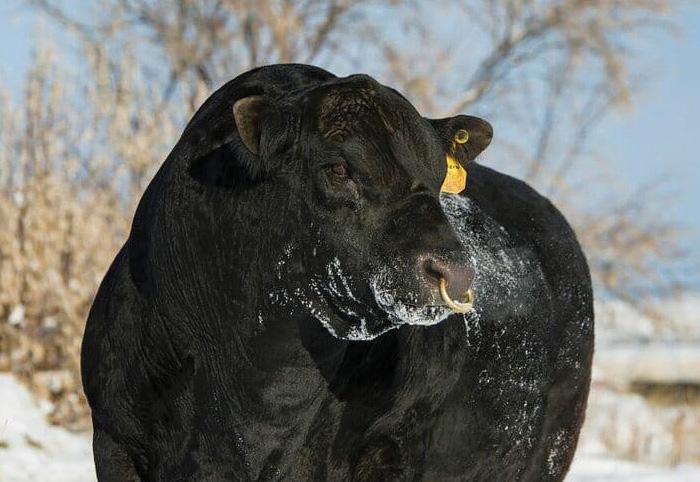
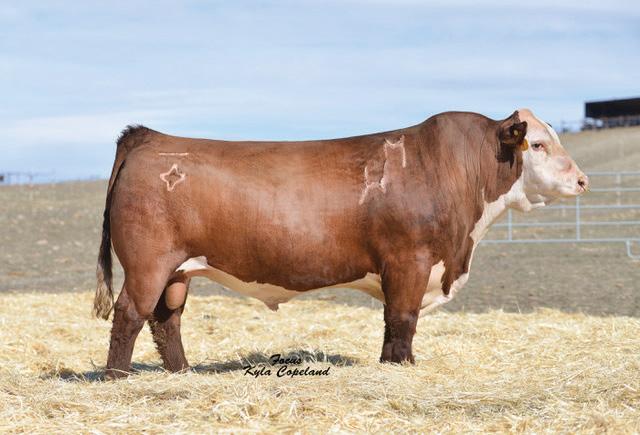
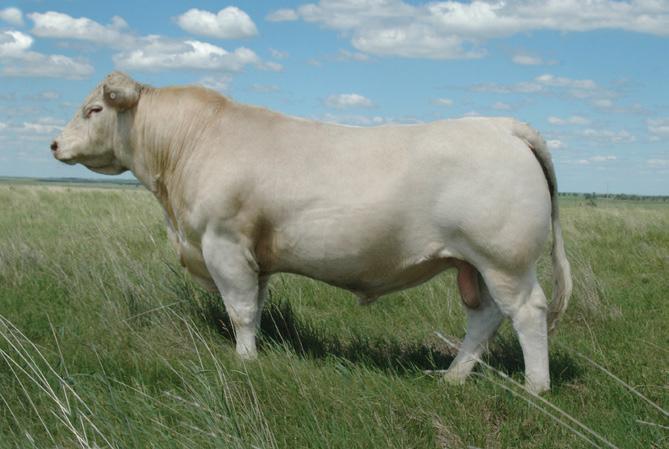
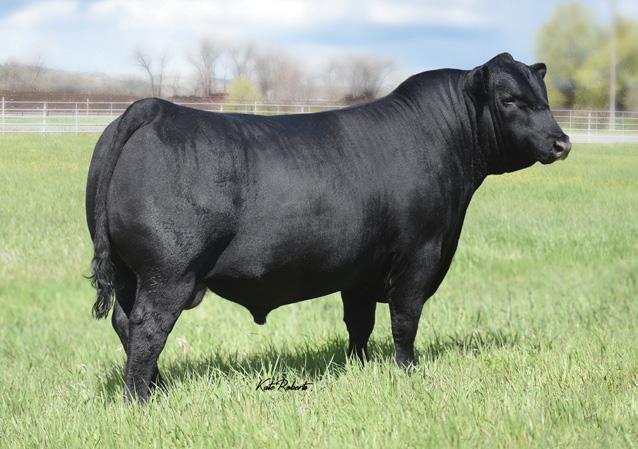
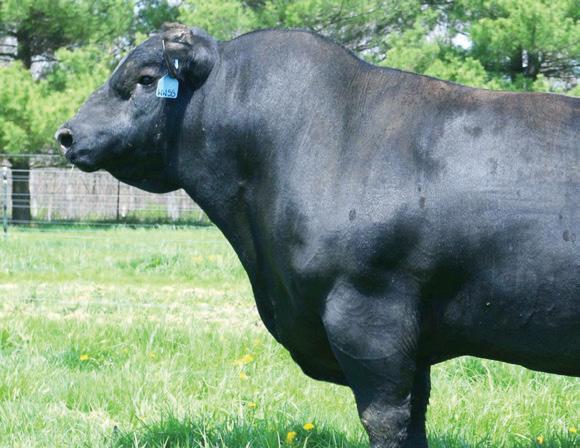
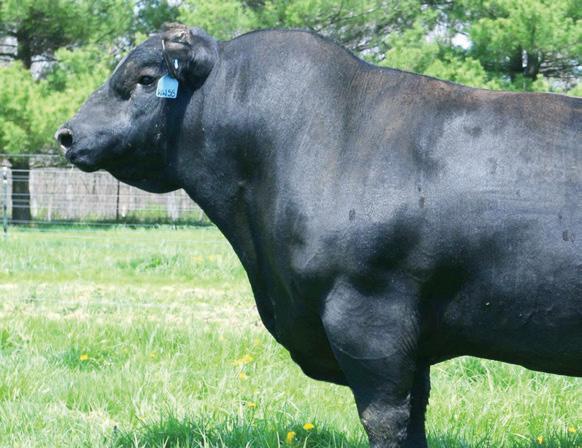

“Everything that’s measured either adds profit or costs you money,” Bill said. The colour or number of whorls on a bull or heifer’s coat is irrelevant to Bill who says his focus is assessing practical and functional cattle.
“Breeders often talk about structural soundness, but I talk about structural functionality, because it’s about cattle that are functional and productive.”
He pointed out and explained some of the considerations and measurements using a few Kepler cattle. Claw set, foot angle, leg view was explained in the context of mobility and the ability of a bull to fulfill its job description of reliably serving cows.
Aside from temperament, one of the most important measurements was heel
depth, or foot/hoof angle.
“If that’s ok, everything else should fall into place,” he said.
The heel depth, measured from the hairline at the top of the hoof to the ground should ideally be 40–60% of the heel-to-toe length.
Mobility – where the animal places its feet when walking naturally – was also a good guide as to whether a bull was fit for purpose. A structurally correct animal placed its hind foot in the imprint left by the front foot. However, a straight-legged bull placed its hind foot short of the front imprint. They were less athletic than a sound bull and were more likely to break a stifle while serving a cow.
Bill’s final word of advice was to select the EBVs relevant to your country and system and go to the breeder who has the most bulls of that type.
“It’s not the individual bull you buy, it’s the driveway of the breeder you choose that will have the biggest financial influence [on your cattle system].”
+ For more on cattle structural assessment go to: https://beeflambnz.com/ knowledge-hub/video/V539-beef-class-structural-assessment

Country-Wide Beef | MAY 2023 101
Your trusted partner in Beef Genetics. Advancing genetic gain and diversity in the NZ Beef Industry. Make us your partner! Ben Jakschik New Zealand Manager: 027 426 2364 Email: ben.j@geneticchoice.co.nz PO BOX 1122, Taupo 3351 www.geneticchoice.co.nz • Exclusive Custom Sire Packages available • Commercial Sire Packages tailored to your herd • Exclusive • Commercial • Easy web • Exclusive (Call or email • Easy web shop functionality with live inventory availability • Exclusive offer for Country Wide readers - 10% Coupon Code discount (Call or email Ben for your code details!)

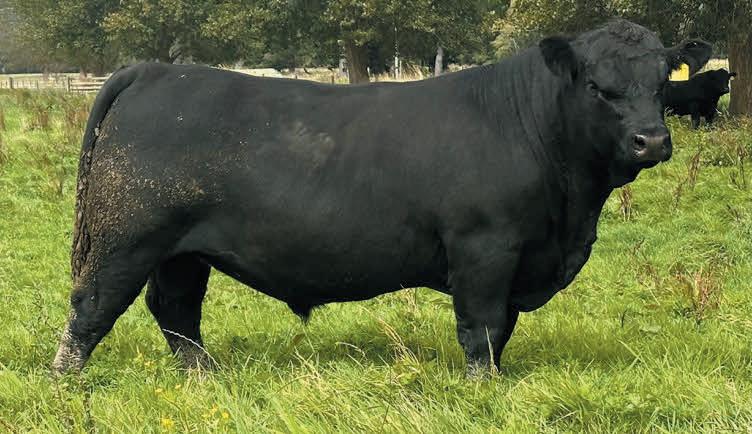
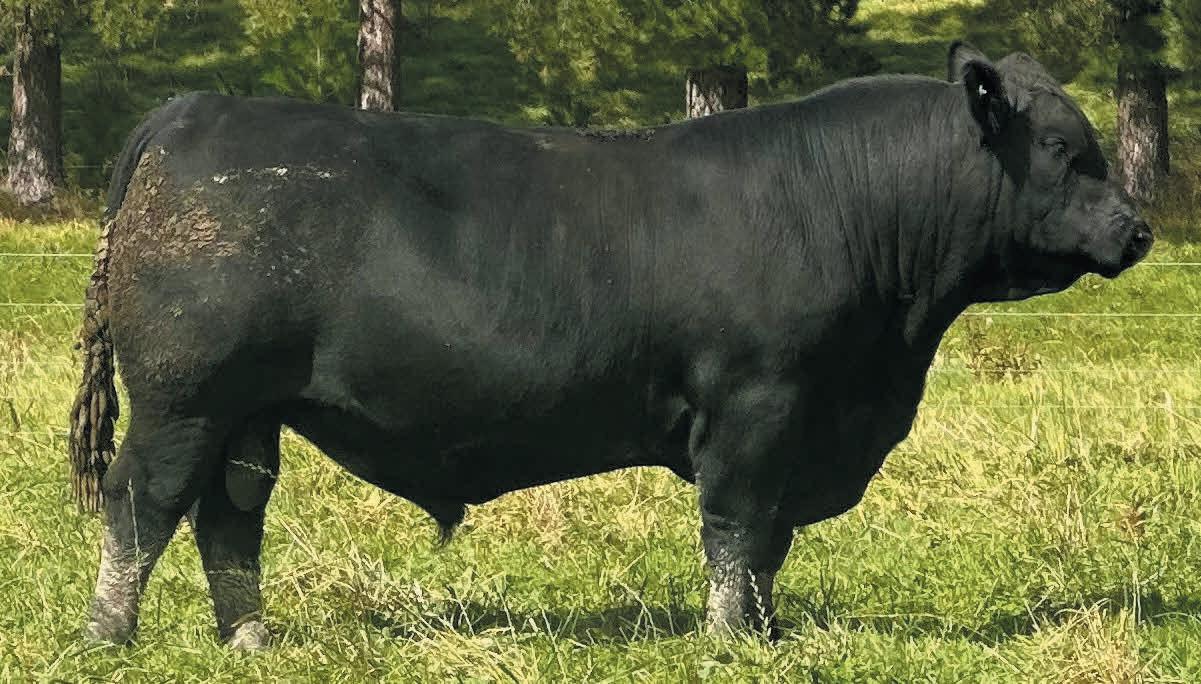

102 Country-Wide Beef | MAY 2023 Enquiries & viewing contact: kayjaycattleco@outlook.com COMPLETE GENETIC PACKAGES Celebrating Years Lot 4: Strong KJ bloodlines and out of a Steakhouse Daughter Lot 1: KayJay Fullbeam, used as follow up to AI Turihaua Tender ROD KJESTRUP 06 372 7533 213 Hakakino Road, Masterton FRIDAY 2ND JUNE 2023 - 45 BULLS FROM TWO LEADING WAIRARAPA STUDS FRIDAY 2ND JUNE 2023 80 BULLS KJ Cow 601kg, Calf 430kg March 16 2023 2.00 p.m. 11.00 a.m. 14th ANNUAL BULL SALE FRIDAY 2ND JUNE 2023 • 35 BULLS fb.com/kayjayagnus NEIL KJESTRUP 06 372 2838
BLACK RIDGE
ANGUS STUD
DEAN & TERESA SHERSON
675 Taringamotu Road, RD 4, TAUMARUNUI 3994 p: 07 896 7211 m: 027 690 2033
e: blackridgeangus@outlook.com
On-Farm Bull Sale


Thursday 1st June 2023, 2pm
35 R2 Year Bulls
SIRE BULLS: Black Ridge Hero Q004, Tangihau Maximus N458, Te Mania Buff 314, Kaharau Jonah 343, Stokman South Dakota N226, Murchison PowerHouse N282
FIRST SONS OF THE 86K TURIROA COMPLETE 18P250 FOR SALE
Country-Wide Beef | MAY 2023 103 3 year guarantee for fertility & soundness 50 TOP QUALITY BULLS FOR SALE
SALE: Wednesday 28th June 2023, at 2PM ON THE PROPERTY, TURIROA, STATE HIGHWAY 2, WAIROA ENQUIRIES WELCOME: Andrew Powdrell P: (06) 838 8805 M: 0276 228 088 Email arpowdrell@turiroa.co.nz Turiroa Angus @turiroaangus • www.turiroaangus.co.nz
ANNUAL
Inspection and Enquiries always welcome | All bulls BVD vaccinated and tested. Lepto vaccinated. Semen evaluated. TB C10. Like and Find us on Facebook
A selection of this years bulls on offer

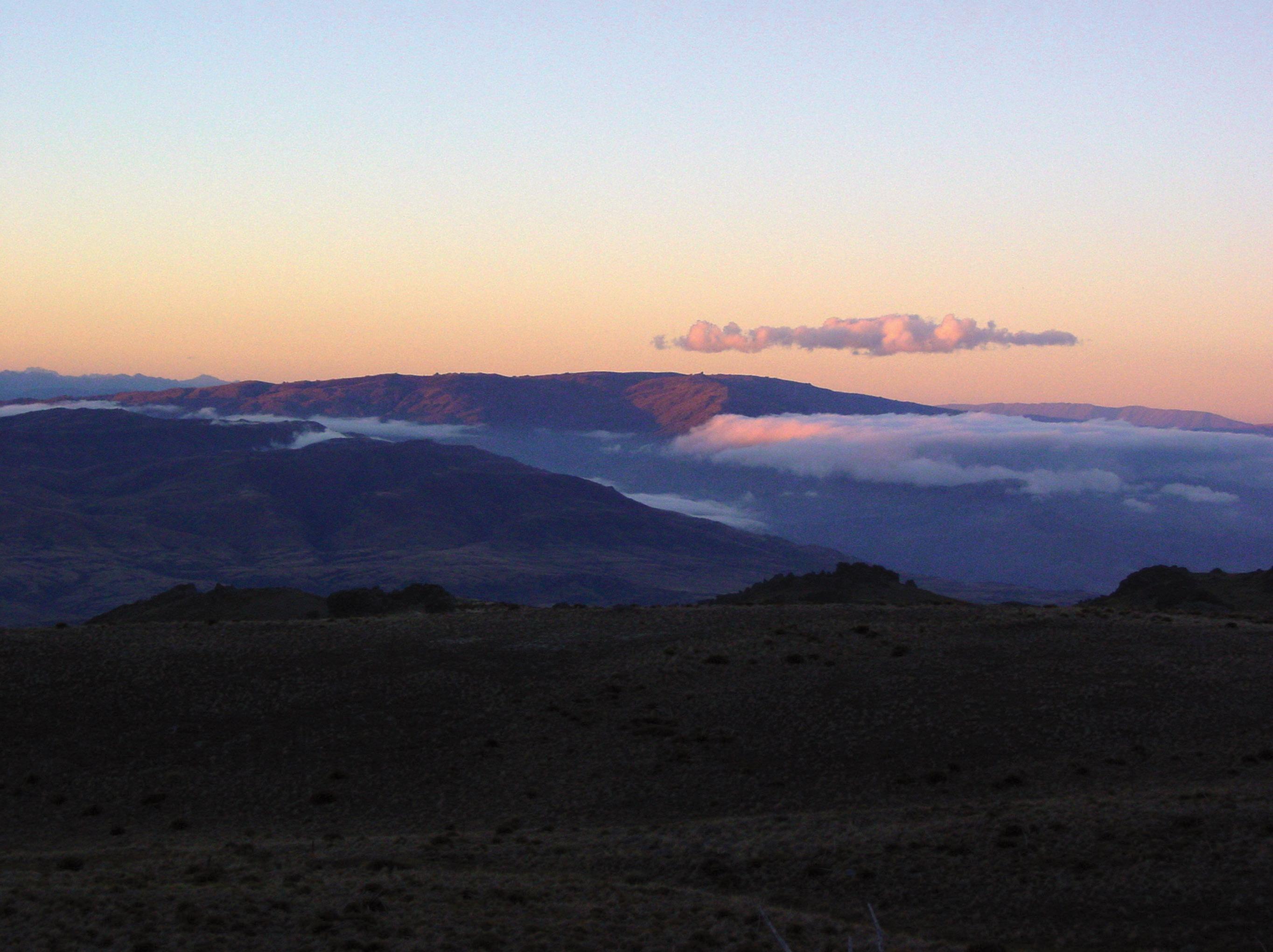

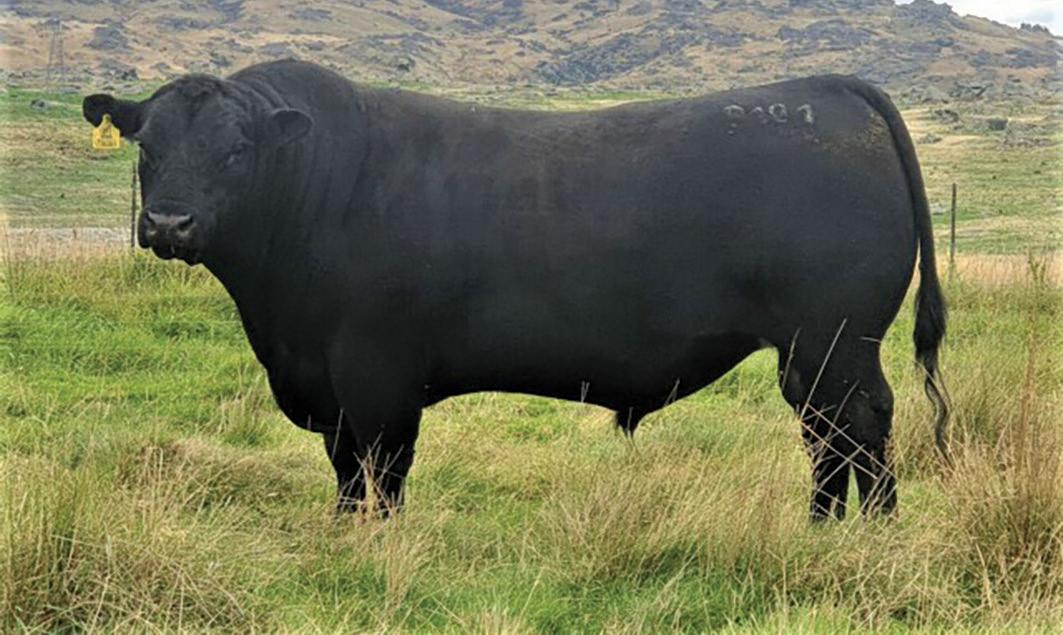
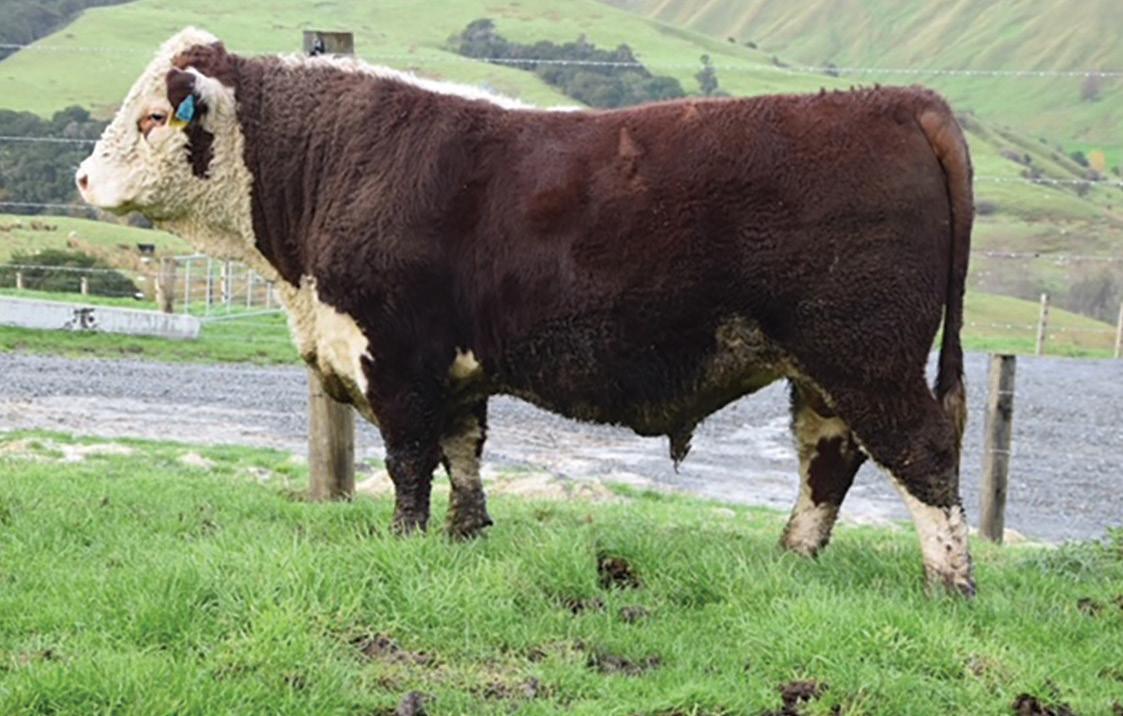
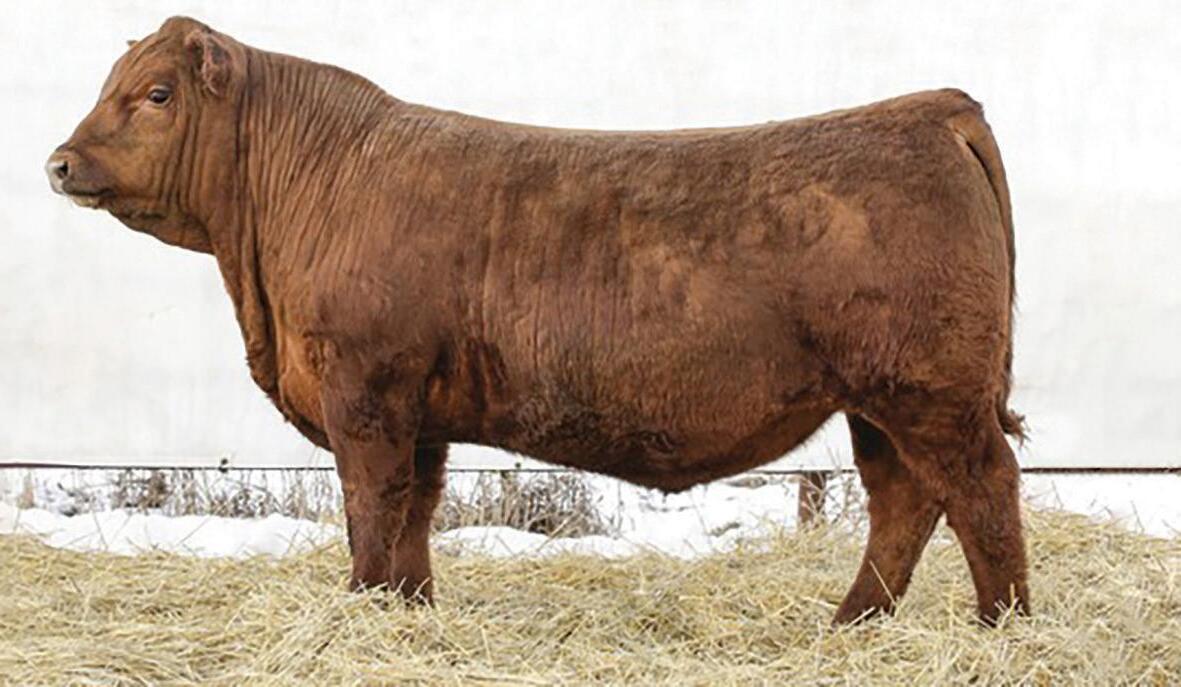
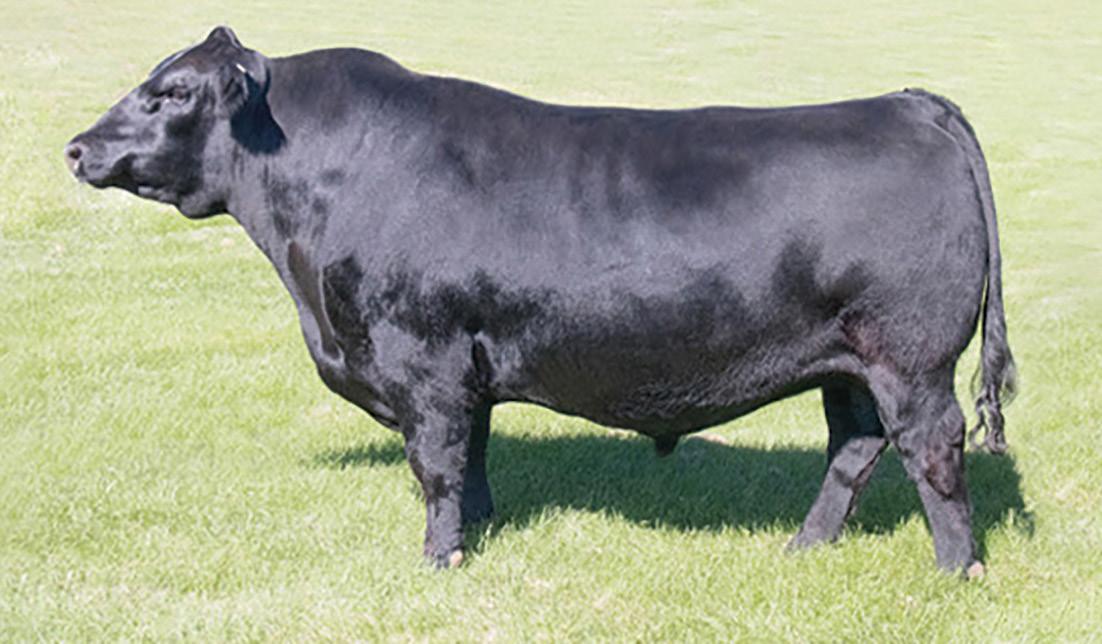
Earnscleugh HIGH COUNTRY GENETICS ANGUS, POLLED HEREFORD & ECC COMPOSITES
bulls
low breakdown rates.
deep south
affordable
Three maternal breeds selling on the day Angus for carcase traits • Hereford for temperament Composites for hybrid vigour performance ALISTAIR CAMPBELL P: 03 449 2031 or M: 0274 892 820 email: ecgenetics@farmside.co.nz DUNCAN CAMPBELL P: 03 426 2455 or M: 027 659 6713 email: duncancampbell77@gmail.com ENQUIRIES TO: Like our Facebook page Earnscleugh High Country Genetics ANNUAL BULL SALE DATE: Friday 9th June 2023, 1.00pm VENUE: Earnscleugh Station, 382 Conroys Road, Alexandra Top Photo: On Farm Panorama SUDELEY VIKING 18101 REGO: 20082018101 DIR DTRS GEST BW MILK 200 400 600 SS DTC +4.6 +5.4 -1.8 +5.0 +11 +44 +80 +98 +4.4 -5.0 CW EMA RIB RUMP RBY IMF +45 +5.0 +4.1 +4.9 -0.9 +3.4 SR INDEX $ AP INDEX $ HDT INDEX $ +$152 +$178 +$116 LIMEHILLS STARDOM 190168 REGO: 0677190168 DIR DTRS GEST BW MILK 200 400 600 SS DTC +6.8 +7.6 +0.9 +3.1 +28 +40 +73 +101 +1.9 -5.5 CW EMA RIB RUMP RBY IMF +71 +4.3 +2.6 +4.0 -0.8 +2.0 HP INDEX $ BH INDEX $ DB INDEX $ +$171 +$230 +$140 GW COPPERHEAD 919G ASA: 3549340 CE BW WW YW ADG MCE MM MWW STAY +13.7 -2.1 +85.1 +133.5 +0.30 +7.5 +28.1 +70.6 +19 DOC CW YG MARB BF REA SHR API +18.3 +26.6 -0.036 +0.79 -0.061 +0.87 -0.18 +175.2 TJ GOLD 274G ASA: 3582577 CE BW WW YW ADG MCE MM MWW STAY +16.7 -3.4 +79.7 +122.4 +0.27 +7.3 +25.5 +65.4 +17.6 DOC CW YG MARB BF REA SHR API +13.6 +24.3 -0.030 +0.60 -0.036 +0.84 -0.48 +176
Earnscleugh
are renowned for their shifting ability. Our environment prevents our sale bulls being overgrown and this converts to very
Come to the
for
bulls.
NG Ā PUTAHI
The Cameron Clan would like to invite you to their

RISING 2 YEAR OLD ANGUS BULL SALE
Monday 12th June, 3PM
Raised under totally commercial conditions
Born to dams that are udder, temperament and phenotype scored at birth
Genetically docile and easy to handle
(important traits that will be inherent in their progeny)
Meet and exceed all present and future beef quality standards excelling in EMA, IMF and carcass yield
Venue: Ngāputahi Main Woolshed. Access via Pohangina Road only
Mt Mable Angus
38th Annual Bull Sale on Monday 12th June 2.30pm Quality yearling bulls sold Monday 18th September at 12.00pm
Consistently breeding and fully recording quality, sound, quiet, easy eshing fertile pedigree angus cattle for over 50 years.

• BVD Tested
• BVD Vaccinated
• 10 in 1 Vaccinated
• All bulls DNA proled and sire/dam veried
• TB status C10
• Fully Breedplan 5 Star record
Our cattle are a case of what you see is what you will getcalm, quiet, meaty, fabulously footed, sound, fertile and all backed by a comprehensive three year money back guarantee. Think you can’t have it all? Time to think again.
Enquiries and inspection welcomed - Kevin and Megan Friel
Phone: 06 376 4543 | Mobile: 027 625 8526 | Email: kev.meg.co@xtra.co.nz
625 Jacksons Road, Kumeroa (easy to find off SH2, Oringi Rd from North, Hopelands Rd from South) Website: www.mtmableangus.co.nz | Find us on Facebook: Mt Mable Angus Cattle
Country-Wide Beef | MAY 2023 105
Future in youth

106 Country-Wide Beef | MAY 2023
Genomic testing has come a long way during the past decade, improving the accuracy of breeding values for yearlings.
Sarah Horrocks visited yearling specialists Stokman stud near Rotorua to find out how their business is doing.
When you’re looking for bulls, where do you start? There are twoyear-olds, yearlings, registered or bush bulls, private sales and auctions. Prices vary immensely between the various options, but one thing is certain, science has proven that without reputable genomic evaluation on any given animal, it’s all a guessing game.
The Stokman bloodlines have been in the Angus cattle game for more than a century and Stokman stud has now been in operation for more than 25 years in the Waikite Valley near Rotorua.
Sherrie Stokman hails from Sitz Angus in Montana and the family farm is run by her and husband Mark, son Jake and stock manager Craig Moyes. Yearling bulls are their specialty, and they sell plenty of them.

The breeding programme was developed around profitability and the practicality of using yearling bulls in both heifer and cow mating programmes.
“They’re easier to handle, shift easily and they’re more economical,” Sherrie says.
Mark insists that the first point of profit in any beef breeding programme is having a live calf on the ground. He says there’s data available on bulls to ensure the predictability of a female producing a calf that will calve easily with a moderate birthweight and go on to have above average growth.
“That’s a profit point,” says Mark. Yearling bulls provide the latest genetics available in the industry and that’s why they are so appealing
to Stokman clients.
With genomic testing, the accuracy of the estimated breeding values (EBVs) available for yearlings has come a long way. Ten years ago people were worried about buying a yearling as they weren’t proven as a sire and their EBVs weren’t as reliable as those of a two-year-old. Accuracy on a bull increased as the number of progeny increased. HD50k genomic testing changed all of that. It greatly increases the accuracy and scope of predictions for young bulls and females with limited or no progeny. A yearling bull that has been HD50k tested has EBVs that are more accurate than a large number of the two-year-old bulls being sold here in New Zealand without genomic testing.
In 2022 Stokman calved down 376 females – 300 mixed age (MA) cows and 76 R2 heifers.
There are 100 bulls catalogued for the yearling sale in September and Stokmans plan to increase this number in future. The bulls are selected for their suitability for heifer mating (calving ease) while still possessing data to provide good growth and carcase attributes.
Mark says a farmer might want a big calf that has huge growth, but if it has to be pulled out the calf might not make it. The farmer has lost the opportunity of that cow’s production for a year. With today’s genetics curve bending sires can be easily identified.
“Looking at the calving traits is really important for heifer mating.”
Mating heifers is not just preached, but practised by Stokman, with all heifers mated at 15 months, and Mark
Country-Wide Beef | MAY 2023 107
SYSTEMS ONFARM
is blunt when asked about the idea that this generates the most profitable return on females.
“Unless you’re farming for a hobby and don’t want to make money, you mate yearling heifers.”
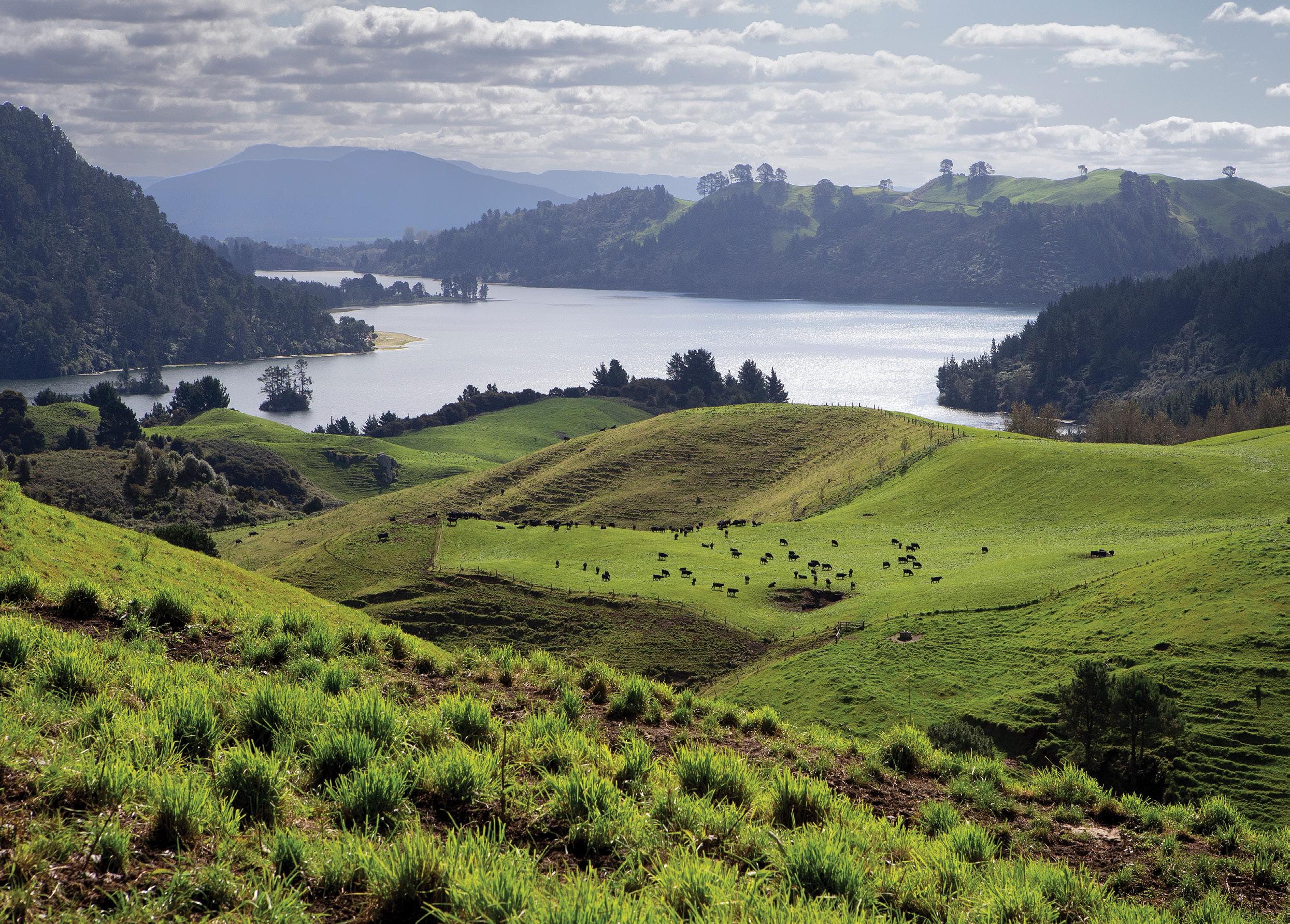
While a heifer’s calf won’t always have the same growth as a calf out of an MA cow, Mark says commercial farmers should look very closely at retaining their replacements out of the heifer calves.
“They should be your best genetics,” he says.
Jake says by 15 months old the heifer’s calves have caught up and it’s hard to pick them out among their
contemporary group without their tag numbers.
Conception
The cycle begins with a planned calving date of August 1 for the heifers and August 14 for the MA cows at Stokman. It’s a short gestation herd so the team can expect to see calves on the ground up to 10 days earlier than that. This isn’t something that was sought, but rather a by-product of selecting for lower birth weight and calving ease.
The short gestation is also beneficial for the reproductive cycle with the cows often in their second or third cycle by the time mating starts, which increases
the reconception rate.
“We end up with a tighter calving pattern,” Mark says.
That calving pattern will see 89% of the pregnant females calving within a six-week period in 2023. The total empty rate is 7% in the MA cows and 8% in the yearling heifers.
Only 75% of the cows are put through one round of AI, with the average conception rate just over 70%. The cost and management time is significant, which is why not all females are impregnated via AI.
Mark says semen, AI and CIDRs cost about $150-200 per cow.
The total cost spent on AI in 2022 was $61,000, without any management time included. A third of the bulls used for AI are bred by Sitz Angus in Montana, renowned in the USA for their quality of females.
“They’re a strong maternal herd and
108 Country-Wide Beef | MAY 2023
The farm is set in a stunning location, along the shores of Lake Ohakuri on the Waikato River. It ranges from 340m above sea level at the lake shore to 480m on the tops.
i
KEY
POINTS:
390ha effective | 376
females calved | Sell 140 yearling bulls Winter 4600 stock units | Straight cattle system | Grow a lot of feed | Tourism and function centre.
they’re family,” Sherrie says.
Stokman are looking to bring in more intramuscular fat (IMF) and carcase into their progeny, so for this they are on a global hunt for sires.
“We’re bringing IMF in slowly to ensure we don’t sacrifice the maternal ability,” Mark says.
There’s just one cycle of AI and then the bull goes out for eight weeks, as it does for all other females too. Herd sires are sought from other NZ studs, with Stokman having used Ngaputahi, Storth Oaks, Hallmark and Te Mania sires in the past. For their heifer mating programme they hold back their two top yearling bulls each year.
When looking for bulls for their own programme, aside from the maternal attributes and hunting out the curve benders with low birthweight and top 20% growth EBVs, IMF is important.
“They have to be above the Australian
breed average of 2.2 for IMF,” says Sherrie.
Pregnancy testing and foetal dating in January identifies the females who got in-calf to AI and early natural mating.
The cattle are farmed in a rotational grazing system across the 390ha (effective) farm. The topography is about one-third easy country, one-third medium hill country and a third steep.
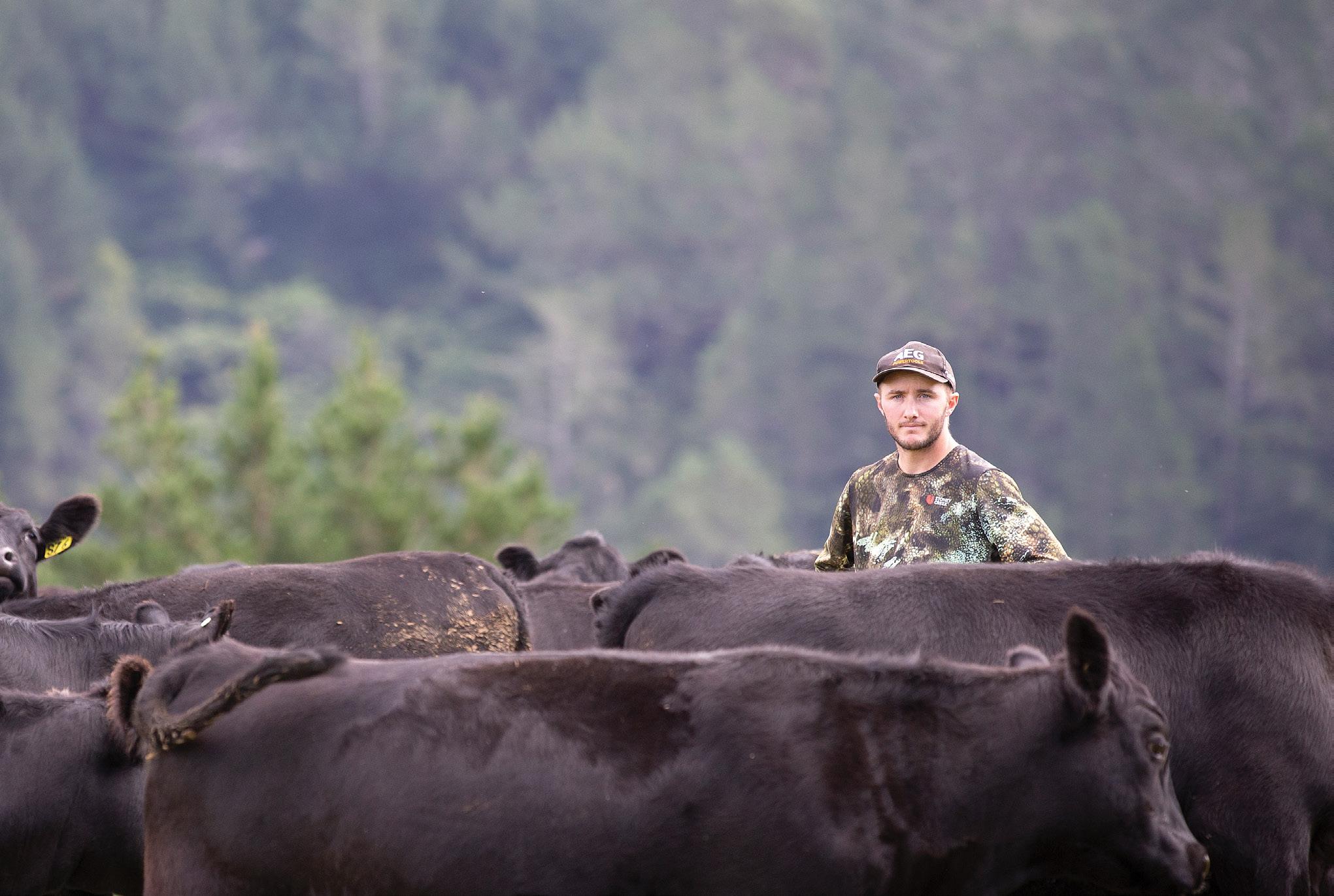
Stokman cows live in the hills for most of the year, only coming down to calve behind a wire for management; calves must be tagged, weighed and DNA sampled at birth.
HD50k testing costs $20,000 a year but the benefits far outweigh the cost.
Young stock the priority
In early to mid-February the calves have their 200-day weight measurement collected, docility score taken and are weaned. “The cows are put to work after
weaning,” Jake says.
The heifers and bulls are separated and run in mobs of 180-210 depending on the ratio of bull to heifer calves in any given year.
The bulls are fed to achieve a weight of 1kg plus/day, which gives a target liveweight of 500kg plus on sale day in September. On June 1 the weaner bulls are broken into two mobs of about 80-90 to reduce behavioural problems and make management easier over the winter months. The 120 potential sale bulls are selected in July and once selected are run in smaller mobs of 60, yet still fed the same as all the other young bulls so they can be compared equally against their contemporary group.
In July all the young bulls are carcasescanned and the heifers are done in January. It ensures physical evidence of the progeny they are taking back into their herd and also improves the
Country-Wide Beef | MAY 2023 109
By 15 months old Jake Stokman says that the heifers’ calves have caught up and it’s hard to pick them out among their contemporary group without their tag numbers.
accuracy of the EBVs.
The bulls are fertility tested in August and then sold via auction at 13 months old. Of the bulls sold, about 20% are more suited to cow mating than heifer mating.
“These bulls are breed average or slightly above for birthweight,” Mark says.
While these bulls aren’t in the breeding policy, there will always be genetic outliers. While Stokman closely monitors sires to reduce the number of higher birthweight bulls, they are still a valuable option for cow breeding.
In 2022 Stokman decided to host a two-year-old sale in June as an outlet for


these higher birthweight bulls. However, that created mixed messaging around the two different sales, so they don’t plan to host a second auction again in the near future.
Sherrie says they received a lot of feedback from their regular clients saying Stokman was creating a distraction from their main focus – the yearlings.

“Our clients know the value of a yearling,” she says.
Jake says when they initially discussed the idea of a two-year-old sale, they made the decision that the best bulls would always be sold as yearlings.
“We stand by that decision.”
Going forward they will now farm a
handful of bulls through, to be sold by private treaty. It also means there will always be bulls there to assist any clients in need of a bull throughout the year.
“The most important thing is to get cows in-calf,” Mark says.
There are also another 35-40 bulls sold by private treaty as yearlings, mostly to the dairy industry.
“We sell 80-90% of the sale bulls to the beef industry,” Jake says.
While Stokman do sell bulls to the dairy market, it’s the commercial beef farmer who gets a return from his bull for at least four years. They are prepared to pay the bigger money for a bull at auction. However, in the past three years, Jake says they’ve had dairy farmers paying up to $6100 for bulls.
Mark says the beef farmer buys a bull for finishing and weaner progeny, as well as the female replacements going back into his herd. The dairy farmer just wants live calves on the ground.
The total income generated from selling registered bulls in 2022 was $763,000, the majority share in the gross farm income of $2700/ha. The top priced yearling bull in 2022 smashed NZ records. Stokman Solution S329 sold



110 Country-Wide Beef | MAY 2023
FOR FURTHER DETAILS CONTACT FARM MANAGER: GREG CROMBIE PH 0275 511 011 EMAIL greg@leefieldstation.co.nz LEEFIELD STATION 1171 WAIHOPAI VALLEY ROAD, MARLBOROUGH 9.30am MONDAY 19TH June 2023
Sherrie Stokman in her happy place –out with the young weaner heifers on the hills at Stokman.
for $55,000 (not included in total bull sales) and that was for semen rights in Australia only. This means they kept him on farm to use at Stokman and his semen will also be available for sale here in NZ this year.
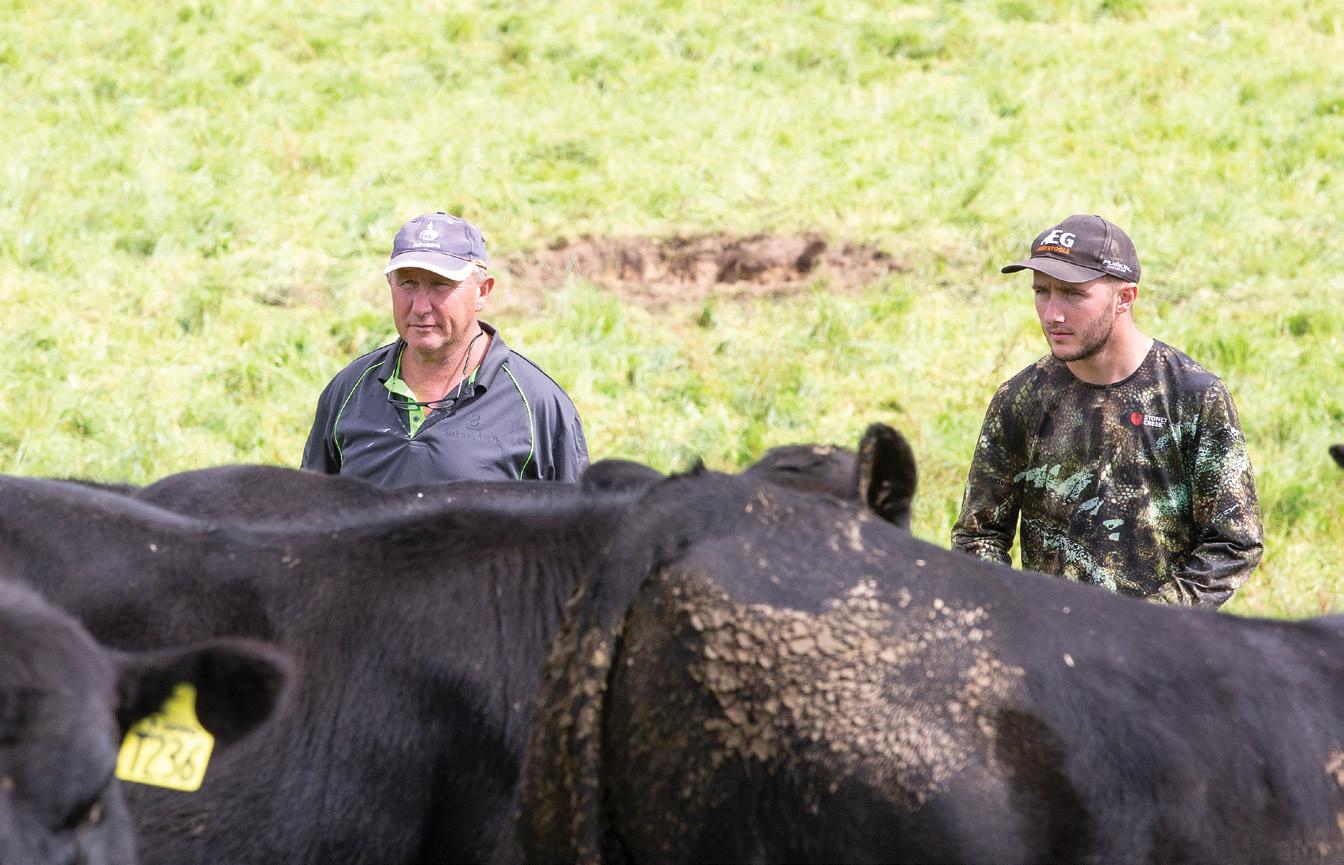
“That was a win-win for us,” Jake says.
The girls
Stokmans keep 75 heifer replacements annually. Of the remainder, they sell 40 as yearlings at the bull sale in September and about 80-90 are sold in-calf over the summer and autumn – all unregistered.
Every year there are about 20 heifers that are culled and sold fat through progressive meats at Wilson Hellaby for the Countdown Angus brand.
Mark says getting more information from meat plants rather than just weights would be beneficial for their programme.
“We really want that carcase data back.”
The fat heifers are killed either just prior to or during the second winter (20+ months) when the schedule is higher. They kill above 240kg CW.
Winter brings the highest stocking challenges for Stokmans, with 4900 stock units on board, so the less finishing stock they have to carry through the better.
As well as the cows and young weaner stock, there are 60 autumn calving commercial cows with their young calves at foot during winter. At 15 months old the bull progeny from these are sold unregistered to the dairy industry and the heifers are sold to a repeat buyer. Mark says there’s a market for these autumn-born bulls and heifers.
“Some dairy farmers like using a

No shortage of feed
Although winter and summer droughts bring challenges to farming in the pumice soil, feed is grown in abundance. Pasture quality is crucial and anything that can be cut for silage or cropped gets the tractor over it.

Country-Wide Beef | MAY 2023 111 OKAKA ANGUS PAUL & SUSANNAH REVELL 361 Okaka Road, RD1 Taihape 4791 E: paulandsus@inspire.net.nz Ph: 06 388 7519 Okaka Angus 2yr Bull Sale Thursday 15 th June 2023, 1pm Bred on steep hill country for steep hill country - Includes pure New Zealand genetics Open day Tuesday 6 th June 2023, 1-5pm - On farm and your bid online auction
15-month-old bull in their autumn calving herds.”
Mark (left) and Jake Stokman wander through a mob of weaner bulls.



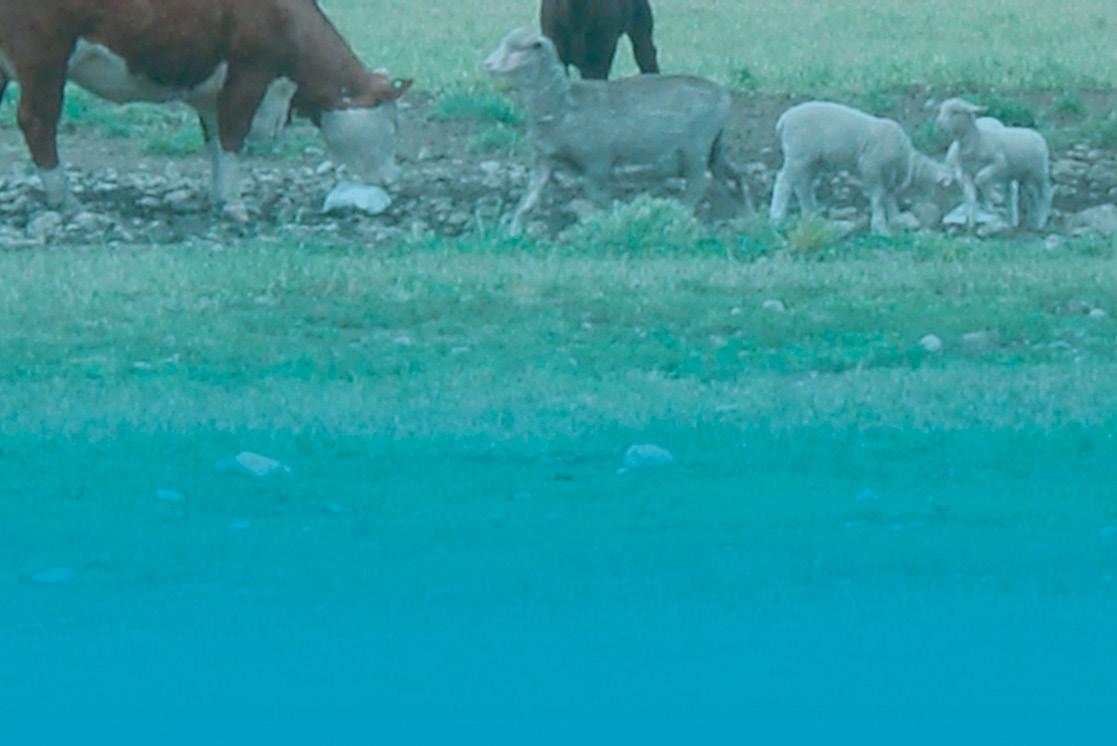
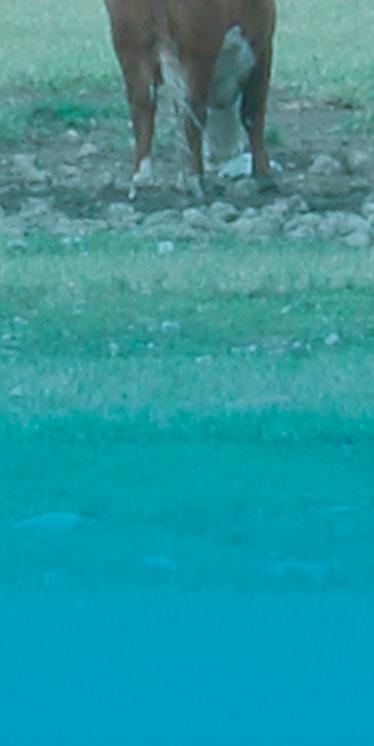




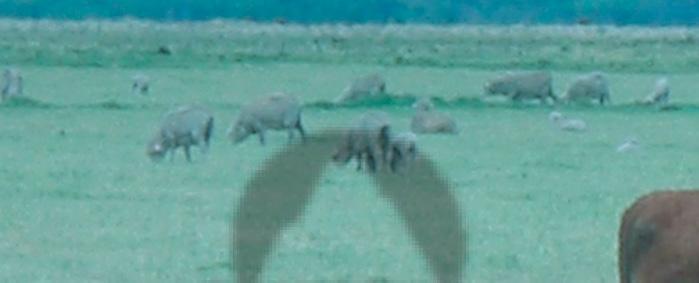
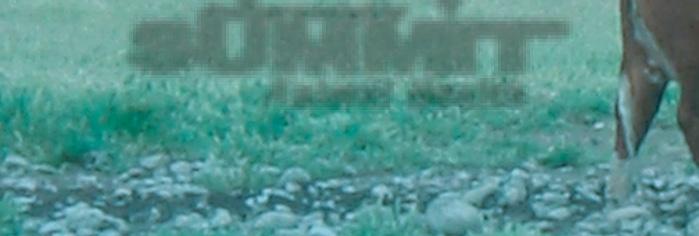



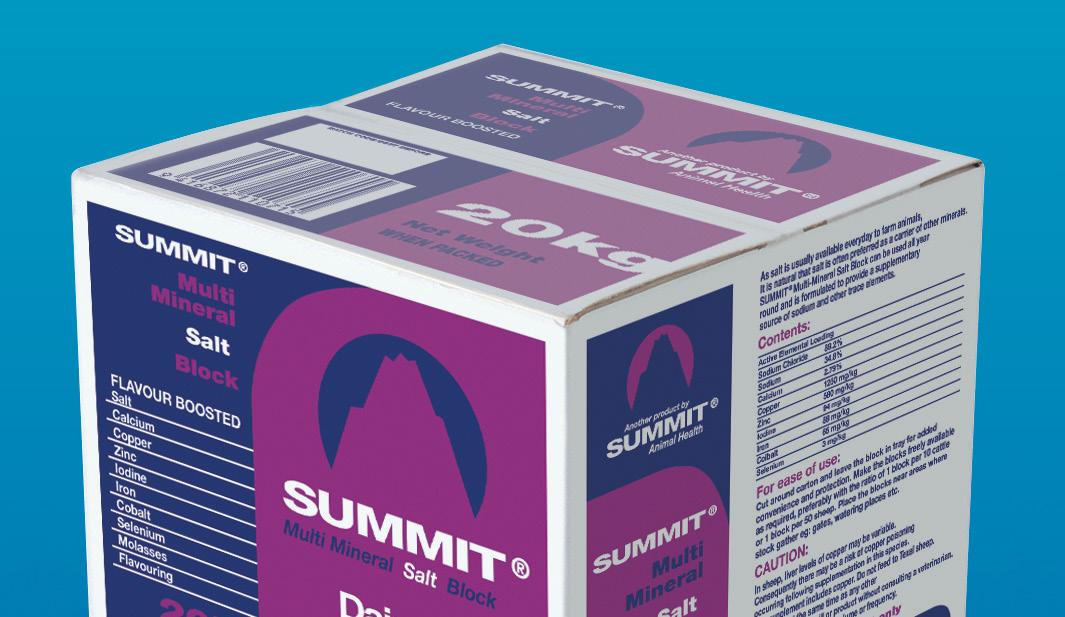
















112 Country-Wide Beef | MAY 2023
There’s about 35ha of relatively flat land around the sale barn that’s in a five-year rotation for new grasses – predominantly clover and Italian ryegrass.
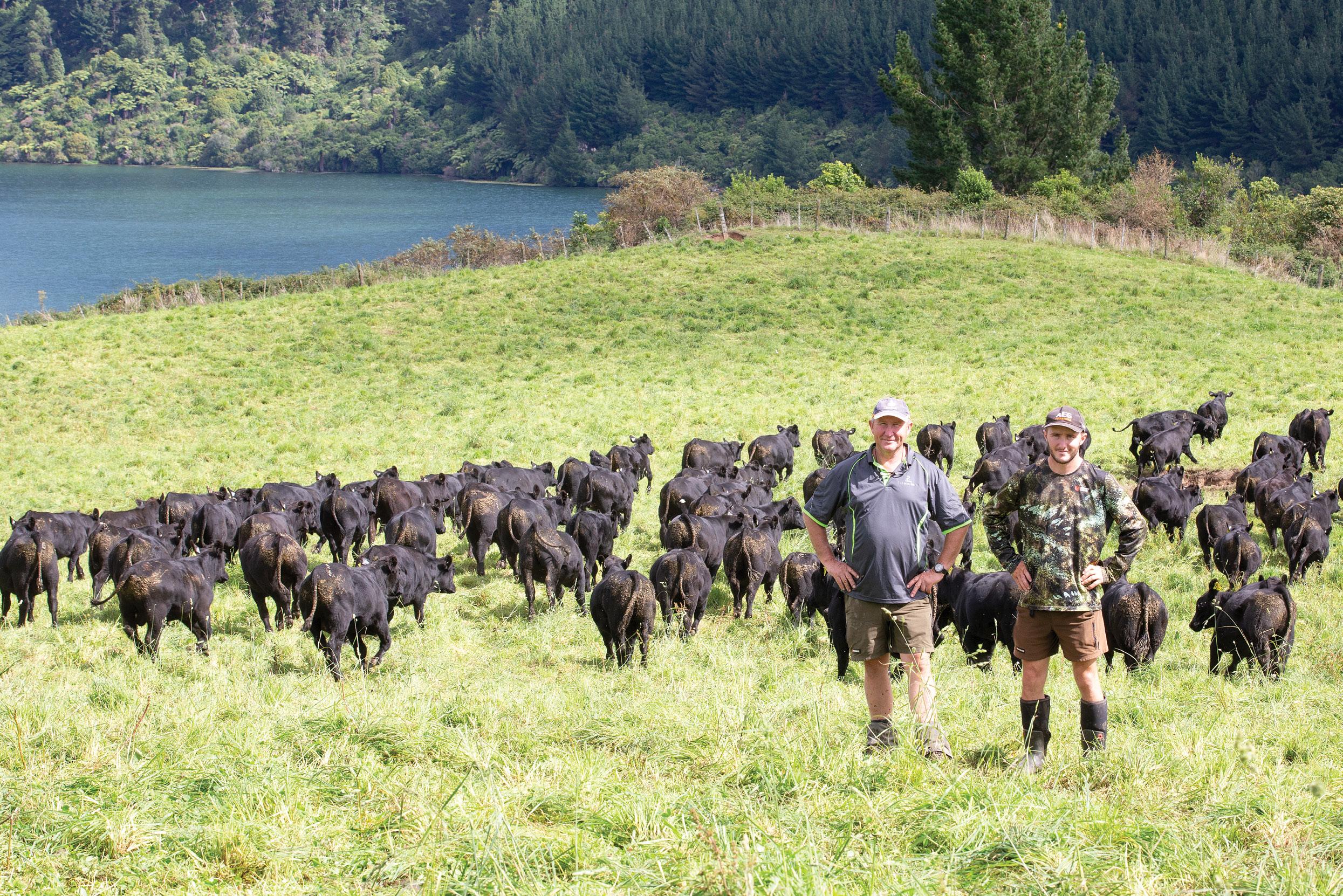
Across the whole farm there is 20ha put into crop for wintering the young stock and cows.
Jake says they make 1000-1500 bales of silage every year from surplus feed and some of this is sold to nearby dairy farmers. This is all done by contractors, but all the cultivation and re-grassing is done by Jake with the Stokmans’ own gear.
“This means it’s done when we need it done.”
The high cost of fertiliser this year has seen the Stokmans pull their fertiliser budget back, but it’s still costing about $180,000.
“We’ll be mining some of our fertility,” Mark says.
There won’t be any phosphate going on the flats, with Olsen P levels sitting at 45-50. The hills are at 15-23, so there’ll
be 20 units of phosphorus flown on by helicopter in two or three split dressings, with a DAP base.
The average acidity is pH 5.9 and the paddocks in crop receive three tonnes of lime/ha. Twenty units/ha of potassium goes across the farm in December to assist with clover production.
Mineral deficiencies
The pumice is deficient in minerals so animal health is a big expense at $9.61/ su, with an additional $2.95/su for Crystalyx tubs. These are available to all females from pre-calving through till the end of mating, to compensate for the high mineral deficiencies in the soil. Vaccinations include leptospirosis, BVD, Covexin 10 and salmonella. There is a regular programme to administer B12 selenium every three months and copper boluses two or three times a year across all classes of cattle. Drench is given in a mix of pouron and oral, with weaners drenched every eight weeks from two weeks
after weaning until 15 months of age. From then on drenching is on an “as needed” basis only, with mature cows rarely getting drenched. Lice control is occasionally required.
Diversification
The farm is set in a stunning location, along the shores of Lake Ohakuri on the Waikato River. It ranges from 340m above sea level at the lake shore to 480m asl on the tops. There is abundant geothermal activity in the area with Orakei Korako just a few hundred metres away by boat and the popular Paradise hot water pool within swimming distance.
The Stokmans used to sell bulls at Waikato combined sale and Taupo sale yards before building their new sale-barn venue in 2018. The long-term vision is to host weddings and corporate functions there for additional income. Covid didn’t play nicely and has put them at least two years behind. However, they have hosted two weddings to date and there are a
Country-Wide Beef | MAY 2023 113
Mark (left) and Jake Stokman. With genomic testing, the accuracy of the breeding values (EBVs) available on yearlings has come a long way.
number of corporate groups who use the venue, including Fonterra.
“They love looking out at the beef cattle, but luckily we have high milk EBVs on our cows,” Mark jokes.
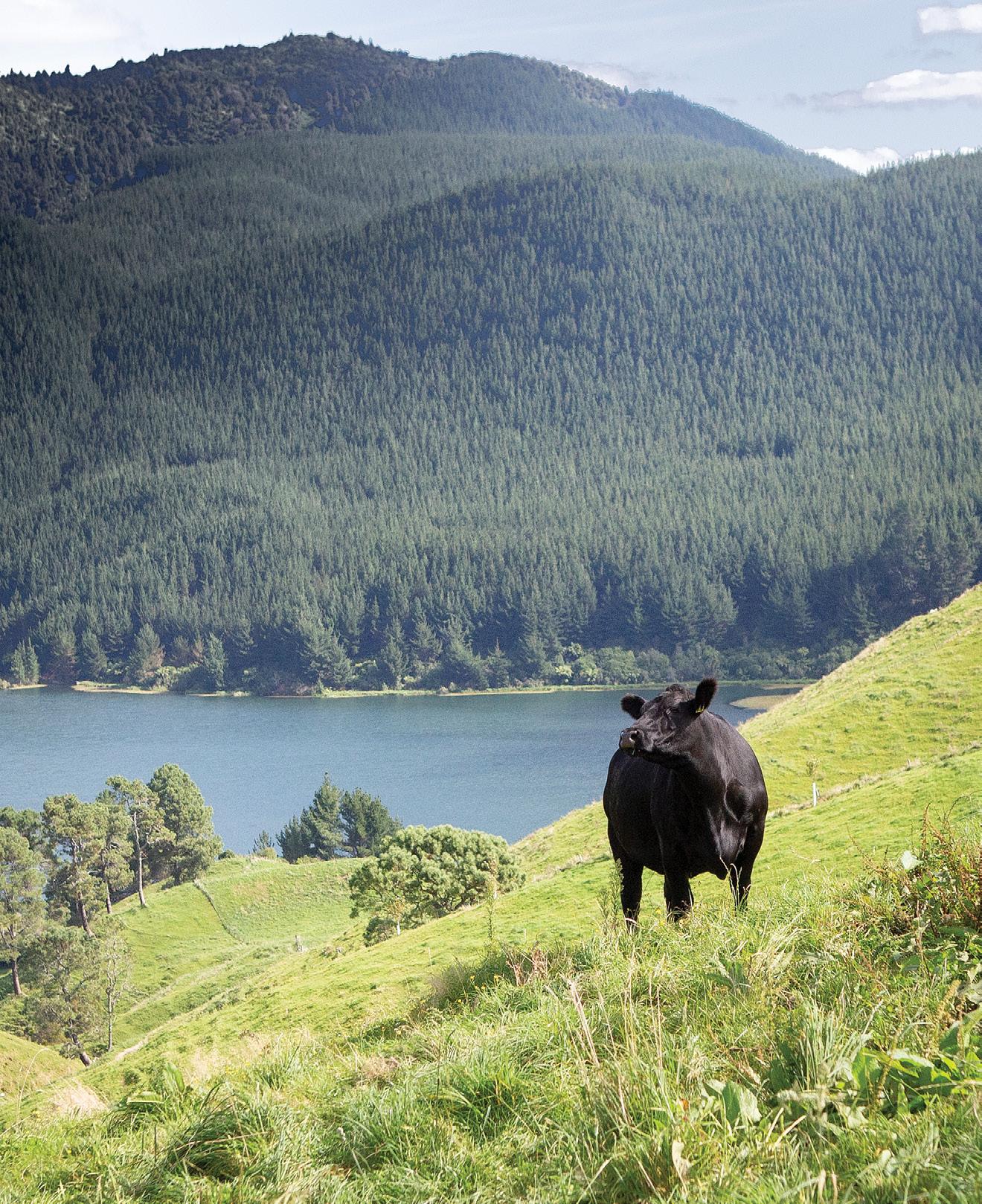
Jokes aside, Mark believes they should take every opportunity to showcase their product to anyone who passes through the farm. This is shown at their new accommodation pods, where all guests receive complimentary AngusPure steaks to dine on during their stay.
The self-contained pods were finished in early 2023 and designed as an addon to an existing family cabin that sits alongside the sale-barn venue. The old cabin has been updated to now include flushing toilets, gas hot water and solar power. The investment set the family back more than $100,000 (excluding the solar) but Jake is adamant it’s good future-proofing for the overall business.

Craig’s wife Courtney assists Sherrie with operations at the accommodation and sale-barn, ensuring the grounds are always immaculate and the gates are kept shut to wandering cattle.
A licensed pheasant preserve brings in a group of six regular hunters who stay in the cabin. To maintain the licence, Fish & Game requires the Stokmans to buy in 400 pheasant poults every year, which is a considerable expense of course, but there’s a flow-on benefit for the winter crops.
“They tend to eat a lot of the bugs without damaging the crop,” Mark says.
Despite Cyclone Gabrielle bringing minor damage to races, it’s nothing a bulldozer or digger won’t fix, and Mark and Sherrie feel fortunate they escaped relatively unscathed.
Capital development is now in a holding pattern for a year or two across the farm, with the team focused on maintaining and improving the existing infrastructure.
Genomics and scientific research have been a game-changer in the beef industry and the Stokmans have harnessed that power to ensure buying yearlings is no longer a guessing game.
114 Country-Wide Beef | MAY 2023
The self-contained pods were finished in early 2023 and designed as an add-on to an existing family cabin that sits alongside the sale barn venue. Bottom: Mixed-age cows spend their time on the hills at Stokman.
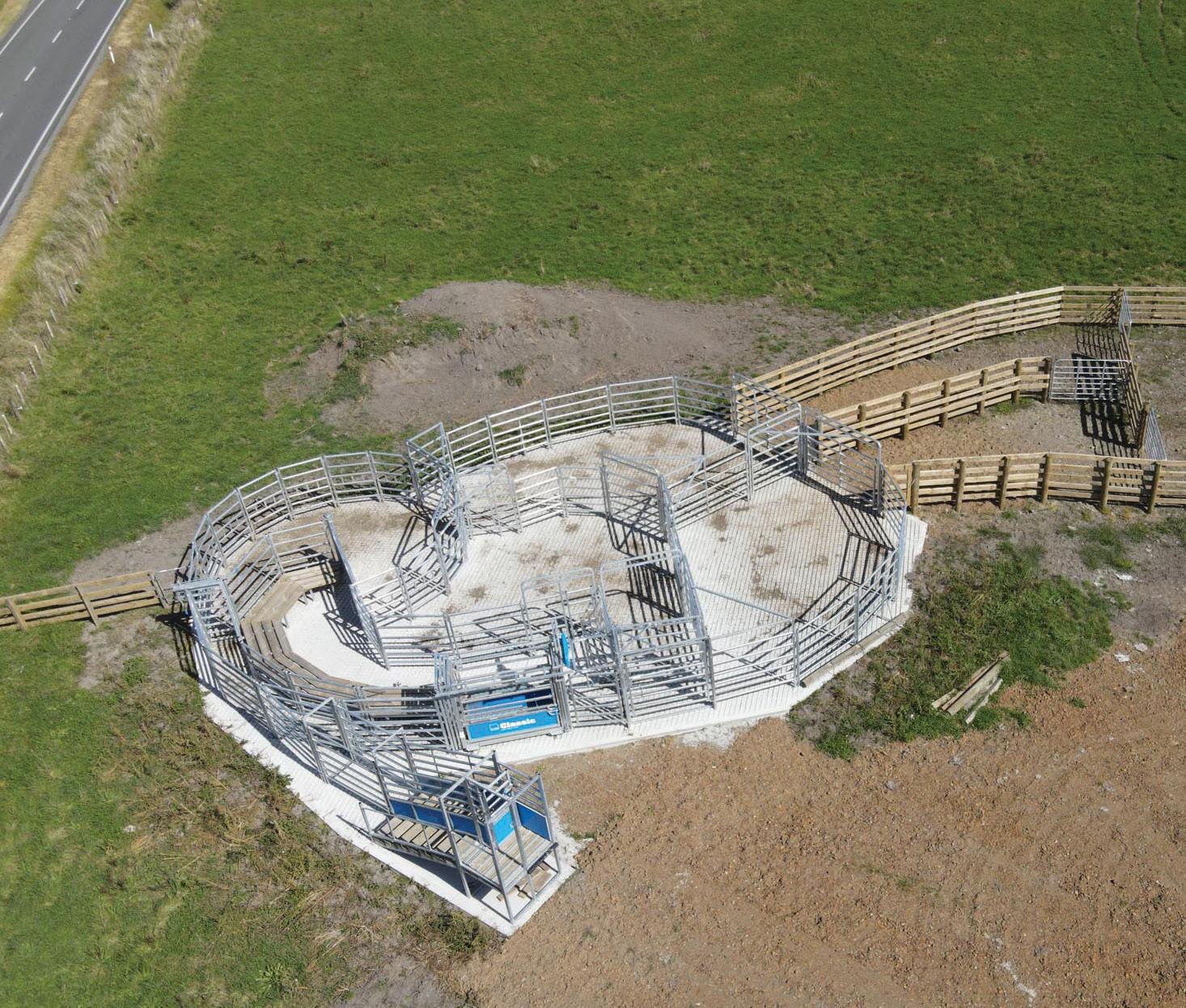
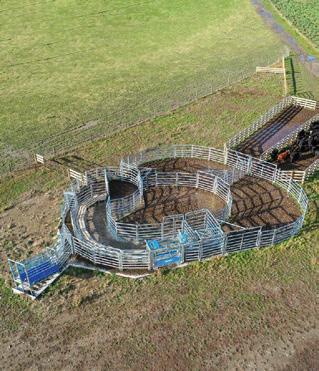


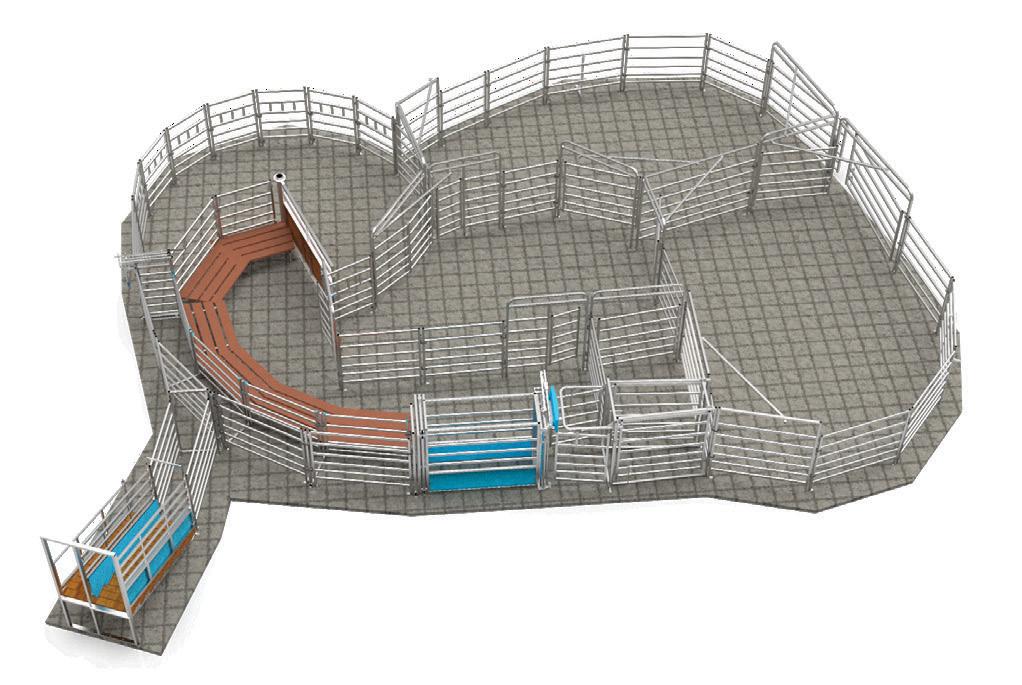
Country-Wide Beef | MAY 2023 115 Download our NEW priced ‘Popular Picks’ Yard Booklet at www.tepari.com WORLD-LEADING INTEGRATED LIVESTOCK HANDLING SOLUTIONS TOP 8 Cattle Yard Popular Picks The Te Pari SY107 Cattle Yard is a popular choice to make cattle work easy! With 4 pens and excellent drafting options this yard is an excellent design for finishing operations, handling approx 100 head. FEATURES •Super C-Force gate system •3 way drafting module •Curved race with catwalk •4 working pens •Slam latches on all gates Free Delivery to your farm! *Price excludes Loading Ramp & Cattle Crush. $47,323* Priced From +gst TE PARI MAKES CATTLE HANDLING EASY! POPULAR PICK! Call us on 0800 837 274 or visit www.tepari.com Yard Package SY107 A yard designed to handle 100 head effortlessly.
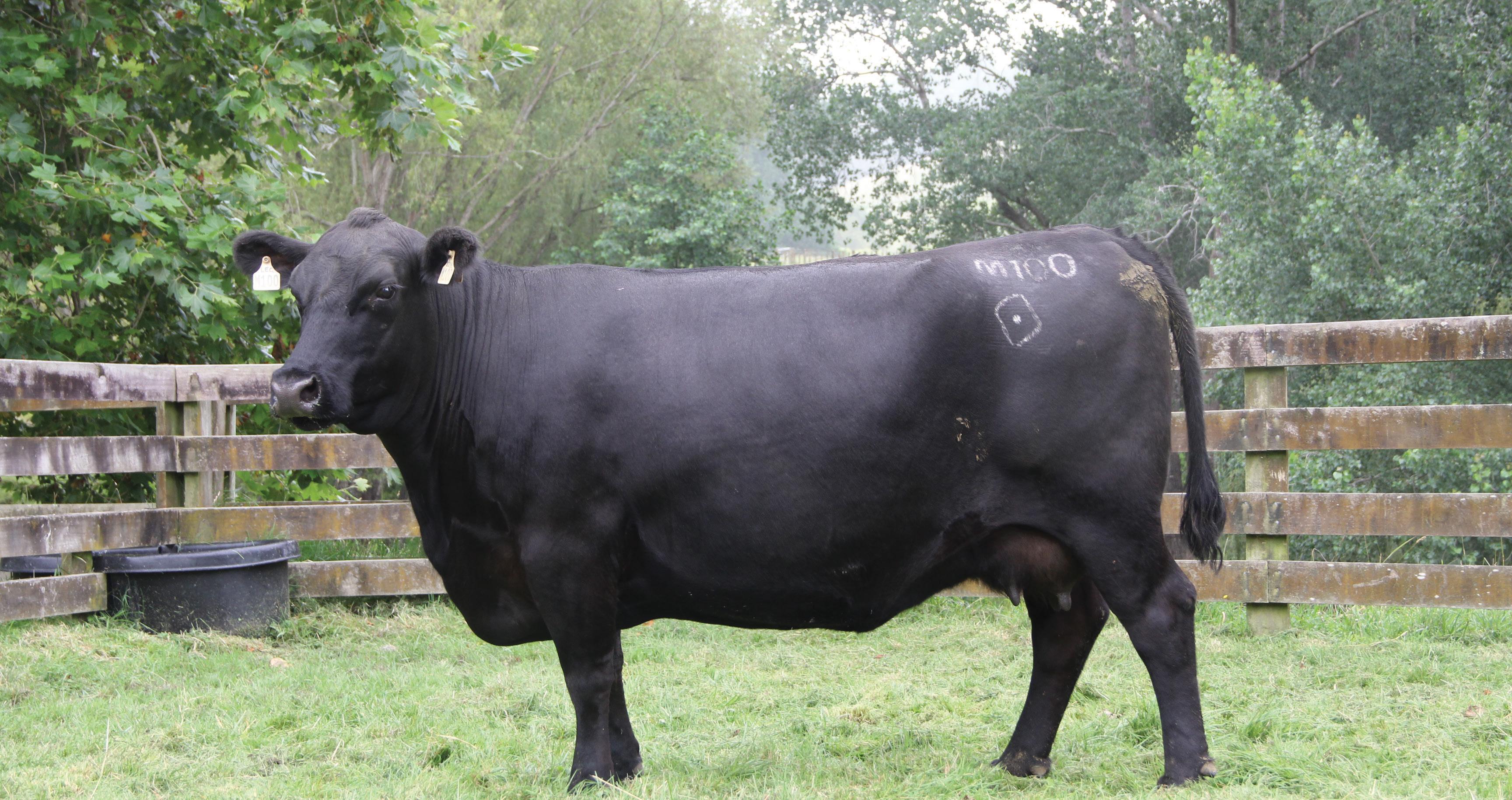


116 Country-Wide Beef | MAY 2023 Future proof your herd with 117 years of genetic excellence PAUL & SARAH WILLIAMS 06 868 6709 or 021 189 4114 | � turihaua@gisborne.net.nz � www.turihaua.co.nz | @turihaua ANNUAL SALE 3.30pm | Tuesday 27 June 2023 SPRING SALE 1.00pm | Tuesday 19 September 2023 Fertility | Structure | Temperament | Constitution Willy Philip 102 Laws Road, Dannevirke Ph: 06 374 8857 Email: anui @xtra.co.nz George Philip 923 Mangatuna Road Dannevirke Ph: 06 374 2861 ON-FARM BULL SALE TUESDAY 13TH JUNE 2023, 9.30AM 102 LAWS ROAD, DANNEVIRKE INSPECTIONS WELCOM E @AnuiStudLivestock JUSTIN & MEG KING 34 PAULSEN ROAD, TAKAPAU M: 027 248 8400 | E: justin@brookwood.co.nz www.brookwood.co.nz 13th JUNE 12:30PM TUESDAY BASIN RAINMAKER 4404 MUSGRAVE BLACKLOCH MATAURI CRIKEY TANGIHAU MAXIMUS KAHARAU 610 SIRES OF 2023 SALE BULLS INCLUDE:
CONTACT US TODAY
Mat Middlemass
Cattle/General Manager
M: 021 799 986
E: mmiddlemass@mountlinton.co.nz
Proven Under Pressure!
Tuesday 6 ON FARM BULL AUCTION th June 2023 commencing At 2pm | HYBRID & BIDR PLATFORM
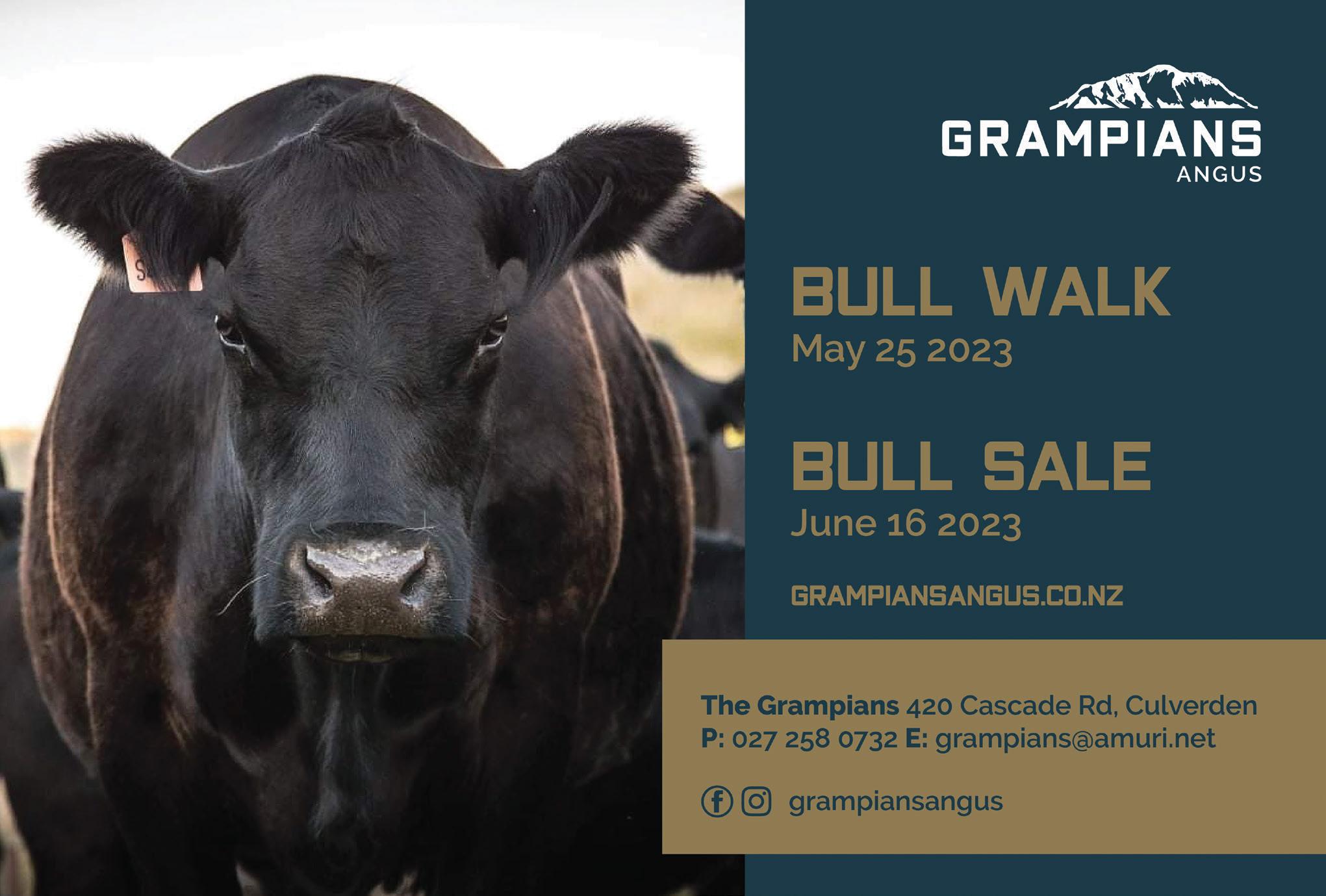
Mount Linton breed cattle that are fer tile and docile with a moderate maturity pattern and excellent carcass quality with high intramuscular fat, eye muscle area and positive rib and rump fat.
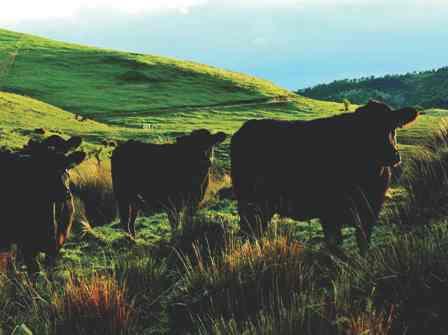
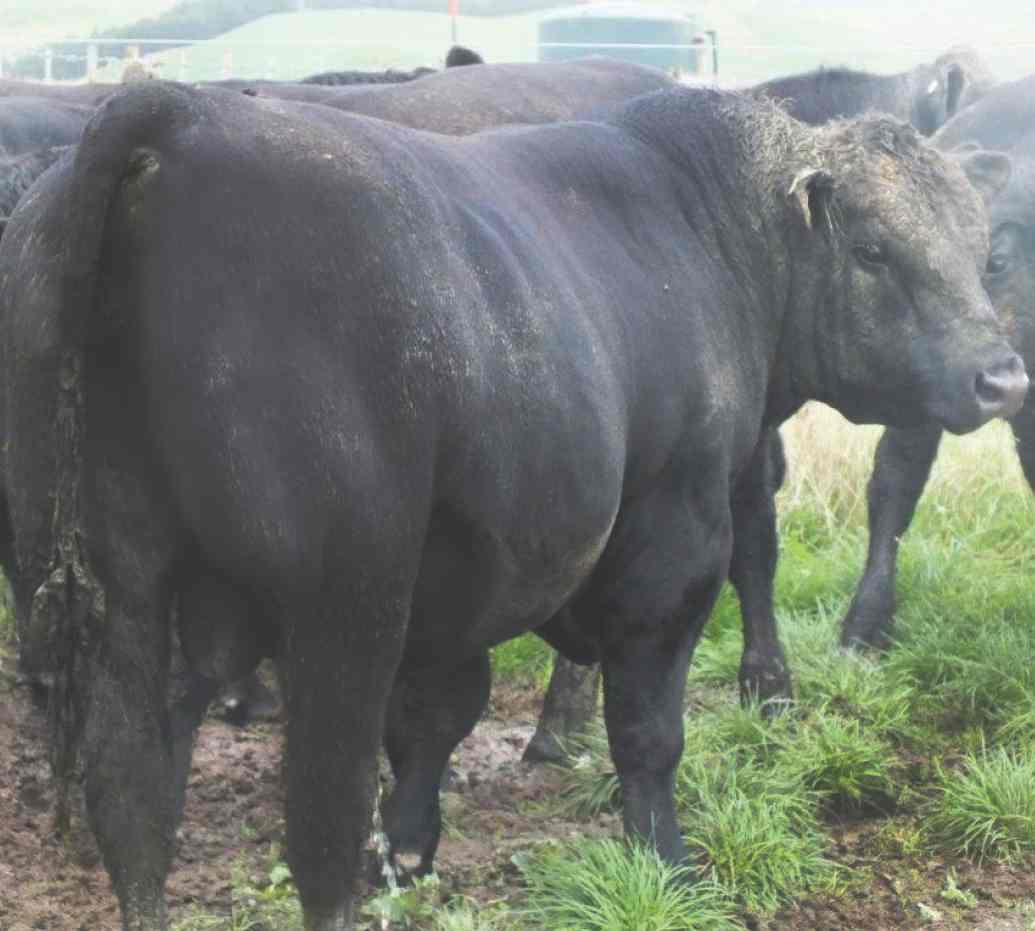
The best of both maternal and carcass charac teristics
YEARLING BULLS AVAILABLE IN NOVEMBER AND 18 MONTH BULLS IN JUNE
w w w.mountlinton.co.nz
Country-Wide Beef | MAY 2023 117
WAGYU WORTH THE WAIT
Builder turned farmer Duncan Robertson is into his third year breeding and finishing Wagyu beef on his Northland dairy farm.
By Annabelle Latz.
Photos by Malcolm Pullman.
Striking the balance between margins and quality is the goal when producing Wagyu beef.
Based at Kerikeri, Duncan Robertson breeds and finishes Wagyu, which he sees as a complementary addition to the family dairy farm.
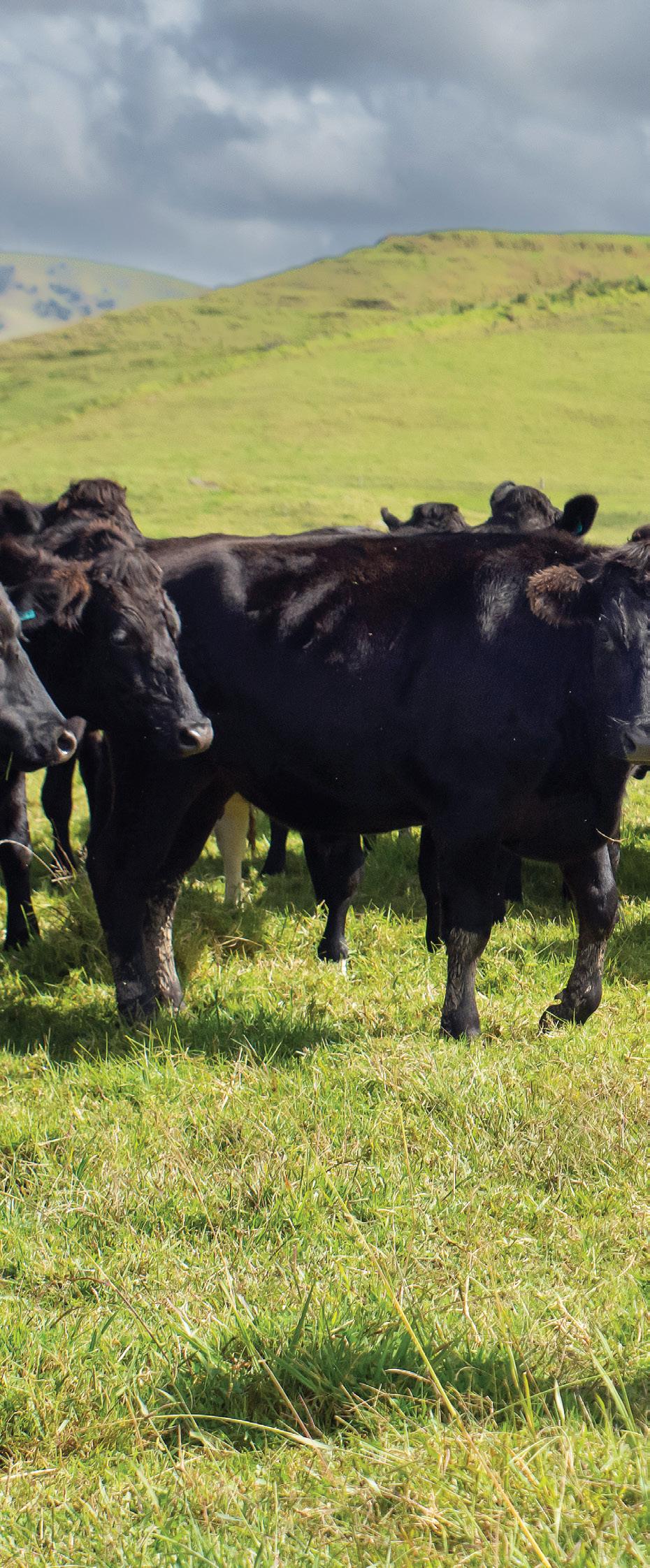
In February 2020 Country-Wide caught up with Duncan when his first Wagyu calves were on the ground.
Wind the clock forward three years and he reflects on last year’s inaugural cull, described as a hangover from a couple of summer droughts.
“We were a bit behind in weight. We sold them two or three months later than they should have been.”
This meant being heavier stocked for a while, but since then they’ve had a couple of summers with good grass growth and stock has been finished on time.
“It’s been the same for everyone around Northland, even the commercial beef farmers,” Duncan says.
The Robertsons do have the luxury
of having space to graze and produce a good amount of grass, and maize silage is fed out when there’s a pinch.
The dairy farm is 140ha, which is also used for rearing the Wagyu calves and other beef calves. They lease 170ha from Duncan’s in-laws across the road and have access to grazing blocks down the road when needed.
Amongst the Wagyu herd on the home block there are 89 R1 steers and heifers, 25 R2s (with an additional 97 out grazing on the lease block), and 271 R3s.
Despite the Wagyu breed being commonly known for its slower growth rate, those in the industry have methods to mitigate this.
It typically takes 28 to 30 months to finish Wagyu, compared to commercial beef which takes four to six months less. Talking numbers, that means on average 0.6kg LW/day for Wagyu, compared to commercial breeds’ 0.8kg LW/day. “That means 200g a day, and that adds up,” Duncan says.
This year he’ll be finishing 250 Wagyu,
and justifies the longer time in the paddock by the prime price he pulls. Typically he receives on average $1.50/ kg LW (including shareholder dividend) more than a commercial beef farmer, with the prices fixed after March 31 each year by First Light Foods, of which Duncan is now a shareholder.
Getting the recipe right
Producing meat for First Light Foods takes skill and time, and Duncan says putting a Wagyu bull over his Kiwicross or Jersey heifers is a good
118 Country-Wide Beef | MAY 2023
ONFARM
recipe, providing good hybrid vigour and growth. Crossing a Wagyu bull with straight Friesian or Angus does not provide the marbling or the taste.
“The cross I’m using means good growth rate, but does not sacrifice the taste or marbling.”
Putting Jersey in the mix also means a smaller calf, which means a lighter footprint on the grass and a fasterfinishing animal.
During winter Duncan breaks paddocks into roughly half-hectare cells and stocks at about 1000kg/ha.
He drafts animals two months prior to kill date, and feeds ad-lib maize silage in transportable troughs to increase the marble score.
He dedicates a couple of winters to do the job properly and finish the Wagyu to a high standard, but the rewards are reaped when he’s achieving above average marble scores and some of the tastiest meat on the hook.
Wagyu producers are graded between two and nine on a marble score, Duncan achieves 5.3, one whole score above average.
First Light Foods CEO Jason Ross says Duncan’s ability to breed his own calves and finish them delivers the best financial and meat quality outcomes.
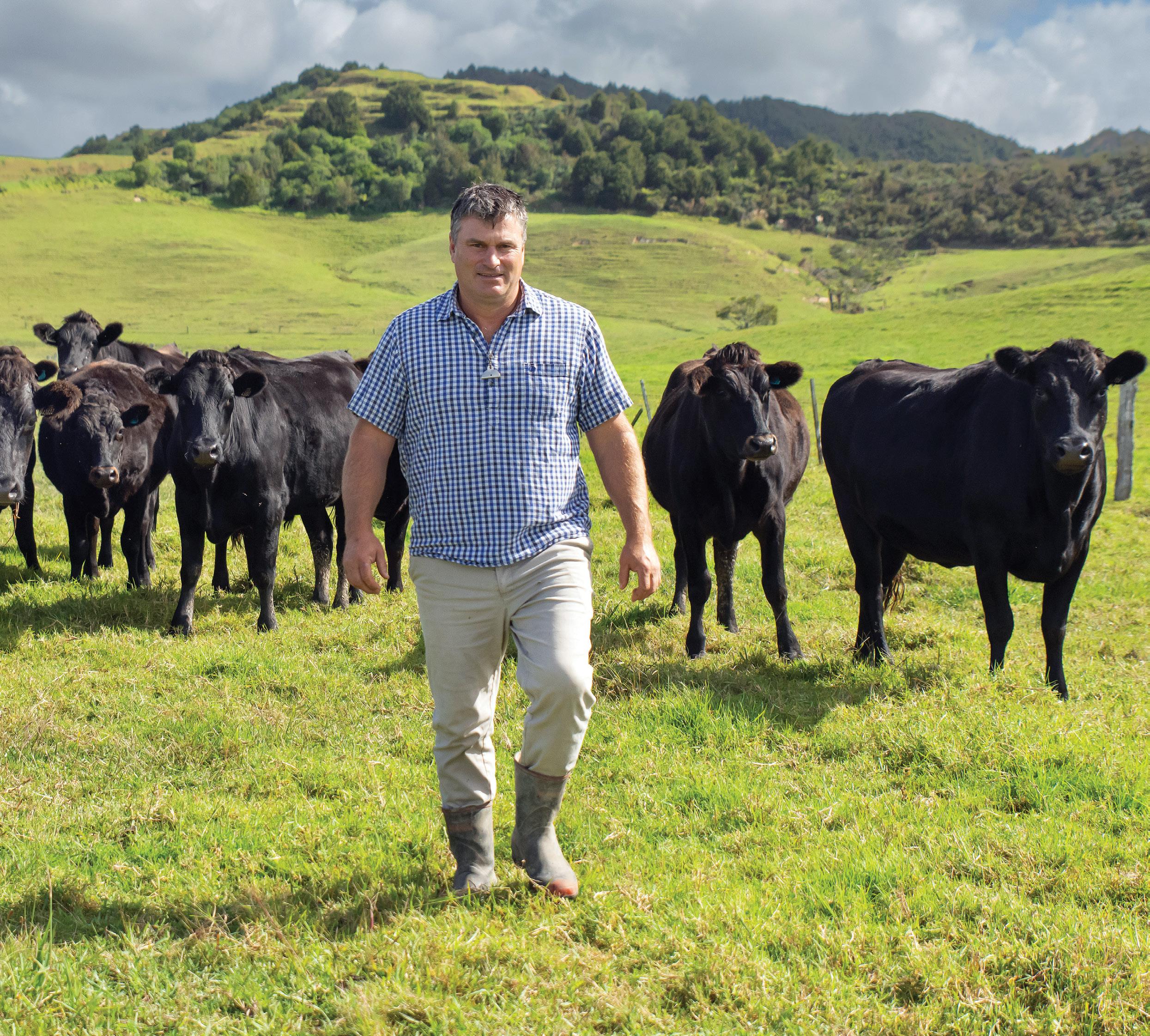
“We call it breed to finish, and it’s the ultimate model for us and the farmers.”
Jason says in the world of beef production, first comes bone, then comes meat, then comes marbling. Therefore, it takes time to finish any animal, and because dairy breeds have more marbling in them than traditional beef breeds, it’s the preferred cross.
“Grass-fed Wagyu beef is being
Country-Wide Beef | MAY 2023 119
This year Duncan Robertson will be finishing 250 Wagyu cattle.
finished properly, farmers are allowing the time on grass for the energy of the animal to produce the marbling.”
First Light Foods decided to cap their cattle count at 18,000 a year nationwide, backing up the company’s view that the focus across the agricultural industry worldwide should be quality rather than quantity.
“This is quite a big thing for us, and we aspire for these to be the most valuable cattle in New Zealand,” Jason says.
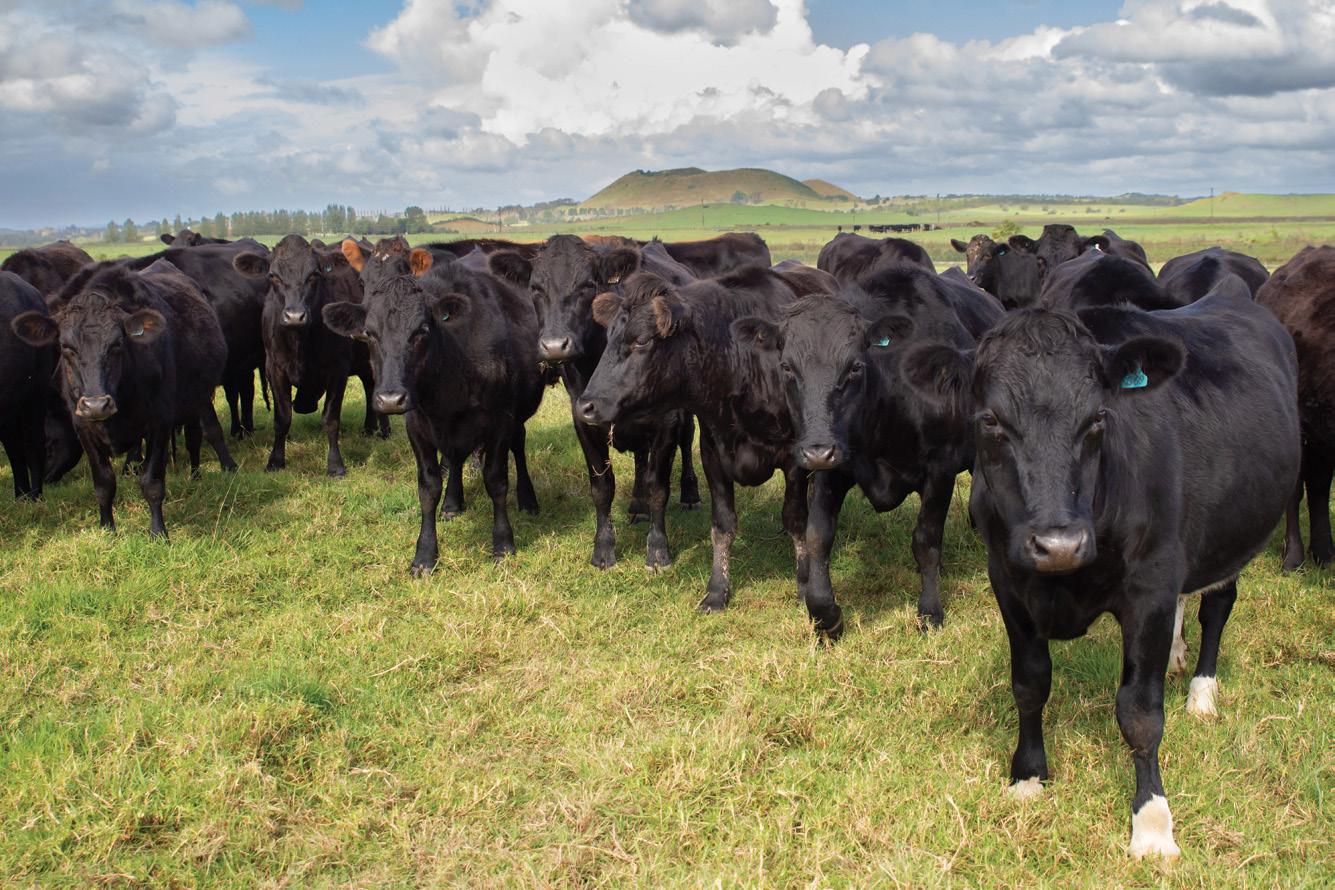
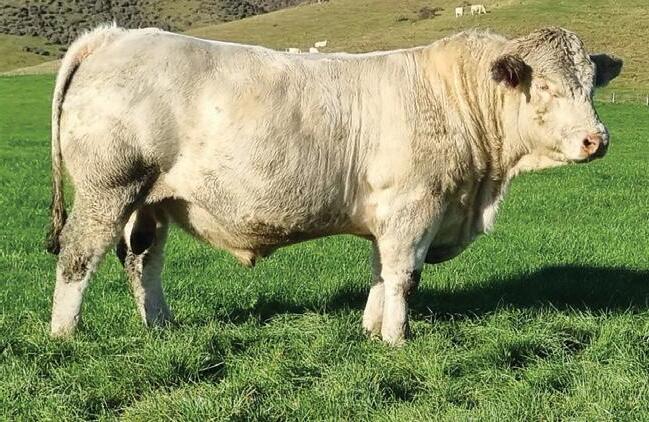

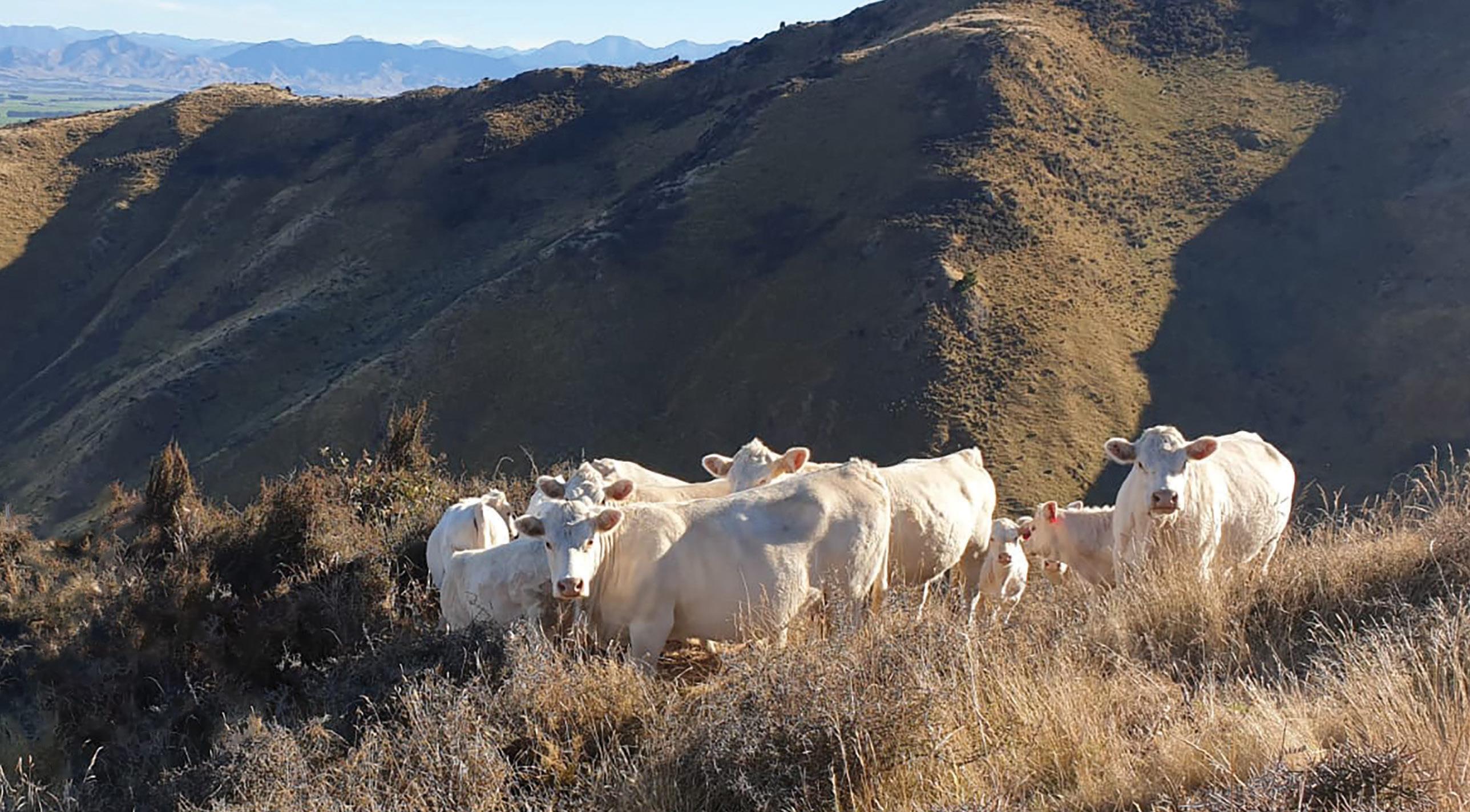
Effort and energy to maximise the value of the meat through a push for more online sales and increasing brand and retail presence is one focus, alongside investigating options for how to use the ‘fifth quarter’ of the animal, the parts that are traditionally deemed as waste.
Research is taking place in New Zealand around pet food (bones), vitamin supplements (offal), and
120 Country-Wide Beef | MAY 2023
HEMINGFORD CHAROLAIS • ROMTEX • SUFTEX • TEXEL 14TH ANNUAL BULL SALE Thursday 15th June at 2pm On Farm Auction, St Leonards Road, Culverden 60 Quiet, Grunty Charolais Bulls SAM HOLLAND Hemingford Culverden, M: 021 181 4868 E: vikiholland@amuri.net hemingfordgenetics
Hemingford Rough Justice (Poll)
FREIGHT PAID NATIONWIDE
Hemingford Rockafella (Poll)
In the background is Mount Pouerua pa. It was inhabited until about 1860 and when missionaries arrived in the 1820s they estimated more than 5000 people lived there.
collagen products (hide).
“If you are deficient in vitamin B12, you’ve been trained to take a synthetic capsule. But people are starting to question the ethics of this,” Jason says, adding that liver is the single most nutrient-dense product on the planet containing vitamin B12, iron, zinc, vitamin A and a host of other micronutrients.
This research started 18 months ago and products will be rolled out in the US, initially to First Light Food’s existing retail customers.
Jason says if farmers are being encouraged to have fewer animals, it is First Light Food’s mission to protect their income and the fifth quarter concept is an answer to this.
“We need to be in a position to give farmers more money.”
Back on the dairy farm, Duncan has reduced dairy replacement matings by using sexed semen over the top third of his dairy herd.
The technology has been available in New Zealand for about a decade as frozen and fresh semen, with fresh semen being available in Northland for the past couple of years.
Duncan has experienced good replacement numbers for his dairy herd, which reduces the number of bull calves, due to the 90% guarantee of a heifer calf. This means he now has more cows to mate for producing high quality beef.
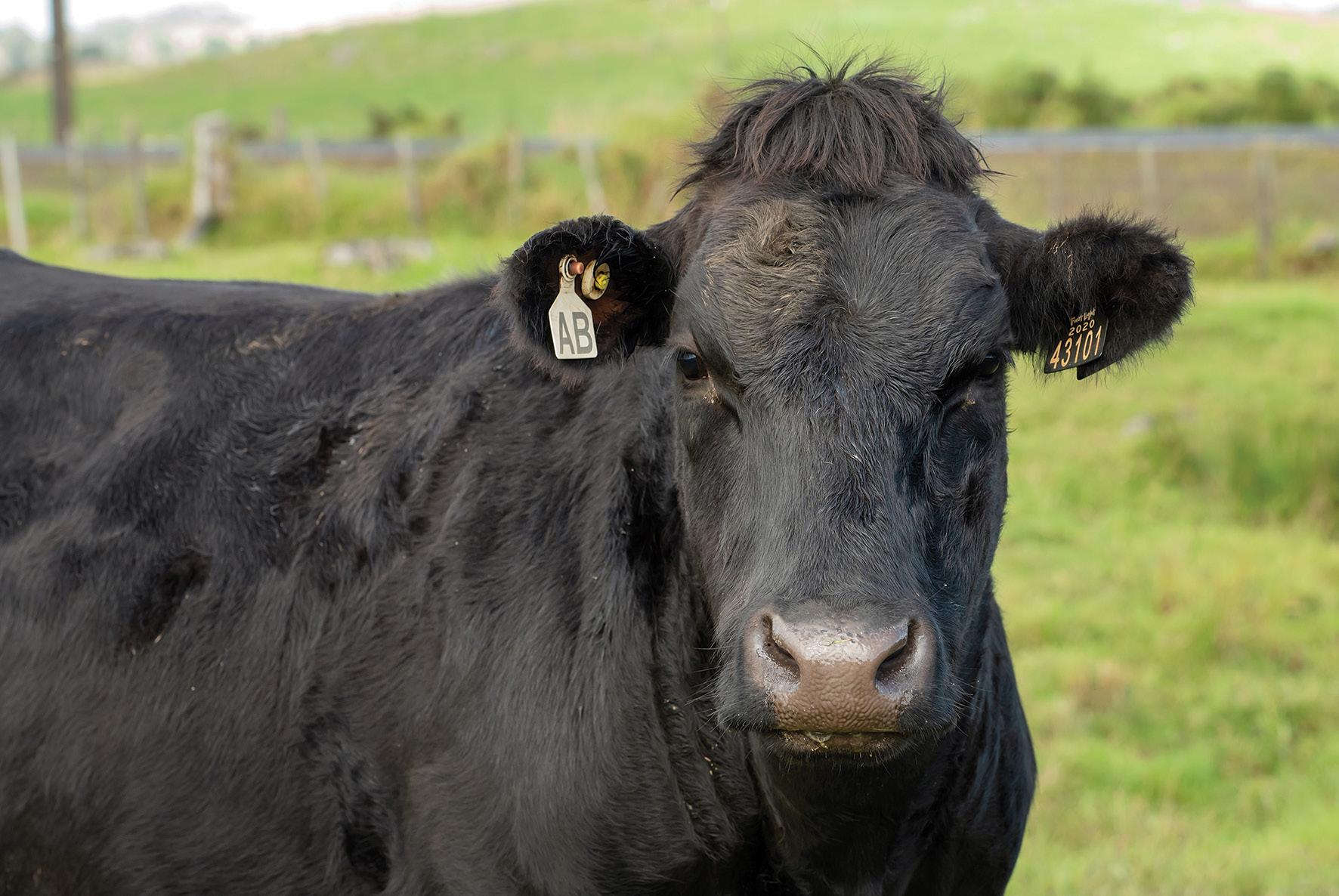
Mixing it up
Wagyu is used across the more Jerseyblooded cows, and Charolais over the more Friesian cows. He uses natural mating of Hereford bulls to mop up the rest, “as a colour code”.
This technology costs twice as much, but the investment is worth it. Duncan ends up with a good number of replacements and beef calves worth $200, rather than a Kiwicross/Jersey bull worth between $20 and $30 as a four-day old calf.
“It means all our calves have a valued end use.”
He’s running 52 R1 Charolais steers and heifers, 53 R1 Hereford steers and heifers, 21 R1 Jersey and crossbreed bulls, 15 R2 dairy cross steers, and 79 R2
Hereford steers and heifers.
Running a comparative eye over them, Duncan says Charolais are ahead on size compared to the Herefords.
“We now have a lot more good quality beef animals from the dairy farm because of this.”
He’ll be finishing 180 Charolais/ Herefords this year, on par with other years, but given the very wet winters and dry summers over recent years these
numbers have fluctuated a bit.
Last winter was particularly wet, which brought its own challenges with stock management and trying to protect the farm from pasture damage, but overall things are looking positive on the farming front for Duncan. He’s looking forward to finishing more quality Wagyu, and his decision to terminate his building career in 2016 and commit to the Wagyu industry is one he does not regret.

Country-Wide Beef | MAY 2023 121
Top: Maize silage fed to Wagyu in last couple of months to help with finishing and marbling of meat, stored in a plastic tube to help keep the feed quality. Above: Animals that have been treated with antibiotics can’t be sold into some markets.
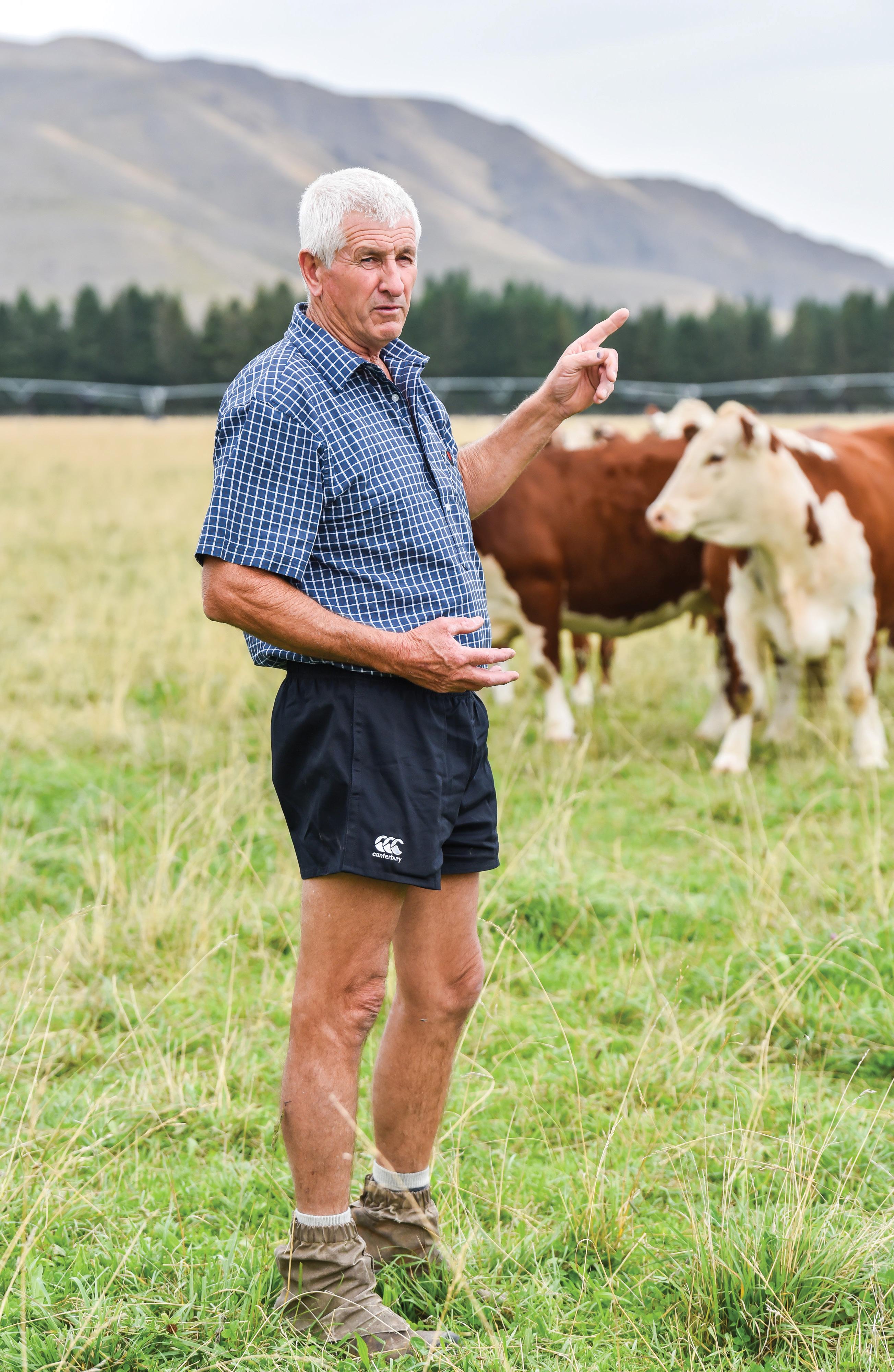
122 Country-Wide Beef | MAY 2023
Haldon Station manager Paddy Boyd has a long and strong focus on proven genetics.
POWER OF A DATABASE UNLEASHED
A decision to invest in data for top genetics 52 years ago has paid off for a South Canterbury station, Terry Brosnahan writes. Photos Chris Sullivan.
Haldon station’s genetic breeding programme, Genepool, is one of the largest Hereford beef genetic databases in New Zealand.
Station manager Paddy Boyd says that’s its greatest strength. He says the aim was to breed high-performing bulls for the country they were being sold into.
Haldon and 15 other stations formed a genetic programme with up to 30,000 cattle recorded. Most of the stations were commercial operations with genuine beef-type country. Today the nucleus herd is based at Haldon, with a few other herd owners still recording.
“Way back then we were buying bulls which weren’t lasting, nor were their progeny.”
It was about identifying cows weaning above-average calves which then could get back into calf every year. That was the main breeding objective farmers were after.
The key traits are low birthweight, high-growth rates, fertility, and fecundity. Temperament was a doubtful trait when Paddy joined Haldon in 1982, but it’s now sorted. The maternal cows and all progeny are observed and ranked 1–5 on temperament.
When the bull sale is held on Haldon, the bulls are displayed in the sheep yards;
a testimony to their docility.
“I’ve always put temperament at the top end, mainly for staff safety,” Paddy says.
Genepool was started in the 1970s to find good proven Hereford genetics for commercial use.
After James Innes left Lincoln College, he worked for Hugh Irving at Wairaki Station. James and Hugh were unconvinced of the genetic potential of the bulls they were buying. They had better performing cows weaning top calves in their own herds. They wanted scientific data behind the breeding and so did other farmers.
Haldon and the 15 stations with big commercial herds grouped together and started selecting high-producing cows. Once they identified those cows they formed Genepool with the nucleus herd later based at Haldon. James came home later to run the programme and eventually take over the station.
Haldon was selected because of its tough environment, down to -20C and up to 40C. If the cows could survive and perform at a high level, they could survive anywhere.
Genepool then searched across NZ studs for top Hereford genetics. They bought mainly semen and artificially
inseminated the cows, then started recording them and their progeny against each other.
When Paddy came to Haldon in 1982 as stock manager, James put him in charge of putting together the database for Genepool Herefords.
There were stacks of data on excel sheets but no computer analysis, but pencil workings on the excel printouts. “It was limited data and meant a lot of pencilled copies…”
Paddy knew a comprehensive database could be done, as they were weighing several times a year and analysing calf weight gains. They also weighed the maternal cows and recorded other traits such as udder conformation, structural scores and fertility.
“This is where the multi-trait came from.”
When Paddy arrived, there was so much data in the shed, the only way to do analysis was to pull it all out and spend days going over it.
“It was just impossible as the numbers built up.”
There were about 40,000 animals recorded across the herds. Now there are 41,000.
Paddy says the cattle have all been cross-referenced, with a reference sire
Country-Wide Beef | MAY 2023 123
GENETICS
used every year. That’s why it’s much easier to have one herd, because if they were split herds, unless they used some semen from a previous sire, they couldn’t take out the climatic difference.
“You had to have a reference sire from the previous year to have accurate data.”
In 1986 all the data was sent to Colorado State University which had a computer big enough to analyse all the data.
After several years, the analysis work was brought back to NZ. Genepool contracted with Dr Leyden Baker in the genetics section of MAF Ruakura who masterminded the collation and analysis of data. He entered the data into a computer program which made best linear unbiased predictions (BLUP).
The power of the data was finally unleashed.
BLUP uses the information to make accurate predictions of an animal’s genetic merit (estimated breeding values). Over the years the database has evolved and computer software has improved.
Ruakura’s Dr Neil Cullen now collates and analyses Genepool data.
It’s an across-trait analysis that makes sure there are predictive values on all the breeding traits.
Paddy says Genepool achieved James’ objective. The bulls and females they go to buy now have estimated breeding values, highly predictable and accurate. They now have across-trait analysis across herds, not just recorded within a herd.
It made the cattle stud industry start multi-trait analysis rather than focussing on a single trait like weight gain.
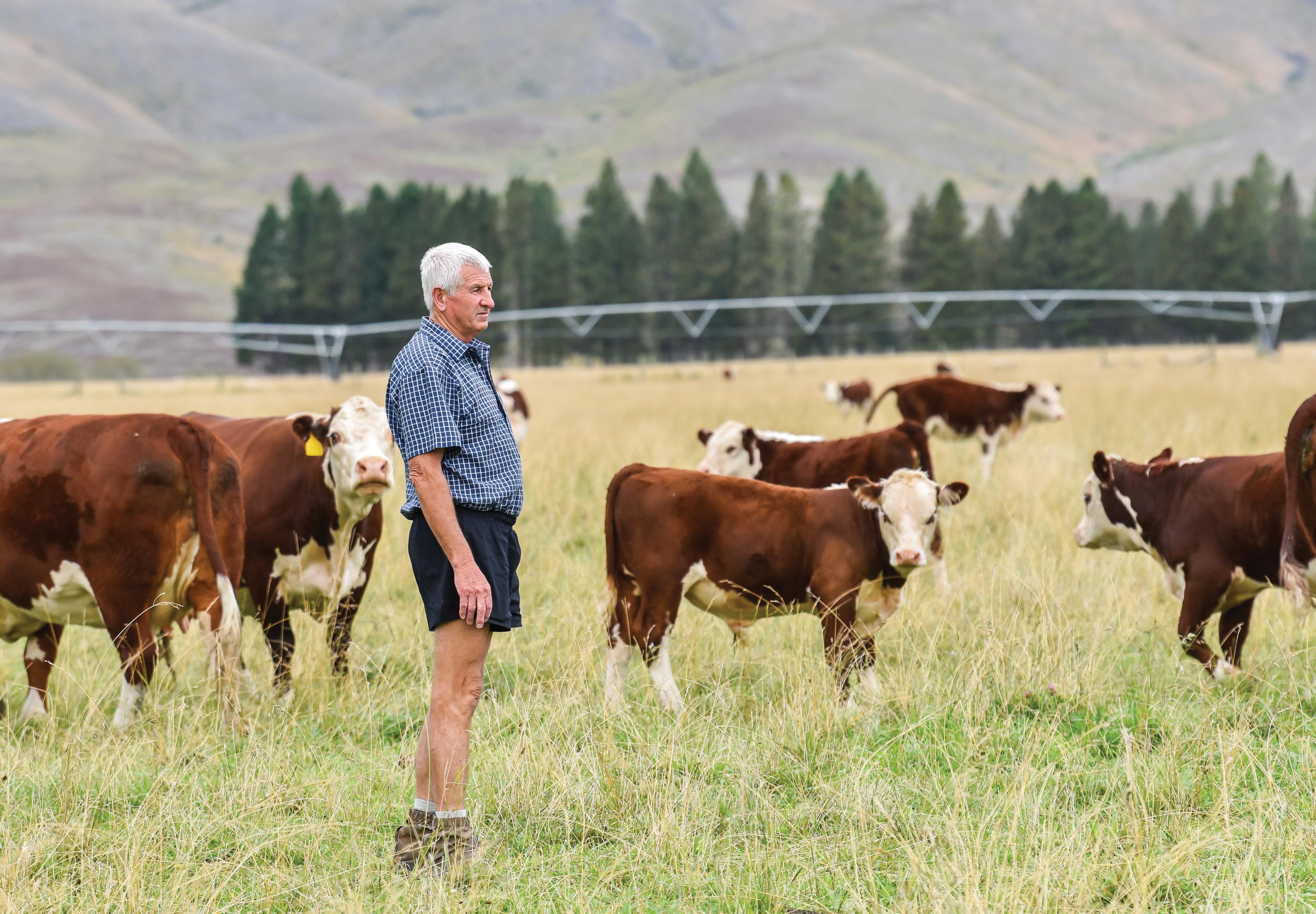
In the early years Genepool bought a lot of semen from the USA and Australia. It was never used straight away on the Genepool herd but put into average cows and progeny-tested them against other recorded bulls.
After 41 years tagging calves, Paddy is an expert. “I’ve just about tagged every day of calving as we do it three times a day.”
Haldon started using bronze then brass
tags. They still use the brass tags because they’re easy to carry when tagging three times on a cold wet day.
“It’s a little clip, one click and it’s in.”
They are there for life, but hard to visually read. As the calves get older they have to use a head bail when weighing to read the tags. So the calves end up with three tags – brass, visual and NAIT, all on the database. NAIT has made it easier because of technology, with all animals having lifetime data immediately available.
“If one ever falls out we still have references.”
The NAIT tag is the only electronic one.
“It’s so simple, I just grab a wand and wave it over their heads…all the data is there...”
Cornered the dairy cow market
Genepool’s low birthweight bulls have been used by Livestock Improvement Company (LIC).
In the 1980s and 1990s the low
124 Country-Wide Beef | MAY 2023
birthweight, fast growth rates and fertility won Genepool the contract to supply LIC with all the Hereford semen.
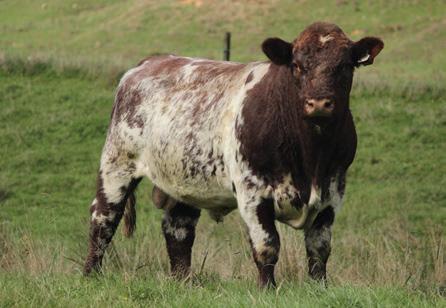

“The only reason it was stopped was because Haldon wasn’t a stud.”
Haldon’s yearling bulls are now sold to repeat dairy farmer buyers each year. The top 20–30 bulls selected on figures and structure are retained and sold at the on-farm sale in early June.
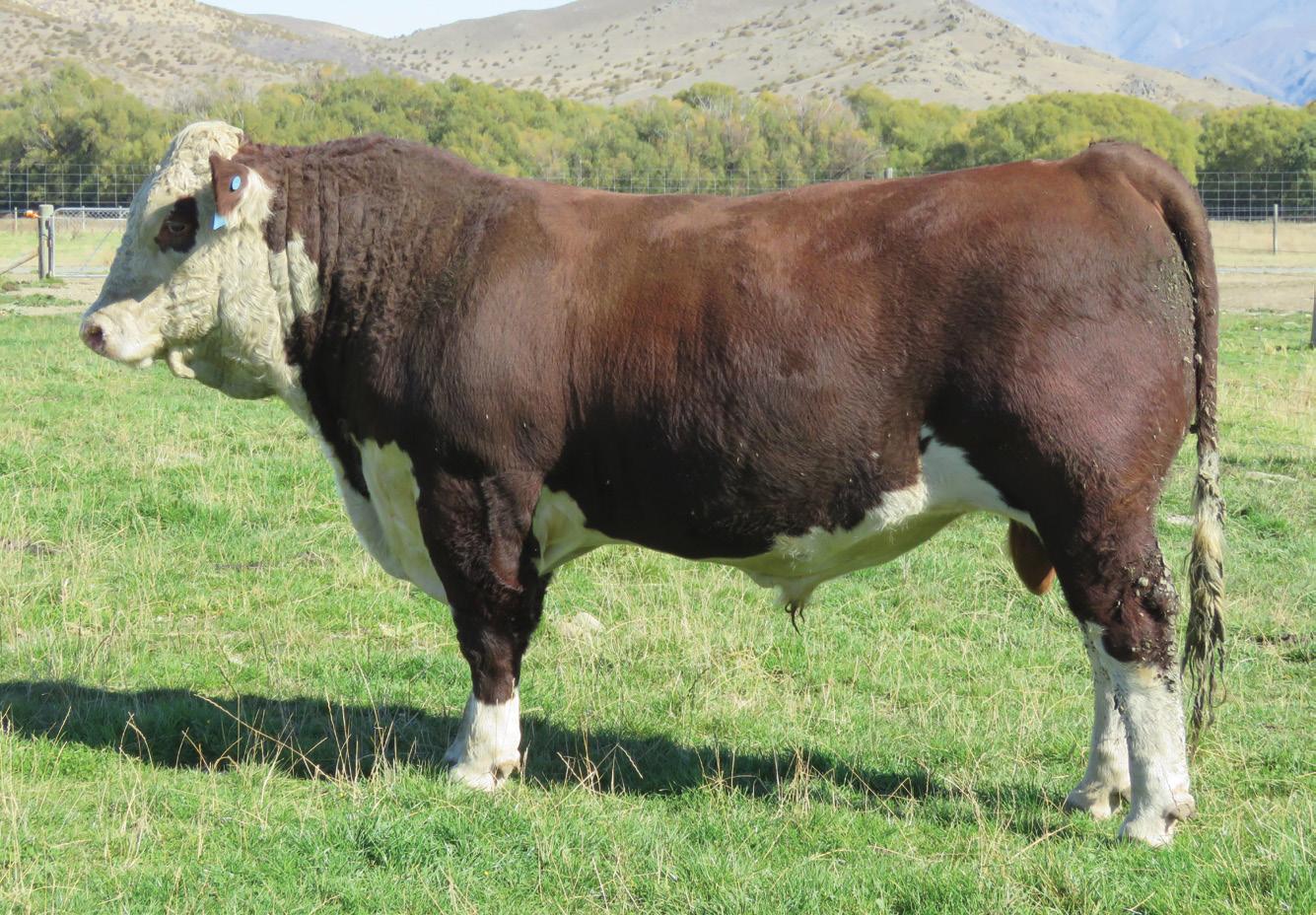
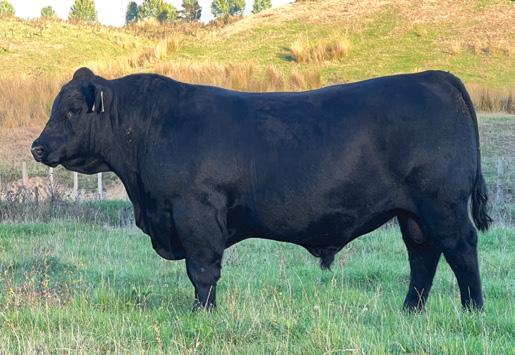
Industry focus on polled cattle means the horned cattle are disappearing, which saddens Paddy because they have proven to be the hardier cows. “We multi-trait recorded them and horned cattle were in the top group.”
Haldon has 400 Hereford cows and 150 Angus that are fully recorded. The station retains all heifers until 18 months old which gives accurate growth rate data back to the sires.
Retaining so many may be seen as a burden but the cattle are well-used as a tool for pasture management, tidying up behind the sheep.
This year the 22,000ha station will winter 6800 deer, 6500 Merinos, 3000 Border Leicester-Merino cross ewes and 3000 hoggets, 1200 Hereford and Angus cattle including breeding cows, replacement heifers and younger stock.
Irrigation has changed the management of Haldon, which Paddy says he originally didn’t sign up for. Nine
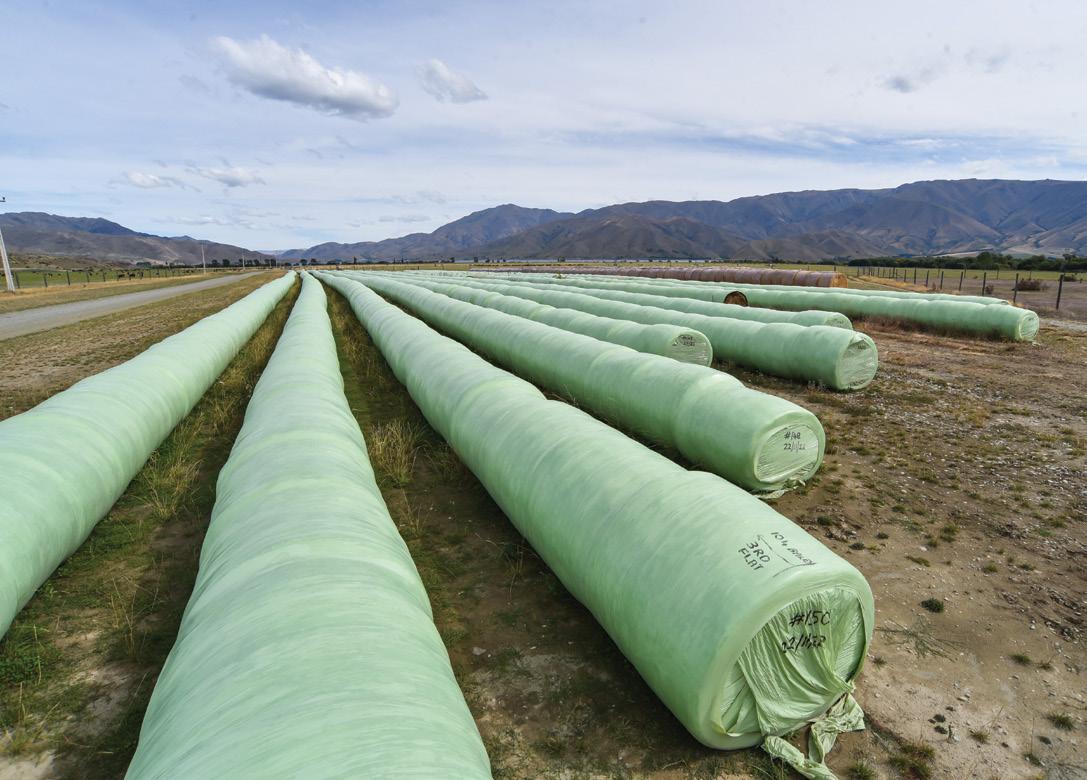

Country-Wide Beef | MAY 2023 125 BULL SALE DATE 30th MAY AT 3:30PM. ANNUAL ON FARM AUCTION HELD UNDER COVER.
Colvend Angus established in 2016 on females from the Oakview Stud. Colvend Shorthorns established in 2000. Successes at Beef Expo 3 Supreme Champion bulls and 2 Reserve Champions.
Colvend
ALAN & VAL PARK p: 07 894 6030 | e: colvendfarm@gmail.com Located off state highway 4. 841 Tapuiwahine Valley Road,
BVD tested free. TB C10
Shorthorn & Angus Stud
Ongarue, Taumarunui 3997.
“The only reason it was stopped was because Haldon wasn’t a stud.”
Left: Haldon’s irrigated 950ha grows pasture to finish cattle, deer, sheep and make supplements. Below: Ready for action, Genepool 173-18.
23RD ANNUAL ON FARM SIMMENTAL BULL SALE
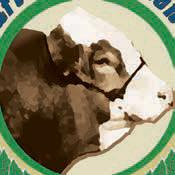
11AM
WEDNESDAY
24TH MAY 2023
MODERATE SIZE CONFORMATION

DOCILITY MUSCLING EMA AND IMF




LOW BIRTHWEIGHT AND CALVING EASE
EXPLOSIVE GROWTH FERTILITY TESTED ALL BULLS ARE DNA TESTED
35th Bull Sale
New reference Sire Imp. Canada


“GRINALTAS HP SENSATION”
BEEF FARMERS: Join the rush – buy a GLENANTHONY SIMMENTAL BULL this year for:
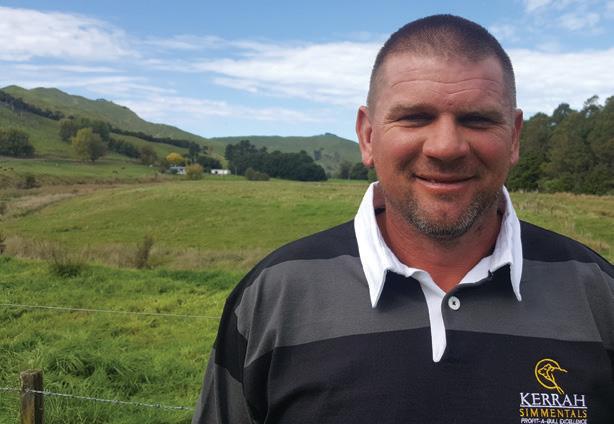
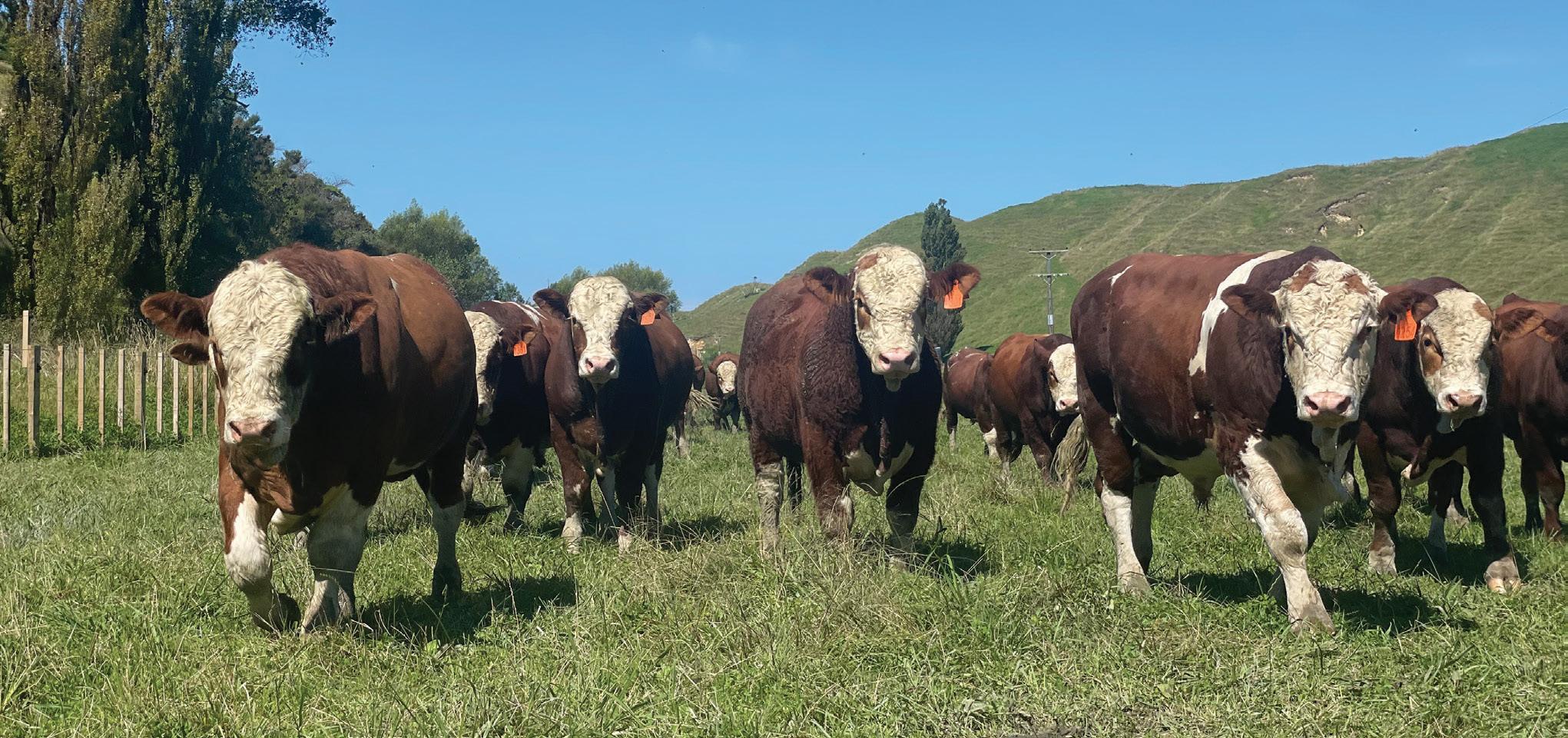
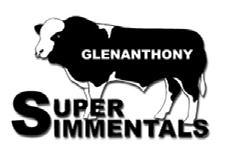
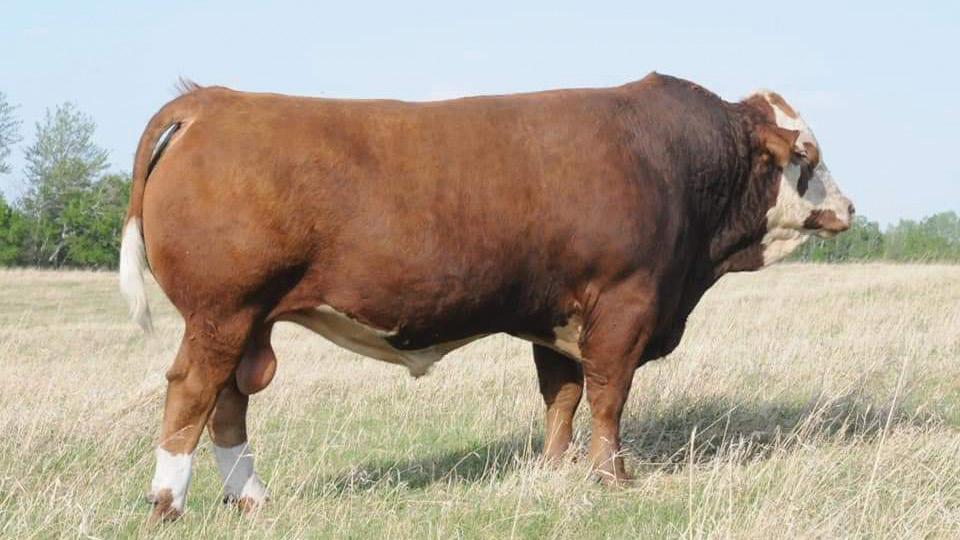
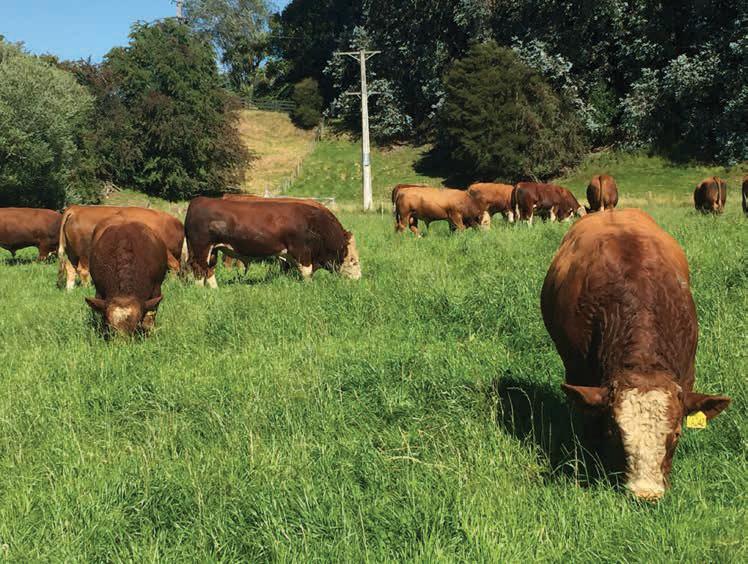
Extra liveweight at weaning
Extra liveweight at finishing!
Less feed, less cost, less fuss!
All bulls semen and service tested, BVD tested and Vaccinated
35th Bull Sale on farm
825 Farm Road, Waipukurau
12.30pm, Thursday 8th June, see you there
Rapid 235, Wairongoa Rd RD2 Mosgiel, North Taieri 9092, Otago

• M: 027 248 5024
• H: 03 4897521
• E: e.strauss@xtra.co.nz

Enquiries to Tony Thompson ph 027 280 6148 Watch for the catalogue www.glenanthony.co.nz
1447 Hereheretau Rd, RD 6, WAIROA 4196 www.kerrahsimmentals.co.nz
PROFIT-A-BULL
POLLED80+PERFORMANCE
126 Country-Wide Beef | MAY 2023
EXCELLENCE
Contact
for Catalogue Info: Jon Knauf 06 838 6793
E:
jsknauf@gisborne.net.nz Phil Transom 0274 420 060 PGG Wrightson Ross Mitchell 0274 048 965 Fergus Rural
EIGHTH ANNUAL ON-FARM AUCTION Tangiwai Station, Wairoa • 1PM, Tuesday, 23rd May 2023
Jon Knauf
BULLS FOR AUCTION Winners of the Steak of Origin 2018
“Where Performance Meats Phenotype”
centre-pivots have gone in over the past 15 years.
The irrigated 950ha on Haldon enables Paddy and staff to look after the rest of the station.
It grows pasture to finish cattle, deer, sheep and make supplements.

With irrigation they can finish 5000 first cross lambs, 3000 fawns and 300 cattle.
Barley is being grown on the irrigated land as a break crop for two years and to lower supplement costs. About 50–100ha/year is sprayed out and renewed.
None of the 250ha in lucerne is under irrigation. Originally lucerne was to be irrigated to guarantee four or five cuts, but land area is not a problem and lucerne performs well in the dryland valleys. In April the station was flush with lucerne with fawns and lambs flatout eating it.
Lucerne stands have good longevity of 20–25 years, one of Wairau’s paddocks is 35 years old. A common cause of replanting is rabbit damage. Despite rabbit fencing, some stands have so many rabbit holes they wreck the haymaking equipment.
When lucerne is ripped up, ryecorn is grown as a two-year break crop.
Paddy used to use a renovator Mark 3 for drilling but now uses a contractor with an Allen direct drill. With seed expensive, they are down to 8–9kg/ha. About 150kg/ha of lucerne fertiliser, with some molybdenum and boron is used.
Lucerne requires sulphur all the time and
the soil pH needs to be at least 6.2. The two years in ryecorn gets the weeds sorted before planting. If fathen and some weeds grow, they leave them for the first grazing or cut.
Paddy says the secret is not to be tempted to get on the lucerne too quickly.
James Innes put in borderdyking which was well before its time. With consents for borderdyking unlikely to be renewed in 2025, Paddy has put in centre-pivots. The irrigated land is virtually a farm on its own.
Haldon has three water sources for irrigation: a stream, the lake and deep
wells. Even though the water was at 18–28 metres at the time, they had to go to 60m because Meridian claimed ownership of the water, above what is deemed to be hydraulically linked to the lake.
Paddy says when ECNZ renewed its 25-year water permit a clause was left out which allowed anyone access to water. A group of farmers in the Mackenzie Basin, including Paddy, challenged it in court, and they won.
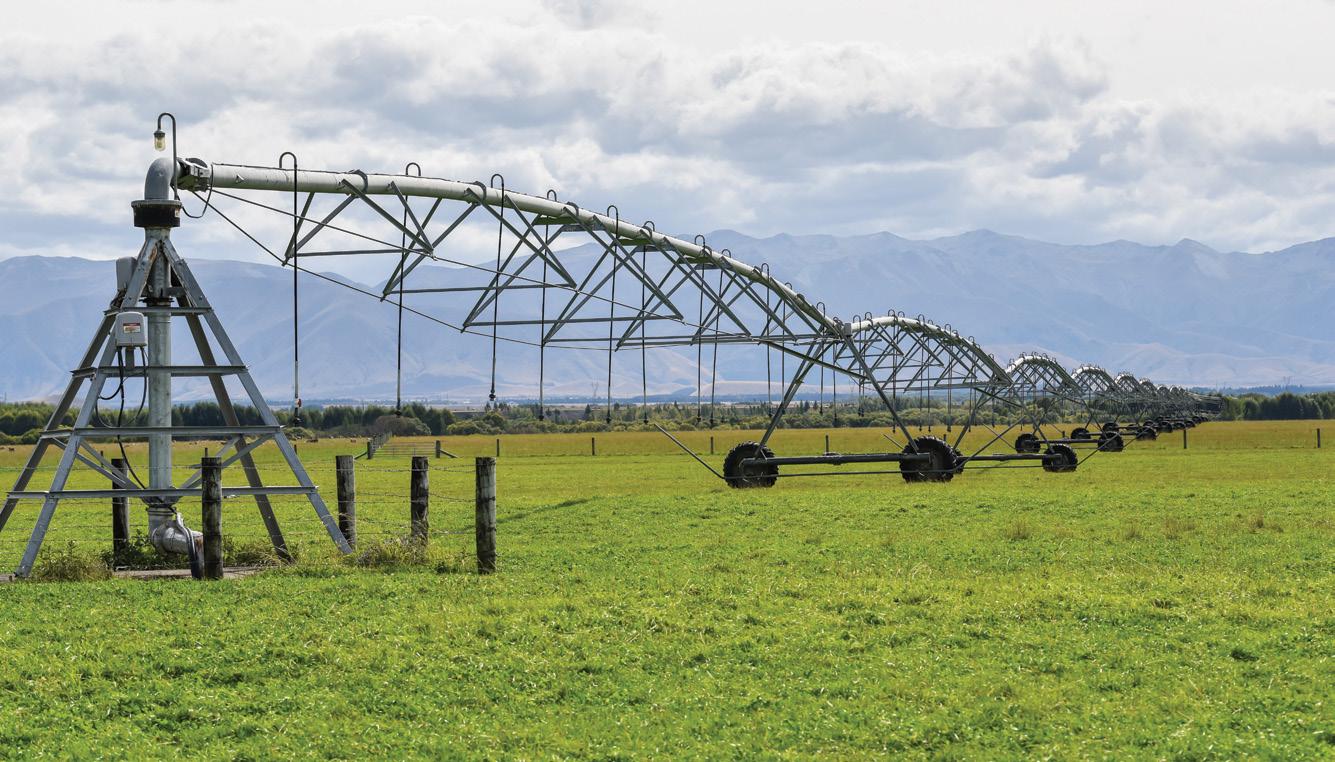
Now anyone has the right to access the water, but needs to go to Environment Canterbury, the regional council, for the right to use it and the local council for land-use consent.
The farmer group received no compensation for its costs.
Paddy says it is important to have irrigation in some areas, but it is not suitable everywhere.
There has been opposition to development in the area, but Paddy says only 3% of the Mackenzie Basin flat area is under irrigation.
He says irrigation is imperative to let the stations stay economically and environmentally viable to allow for good, sound land management.
Country-Wide Beef | MAY 2023 127
+ Read more about Paddy Boyd and Haldon Station in the April issue.
Above: Cows in the the back hut yards on the station. Below: Haldon has nine centrepivot irrigators.
BREEDING BULLS SINCE 1949
Tangihau Angus Annual Bull Sale
June 26, 2023
12 PM
Paddock viewing available from 10 AM
Tangihau Angus Bull Complex 119 Taumata Road, Rere, Gisborne


Please note the change of sale time above.
Studmaster Dean McHardy | +64 27 242 5321 | tangihau.station@xt ra.co.nz
www.tangihauangus.co.nz @tangihauangus
TWO YEAR BULL SALE
WED 21 JUNE AT 1PM
VIEWING FROM 10AM
290 CONWAY FLAT ROAD, PARNASSUS
WILL WILDING: 027 826 4015
www.temania.co.nz

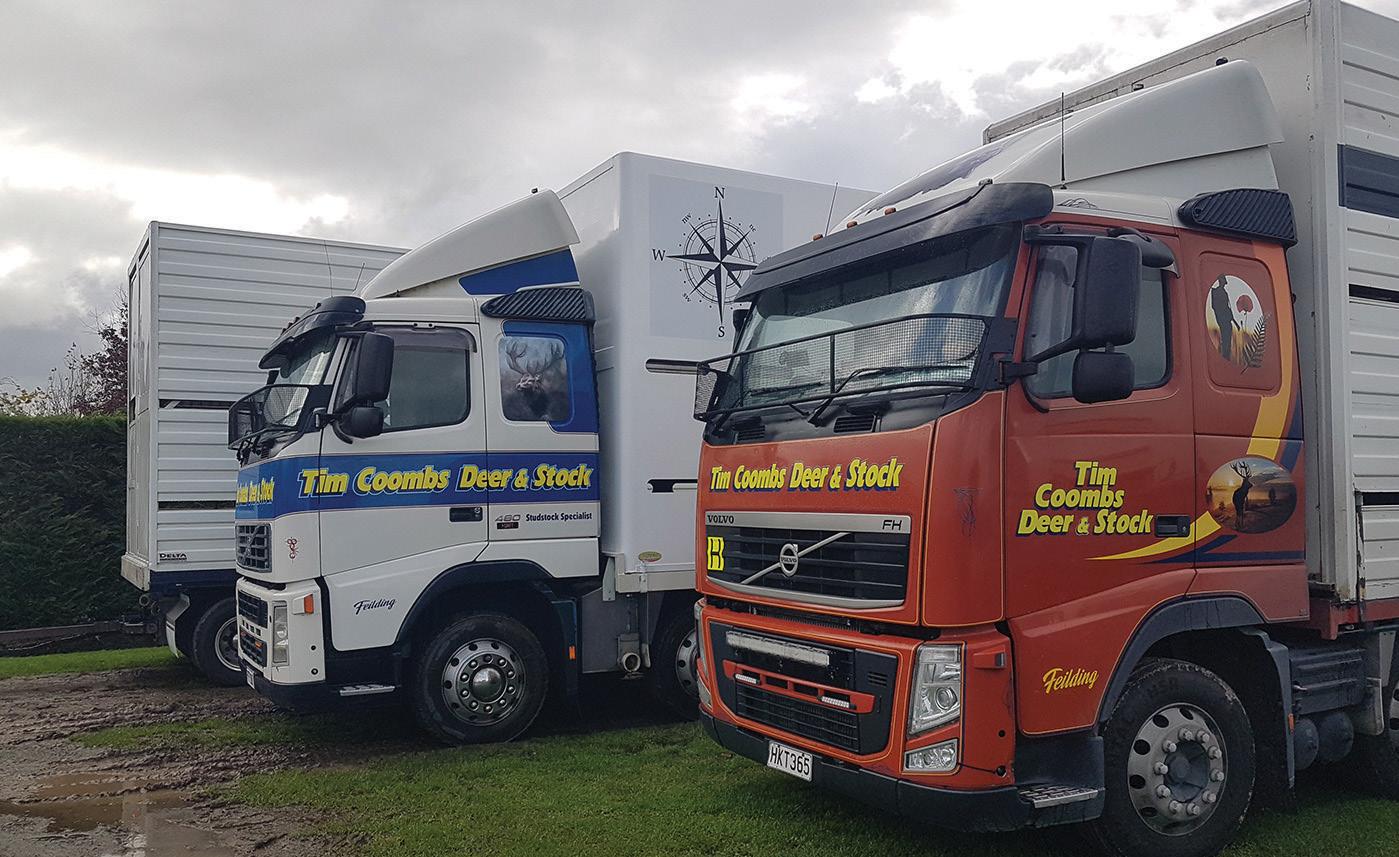
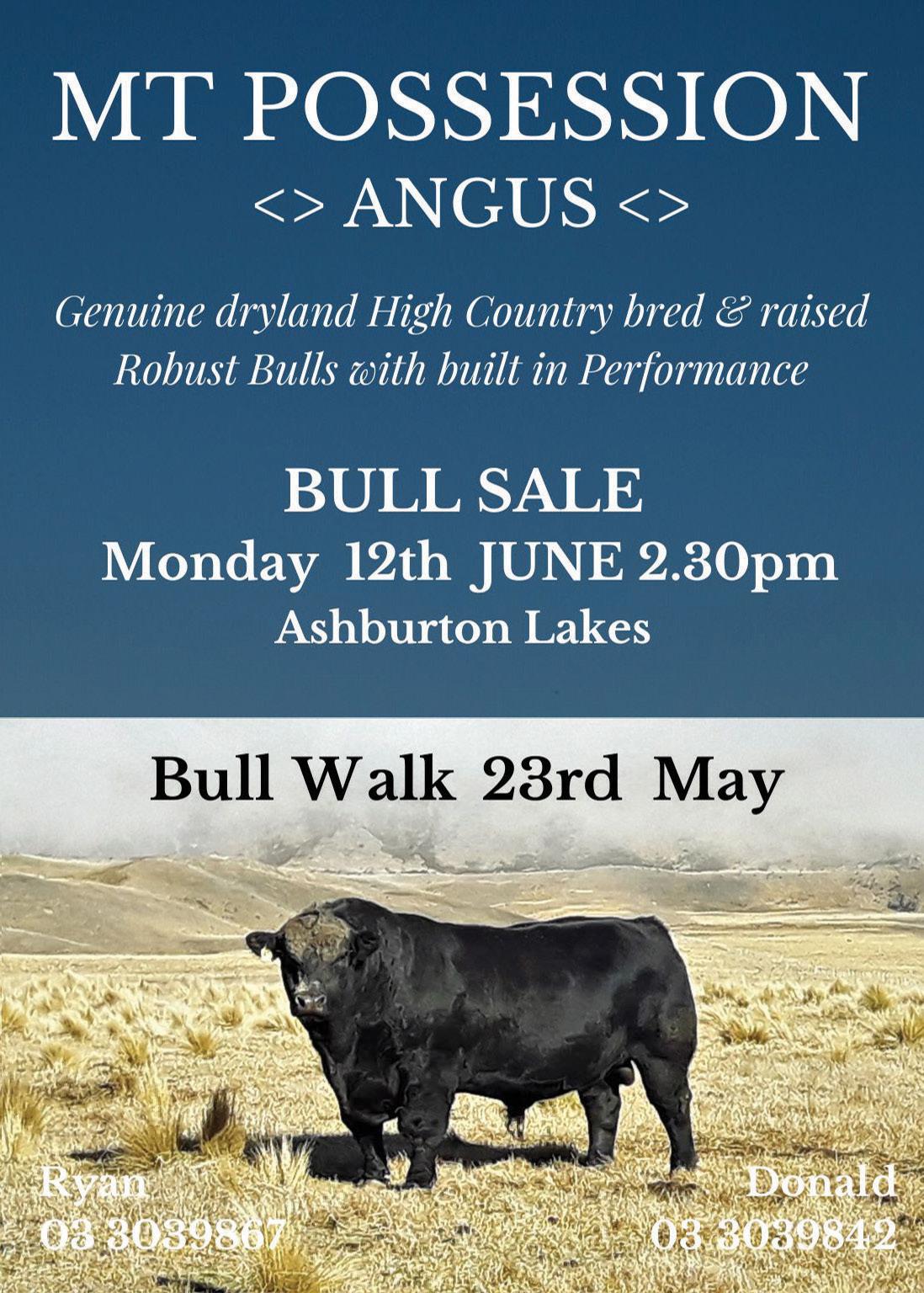

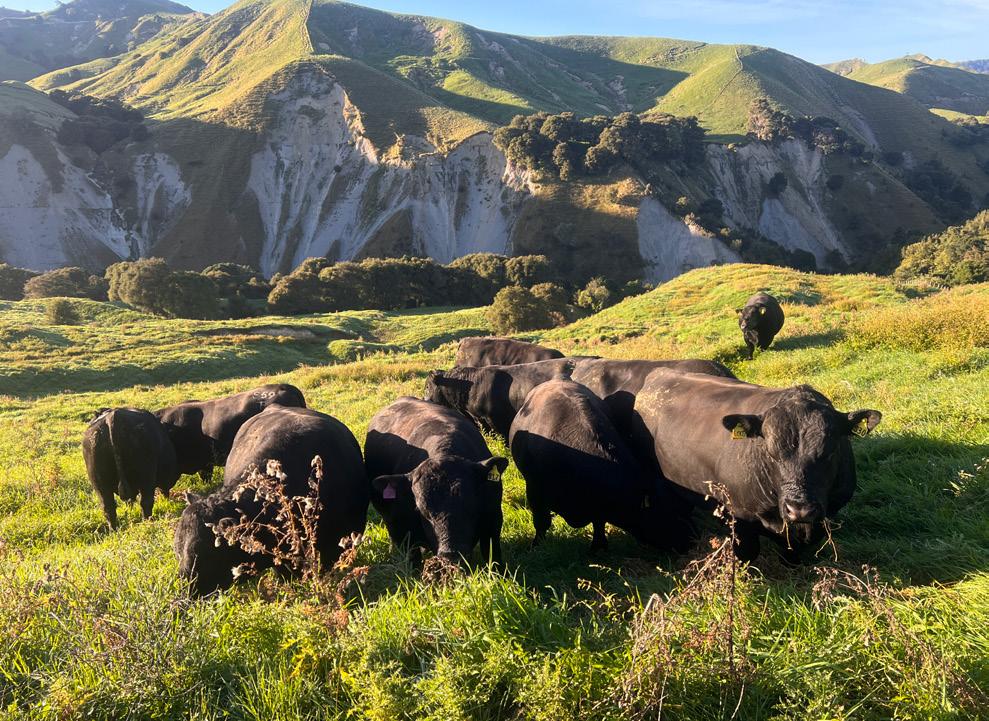
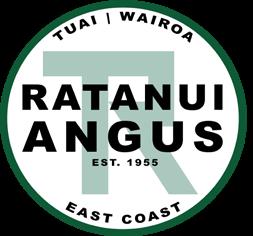

Country-Wide Beef | MAY 2023 129 Studstock Transport Studstock Transport Tim Coombs NZ Wide Tim Coombs NZ Wide Your Studstock Specialist Your Studstock Specialist TIM COOMBS Owner/Manager Phone: 027 444 1937 Email: coombs@vetta.net.nz Office/Admin P: 027 555 1118 Genuine 35+ years experience in carting stud bulls www.timcoombsdeerandstock.co.nz Red Oak 20th Annual Bull Sale + Elite Cow & Semen Sale Friday 16 June at 2pm on farm ANGUS 100 YEARS STUD BREEDING Focusing on good cows weaning top calves under true summer dry hill country conditions Rick & Deb Orr Red Oak, Weka Pass, RD3, Amberley P: 03 314 6759 M: 0272 457 751 E: redoakstud@amuri.net Comprising of: 45 Meaty hill country bulls • 26 Elite 2012 - 2014 born cows Complete line of R9 - R11yr cows vic to top sires including: Red Oak 451 Kincardine Rainstorm, Millah Murrah Quioxte, Banquet Quarter Pounder 89 MCDONALD ROAD, RD5, WAIROA | 022 130 7125 ratanuiangus@gmail.com facebook.com/ratanuiangus 38 BULLS FOR SALE RATANUI ARE NOW IN WAIROA! R2 SALE DATE & TIME: 23RD JUNE 2023 @ 2PM VIEWING FROM 12PM SALE LOCATION ON FARM - 89 MCDONALD ROAD, RD5, WAIROA
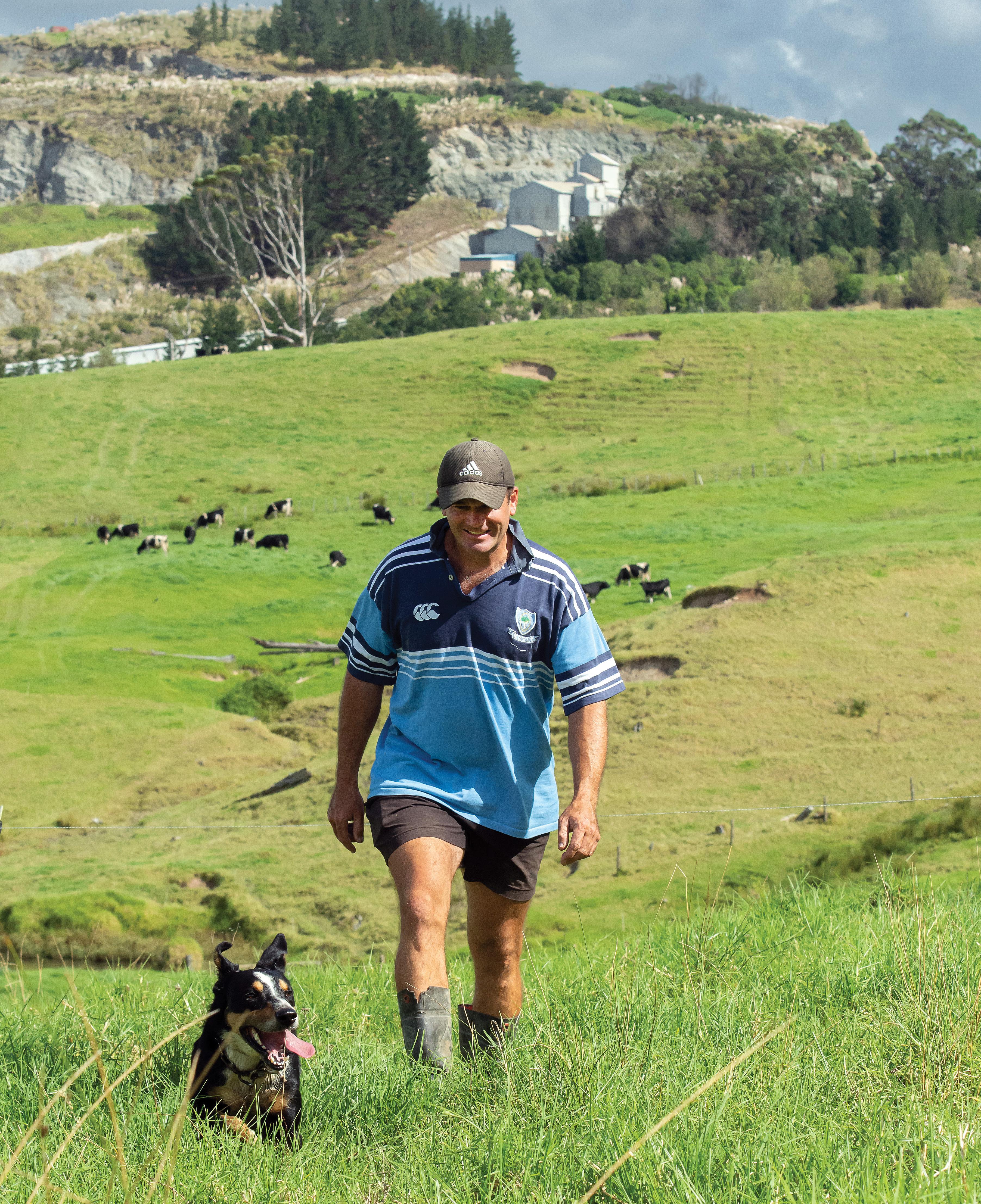
130 Country-Wide Beef | MAY 2023
CONSTANTLY TWEAKING THE SYSTEM
Bull farmer James Donaldson is always game to try new methods and ideas on his three Northland farms, but he told Glenys Christian it’s a constant round of budgeting, monitoring and fine tuning. Photos by Malcolm Pullman.
James Donaldson, 42, describes his operation as a tough game to make money on.
“You’ve got to watch everything like a hawk,” he says. “A nice hawk.”
James winters 1800, 18-month bulls on 1040 hectares along with 900 yearling bulls. The yearlings graze in mobs of 30 and the rising two-year-old bulls mobs of 18, using Technograzing and cell-grazing systems where they’re moved on average every two days.
While his requirement to stock agent Leo Sloane is Friesian bulls, “we always end up with a few colourful ones that are cheapies”. The aim is to buy 900, 180kg bulls in May or June from the saleyards or other farmers, then the same number of 330kg animals in October or November.
“We kill 1800 a year, starting in October with two-thirds killed before Christmas in case it gets dry.
“The other one-third dribbles out after Christmas.”
This year James still has 200 on the farm due to the incredibly good grassgrowing season.
After four years at Lincoln University completing an agricultural science degree and meeting wife Katie, James started farming in 2004. The rural professional route didn’t appeal and due to the early morning starts, the couple never wanted to go into dairying.
James managed a 300ha farm at Titoki, 26km west of Whangarei, which was running 600 ewes and 500 bulls and he started using the Techno-grazing system there.
“The owners had close friends at Omamari who had converted their whole farm, so I thought it should work,” he says.
He dipped a toe in the water, converting 50ha of the better contoured part of the farm. By 2008 the owners were happy to lease him the farm, an arrangement that continues today, with work on fences and water reticulation
Country-Wide Beef | MAY 2023 131
ONFARM
KEY POINTS: Large scale bull farming 1040ha | Techno-grazing or cell grazing bulls | Production aim 350kg CW/ha this year | Careful monitoring of pasture growth, all input costs | Gross farm revenue $2030/ha | Farm working expenses $1038/ha | Effective farm surplus $818/ha.
Testing the system
In 2017, a six-month on-farm grazing trial clearly showed the benefits of rotational grazing on vulnerable soils.
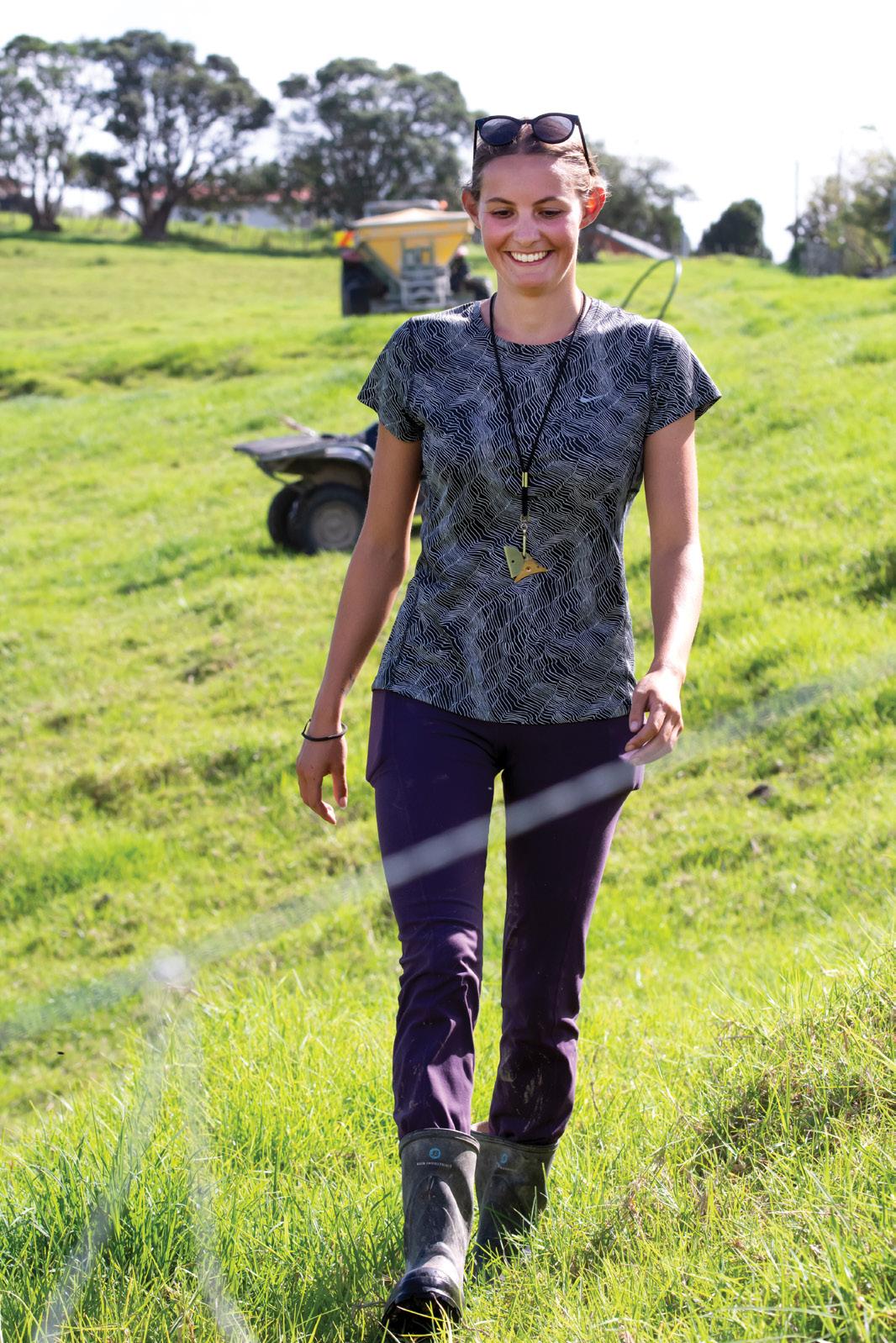
“We knew the answer before we started, but it gave us the data,” James says.
Run by Greenlea through the Red Meat Profit Partnership, it showed that under rotational grazing there was an average 2.2t/ha more pasture and the cattle consumed 1.1t/ha more grass. Pugging damage was halved and the cattle grew 60% more liveweight/ha,
generating $547/ha extra income.
“That difference is more like $700 a hectare now.”
James recently bought a 170ha former dairy farm at Maungakaramea, west of Portland, and is converting it to Techno-grazing and cells.
“All the basic infrastructure was in place and there was high soil fertility,” he says.
By doing as much of the grazing conversion work in-house as possible, the cost came out at about $100,000.
completed just four years ago.
James says the catalyst for change was what they were doing was uneconomic.
“We needed more gross revenue and there’s nothing like seeing someone else doing it.”
Fine-tuning of the system was carried out along the way.
“With rolling clay country covered in kikuyu that’s summer dry and winter wet, it’s taken a while to get right.”
Seven years ago the move was made to Portland, just south of Whangarei to lease Katie’s parents’ 800ha farm, which is 700ha effective.
“We had the recipe pretty right by then and we just extrapolated what we’d learned,” James says.
While he and Katie owned a house and some stock at Titoki, taking on the lease was a big step that stretched them. The farm was running 600 yearlings, 300 Angus breeding cows and 300 ewes.
James did the budgets based on what Katie’s father was doing, which came out at an income of $80,000 a year.
“I wasn’t happy with that.”
There was some “dilly-dallying” before the decision was made to just go with cells rather than the full Technograzing system, due to little money being available.
“Polywire was pretty cheap and I could design the cells on the computer and use a handheld GPS,” he says.
“It would have cost $700,000 for a clean-slate design but we did it for half that.”
All three farms have a high percentage of kikuyu, with the heaviest seen at Portland. Three mulchers towed by three tractors are used extensively when time allows to mulch about 200ha from March through to May.
“The bulls eat as much as they can. The mulchers are the last resort.”
No supplements are made, no crops are grown, nor pasture renewal programmes carried out.
James ran an Italian ryegrass trial on the Portland farm that showed there was more grass growth earlier in the season, but it had marginal benefit.
“We spent $200/ha making $200.
132 Country-Wide Beef | MAY 2023
Previous page: James Donaldson with the Portland cement works quarry and crushing plant in the background and part of 1km long conveyor. Right: Block Manager Zoe Allison.
His philosophy of spending $1 to get $2 back has served him well.
“Rather than $1 to make $1.50, because sometimes the 50c disappears.”
Close and careful monitoring
James describes himself as an ardent feed budgeter, so as the rain kept falling through the summer he knew exactly how much more feed was in his paddocks. While growth rates of 8kg of dry matter (DM)/ha/day through January and February are the norm, he plugged in 30kg, which meant significantly more stock could be carried on through the year.
He uses sward sticks, adjusting them based on the time of year – generally in May and October or November.
Once a month he goes around the farm and looks at the grass covers.
James says if he doesn’t do a feed budget they won’t know whether two or three applications of nitrogen will be needed. At an average cost of $100,000
an application, he needs to get that right.
They might weigh the bulls going into winter and coming out the other side going into spring. But if they have the grass covers right and animals are healthy, everything has been done to grow them.
In a perfect world an 18-month bull would be 450kg liveweight at July 1.
“Last year we were at 430kg, but this year we should do it.”
He’s a strong believer in killing stock “when you want to, not when you have to”, and making a supply plan for the year ahead with Greenlea Meats’ livestock manager.
He budgets on producing more than 330kg carcaseweight of beef/ha and hopes to get to 350kg/ha this year.
“Historically we’ve done 400kg/ha but then we ran younger stock and that involved more labour,” he says.
He says taking weaner calves through the summer was incredibly difficult, so
now they buy more yearlings in spring.
“An 18-month-old bull will control kikuyu but a calf won’t.”
The farms didn’t achieve the same kill weights as last season, which was disappointing and James puts it down to management changes that came about as a result of high fertiliser prices. He monitors these costs carefully, usually applying 350kg/ha of 20% potash sulphur super as a maintenance dressing on all three farms although this has now dropped back to 270kg/ha.
James says they bought spreading gear last year and are getting a much better spread with it not just pushed into the centre of the cells.
At the same time protected clover seed was added to the mix, which James says worked well in kick-starting this species’ establishment.
While Olsen P levels are between 13 and 14 on the Portland farm, they’re up to 30 on the more intensively farmed Maungakaramea and Titoki properties.

Country-Wide Beef | MAY 2023 133
18-month Belgian Blue bulls.
PUSHING BREEDING BOUNDARIES
AT GOLD CREEK SIMMENTALS WE ALWAYS LIKE TO PUSH THE BOUNDARIES OF WHAT’S POSSIBLE AND SET A HIGHER STANDARD.
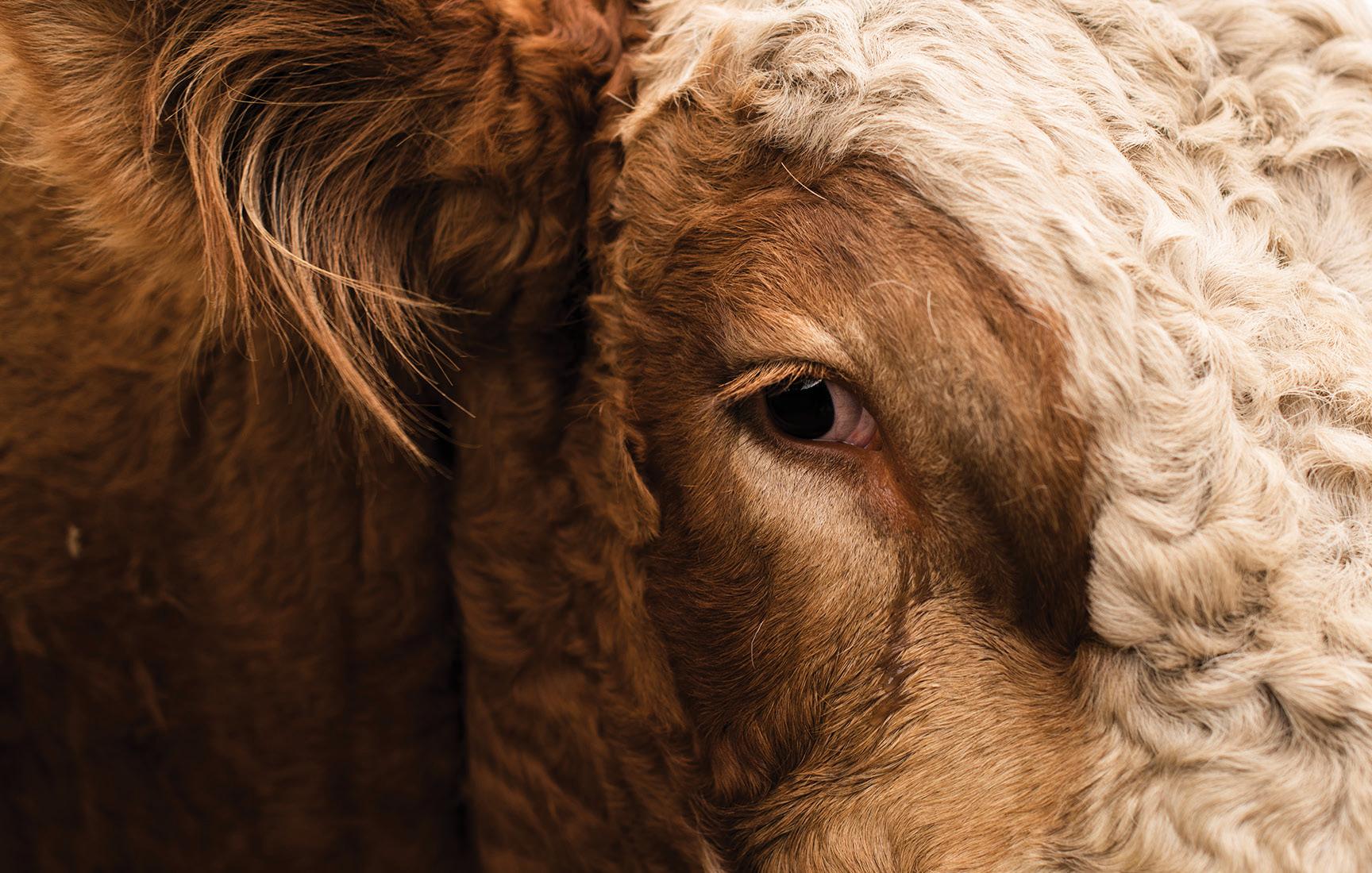
This means thinking differently and not doing what’s always been done, because what got you here won’t necessarily get you there.
Farming productivity and profitability is always under pressure so it pays to make the right decision when buying your bulls.
And whilst we’re not so showy and slightly shier about the way we do business, we’re not shy about the performance of our bulls.
Our breeding values continually improve each and every year. We listen to what you want and we take action because we know your success is our success.
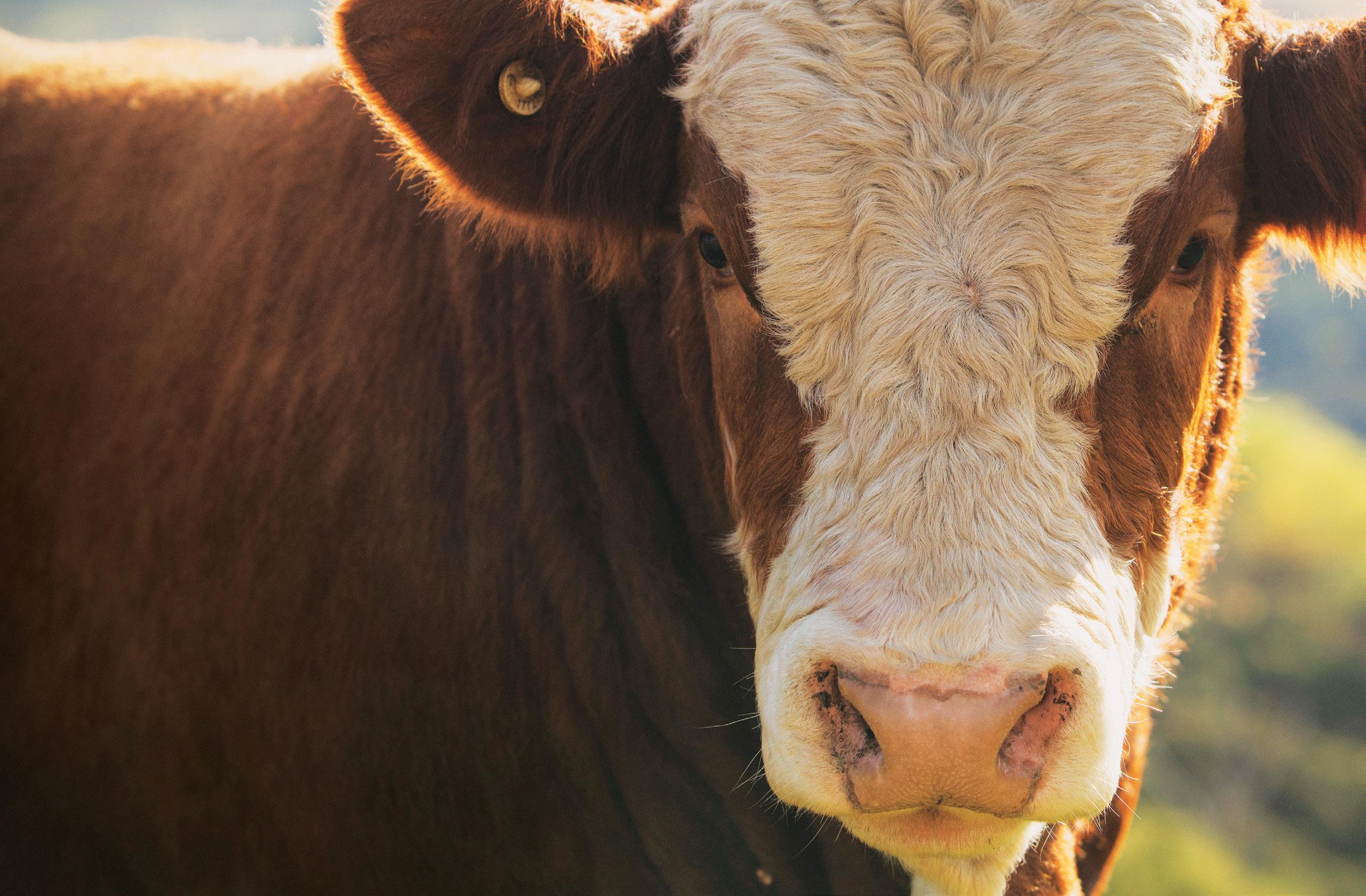
We make sure we align our breeding programme to the needs and wants of our valued clients. And that’s the only way we ensure you keep coming back for more.
We work hard to earn each and every sale so we look forward to seeing you at ours.
GOLD CREEK 2023 BULL SALE
Monday 22nd May at 2pm
34 bulls + 2 semen sires available for sale
WHERE
Gold Creek Sale Complex
4557 Matawai Road, Te Karaka, Gisborne
134 Country-Wide Beef | MAY 2023
CALL TOM SANSON FOR MORE INFORMATION Gisborne Waihirere Ormond Waipaoa Te Karaka 4557 Matawai Rd Ngatapa Patutahi 2 027 248 9098 goldcreeksimmentals.nz
AGRARIAN
The pH levels are all about 5.8. Nitrogen goes on by helicopter in up to three applications of 35 units/ ha during winter, last year it was two applications.
Animal health costs are low at less than $20,000 a year, which James puts down to running no weaners. The bulls receive two pour-ons a year, two copper jabs and one long-acting selenium injection. The Titoki farm was depopulated after Mycoplasma bovis was found in calves that were supposed to have come from the Waikato, but had been brought from the South Island. The Portland farm was also put under movement restrictions. As a result, James “drew a line south of Taupo” for buying in stock. He looks at NAIT records much more carefully and “scans everything religiously”.
Administration is sub-contracted out at $18,000/year which James says is the best money spent by the business.
“I have no interest in shuffling paper.”
Katie is a teacher at Matarau School which their two daughters, Emma, 11, and Lilly, 7, attend. Son Ben, 13, is a boarder at King’s College in Auckland. Including James, 4.5 staff are employed on the farms. One worker is Zoe Allison, a city girl who enjoyed her time on the farm so much as an intern under the Whangarei A&P Society programme that she returned as a fulltime worker.
After 20% SU lift, 20% cost cut
Recently James hired a full-time fencer who will be contracted out to local landowners half the time and the remainder will be spent improving their
Close to the bustle
own farms’ fencing to keep bulls from getting down in drains or escaping.
“It’s one of the things I’ve wanted to do for some time,” he says. “This way there will be no net cost to the business.”
Looking to the future, James believes there’s the chance to up his stocking rate by 20% by making cells smaller and running mobs more intensively.
There’s a little bit more they can wring out of the system.
“Bulls can’t count above 30 and big bulls beyond 18.”
He tries to trim 20% of costs, never achieving that goal but small savings along the way all add up. He’s changed fuel supplier, asked for a discount on
fertiliser, and got his bank to knock 0.3% off his mortgages.
“You have to ask otherwise you won’t receive.”
Frustrated by not being able to control genetics of the animals he’s growing, he’s reviewing the idea of rearing some dairy beef calves in purpose-built facilities through spring. Recently he’s been advertising for more land to lease, wanting to improve returns by spreading his fixed costs over a greater area.
“But carbon forestry has buggered that with landowners planting their farms and not leasing them out.”

A longer-term aim is to have a stab at adding value to his final product, through being consumer-centric and working backwards.
He says unless a farmer has a big dry stock business that’s humming, he’s doing it for love.
“What we do to bull beef hasn’t changed for 30 years.”

James says it’s a low-grade commodity. New Zealand doesn’t produce that much beef. Surely it can’t be too hard to find somewhere that will pay more?

Country-Wide Beef | MAY 2023 135
The farm borders the Portland cement works and quarry, Portland township, Maruni export wood chip plant, the Whangarei District Council’s major Puwera landfill, several estuarine arms of Whangarei harbour and is bisected by the main trunk railway line, a private road serving the chip plant and cement works and a 1km long conveyor belt taking limestone from the quarry to the cement works.
Fertiliser spreading using the farm’s own equipment. James said he had spent more than half a million dollars in recent years on fert and clover seed. Adding clover to the kikuyu pasture apparently makes a big difference in weight gain.
BEST IN BEEF RESEARCH 2023

















 By Nicola Dennis
By Nicola Dennis

136 Country-Wide Beef | MAY 2023 2023
Welcome to the second annual Best in Beef Research Awards. An entirely arbitrary celebration of beef research.
.
THIS YEAR WE are limited to open-access research – science that’s not locked behind paywalls – because taxpayer-funded research belongs to the people! And because Sci-Hub, the website that everyone uses to get around the stupid paywalls, is busy with a legal battle in India. Essentially, the hopes and dreams of global academics rely on a 34-year-old Kazakhstani woman winning a copyright case in India.
You see, publicly funded researchers are expected to pay journals to publish their articles, then volunteer their time to peer-review research when requested, and then pay $50 an article to read other people’s articles. It’s a silly system and the United States Government plans to put an end to it. The paywalls I mean. By 2026, all federally funded research must be free to read as soon as it is published. Until then, all hopes are on the speedy reinstatement of Sci-Hub.
But anyway, on with the show!
THE KILL IT WITH FIRE AWARD: BEST IN TICK TORTURE


Some poor souls cannot enjoy meat and dairy products because they have been bitten by ticks. There is a Lone Star tick that lurks around the eastern regions of the USA and Canada, an all- round bad guy spreading deadly viruses. But its bite can also trigger an overreaction to a sugar called alpha-gal which is also present in red meat, gelatin and some dairy products. Once your immune system is on the lookout for this innocent sugar, then a bite of beef can trigger a deadly allergic reaction between three and eight hours later. This condition is a nightmare – not just because it is bad for the beef business, but also because alpha-gal is in so many food products and the delayed allergic reaction makes it so hard to pinpoint what is going on. In fact the cause of this disease has only come to light in the last 15 years after sufferers kept reacting to a bowel cancer medicine Cetuximab, which contains alpha-gal.
Our winners gain the prize for torturing Lone Star ticks. Technically the researchers at Pepperdine University in California were exposing ticks to changes in humidity to see what they
can survive. But this involved 72 of the nasty suckers perishing inside climatic chambers and that seemed like a great start. The research found that Lone Star ticks died faster in drier conditions, but were still surviving for about 11 days at 32% relative humidity and temperatures of 20–30C. They turned out to be good climbers too, climbing higher than the other types of ticks in the study (up to the top of the 20cm container they were held in) while looking for a meal. Drier conditions just made them even more determined to climb in search of a meal, which wasn’t great for all the beef lovers wandering past them. These are not necessarily uplifting findings, and for that I apologise.
The good news, I guess, is that the tick that causes Lyme disease (not related to beef at all) is a bit of a weakling and the researchers don’t think it will do well with global warming.
Honourable mention to the paper that was testing the blood of alpha-gal allergic people and confirming that their immune system doesn’t have a problem with them eating poultry.
THE BIG BROTHER AWARD: THE LEAST CREEPIEST SURVEILLANCE
Why ask customers if they like the beef patties they are eating when you can analyse their facial expressions using FaceReader technology instead? If that sounds fun and not at all creepy to you, then you will be thrilled to learn that this is a homegrown project involving Lincoln University and AgResearch. I, for one, will need some time to get used to the idea.
I was also slightly traumatised by automated eye scanning to monitor vitamin A levels in Japanese Black cattle. I liked the sound of that until I realised that this is to prop up a practice where finishing cattle are purposely deprived of vitamin A (an important vitamin for vision) to improve the marbling of their meat. To put it very bluntly, they want to monitor eye damage in their cattle to make sure they are causing their desired level of malnutrition. I would like to use FaceReader to scan your face as you read that last sentence. The imaginary prize goes to Utah State University for their Cameras for Conservation research. We’ve got it good in NZ; our native species are far too meek to feast on our cattle. Everywhere else in the world, there’s something lurking in the bushes that wouldn’t mind a taste of beef. The trouble is that many threatened predators, such as jaguar, rely on private farmland to survive. For the most part, the predators are hunting smaller wildlife,such as white-tail deer and rodents that also frequent the farmland. But they also help themselves to 3–5% of a South American beef farmer’s herd, which makes them no friends. This research reviews schemes where cameras were set up on private farmland and landowners were paid significant money (US$50–220) everytime they successfully photographed a big cat, bear, wolf, etc, on their land. Basically, all a farmer needs is a good living for
Country-Wide Beef | MAY 2023 137 2023
2023
RESEARCH
taking care of the land. Getting paid for pics, incentivising farmers not to hunt threatened predators but to also spare the wild prey species that make up most of the predators diet sounds like a good idea. Working with farmers to preserve the environment rather than beating them around the head with regulations? Who knows, it might catch on.
Honourable mention: Wageningen University has programmed drones to monitor the size and weight of grazing cattle. Unfortunately the machine is still flummoxed by sleeping cows.
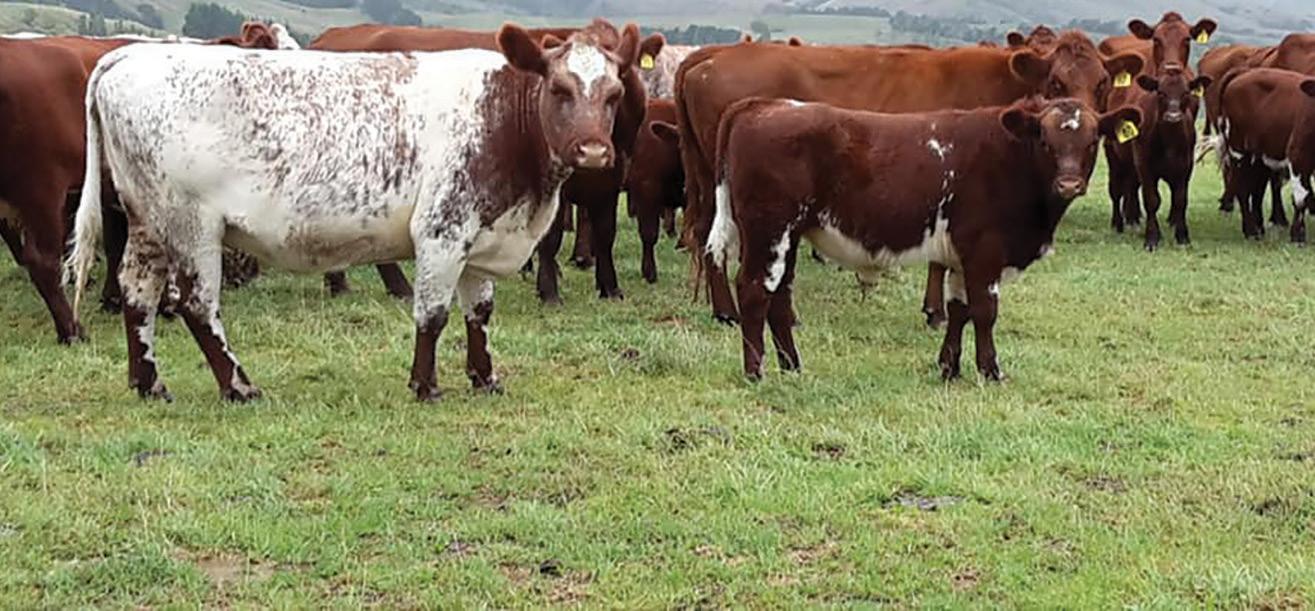
THE WEDGY AWARD: BEST USE OF NERDY MATHS
You don’t need to know what Bayesian statistics is, you just need to know that the people who are fond of it are a little like vegans. The fact that someone chooses to use Bayes models never seems to go unannounced. Shhhh, the rest of us don’t care. But still, nerdy maths has its uses. A food fraud study is as good as any.
So a reluctant round of applause goes to ‘A Bayesian Approach to Predict Food Fraud Type and Point of Adulteration’.
Researchers from the UK and Malaysia studied nearly 900 food incidents reported in the Food Adulteration Incidents Registry database. Reading through the categories of incidents, particularly the ones pertaining to contamination with formaldehyde or sewerage water, you may never wish to eat again. But thankfully, the researchers found most of the food fraud related to mislabelling, fudging the country of origin, expiry date, nutritional information and attributes such as “organic” or “free range”. Not great if you are a high-standards country that might get mimicked by the crooks, but still better than poisoning people. Beverages were the most likely to be ripped off. It is relatively easy to stretch a drink the extra mile by adding water or sugar. That can be especially tempting for high-value alcohols. Messing with meat made up about 14% of all incident cases. Counterfeiting inspection documents or substituting beef with poultry, horse or offal products made up the bulk of the beef crime. The system is clearly vulnerable to rogue food processors using dodgy ingredients when no one is looking. Small family-owned retailers who ignore or are ignorant of food labelling rules are another source of frustration.
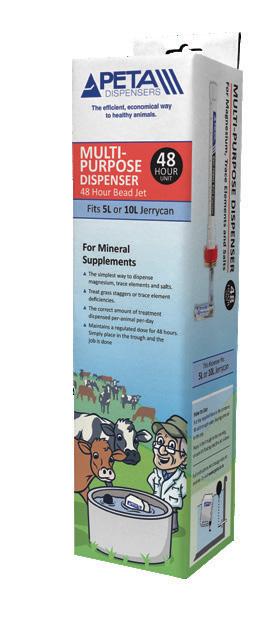
Honourable mention: The Russian researchers using nerdy maths to work out recipes for beef lungs.
THE ‘WHAT’S THAT SMELL?’ AWARD: BEST IN MEAT PRESERVATION

The food scientists are always hard at work looking for the next big thing in meat preservation and packaging. Last year we showcased a pH-sensing packaging made from waste watermelon rinds. This year it is the battle of the food additives. While we can all see the value in a “au natural” beef steak straight off the beast, cattle are not made exclusively of steak cuts. Each carcase yields a bulk load of manufacturing beef that is ground up for things like burger patties, sausages and pastes for meaty recipes. It is harder to keep minced meat fresh because the grinding process exposes all the insides (iron, enzymes and fats) to the harsh outside environment. These compounds can oxidise and cause the meat to go rancid and opportunistic bacteria can also set up camp there. There are some distinctively chemically sounding treatments that can be added to meat products to keep meat fresh, but the food science community is always on the lookout for food additives that will resonate with the consumer. Essential oils are a popular option, going by all the research papers. Keeping the meat fresh, perhaps with rosemary or sage oil or maybe manuka or kanuka oil, or with spare antioxidants left over from blackcurrant processing sounds

138 Country-Wide Beef | MAY 2023 Don’t get caught out... dispense smarter Multi-Purpose Dispenser For magnesium, trace elements and salts. Available in 24 or 48 hour options. www.peta.co.nz HIWIROA SHORTHORNS Inspection anytime at: 300 Rotohiwi Road, Waipukurau. Ph. Jim Syme 06 858 5369 or Nick Syme 027 428 8821 We have commercially focussed, high indexing Shorthorn beef bulls available OUR GENETICS EMPHASIZE MATERNAL TRAITS AND PREMIUM CARCASS QUALITIES
2023
2023
RESEARCH
like a trifecta of thrifty, sustainable and healthy. Without further ado I present our winner ‘Evaluation of different blackcurrant seed ingredients in meatballs by using conventional quality assessment and untargeted metabolomics’, Estonian University of Life Sciences. Pressing black currants for juice, leaves behind a press-cake of seeds rich in polyphenolic antioxidants. This paper explores ways of upcycling this waste product into a healthy meat additive. These additives preserved the colour and pH of the meatballs during storage while adding dietary fibre and lowering the water lost during cooking.
Honourable mention: Researchers in Queensland, Australia who studied replacing soy protein isolate (a common emulsifier in sausage recipes) with processed Acacia seed in beef sausages. It looked promising.

paper called ‘Social Media and Hindu Extremism in India’. Call me naive, but it never occurred to me that there were Hindu terrorists. I do not feel better for knowing that. Likewise for “Meating halfway”: Exploring the attitudes of meat eaters, veg*ns, and occasional meat eaters toward those who eat meat… Veg*n is never defined in this lengthy paper. I tried to find out how many other research papers used the term and the computer dutifully retrieved marketing papers by Nathalie Veg-Sala whose only crime is writing in French and having a name that looks a bit like Veg*n to computers. I now understand from trawling a vegan website that Veg*n is supposed to be an “inclusive” term for both vegan and vegetarian…and also computers confused by the French alphabet.
While the terrorists and vegans battle it out on the old social media, the video platform TikTok is teaching the younger generation how to cook. A big hand please for our category winner: “TikTok Made Me Do It”: Teenagers’ Perception and Use of Food Content
on TikTok, from Indiana University Bloomington. Sure, there is a possibility that it might be a surveillance tool for the Chinese state and my “For You” page is unsubtly hinting that I have ADHD, but TikTok is amazing at serving up helpful videos. This research suggests that it is having a positive influence by giving users practical hints for everyday healthy eating. ““TikTok has inspired me to consider enhancing my common meals. For instance, adding fruit to my oatmeal, or meat and vegetables to my store-bought ramen,” says one study participant who has been spared years of basic two-minute noodles once considered a rite of passage for youngsters. Other participants report cultivating an interest in international cuisine, recreating meals shared by their favourite celebrity and learning how to cook a steak to perfection. The participants also had hints for how to save these videos to your phone for future reference and how to tell if content makers actually knew what they were talking about. You know what? I think the kids are going to be alright.
THE LIKE, FOLLOW AND SUBSCRIBE AWARD: BEST USE OF SOCIAL MEDIA
There is no telling what you will get if you put “social media” and “beef” into Google Scholar. I was presented with a

So that’s it for the awards. There was, of course, all sorts of research on methane mitigation, beef growing conditions, packaging, marketing, nutrition and a thousand other things I did not deem quirky enough to mention. Until next year, take care and mind the allergenic ticks!
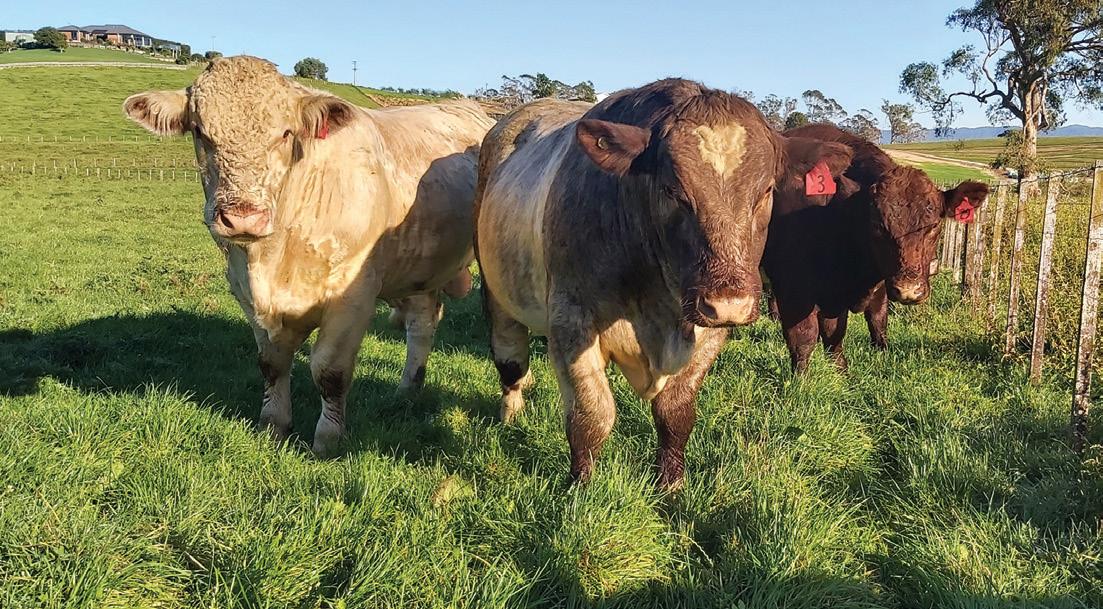
Country-Wide Beef | MAY 2023 139 TARAMOA SOUTHERN NEW ZEALAND CONTACT Dave and Juli Marshall M: 027 205 1895 (Dave) BULLS FOR SALE BY PRIVATE TREATY R2 Bulls available after May 15th Yearling Bulls available after October 10th SIRED BY Te Mania 16500 - Te Mania 17565 Matauri H412 - Benatrade 18-16 Baldrige Alternative @BENATRADEANGUS MORTON SHORTHORNS BULL SALE THURSDAY 18 th MAY 2023, 1pm 58 YEARS of BREEDING SHORTHORNS Any enquiries contact Ken Morton • Ph: (07) 552 0815 Craig Morton • Ph: 021 520 244 Email: mortons76@xtra.co.nz Facebook.com/mortonshorthorns
2023
New regs for winter grazing
James Hoban says farmers shouldn’t ignore the new winter grazing rules even though they mean more work – on farm and on paper – but he does wonder how successful the new rules will be.
Winter 2023 harbours a new landscape in terms of rules for intensive winter grazing. After several years of increased public scrutiny, numerous complaints and regional council investigations, many farmers across the country will now trigger rules requiring them to apply for resource consents. This is after two postponements of the rules.
In many cases, the farmers triggering rules are only continuing a practice they have been carrying out for years. Arguably, public pressure is a greater cause of the national rules than actual environmental impacts. Inarguably, intensive winter grazing on forage crops can have major environmental impacts when it is not done well.
What are the rules?

The Government has attempted to establish rules that draft higher-risk intensive winter grazing scenarios into a consented framework and let lower-risk activities continue without the costly paperwork. Whether the rules raise the bar for the right people remains to be seen. The rules apply to annual forage crops grazed in situ between May 1 and September 30. Only policy planners could create a five-month winter. The following
conditions need to be met to avoid the need for resource consent.
• Critical source areas need to be identified and carefully managed – this includes not sowing them in crop and not grazing them during winter. Fencing around these areas can be temporary. Critical source areas are low points where water and potentially nutrients and other pollutants accumulate in high concentrations and flow to waterways.
• The slope of cropped areas needs to be below 10 degrees. If there is an area in winter feed that is greater than 10 degrees, measured across a distance of 20 metres, then technically a consent is required.
• Waterways should be protected from stock, with a minimum of five-metre buffers.

• The total area of winter crops needs to be less than 50ha or 10% of the farm area (whichever number is greater).
• The area of winter crops needs to be no more than the maximum used on the property between June 2014 and July 2019. The property needs to have been winter grazing during that time. This clause is designed to capture expansion and new winter grazing.
140 Country-Wide Beef | MAY 2023 ENVIRONMENT
!! !!!!! ! ! ! ! ! ! !
Thankfully, the challenging draft rules around pugging and sowing dates after winter have been removed. These were largely unworkable – potentially requiring sodden paddocks to be drilled and stock to leave no footprints. It is important to remember that being on the wrong end of these rules does not mean winter grazing has to stop – it just means a consent is needed.
How will councils handle the process and how many farmers will apply?
It would be uncharitable but not entirely inaccurate to say regional councils have no idea how this is going to unfold.
The prospect of rules requiring resource consents en masse is not new – but this is the first time it has gone so far and is actually in place, as opposed to a being a twinkle in the corner of a government minister’s eye. This set of rules is a decree from the ivory tower in Wellington. Stretched regional councils are only slightly more excited about processing consents and implementing the rules than farmers are about applying.
It is reasonable to expect a number of farmers who trigger the rules will choose not to apply for consent. In Canterbury, the cost of applying is a minimum $3500 deposit. While a quick and seamless processing would in theory
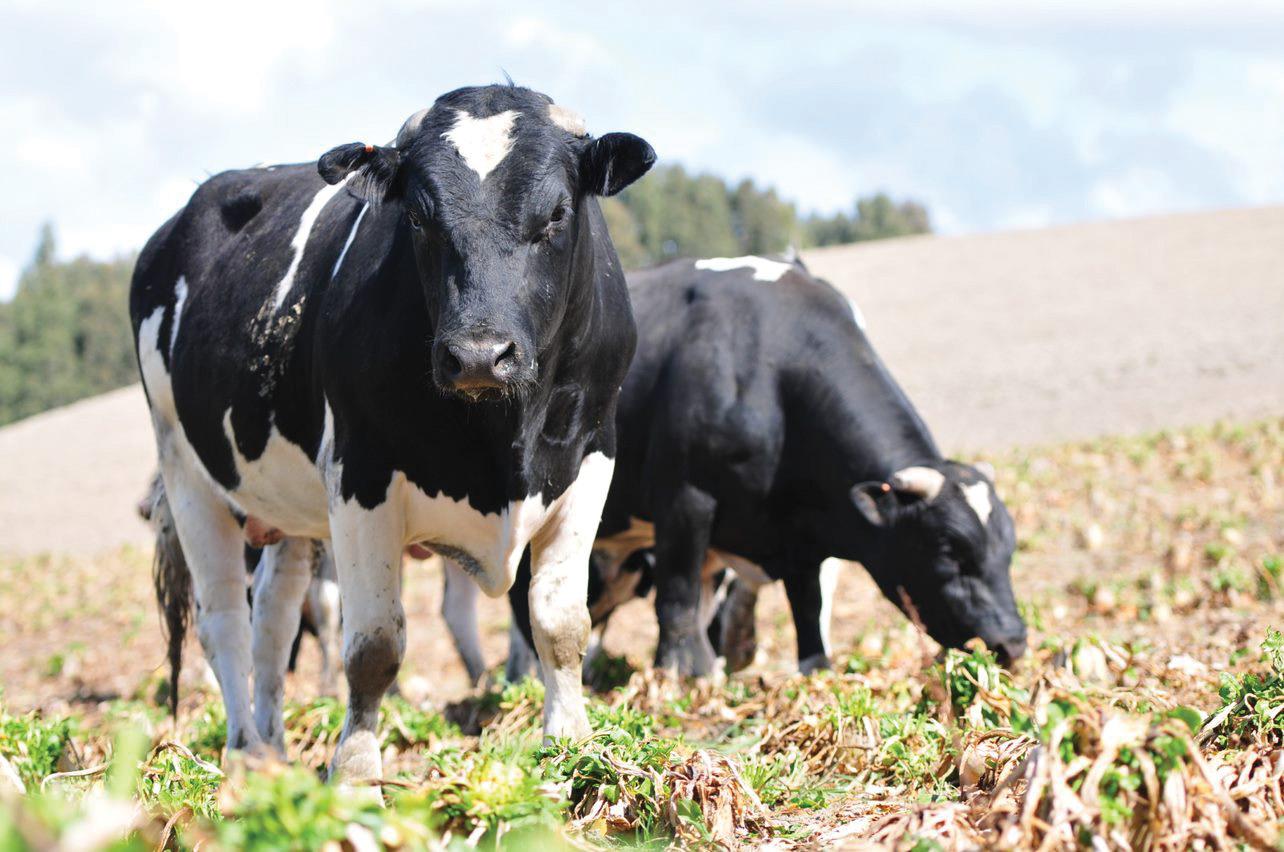
see a portion of the deposit refunded, the road to riches is not paved with resource consent refunds. There must be people somewhere who have received partial refunds because of council efficiency, but they remain elusive.
The wisest of the people who choose not to apply will have an updated winter grazing management plan in place, ready to show any interested parties who knock on their door. They might successfully avoid detection for a time. It is not unreasonable to rationalise that councils will focus on high impact, visible sites first and that they will struggle to catch up with everyone this winter. Avoiding the law forever is a naïve hope though, with councils across the country having already used aerial winter surveys to monitor compliance. This scrutiny will only increase.
An effective wintering system:
• Ensures animals are well fed and productive.
• Prioritises stock with the greatest need – both feed and shelter.
• Enables stock performance through
a cold period when grass growth is slow or negligible.
• Keeps soil and nutrients where they are meant to be – in the farm system
• Minimises soil damage and protects sensitive areas.
• Allows for adverse weather and incorporates several contingency plans for when winter conditions are extraordinarily extreme.
• Is defendable in the face of public scrutiny and allows farmers to sleep at night.
To give Environment Canterbury credit, they have signalled that their first response to any issues this winter will be based on educating rather than demonising farmers. Unfortunately, whenever the regional council takes a gentle approach to farming rules, rabid hordes of environmentalists keep the pressure on, easily incensed if they feel farmers are being treated softly. If it ever comes to the crunch, it is difficult for the council to explain in court why it is not implementing rules according to the law.
The least-wise rule dodger will not have a grazing plan in place. They will at best have their fingers in their ears and at worst will be imitating an ostrich. They will be living somewhere highly visible to the public, they might well have heavy animals on wet soils and an apparent lack of management of critical source areas. Being frustrated is not a
Country-Wide Beef | MAY 2023 141
With so much publicity around new grazing rules it is easy to get caught up in the hype. It is worth stepping back from the regulations and remembering exactly what farmers are trying to achieve with annual forage crops grazed in winter.
“It is important to remember that being on the wrong end of these rules does not mean winter grazing has to stop – it just means a consent is needed.”
PLATFORM STUD
Hereford hill country bred R2 Bulls with excellent temperament and growth are for sale on Bidr online auction 12th June 2023 at 7.00pm.
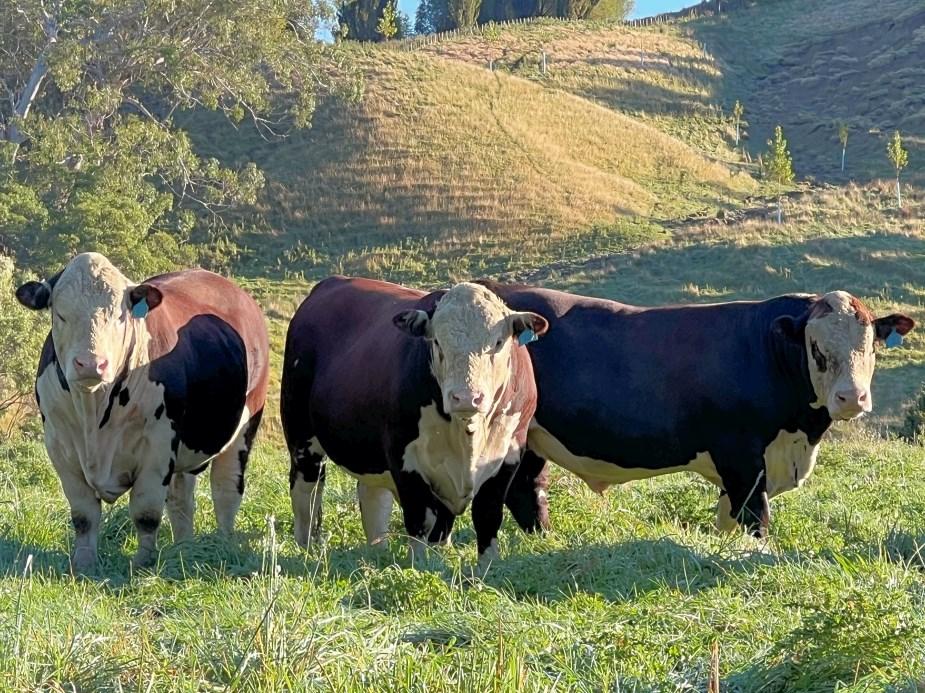
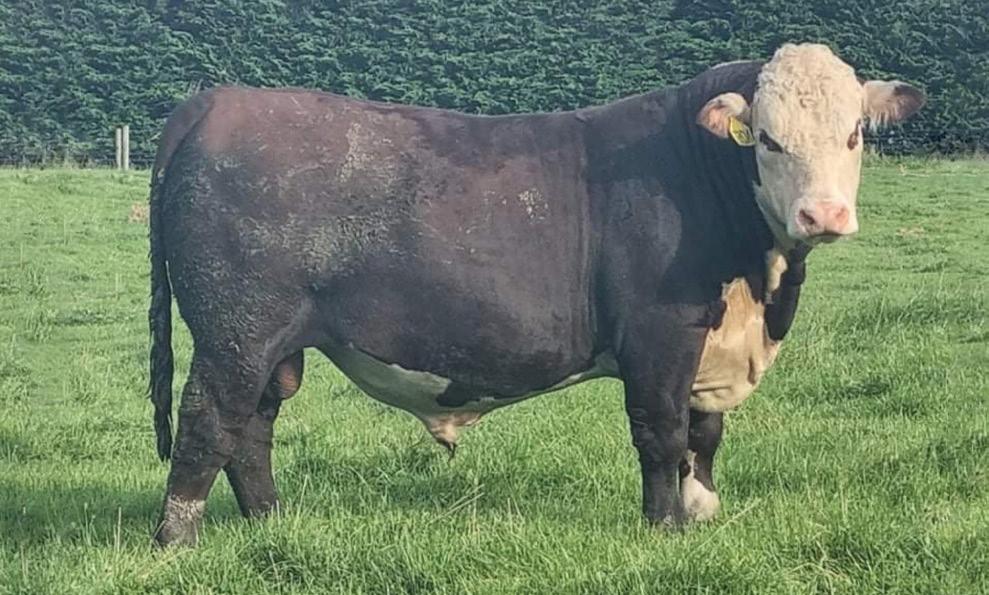

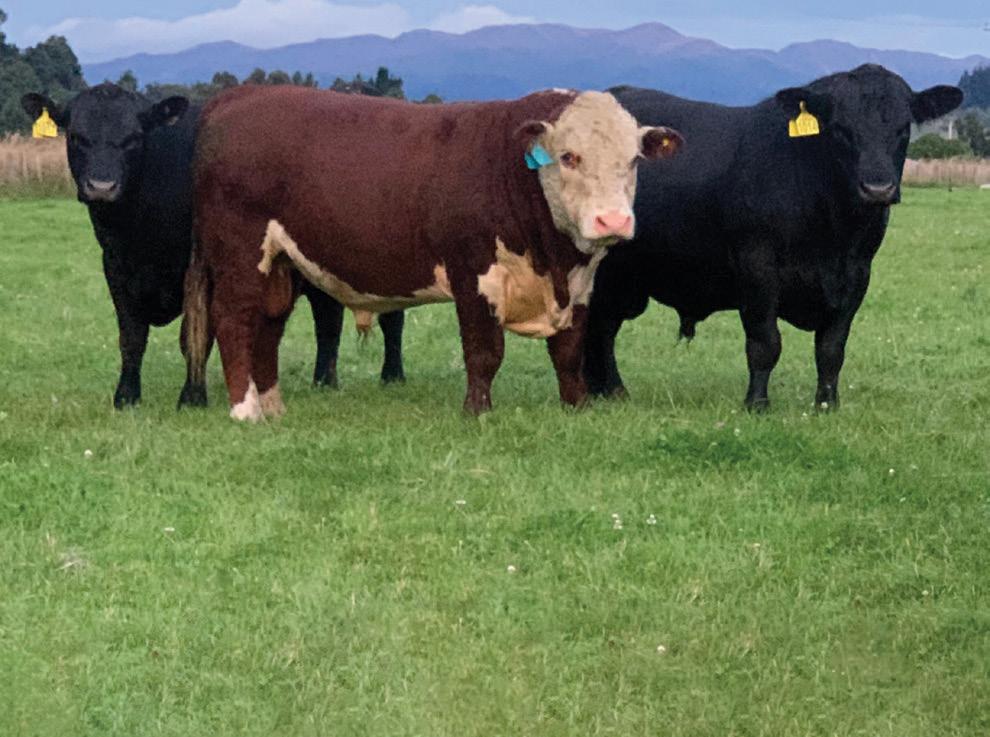
• Platform Edmond (on left) Stud prospect
• All bulls BVD tested and vaccinated

• Inspection welcomed
• PGG Stock agent: Rihi Brown 027 404 7514
Enquiries: Mark & Charmaine Will 125 Coopers Road, Masterton 5871
Phone: 06 372 4896
Email: platformfarm@gmail.com
Follow us: FACEBOOK @ Platform Hereford Stud



RIVERLEE
HEREFORDS & ANGUS
HILL COUNTRY BRED FOR HILL COUNTRY FARMERS
Annual on farm Bull Sale 1019 Mangaorapa Rd, Porangahau
Thursday 2pm 1st June 2023
Andy & Emma Martin PH : 06 855 5348
a.emartin61@gmail.com www.glenbraestud.co.nz
MATARIKI
BREEDING CATTLE WITH STRUCTURE, CONSTITUTION & CARCASS
ON FARM SALE TUESDAY 20TH JUNE 2023
SPRING SALE TUESDAY 3RD OCTOBER 2023

Annual Beef Bull Sale
On Farm 13th June 2023 @ 1.00pm
OFFERING: 35 R2yr BULLS
All cows commercially run & wintered with the ewes
Temperament • Constitution • Structural Soundness Growth • IMF
AGENTS:
Carrfields: Dan Warner 027 8265 768
NZ Farmers: John Watson 027 4941 975
ENQUIRIES & VISITORS WELCOME
MURRAY & FIONA CURTIS
2354 Rangiwahia Road, RD 54, Kimbolton 4774
P: 06 3282 881 • M: 027 2282 881
E: mfcurtis@farmside.co.nz
BULLS SERVICE CAPACITY & SEMEN TESTED SCANNED FOR CARCASS ANALYSIS BVD TESTED & VACCINATED BREEDPLAN RECORDED | 650 REGISTERED COWS
ALL ENQUIRIES AND VISITORS MOST WELCOME
JACK MURRAY | JAMES & BECKY MURRAY 174 Clarence Valley Road, RD 1, Kaikoura 7371
Email: matariki@xtra.co.nz | Jack: 027 381 2300
James: 03 319 4331 or 027 486 6699
Sam: 027 698 6283
142 Country-Wide Beef | MAY 2023
Offering 30 Powerful Poll Hereford Sires
sufficient reason to join this camp. Regional councils have long talked of streamlined consent processes that would help handle this type of situation. Forms that applicants could complete without the assistance of a consultant would standardise things nicely enough for the council staff to process quickly. To give Environment Canterbury credit, it has had a go at designing this document. The result is a 34-page application form that has tested the will of even the earliest of adopters.
Applicants should not be daunted by the policy-wonk language in the application form and process. Despite the fact that an array of bureaucratic terms are now being applied to a normal farming activity, good practice has not changed. Mitigations that help reduce issues around winter grazing are not new and do not need to be explained to regulators in a complicated way.


For the past two years, intensive

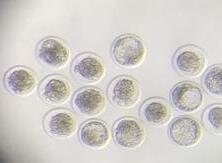
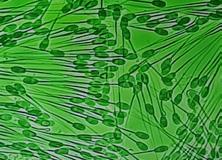




winter grazing management plans have been a smart tool to adopt. They are now a requirement and fortunately they are much more manageable than a consent application. There are several templates for these plans available from industry groups and regulators. They all involve mapping risks associated with individual paddocks and explaining what management practices will ensure grazing is well conducted on the farm. Completing these plans is only mildly onerous. They will be the first document taken out of the drawer if a council employee arrives in response to a complaint. They are also the key part of a consent application. A well-prepared plan will answer most questions a consent processor will have. These documents need to be reviewed annually and adapted where necessary. For those who cannot face resource consent application forms, a number of consultants are available who can help.
Unfortunately, they will not do this out of the goodness of their hearts and their charges will be in addition to any fees paid to a regional council. Farmers who opt to use a consultant need to choose a good one, which will require some basic research. It is also worth completing the easiest parts of the application and having all relevant information well organised before engaging a consultant. Saving them time will save money. Realistically, applications are completable for many farmers but will require effort and perseverance. A good consultant will save stress but cost money. This decision needs to be made based on what applicants are most comfortable with.
•
•
Country-Wide Beef | MAY 2023 143
James Hoban is an environmental consultant and North Canterbury farmer. james.hoban@outlook.co.nz
• Export centres for semen and embryo collections
Fertility evaluations and on farm freezing of semen
• AI programs and fresh semen collection for AI
Import and export of semen and embryos
despatching services 06 376 4955 breedingcentre@tvg.co.nz tararuabreedingcentre.nz @ Tararua Breeding Centre Part of
Vets Ltd ARTIFICIAL BREEDING SPECIALISTS NZ’s Leading Online Auction Platform • Over 8000 users and 11 agency partners • Range of real time and online auctions • Regular weekly streaming from 10 saleyards nationwide Chat with the bidr® team today on 0800 86 2437, or visit www.bidr.co.nz
• Storage of all species and
Totally
What’s the best fit for your farm?
Braydon Schroder has a range of factors that will help farmers and farm owners decide what system will work best on their farm. He’s wanting farmers to challenge their thinking processes.
There is common contemplation about what beef enterprise best fits a farmer’s land and resource mix. The words ‘best fit’ are chosen as in many cases there won’t be a ‘right’ or ‘wrong’ stock class for a farm. Best fit is used to capture a whole farm system thinking process to account for and consider the distinct factors of an individual property and priorities of the owner.
Generally, the first line of thought for many is what stock class was run on the property before and what are mates or neighbours running. The big factors that help drive a cattle policy for farmers are typically land type, pasture management and financial return. This article is to challenge and push the thinking process to help identify the best fit beef enterprise for each situation.
144 Country-Wide Beef | MAY 2023
ANALYSIS
The vast range of beef class options includes calf rearing for beef, beef heifers, steers and bulls of all ages and various trading times and breeds, breeding cows, breeding bulls, replacement breeding heifers/bulls, cull dairy cows, dairy replacement grazing and dairy cow grazing. There are numerous ways to include each of these stock classes within farm systems, each with their special benefits and disadvantages.
To begin the process of identifying the best fit beef for a property, the first step is to understand the property’s limitations. Also, consider what may be feasible without having to incur large capital expenditure to run a certain beef enterprise and ultimately a profitable cattle system. These limitations may include, but are not limited to, yards/ handling facilities (health and safety), contour, drainage, calf rearing gear/ facilities, animal health issues, quality feed availability or fence quality.
In some cases, capital expenditure will be justified. To compare livestock enterprises, a gross margin analysis is a good start to indicate relative profitability. To investigate the return on capital for major inputs, a cost benefit analysis can be done in conjunction with the stock class gross margins for comparison.
A cost benefit analysis is essentially the financial benefits resulting from the capital cost minus the total cost –including initial cost, additional interest, labour, maintenance allowance and other additional costs each year – to get
the annual net benefit from the required investment. The payback period on the investment for the business can then be calculated to determine if this capital spend can be justified.
More things to consider
Other factors to consider are the main reasons for having cattle in the farm system and perhaps what proportion of cattle compared to proportion of sheep, deer or other stock is best in a system to achieve the business goals. For example, is it to control feed surplus and keep feed quality around the farm? Or is it to maintain the worm drench efficacy and worm burden on other livestock classes? Perhaps the farm has a greater area of fertile flatter country and can intensify the system to achieve greater liveweight gains and number of trades. Or perhaps the beef class is just filling a gap where another farm enterprise (e.g. sheep or deer, dairy unit or cropping farm) is the priority. Does the locality (access or market) influence the decision to buy/sell certain classes of stock and not others? Perhaps lifestyle, labour or the safety factor will guide which stock class will be best fit. Ultimately, all farm systems and owners will have their specific set of priorities for various reasons.
Once these priorities are understood, each remaining beef enterprise of interest can be evaluated accordingly to these priorities. This step will generally rule out many enterprises for a particular situation. Thus, it is important to accompany this step (before selecting
enterprise options) with a gross margin analysis ($/head and $/kg DM eaten) specific to trading times expected to work with the feed available in the farm system. Historical pasture and stock unit data, or ideally a feed budget, can be used to ensure the designed stocking policy will fit together as a feasible farm system within the expected pasture growth profile.
At this point, once understanding the limitations of the farm, priorities of the business and the feed availability, the final step alongside an accordingly adjusted feed and financial budget is to list on a score chart the beef enterprises of interest to be investigated. This can include a 1–10 score next to each enterprise under all, or a select few, of the priorities, such as relative profitability via gross margin analysis discussed above.
Each of these priority factors can be given a percentage weighting of importance specific to the business. This can then be multiplied by the specific priority score and all summed to give an overall score for each enterprise.
In most cases, it won’t just be one beef enterprise that is chosen for a farm. The reason for this is clear when producing this chart for a farm, as one stock class will be a best fit for one purpose, e.g. cows for hills and keeping feed quality. Another class may be best fit for another priority, e.g. bull calves for gross margin and potentially market availability.
Using the thinking and process above will help identify cattle enterprises that are as profitable as possible, work within the distinct resource mix, feed budget and business goals to be ultimately ‘best fit’ for a farm.
Country-Wide Beef | MAY 2023 145
Braydon Schroder is a consultant with PerrinAg.
“To investigate the return on capital for major inputs, a cost benefit analysis can be done in conjunction with the stock class gross margins for comparison.”
Cleaning up after Gabrielle
BY CLAIRE ASHTON
Peter and Judy Gannon, family members and farm owners Graeme and Hamish operate five farms in the Tutira and Mohaka area in northern Hawke’s Bay, with 1600ha total across the farms and about 1420 effective. They run a closed system with 5500 sheep, and 1240 beef, including 400 breeding cows.
“It’s a bit devastating seeing all our work go,” Peter said. “We started farming on our own right after Cyclone Bola and the damage is more significant this time by far.”
For the first two weeks after Cyclone Gabrielle they had no power and only limited access to radio, only RNZ National, with no cell phone coverage. Topdressing pilots dropped generators, fuel, fencing supplies and food in. Cooking was done with gas bottles and open flame barbeques, and they even managed to cook roasts.

Peter was feeling “a bit fragile” after they received 20mm of rain over Easter weekend and says any extra rain just makes the waterlogged ground sloppy. Before the cyclone the land was already wet, about as wet as they usually would be going out of winter.
Three of the farms still can’t get stock out, but Peter was fortunate to get steers out to the works with a 330kg carcaseweight. He suggests their weight was good because the animals were free to roam over much more pasture than usual due to internal fencing losses. Lambs were sent to the works after Easter at 19.8kg CW.
They hadn’t released the rams before the cyclone and needed to get the ewes somewhere they could mob up before they released them. Because of this, breeding patterns will be affected. The Gannon’s were fortunate that their stock loss was minimal – perhaps 40.
Peter’s own farm of 270ha has had 23 slips internally and he’s lost 5.5km
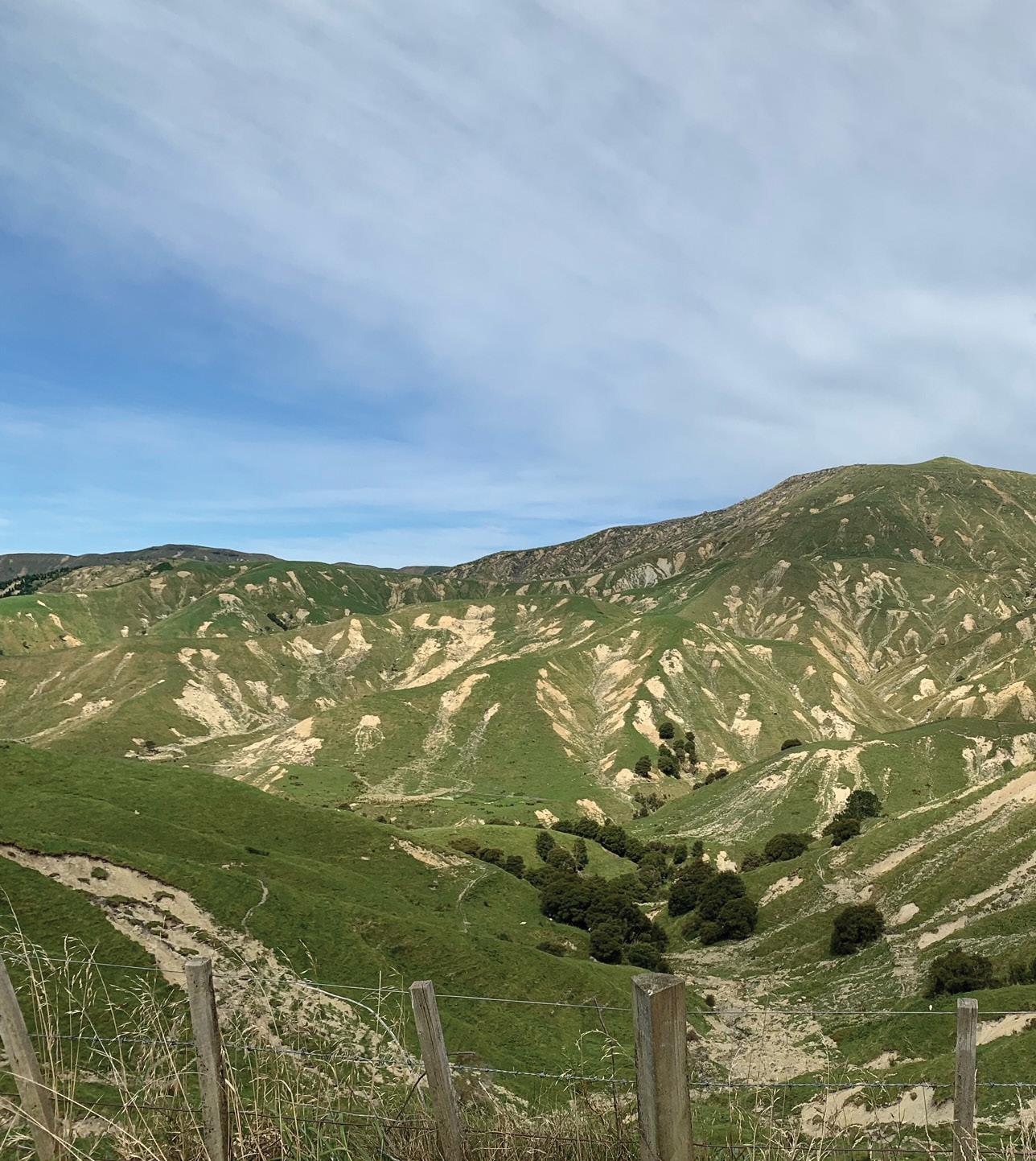
of fencing. Most of the external fencing wasn’t too badly affected and has been fixed which was a priority as one of the neighbouring farms had TB.
“It’s amazing the variation of the weather we got from the cyclone. One son is 12km from my home and he had minimal damage, two properties have bad damage, and two farms have severe damage.
146 Country-Wide Beef | MAY 2023 POST CYCLONE
Country-Wide writers talk to farmers in the path of Cyclone Gabrielle who are still struggling to get stock out and fix fences.
“We’ve had this amount of rainfall before without much damage, but the short period of rainfall was intense.”
Fencing loss has been notable. They fixed the internal fencing of about 10-15 posts long to give themselves multiple paddocks as at first there were no stockproof fences.
Peter says they’ll use electric fencing when they’re doing some fence replacement - either two or three strands. It’s less expensive and easier to repair. The family all pitched in with the fencing repairs, and with the help of a forestry worker, they sheared a large number of sheep using a generator.
Retired land by the river and the riparian planting has been washed away, and silt continues to wash downstream after any rainfall. In essence, that riparian planting added to and became part of the debris.
“In some areas the silt is 12-13ft deep, so you have to be careful working in and around it,” Peter said.
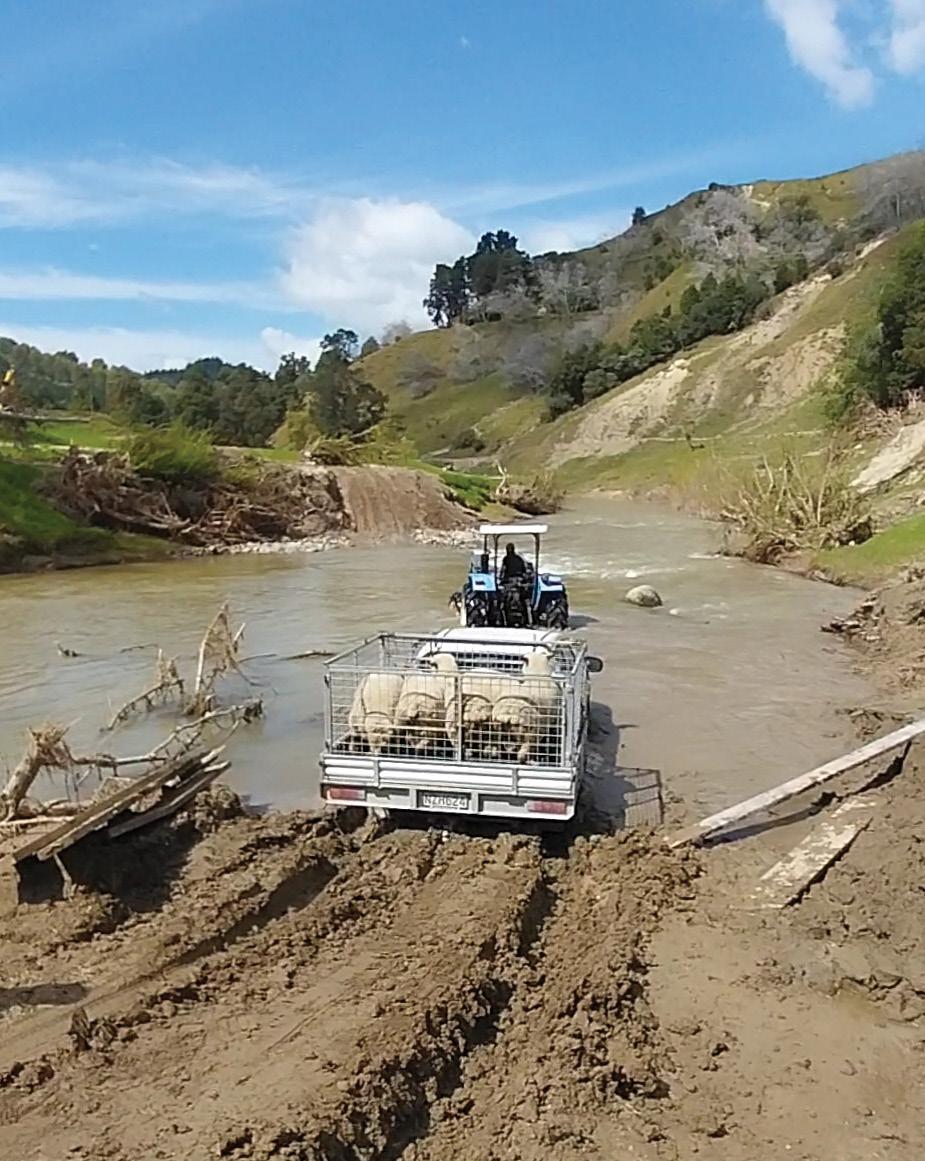
“The areas by the river were flat like a rugby field with the top two inches of posts sticking up. You can walk around on it but there was a guy who got stuck.”
Most help with roading early on came from forestry contractors with trucks and machinery, with expert operators working on clearing roads, but Peter said work seems to have slowed down – after the arrival of road cones and bureaucracy.
“I’m disappointed with the roading progress now. It’s just ground to a halt.
“There were times when you just felt a bit overwhelmed by it all, but you just have to do what you can do. You can’t do it all in one day.”
MATT EVANS HAS been farm manager on Strathblane Station in Hangaroa for the last nine years. The station is divided by the Hangaroa River.
The station’s main side, which was cut off during Cyclone Gabrielle, has 900ha on the steep hill side of the river and 300ha of lower lying land that’s still accessible. It’s a mixed sheep and beef operation, carrying 10,000 stock units made up of 3600 ewes and beef stock, including 400 heifers.
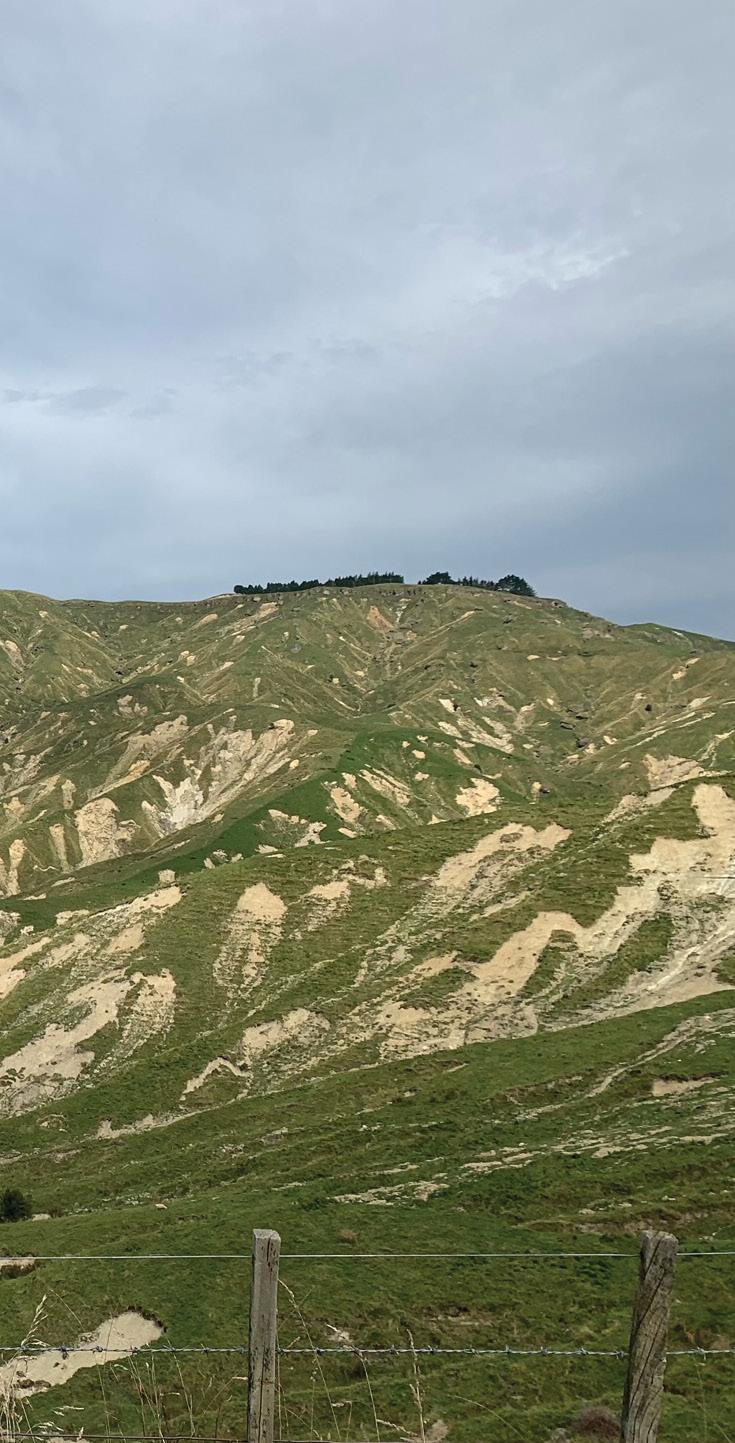
Matt and Jess Evans and their two children heard the heavy rain during the night of the cyclone and Matt didn’t expect to see the bridge in the morning. Their home on a hill escaped flooding, but the bridge connecting them to the world was washed out. Locals believe the water was three metres higher than during Cyclone Bola in 1988.
“As far as slipping goes, it is quite localised – we are in a band that hit halfa-dozen farms real bad, then farms two or three kilometres either side hardly got any slips,” Matt says.
He estimates 30-35% of pasture has been lost to slips on the steeper hill country. Fences have been badly damaged, and they are slowly patching holes up, but more work will occur slowly with a push perhaps over summer if it dries up enough. Of the 27 main paddocks only three remain stock-proof, which means mustering can include trying to cover half the farm. Day-to-day farm life is quite different as it takes so long to muster and get stock to where
Country-Wide Beef | MAY 2023 147
Left: Debris clings to fences on Peter and Judy Gannon’s farm in northern Hawke’s Bay. Above: Slips cover the hills on the Gannons’ 1600ha farm. Right: With farm infrastructure such as roads and bridges washed away, innovative alternatives were used to move stock on Matt Evans’ Strathblane Station.
Our skilled and creative team will move your business forward in leaps and bounds! For successful online business growth with proven ongoing results, talk to us today.
We’ve merged top creative design talent with digital www.pivotdesign.co.nz


South Street, Feilding 06 323 0740 info@pivotdesign.co.nz pivotdesignnz

148 Country-Wide Beef | MAY 2023
75
WEBSITE DESIGN SOCIAL MEDIA EMAIL MARKETING SEARCH PAID MEDIA GOOGLE 360
Matt needs them.
Stock losses, lambs and cows, are certain, but Matt says he couldn’t estimate how many.
“A lot of them will be buried under dirt or washed down the river.”
If some stock has ended up on neighbouring properties, Matt is sure he’ll get them back. They have good neighbours across the river and together they’ve set up a dinghy on ropes to get across.
Due to stock being on the accessible side of the river, Matt was able to send 70 bull beef cattle and 300 lambs to the works, which meant income kept flowing. Normally, this time of year, Strathblane station would have started killing lambs and weaning calves a month ago.
An in-demand digger contractor arrived in the first week of March to work on the new low-level bridge being made from the top of an old bridge, with beams and planks on top for car access, and they can now walk stock out across the river. A priority for the digger is to dig out the buried farm tracks. Once the bridge is in place, they can herd lambs across and get them to the works.
Improvising after Gabrielle
BY GLENYS CHRISTIAN
Grant Hickling estimates he and wife Kerry haven’t fixed 10% of the damage caused by Cyclone Gabrielle on their farm at Rere, 50km inland from Gisborne.
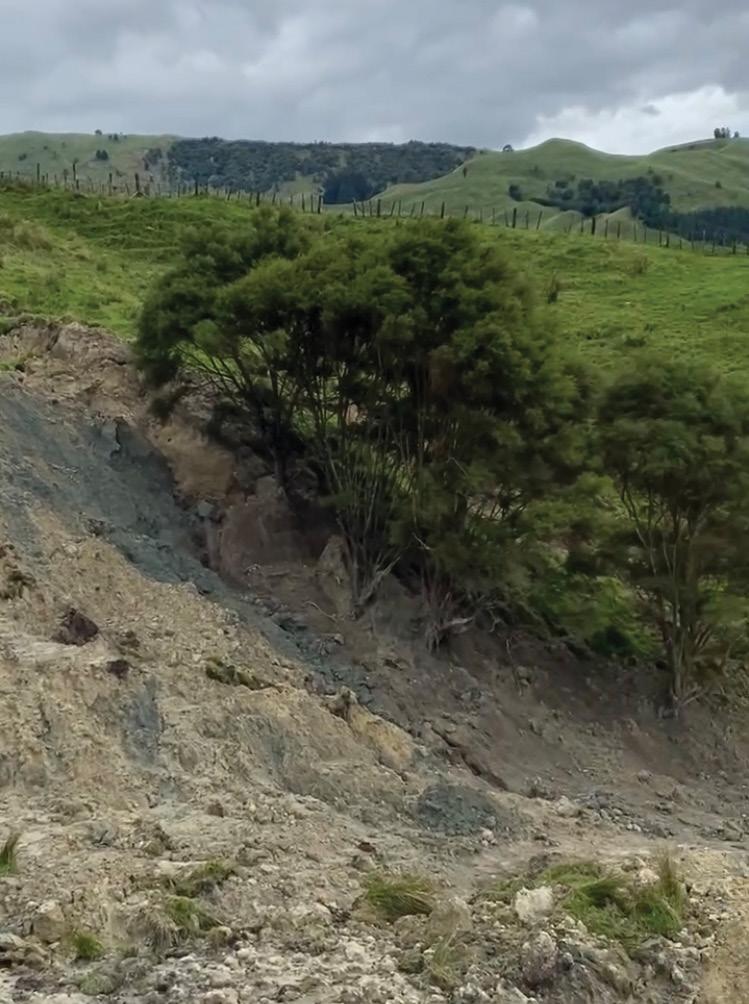

“But we’ll get there,” Grant says. They winter 5500 stock units, half cattle and half sheep, on 600 hectares with the main damage to the property being to fences and tracks “bowled by slips”.
There were a lot more slips during Cyclone Bola in 1988, but this time around much more material moved.
“There’s 40 sets of floodgates on the farm and a lot were broken or just gone.” Grant says.
Eight dams now filled with soil will need to be dug out.
With many breaks in fences their ewes were shifted to have the run of what had been four paddocks and only one lamb died; the rest of their stock were left to look after themselves on the hill country. The priority was opening up tracks to get around the farm and then to slowly tackle fencing repairs.
“You’ve got to prioritise what’s most important to get done so you can get back to normal as soon as possible,” Grant says.
“If you think about it, you’ll get overwhelmed. The ground is so saturated that it only takes a few millimetres of rain to get everything wet. You’re fighting a losing battle. There’ll be a lot of tidying up in summer.”
While there’s plenty of grass, Grant’s noticed their cattle are very tentative about where they go. “They won’t go onto anything where there’s mud, so they’re difficult to shift,” he says.
“The real nightmare was getting the lambs home to shear. That happened two weeks late because we had no communication.”
To get stock off the farm they ran their lambs down the road and out through a neighbour’s property, something that will need to be repeated.
While the Hicklings’ access road is passable by four-wheel drive vehicles, one load of metal to make it usable to
other vehicles can’t arrive soon enough.
“We had a bulldozer and we bought a digger – we’re almost getting around now.”
Ironically, the deal to buy the digger was being done over the phone when the power cut out on the Monday night of Cyclone Gabrielle.
“It was out for a couple of days and we had no landline from Monday until Friday,” Grant says.
Cell phone coverage went as well until Grant got to a paddock called ‘Faraway’ from where the sea can be seen.
“Suddenly I got a lot of messages,” he says. “It’s ridiculous how much we rely on them.”
They hauled out the transistor radio, but the eight batteries they had were all the wrong size. “So we ended up eating toast in the car listening to the radio in there.”
Their house wasn’t damaged, making them very sympathetic to farmers struggling through mud during the day but unable to go back to a warm and clean home.
When Grant poisoned his finger cutting up dog tucker and went into town to the doctor, he was pleasantly surprised to find an appointment wasn’t required.
“Their fridge wasn’t working so I needed to go to the hospital to get a tetanus injection. I went straight into A and E –it was a breeze.”
Country-Wide Beef | MAY 2023 149
POST CYCLONE
Grant Hickling plans to tackle the extensive fencing repairs once work is completed on restoring the roading system on the farm at Rere, inland from Gisborne.
Opportunities from disaster
Peter Andrew is no stranger to cyclones but says Gabrielle showed the progress we’ve made in some areas and has highlighted ways to do things better.
When Cyclone Bola struck in March 1988, I was a farm adviser with the Ministry of Agriculture based out of the Gisborne office.
I was also part of the team that assessed the damage in the district and prepared a report that we faxed off to Wellington. The report assessed the damage, the consequences and then suggested the best options.
The resulting Bola payment for damages was controversial, but was an investment as it was ruthlessly targeted around need. It was a great example of when one of the team is having a hard time, the rest rally to help.
When our regions get hit by these
big events the hurt is both financial and moral. It is a long way back and there are no winners. The world and particularly New Zealand needs to have a strong and vibrant provincial fruit bowl and vegetable bin. A speedy recovery is in everyone’s interests. When the chips are down and you are up to your armpits in silt, there is nothing more powerful than “we have got your back”.
Bola v Gabrielle: which was worse?
Cyclone Bola was worse as it impacted significantly on just about every farm right across the district. In contrast, Gabrielle had a pretty random path as
she wandered across the district causing havoc. Some farms got munted, even worse than Bola and then other farms had little to no damage.
In 1988 there was no internet and communications were at a primitive level compared to today.
A positive to come out of Gabrielle was just how far we have come with weather prediction and the monitoring of these events. We had the computer models satellite imagery accurately predicting Cyclone Gabrielle six days out. There is then the opportunity to double check the meteorological suggestions on any one of the four weather forecast sites.
Critical data monitoring is better
On the night Gabrielle struck I used a combination of rain radars and realtime rainfall data loggers that Gisborne District Council had spread right across the catchments to monitor the precipitation.
Many of our more troublesome rivers are also monitored on an hourly basis for height and flow. A couple of our rivers are even live-streamed for those who struggle to believe the river levels.
The coolest part is the predicted river state which works off the level and then adds the predicted forecast rain to bravely predict where it might be going. The modelling and predictions have (unfortunately) been very accurate.
The next thing is my mobile phone
Solar panels have been a hero in Gabrielle because water and electric fences charged on without missing a beat.
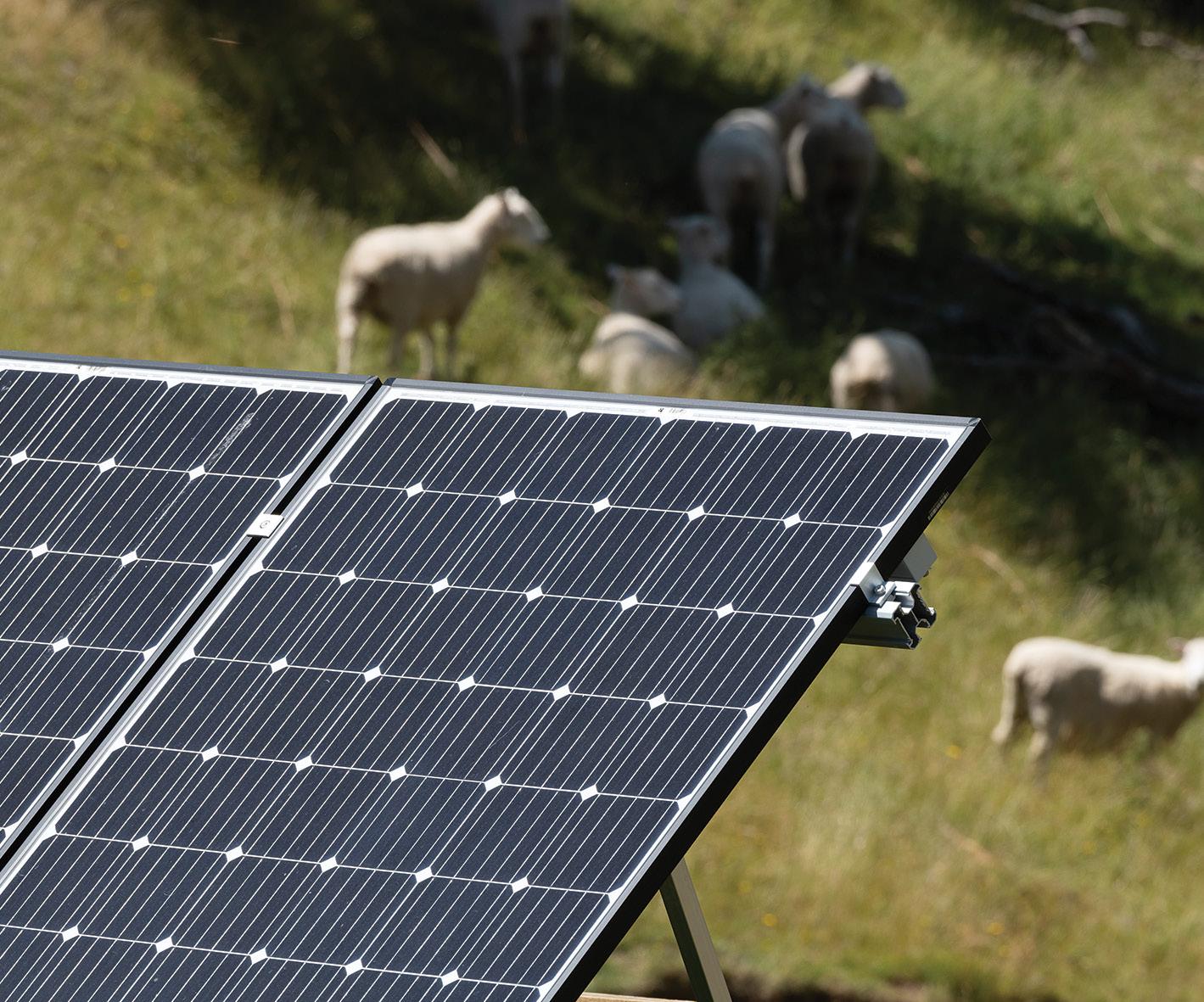
150 Country-Wide Beef | MAY 2023 POST CYCLONE
buzzing with a multitude of alerts.
All of this is pretty damn slick when you compare it to 1988 when we would have had TV, radio and a newspaper to tell about the pending arrival of Bola.
Sure, it all went to custard afterwards with our internet and phones crashing out, but we don’t want to detract from the huge progress that has been made. I’m sure a little more resilience is being built right now in many of the communication and internet businesses around NZ. Listen and change to build a better future.
How did pastoral farming get on and what can we learn about the future?
In Bola days we had lots of small pot dams that lasted till a drought, but not through one. They also had a high risk of filling up with silt in an event, which they did. Now, thankfully, we have moved to either reticulated water supply or huge dams.
There is a huge opportunity with onfarm recovery to have more dams set up to manage the rainfall intensity to reduce the runoff that heads downstream.
There are a few certainties in life, but
Fences and paddocks
Paddocks and fences are an important part of successful farming and needed for pasture control. Back in the 1980s we had quite a big push for intensive grazing systems in this district. To control the pasture, we had big mobs with regular shifts, which meant lots of small paddocks.
Now, through policy changes, we have bigger paddocks, meaning fewer
death, taxes, potholes and losing power in a storm are a few of them.
Solar panels have been a hero in Gabrielle. Solar-powered water and electric fences have charged on without missing a beat. There is a huge opportunity to continue to expand this area to take out the need for generators right through to totally going off the grid.
Hill soils protected
Some of the oldest trees planted for erosion control on our farms are now more than 70 years old. After Cyclone Bola rolled through, the poplar and
fences are in dodgy places.
Slash just loves riparian fencing, so it’s not really an option unless you are one of the lucky ones who don’t have forestry in the catchment.
The fence rebuild presents many opportunities to do it better. We also need to have an open mind to fenceless solutions, such as smart collars, Shepherd and Halter.
willow planting ramped up with just about every farmer planting poles in the most vulnerable spots.
So how have they fared in Cyclone Gabrielle? As you look around the district, the farms with a sensible amount of poles have protected the soils to a very high level. Hidden behind the slash is a huge success story.
Yes, we do get some erosion, especially on some of our steeper soils. However, in this district this happens with any land use, even native bush. A classic example of erosion being a natural process is erosion that continues to occur deep in the Raukumara ranges.
As long as you have tectonic uplift, rainfall and gravity, you are going to have some erosion. It is a natural process. Isn’t the name of the game to minimise erosion and to minimise any negative impact on your neighbours and community?
If you take away the impact of the logs and the slash then the sheep and beef farmers in these regions have survived Gabrielle extremely well.
Farming is far more resilient now than it was at the time of Bola, but there are still lessons to be learned from cyclone Gabrielle.
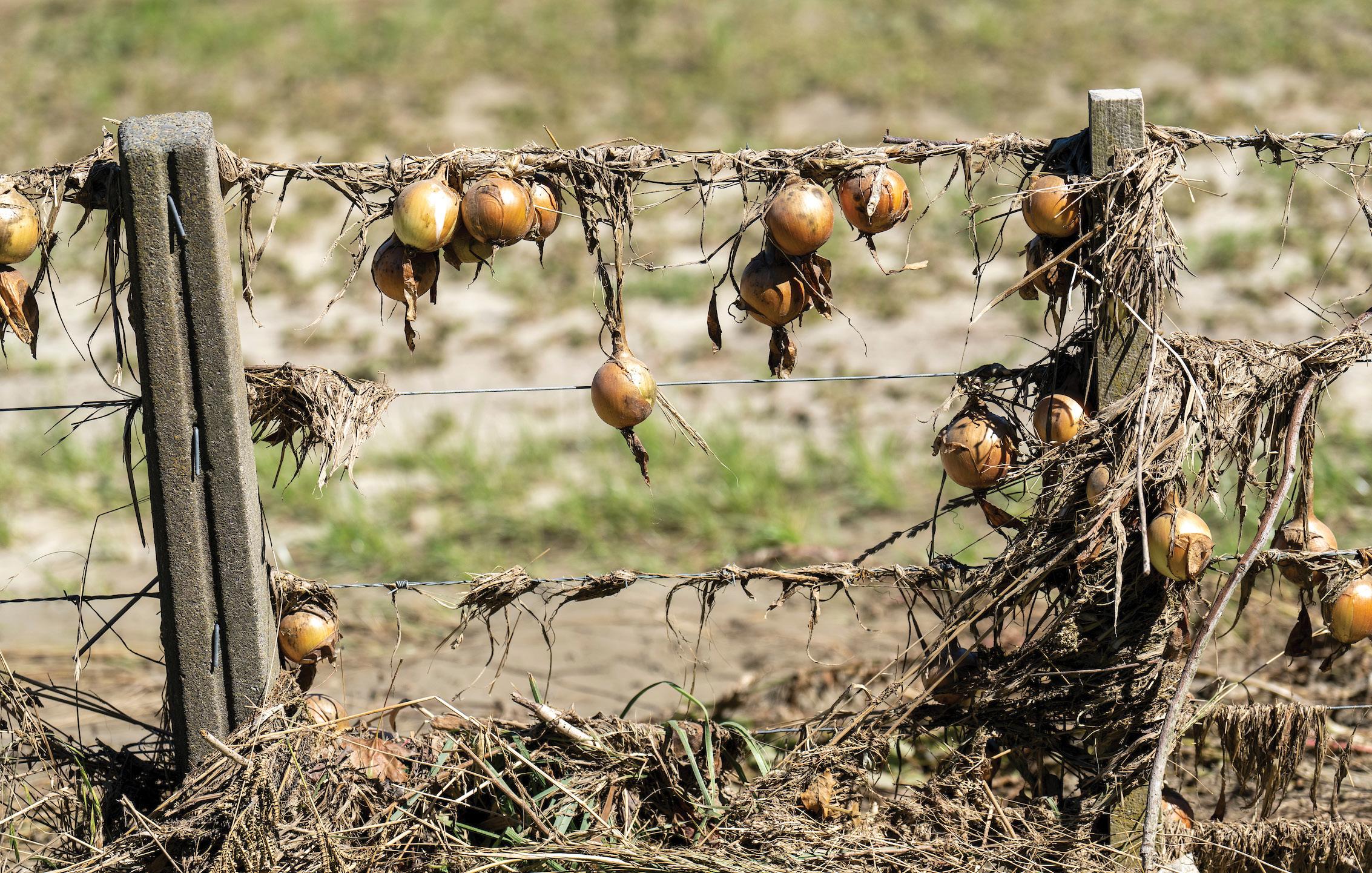
Country-Wide Beef | MAY 2023 151
“Cyclone Bola was worse as it impacted significantly on just about every farm right across the district.”
The power of nature
One thing I don’t like doing is writing about things I don’t really know about, so this is an opinion piece not based on hands-on experience.
In 1989, the year after Cyclone Bola, the New Zealand Farm Forestry conference was held in Gisborne. The conference delegates travelled around the district to look at some of the damage including the huge Tarndale slip.
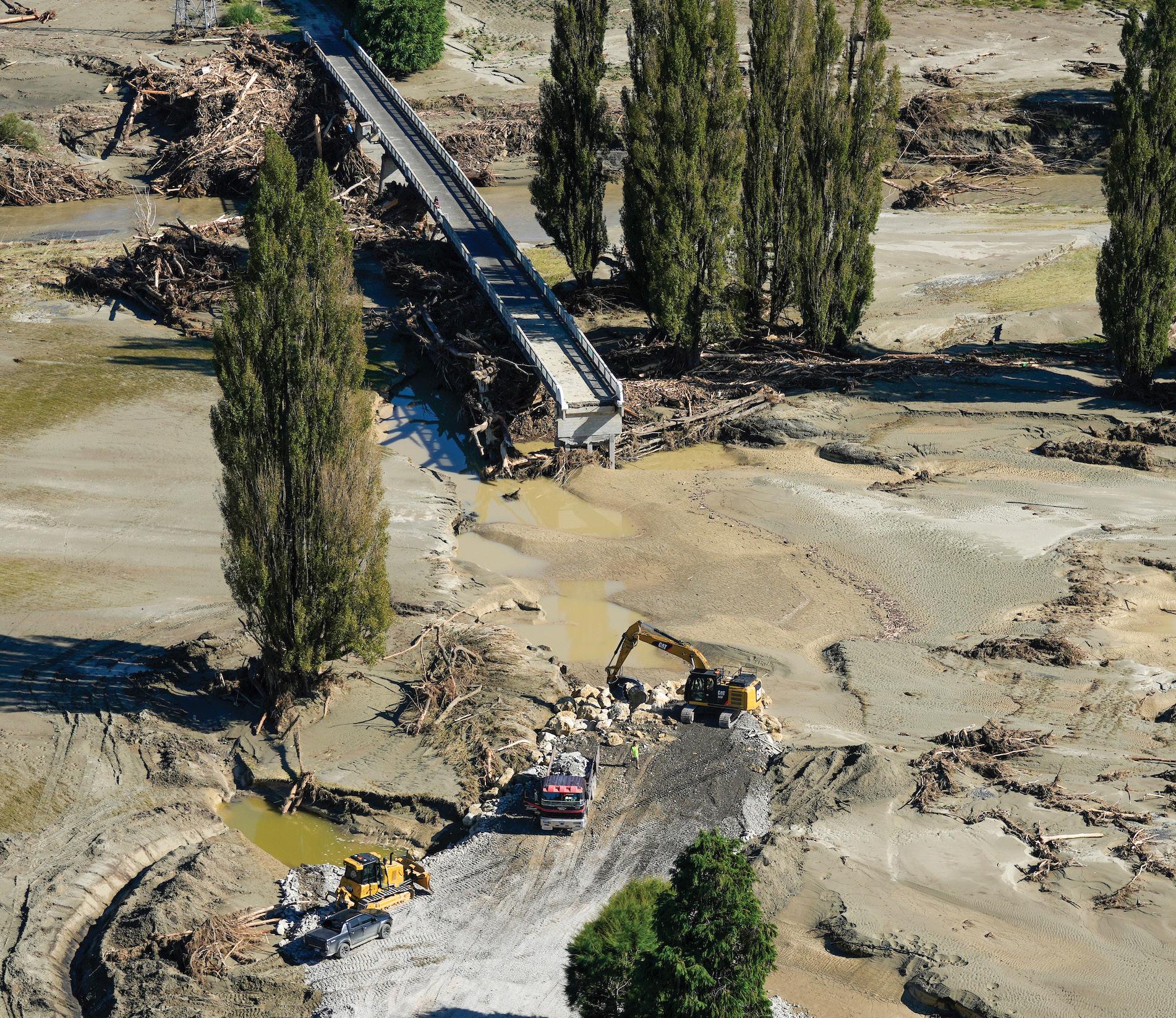
During a discussion afterwards I was howled down for saying the fertile Gisborne flats had been built up with soil washed down from the horrible, steep, eroding high country and it was better, in the long run, to let the erosion continue.
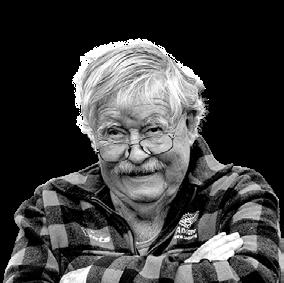
My comments were, understandably, not well received and masses of pines were planted. The result has been a mixture of not just silt, but silt and pine slash.
In 2002 Hastings Pak’nSave put in an underground car park. About 10 metres down, after digging through various layers of shingle and silt, they
hit prostrate tree trunks, mostly totara and kahikatea. The area has a history of flooding.
The Esk Valley’s last major flood was in 1938 when it was mostly pastoral land. It recovered to become highly productive with grapes, orchards and horticultural crops. After Gabrielle they have all gone, but with time will recover.
The Ngaruroro and Tutaekuri rivers, the cause of so much damage, both have a total of 26km of stop banks, which have been raised several times but were breached or over-topped in 30 places by Cyclone Gabrielle. The Hawke’s Bay Regional Council plans to raise them even more to cope with a 500-year flood event. Trouble is, the bridges will also have to be raised.
In 1934 Sir Francis Chichester, the round the world sailor, planted a pine forest in the Marlborough Sounds. His idea was that the resulting logs could be dropped downhill, straight into the sea and loaded from there directly on to a ship.
In 1934 pleasure boats were slow-
152 Country-Wide Beef | MAY 2023
Peter Arthur writes we can learn from previous weather events and has ideas for land use after the flood.
Peter Arthur is a Hawke’s Bay farmer.
POST CYCLONE
moving sluggish things, but by the time Chichester’s forest was due for harvest, speed boats had become very common and to prevent them having accidents with logs in the water, the rules were changed. The logs had to be winched to the top of the hills, using skyline haulers and then trucked out on rather expensive roads. No slash was allowed to get into the sea.
Cutting the slash
With mobile chippers and compact container-sized equipment, the slash can be processed on the skid site. The slash problem is solvable and probably rather expensive to do, but possibly much cheaper than the cost of clearing it off the fertile flats, off the beaches and out of the smashed up houses. Scion was doing research on turning wood waste into biofuel but the Government has recently stopped funding that.
In my 75 years here, I have never
seen the farm so wet and it was wet well before the two cyclones. I think the damage is a bit worse than Bola. About 15 years ago Martin, who runs the farm, and his family spent a couple of days planting poplar poles on the steeper faces, and apart from one tree falling over, there is virtually no slipping where the trees are.
I have a stand of nine-year-old pines and one slope, about 50 metres across and 100m deep, the whole lot, from top to bottom, has slid down the hill. Another steep face, with manuka, kanuka, oaks and pines has slithered downhill on top of a rather large $5000 culvert. The face is papa, which nothing much can get its roots into.
We didn’t get the wind that caused much tree damage around Hastings and devastated 4000ha of pine forest in the Turangi-Taupo area. Many of the Hawke’s Bay forestry crews are up there salvaging as much as they can. Due to access
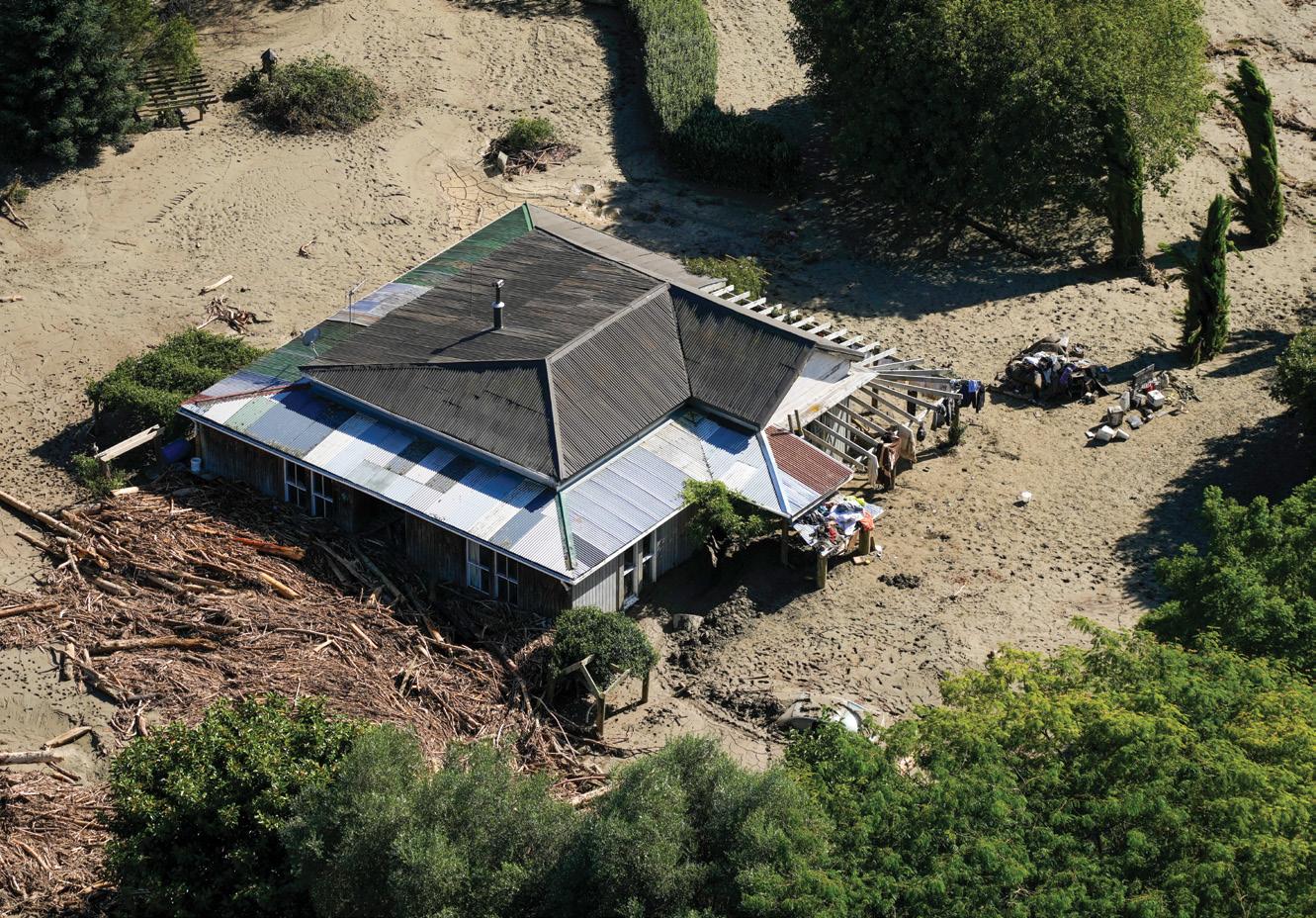
problems, logging has stopped in most of the local forests. The equinoctial gales normally start about now in this part of the world and this will cause lots more trees to blow over, the ground being so wet.
Ideas for getting through
Aerial photos of some of the steeper Hawke’s Bay sheep and beef country seem to show more slips than pasture and the stocking rate will need to be halved for the next five years. The cost of re-fencing, clearing tracks and fixing bridges and culverts is going to be huge. I would fence off a manageable area and start planting poplar cuttings for carbon credits. All you need is 50 to 60 trees a hectare and once they are five metres tall you are eligible for carbon credits. Though I have pre-1989 carbon credits, I have no idea how the system works.
In five years time you will be able to run stock amongst the trees, and in drought years feed the prunings to livestock. I would also be planting acorns and walnuts, using a long-handled spike to make a hole in which to drop each seed, some of which will grow. For inspiration read the little book, “The Man Who Planted Trees” by Jean Giono. Finally, all trees drop branches, and if not logged, will eventually die causing another debris problem for the next generation.
Our native bush and forests are under threat from the exploding population of goats, deer and wild pigs that are destroying the seedling undergrowth, essential for replacing the big trees when they die.
Geologically, NZ is a young country with the mountains and higher country slowly eroding to build up the fertile plains. We cannot beat the power of nature. Look at the weather with its floods, droughts, blizzards, heat waves and tornados, then add in tsunamis, earthquakes and volcanic eruptions, which we have absolutely no power to control. The only thing we can do is adapt to our ever-changing environment.
Country-Wide Beef | MAY 2023 153
“With mobile chippers and compact containersized equipment, the slash can be processed on the skid site. I think the slash problem is solvable… “
Cyclone Gabrielle damage in Esk Valley north of Napier. Photos: John Cowpland.
LESSONS FROM THE SIM VALLEY
LONGTIME SIMMENTAL BREEDER Tony Thompson (pictured right) didn’t know it at the time, but his unexpected visit to the Sim Valley in Switzerland in the late 1960s would have a huge impact on his life.
As the name suggests, the Sim Valley is the original home of the Simmental breed, first imported into New Zealand in the early 1970s in a wave of exotic cattle imports.
Tony had completed his final year at the newly minted Massey College Veterinary School and headed off on a P&O round-the-world cruise with his new wife Glennis.
During a holiday break from studying equine embryology at Cambridge University, he and Glennis bought a minivan and headed for the Continent, winding their way through several countries including Switzerland.
Their visit to Sim Valley coincided with a local cattle auction and the Thompsons were able to see locally bred Simmental animals up close for the first time. When the opportunity came a few years later when imports to NZ began, they were keen to get involved, and established Glen Anthony Stud.
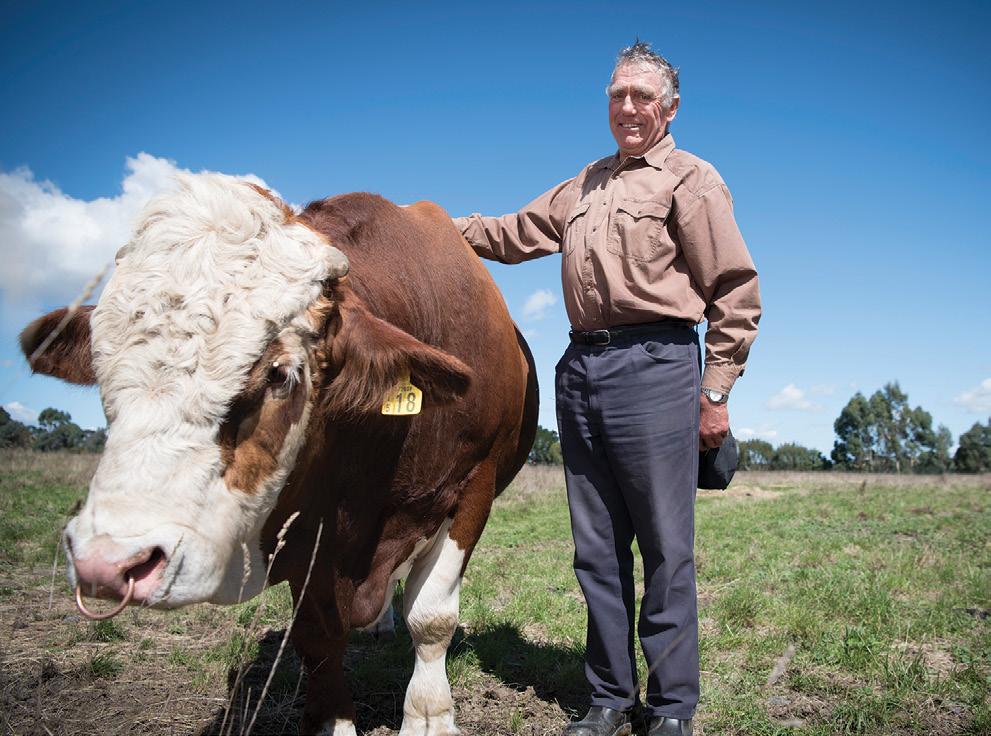
With 50 years of breeding Simmental cattle under his belt, he’s still passionate about the breed and misses the A & P shows and National Bull Sales events that put Glen Anthony stud front and centre with commercial and stud cattle farmers nationwide.
He’s proud of their many show and sale achievements, including countless Royal and regional show ribbons plus an enviable record from 34 years of two-year-old bull sales.
Last year’s sale was Glen Anthony’s best yet when the first eight bulls to enter the sale ring were bought by other studs, keen to access the Glen Anthony Executive bloodline.
At the rising two-year weight date, Executive was 100kg
GOLD CREEK READIES FOR BULL SALE
THE WEATHER GODS and Cyclone Gabrielle haven’t been kind to the Gisborne region with some areas still battered and bruised, but the bulls in the line-up for this year’s Gold Creek Simmentals sale on May 22 at 2pm are nothing short of spectacular.
Gold Creek Simmental have been working hard to continue to build on their well-known traits of high growth, fertility, structure and docility. As always, the EBVs back it up so you know you’re always making the most accurate and informed decision about the bulls to buy.
heavier than his contemporaries and his eye muscle area was about a third bigger than the average at 130 square centimetres.
“So, we kept him and bred from him. His carcase data was really good and when used over our Waiata cows, it was a match made in heaven.”
In the past few years, Tony has been importing and using semen from two homozygous polled bulls from North America.
The 2023 sale will feature the first line of bulls bred from a Canadian sire, Grinaltas HP Sensation, to be sold in NZ.
He’s also impressed by the yearling progeny he’s bred from semen from a United States bull, Saint John Gatton, which will be offered at the 2024 sale.
“His yearlings are looking magnificent so buyers will have plenty to consider in the coming years from Glen Anthony.”
Climate and conditions have not prevented the team at Gold Creek Simmentals from cutting any corners. They recently bought semen sire Woonallee Secret Service S086 at the Woonallee Simmentals sale in South Australia in partnership with Agri-Gene in February. Secret Service’s presence, power, super soundness, homo-polled and impressive data sets aligned perfectly with their breeding programme.
Stud master Tom Sanson and his team will also give the ring an early heads up with an exciting announcement on
a new progeny project they’ve been working on. All they can say is it is the New Black, so we’ll leave it at that!
Gold Creek Simmentals Open Day will be on Friday, May 5. This will be an opportunity to get a deeper insight into what Tom and his team have been focusing on in their breeding programme.
Find out more: call 027 248 9098 or email goldcreek@ gisborne.net.nz or visit https:// goldcreeksimmentals.nz/
154 Country-Wide Beef | MAY 2023 SOLUTIONS
+ Glen Anthony Bull Sale, June 8 2023.
KAYJAY NOTCHES UP ANOTHER BIG MILESTONE
LOCATED ON THE eastern hills of Wairarapa, the KayJay prefix was established in 1958 by brothers Terry and Graeme Kjestrup.
Cows were sourced from Waiterenui, Cricklewood and Elgin studs with real emphasis on depth of body and fleshing.
In 1980 Terry’s son Neil took over the stud master duties and carried the stud to some great heights over the years from repeatedly topping the Wairarapa combined breeders sales to holding KayJay’s first onfarm bull sale in 2005 where KJ West 422 sold for $30,000.
KayJay now has the fourth generation Kjestrup at the helm of the stud with son Roddy and wife Sam as well as Neil and Joan farming together on the 590ha property. The stud consists of 190 cows and heifers that are born on the hills and stay there through their lives.
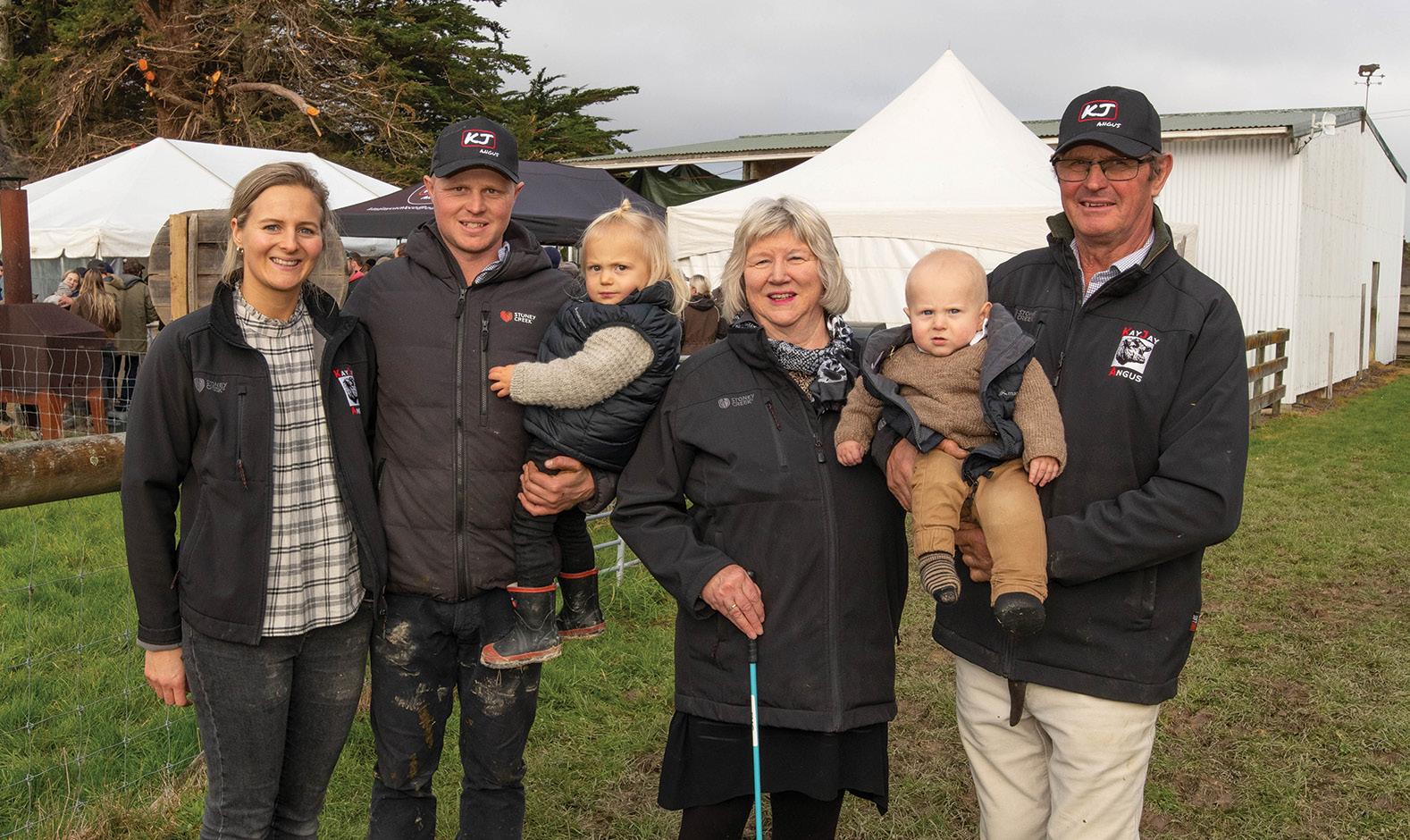
The stud operation is run alongside 2300 ewes, with the cows playing a key role in the success of the sheep performance.
The KayJay cow needs to be moderate in frame, milk well and rear calves that display rapid growth through to weaning. Many cows wean about 60% of their own body weight.
The aim is to breed an Angus female that will outstrip any cross-breeding programme.
KJ bulls are becoming well recognised for adding depth and thickness into both commercial and stud breeding programmes with bulls being sold all over the country. Clients are consistently topping weaner fairs with a premium being realised from the demand by finishers for these genetics.
This year KayJay is proud to have 28 of its 44 bulls in the sale catalogue sired by KJ sires.
“The test of any breeding programme is the ability to use our own genetics successfully as there is no better way to get a gauge on how your own genetics perform,” Roddy says.
A feature of these homebred bulls will be the first sons sired by KJ BigMac Q324, sold to Shian Angus in 2021 for $56,000.
This year’s sale starts at 2pm and will be followed by a live band and KJ’s great hospitality. Accommodation will be covered for those travelling.
+ Find out more: Call Roddy Kjestrup on 027 303 9280
RAVENSDOWN LAUNCHES NEW TOOL
HawkEye Response, a software tool to help farmers map and deal with slips that have impacted farm effective areas, compromised paddocks, or taken out fences. Users can also identify erosionprone areas to prepare for future weather events.
The new tool combines pre and postCyclone Gabrielle satellite data with fixed wing aerial imagery and brings it into Ravensdown’s existing HawkEye software.
Once in HawkEye, the images of slips and washouts are cross-referenced against existing fence line data to give farmers an up-to-date spatial view of weather damage on their property.
Ravensdown chief executive Garry Diack says the tool will help farmers identify immediate hazards and other areas of concern so they can direct resources to those areas.
“Many farmers in Hawke’s Bay and East Coast still can’t easily access parts of their farm, so it can be incredibly difficult for them to get a representative view of what needs to be fixed first.
Farmers can identify each paddock’s new effective area and test methods of farm and stock management virtually before committing to any changes. The software’s analysis and editing abilities can also help with the set-up of exclusion zones so that slips can be retargeted for re-seeding and erosion-prone areas cordoned.
Diack says the software is designed to be an enduring part of the farmer toolkit and will be enhanced and improved as it develops.
“The aerial imagery gives farmers better ability to spot potential hazards for future weather events. As the latest aerial mapping and satellite imagery comes through, HawkEye Response will be updated so farmers always have a close to real-time picture of their land from above and can respond to any issues,” Diack says.
Ravensdown is offering the tool to cyclone-impacted customers free of charge. However, all farmers, including non-Ravensdown customers who are not already mapped in HawkEye can access this tool by getting in touch with their local Ravensdown representative.
Country-Wide Beef | MAY 2023 155
Sam, Roddy, Joan, Neil with kids Zara and Sullivan at last year’s annual bull sale.
HEAD BAILS AND ENTRY DOORS KEY TO FAST, SAFE HANDLING
FORTY YEARS AGO, few farmers had large-scale stock handling facilities and there was no manufacturing in New Zealand.
TechniPharm brought in systems from Australia and spent significant time educating farmers about handling stock in them. Most yards were designed around TB testing convenience rather than for optimum, stress-free and safe stock handling, so there was a big challenge ahead.
A few companies identified the same opportunity and several cattle yard ‘road shows’ where organised and stock handling became a drawcard section for many farmers and suppliers at field days.
Yet little progress was made in handling facility design. Most companies continued to focus on sales of steel crates rather than design for optimum handling.
Sliding gate-type head bails are still common, but these are not very effective in holding stock for jobs to be done on an animal’s head, like tagging or eye treatment. With an increased importation of China-based equipment, mostly using the same old designs, head control has not improved much either.
Technipharm’s design focus on animal
A FOCUS ON GENOMICS
PERFORMANCE BEEF BREEDERS (PBB) credits a significant part of its success to the strong partnerships it has built over the past two decades.
One of the most notable partnerships was formed in 2018 with Neogen, world leaders in the agriculture and food safety industry. This allowed PBB to step into the New Zealand genomics market and offer high-quality products to all beef breeders at competitive prices.
This move undoubtedly cemented PBB as the one-stop-shop for livestock breeders, with PBB already offering
science means its head bails have two key features.
First, a moon shape, rotating or V-lock design on the yokes. These fold around the animal’s neck and can be rubber-lined for an even more effective hold. This clever design creates a good 180-210-degree arm access space instead of 0 degrees with flat-face head bails. It also pushes the head further forward which also increases access.
Secondly, Technipharm head bails are locked with passive or active hydraulic or mechanical locking rams for optimum hold and silent stress-free handling.
These features have received many NZ and international awards over the years and created a substantial farmer following.
The latest design feature to Technipharm’s handlers is around entry gates. Traditionally, they are slide gates, either in one or two pieces, like an elevator door. The two-piece gates are a significant improvement on the single option.
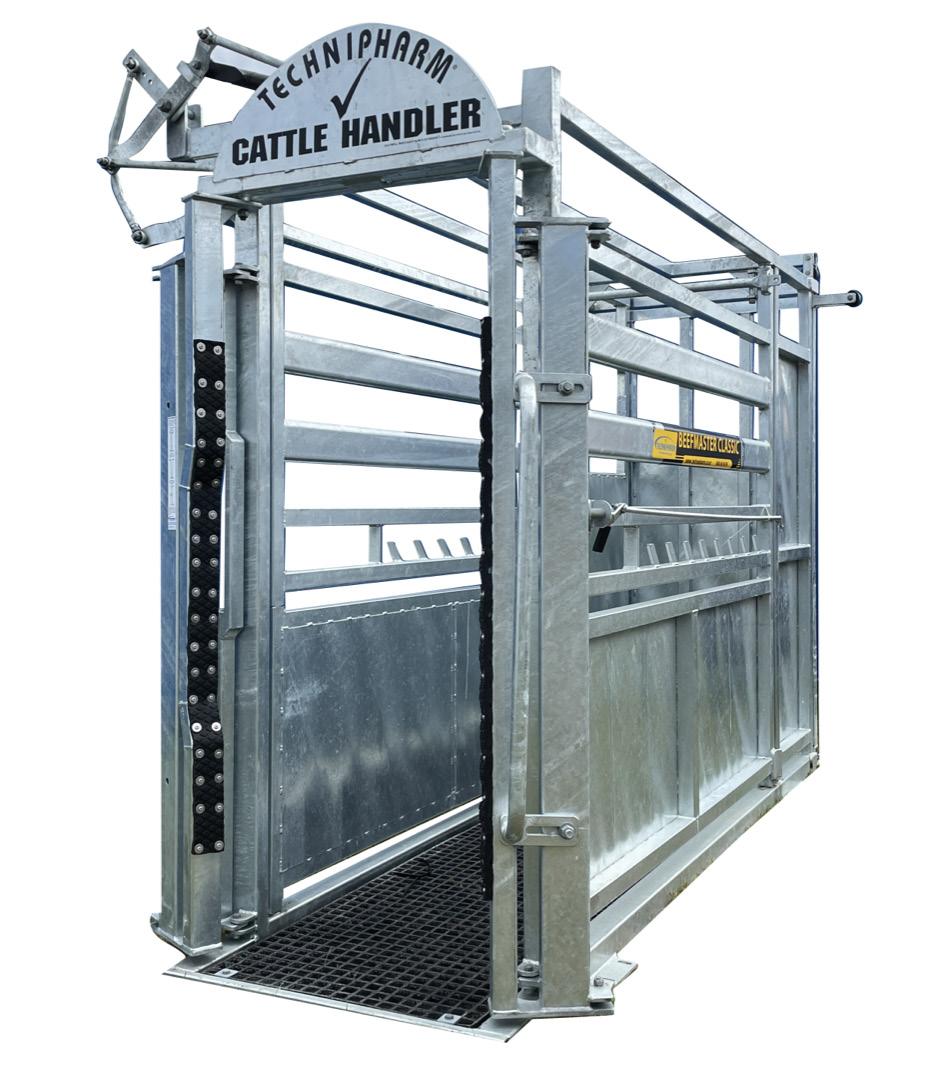
Two-piece doors slide out to each side by 400mm so any following animal can be quickly cut off the entry to the handler.
However, slide gates need levers and
connecting points which are subject to wear and tear.
Techipharm’s new Rotating Fast Entry gate has none of these limitations. It’s fast, silent and solid in operation, controlled by active hydraulics, making it the ultimate in handling stock.
Check it out at Fieldays 2023 next month at the Techipharm display inside the Main Pavilion.
admin, accounting, registry, and graphic design services to 10 beef societies in NZ, including Speckle Park International. Neogen’s manager business development Dr Pieter van As says it has been an exciting period watching breeders use the data from the DNA tests to make progress in their herd.
Through this partnership, accurate testing for genetic conditions became available. The PBB DNA team worked with the different breeds to create customised genomics bundles with varying genetic conditions to suit.
Dr van As says the ability to carry out disease testing such as BVD in conjunction with other testing was a game-changer. Farmers can now obtain everything they need from one sample. This is especially important as diseases can have a significant impact on a herd’s performance. When the opportunity arose to bring Neogen’s product Igenity Beef to NZ, they leapt at it. Igenity is a genomic test designed for commercial farmers with pure or crossbred animals of the following breeds: Angus, Red Angus, Hereford, Limousin, Shorthorn,
156 Country-Wide Beef | MAY 2023
+ More? Call 0800 80 90 98 or visit www.technipharm.co.nz SOLUTIONS
GALLOWAYS WIN GOLD
NEW ZEALAND GALLOWAY cattle breeders have achieved national and international success.
South Taranaki’s onfarm Chopped Butchery won gold with their traditional beef Galloway sausage in The Great New Zealand Sausage Competition 2022.
Kiwi Galloway breeders were placed in the 2022 Galloway Champion of the World Competition after being awarded three golds and Champion of the World.
Co-owners Adam and Eddie Rivett, who launched Chopped Butchery in May 2022 with the support of their spouses Karen and Jacque and won gold after operating for only five months.
The Morven-based butchery’s point of difference is being onfarm and specialising in supplying locally sourced Galloway beef. Demand has been steady for Galloway beef since the start of the venture. Stock are supplied by breeders Sylvia Anderson and Geoffrey Linton, Roger and Andrea Cotton, Rob and Lynne Hall, Gordon and Wendy Hellyer, Peter and Susan Lawson, Jill MaxwellStrang and Janinea Slee.
Galloway beef contains less saturated fatty acids and is a choice for a healthy diet. It is not only important to have a sufficient amount of unsaturated
fatty acids in our food, but to have two kinds, omega-3 and omega-6. These give protection from arteriosclerosis, thrombosis and are important to prevent blood from clotting and may even reduce cholesterol levels.
Cherrybank Arapuni Pride, a Riggit Galloway bull, won 2022 GallowayChampion of the World after he won gold and the title of Mr Asia/Africa, which includes NZ and Australia. He was bred and owned by Waikato’s Beth and Paul McVerry.
Dunollie Brick, a NZ belted Galloway
bull, won a bronze in the Mr Asia/Africa region owned and bred by Jurie and Tui Snyman.
Cherrybank Pizzazz, another NZ Riggit Galloway, won gold and the title of Miss Asia/Africa which then went on to gain a bronze in The 2022 Galloway - Miss Champion of the World. She is owned and bred by the McVerrys. Cherrybank Elisa, a white Galloway also owned and bred by the McVerrys, won a bronze.
The Galloway is one of the world’s oldest established breeds of beef cattle, named after the Galloway region of Scotland.
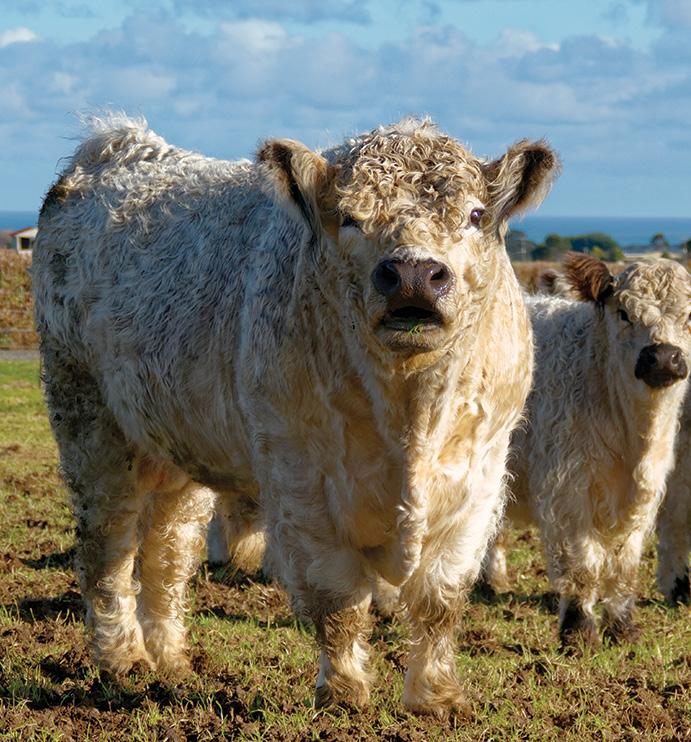
Galloways come in four breed types: belted, riggit, solid and white. They are a medium-sized beef animal, with a shaggy, double, weather-resistant coat which is one of its most distinctive characteristics. Cows breed easily with low birth weight calves, and are long-lived, excellent mothers and are naturally polled.
Galloways are extremely hardy, excellent foragers and thrive in cold rough, hilly country, being efficient converters of rough pasture into relatively lean marbled meat.
To find a breeder visit www. nzgalloway.co.nz/
Simmental and Gelbvieh.
It is an easy-to-use system which uses the power of genomics to rank cattle from top to bottom on performance and profitability. It does this by providing scores of 1-10 for 17 maternal, performance and carcase traits.
These scores provide farmers with a greater insight into their female’s potential fertility and performance without having to have a calf on the ground. This helps optimise selection decisions onfarm and can pinpoint weaknesses and strengths within a herd, leading to greater genetic gain and return on investment.
PBB general manager Harry Faas says until now commercial breeders could only see half the picture as they only had access to information on the male line. Now with Igenity they can see detailed information for the female line as well. This allows them to easily invest in cows that are easy calvers and consistently produce thrifty, high-quality calves. Before the system was made available in NZ, a lengthy validation process - which coincided with an upgrade to the system – was required.
PBB national territory manager Ella Holland says, “The purpose of the validation process was to make sure
Igenity was compatible with our animals and the farming system we have in NZ. We added genetics and performance data from NZ animals to help with this.”
All Igenity users are assigned their own dashboard where results are uploaded.
“With the new sorting tool farmers can have cattle sorted in minutes. It also has special features such as a custom index builder, three pre-made indexes and a benchmarking tool that ranks a farmer’s animal against the entire database of over 18 million animals.”
Country-Wide Beef | MAY 2023 157
More? Go to www.pbbnz.com/
CRUIZY CALVES HIT THE SPOT
INVESTING IN TOP genetics without compromising constitution has always been a priority for the McFadzean family, who farm 18,000 sheep, 1500 cows and 600 deer across four properties in Wairarapa.
Last September at their fifth annual yearling bull sale of Meat Maker and Super Angus bulls, they offered their first consignment of the McFadzean Cruizy Calve bulls from a recently acquired herd of specialist low birth weight, short gestation Angus cows.
The sale was a real success with the Meat Maker and Super Angus selling for an average of $4800 with a top price of $13,200 for a bull sold to Grassendale Genetics, a long-time supporter of our programme, and the Cruizy Calves selling for an average of $3000 with a top price of $6500 to Herrick Land Co.
Stud master Johnie McFadzean manages
the company’s Meatmaker, Super Angus breeding program and new Cruizy Calve Angus herd on the family’s property west of Carterton in Wairarapa.
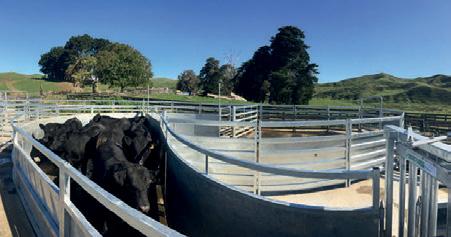
The focus has been on having a sustainable and high performing cow herd. They expect their cows to wean a calf that is more than 53% of the cow’s live weight year on year, regardless of the season.
Replacement heifers are selected under strict criteria, considering type, constitution, temperament, and durability.
These commercially focused selection criteria are mirrored in their stud operation.
The bulls are selected in early March and the remainder of the bulls are sold at the Masterton weaner fair. This year’s weaner fair was strong again for the McFadzeans and some of their clients.
We Make Farming Ezy
They sold just under 260 weaner bulls receiving a top price of $1460 and an average of $1280.
Two clients, Patrick Cattle Co and Waikaramu Station, both received top prices of $1160 and an average of $1130 for their weaner steers.
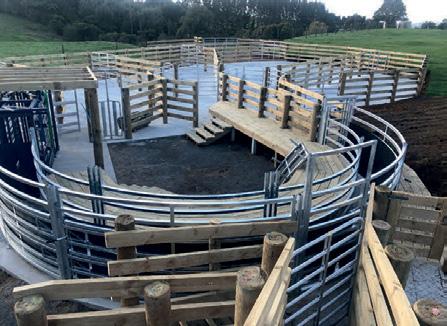
In spite of an extremely tough spring, this year’s sale line has come on well and is shaping up to be some of the better bulls ever put up for sale. The Cruizy Calve bulls have weaned well at an average of 300kg, 20kg above last year’s average. The Super Angus and Meat Maker bulls have averaged 380kg at weaning which is on par with previous years.
+ The McFadzeans open day is on August 30 and their sixth annual sale on Thursday, September 14, 2023.

The #8 is designed with animal wellbeing in mind, great access and excellent, comfortable handling is what any animal on farm deserves. Safe, fast and ezy working conditions are needed for operators, contractors and vets alike.
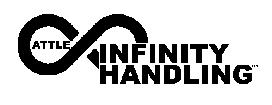
The Highflow 260 HD Extreme™ is designed for the very serious stockman. This is the stake in the ground where real handling starts and mediocre handling stops. The Highflow 260 HD Extreme is not just about steel or power... it’s about clever and intelligent engineering for a purpose.
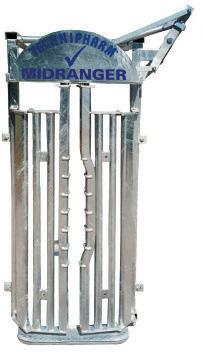
CURTAIN™
The Cattle Curtain™ makes your yard work easy and safe. Most yards have a lot of gates; gates require people in the yards often in amongst stock. Now place Cattle Curtain™ anywhere in your yards where cattle should only travel one way.
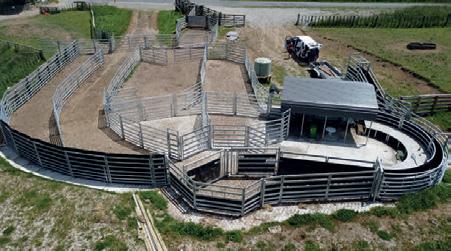

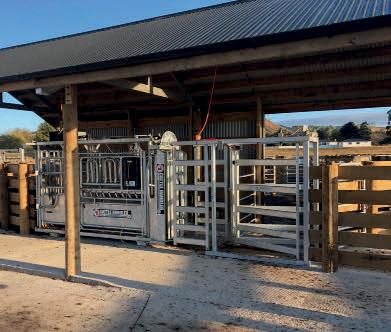
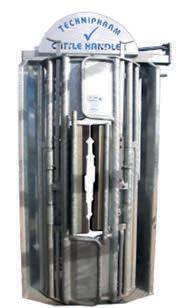

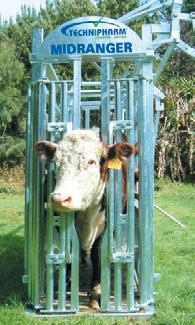
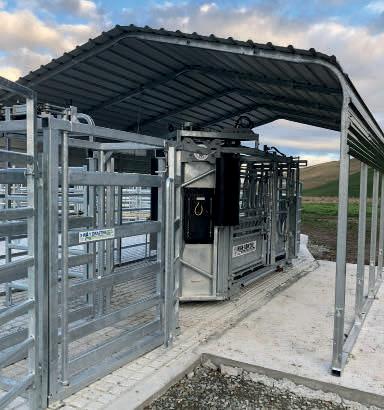
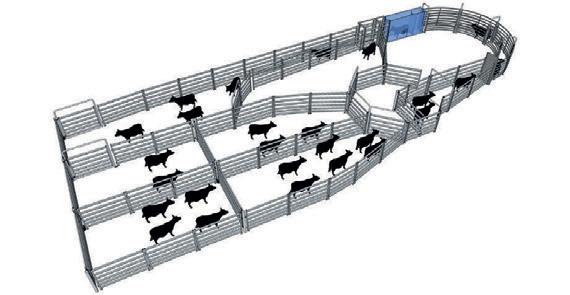

158 Country-Wide Beef | MAY 2023 TH2099 28/04/22 WWW.TECHNIPHARM.CO.NZ 0800 80 90 98 WWW.TECHNIPHARM.CO.NZ 0800 80 90 98 Smart-Yards™ are the hallmark of quality and functionality. TH2033IN 21/05/19 SMYINNAVIGATOR360COREEXTENDED3DA32019.indd Navigator 360 Core Extended FREE 0800 80 90 98 “we mak Wondered what its like to work in high performce cattle yards? Make farming ezy HIGH PERFORMANCE YARDS SMART-YARDS™ CATTLE HEADBAILS
#8 HANDLER™ HIGHFLOW 260™ CATTLE
MID RANGER MEDIUM SIZE™ MID RANGER FULL SIZE™ ROTATING YOKE ™
®
benefit from our
standard
or custom designed.
The design of your new yards will significantly
input
plans
SOLUTIONS
OVER THE PAST decade, the disease management agency OSPRI has been edging closer to eliminating bovine tuberculosis (TB) from New Zealand.
At the start of 2023, fewer than 30 herds had TB infections, a far cry from the 1990s when the number was close to 1700 herds.
Pest management is a major part of the TBfree programme. Aerial and ground control are the main form of control for possums, the main TB spreader. While much progress has been made, elimination is still in sight.
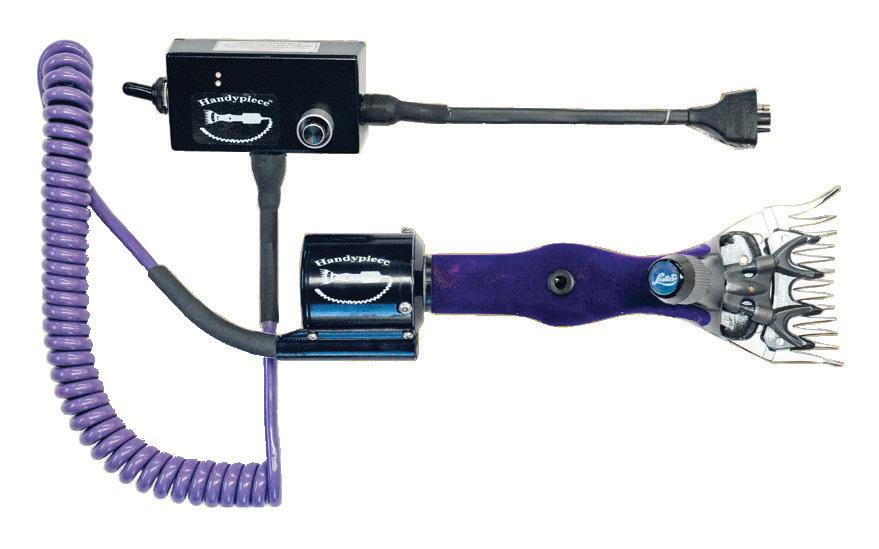
An example of how the eradication programme is working can be seen in the upper South Island high country of Molesworth Station and the neighbouring Muzzle and Bluff Stations. With recent 1080 aerial operations, farmers in the area are feeling positive that their properties may soon be clear of TB.
Bluff Station’s Hamish Murray (pictured) says one of the keys to having a successful strategy is cooperation and unity with neighbouring farmers.
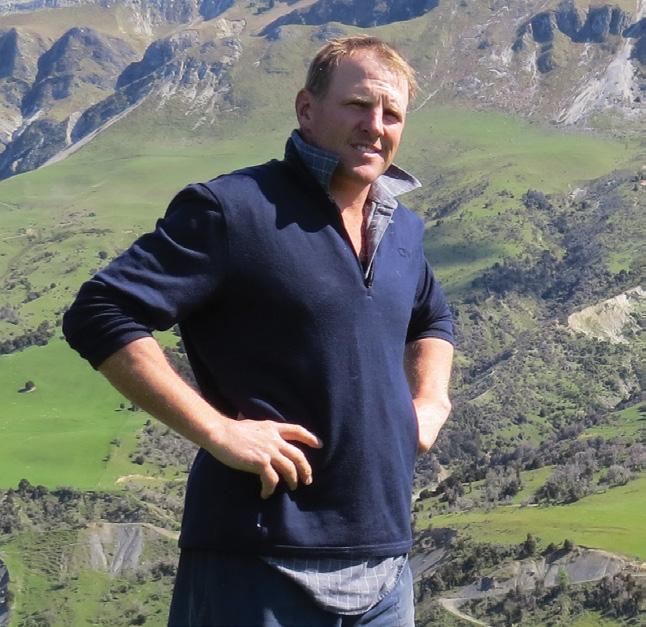
“Ultimately there are no TB-infected possum populations around the edges of our property, but if the leakage that comes from the far end of the Bluff or from the Muzzle or the Clarence Reserve comes this end, and if we neglect to manage those possum populations in this area, then we run

the risk of that exploding.”
Molesworth Station manager Jim Ward says it looked like they had beaten TB in the late 1990s, but there was a massive explosion of herd breakdowns when follow-up possum control was neglected.
“That is never going to happen again,” says Jim.
“All the people who had knowledge of that period at OSPRI are not going to forget, and they won’t let the country down.”
OSPRI’s senior veterinarian Kevin Crews says it’s been a progressive strategy over the past 50 plus years.
“We’re now in what I like to describe as the home stretch. Getting TB out of the Clarence catchment is a critical part of the success not just of the strategy in this local area, but the TB plan nationally.”
Another reason why this area is critical, Crews says, is because of the grand scale, and the fact that we’re on the cusp of eradicating TB over half a million hectares, which is a very good indication that the national TB plan itself can be ultimately successful.
Muzzle station farmers Guy Redfern and Colin Nimmo have been dealing with TB for more than 30 years and will be glad to see it gone for good.
When the government’s policy changed to eradicate TB as a country, Guy says the Clarence River area became a priority.
“We just did one round of 1080 poison really and some ground control work. And we were clear within two years basically. Eradicating TB is hugely important because otherwise it’s just going to always be there, potentially. And there’s a massive cost already even just trying to control it.”
Father-in-law Colin Nimmo says not fully eliminating TB now would be risky.
“We need to finish it off really, we’ve done a hell of a good job of getting TB down to a very low number of herds. What we need to do now is get rid of the little pockets of TB that’s left because once you take your foot off the hammer it’ll just come back again.
“It will be easier to finish the job off now than let it come back and we’ll be back to square one,” he says.
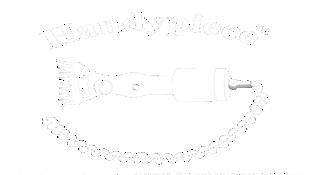
Country-Wide Beef | MAY 2023 159
MOVING CLOSER TO THE FINISH
handypiece n Ideal for trimming cows tails, shearing sheep, alpacas and goats n Variable speed from 2600-3500 rpm n Latest brushless motor technology means minimal heat build up n 1400gms means 100-200gms lighter than standard handpiece n At 2800 rpm the 12-volt lithium battery will trim up to 400-500 cows tails or crutch 300-400 sheep n Auto reset fuse for overload or lock up View in action go to www.handypiece.co.nz Email: dave@handypiece.co.nz Free call 0800 474 327 powerfulWorldsmost variable speedclipperishere • FASTER • LIGHTER • VARIABLE SPEED
TB:
LINE
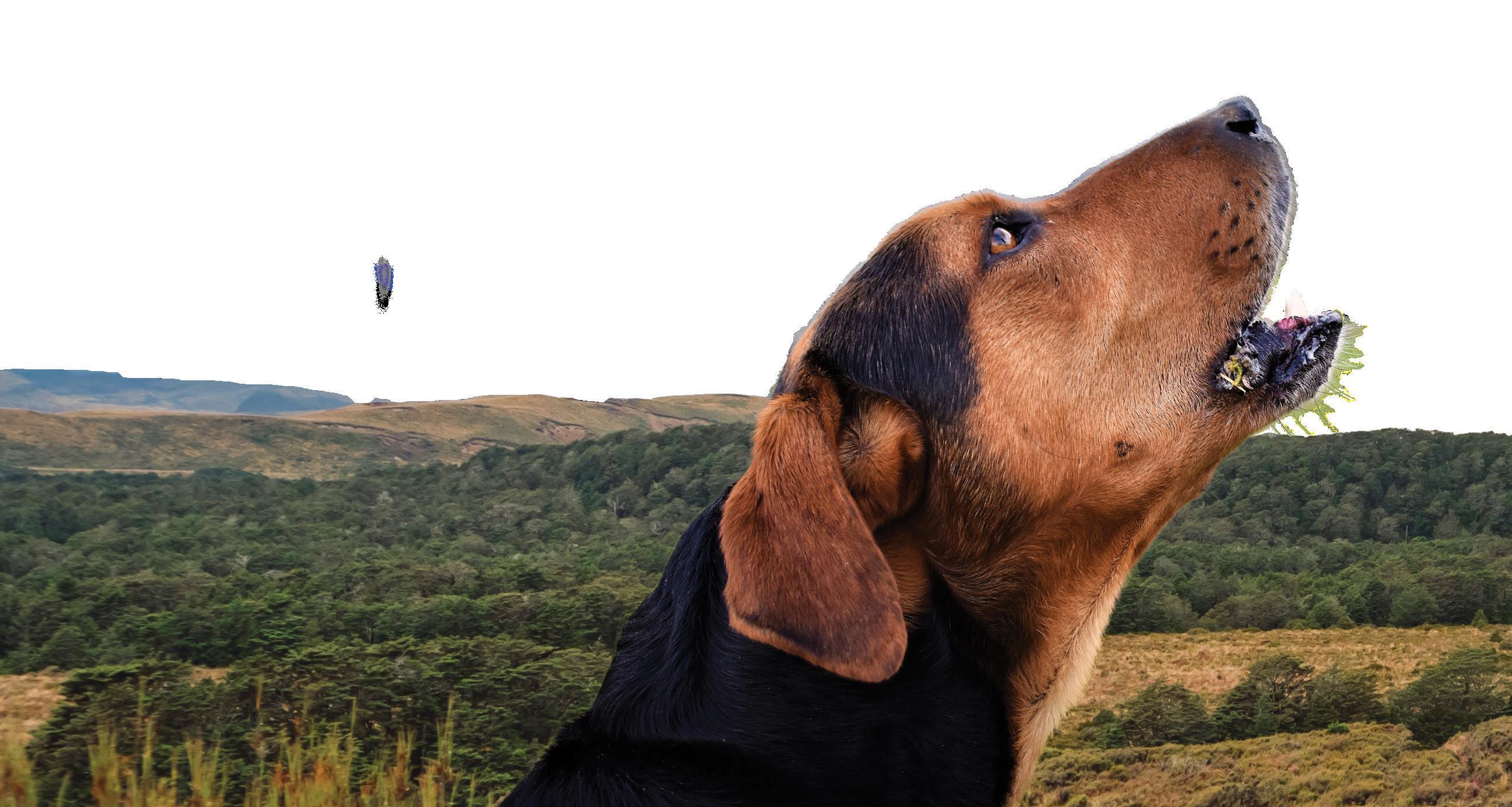

160 Country-Wide Beef | MAY 2023 72 Country-Wide | APRIL 2023 *For every specially marked Royal Canin® Energy 4800 20kg, Maxi Puppy Active 20kg and Medium Puppy 16kg bag sold at a participating veterinary clinic in New Zealand between 1 April 2023 and 31 May 2023, Royal Canin Australia Pty Ltd will donate NZ$1 to the Will To Live Charitable Trust New Zealand (CC57571), up to a maximum donation of NZ$10,000. Full terms and conditions are available at https://www.royalcanin.com/nz/competition-terms To find out more visit: facebook.com/willtolivenz SPEAKING UP FOR RURAL MENTAL HEALTH INSPIRE, SUPPORT AND BOOST POSITIVE WELLBEING AND MENTAL HEALTH IN HARD WORKING RURAL NEW ZEALANDERS.


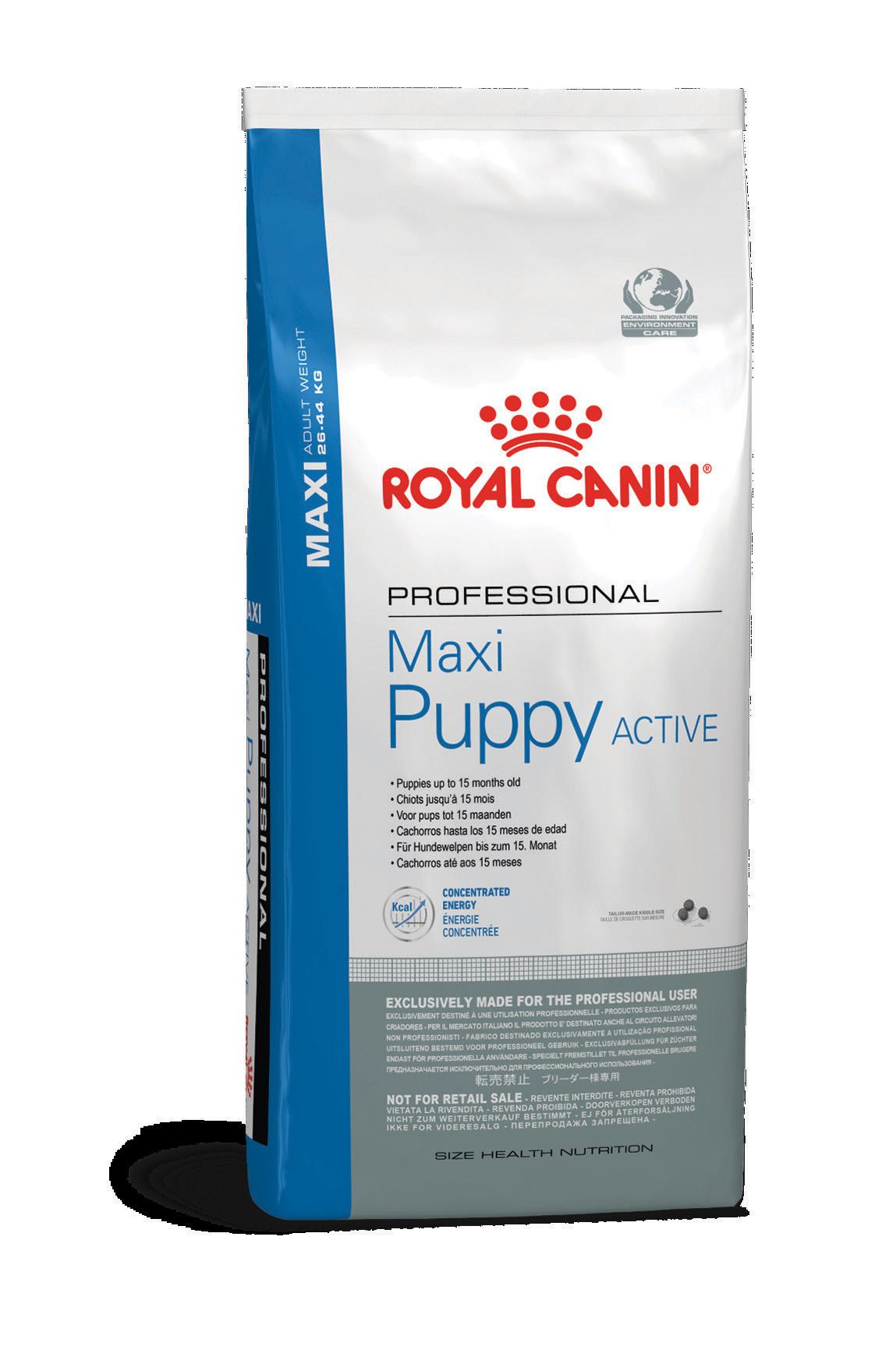
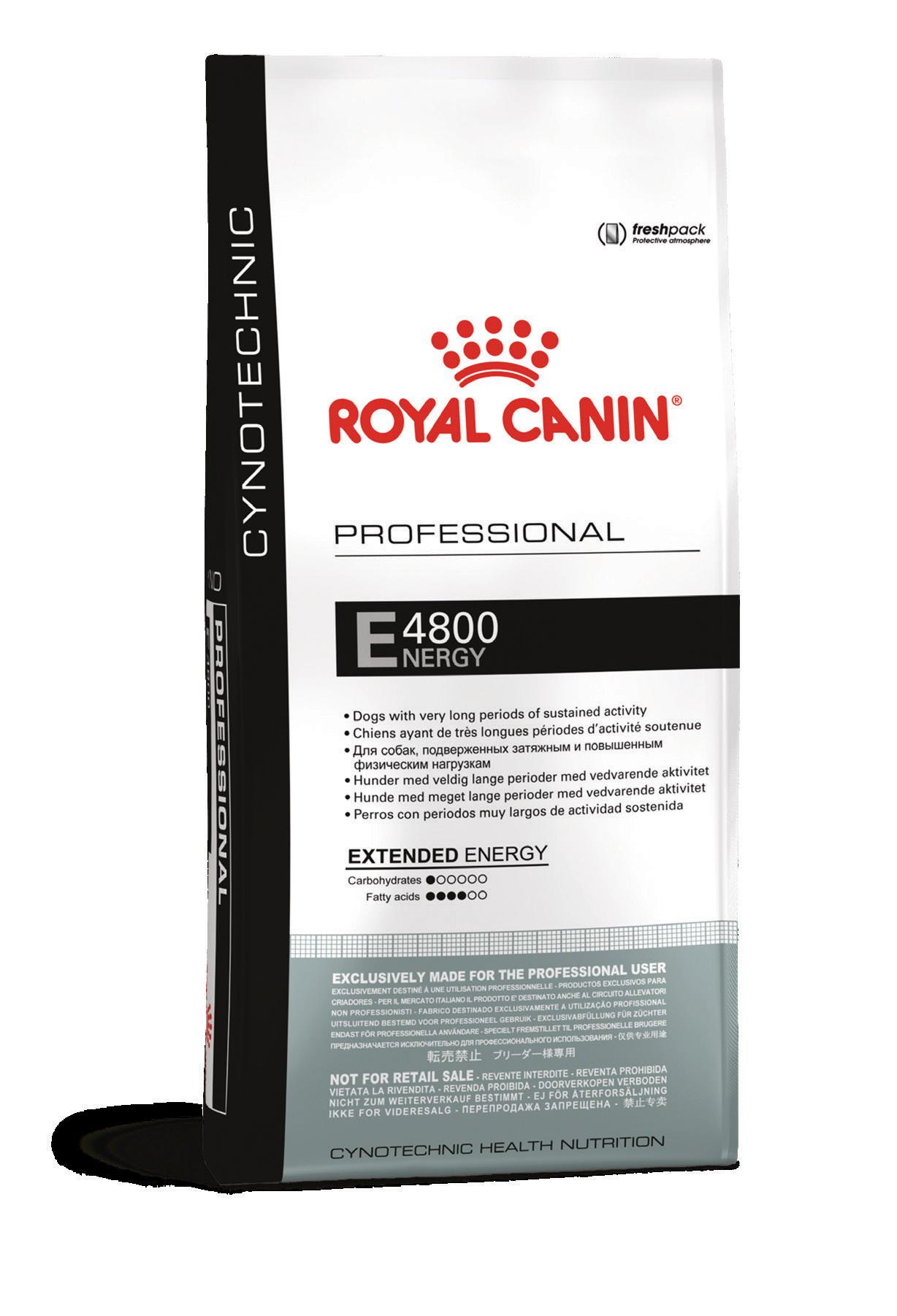
Country-Wide Beef | MAY 2023 Country-Wide | APRIL 2023 DONATED FOR EVERY BAG* ROYAL CANIN® ENERGY 4800 20KG MAXI PUPPY ACTIVE 20KG & MEDIUM PUPPY 16KG
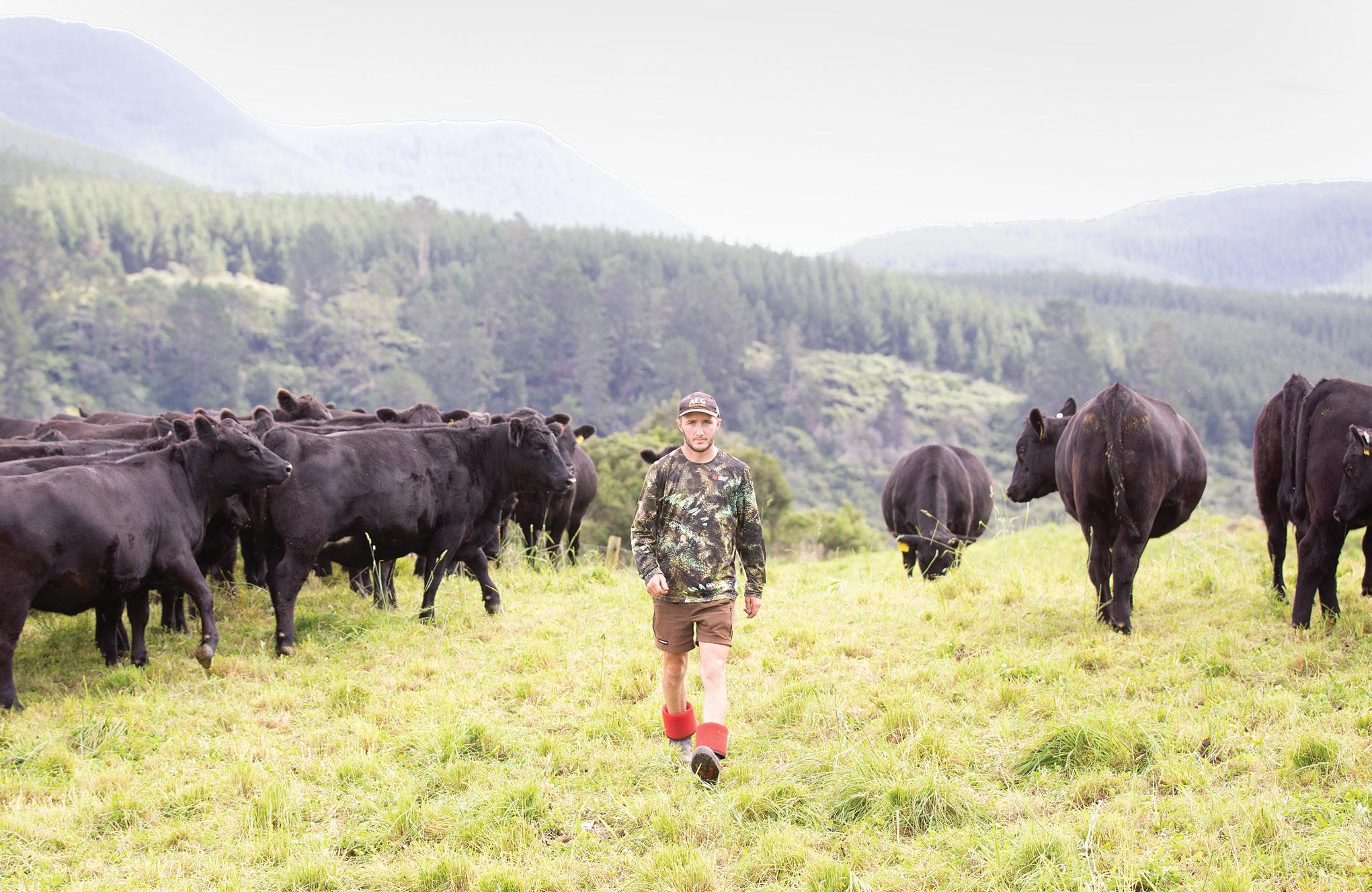
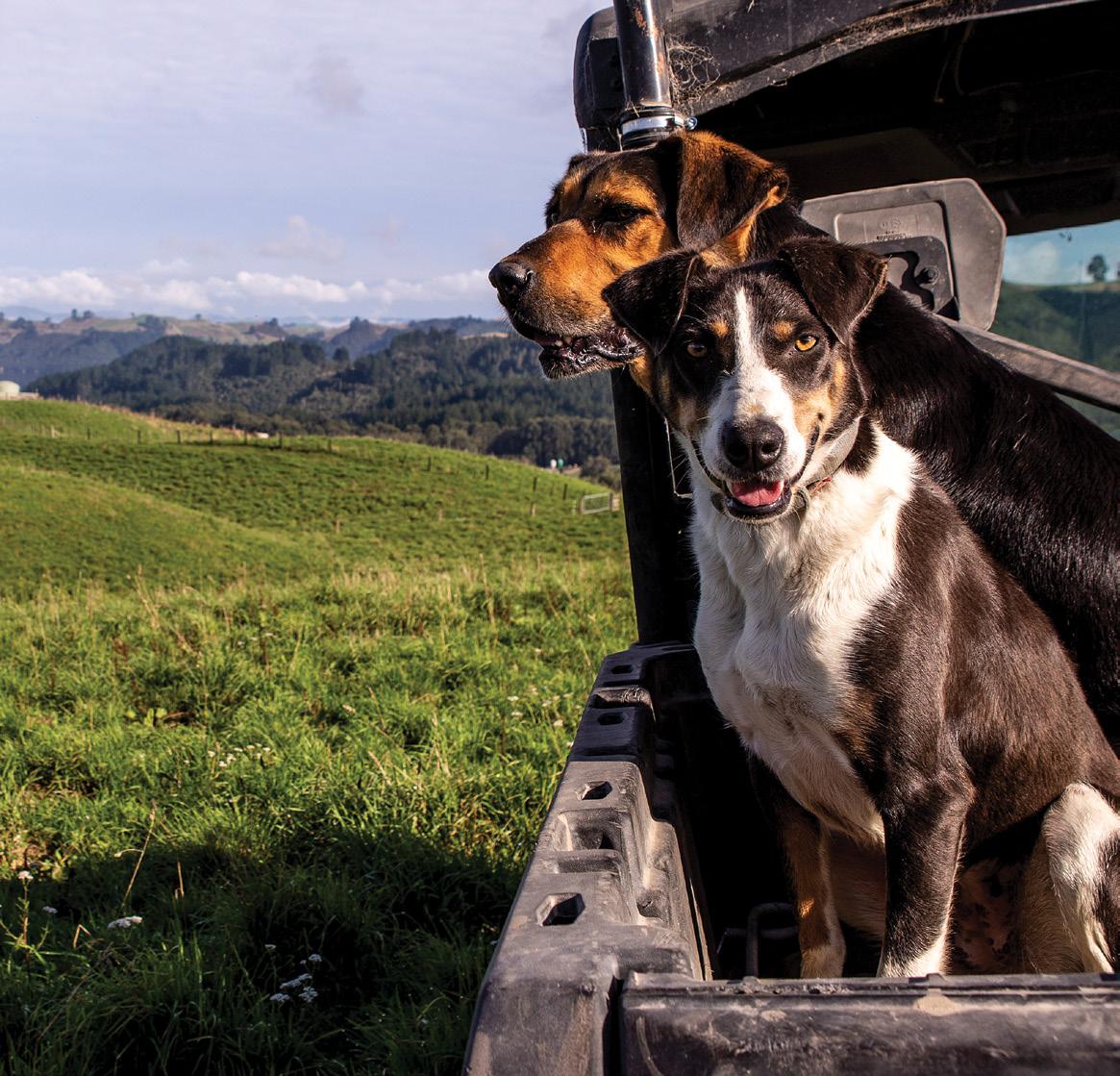
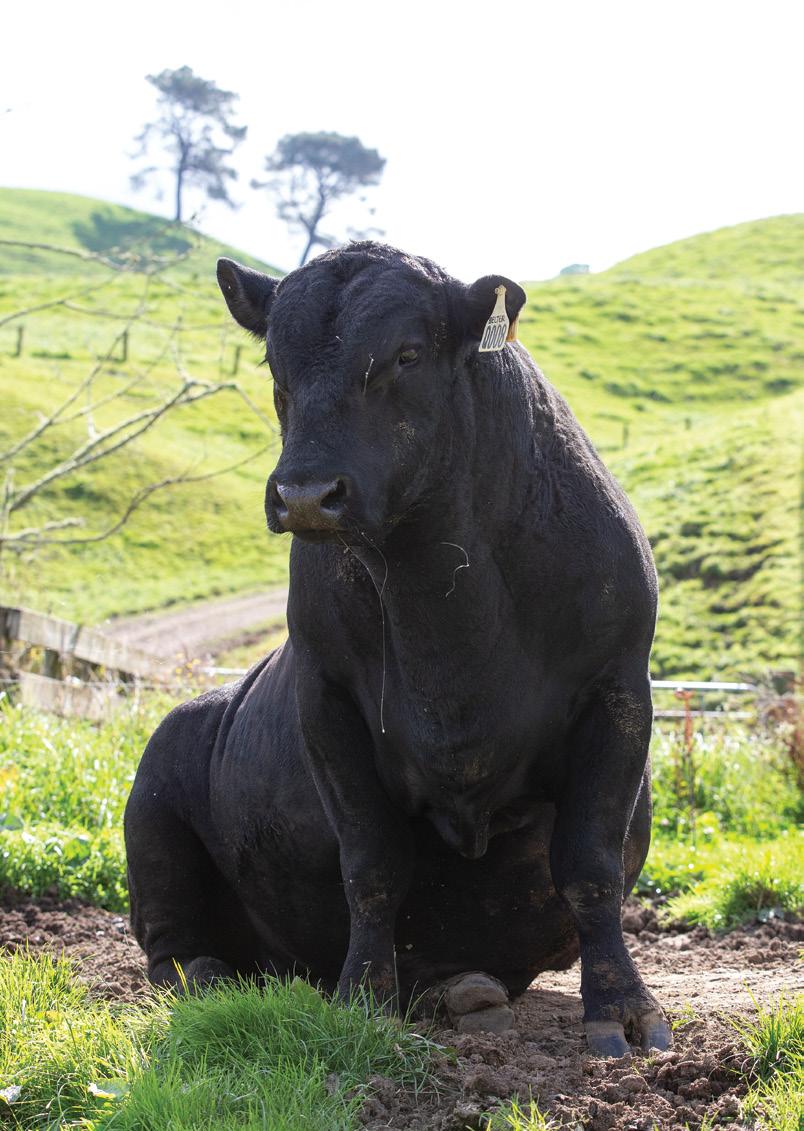
162 Country-Wide Beef | MAY 2023
FARMING IN FOCUS
Top left: Working dogs are useful members of the Stokman team. Top right: Sorry to disturb you Belter… Above: Jake Stokman walking through a mob of in-calf yearling heifers.
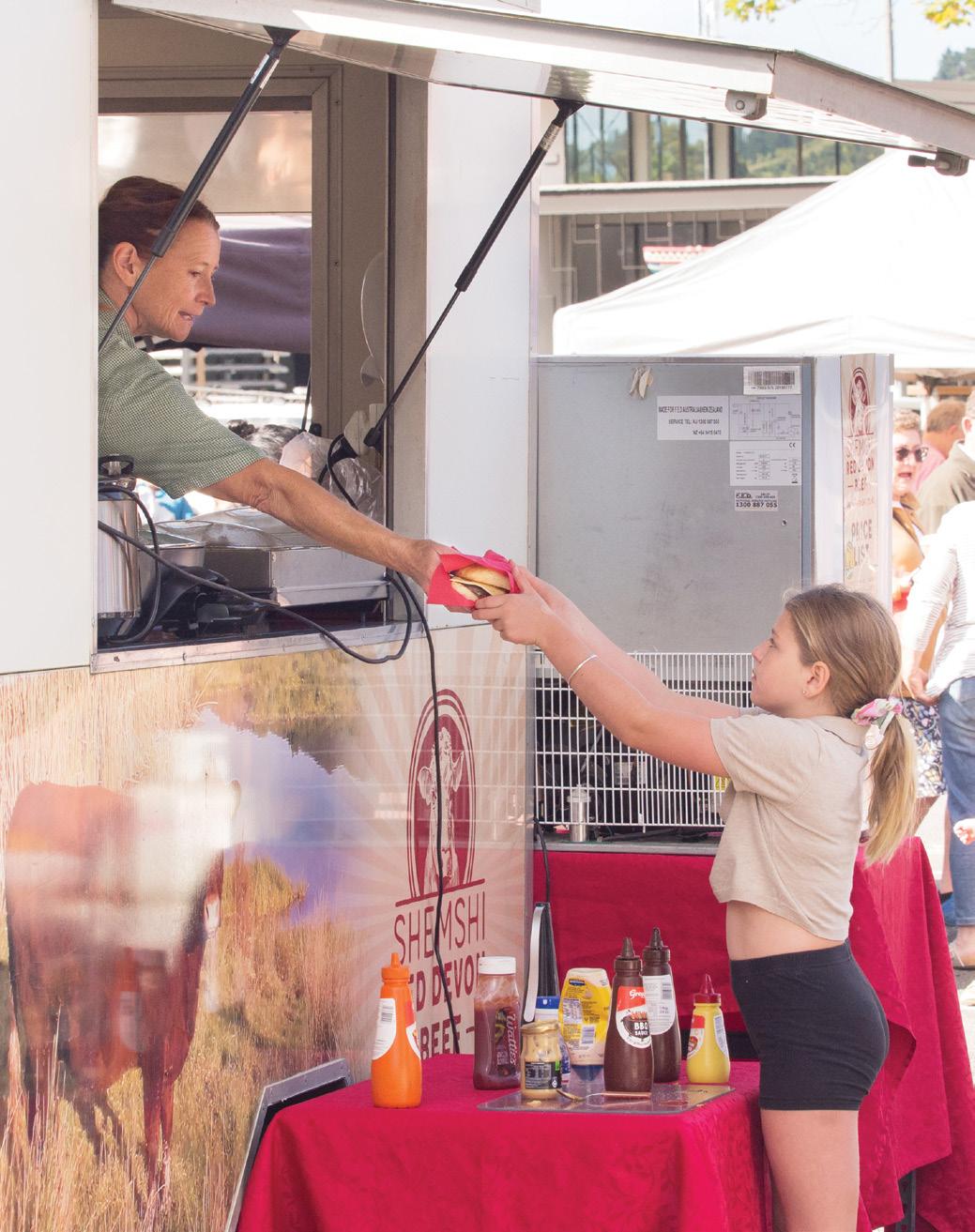
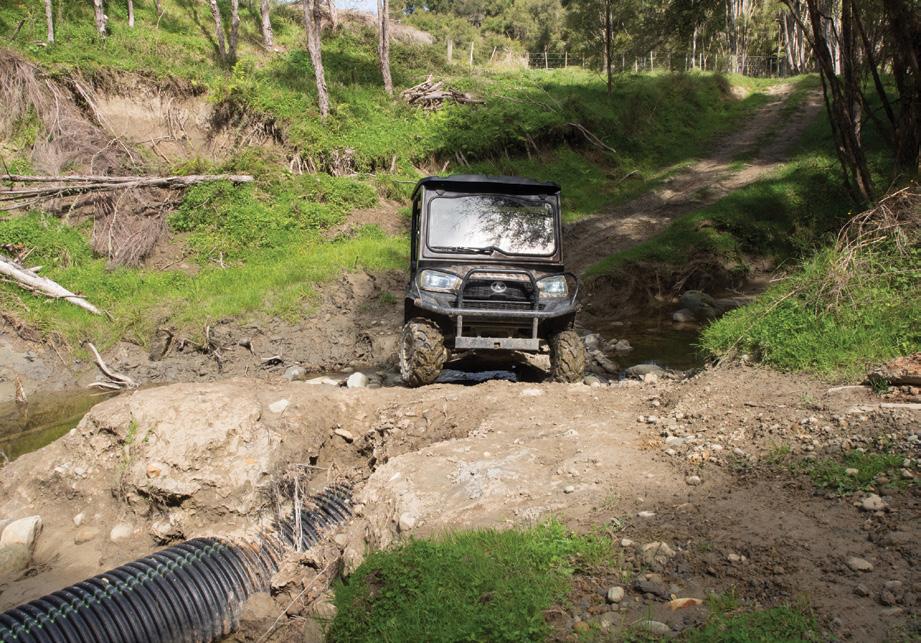
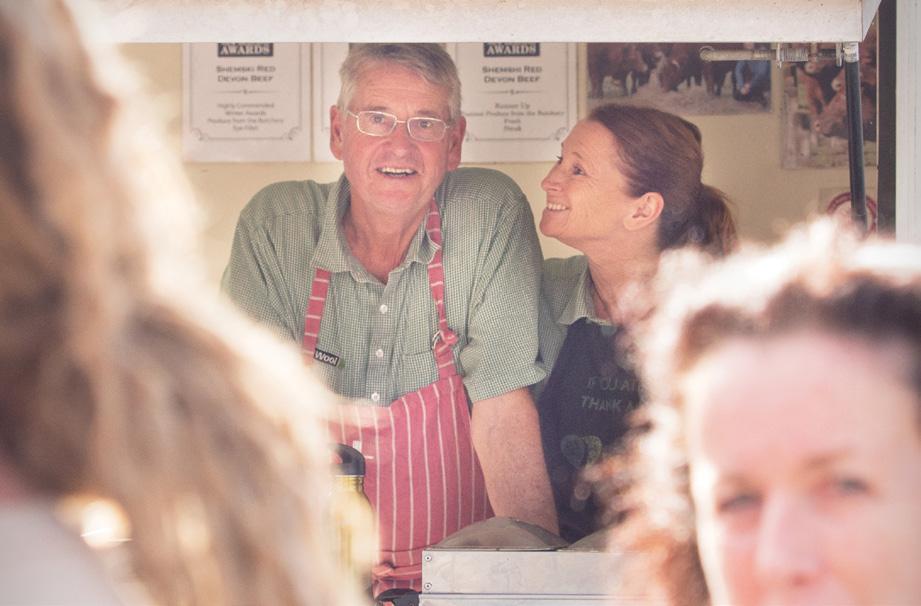
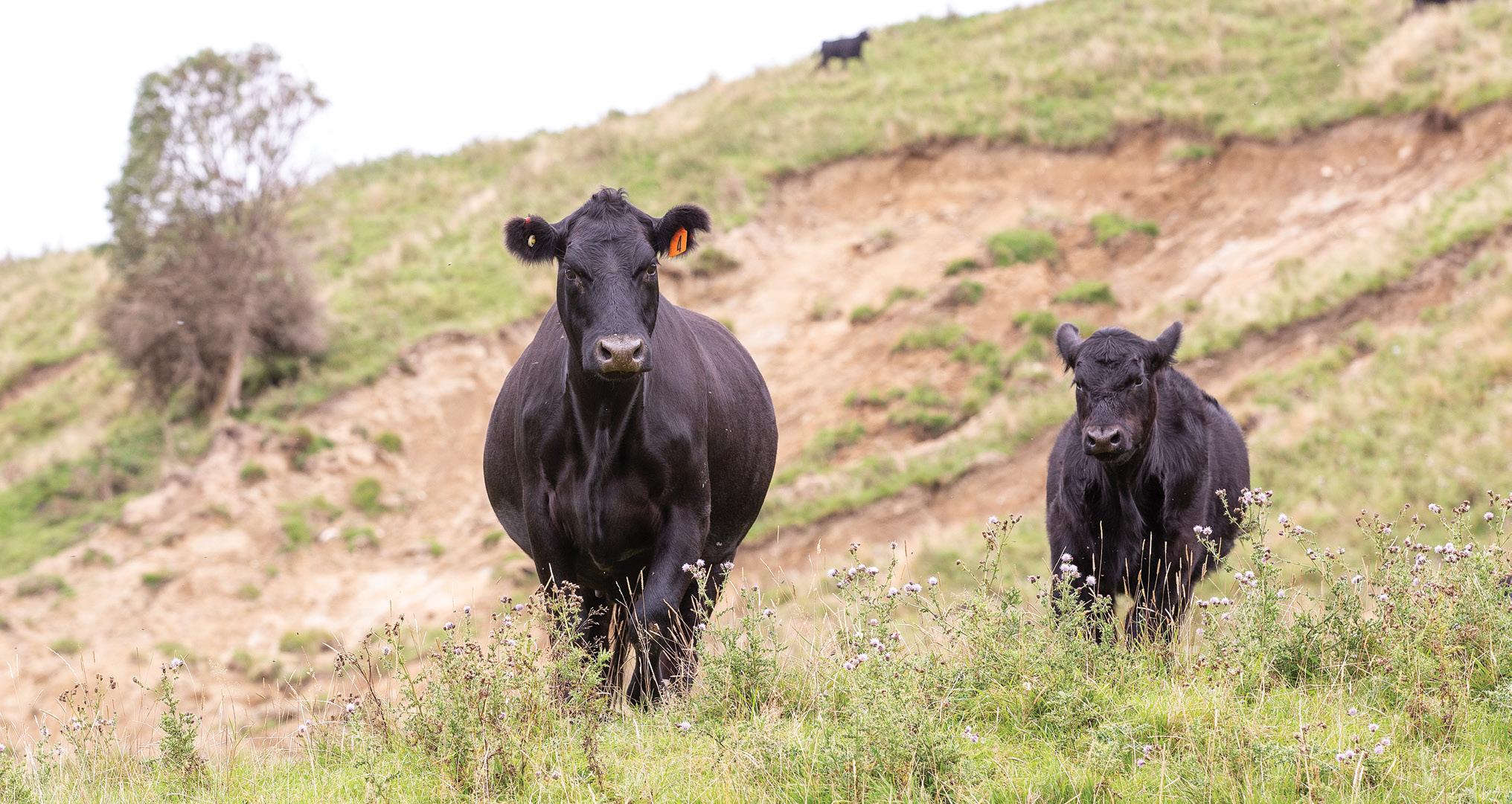
Country-Wide Beef | MAY 2023 163
Top left: Gisborne farmer Lee Askew with partner Simon at the Gisborne Farmers’ Market, selling her finished product from the Shemshi Beef food trailer. Top right: For Lee, success is measured by how fast the ciabatta buns sell out. Centre: Lee’s main crossing on her Gisborne farm blew out. Above: All yearling heifers are mated to low birthweight Angus bulls on the Hirschberg’s farm in Apiti, Manawatu.
GOING THE EXTRA YARD.
We’re here for the good of the country.
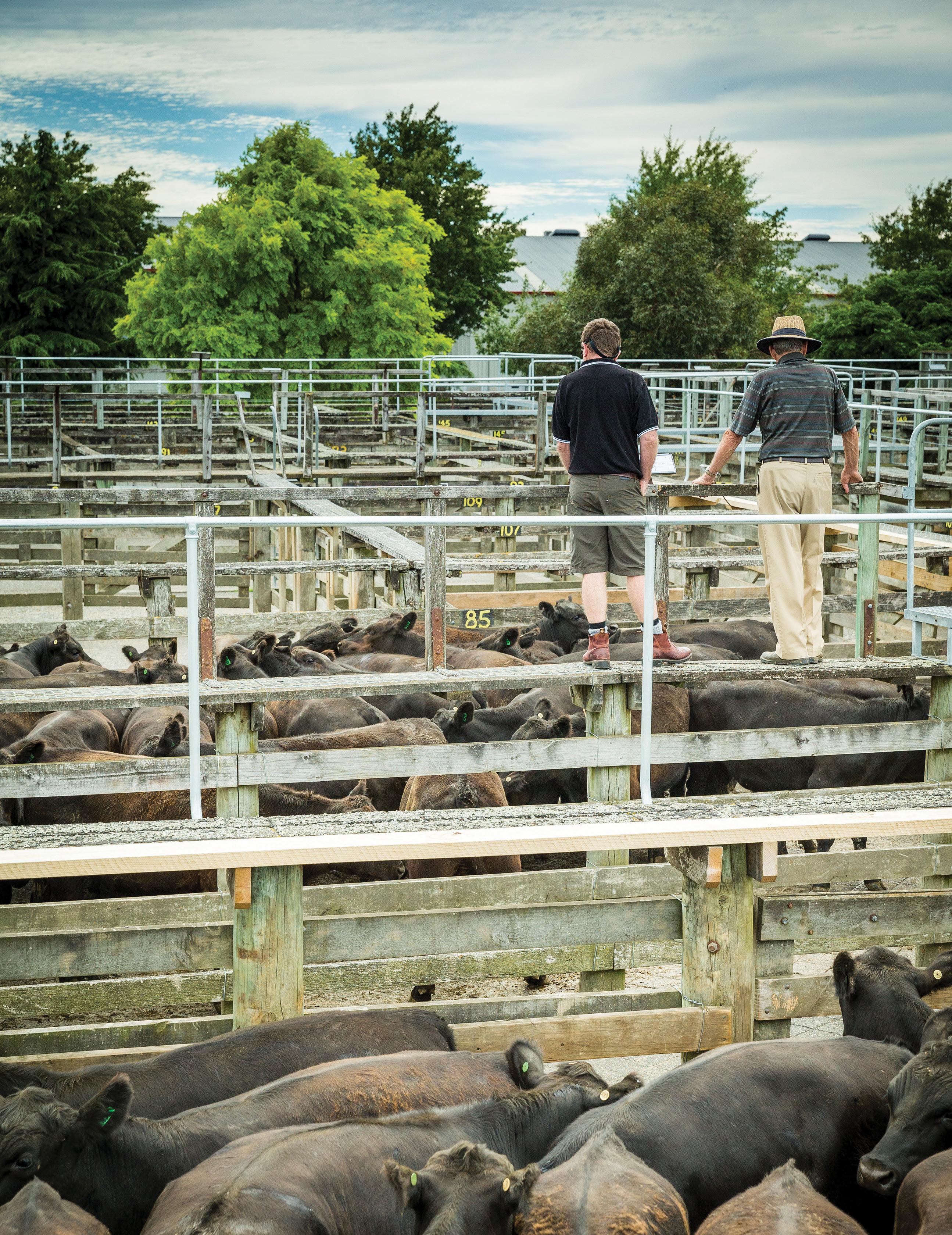
Relationships are the backbone of rural success. With over 118 years of partnering with rural New Zealand you can be sure our insurance and advice is top notch. If you’re keen to chat about a successful partnership get in touch on 0800 366 466 or visit fmg.co.nz






































































































































































































 One of Lee Askew's pedigree Red Devon calves.
One of Lee Askew's pedigree Red Devon calves.

























































































































































































































 By Nicola Dennis
By Nicola Dennis







































































